9.1: Byzantium: The New Rome
9.1.1: Naming of the Byzantine Empire
While the Western Roman Empire fell, the Eastern Roman Empire, now known as the Byzantine Empire, thrived.
Learning Objective
Describe identifying characteristics of the Byzantine Empire
Key Points
- While the Western Roman Empire fell in 476 CE, the Eastern Roman Empire, centered on the city of Constantinople, survived and thrived.
- After the Eastern Roman Empire’s much later fall in 1453 CE, western scholars began calling it the “Byzantine Empire” to emphasize its distinction from the earlier, Latin-speaking Roman Empire centered on Rome.
- The “Byzantine Empire” is now the standard term used among historians to refer to the Eastern Roman Empire.
- Although the Byzantine Empire had a multi-ethnic character during most of its history and preserved Romano-Hellenistic traditions, it became identified with its increasingly predominant Greek element and its own unique cultural developments.
Key Term
- Constantinople
-
Formerly Byzantium, the capital of the Byzantine Empire as established by its first emperor, Constantine the Great. (Today the city is known as Istanbul.)
The Byzantine Empire, sometimes referred to as the Eastern Roman Empire, was the continuation of the Roman Empire in the east during Late Antiquity and the Middle Ages, when its capital city was Constantinople (modern-day Istanbul, originally founded as Byzantium). It survived the fragmentation and fall of the Western Roman Empire in the 5th century CE, and continued to exist for an additional thousand years until it fell to the Ottoman Turks in 1453. During most of its existence, the empire was the most powerful economic, cultural, and military force in Europe. Both “Byzantine Empire” and “Eastern Roman Empire” are historiographical terms created after the end of the realm; its citizens continued to refer to their empire as the Roman Empire, and thought of themselves as Romans. Although the people living in the Eastern Roman Empire referred to themselves as Romans, they were distinguished by their Greek heritage, Orthodox Christianity, and their regional connections. Over time, the culture of the Eastern Roman Empire transformed. Greek replaced Latin as the language of the empire. Christianity became more important in daily life, although the culture’s pagan Roman past still exerted an influence.
Several signal events from the 4th to 6th centuries mark the period of transition during which the Roman Empire’s Greek east and Latin west divided. Constantine I (r. 324-337) reorganized the empire, made Constantinople the new capital, and legalized Christianity. Under Theodosius I (r. 379-395), Christianity became the empire’s official state religion, and other religious practices were proscribed. Finally, under the reign of Heraclius (r. 610-641), the empire’s military and administration were restructured and adopted Greek for official use instead of Latin. Thus, although the Roman state continued and Roman state traditions were maintained, modern historians distinguish Byzantium from ancient Rome insofar as it was centered on Constantinople, oriented towards Greek rather than Latin culture, and characterized by Orthodox Christianity.
Just as the Byzantine Empire represented the political continuation of the Roman Empire, Byzantine art and culture developed directly out of the art of the Roman Empire, which was itself profoundly influenced by ancient Greek art. Byzantine art never lost sight of this classical heritage. For example, the Byzantine capital, Constantinople, was adorned with a large number of classical sculptures, although they eventually became an object of some puzzlement for its inhabitants. And indeed, the art produced during the Byzantine Empire, although marked by periodic revivals of a classical aesthetic, was above all marked by the development of a new aesthetic. Thus, although the Byzantine Empire had a multi-ethnic character during most of its history, and preserved Romano-Hellenistic traditions, it became identified by its western and northern contemporaries with its increasingly predominant Greek element and its own unique cultural developments.
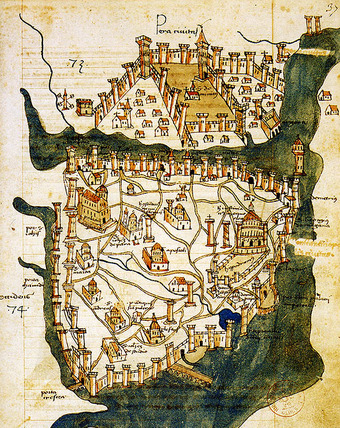
Map of Constantinople
A map of Constantinople, the capital and founding city of the Byzantine Empire, drawn in 1422 CE by Florentine cartographer Cristoforo Buondelmonti. This is the oldest surviving map of the city and the only one that predates the Turkish conquest of the city in 1453 CE.
Nomenclature
The first use of the term “Byzantine” to label the later years of the Roman Empire was in 1557, when the German historian Hieronymus Wolf published his work, Corpus Historiæ Byzantinæ, a collection of historical sources. The term comes from “Byzantium,” the name of the city of Constantinople before it became Constantine’s capital. This older name of the city would rarely be used from this point onward except in historical or poetic contexts. However, it was not until the mid-19th century that the term came into general use in the western world; calling it the “Byzantine Empire” helped to emphasize its differences from the earlier Latin-speaking Roman Empire, centered on Rome.
The term “Byzantine” was also useful to the many western European states that also claimed to be the true successors of the Roman Empire, as it was used to delegitimize the claims of the Byzantines as true Romans. In modern times, the term “Byzantine” has also come to have a pejorative sense, used to describe things that are overly complex or arcane. “Byzantine diplomacy” has come to mean excess use of trickery and behind-the-scenes manipulation. These are all based on medieval stereotypes about the Byzantine Empire that developed as western Europeans came into contact with the Byzantines, and were perplexed by their more structured government.
No such distinction existed in the Islamic and Slavic worlds, where the empire was more straightforwardly seen as the continuation of the Roman Empire. In the Islamic world, the Roman Empire was known primarily as Rûm. The name millet-i Rûm, or “Roman nation,” was used by the Ottomans through the 20th century to refer to the former subjects of the Byzantine Empire, that is, the Orthodox Christian community within Ottoman realms.
9.1.2: The Eastern Roman Empire, Constantine the Great, and Byzantium
The Christian, Greek-speaking Byzantine Empire had its capital at Constantinople, established by Emperor Constantine the Great.
Learning Objective
Explain the role of Constantine in Byzantine Empire history
Key Points
- The Byzantine Empire (the Eastern Roman Empire) was distinct from the Western Roman Empire in several ways; most importantly, the Byzantines were Christians and spoke Greek instead of Latin.
- The founder of the Byzantine Empire and its first emperor, Constantine the Great, moved the capital of the Roman Empire to the city of Byzantium in 330 CE, and renamed it Constantinople.
- Constantine the Great also legalized Christianity, which had previously been persecuted in the Roman Empire. Christianity would become a major element of Byzantine culture.
- Constantinople became the largest city in the empire and a major commercial center, while the Western Roman Empire fell in 476 CE.
Key Terms
- Christianity
-
An Abrahamic religion based on the teachings of Jesus Christ and various scholars who wrote the Christian Bible. It was legalized in the Byzantine Empire by Constantine the Great, and the religion became a major element of Byzantine culture.
- Germanic barbarians
-
An uncivilized or uncultured person, originally compared to the hellenistic Greco-Roman civilization; often associated with fighting or other such shows of strength.
Constantine the Great and the Beginning of Byzantium
It is a matter of debate when the Roman Empire officially ended and transformed into the Byzantine Empire. Most scholars accept that it did not happen at one time, but that it was a slow process; thus, late Roman history overlaps with early Byzantine history. Constantine I (“the Great”) is usually held to be the founder of the Byzantine Empire. He was responsible for several major changes that would help create a Byzantine culture distinct from the Roman past.
As emperor, Constantine enacted many administrative, financial, social, and military reforms to strengthen the empire. The government was restructured and civil and military authority separated. A new gold coin, the solidus, was introduced to combat inflation. It would become the standard for Byzantine and European currencies for more than a thousand years. As the first Roman emperor to claim conversion to Christianity, Constantine played an influential role in the development of Christianity as the religion of the empire. In military matters, the Roman army was reorganized to consist of mobile field units and garrison soldiers capable of countering internal threats and barbarian invasions. Constantine pursued successful campaigns against the tribes on the Roman frontiers—the Franks, the Alamanni, the Goths, and the Sarmatians—, and even resettled territories abandoned by his predecessors during the turmoil of the previous century.
The age of Constantine marked a distinct epoch in the history of the Roman Empire. He built a new imperial residence at Byzantium and renamed the city Constantinople after himself (the laudatory epithet of “New Rome” came later, and was never an official title). It would later become the capital of the empire for over one thousand years; for this reason the later Eastern Empire would come to be known as the Byzantine Empire. His more immediate political legacy was that, in leaving the empire to his sons, he replaced Diocletian’s tetrarchy (government where power is divided among four individuals) with the principle of dynastic succession. His reputation flourished during the lifetime of his children, and for centuries after his reign. The medieval church upheld him as a paragon of virtue, while secular rulers invoked him as a prototype, a point of reference, and the symbol of imperial legitimacy and identity.
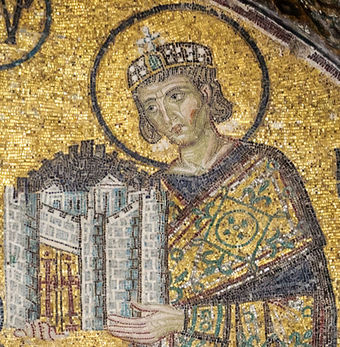
Constantine the Great
Byzantine Emperor Constantine the Great presents a representation of the city of Constantinople as tribute to an enthroned Mary and Christ Child in this church mosaic. St Sophia, c. 1000 CE.
Constantinople and Civil Reform
Constantine moved the seat of the empire, and introduced important changes into its civil and religious constitution. In 330, he founded Constantinople as a second Rome on the site of Byzantium, which was well-positioned astride the trade routes between east and west; it was a superb base from which to guard the Danube river, and was reasonably close to the eastern frontiers. Constantine also began the building of the great fortified walls, which were expanded and rebuilt in subsequent ages. J. B. Bury asserts that “the foundation of Constantinople […] inaugurated a permanent division between the Eastern and Western, the Greek and the Latin, halves of the empire—a division to which events had already pointed—and affected decisively the whole subsequent history of Europe.”
Constantine built upon the administrative reforms introduced by Diocletian. He stabilized the coinage (the gold solidus that he introduced became a highly prized and stable currency), and made changes to the structure of the army. Under Constantine, the empire had recovered much of its military strength and enjoyed a period of stability and prosperity. He also reconquered southern parts of Dacia, after defeating the Visigoths in 332, and he was planning a campaign against Sassanid Persia as well. To divide administrative responsibilities, Constantine replaced the single praetorian prefect, who had traditionally exercised both military and civil functions, with regional prefects enjoying civil authority alone. In the course of the 4th century, four great sections emerged from these Constantinian beginnings, and the practice of separating civil from military authority persisted until the 7th century.
Constantine and Christianity
Constantine was the first emperor to stop Christian persecutions and to legalize Christianity, as well as all other religions and cults in the Roman Empire.
In February 313, Constantine met with Licinius in Milan, where they developed the Edict of Milan. The edict stated that Christians should be allowed to follow the faith without oppression. This removed penalties for professing Christianity, under which many had been martyred previously, and returned confiscated Church property. The edict protected from religious persecution not only Christians but all religions, allowing anyone to worship whichever deity they chose.
Scholars debate whether Constantine adopted Christianity in his youth from his mother, St. Helena,, or whether he adopted it gradually over the course of his life. According to Christian writers, Constantine was over 40 when he finally declared himself a Christian, writing to Christians to make clear that he believed he owed his successes to the protection of the Christian High God alone. Throughout his rule, Constantine supported the Church financially, built basilicas, granted privileges to clergy (e.g. exemption from certain taxes), promoted Christians to high office, and returned property confiscated during the Diocletianic persecution. His most famous building projects include the Church of the Holy Sepulchre, and Old Saint Peter’s Basilica.
The reign of Constantine established a precedent for the position of the emperor as having great influence and ultimate regulatory authority within the religious discussions involving the early Christian councils of that time (most notably, the dispute over Arianism, and the nature of God). Constantine himself disliked the risks to societal stability that religious disputes and controversies brought with them, preferring where possible to establish an orthodoxy. One way in which Constantine used his influence over the early Church councils was to seek to establish a consensus over the oft debated and argued issue over the nature of God. In 325, he summoned the Council of Nicaea, effectively the first Ecumenical Council. The Council of Nicaea is most known for its dealing with Arianism and for instituting the Nicene Creed, which is still used today by Christians.
The Fall of the Western Roman Empire
After Constantine, few emperors ruled the entire Roman Empire. It was too big and was under attack from too many directions. Usually, there was an emperor of the Western Roman Empire ruling from Italy or Gaul, and an emperor of the Eastern Roman Empire ruling from Constantinople. While the Western Empire was overrun by Germanic barbarians (its lands in Italy were conquered by the Ostrogoths, Spain was conquered by the Visigoths, North Africa was conquered by the Vandals, and Gaul was conquered by the Franks), the Eastern Empire thrived. Constantinople became the largest city in the empire and a major commercial center. In 476 CE, the last Western Roman Emperor was deposed and the Western Roman Empire was no more. Thus the Eastern Roman Empire was the only Roman Empire left standing.
9.1.3: Justinian and Theodora
Emperor Justinian was responsible for substantial expansion, a legal code, and the Hagia Sophia, but suffered defeats against the Persians.
Learning Objective
Discuss the accomplishments and failures of Emperor Justinian the Great
Key Points
- Emperor Justinian the Great was responsible for substantial expansion of the Byzantine Empire, and for conquering Africa, Spain, Rome, and most of Italy.
- Justinian was responsible for the construction of the Hagia Sophia, the center of Christianity in Constantinople. Even today, the Hagia Sophia is recognized as one of the greatest buildings in the world.
- Justinian also systematized the Roman legal code that served as the basis for law in the Byzantine Empire.
- After a plague reduced the Byzantine population, they lost Rome and Italy to the Ostrogoths, and several important cities to the Persians.
Key Terms
- Hagia Sophia
-
A church built by Byzantine Emperor Justinian; the center of Christianity in Constantinople and one of the greatest buildings in the world to this day. It is now a mosque in the Muslim Istanbul.
- Nika riots
-
When angry racing fans, already angry over rising taxes, became enraged at Emperor Justinian for arresting two popular charioteers, and tried to depose him in 532 CE.
Byzantine Empire from Constantine to Justinian
One of Constantine’s successors, Theodosius I (379-395), was the last emperor to rule both the Eastern and Western halves of the empire. In 391 and 392, he issued a series of edicts essentially banning pagan religion. Pagan festivals and sacrifices were banned, as was access to all pagan temples and places of worship. The state of the empire in 395 may be described in terms of the outcome of Constantine’s work. The dynastic principle was established so firmly that the emperor who died in that year, Theodosius I, could bequeath the imperial office jointly to his sons, Arcadius in the East and Honorius in the West.
The Eastern Empire was largely spared the difficulties faced by the west in the third and fourth centuries, due in part to a more firmly established urban culture and greater financial resources, which allowed it to placate invaders with tribute and pay foreign mercenaries. Throughout the fifth century, various invading armies overran the Western Empire but spared the east. Theodosius II further fortified the walls of Constantinople, leaving the city impervious to most attacks; the walls were not breached until 1204.
To fend off the Huns, Theodosius had to pay an enormous annual tribute to Attila. His successor, Marcian, refused to continue to pay the tribute, but Attila had already diverted his attention to the west. After his death in 453, the Hunnic Empire collapsed, and many of the remaining Huns were often hired as mercenaries by Constantinople.
Leo I succeeded Marcian as emperor, and after the fall of Attila, the true chief in Constantinople was the Alan general, Aspar. Leo I managed to free himself from the influence of the non-Orthodox chief by supporting the rise of the Isaurians, a semi-barbarian tribe living in southern Anatolia. Aspar and his son, Ardabur, were murdered in a riot in 471, and henceforth, Constantinople restored Orthodox leadership for centuries.
When Leo died in 474, Zeno and Ariadne’s younger son succeeded to the throne as Leo II, with Zeno as regent. When Leo II died later that year, Zeno became emperor. The end of the Western Empire is sometimes dated to 476, early in Zeno’s reign, when the Germanic Roman general, Odoacer, deposed the titular Western Emperor Romulus Augustulus, but declined to replace him with another puppet.
Emperor Justinian I
In 527 CE, Justinian I came to the throne in Constantinople. He dreamed of reconquering the lands of the Western Roman Empire and ruling a single, united Roman Empire from his seat in Constantinople.
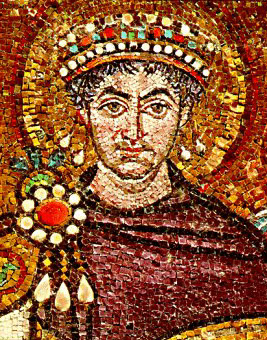
Emperor Justinian
Byzantine Emperor Justinian I depicted on one of the famous mosaics of the Basilica of San Vitale, Ravenna.
The western conquests began in 533, as Justinian sent his general, Belisarius, to reclaim the former province of Africa from the Vandals, who had been in control since 429 with their capital at Carthage. Belisarius successfully defeated the Vandals and claimed Africa for Constantinople. Next, Justinian sent him to take Italy from the Ostrogoths in 535 CE. Belisarius defeated the Ostrogoths in a series of battles and reclaimed Rome. By 540 CE, most of Italy was in Justinian’s hands. He sent another army to conquer Spain.
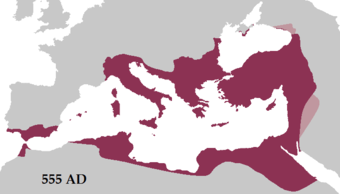
The Byzantine Empire under Justinian
The Byzantine Empire at its greatest extent, in 555 CE under Justinian the Great.
Accomplishments in Byzantium
Justinian also undertook many important projects at home. Much of Constantinople was burned down early in Justinian’s reign after a series of riots called the Nika riots, in 532 CE, when angry racing fans became enraged at Justinian for arresting two popular charioteers (though this was really just the last straw for a populace increasingly angry over rising taxes) and tried to depose him. The riots were put down, and Justinian set about rebuilding the city on a grander scale. His greatest accomplishment was the Hagia Sophia, the most important church of the city. The Hagia Sophia was a staggering work of Byzantine architecture, intended to awe all who set foot in the church. It was the largest church in the world for nearly a thousand years, and for the rest of Byzantine history it was the center of Christian worship in Constantinople.
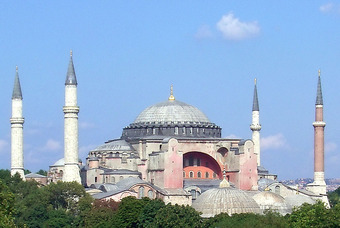
The Hagia Sophia
Byzantine Emperor Justinian built the Greek Orthodox Church of the Holy Wisdom of God, the Hagia Sophia, which was completed in only four and a half years (532 CE-537 CE). Even now, it is universally acknowledged as one of the greatest buildings in the world.
Emperor Justinian’s most important contribution, perhaps, was a unified Roman legal code. Prior to his reign, Roman laws had differed from region to region, and many contradicted one another. The Romans had attempted to systematize the legal code in the fifth century but had not completed the effort. Justinian set up a commission of lawyers to put together a single code, listing each law by subject so that it could be easily referenced. This not only served as the basis for law in the Byzantine Empire, but it was the main influence on the Catholic Church’s development of canon law, and went on to become the basis of law in many European countries. Justinian’s law code continues to have a major influence on public international law to this day.
The impact of a more unified legal code and military conflicts was the increased ability for the Byzantine Empire to establish trade and improve their economic standing. Byzantine merchants traded not only all over the Mediterranean region, but also throughout regions to the east. These included areas around the Black Sea, the Red Sea, and the Indian Ocean.
Theodora
Theodora was empress of the Byzantine Empire and the wife of Emperor Justinian I. She was one of the most influential and powerful of the Byzantine empresses. Some sources mention her as empress regnant, with Justinian I as her co-regent. Along with her husband, she is a saint in the Eastern Orthodox Church, commemorated on November 14.
Theodora participated in Justinian’s legal and spiritual reforms, and her involvement in the increase of the rights of women was substantial. She had laws passed that prohibited forced prostitution and closed brothels. She created a convent on the Asian side of the Dardanelles called the Metanoia (Repentance), where the ex-prostitutes could support themselves. She also expanded the rights of women in divorce and property ownership, instituted the death penalty for rape, forbade exposure of unwanted infants, gave mothers some guardianship rights over their children, and forbade the killing of a wife who committed adultery.
Justinian’s Difficulties
A terrible plague swept through the empire, killing Theodora and almost killing him. The plague wiped out huge numbers of the empire’s population, leaving villages empty and crops unharvested. The army was also afflicted, and the Ostrogoths were able to effectively regain Italy in 546 CE, through guerrilla warfare against the Byzantine occupiers.
With Justinian’s army bogged down fighting in Italy, the empire’s defenses against the Persians on its eastern frontiers were weakened. In the Roman-Persian Wars, the Persians invaded and destroyed a number of important cities. Justinian was forced to establish a humiliating 50-year peace treaty with them in 561 CE.
Still, Justinian kept the empire from collapse. He sent a new general, Narses, to Italy with a small force. Narses finally defeated the Ostrogoths and drove them back out of Italy. By the time the war was over, Italy, once one of the most prosperous lands in the ancient world, was wrecked. The city of Rome changed hands multiple times, and most of the cities of Italy were abandoned or fell into a long period of decline. The impoverishment of Italy and the weakened Byzantine military made it impossible for the empire to hold the peninsula. Soon a new Germanic tribe, the Lombards, came in and conquered most of Italy, though Rome, Naples, and Ravenna remained isolated pockets of Byzantine control. At the same time, another new barbarian enemy, the Slavs, appeared from north of the Danube. They devastated Greece and the Balkans, and in the absence of strong Byzantine military might, they settled in small communities in these lands.
9.1.4: The Justinian Code
Justinian I achieved lasting fame through his judicial reforms, particularly through the complete revision of all Roman law that was compiled in what is known today as the Corpus juris civilis.
Learning Objective
Explain the historical significance of Justinian’s legal reforms
Key Points
- Shortly after Justinian became emperor in 527, he decided the empire’s legal system needed repair.
- Early in his reign, Justinian appointed an official, Tribonian, to oversee this task.
- The project as a whole became known as Corpus juris civilis, or the Justinian Code.
- It consists of the Codex Iustinianus, the Digesta, the Institutiones, and the Novellae.
- Many of the laws contained in the Codex were aimed at regulating religious practice.
- The Corpus formed the basis not only of Roman jurisprudence (including ecclesiastical Canon Law), but also influenced civil law throughout the Middle Ages and into modern nation states.
Key Terms
- Corpus juris civilis
-
The modern name for a collection of fundamental works in jurisprudence, issued from 529 to 534 by order of Justinian I, Eastern Roman Emperor.
- Justinian I
-
A Byzantine emperor from 527 to 565. During his reign, he sought to revive the empire’s greatness and reconquer the lost western half of the historical Roman Empire; he also enacted important legal codes.
Byzantine Emperor Justinian I achieved lasting fame through his judicial reforms, particularly through the complete revision of all Roman law, something that had not previously been attempted. There existed three codices of imperial laws and other individual laws, many of which conflicted or were out of date. The total of Justinian’s legislature is known today as the Corpus juris civilis.
The work as planned had three parts:
- Codex: a compilation, by selection and extraction, of imperial enactments to date, going back to Hadrian in the 2nd century CE.
- Digesta: an encyclopedia composed of mostly brief extracts from the writings of Roman jurists. Fragments were taken out of various legal treatises and opinions and inserted in the Digesta.
- Institutiones: a student textbook, mainly introducing the Codex, although it has important conceptual elements that are less developed in the Codex or the Digesta.
All three parts, even the textbook, were given force of law. They were intended to be, together, the sole source of law; reference to any other source, including the original texts from which the Codex and the Digesta had been taken, was forbidden. Nonetheless, Justinian found himself having to enact further laws, and today these are counted as a fourth part of the Corpus, the Novellae Constitutiones. As opposed to the rest of the Corpus, the Novellae appeared in Greek, the common language of the Eastern Empire.
The work was directed by Tribonian, an official in Justinian’s court. His team was authorized to edit what they included. How far they made amendments is not recorded and, in the main, cannot be known because most of the originals have not survived. The text was composed and distributed almost entirely in Latin, which was still the official language of the government of the Byzantine Empire in 529-534, whereas the prevalent language of merchants, farmers, seamen, and other citizens was Greek.
Many of the laws contained in the Codex were aimed at regulating religious practice, included numerous provisions served to secure the status of Christianity as the state religion of the empire, uniting church and state, and making anyone who was not connected to the Christian church a non-citizen. It also contained laws forbidding particular pagan practices; for example, all persons present at a pagan sacrifice may be indicted as if for murder. Other laws, some influenced by his wife, Theodora, include those to protect prostitutes from exploitation, and women from being forced into prostitution. Rapists were treated severely. Further, by his policies, women charged with major crimes should be guarded by other women to prevent sexual abuse; if a woman was widowed, her dowry should be returned; and a husband could not take on a major debt without his wife giving her consent twice.
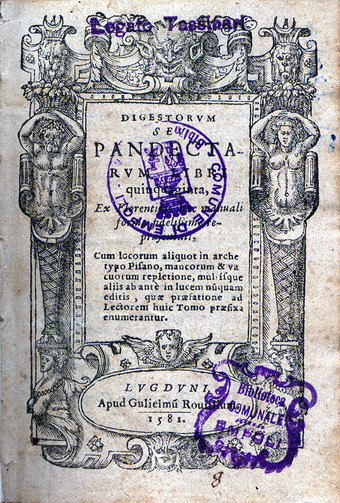
Justinian Digesta
A later copy of Justinian’s Digesta: Digestorum, seu Pandectarum libri quinquaginta. Lugduni apud Gulielmum Rouillium, 1581. From Biblioteca Comunale “Renato Fucini” di Empoli.
Legacy
The Corpus forms the basis of Latin jurisprudence (including ecclesiastical Canon Law) and, for historians, provides a valuable insight into the concerns and activities of the later Roman Empire. As a collection, it gathers together the many sources in which the laws and the other rules were expressed or published (proper laws, senatorial consults, imperial decrees, case law, and jurists’ opinions and interpretations). It formed the basis of later Byzantine law, as expressed in the Basilika of Basil I and Leo VI the Wise. The only western province where the Justinian Code was introduced was Italy, from where it was to pass to western Europe in the 12th century, and become the basis of much European law code. It eventually passed to eastern Europe, where it appeared in Slavic editions, and it also passed on to Russia.
It was not in general use during the Early Middle Ages. After the Early Middle Ages, interest in it revived. It was “received” or imitated as private law, and its public law content was quarried for arguments by both secular and ecclesiastical authorities. The revived Roman law, in turn, became the foundation of law in all civil law jurisdictions. The provisions of the Corpus Juris Civilis also influenced the canon law of the Roman Catholic Church; it was said that ecclesia vivit lege romana—the church lives by Roman law. Its influence on common law legal systems has been much smaller, although some basic concepts from the Corpus have survived through Norman law—such as the contrast, especially in the Institutes, between “law” (statute) and custom. The Corpus continues to have a major influence on public international law. Its four parts thus constitute the foundation documents of the western legal tradition.
9.2: The Heraclian and Isaurian Dynasties
9.2.1: Emperor Heracluis
Emperor Heraclius defended the Byzantine Empire from the Persians, but lost the reconquered land to the Arabs shortly thereafter.
Learning Objective
Identify the reason for the reduction in size of the Byzantine Empire
Key Points
- After Justinian, the Byzantine Empire continued to lose land to the Persians.
- Emperor Heraclius seized the throne in 610 CE, and beat back the Persians by 628 CE.
- However, after Heraclius’ victory against the Persians, he had taken such losses that he was unable to defend the empire against the Arabs, and so they again lost the lands they had just reconquered by 641 CE.
- Heraclius tried to unite all of the various religious factions within the empire with a new formula that was more inclusive and more elastic, called monothelitism, which was eventually deemed heretical by all factions.
Key Terms
- Muhammad
-
The central figure of Islam, widely regarded as its founder.
- Monothelitism
-
The view that Jesus Christ has two natures but only one will, a doctrine developed during Heraclius’ rule to bring unity to the Church.
Conflict with the Persians and Chaos in the Empire
Ever since the fall of the Western Roman Empire, the Eastern Roman Empire had continued to see western Europe as rightfully Imperial territory. However, only Justinian I attempted to enforce this claim with military might. Temporary success in the west was achieved at the cost of Persian dominance in the east, where the Byzantines were forced to pay tribute to avert war.
However, after Justinian’s death, much of newly recovered Italy fell to the Lombards, and the Visigoths soon reduced the imperial holdings in Spain. At the same time, wars with the Persian Empire brought no conclusive victory. In 591 however, the long war was ended with a treaty favorable to Byzantium, which gained Armenia. Thus, after the death of Justinian’s successor, Tiberius II, Maurice sought to restore the prestige of the Empire.
Even though the empire had gained smaller successes over the Slavs and Avars in pitched battles across the Danube, both enthusiasm for the army and faith in the government had lessened considerably. Unrest had reared its head in Byzantine cities as social and religious differences manifested themselves into Blue and Green factions that fought each other in the streets. The final blow to the government was a decision to cut the pay of its army in response to financial strains. The combined effect of an army revolt led by a junior officer named Phocas and major uprisings by the Greens and Blues forced Maurice to abdicate. The Senate approved Phocas as the new emperor, and Maurice, the last emperor of the Justinian Dynasty, was murdered along with his four sons.
The Persian King Khosrau II responded by launching an assault on the empire, ostensibly to avenge Maurice, who had earlier helped him to regain his throne. Phocas was already alienating his supporters with his repressive rule (introducing torture on a large scale), and the Persians were able to capture Syria and Mesopotamia by 607.
While the Persians were making headway in their conquest of the eastern provinces, Phocas chose to divide his subjects, rather than unite them against the threat of the Persians. Perhaps seeing his defeats as divine retribution, Phocas initiated a savage and bloody campaign to forcibly convert the Jews to Christianity. Persecutions and alienation of the Jews, a frontline people in the war against the Persians helped drive them into aiding the Persian conquerors. As Jews and Christians began tearing each other apart, some fled the butchery into Persian territory. Meanwhile, it appears that the disasters befalling the empire led the emperor into a state of paranoia.
The Heraclian Dynasty Under Heraclius
Due to the overwhelming crises that had pitched the empire into chaos, Heraclius the Younger now attempted to seize power from Phocas in an effort to better Byzantium’s fortunes. As the empire was led into anarchy, the Exarchate of Carthage remained relatively out of reach of Persian conquest. Far from the incompetent Imperial authority of the time, Heraclius, the Exarch of Carthage, with his brother Gregorius, began building up his forces to assault Constantinople. In 608, after cutting off the grain supply to the capital from his territory, Heraclius led a substantial army and a fleet to restore order in the Empire. The reign of Phocas officially ended in his execution, and the crowning of Heraclius by the Patriarch of Constantinople two days later on October 5, 610. After marrying his wife in an elaborate ceremony and being crowned by the Patriarch, the 36-year-old Heraclius set out to perform his work as emperor. The early portion of his reign yielded results reminiscent of Phocas’ reign, with respect to trouble in the Balkans.
To recover from a seemingly endless string of defeats, Heraclius drew up a reconstruction plan of the military, financing it by fining those accused of corruption, increasing taxes, and debasing the currency to pay more soldiers and forced loans.
Instead of facing the waves of invading Persians, he went around them, sailing over the Black Sea and regrouping in Armenia, where he found many Christian allies. From there, he invaded the Persian Empire. By fighting behind enemy lines, he caused the Persians to retreat from Byzantine lands. He defeated every Persian army sent against him and then threatened the Persian capital. In a panic, the Persians killed their king and replaced him with a new ruler who was willing to negotiate with the Byzantines. In 628 CE, the war ended with Heraclius’ defeat of the Persians.
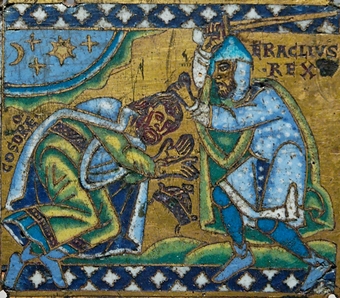
Emperor Heraclius
A plaque depicting Byzantine Emperor Heraclius overcoming Persian King Khosrau II, c. 1160-1170 CE.
The Arab Invasion
By this time, it was generally expected by the Byzantine populace that the emperor would lead Byzantium into a new age of glory. However, all of Heraclius’ achievements would come to naught, when, in 633, the Byzantine-Arab Wars began.
On June 8, 632, the Islamic Prophet Muhammad died of a fever. However, the religion he left behind would transform the Middle East. In 633, the armies of Islam marched out of Arabia with a goal to spread the word of the prophet, with force if needed. In 634, the Arabs defeated a Byzantine force sent into Syria and captured Damascus. The arrival of another large Byzantine army outside Antioch (some 80,000 troops) forced the Arabs to retreat. The Byzantines advanced in May 636. However, a sandstorm blew in against the Byzantines on August 20, 636, and when the Arabs charged against them, they were utterly annihilated.
Jerusalem surrendered to the Arabs in 637, following a stout resistance; in 638, the Caliph Omar rode into the city. Heraclius stopped by Jerusalem to recover the True Cross whilst it was under siege. The Arab invasions are seen by some historians as the start of the decline of the Byzantine Empire. Only parts of Syria and Cilicia would be recovered.
Religious Controversy
The recovery of the eastern areas of the Roman Empire from the Persians during the early phase of Heraclius’ rule raised the problem of religious unity centering on the understanding of the true nature of Christ. Most of the inhabitants of these provinces were Monophysites who rejected the Council of Chalcedon of 451. The Chalcedonian Definition of Christ as being of two natures, divine and temporal, maintains that these two states remain distinct within the person of Christ and yet come together within his one true substance. This position was opposed by the Monophysites, who held that Christ possessed one nature only; the human and divine natures of Christ were fused into one new single (mono) nature. This internal division was dangerous for the Byzantine Empire, which was under constant threat from external enemies, many of whom were in favor of Monophysitism, people on the periphery of the Empire who also considered the religious hierarchy at Constantinople to be heretical and only interested in crushing their faith.
Heraclius tried to unite all of the various factions within the empire with a new formula that was more inclusive and more elastic. With the successful conclusion to the Persian War, Heraclius would devote more time to promoting his compromise.
The patriarch Sergius came up with a formula, which Heraclius released as the Ecthesis in 638. It forbade all mention of Christ possessing one or two energies, that is, one or two wills; instead, it now proclaimed that Christ, while possessing two natures, had but a single will. This approach seemed to be an acceptable compromise, and it secured widespread support throughout the east. The two remaining patriarchs in the east also gave their approval to the doctrine, now referred to as Monothelitism, and so it looked as if Heraclius would finally heal the divisions in the imperial church.
Unfortunately, he had not counted on the popes at Rome. During that same year of 638, Pope Honorius I had died. His successor, Pope Severinus (640), condemned the Ecthesis outright, and so was forbidden his seat until 640. His successor, Pope John IV (640-42), also rejected the doctrine completely, leading to a major schism between the eastern and western halves of the Chalcedonian Church. When news reached Heraclius of the pope’s condemnation, he was already old and ill, and the news only hastened his death, declaring with his dying breath that the controversy was all due to Sergius, and that the patriarch had pressured him to give his unwilling approval to the Ecthesis.
9.2.2: The Theme System
The Byzantine-Arab wars wrought havoc on the Byzantine Dynasty, but led to the creation of the highly efficient military theme system.
Learning Objective
Diagram the Byzantine military and social structure under Heraclius
Key Points
- In the Byzantine-Arab wars of the Heraclian Dynasty, the Arabs nearly destroyed the Byzantine Empire altogether.
- In order to fight back, the Byzantines created a new military system, known as the theme system, in which land was granted to farmers who, in return, would provide the empire with loyal soldiers. The efficiency of this system allowed the dynasty to keep hold of Asia Minor.
- The Arabs were finally repulsed through the use of Greek fire, but Constantinople had decreased massively in size, due to relocation.
- The empire was now poorer and society was dominated by the military, as a result of the many Arab invasions.
Key Terms
- theme system
-
A new military system created during the Heraclian Dynasty of the Byzantine Empire, in which land was granted to farmers who, in return, would provide the empire with loyal soldiers. Similar to the feudal system of medieval western Europe.
- Greek fire
-
A military weapon invented during the Byzantine Heraclian Dynasty; flaming projectiles that could burn while floating on water, and thus could be used for naval warfare.
- cosmopolitan
-
A city/place or person that embraces multicultural demographics.
- Caliphate
-
Islamic state led by a supreme religious and political leader, known as a caliph (i.e., “successor”) to Muhammad and the other prophets of Islam.
The themes (themata in Greek) were the main administrative divisions of the middle Byzantine Empire. They were established in the mid-7th century in the aftermath of the Slavic invasion of the Balkans, and Muslim conquests of parts of Byzantine territory. The themes replaced the earlier provincial system established by Diocletian and Constantine the Great. In their origin, the first themes were created from the areas of encampment of the field armies of the East Roman army, and their names corresponded to the military units that had existed in those areas. The theme system reached its apogee in the 9th and 10th centuries, as older themes were split up and the conquest of territory resulted in the creation of new ones. The original theme system underwent significant changes in the 11th and 12th centuries, but the term remained in use as a provincial and financial circumscription, until the very end of the empire.
Background
During the late 6th and early 7th centuries, the Eastern Roman Empire was under frequent attack from all sides. The successors of Heraclius had to fight a desperate war against the Arabs in order to keep them from conquering the entire Byzantine Empire; these conflicts were known as the Byzantine-Arab wars. The Arab invasions were unlike any other threat the Byzantines ever faced. Fighting a zealous holy war for Islam, the Arabs defeated army after army of the Byzantines, and nearly destroyed the empire. Egypt fell to the Arabs in 642 CE, and Carthage as well in 647 CE, and the Eastern Mediterranean slightly later. From 674-678 CE the Arabs laid siege to Constantinople itself.
In order to survive and fight back, the Byzantines created a new military system, known as the theme system. Abandoning the professional army inherited from the Roman past, the Byzantines granted land to farmers who, in return, would provide the empire with loyal soldiers. This was similar to the feudal system in medieval western Europe, but it differed in one important way—in the Byzantine theme system, the state continued to own the land, and simply leased it in exchange for service, whereas in the feudal system ownership of the lands was given over entirely to vassals. This efficiency of the theme system allowed the dynasty to keep hold of the imperial heartland of Asia Minor.
Thus, by the turning of the 8th century, the themes had become the dominant feature of imperial administration. Their large size and power, however, made their generals prone to revolt, as had been evidenced in the turbulent period 695-715, and would again during the great revolt of Artabasdos in 741-742.
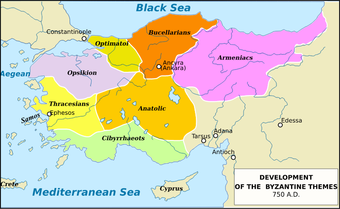
The Theme System
Map depicting the locations of the themes established during the Heraclian Dynasty of the Byzantine Empire.
Despite the prominence of the themes, it was some time before they became the basic unit of the imperial administrative system. Although they had become associated with specific regions by the early 8th century, it took until the end of the 8th century for the civil fiscal administration to begin being organized around them, instead of following the old provincial system. This process, resulting in unified control over both military and civil affairs of each theme by its strategos, was complete by the mid-9th century, and is the “classical” thematic model.
Structure of the Themes
The term theme was ambiguous, referring both to a form of military tenure and to an administrative division. A theme was an arrangement of plots of land given for farming to the soldiers. The soldiers were still technically a military unit, under the command of a strategos, and they did not own the land they worked, as it was still controlled by the state. Therefore, for its use the soldiers’ pay was reduced. By accepting this proposition, the participants agreed that their descendants would also serve in the military and work in a theme, thus simultaneously reducing the need for unpopular conscription, as well as cheaply maintaining the military. It also allowed for the settling of conquered lands, as there was always a substantial addition made to public lands during a conquest.
The commander of a theme, however, did not only command his soldiers. He united the civil and military jurisdictions in the territorial area in question. Thus the division set up by Diocletian between civil governors (praesides) and military commanders (duces) was abolished, and the empire returned to a system much more similar to that of the Republic or the Principate, where provincial governors had also commanded the armies in their area.
Consequences of the Theme System
Early on, Heraclius had proven himself to be an excellent Emperor—his reorganization of the empire into themes allowed the Byzantines to extract as much as they possibly could to increase their military potential. This became essential after 650, when the Islamic Caliphate was far more resourceful and powerful then the Byzantines were. As a result, a high level of efficiency was needed to combat the Arabs, achieved in part due to the theme system.
The Arabs were finally repulsed through the use of Greek fire, flaming projectiles that could burn while floating on water, and thus, could be used for naval warfare. Greek fire was a closely guarded state secret, a secret that has since been lost. The composition of Greek fire remains a matter of speculation and debate, with proposals including combinations of pine resin, naphtha, quicklime, sulfur, or niter. Byzantine use of incendiary mixtures was especially effective, thanks to the use of pressurized nozzles or siphōn to project the liquid onto the enemy. The Arab-Muslim navies eventually adapted to their use. Under constant threat of attack, Constantinople had dropped substantially in size, due to relocation, from 500,000 to 40,000-70,000.
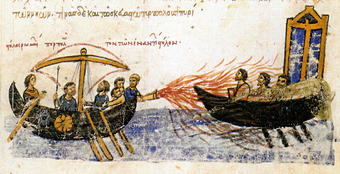
Greek Fire
Image from an illuminated manuscript (the Skylitzes manuscript) showing the Byzantine Navy’s use of Greek fire against the fleet of the rebel Thomas the Slav, c. 12th century CE. The caption above the left ship reads “the fleet of the Romans setting ablaze the fleet of the enemies.”
By the end of the Heraclian Dynasty in 711 CE, the empire had transformed from the Eastern Roman Empire, with its urbanized, cosmopolitan civilization, to the medieval Byzantine Empire, an agrarian, military-dominated society in a lengthy struggle with the Muslims. The loss of the empire’s richest provinces, coupled with successive invasions, had reduced the imperial economy to a relatively impoverished state, compared to the resources available to the Caliphate. The monetary economy persisted, but the barter economy experienced a revival as well. However, this state was also far more homogeneous than the Eastern Roman Empire; the borders had shrunk, such that many of the Latin-speaking territories were lost and the dynasty was reduced to its mostly Greek-speaking territories. This enabled it to weather these storms and enter a period of stability under the next dynasty, the Isaurian Dynasty.
9.2.3: The Isaurian Dynasty
The Isaurian Dynasty is characterized by relative political stability, after an important defeat of the Arabs by Leo III, and Iconoclasm, which resulted in considerable internal turmoil.
Learning Objective
Describe governmental and religious changes that occured during the Isaurian Dynasty
Key Points
- The Isaurian Dynasty, founded by Leo III, was a time of relative stability, compared to the constant warfare against the Arabs that characterized the preceding Heraclian Dynasty.
- However, the Bulgars, a nomadic tribe, rose up in Europe and took some Byzantine lands.
- The Isaurian Dynasty is chiefly associated with Byzantine Iconoclasm, an attempt to restore divine favor by purifying the Christian faith from excessive adoration of icons, which resulted in considerable internal turmoil.
- The Second Arab siege of Constantinople in 717-718 was an unsuccessful offensive by the Muslim Arabs of the Umayyad Caliphate against the capital city of the Byzantine Empire, Constantinople.
- The outcome of the siege was of considerable macrohistorical importance; the Byzantine capital’s survival preserved the empire as a bulwark against Islamic expansion into Europe until the 15th century, when it fell to the Ottoman Turks.
- By the end of the Isaurian Dynasty in 802 CE, the Byzantines were continuing to fight the Arabs and the Bulgars, and the empire had been reduced from a Mediterranean-wide empire to only Thrace and Asia Minor.
Key Terms
- iconoclasm
-
The deliberate destruction within a culture of the culture’s own religious icons and other symbols or monuments, usually for religious or political motives. It is a frequent component of major political or religious changes.
- Bulgars
-
A nomadic tribe related to the Huns; they presented a threat to the Byzantine Empire.
The Byzantine Empire was ruled by the Isaurian or Syrian Dynasty from 717-802. The Isaurian emperors were successful in defending and consolidating the empire against the Caliphate after the onslaught of the early Muslim conquests, but were less successful in Europe, where they suffered setbacks against the Bulgars, had to give up the Exarchate of Ravenna, and lost influence over Italy and the Papacy to the growing power of the Franks.
The Isaurian Dynasty is chiefly associated with Byzantine Iconoclasm, an attempt to restore divine favor by purifying the Christian faith from excessive adoration of icons, which resulted in considerable internal turmoil.
By the end of the Isaurian Dynasty in 802, the Byzantines were continuing to fight the Arabs and the Bulgars for their very existence, with matters made more complicated when Pope Leo III crowned Charlemagne Imperator Romanorum (“Emperor of the Romans”), which was seen as making the Carolingian Empire the successor to the Roman Empire, or at least the western half.
Leo III, who would become the founder of the so-called Isaurian Dynasty, was actually born in Germanikeia in northern Syria c. 685; his alleged origin from Isauria derives from a reference in Theophanes the Confessor, which may be a later addition. After being raised to spatharios by Justinian II, he fought the Arabs in Abasgia, and was appointed as strategos of the Anatolics by Anastasios II. Following the latter’s fall in 716, Leo allied himself with Artabasdos, the general of the Armeniacs, and was proclaimed emperor while two Arab armies campaigned in Asia Minor. Leo averted an attack by Maslamah through clever negotiations, in which he promised to recognize the Caliph’s suzerainty. However, on March 25, 717, he entered Constantinople and deposed Theodosios.
Leo III’s Rule
Having preserved the empire from extinction by the Arabs, Leo proceeded to consolidate its administration, which in the previous years of anarchy had become completely disorganized. In 718, he suppressed a rebellion in Sicily and in 719 did the same on behalf of the deposed Emperor Anastasios II.
Leo secured the empire’s frontiers by inviting Slavic settlers into the depopulated districts, and by restoring the army to efficiency; when the Umayyad Caliphate renewed their invasions in 726 and 739, as part of the campaigns of Hisham ibn Abd al-Malik, the Arab forces were decisively beaten, particularly at Akroinon in 740. His military efforts were supplemented by his alliances with the Khazars and the Georgians.
Leo undertook a set of civil reforms, including the abolition of the system of prepaying taxes, which had weighed heavily upon the wealthier proprietors; the elevation of the serfs into a class of free tenants; and the remodeling of family, maritime law, and criminal law, notably substituting mutilation for the death penalty in many cases. The new measures, which were embodied in a new code called the Ecloga (Selection), published in 726, met with some opposition on the part of the nobles and higher clergy. The emperor also undertook some reorganization of the theme structure by creating new themata in the Aegean region.
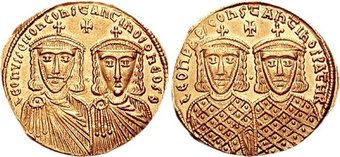
Byzantine Coin
A gold coin, or solidus, engraved with the emperors of the Byzantine Isaurian Dynasty, from c. 780 CE. Left: Leo IV with his son Constantine VI; Right: Leo III with his son Constantine V on the reverse.
The Siege of Constantinople
The Second Arab siege of Constantinople in 717-718 was a combined land and sea offensive by the Muslim Arabs of the Umayyad Caliphate against the capital city of the Byzantine Empire, Constantinople. The campaign marked the culmination of twenty years of attacks and progressive Arab occupation of the Byzantine borderlands, while Byzantine strength was sapped by prolonged internal turmoil. In 716, after years of preparations, the Arabs, led by Maslama ibn Abd al-Malik, invaded Byzantine Asia Minor. The Arabs initially hoped to exploit Byzantine civil strife, and made common cause with the general Leo III the Isaurian, who had risen up against Emperor Theodosius III. Leo, however, tricked them and secured the Byzantine throne for himself.
After wintering in the western coastlands of Asia Minor, the Arab army crossed into Thrace in early summer 717 and built siege lines to blockade the city, which was protected by the massive Theodosian Walls. The Arab fleet, which accompanied the land army and was meant to complete the city’s blockade by sea, was neutralized soon after its arrival by the Byzantine navy through the use of Greek fire. This allowed Constantinople to be resupplied by sea, while the Arab army was crippled by famine and disease during the unusually hard winter that followed. In spring 718, two Arab fleets sent as reinforcements were destroyed by the Byzantines after their Christian crews defected, and an additional army sent overland through Asia Minor was ambushed and defeated. Coupled with attacks by the Bulgars on their rear, the Arabs were forced to lift the siege on August 15, 718. On its return journey, the Arab fleet was almost completely destroyed by natural disasters and Byzantine attacks.
The Arab failure was chiefly logistical, as they were operating too far from their Syrian bases, but the superiority of the Byzantine navy through the use of Greek fire, the strength of Constantinople’s fortifications, and the skill of Leo III in deception and negotiations, also played important roles.
The siege’s failure had wide-ranging repercussions. The rescue of Constantinople ensured the continued survival of Byzantium, while the Caliphate’s strategic outlook was altered: although regular attacks on Byzantine territories continued, the goal of outright conquest was abandoned. Historians consider the siege to be one of history’s most important battles, as its failure postponed the Muslim advance into Southeastern Europe for centuries. The Byzantine capital’s survival preserved the empire as a bulwark against Islamic expansion into Europe until the 15th century, when it fell to the Ottoman Turks. Along with the Battle of Tours in 732, the successful defense of Constantinople has been seen as instrumental in stopping Muslim expansion into Europe.
9.2.4: Iconoclasm in Byzantium
The Byzantine Iconoclasm was the banning of the worship of religious images, a movement that sparked internal turmoil.
Learning Objective
Understand the reasoning and events that led to iconoclasm
Key Points
- Isaurian Emperor Leo III interpreted his many military failures as a judgment on the empire by God, and decided that it was being judged for the worship of religious images. He banned religious images in about 730 CE, the beginning of the Byzantine Iconoclasm.
- At the Council of Hieria in 754 CE, the Church endorsed an iconoclast position and declared image worship to be blasphemy.
- At the Second Council of Nicaea in 787 CE, the decrees of the previous iconoclast council were reversed and image worship was restored, marking the end of the First Iconoclasm.
- Emperor Leo V instituted a second period of iconoclasm in 814 CE, again possibly motivated by military failures seen as indicators of divine displeasure, but only a few decades later, in 842 CE, icon worship was again reinstated.
Key Terms
- iconoclasm
-
The deliberate destruction within a culture of the culture’s own religious icons and other symbols or monuments.
- Council of Hieria
-
The first church council concerned with religious imagery. On behalf of the church, the council endorsed an iconoclast position and declared image worship to be blasphemy.
- Second Council of Nicaea
-
This council reversed the decrees of the Council of Hieria and restored image worship, marking the end of the First Byzantine Iconoclasm.
Iconoclasm, Greek for “image-breaking,” is the deliberate destruction within a culture of the culture’s own religious icons and other symbols or monuments. Iconoclasm is generally motivated by an interpretation of the Ten Commandments that declares the making and worshipping of images, or icons, of holy figures (such as Jesus Christ, the Virgin Mary, and saints) to be idolatry and therefore blasphemy.
Most surviving sources concerning the Byzantine Iconoclasm were written by the victors, or the iconodules (people who worship religious images), so it is difficult to obtain an accurate account of events. However, the Byzantine Iconoclasm refers to two periods in the history of the Byzantine Empire when the use of religious images or icons was opposed by religious and imperial authorities. The “First Iconoclasm,” as it is sometimes called, lasted between about 730 CE and 787 CE, during the Isaurian Dynasty. The “Second Iconoclasm” was between 814 CE and 842 CE. The movement was triggered by changes in Orthodox worship that were themselves generated by the major social and political upheavals of the seventh century for the Byzantine Empire.
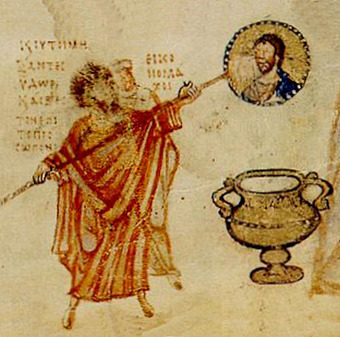
Byzantine Iconoclasm
A depiction of the destruction of a religious image under the Byzantine Iconoclasm, by Chludov Psalter, 9th century CE.
Causes
Traditional explanations for Byzantine Iconoclasm have sometimes focused on the importance of Islamic prohibitions against images influencing Byzantine thought. According to Arnold J. Toynbee, for example, it was the prestige of Islamic military successes in the 7th and 8th centuries that motivated Byzantine Christians to adopt the Islamic position of rejecting and destroying idolatrous images. The role of women and monks in supporting the veneration of images has also been asserted. Social and class-based arguments have been put forward, such as the assertion that iconoclasm created political and economic divisions in Byzantine society, and that it was generally supported by the eastern, poorer, non-Greek peoples of the empire who had to constantly deal with Arab raids. On the other hand, the wealthier Greeks of Constantinople, and also the peoples of the Balkan and Italian provinces, strongly opposed iconoclasm. In recent decades in Greece, iconoclasm has become a favorite topic of progressive and Marxist historians and social scientists, who consider it a form of medieval class struggle and have drawn inspiration from it. Re-evaluation of the written and material evidence relating to the period of Byzantine Iconoclasm by scholars, including John Haldon and Leslie Brubaker, has challenged many of the basic assumptions and factual assertions of the traditional account.
The First Iconoclasm: Leo III
The seventh century had been a period of major crisis for the Byzantine Empire, and believers had begun to lean more heavily on divine support. The use of images of the holy increased in Orthodox worship, and these images increasingly came to be regarded as points of access to the divine. Leo III interpreted his many military failures as a judgment on the empire by God, and decided that they were being judged for their worship of religious images.
Emperor Leo III, the founder of the Isaurian Dynasty, and the iconoclasts of the eastern church, banned religious images in about 730 CE, claiming that worshiping them was heresy; this ban continued under his successors. He accompanied the ban with widespread destruction of religious images and persecution of the people who worshipped them.
The western church remained firmly in support of the use of images throughout the period, and the whole episode widened the growing divergence between the eastern and western traditions in what was still a unified church, as well as facilitating the reduction or removal of Byzantine political control over parts of Italy.
Leo died in 741 CE, and his son and heir, Constantine V, furthered his views until the end of his own rule in 775 CE. In 754 CE, Constantine summoned the first ecumenical council concerned with religious imagery, the Council of Hieria; 340 bishops attended. On behalf of the church, the council endorsed an iconoclast position and declared image worship to be blasphemy. John of Damascus, a Syrian monk living outside Byzantine territory, became a major opponent of iconoclasm through his theological writings.
The Brief Return of Icon Worship
After the death of Constantine’s son, Leo IV (who ruled from 775 CE-780 CE), his wife, Irene, took power as regent for her son, Constantine VI (who ruled from 780 CE-97 CE). After Leo IV too died, Irene called another ecumenical council, the Second Council of Nicaea, in 787 CE, that reversed the decrees of the previous iconoclast council and restored image worship, marking the end of the First Iconoclasm. This may have been an attempt to soothe the strained relations between Constantinople and Rome.
The Second Iconoclasm (814 CE-842 CE)
Emperor Leo V the Armenian instituted a second period of Iconoclasm in 814 CE, again possibly motivated by military failures seen as indicators of divine displeasure. The Byzantines had suffered a series of humiliating defeats at the hands of the Bulgarian Khan Krum. It was made official in 815 CE at a meeting of the clergy in the Hagia Sophia. But only a few decades later, in 842 CE, the regent Theodora again reinstated icon worship.
9.2.5: The Emperor Irene
Irene of Athens, the first woman emperor of the Byzantine Empire, fought for recognition as imperial leader throughout her rule, and is best known for ending the First Iconoclasm in the Eastern Church.
Learning Objective
Analyze the significance of Emperor Irene
Key Points
- Irene of Athens was an orphan from a noble family, and was married to the son of the current emperor, Leo IV, in 768.
- When Leo died in 780, Irene became regent for their nine-year-old son, Constantine, who was too young to rule as emperor, thereby giving her administrative control over the empire.
- As imperial regent, Irene subdued rebellions and fought the Arabs with mixed success. She also ended the First Iconoclasm in the Eastern Church.
- When Constantine became old enough to become emperor proper, he eventually rebelled against Irene, although he let her keep the title of empress.
- Soon after, Irene organized her own rebellion and eventually killed her son, thereby claiming sole rulership over the empire as empress, the first woman to have that title in the empire.
- Although it is often asserted that, as monarch, Irene called herself “emperor” rather than “empress,” in fact she used “empress” in most of her documents, coins, and seals.
- The pope would not recognize a woman as ruler, and in 800, crowned Charlemagne as imperial ruler over the entire Roman territory, including Byzantium.
- Charlemagne did not attempt to rule Byzantium, but relations between the two empires remained difficult.
- Irene was eventually deposed by her finance minister.
Key Terms
- regent
-
A person appointed to administer a state because the monarch is a minor, is absent, or is incapacitated.
- strategos
-
A military governor in the Byzantine Empire.
- Iconoclasm
-
The destruction of religious icons, and other images or monuments, for religious or political motives.
Irene of Athens (c. 752-803 CE) was Byzantine empress from 797 to 802. Before that, Irene was empress consort from 775 to 780, and empress dowager and regent from 780 to 797. She is best known for ending iconoclasm.
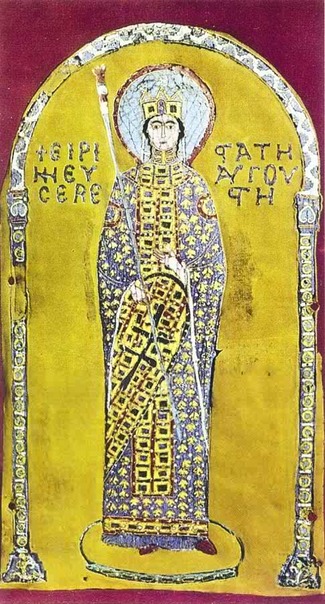
Empress Irene
Image from “Pala d’Oro,” Venice, c. 10th century.
Early Life
Irene was related to the noble Greek Sarantapechos family of Athens. Although she was an orphan, her uncle or cousin, Constantine Sarantapechos, was a patrician and was possibly the strategos of the theme of Hellas at the end of the 8th century. She was brought to Constantinople by Emperor Constantine V on November 1, 768, and was married to his son, Leo IV, on December 17.
On 14 January 771, Irene gave birth to a son, the future Constantine VI. When Constantine V died in September 775, Leo succeeded to the throne at the age of twenty-five years. Leo, though an iconoclast, pursued a policy of moderation towards iconodules, but his policies became much harsher in August 780, when a number of courtiers were punished for venerating icons. According to tradition, he discovered icons concealed among Irene’s possessions and refused to share the marriage bed with her thereafter. Nevertheless, when Leo died on September 8, 780, Irene became regent for their nine-year-old son, Constantine, thereby giving her administrative control over the empire.
Regency
Irene was almost immediately confronted with a conspiracy that tried to raise Caesar Nikephoros, a half-brother of Leo IV, to the throne. To overcome this challenge, she had Nikephoros and his co-conspirators ordained as priests, a status which disqualified them from ruling.
As early as 781, Irene began to seek a closer relationship with the Carolingian Dynasty and the Papacy in Rome. She negotiated a marriage between her son, Constantine, and Rotrude, a daughter of Charlemagne by his third wife, Hildegard. During this time, Charlemagne was at war with the Saxons, and would later become the new king of the Franks. Irene went as far as to send an official to instruct the Frankish princess in Greek; however, Irene herself broke off the engagement in 787, against her son’s wishes.
Irene next had to subdue a rebellion led by Elpidius, the strategos of Sicily. Irene sent a fleet, which succeeded in defeating the Sicilians. Elpidius fled to Africa, where he defected to the Abbasid Caliphate. After the success of Constantine V’s general, Michael Lachanodrakon, who foiled an Abbasid attack on the eastern frontiers, a huge Abbasid army under Harun al-Rashid invaded Anatolia in summer 782. The strategos of the Bucellarian Theme, Tatzates, defected to the Abbasids, and Irene, in exchange for a three-year truce, had to agree to pay an annual tribute of 70,000 or 90,000 dinars to the Abbasids, give them 10,000 silk garments, and provide them with guides, provisions, and access to markets during their withdrawal.
Ending Iconoclasm
Irene’s most notable act was the restoration of the veneration of icons, thereby ending the First Iconoclasm of the Eastern Church. Having chosen Tarasios, one of her partisans and her former secretary, as Patriarch of Constantinople in 784, she summoned two church councils. The first of these, held in 786 at Constantinople, was frustrated by the opposition of the iconoclast soldiers. The second, convened at Nicaea in 787, formally revived the veneration of icons and reunited the Eastern Church with that of Rome.
While this greatly improved relations with the Papacy, it did not prevent the outbreak of a war with the Franks, who took over Istria and Benevento in 788. In spite of these reverses, Irene’s military efforts met with some success: in 782 her favored courtier, Staurakios, subdued the Slavs of the Balkans and laid the foundations of Byzantine expansion and re-Hellenization in the area. Nevertheless, Irene was constantly harried by the Abbasids, and in 782 and 798, had to accept the terms of the respective Caliphs Al-Mahdi and Harun al-Rashid.
Rule as Empress
As Constantine approached maturity, he began to grow restless under her autocratic sway. An attempt to free himself by force was met and crushed by the empress, who demanded that the oath of fidelity should thenceforward be taken in her name alone. The discontent that this occasioned swelled in 790 into open resistance, and the soldiers, headed by the army of the Armeniacs, formally proclaimed Constantine VI as the sole ruler.
A hollow semblance of friendship was maintained between Constantine and Irene, whose title of empress was confirmed in 792; however, the rival factions remained, and in 797, Irene, by cunning intrigues with the bishops and courtiers, organized a conspiracy on her own behalf. Constantine could only flee for aid to the provinces, but even there participants in the plot surrounded him. Seized by his attendants on the Asiatic shore of the Bosphorus, Constantine was carried back to the palace at Constantinople. His eyes were gouged out, and according to most contemporary accounts, he died from his wounds a few days later, leaving Irene to be crowned as first empress regnant of Constantinople.
As empress, Irene made determined efforts to stamp out iconoclasm everywhere in the empire, including within the ranks of the army. During Irene’s reign, the Arabs were continuing to raid into and despoil the small farms of the Anatolian section of the empire. These small farmers of Anatolia owed a military obligation to the Byzantine throne. Indeed, the Byzantine army and the defense of the empire was largely based on this obligation and the Anatolian farmers. The iconodule (icon worship) policy drove these farmers out of the army, and thus off their farms. Thus, the army was weakened and was unable to protect Anatolia from the Arab raids. Many of the remaining farmers of Anatolia were driven from the farm to settle in the city of Byzantium, further reducing the army’s ability to raise soldiers. Additionally, the abandoned farms fell from the tax rolls and reduced the amount of income that the government received. These farms were taken over by the largest land owner in the Byzantine Empire, the monasteries. To make the situation even worse, Irene had exempted all monasteries from all taxation.
Given the financial ruin into which the empire was headed, it was no wonder, then, that Irene was, eventually, deposed by her own minister of finance. The leader of this successful revolt against Irene replaced her on the Byzantine throne under the name Nicephorus I.
Although it is often asserted that, as monarch, Irene called herself “basileus” (emperor), rather than “basilissa” (empress), in fact there are only three instances where it is known that she used the title “basileus“: two legal documents in which she signed herself as “Emperor of the Romans,” and a gold coin of hers found in Sicily bearing the title of “basileus.” She used the title “basilissa” in all other documents, coins, and seals.
Relationship with the Carolingian Empire
Irene’s unprecedented position as an empress ruling in her own right was emphasized by the coincidental rise of the Carolingian Empire in western Europe, which rivaled Irene’s Byzantium in size and power. In 800, Charlemagne was crowned emperor by Pope Leo III, on Christmas Day. The clergy and nobles attending the ceremony proclaimed Charlemagne as “Emperor of the Roman Empire.” In support of Charlemagne’s coronation, some argued that the imperial position was actually vacant, deeming a woman unfit to be emperor. However, Charlemagne made no claim to the Byzantine Empire. Relations between the two empires remained difficult.
9.3: The Late Byzantine Empire
9.3.1: The Macedonian Dynasty
The Macedonian Dynasty saw expansion and the Byzantine Renaissance, but also instability, due to competition among nobles in the theme system.
Learning Objective
Discuss hegemony under the Macedonian Dynasty
Key Points
- Shortly after the extended controversy over the Byzantine Iconoclasm, the Byzantine Empire would recover under the Macedonian Dynasty, starting in 867 CE.
- The Macedonian Dynasty saw the Byzantine Renaissance, a time of increased interest in classical scholarship and the assimilation of classical motifs into Christian artwork.
- The empire also expanded during this period, conquering Crete, Cyprus, and most of Syria.
- However, the Macedonian Dynasty also saw increasing dissatisfaction and competition for land among nobles in the theme system, which weakened the authority of the emperors and led to instability.
Key Term
- Byzantine Renaissance
-
The time during the Macedonian Dynasty when art, literature, science, and philosophy flourished.
Emperor Basil I
Shortly after the extended controversy over iconoclasm, which more or less ended (at least in the east) with the regent Theodora reinstating icon worship in 842 CE, Emperor Basil I founded a new dynasty, the Macedonian Dynasty, in 867 CE. Basil was born a simple peasant in the Byzantine theme of Macedonia; he rose in the Imperial Court, and usurped the imperial throne from Emperor Michael III (r. 842-867). Despite his humble origins, he showed great ability in running the affairs of state, leading to a revival of imperial power and a renaissance of Byzantine art. He was perceived by the Byzantines as one of their greatest emperors, and the Macedonian Dynasty ruled over what is regarded as the most glorious and prosperous era of the Byzantine Empire.
It was under this dynasty that the Byzantine Empire would recover from its previous turmoil, and become the most powerful state in the medieval world. This was also a period of cultural and artistic flowering in the Byzantine world. The cities of the empire expanded, and affluence spread across the provinces because of the new-found security. The population rose, and production increased, stimulating new demand, while also helping to encourage trade. The iconoclast movement experienced a steep decline; the decline was advantageous to the emperors who had softly suppressed iconoclasm, and to the reconciliation of the religious strife that had drained the imperial resources in the previous centuries.
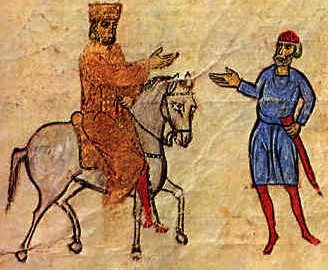
Emperor Basil I
A depiction of Byzantine Emperor Basil I, of the Macedonian Dynasty, on horseback.
Macedonian Renaissance
The time of the Macedonian Dynasty’s rule over the Byzantine Empire is sometimes called the Byzantine Renaissance or the Macedonian Renaissance. A long period of military struggle for survival had recently dominated the life of the Byzantine Empire, but the Macedonians ushered in an age when art and literature once again flourished. The classical Greco-Roman heritage of Byzantium was central to the writers and artists of the period. Byzantine scholars, most notably Leo the Mathematician, read the scientific and philosophical works of the ancient Greeks and expanded upon them. Artists adopted their naturalistic style and complex techniques from ancient Greek and Roman art, and mixed them with Christian themes. Byzantine painting from this period would have a strong influence on the later painters of the Italian Renaissance.
Political and Religious Expansion
The Macedonian Dynasty also oversaw the expansion of the Byzantine Empire, which went on the offensive against its enemies. For example, Emperor Nikephoros II Phokas (who ruled from 912 CE-969 CE) pursued an aggressive policy of expansion. Before rising to the throne, he had conquered Crete from the Muslims, and as emperor he led the conquest of Cyprus and most of Syria.
The Macedonian period also included events of momentous religious significance. The conversion of the Bulgarians, Serbs, and Rus’ to Orthodox Christianity permanently changed the religious map of Europe, and still impacts demographics today. Cyril and Methodius, two Byzantine Greek brothers, contributed significantly to the Christianization of the Slavs, and in the process devised the Glagolitic alphabet, ancestor to the Cyrillic script.
Throughout this period there was great competition among nobles for land in the theme system. Since such governors could collect taxes and control the military forces of their themes, they became independent of the emperors and acted independently, weakening the authority of the emperors. They tended to increase taxes on small farmers in order to enrich themselves, thereby causing massive dissatisfaction.
9.3.2: The Great Schism of 1054
The centuries-long gradual religious separation between the Eastern and Western Roman Empires culminated in the institutional separation known as the East-West Schism.
Learning Objective
Identify the consequences of the East-West Schism
Key Points
- By the turn of the millennium, the Eastern and Western Roman Empires had been gradually separating along religious fault lines for centuries. A separation in the Roman world can be marked with the construction of Constantine The Great’s New Rome in Byzantium.
- The Byzantine Iconoclasm, in particular, widened the growing divergence and tension between east and west—the Western Church remained firmly in support of the use of religious images—though the church was still unified at this time.
- In response, the pope in the west declared a new emperor in Charlemagne, solidifying the rift and causing outrage in the east. The empire in the west became known as the Holy Roman Empire.
- Finally, 1054 CE saw the East-West Schism: the formal declaration of institutional separation between east, into the Orthodox Church (now Eastern Orthodox Church), and west, into the Catholic Church (now Roman Catholic Church).
Key Terms
- East-West Schism
-
The formal institutional separation in 1054 CE between the Eastern Church of the Byzantine Empire (into the Orthodox Church, now called the Eastern Orthodox Church) and the Western Church of the Holy Roman Empire (into the Catholic Church, now called the Roman Catholic Church).
- Iconoclasm
-
The destruction or prohibition of religious icons and other images or monuments for religious or political motives.
The East-West Schism, also called the Great Schism and the Schism of 1054, was the break of communion between what are now the Eastern Orthodox and Catholic churches, which has lasted since the 11th century.
The ecclesiastical differences and theological disputes between the Greek east and Latin west pre-existed the formal rupture that occurred in 1054. Prominent among these were the issues of the source of the Holy Spirit, whether leavened or unleavened bread should be used in the Eucharist, the Bishop of Rome’s claim to universal jurisdiction, and the place of the See of Constantinople in relation to the Pentarchy.
Tensions Between East and West
By the turn of the millennium, the Eastern and Western Roman Empires had been gradually separating along religious fault lines for centuries, beginning with Emperor Leo III’s pioneering of the Byzantine Iconoclasm in 730 CE, in which he declared the worship of religious images to be heretical. The Western Church remained firmly in support of the use of religious images. Leo tried to use military force to compel Pope Gregory III, but he failed, and the pope condemned Leo’s actions. In response, Leo confiscated papal estates and placed them under the governance of Constantinople.
Therefore, the Iconoclasm widened the growing divergence and tension between east and west, though the church was still unified at this time. It also decisively ended the so-called Byzantine Papacy, under which, since the reign of Justinian I a century before, the popes in Rome had been nominated or confirmed by the emperor in Constantinople. The deference of the Western Church to Constantinople dissolved, and Rome would maintain a consistently iconodule position (meaning it supports or is in favor of religious images or icons and their veneration).
A New Emperor in the West
Regent Irene convened the Second Council of Nicaea in 787 CE, which temporarily restored image worship, in an attempt to soothe the strained relations between Constantinople and Rome—but it was too late. After Charlemagne, the king of the Franks, saved Rome from a Lombard attack, Pope Leo III (not to be confused with the Byzantine Leo III) declared him the new Roman emperor in 800 CE, since a woman (Irene) could not be emperor. It was also a message that the popes were now loyal to the Franks, who could protect them, instead of the Byzantines, who had only caused trouble. To the Byzantines, this was an outrage, attacking their claim to be the true successors of Rome.
From this point on, the Frankish Empire is usually known as the Holy Roman Empire. With two Roman empires, the Byzantines and the Franks, the authority of the Byzantine Empire was weakened. In the west they were no longer called “Romans,” but “Greeks” (and eventually “Byzantines”). The Byzantines, however, continued to consider themselves Romans, and looked to the patriarch of Constantinople, not the pope, as the most important religious figure of the church.
Crisis and Permanent Schism
The differences in practice and worship between the Church of Rome in the west and the Church of Constantinople in the east only increased over time.
In 1053, the first step was taken in the process that led to formal schism; the Ecumenical Patriarch of Constantinople, Michael I Cerularius, ordered the closure of all Latin churches in Constantinople, in response to the Greek churches in southern Italy having been forced to either close or conform to Latin practices. According to the historian J. B. Bury, Cerularius’ purpose in closing the Latin churches was “to cut short any attempt at conciliation.”
Finally, in 1054 CE, relations between the Eastern and Western traditions within the Christian Church reached a terminal crisis. The papal legate sent by Leo IX traveled to Constantinople for purposes that included refusing to Cerularius the title of “Ecumenical Patriarch,” and insisting that he recognize the Pope’s claim to be the head of all the churches. The main purpose of the papal legation was to seek help from the Byzantine emperor in view of the Norman conquest of southern Italy, and to deal with recent attacks by Leo of Ohrid against the use of unleavened bread and other Western customs, attacks that had the support of Cerularius. Historian Axel Bayer contends that the legation was sent in response to two letters, one from the emperor seeking assistance in arranging a common military campaign by the Eastern and Western Empires against the Normans, and the other from Cerularius. On the refusal of Cerularius to accept the demand, the leader of the legation, Cardinal Humbert of Silva Candida, excommunicated him, and in return Cerularius excommunicated Humbert and the other legates. This was only the first act in a centuries-long process that eventually became a complete schism.
The gradual separation of the last several centuries culminated in a formal declaration of institutional separation between east, into the Orthodox Church (now Eastern Orthodox Church), and west, into the Catholic Church (now Roman Catholic Church). This was known as the East-West Schism.
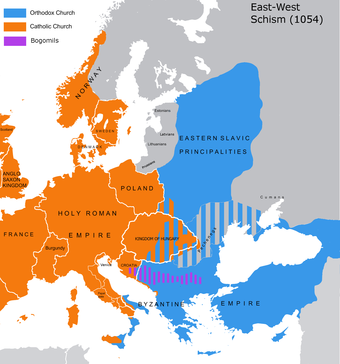
The East-West Schism
The religious distribution after the East-West Schism between the churches of the Byzantine Empire and the Holy Roman Empire in 1054 CE.
The church split along doctrinal, theological, linguistic, political, and geographical lines, and the fundamental breach has never been healed, with each side sometimes accusing the other of having fallen into heresy and of having initiated the division. Conflicts over the next several centuries (such as the Crusades, the Massacre of the Latins in 1182 CE, the west’s retaliation in the Sacking of Thessalonica in 1185 CE, the capture and sack of Constantinople in 1204 CE, and the imposition of Latin patriarchs) would only make reconciliation more difficult.
9.3.3: The Byzantine-Bulgarian Wars
The Byzantine Empire had a long and tumultuous relationship with the Bulgar Empire to its north.
Learning Objective
Distinguish between the different threats that the Byzantines faced around the turn of the millennium
Key Points
- The Bulgarian Empire was founded in the 5th century and continued to expand and clash with the Byzantine Empire for centuries.
- During a period of peace, in 864 the Bulgar Empire converted to Christianity and adopted many Byzantine cultural practices.
- Ending 80 years of peace between the two states, the powerful Bulgarian tsar Simeon I invaded in 894, but was pushed back by the Byzantines.
- In 971, John I Tzimiskes, the Byzantine emperor, subjugated much of the weakening Bulgarian Empire.
- In 1185, however, Bulgarians Theodore Peter and Ivan Asen started a revolt, and the weakening Byzantine Empire, facing internal dynastic troubles of its own, was unable to prevent the revolt from being successful.
- In 1396, Bulgaria fell to the Ottoman Turks, and in 1453, Constantinople was captured. Since both became part of the Ottoman Empire, this was the end of the long series of Bulgarian-Byzantine Wars.
Key Terms
- lingua franca
-
A language or dialect systematically used to make communication possible between people who do not share a native language or dialect.
- Bulgarian
-
A South Slavic ethnic group who are native to Bulgaria and neighbouring regions.
The Bulgarian Empire
The First Bulgarian Empire was a medieval Bulgarian state that existed in southeastern Europe between the 7th and 11th centuries CE. It was founded circa 681, when Bulgar tribes led by Asparukh moved to the northeastern Balkans. There they secured Byzantine recognition of their right to settle south of the Danube, by defeating—possibly with the help of local South Slavic tribes—the Byzantine army led by Constantine IV. At the height of its power, Bulgaria spread from the Danube Bend to the Black Sea, and from the Dnieper River to the Adriatic Sea.
As the state solidified its position in the Balkans, it entered into a centuries-long interaction, sometimes friendly and sometimes hostile, with the Byzantine Empire. Bulgaria emerged as Byzantium’s chief antagonist to its north, resulting in several wars. The two powers also enjoyed periods of peace and alliance, most notably during the Second Arab siege of Constantinople, where the Bulgarian army broke the siege and destroyed the Arab army, thus preventing an Arab invasion of southeastern Europe. Byzantium had a strong cultural influence on Bulgaria, which also led to the eventual adoption of Christianity in 864.
After the adoption of Christianity, Bulgaria became the cultural center of Slavic Europe. Its leading cultural position was further consolidated with the invention of the Glagolitic and Early Cyrillic alphabets shortly after in the capital of Preslav, and literature produced in Old Bulgarian soon began spreading north. Old Bulgarian became the lingua franca of much of eastern Europe and it came to be known as Old Church Slavonic. In 927, the fully independent Bulgarian Patriarchate was officially recognized.
The Byzantine-Bulgarian Wars
The Byzantine-Bulgarian Wars were a series of conflicts fought between the Byzantines and Bulgarians, which began when the Bulgars first settled in the Balkan peninsula in the 5th century, and intensified with the expansion of the Bulgarian Empire to the southwest after 680 CE. The Byzantines and Bulgarians continued to clash over the next century with variable success, until the Bulgarians, led by Krum, inflicted a series of crushing defeats on the Byzantines. After Krum died in 814, his son, Omurtag, negotiated a thirty-year peace treaty. The traditional struggle with the See of Rome continued through the Macedonian period, spurred by the question of religious supremacy over the newly Christianized state of Bulgaria. Ending 80 years of peace between the two states, the powerful Bulgarian tsar, Simeon I, invaded in 894 but was pushed back by the Byzantines, who used their fleet to sail up the Black Sea to attack the Bulgarian rear, enlisting the support of the Hungarians. The Byzantines were defeated at the Battle of Boulgarophygon in 896, however, and agreed to pay annual subsidies to the Bulgarians.
In 971 John I Tzimiskes, the Byzantine emperor, subjugated much of the weakening Bulgarian Empire, as it faced wars with Russians, Pechenegs, Magyars and Croatians, and by defeating Boris II and capturing Preslav, the Bulgarian capital. Byzantine Emperor Basil II completely conquered Bulgaria in 1018, as a result of the 1014 Battle of Kleidion. There were rebellions against Byzantine rule from 1040 to 1041, and in the 1070s and the 1080s, but these failed. In 1185, however, Theodore Peter and Ivan Asen started a revolt, and the weakening Byzantine Empire, facing internal dynastic troubles of its own, was unable to prevent the revolt from being successful.
The rebellion failed to immediately capture Bulgaria’s historic capital, Preslav, but established a new capital city at Tărnovo, presumably the center of the revolt. In 1186, the rebels suffered a defeat, but Isaac II Angelos failed to exploit his victory and returned to Constantinople. With the help of the chiefly Cuman population north of the Danube, Peter and Asen recovered their positions and raided into Thrace. When Isaac II Angelos penetrated into Moesia again in 1187, he failed to capture either Tărnovo or Loveč, and he signed a treaty effectively recognizing the Second Bulgarian Empire, but neither side had any intention of keeping the peace.
Fighting continued until 1396, when Bulgaria fell to the Ottoman Turks, and 1453, when Constantinople was captured. Since both became part of the Ottoman Empire, this was the end of the long series of Bulgarian-Byzantine Wars.
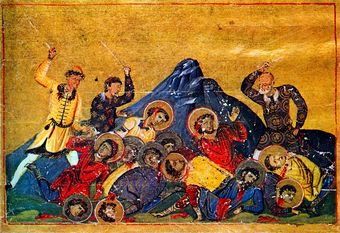
Bulgarians Fighting the Byzantines
A Byzantine painting depicting Bulgarians slaughtering Byzantines, who can be seen with halos on their head.
9.3.4: The Double Disasters
In 1071, the Byzantine Empire suffered two important defeats, against the Turks in the Battle of Manzikert, and against the Normans in Bari. These are sometimes called the Double Disasters.
Learning Objective
Identify the Double Disasters and their consequences
Key Points
- A number of wars between the Normans and the Byzantine Empire were fought from c. 1040 until 1185.
- In 1071, the Byzantines were defeated by the Normans during their conquest of Italy, thereby driving the Byzantines from southern Italy.
- Even more dangerous than the Normans was a new enemy from the steppe: the Turks.
- The Battle of Manzikert was fought between the Byzantine Empire and the Seljuq Turks on August 26, 1071, and proved a decisive defeat of the Byzantine army.
- This defeat and the capture of the emperor Romanos IV Diogenes played an important role in undermining Byzantine authority in Anatolia and Armenia, the heartland of the Byzantine Empire.
Key Terms
- Battle of Manzikert
-
A major battle between the Byzantines and the Turks that ended in a Byzantine defeat and ushered in the decline of the Byzantine Empire.
- Normans
-
The people who in the 10th and 11th centuries gave their name to Normandy, a region in France. They were descended from Norse raiders and pirates from Denmark, Iceland, and Norway who, under their leader Rollo, agreed to swear fealty to King Charles III of West Francia.
The Normans and the Defeat at Bari
A number of wars between the Normans and the Byzantine Empire were fought from 1040 until 1185, when the last Norman invasion of Byzantine territory was defeated. At the end of the conflict, neither the Normans nor the Byzantines could boast much power. A Byzantine defeat in 1071 proved decisive for the disintegration and collapse of the empire.
The Normans had come from the Duchy of Normandy in West Francia, which in 911 had been granted to the Viking Rollo in the Treaty of Saint-Clair-sur-Epte by the French king Charles the Simple. The Normans and their new land took the name of these “Northmen.” During the time that the Normans had conquered southern Italy, and the Byzantine Empire was in a state of internal decay; the administration of the empire had been wrecked, and the efficient government institutions that provided Basil II with a quarter of a million troops and adequate resources by taxation had collapsed within a period of three decades. Attempts by Isaac I Komnenos and Romanos IV Diogenes to reverse the situation proved unfruitful. The premature death of the former, and the overthrow of the latter, led to further collapse as the Normans consolidated their conquest of Sicily and Italy.
Reggio Calabria, the capital of the tagma of Calabria, was captured by Robert Guiscard in 1060. At the time, the Byzantines held a few coastal towns in Apulia, including the capital of the catepanate of Italy, Bari. Otranto was besieged and fell in October 1068; in the same year, the Normans besieged Bari itself, and, after defeating the Byzantines in a series of battles in Apulia, and after any attempt of relief had failed, the city surrendered in April 1071, ending the Byzantine presence in southern Italy.
The Norman adventurer Robert Guiscard allied with the pope to drive the remaining Byzantines from southern Italy and replace them with a Roman Catholic Norman Kingdom. Guiscard was incredibly successful, and he turned his eye to conquering the entire Byzantine Empire. He crossed over into Greece, pillaged the countryside, and defeated the Byzantine army at the Battle of Dyrrhachium in 1081 CE. He died before he could complete his conquests, but southern Italy would never again be ruled by the Byzantine Empire.
The Turks and the Defeat at Manzikert
Even more dangerous than the Normans was a new enemy from the steppe, the Turks. These former pastoral nomads converted to Islam and ushered in a new phase of Islamic conquests. While the Normans were pillaging Italy, the Turks invaded Asia Minor. Emperor Romanos Diogenes moved the Byzantine army to meet them. At the Battle of Manzikert in 1071 CE, the Byzantine army was totally wiped out by the Turks. It was perhaps the most severe military disaster in Byzantine history. With this defeat, Anatolia fell into the hands of the Turks. Anatolia had been the heartland of the Byzantine Empire, the home of most of its soldiers and farmers. This defeat at Manzikert meant that the theme system, which had effectively supplied Byzantium with its army, was destroyed. The Byzantine Empire was now vulnerable to conquest.
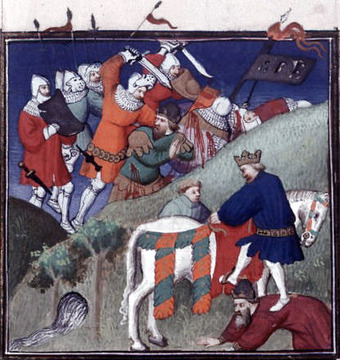
Battle of Manzikert
In this 15th-century French miniature depicting the Battle of Manzikert, the combatants are clad in contemporary western European armor.
The brunt of the battle was borne by the professional soldiers from the eastern and western tagmata, as large numbers of mercenaries and Anatolian levies fled early and survived the battle. The fallout from Manzikert was disastrous for the Byzantines, resulting in civil conflicts and an economic crisis that severely weakened the Byzantine Empire’s ability to adequately defend its borders. This led to the mass movement of Turks into central Anatolia—by 1080, an area of 78,000 square kilometers (30,000 sq. miles) had been gained by the Seljuk Turks. It took three decades of internal strife before Alexius I (1081 to 1118) restored stability to Byzantium. Historian Thomas Asbridge says, “In 1071, the Seljuqs crushed an imperial army at the Battle of Manzikert (in eastern Asia Minor), and though historians no longer consider this to have been an utterly cataclysmic reversal for the Greeks, it still was a stinging setback.” It was the first time in history a Byzantine emperor had become the prisoner of a Muslim commander.
Years and decades later, Manzikert came to be seen as a disaster for the empire; later sources, therefore, greatly exaggerate the numbers of troops and the number of casualties. Byzantine historians would often look back and lament the “disaster” of that day, pinpointing it as the moment the decline of the empire began. It was not an immediate disaster, but the defeat showed the Seljuks that the Byzantines were not invincible—they were not the unconquerable, millennium-old Roman Empire (as both the Byzantines and Seljuks still called it). The usurpation of Andronikos Doukas also politically destabilized the empire, and it was difficult to organize resistance to the Turkish migrations that followed the battle.
9.3.5: Crisis and Fragmentation
Tensions between eastern and western European powers boiled over during the Komnenian Dynasty; the west destroyed Constantinople and, with it, the Byzantine Empire.
Learning Objective
Analyze the relationship between the Holy Roman Empire and the Byzantine Empire
Key Points
- The Komnenian Dynasty saw a restoration of the empire after the disastrous defeat by the Turks. But, for the first time, the Byzantines had to look to the estranged western Europe for help.
- The west came to the aid of the east, but tensions mounted between them until 1182 CE, when riots escalated into a massacre of tens of thousands of Latins.
- Two decades later, western European knights sacked Constantinople in the Fourth Crusade. This was a disaster for the Byzantine Empire, which for all purposes ceased to exist.
- The leaders of several states fought over who would become the new Byzantine emperor and regain control; the Empire of Nicaea won.
Key Term
- First Crusade
-
The 1095 CE campaign begun by the pope in the Holy Roman Empire to win back Jerusalem from the Muslims.
The Komnenian Dynasty: Cooperation with the Holy Roman Empire
In 1081 CE, with the attacks from the Normans and Turks reaching their height, a new emperor, Alexios I, came to the throne. His dynasty, the Komnenian Dynasty, would oversee a restoration of the empire after these disasters. But for the first time, the Byzantines would have to look west for help, to their estranged fellow Christians in western Europe. Although western Europe had a history of religious disagreements with the Byzantines, they now realized that the Byzantine Empire was all that was holding back the Muslims from invading Europe.
Having achieved stability in the west, Alexios could turn his attention to the severe economic difficulties and the disintegration of the empire’s traditional defenses. However, he still did not have enough manpower to recover the lost territories in Asia Minor, and to advance against the Seljuks. At the Council of Piacenza in 1095, envoys from Alexios spoke to Pope Urban II about the suffering of the Christians of the east, and underscored that without help from the west, they would continue to suffer under Muslim rule.
Urban saw Alexios’ request as a dual opportunity to cement western Europe and reunite the Eastern Orthodox Churches with the Roman Catholic Church under his rule. On November 27, 1095, Pope Urban II called together the Council of Clermont, and urged all those present to take up arms under the sign of the cross, and launch an armed pilgrimage to recover Jerusalem and the east from the Muslims. The response in western Europe was overwhelming.
Tensions Mount During the First Crusade
Alexios had anticipated help in the form of mercenary forces from the west, but he was totally unprepared for the immense and undisciplined force which soon arrived in Byzantine territory. It was no comfort to Alexios to learn that four of the eight leaders of the main body of the Crusade were Normans, among them Bohemund.
Relations were rocky from the start. To the Byzantines, the crusaders were dirty, uneducated brutes. To the crusaders, the Byzantines were untrustworthy, over-pampered schemers. Still, they tried to work together. The Byzantines and crusaders agreed that whatever formerly Byzantine lands the crusaders recaptured from the Turks would be returned to Byzantine control. The crusaders went back on this agreement, however, and took the lands for themselves. The crusaders succeeded in conquering Jerusalem in 1099 CE, but the Byzantines had come to regard them as just as big a threat as the Muslims.
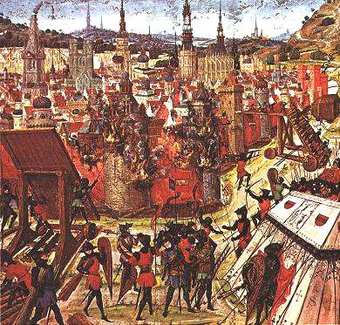
The First Crusade
The capture of Jerusalem in 1099 CE marked the success of western Europe’s First Crusade against the Muslims.
Still, thanks to the Crusades, the Byzantines were able to reassert control of Anatolia. Emperor Alexios created a new system of leasing land in exchange for military service, called the Pronoia System, which was similar to the old theme system. Under his successors, the Byzantines did not win any major victories, but they were able to keep the Turks out of Byzantium’s Anatolian heartland.
At the same time, in order to secure military aid from the western powers, the Byzantine emperors had granted financial and trade concessions to Italy. Large numbers of Italian merchants settled in Constantinople and put the local merchants out of business. Tensions between them and the Byzantines of the city worsened. In 1182 CE, these tensions spilled over into riots and a massacre of Latins (the people from western Europe) by an angry mob. Tens of thousands were killed.
The recent anti-Latin resentment in the empire led to the Crusader states losing their protection from Byzantium. However, while the Crusader states did not rely on Byzantium for protection, the Byzantines certainly did in that it kept the aggressive expansionism of Islam in check.
Western Europe Sacks Constantinople
In 1198 CE, the pope called a new crusade to permanently secure western Europe’s hold on Jerusalem. When the western Europeans arrived at Constantinople in 1204 CE, they found civil war among the Byzantines. In part sparked by the massacre of the Latins of 1182 CE, and in part motivated by the tempting wealth of Constantinople, the western European knights sacked Constantinople, in what is known as the Fourth Crusade. They pillaged the city, carrying away the vast wealth amassed over nine centuries in the Byzantine capital. For this reason, many great examples of Byzantine art can be found today in Venice, especially at St. Mark’s Cathedral. The sack was a disaster for the Byzantine Empire, which for all purposes ceased to exist. The crusaders parceled out Byzantine lands among themselves. Constantinople became the capital of a new empire, called the Latin Empire, ruled by western knights.
Constantinople was considered as a bastion of Christianity that defended Europe from the advancing forces of Islam, and the Fourth Crusade’s sack of the city dealt an irreparable blow to this eastern bulwark. Although the Greeks retook Constantinople after 57 years of Latin rule, the Byzantine Empire had been crippled by the Fourth Crusade.
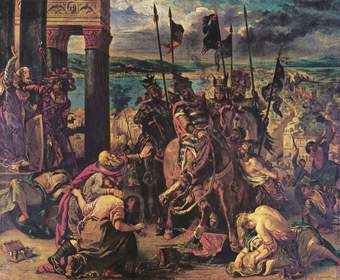
The Fourth Crusade
An oil painting by Eugène Delacroix depicting the arrival of the Fourth Crusade in Constantinople in 1204 CE.
Fragmentation of the Byzantine Empire
The Siege of Constantinople in 1204 CE was a turning point in Byzantine history, but it was not the end. Several members of the Komnenian royal family had been away from the capital at the time of the sack, and they declared their own successor states. Each emperor of these states declared himself to be the rightful Byzantine emperor. They fought each other and the Latins for control of the former lands of the Byzantine Empire. It was the Empire of Nicaea, closest to Constantinople, that would be most successful.
9.3.6: The Last Byzantine Dynasty
Michael VIII recaptured Constantinople and restored the Byzantine Empire, giving rise to the last dynasty of the empire and a brief time of cultural flourishing.
Learning Objective
Identify the role of Michael VIII and the Palaiologos Dynasty
Key Points
- After Constantinople was sacked by the west, and the Byzantine Empire was mostly destroyed with it, Michael VIII of the Empire of Nicaea, a smaller state, claimed the throne and founded the Palaiologos Dynasty, the longest and last dynasty of Byzantine rulers.
- In 1261 CE, Michael’s forces recaptured Constantinople, though it was a shell of its former self, marking the restoration of the Byzantine Empire.
- Michael attempted to end the schism between the Catholic and Orthodox churches, but this outraged many of his citizens, who now hated the Latins of western Europe more than even the Muslims, due to their sacking of Constantinople.
- During the Palaiologan Dynasty, however, the empire experienced the short but vibrant Palaiologan Renaissance, when learning, art, and philosophy flourished.
Key Terms
- Palaiologan Renaissance
-
The short but vibrant period when emperors attempted to restore Constantinople from destruction and encouraged art, philosophy, and education. The attempt at restoring this cultural foundation occurred during the Byzantine Empire’s longest-lived dynasty in Byzantine history. Migration of Byzantine scholars at the end of this period helped to spark the Renaissance in Italy.
- Nicaean Empire
-
The largest of the three Byzantine Greek successor states founded by the aristocracy of the Byzantine Empire that fled after Constantinople was occupied by western European and Venetian forces during the Fourth Crusade.
Background
Following the Fourth Crusade, the Byzantine Empire had fractured into the Greek successor-states of Nicaea, Epirus and Trebizond, with a multitude of Frankish and Latin possessions occupying the remainder, nominally subject to the Latin emperors at Constantinople. In addition, the disintegration of the Byzantine Empire allowed the Bulgarians, the Serbs, and the various Turcoman emirates of Anatolia to make gains. Although Epirus was initially the strongest of the three Greek states, the Nicaeans were the ones who succeeded in taking back the city of Constantinople from the Latin Empire
The Nicaean Empire was successful in holding its own against its Latin and Seljuk opponents. At the Battle of Meander Valley, a Turkic force was repelled and an earlier assault on Nicaea led to the death of the Seljuk Sultan. In the west, the Latins were unable to expand into Anatolia; consolidating Thrace against Bulgaria was a challenge that kept the Latins occupied for the duration of the Latin Empire.
In 1261, the Empire of Nicaea was ruled by John IV Laskaris, a boy of ten years. However, John IV was overshadowed by his co-emperor, Michael VIII Palaiologos. Palaiologos was a leading noble of military standing and the main figure of the regency of John IV, who had used this role to propel himself to the throne, and set the stage for his becoming sole emperor of the restored Byzantine Empire.
Restoration of the Byzantine Empire
In 1259 CE, Michael VIII came to the throne of the Empire of Nicaea. He founded the Palaiologos Dynasty, the longest and last dynasty of Byzantine rulers. In 1261 CE, Michael’s forces succeeded in capturing Constantinople while the Latin knights were off fighting elsewhere. They found the city a shell of its former self, sparsely populated and largely ruined. Still, Michael VIII returned to the city and was proclaimed emperor there, marking the restoration of the Byzantine Empire.
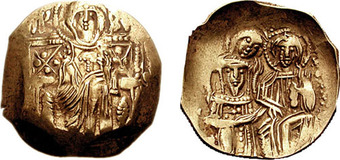
Byzantine Coin
A gold Byzantine coin, called the hyperpyron (which replaced the earlier solidus), depicting the first emperor of the Byzantine Palaiologan Dynasty, Michael VIII.
In order to protect his empire from further attacks by western knights, he attempted to end the schism between the Catholic and Orthodox churches. This outraged many of his citizens, who blamed the Catholics for the sack of Constantinople. A decisive change had taken place: among the citizens of the restored Byzantine Empire, the “Latins” of western Europe were more hated than even the Muslims.
The war-ravaged empire was ill-equipped to deal with the enemies that now surrounded it. In order to maintain his campaigns against the Latins, Michael pulled troops from Asia Minor, and levied crippling taxes on the peasantry, causing much resentment. Massive construction projects were completed in Constantinople to repair the damages of the Fourth Crusade, but none of these initiatives was of any comfort to the farmers in Asia Minor, suffering raids from fanatical ghazis.
As a result, Anatolia, which had formed the very heart of the shrinking empire, was systematically lost to numerous Turkic ghazis, whose raids evolved into conquering expeditions inspired by Islamic zeal. With a decreasing source of food and manpower, the Palaiologoi were forced to fight on several fronts, most of them being Christian states: the Second Bulgarian Empire, the Serbian Empire, the remnants of the Latin Empire, and even the Knights Hospitaller.
The loss of land in the east to the Turks, and in the west to the Bulgarians, was complemented by two disastrous civil wars, the Black Death and the 1354 earthquake at Gallipoli, whose destruction and evacuation allowed the Turks to occupy it. By 1380, the Byzantine Empire consisted of the capital Constantinople and a few other isolated exclaves, which only nominally recognized the emperor as their lord. Nonetheless, Byzantine diplomacy coupled with the adroit exploitation of internal divisions and external threats among their enemies, and above all the invasion of Anatolia by Timur, allowed Byzantium to survive until 1453.
The Palaiologan Renaissance
During the Palaiologan Dynasty, the empire experienced a short but vibrant renaissance, known as the Palaiologan Renaissance. As the Palaiologan emperors attempted to restore the glory of Constantinople, they sponsored art and encouraged philosophy. Artists and philosophers looked to the classical past and rediscovered much ancient learning. Although the Palaiologan Renaissance came too late to save the struggling Byzantine civilization, it would be a major catalyst for the Italian Renaissance, especially as Byzantine artists and scholars traveled to Italy to seek shelter from the new threats that besieged the empire.
Towards the 14th century, as the empire entered into a phase of terminal crisis, such achievements became less valued. All was not lost for these seemingly rejected scholars—many in Italy who had been opened up to Byzantium by the maritime expansions of Genoa and Venice came to appreciate their achievements, facilitating the Renaissance. As such, these scholars found themselves in Italian institutions, expressing their Greco-Roman culture for pay. Immigration to Italy was made less attractive by the idea of abandoning the Orthodox faith to practice Catholicism. Nonetheless, a significant and increasing number of Greeks began traveling to Italy, first temporarily, to Italian colonies such as Crete or Cyprus before returning to Byzantium, then, as the Empire began to fail horribly, in a more permanent manner. The Fall of Constantinople was marked by large amounts of Greek refugees escaping Turkic rule into Europe via Italy, and thus accelerating the Renaissance.
9.3.7: The Fall of Constantinople
The restored Byzantine Empire converted to Catholicism to get aid from the west against the Ottoman Turks, but the Turks defeated them by conquering Constantinople, thereby causing the final collapse of the Byzantines.
Learning Objective
Describe the political situation leading up to the Turkish conquest of the Byzantine Empire
Key Points
- The restored Byzantine Empire was surrounded by enemies. The Bulgarian Empire and the Serbian Empire conquered many Byzantine lands, and the Turks overran Asia Minor altogether.
- Anatolia gradually transformed from a Byzantine Christian land into an Islamic land dominated by the Turks. It would ultimately become the Ottoman Empire.
- The west would only provide the east with help against the Turks if the east converted from Orthodox to Catholic Christianity. This sparked riots among the eastern Orthodox populace, who hated the western Catholics for the sack of Constantinople.
- Meanwhile, the Ottomans defeated most of the empire except for Constantinople.
- The east ultimately capitulated and accepted Catholicism, but it was too late. On May 29, 1453 CE, Constantinople fell to the Ottoman Turks and the Byzantine Empire came to an end. Constantinople was transformed into the Islamic city of Istanbul.
Key Terms
- Ottoman Empire
-
A large empire that began as a Turkish sultanate centered on modern Turkey; founded in the late 13th century, it lasted until the end of World War I. This empire also defeated Constantinople and the Byzantine Empire in 1453 CE.
- Mehmed II
-
An Ottoman sultan who, at the age of 21, conquered Constantinople and brought an end to the Eastern Roman Empire.
The Rise of the Turks and the Ottoman Empire
The restored Byzantine Empire was surrounded by enemies. The Bulgarian Empire, which had rebelled against the Byzantines centuries earlier, now matched it in strength. A new empire arose in the western Balkans, the Serbian Empire, who conquered many Byzantine lands. Even more dangerous to the Byzantines, the Turks were once again raiding Byzantine lands, and Asia Minor was overrun. With the theme system a thing of the past, the emperors had to rely on foreign mercenaries to supply troops, but these soldiers-for-hire were not always reliable. Anatolia gradually transformed from a Byzantine Christian land into an Islamic land dominated by the Turks.
For a long time the Turks in Anatolia were divided up into a patchwork of small Islamic states. However, one ruler, Osman I, built up a powerful kingdom that soon absorbed all the others and formed the Ottoman Empire.
In the century after the death of Osman I, Ottoman rule began to extend over the eastern Mediterranean and the Balkans. Osman’s son, Orhan, captured the city of Bursa in 1324 and made it the new capital of the Ottoman state. The fall of Bursa meant the loss of Byzantine control over northwestern Anatolia. The important city of Thessaloniki was captured from the Venetians in 1387. The Ottoman victory at Kosovo in 1389 effectively marked the end of Serbian power in the region, paving the way for Ottoman expansion into Europe. The Battle of Nicopolis in 1396, widely regarded as the last large-scale crusade of the Middle Ages, failed to stop the advance of the victorious Ottoman Turks. With the extension of Turkish dominion into the Balkans, the strategic conquest of Constantinople became a crucial objective.
The empire controlled nearly all former Byzantine lands surrounding the city, but the Byzantines were temporarily relieved when Timur invaded Anatolia in the Battle of Ankara in 1402. He took Sultan Bayezid I as a prisoner. The capture of Bayezid I threw the Turks into disorder. The state fell into a civil war that lasted from 1402 to 1413, as Bayezid’s sons fought over succession. It ended when Mehmed I emerged as the sultan and restored Ottoman power.
When Mehmed I’s grandson, Mehmed II (also known as Mehmed the Conquerer) ascended to the throne in 1451, he devoted himself to strengthening the Ottoman navy and made preparations for the taking of Constantinople.
Byzantium Looks West for Aid
Against all these enemies, the Byzantines could only look west in search of help. The pope, however, continued to stress that aid would only come if the Byzantines adopted the Catholicism of the Latin church. While the Byzantine emperors were willing to do so in order to save their empire, the populace hated the Catholics for the sack of Constantinople, and so attempts to reconcile with the Catholic Church only led to riots. Further theological disagreements inflamed the bitterness between the Orthodox and the Catholics.
While civil war and religious disputes occupied the Byzantines, the Ottomans slowly closed in on the empire. They crossed into Europe and annexed most of the lands around Constantinople. By 1400 CE, the Byzantine Empire was little more than the city-state of Constantinople. It was clear that the only way they would receive Europe-wide help in pushing back the Ottomans was if they reconciled with the Catholic Church.
This was not acceptable for most Byzantines. A popular saying at the time was “Better the Turkish turban than the Papal tiara.” In other words, the Orthodox Byzantines considered it better to be ruled by the Muslim Turks than to go against their religious beliefs and give in to the Catholic Church. Still, the emperors realized that Byzantium would soon fall without help from the west.
In 1439 CE, Emperor John VIII Palaiologos and the most important Byzantine bishops reached an agreement with the Catholic Church at the Council of Florence, in which they accepted Catholic Christianity. When the bishops returned to the Byzantine Empire, however, they found themselves under attack by their congregations. Their agreement to join the Catholic Church was exceedingly unpopular.
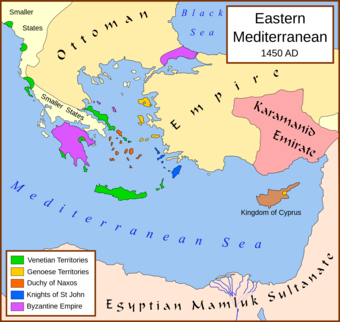
The Rise of the Ottoman Empire
The borders of the Byzantine and Ottoman Empires in the eastern Mediterranean just before the fall of Constantinople in 1453 CE.
The Fall of Constantinople
By this stage, Constantinople was underpopulated and dilapidated. The population of the city had collapsed so severely that it was now little more than a cluster of villages separated by fields. On April 2, 1453, the Ottoman army, led by the 21-year-old Sultan Mehmed II, laid siege to the city with 80,000 men. Despite a desperate last-ditch defense of the city by the massively outnumbered Christian forces (7,000 men, 2,000 of whom were sent by Rome), Constantinople finally fell to the Ottomans after a two-month siege on May 29, 1453. The last Byzantine emperor, Constantine XI Palaiologos, was last seen casting off his imperial regalia and throwing himself into hand-to-hand combat after the walls of the city were taken.
On the third day of the conquest, Mehmed II ordered all looting to stop and sent his troops back outside the city walls. Byzantine historian George Sphrantzes, an eyewitness to the fall of Constantinople, described the Sultan’s actions:
On the third day after the fall of our city, the Sultan celebrated his victory with a great, joyful triumph. He issued a proclamation: the citizens of all ages who had managed to escape detection were to leave their hiding places throughout the city and come out into the open, as they to were to remain free and no question would be asked. He further declared the restoration of houses and property to those who had abandoned our city before the siege, if they returned home, they would be treated according to their rank and religion, as if nothing had changed.
The capture of Constantinople (and two other Byzantine splinter territories soon thereafter) marked the end of the Roman Empire, an imperial state that had lasted for nearly 1,500 years. The Ottoman conquest of Constantinople also dealt a massive blow to Christendom, as the Islamic Ottoman armies thereafter were left unchecked to advance into Europe without an adversary to their rear. After the conquest, Sultan Mehmed II transferred the capital of the Ottoman Empire from Edirne to Constantinople. Constantinople was transformed into an Islamic city: the Hagia Sophia became a mosque, and the city eventually became known as Istanbul.
The conquest of the city of Constantinople, and the end of the Byzantine Empire, was a key event in the Late Middle Ages, which also marks, for some historians, the end of the Middle Ages.
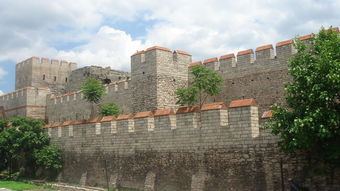
The Walls of Constantinople
Sometimes known as “The Great Wall of Europe,” the walls of Constantinople stood strong for centuries. Yet in 1453, they fell to the Ottoman Turks.
9.3.8: Byzantium’s Legacy
The Byzantine Empire had a lasting legacy in religion, architecture, art, literature, and law.
Learning Objective
Give examples of how the Byzantine Empire continued to have an impact even after its collapse
Key Points
- The Byzantine Empire had lasting legacies on many subsequent cultures.
- The Byzantine Empire insulated Europe from enemies and gave it the time it needed to recover from the chaotic medieval period.
- Byzantium’s role in shaping Orthodoxy was also hugely influential; the modern-day Eastern Orthodox Church is the second largest Christian church in the world.
- Byzantine architecture, particularly in religious buildings, can be found in diverse regions, from Egypt and Arabia to Russia and Romania.
- Byzantine painting from this period would have a strong influence on the later painters of the Italian Renaissance.
Key Term
- lingua franca
-
A common language used by people of diverse backgrounds to communicate with one another; often a basic form of speech with simplified grammar.
Byzantium has been often identified with absolutism, orthodox spirituality, orientalism and exoticism, while the terms “Byzantine” and “Byzantinism” have been used as metaphors for decadence, complex bureaucracy, and repression. Both eastern and western European authors have often perceived Byzantium as a body of religious, political, and philosophical ideas contrary to those of the west. Even in 19th-century Greece, the focus was mainly on the classical past, while Byzantine tradition had been associated with negative connotations.
This traditional approach towards Byzantium has been partially or wholly disputed and revised by modern studies, which focus on the positive aspects of Byzantine culture and legacy. Historian Averil Cameron, for example, regards the Byzantine contribution to the formation of medieval Europe undeniable, and both Cameron and Obolensky recognize the major role of Byzantium in shaping Orthodoxy. The Byzantines also preserved and copied classical manuscripts, and they are thus regarded as transmitters of the classical knowledge, as important contributors to the modern European civilization, and as precursors of both the Renaissance humanism and the Slav Orthodox culture.
Following the conquest of Constantinople by the Ottoman Turks in 1453, Sultan Mehmed II took the title “Kaysar-i Rûm” (the Ottoman Turkish equivalent of Caesar of Rome), since he was determined to make the Ottoman Empire the heir of the Eastern Roman Empire.
Protection of Europe
The Byzantine Empire had kept Greek and Roman culture alive for nearly a thousand years after the fall of the Roman Empire in the west. It had preserved this cultural heritage until it was taken up in the west during the Renaissance. The Byzantine Empire had also acted as a buffer between western Europe and the conquering armies of Islam. Thus, in many ways the Byzantine Empire had insulated Europe and given it the time it needed to recover from its chaotic medieval period.
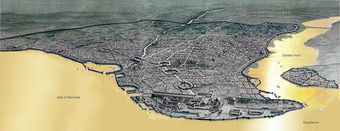
Constantinople in the Byzantine era
An artist-restructured photo of what the city of Constantinople looked like during the Byzantine era.
Religion
Orthodoxy now occupies a central position in the history and societies of Greece, Bulgaria, Russia, Serbia, and other countries. Following the conquest of Constantinople by the Ottoman Turks in 1453 CE, the Ottomans regarded themselves as the “heirs” of Byzantium and preserved important aspects of its tradition, which in turn facilitated an “Orthodox revival” during the post-communist period of the eastern European states. The modern-day Eastern Orthodox Church is the second largest Christian church in the world.
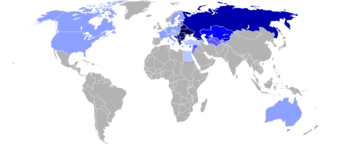
Modern-Day Eastern Orthodoxy
Distribution of Eastern Orthodox Christians in the world by country, as of 2012. Darker blues indicate main religion (over 50%).
Diplomacy and Law
After the fall of Rome, the key challenge to the empire was to maintain a set of relations between itself and its neighbors. When these nations set about forging formal political institutions, they often modeled themselves on Constantinople. Byzantine diplomacy soon managed to draw its neighbors into a network of international and inter-state relations. This network revolved around treaty-making, and included the welcoming of the new ruler into the family of kings, as well as the assimilation of Byzantine social attitudes, values and institutions. The preservation of the ancient civilization in Europe was due to the skill and resourcefulness of Byzantine diplomacy, which remains one of Byzantium’s lasting contributions to the history of Europe.
In the field of law, Justinian I’s reforms to the legal code would come to serve as the basis of not only Byzantine law, but law in many European countries, and continues to have a major influence on public international law to this day. Leo III’s Ecloga influenced the formation of legal institutions in the Slavic world. In the 10th century, Leo VI the Wise achieved the complete codification of the whole of Byzantine law in Greek, which became the foundation of all subsequent Byzantine law, which generates interest to the present day.
Art and Literature
Influences from Byzantine architecture, particularly in religious buildings, can be found in diverse regions, from Egypt and Arabia to Russia and Romania.
During the Byzantine Renaissance of the Macedonian Dynasty, art and literature flourished, and artists adopted a naturalistic style and complex techniques from ancient Greek and Roman art, mixing them with Christian themes. Byzantine painting from this period would have a strong influence on the later painters of the Italian Renaissance.
The migration waves of Byzantine scholars and émigrés in the period following the sacking of Constantinople and the fall of Constantinople in 1453 is considered by many scholars to be key to the revival of Greek and Roman studies that led to the development of the Renaissance in humanism and science. These émigrés were grammarians, humanists, poets, writers, printers, lecturers, musicians, astronomers, architects, academics, artists, scribes, philosophers, scientists, politicians and theologians. They brought to western Europe the far greater preserved and accumulated knowledge of their own (Greek) civilization.
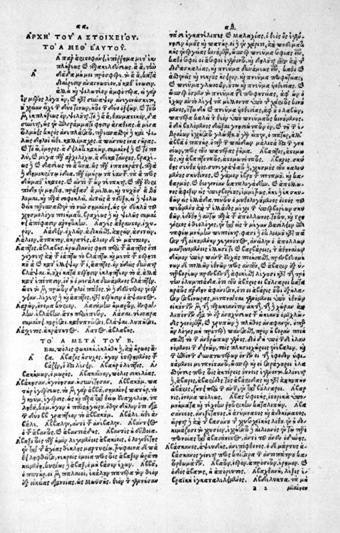
Byzantine Encyclopedia
A page from a 16th-century edition of the vast Byzantine encyclopedia, the Suda.
Chapter 8: The Roman World
8.1: The Etruscans
8.1.1: The Origins of Etruria
The Etruscans were a Mediterranean civilization during the 6th to 3rd century BCE, from whom the Romans derived a great deal of cultural influence.
Learning Objective
Explain the relationship between the Etruscan and Roman civilizations
Key Points
- The prevailing view is that Rome was founded by Italics who later merged with Etruscans. Rome was likely a small settlement until the arrival of the Etruscans, who then established Rome’s urban infrastructure.
- The Etruscans were indigenous to the Mediterranean area, probably stemming from the Villanovan culture.
- The mining and commerce of metal, especially copper and iron, led to an enrichment of the Etruscans, and to the expansion of their influence in the Italian Peninsula and the western Mediterranean Sea. Conflicts with the Greeks led the Etruscans to ally themselves with the Carthaginians.
- The Etruscans governed within a state system, with only remnants of the chiefdom or tribal forms. The Etruscan state government was essentially a theocracy.
- Aristocratic
families were important within Etruscan society, and women enjoyed, comparatively, many freedoms within society. - The
Etruscan system of belief was an immanent polytheism that incorporated
indigenous, Indo-European, and Greek influences. - It is believed that the
Etruscans spoke a non-Indo-European language, probably related to what is
called the Tyrsenian language family, which is itself an isolate family, or in
other words, unrelated directly to other known language groups.
Key Terms
- Etruscan
-
The modern name given to a civilization of ancient Italy in the area corresponding roughly to Tuscany, western Umbria, and northern Latium.
- theocracy
-
A form of government in which a deity is officially recognized as the civil ruler, and official policy is governed by officials regarded as divinely guided, or is pursuant to the doctrine of a particular religion or religious group.
- oligarchic
-
A form of power structure in which power effectively rests with a small number of people. These people could be distinguished by royalty, wealth, family ties, education, corporate, or military control. Such states are often controlled by a few prominent families who typically pass their influence from one generation to the next; however, inheritance is not a necessary condition for the application of this term.
Those who subscribe to an Italic (a diverse group of people who inhabited pre-Roman Italy) foundation of Rome, followed by an Etruscan invasion, typically speak of an Etruscan “influence” on Roman culture; that is, cultural objects that were adopted by Rome from neighboring Etruria. The prevailing view is that Rome was founded by Italics who later merged with Etruscans. In that case, Etruscan cultural objects are not a heritage but are, instead, influences. Rome was likely a small settlement until the arrival of the Etruscans, who then established its initial urban infrastructure.
Origins
The origins of the Etruscans are mostly lost in prehistory. Historians have no literature, and no original texts of religion or philosophy. Therefore, much of what is known about this civilization is derived from grave goods and tomb findings. The main hypotheses state that the Etruscans were indigenous to the region, probably stemming from the Villanovan culture or from the Near East. Etruscan expansion was focused both to the north, beyond the Apennines, and into Campania. The mining and commerce of metal, especially copper and iron, led to an enrichment of the Etruscans, and to the expansion of their influence in the Italian Peninsula and the western Mediterranean Sea. Here, their interests collided with those of the Greeks, especially in the 6th century BCE, when Phoceans of Italy founded colonies along the coast of Sardinia, Spain, and Corsica. This led the Etruscans to ally themselves with the Carthaginians, whose interests also collided with the Greeks.
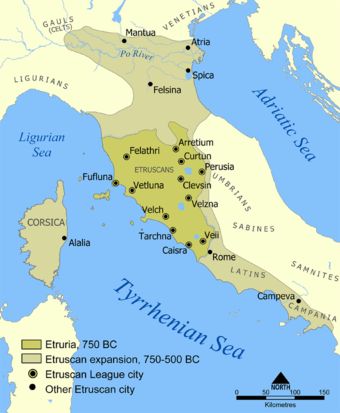
Map of the Etruscan Civilization
Extent of Etruscan civilization and the 12 Etruscan League cities.
Around 540 BCE, the Battle of Alalia led to a new distribution of power in the western Mediterranean Sea. Though the battle had no clear winner, Carthage managed to expand its sphere of influence at the expense of the Greeks, and Etruria saw itself relegated to the northern Tyrrhenian Sea with full ownership of Corsica. From the first half of the 5th century BCE, the new international political situation signaled the beginning of Etruscan decline after they had lost their southern provinces. In 480 BCE, Etruria’s ally, Carthage, was defeated by a coalition of Magna Graecia cities led by Syracuse. A few years later, in 474 BCE, Syracuse’s tyrant, Hiero, defeated the Etruscans at the Battle of Cumae. Etruria’s influence over the cities of Latium and Campania weakened, and it was taken over by the Romans and Samnites. In the 4th century, Etruria saw a Gallic invasion end its influence over the Po valley and the Adriatic coast. Meanwhile, Rome had started annexing Etruscan cities. These events led to the loss of the Northern Etruscan provinces. Etruria was conquered by Rome in the 3rd century BCE.
Etruscan Government
The Etruscans governed using a state system of society, with only remnants of the chiefdom and tribal forms. In this way, they were different from the surrounding Italics. Rome was, in a sense, the first Italic state, but it began as an Etruscan one. It is believed that the Etruscan government style changed from total monarchy to an oligarchic republic (as the Roman Republic did) in the 6th century BCE, although it is important to note this did not happen to all city-states.
The Etruscan state government was essentially a theocracy. The government was viewed as being a central authority over all tribal and clan organizations. It retained the power of life and death; in fact, the gorgon, an ancient symbol of that power, appears as a motif in Etruscan decoration. The adherents to this state power were united by a common religion. Political unity in Etruscan society was the city-state, and Etruscan texts name quite a number of magistrates without explanation of their function (the camthi, the parnich, the purth, the tamera, the macstrev, etc.).
Etruscan Families
According to
inscriptional evidence from tombs, aristocratic families were important within
Etruscan society. Most likely, aristocratic families rose to prominence over
time through the accumulation of wealth via trade, with many of the wealthiest
Etruscan cities located near the coast.
The Etruscan name for
family was lautn, and at the center
of the lautn was the married couple.
Etruscans were monogamous, and the lids of large numbers of sarcophagi were
decorated with images of smiling couples in the prime of their life, often
reclining next to each other or in an embrace. Many tombs also included
funerary inscriptions naming the parents of the deceased, indicating the
importance of the mother’s side of the family in Etruscan society. Additionally,
Etruscan women were allowed considerable freedoms in comparison to Greek and
Roman women, and mixed-sex socialization outside the domestic realm occurred.
Etruscan Religion
The Etruscan system of belief was an immanent polytheism; that is, all visible phenomena were considered to be a manifestation of divine power, and that power was subdivided into deities that acted continually on the world of man and could be dissuaded or persuaded in favor of human affairs. Three layers of deities are evident in the extensive Etruscan art motifs. One appears to be divinities of an indigenous nature: Catha and Usil, the sun; Tivr, the moon; Selvans, a civil god; Turan, the goddess of love; Laran, the god of war; Leinth, the goddess of death; Maris; Thalna; Turms; and the ever-popular Fufluns, whose name is related in an unknown way to the city of Populonia and the populus Romanus, the Roman people.
Ruling over this pantheon of lesser deities were higher ones that seem to reflect the Indo-European system: Tin or Tinia, the sky; Uni, his wife (Juno); and Cel, the earth goddess. In addition the Greek gods were taken into the Etruscan system: Aritimi (Artemis), Menrva (Minerva), and Pacha (Bacchus). The Greek heroes taken from Homer also appear extensively in art motifs.
The Greek polytheistic approach was similar to the Etruscan religious and cultural base. As the Romans emerged from the legacy created by both of these groups, it shared in a belief system of many gods and deities.
Etruscan Language and
Etymology
Knowledge of the Etruscan
language is still far from complete. It is believed that the Etruscans spoke a
non-Indo-European language, probably related to what is called the Tyrsenian
language family, which is itself an isolate family, or in other words,
unrelated directly to other known language groups. No etymology exists for Rasna, the Etruscans’ name for
themselves, though Italian historic linguist, Massimo Pittau, has proposed that
it meant “shaved” or “beardless.” The hypothesized etymology for Tusci, a root for “Tuscan” or “Etruscan,” suggests a connection to the Latin and Greek words for “tower,” illustrating
the Tusci people as those who built
towers. This was possibly based upon the Etruscan preference for building hill towns on
high precipices that were enhanced by walls. The word may also be related to the city of
Troy, which was also a city of towers, suggesting large numbers of migrants
from that region into Etruria.
8.1.2: Etruscan Artifacts
Historians have no literature, or original
Etruscan religious or philosophical texts, on which to base knowledge of their
civilization. So much of what is known is derived from grave goods and tomb
findings.
Learning Objective
Explain the importance of Etruscan artifacts to
our understanding of their history
Key Points
- Princely tombs
did not house individuals, but families who were interred over long periods. - Although many
Etruscan cities were later assimilated by Italic, Celtlic, or Roman ethnic
groups, the Etruscan names and inscriptions that survive within the ruins
provide historic evidence as to the range of settlements that the Etruscans
constructed. -
It is unclear
whether Etruscan cultural objects are influences upon Roman culture or part of
native Roman heritage. The criterion for deciding whether or not an object
originated in Rome or descended to the Romans from the Etruscans is the date of
the object and the opinion of ancient sources regarding the provenance of the object’s
style. - Although Diodorus of Sicily wrote, in the 1st century, of the great
achievements of the Etruscans, little survives or is known of it.
Key Terms
- oligarchic
-
A form of power structure in which power
effectively rests with a small number of people. These people could be
distinguished by royalty, wealth, family ties, education, corporate, or
military control. Such states are often controlled by a few prominent families
who typically pass their influence from one generation to the next, but
inheritance is not a necessary condition for the application of this term. - sarcophagi
-
A box-like funeral receptacle for a corpse, most
commonly carved in stone and displayed above ground.
Historians have no
literature or original Etruscan religious or philosophical texts on which to
base knowledge of their civilization, so much of what is known is derived from
grave goods and tomb findings. Princely tombs did not house individuals, but
families who were interred over long periods. The decorations and objects
included at these sites paint a picture of Etruscan social and political life. For
instance, wealth from trade seems to have supported the rise of aristocratic
families who, in turn, were likely foundational to the Etruscan oligarchic system
of governance. Indeed, at some Etruscan tombs, physical evidence of trade has
been found in the form of grave goods, including fine faience ware cups, which
was likely the result of trade with Egypt. Additionally, the depiction of
married couples on many sarcophagi provide insight into the respect and
freedoms granted to women within Etruscan society, as well as the emphasis
placed on romantic love as a basis for marriage pairings.
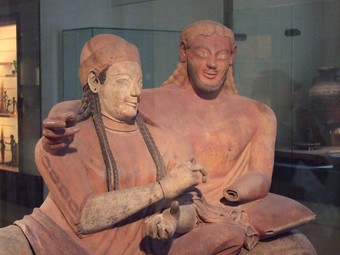
Sarcophagus of the Spouses
Sarcophagus of an Etruscan couple in the Louvre, Room 18.
Although many Etruscan
cities were later assimilated by Italic, Celtic, or Roman ethnic groups, the Etruscan
names and inscriptions that survive within the ruins provide historic evidence of the range of settlements constructed by the Etruscans. Etruscan cities flourished
over most of Italy during the Roman Iron Age. According to ancient sources,
some cities were founded by the Etruscans in prehistoric times, and bore
entirely Etruscan names. Others were later colonized by the Etruscans from
Italic groups.
Nonetheless, relatively little is known about the architecture of the
ancient Etruscans. What is known is that they adapted the native Italic styles
with influence from the external appearance of Greek architecture. Etruscan
architecture is not generally considered part of the body of Greco-Roman
classical architecture. Though the houses of the wealthy were evidently very
large and comfortable, the burial chambers of tombs, and the grave-goods that
filled them, survived in greater numbers. In the southern Etruscan area, tombs contain
large, rock-cut chambers under a tumulus in large necropoli.
There is some debate among
historians as to whether Rome was founded by Italic cultures and then invaded
by the Etruscans, or whether Etruscan cultural objects were adopted
subsequently by Roman peoples. In other words, it is unclear whether Etruscan
cultural objects are influences upon Roman culture, or part of native Roman
heritage. Among archaeologists, the main criteria for deciding whether or not
an object originated in Rome, or descended to the Romans from the Etruscans, is
the date of the object, which is often determined by process of carbon dating.
After this process, the opinion of ancient sources is consulted.
Although Diodorus of Sicily wrote in the 1st century of the great
achievements of the Etruscans, little survives or is known of it. Most Etruscan
script that does survive are fragments of religious and funeral texts. However, it is
evident, from Etruscan visual art, that Greek myths were well known.
8.1.3: Etruscan Religion
The Etruscan belief system was heavily
influenced by other religions in the region, and placed heavy emphasis on the divination
of the gods’ wills to guide human affairs.
Learning Objective
Describe some of the key characteristics of the
Etruscan belief system
Key Points
- The Etruscan system of belief was an immanent polytheism, meaning
all visible phenomena were considered to be a manifestation of divine power, and
that power was subdivided into deities that acted continually on the world of
man. - The Etruscan scriptures were a corpus
of texts termed the Etrusca Disciplina,
a set of rules for the conduct of all divination. - Three layers of deities are evident in the extensive Etruscan art
motifs: indigenous, Indo-European, and Greek. - Etruscan beliefs concerning
the afterlife were influenced by a number of sources, particularly those of the
early Mediterranean region.
Key Terms
- polytheism
-
The
worship of, or belief in, multiple deities, usually assembled into a pantheon of
gods and goddesses, each with their own specific religions and rituals. - Etrusca Disciplina
-
A corpus
of texts that comprised the Etruscan scriptures, which essentially provided a
systematic guide to divination.
The
Etruscan system of belief was an immanent polytheism; that is, all visible
phenomena were considered to be a manifestation of divine power and that power
was subdivided into deities that acted continually on the world of man, and
could be dissuaded or persuaded in favor of human affairs. The Greek polytheistic
approach was similar to the Etruscan religious and cultural base. As the Romans
emerged from the legacy created by both of these groups, it shared in a belief
system of many gods and deities.
Etrusca Disciplina
The Etruscan scriptures were a corpus
of texts, termed the Etrusca Disciplina.
These texts were not scriptures in the typical sense, and foretold
no prophecies. The Etruscans did not appear to have a systematic rubric for
ethics or morals. Instead, they concerned themselves with the problem of
understanding the will of the gods, which the Etruscans considered inscrutable.
The Etruscans did not attempt to rationalize or explain divine actions or
intentions, but to simply divine what the gods’ wills were through an elaborate
system of divination. Therefore, the Etrusca Disciplina is mainly a set of
rules for the conduct of all sorts of divination. It does not dictate what laws
shall be made or how humans are to behave, but instead elaborates rules for how
to ask the gods these questions and receive their answers.
Divinations were conducted by
priests, who the Romans called haruspices
or sacerdotes. A special magistrate
was designated to look after sacred items, but every man had religious responsibilities.
In this way, the Etruscans placed special emphasis upon intimate contact with
divinity, consulting with the gods and seeking signs from them before embarking
upon a task.
Spirits and Deities
Three layers of deities are evident in the extensive Etruscan art
motifs. One appears to be divinities of an indigenous nature: Catha and Usil,
the sun; Tivr, the moon; Selvans, a civil god; Turan, the goddess of love;
Laran, the god of war; Leinth, the goddess of death; Maris; Thalna; Turms; and
the ever-popular Fufluns, whose name is related in some unknown way to the city
of Populonia and the populus Romanus (the Roman people). Ruling over this
pantheon of lesser deities were higher ones that seem to reflect the
Indo-European system: Tin or Tinia, the sky; Uni, his wife (Juno); and Cel, the
earth goddess. In addition, the Greek gods were taken into the Etruscan system:
Aritimi (Artemis), Menrva (Minerva), and Pacha (Bacchus). The Greek heroes
taken from Homer also appear extensively in art motifs.
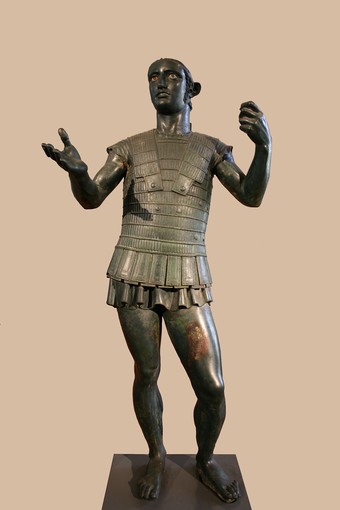
Mars of Todi
The Mars of Todi, a life-sized Etruscan bronze sculpture of a soldier making a votive offering, most likely to Laran, the Etruscan god of war; late 5th to early 4th century BCE.
The Afterlife
Etruscan beliefs concerning the afterlife seem to be
influenced by a number of sources. The Etruscans shared in general early
Mediterranean beliefs. For instance, much like the Egyptians, the Etruscans
believed that survival and prosperity in the afterlife depended on the
treatment of the deceased’s remains. Souls of ancestors are found depicted
around Etruscan tombs, and after the 5th century BCE, the deceased are
depicted in iconography as traveling to the underworld. In several instances,
spirits of the dead are referred to as hinthial,
or one who is underneath. The transmigrational world beyond the grave was
patterned after the Greek Hades and ruled by Aita. The deceased were guided
there by Charun, the equivalent of Death, who was blue and wielded a hammer.
The Etruscan version of Hades was populated by Greek mythological figures, some
of which were of composite appearance to those in Greek mythology.
Etruscan tombs imitated
domestic structures, contained wall paintings and even furniture, and were
spacious. The deceased was depicted in the tomb at the prime of their life, and
often with a spouse. Not everyone had a sarcophagus, however. Some deceased
individuals were laid out on stone benches, and depending on the proportion of
inhumation, versus cremation, rites followed, cremated ashes and bones might be
put into an urn in the shape of a house, or in a representation of the deceased.
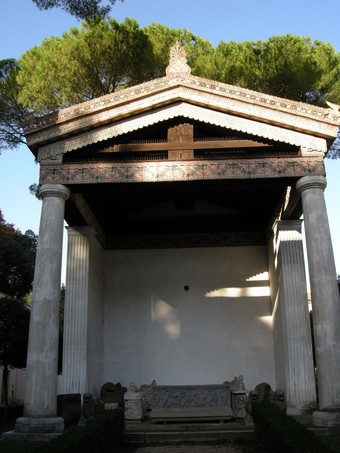
Reconstruction of an Etruscan Temple
19th century reconstruction of an Etruscan temple, in the courtyard of the Villa Giulia Museum in Rome, Italy.
8.2: Early Rome
8.2.1: The Founding of Rome
Myths surrounding the founding of Rome describe the city’s origins through the lens of later figures and events.
Learning Objective
Explain how the founding of Rome is rooted in mythology
Key Points
- The national epic poem of mythical Rome, the Aeneid by Virgil, tells the story of how the Trojan prince, Aeneas, came to Italy. The Aeneid was written under the emperor Augustus, who, through Julius Caesar, claimed ancestry from Aeneas.
- The Alba Longan line, begun by Iulus, Aeneas’s son, extends to King Procas, who fathered two sons, Numitor and Amulius.
According to the myth of Romulus and Remus,Amulius captured Numitor, sent him to prison, and forced the daughter of Numitor, Rhea Silvia, to become a virgin priestess among the Vestals.
- Despite Amulius’ best efforts, Rhea Silvia had twin boys, Romulus and Remus, by Mars. Romulus and Remus eventually overthrew Amulius, and restored Numitor.
- In the course of a dispute during the founding of the city of Rome, Romulus killed Remus. Thus Rome began with a fratricide, a story that was later taken to represent the city’s history of internecine political strife and bloodshed.
- According to the archaeological record of the
region, the development of Rome itself is presumed to have coalesced around the
migrations of various Italic tribes, who originally inhabited the Alban Hills as
they moved into the agriculturally-superior valley near the Tiber River. - The discovery of a series of fortification walls
on the north slope of Palatine Hill, most likely dating to the middle of the
8th century BCE, provide the strongest evidence of the original site and
date of the founding of the city of Rome.
Key Terms
- Romulus
-
The founder of Rome, and one of two twin sons of Rhea Silvia and Mars.
- Aeneas
-
A Trojan survivor of the Trojan War who, according to legend, journeyed to Italy and founded the bloodline that would eventually lead to the Julio-Claudian emperors.
- Rome
-
An Italic civilization that began on the Italian Peninsula as early as the 8th century BCE. Located along the Mediterranean Sea, and centered on one city, it expanded to become one of the largest empires in the ancient world.
The founding of Rome can be investigated through archaeology, but traditional stories, handed down by the ancient Romans themselves, explain the earliest history of their city in terms of legend and myth. The most familiar of these myths, and perhaps the most famous of all Roman myths, is the story of Romulus and Remus, the twins who were suckled by a she-wolf. This story had to be reconciled with a dual tradition, set earlier in time.
Romulus and the Founding of Rome
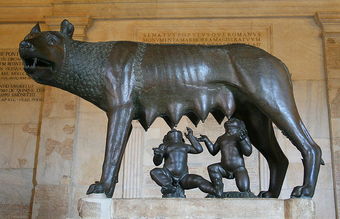
The Capitoline Wolf
The iconic sculpture of Romulus and Remus being suckled by the she-wolf who raised them. Traditional scholarship says the wolf-figure is Etruscan, 5th century BCE, with figures of Romulus and Remus added in the 15th century CE by Antonio Pollaiuolo. Recent studies suggest that the wolf may be a medieval sculpture dating from the 13th century CE.
Romulus and Remus were purported to be sons of Rhea Silvia and Mars, the god of war. Because of a prophecy that they would overthrow their great-uncle Amulius, who had overthrown Silvia’s father, Numitor, they were, in the manner of many mythological heroes, abandoned at birth. Both sons were left to die on the Tiber River, but were saved by a number of miraculous interventions. After being carried to safety by the river itself, the twins were nurtured by a she-wolf and fed by a woodpecker, until a shepherd, named Faustulus, found them and took them as his sons.
When Remus and Romulus became adults and learned the truth about their birth and upbringing, they killed Amulius and restored Numitor to the throne.
Rather than wait to inherit Alba Longa, the city of their birth, the twins
decided to establish their own city. They quarreled, however,
over where to locate the new city, and in the process of their dispute, Romulus killed his brother. Thus Rome began with a fratricide, a story that was later taken to represent the city’s history of internecine political strife and bloodshed.
Aeneas and the Aeneid
The national epic of mythical Rome, the Aeneid by Virgil, tells the story of how the Trojan
prince, Aeneas, came to Italy. Although the Aeneid
was written under the emperor Augustus between 29 and 19 BCE, it tells the
story of the founding of Rome centuries before Augustus’s time. The hero, Aeneas, was already well known within Greco-Roman legend and myth, having been a
character in the Iliad. But Virgil
took the disconnected tales of Aeneas’s wanderings, and his vague association
with the foundation of Rome, and fashioned it into a compelling foundation myth
or national epic. The story tied Rome to the legends of Troy, explained the Punic Wars,
glorified traditional Roman virtues, and legitimized the Julio-Claudian
dynasty as descendants of the founders, heroes, and gods of Rome and Troy.
Virgil makes use of symbolism to draw comparisons between the
emperor Augustus and Aeneas, painting them both as founders of Rome. The Aeneid also contains prophecies about Rome’s
future, the deeds of Augustus, his ancestors, and other famous Romans. The
shield of Aeneas even depicts Augustus’s victory at Actium in 31 BCE. Virgil
wrote the Aeneid during a time of
major political and social change in Rome, with the fall of the republic and
the Final War of the Roman Republic tearing through society and causing many to
question Rome’s inherent greatness. In this context, Augustus instituted a new
era of prosperity and peace through the reintroduction of traditional Roman
moral values. The Aeneid was seen as
reflecting this aim by depicting Aeneas as a man devoted and loyal to his country
and its greatness, rather than being concerned with his own personal gains. The Aeneid also gives mythic legitimization
to the rule of Julius Caesar, and by extension, to his adopted son, Augustus, by
immortalizing the tradition that renamed Aeneas’s son Iulus, making him an
ancestor to the family of Julius Caesar.
According to the Aeneid, the survivors from the fallen city of Troy banded together
under Aeneas, underwent a series of adventures around the Mediterranean Sea,
including a stop at newly founded Carthage under the rule of Queen Dido, and
eventually reached the Italian coast. The Trojans were thought to have landed
in an area between modern Anzio and Fiumicino, southwest of Rome, probably at
Laurentum, or in other versions, at Lavinium, a place named for Lavinia, the
daughter of King Latinus, who Aeneas married. Aeneas’ arrival started a series
of armed conflicts with Turnus over the marriage of Lavinia. Before the arrival
of Aeneas, Turnus was engaged to Lavinia, who then married Aeneas, which began
the conflict. Aeneas eventually won the war and killed Turnus, which granted
the Trojans the right to stay and to assimilate with the local peoples. The
young son of Aeneas, Ascanius, also known as Iulus, went on to found Alba Longa
and the line of Alban kings who filled the chronological gap between the Trojan
saga and the traditional founding of Rome in the 8th century BCE.
Toward the end of
this line, King Procas appears as the father of Numitor and Amulius. At Procas’
death, Numitor became king of Alba
Longa, but Amulius captured him and sent him to prison. He also forced the
daughter of Numitor, Rhea Silvia, to become a virgin priestess among the
Vestals. For many years, Amulius was the king. The tortuous nature of the
chronology is indicated by Rhea Silvia’s ordination among the Vestals, whose
order was traditionally said to have been founded by the successor of Romulus,
Numa Pompilius.
The Archaeological Record
According to the archaeological record of the region, the
Italic tribes who originally inhabited the Alban Hills moved down into the
valleys, which provided better land for agriculture. The area around the Tiber
River was particularly advantageous and offered many strategic resources. For
instance, the river itself provided a natural border on one side of the
settlement, and the hills on the other side provided another defensive position
for the townspeople. A settlement in this area would have also allowed for
control of the river, including commercial and military traffic, as well as a
natural observation point at Isola Tiberina. This was especially important, since
Rome was at the intersection of the principal roads to the sea from Sabinum and
Etruria, and traffic from those roads could not be as easily controlled.
The development of Rome itself is presumed to
have coalesced around the migrations of these various tribes into the valley,
as evidenced by differences in pottery and burial techniques. The discovery of
a series of fortification walls on the north slope of Palatine Hill, most
likely dating to the middle of the 8th century BCE, provide the strongest
evidence for the original site and date of the founding of the city of Rome.
8.2.2: The Seven Kings
For its first 200 years, Rome was ruled by seven kings, each of whom is credited either with establishing a key Roman tradition or constructing an important building.
Learning Objective
Explain the significance of the Seven Kings of Rome to Roman culture
Key Points
- Romulus was Rome’s first king and the city’s founder. He is best known for the Rape of the Sabine Women and the establishment of the Senate, as well as various voting practices.
- Numa Pompilius was a just, pious king who established the cult of the Vestal Virgins at Rome, and the position of Pontifex Maximus. His reign was characterized by peace.
- Tullus Hostilius had little regard for the Roman gods, and focused entirely on military expansion. He constructed the home of the Roman Senate, the Curia Hostilia.
- Ancus Marcius ruled peacefully and only fought wars when Roman territories needed defending.
- Lucius Tarquinius Priscus increased the size of the Senate and began major construction works, including the Temple to Jupiter Optimus Maximus, and the Circus Maximus.
- Servius Tullius built the first pomerium—
walls that fully encircled the Seven Hills of Rome. He also made organizational changes to the Roman army, and implemented a new constitution for the Romans, further developing the citizen classes.
- Lucius Tarquinius Superbus’s reign is remembered for his use of violence and intimidation, as well as his disrespect of Roman custom and the Roman Senate. He was eventually overthrown, thus leading to the establishment of the Roman Republic.
Key Terms
- absolute monarchy
-
A monarchical form of government in which the monarch has absolute power
among his or her people. This amounts to unrestricted political power over a
sovereign state and its people. - patrician
-
A group of elite families in ancient Rome.
The first 200 years of Roman history occurred under a monarchy. Rome was ruled by seven kings over this period of time,
and each of their reigns were characterized by
the personality of the ruler in question. Each of these kings is credited either with establishing a key Roman tradition, or constructing an important building.
None of the seven kings were known to be dynasts, and no reference is made to the hereditary nature of kingdom until after the
fifth king, Tarquinius Priscus.
The king of Rome possessed absolute power over
the people, and the Senate provided only a weak,
oligarchic counterbalance to his power, primarily exercising only minor
administrative powers. For these reasons, the kingdom of Rome is considered an
absolute monarchy. Despite this, Roman kings, with the exception of Romulus, were
elected by citizens of Rome who occupied the Curiate Assembly. There, members
would vote on candidates that had been nominated by a chosen member of the Senate, called an interrex. Candidates could be chosen from any source.
Romulus
Romulus was Rome’s legendary first king and the city’s founder. In 753 BCE, Romulus began building the city upon the Palatine Hill. After founding and naming Rome, as the story goes, he permitted men of all classes to come to Rome as citizens, including slaves and freemen, without distinction. To provide his citizens with wives, Romulus invited the neighboring tribes to a festival in Rome where he abducted the young women amongst them (this is known as The Rape of the Sabine Women). After the ensuing war with the Sabines, Romulus shared the kingship with the Sabine king, Titus Tatius. Romulus selected 100 of the most noble men to form the Roman Senate as an advisory council to the king. These men were called patres (from pater: father, head), and their descendants became the patricians. He also established voting, and class structures that would define sociopolitical proceedings throughout the Roman Republic and Empire.
Numa Pompilius
After the death of Romulus, there was an interregnum for one year, during which ten men chosen from the senate governed Rome as successive interreges. Numa Pompilius, a Sabine, was eventually chosen by the senate to succeed Romulus because of his reputation for justice and piety. Numa’s reign was marked by peace and religious reform. Numa constructed a new temple to Janus and, after establishing peace with Rome’s neighbors, shut the doors of the temple to indicate a state of peace. The doors of the temple remained closed for the balance of his reign. He established the cult of the Vestal Virgins at Rome, as well as the “leaping priests,” known as the Salii, and three flamines, or priests, assigned to Jupiter, Mars, and Quirinus. He also established the office and duties of Pontifex Maximus, the head priest of the Roman state religion.
Tullus Hostilius
Tullus Hostilius was much like Romulus in his warlike behavior, and completely unlike Numa in his lack of respect for the gods. Tullus waged war against Alba Longa, Fidenae and Veii, and the Sabines. It was during Tullus’ reign that the city of Alba Longa was completely destroyed, after which Tullus integrated its population into Rome. According to the Roman historian Livy, Tullus neglected the worship of the gods until, towards the end of his reign, he fell ill and became superstitious. However, when Tullus called upon Jupiter and begged assistance, Jupiter responded with a bolt of lightning that burned the king and his house to ashes. Tullus is attributed with constructing a new home for the Senate, the Curia Hostilia, which survived for 562 years after his death.
Ancus Marcius
Following the death of Tullus, the Romans elected a peaceful and religious king in his place—Numa’s grandson, Ancus Marcius. Much like his grandfather, Ancus did little to expand the borders of Rome, and only fought war when his territories needed defending.
Lucius Tarquinius Priscus
Lucius Tarquinius Priscus was the fifth king of Rome and the first of Etruscan birth. After immigrating to Rome, he gained favor with Ancus, who later adopted him as his son. Upon ascending the throne, he waged wars against the Sabines and Etruscans, doubling the size of Rome and bringing great treasures to the city.One of his first reforms was to add 100 new members to the Senate from the conquered Etruscan tribes, bringing the total number of senators to 200. He used the treasures Rome had acquired from conquests to build great monuments for Rome, including the Roman Forum, the temple to Jupiter on the Capitoline Hill, and the Circus Maximus. His reign is best remembered for the introduction of Etruscan symbols of military distinction and civilian authority
into the Roman tradition, including the scepter of the king, the rings
worn by senators, and the use of the tuba for military purposes.
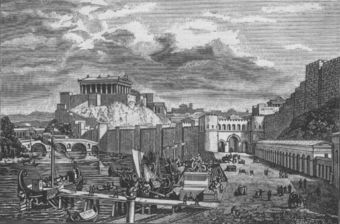
The Temple of Jupiter Optimus Maximus
19th century illustration depicting the Temple of Jupiter Optimus Maximus above the Tiber River during the Roman Republic.
Servius Tullus
Following Priscus’s death, his son-in-law, Servius Tullius, succeeded him to the throne. Like his father-in-law before him, Servius fought successful wars against the Etruscans. He used the treasure from his campaigns to build the first pomerium—walls that fully encircled the Seven Hills of Rome. He also made organizational changes to the Roman army, and was renowned for implementing a new constitution for the Romans and further developing the citizen classes. Servius’s reforms brought about a major change in Roman life—voting rights were now based on socioeconomic status, transferring much of the power into the hands of the Roman elite. The 44-year reign of Servius came to an abrupt end when he was assassinated in a conspiracy led by his own daughter, Tullia, and her husband, Lucius Tarquinius Superbus.
Lucius Tarquinius Superbus
While in power, Tarquinius conducted a number of wars against Rome’s neighbors, including the Volsci, Gabii, and the Rutuli. Tarquinius also engaged in a series of public works, notably the completion of the Temple of Jupiter Optimus Maximus on the Capitoline Hill. Tarquin’s reign, however, is best remembered for his use of violence and intimidation in his attempts to maintain control over Rome, as well as his disrespect of Roman custom and the Roman Senate. Tensions came to a head when the king’s son, Sextus Tarquinius, raped Lucretia, wife and daughter to powerful Roman nobles. Lucretia then told her relatives about the attack and subsequently committed suicide to avoid the dishonor of the episode. Four men, led by Lucius Junius Brutus, incited a revolution, and as a result, Tarquinius and his family were deposed and expelled from Rome in 509 BCE. Because of his actions and the way they were viewed by the people, the word for King, rex, held a negative connotation in Roman culture until the fall of the Roman Empire. Brutus and Collatinus became Rome’s first consuls, marking the beginning of the Roman Republic. This new government would survive for the next 500 years, until the rise of Julius Caesar and Caesar Augustus, and cover a period in which Rome’s authority and area of control extended to cover great areas of Europe, North Africa, and the Middle East.
8.2.3: Early Roman Society
Multiple,
overlapping hierarchies characterized Roman society, which was also highly
patriarchal.
Learning Objective
Describe
what Roman society was like in its early years
Key Points
- Roman society was extremely patriarchal and
hierarchical. The adult male head of a household had special legal powers and
privileges that gave him jurisdiction over all the members of his family. - The status of freeborn Romans was established by
their ancestry, census ranking, and citizenship. - The most important division within Roman society
was between patricians, a small elite who monopolized political power, and
plebeians, who comprised the majority of Roman society. - The Roman census divided citizens into six
complex classes based on property holdings. - Most adult, free-born men within the city limits
of Rome held Roman citizenship. Classes of non-citizens existed and held
different legal rights.
Key Terms
- tax farming
-
A
technique of financial management in which future, uncertain revenue streams are
fixed into periodic rents via assignment by legal contract to a third party. - plebeians
-
A
general body of free Roman citizens who were part of the lower strata of
society. - patricians
-
A
group of ruling class families in ancient Rome.
Roman society was extremely patriarchal and hierarchical. The
adult male head of a household had special legal powers and privileges that
gave him jurisdiction over all the members of his family, including his wife,
adult sons, adult married daughters, and slaves, but there were multiple, overlapping
hierarchies at play within society at large. An individual’s relative position
in one hierarchy might have been higher or lower than it was in another. The status of
freeborn Romans was established by the following:
- Their ancestry
- Their census rank, which in turn was determined by the
individual’s wealth and political privilege -
Citizenship, of which there were grades with
varying rights and privileges
Ancestry
The most important division within Roman society was between
patricians, a small elite who monopolized political power, and plebeians, who
comprised the majority of Roman society. These designations were established at
birth, with patricians tracing their ancestry back to the first Senate
established under Romulus. Adult, male non-citizens fell outside the realms of
these divisions, but women and children, who were also not considered formal
citizens, took the social status of their father or husband. Originally, all
public offices were only open to patricians and the classes could not
intermarry, but, over time, the differentiation between patrician and plebeian statuses
became less pronounced, particularly after the establishment of the Roman
republic.
Census Rankings
The Roman census divided citizens into six complex classes based on property holdings. The richest class was called the senatorial class,
with wealth based on ownership of large agricultural estates, since members of
the highest social classes did not traditionally engage in commercial activity.
Below the senatorial class was the equestrian order, comprised of members who
held the same volume of wealth as the senatorial classes, but who engaged in
commerce, making them an influential early business class. Certain political
and quasi-political positions were filled by members of the equestrian order,
including tax farming and leadership of the Praetorian Guard. Three additional
property-owning classes occupied the rungs beneath the equestrian order.
Finally, the proletarii occupied the bottom rung with the lowest property
values in the kingdom.
Citizenship
Citizenship in ancient Rome afforded political and legal
privileges to free individuals with respect to laws, property, and governance.
Most adult, free-born men within the city limits of Rome held Roman citizenship.
Men who lived in towns outside of Rome might also hold citizenship, but some
lacked the right to vote. Free-born, foreign subjects during this period were
known as peregrini, and special laws existed to govern their conduct and
disputes, though they were not considered Roman citizens during the Roman
kingdom period. Free-born women in ancient Rome were considered citizens, but
they could not vote or hold political office. The status of woman’s citizenship
affected the citizenship of her offspring. For example, in a type of Roman marriage
called conubium, both spouses must be
citizens in order to marry. Additionally, the phrase ex duobus civibus Romanis natos, translated to mean “children born
of two Roman citizens,” reinforces the importance of both parents’ legal status
in determining that of their offspring.
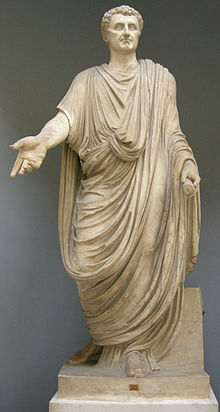
Roman citizenship
The toga, shown here on a statue restored with the head of Nerva, was the distinctive garb of Roman citizens
Classes of non-citizens existed and held different legal
rights. Under Roman law, slaves were considered property and held no rights. However, certain laws did regulate the institution of slavery, and
extended protections to slaves that were not granted to other forms of
property. Slaves who had been manumitted became freedmen and enjoyed largely
the same rights and protections as free-born citizens. Many slaves descended
from debtors or prisoners of war, especially women and children who were
captured during foreign military campaigns and sieges.
Ironically, many slaves originated from Rome’s conquest of
Greece, and yet Greek culture was considered, in some respects by the Romans, to
be superior to their own. In this way, it seems Romans regarded slavery as a
circumstance of birth, misfortune, or war, rather than being limited to, or
defined by, ethnicity or race. Because it was defined mainly in terms of a lack
of legal rights and status, it was also not considered a permanent or
inescapable position. Some who had received educations or learned skills that
allowed them to earn their own living were manumitted upon the death of their
owner, or allowed to earn money to buy their freedom during their owner’s
lifetime. Some slave owners also freed slaves who they believed to be their
natural children. Nonetheless, many worked under harsh conditions, and/or
suffered inhumanely under their owners during their enslavement.
Most freed slaves joined the lower plebeian classes, and
worked as farmers or tradesmen, though as time progressed and their numbers
increased, many were also accepted into the equestrian class. Some went on to
populate the civil service, whereas others engaged in commerce, amassing vast
fortunes that were rivaled only by those in the wealthiest classes.
8.3: The Roman Republic
8.3.1: The Establishment of the Roman Republic
After the public
outcry that arose as a result of the rape of Lucretia, Romans overthrew the unpopular king, Lucius
Tarquinius Superbus, and established a republican form of government.
Learning Objective
Explain why and how Rome transitioned from a
monarchy to a republic
Key Points
- The Roman
monarchy was overthrown around 509 BCE, during a political revolution that
resulted in the expulsion of Lucius Tarquinius Superbus, the last king of Rome. - Despite waging a
number of successful campaigns against Rome’s neighbors, securing Rome’s
position as head of the Latin cities, and engaging in a series of public works,
Tarquinius was a very unpopular king, due to his violence and abuses of power. - When word spread
that Tarquinius’s son raped Lucretia, the wife of the governor of Collatia, an uprising
occurred in which a number of prominent patricians argued for a change in
government. - A general
election was held during a legal assembly, and participants voted in favor of
the establishment of a Roman republic. - Subsequently, all Tarquins were exiled from Rome and an interrex and two
consuls were established to lead the new republic.
Key Terms
- interrex
-
Literally, this translates to mean a ruler that
presides over the period between the rule of two separate kings; or, in other
words, a short-term regent. - plebeians
-
A
general body of free Roman citizens who were part of the lower strata of
society. - patricians
-
A
group of ruling class families in ancient Rome.
The Roman monarchy was
overthrown around 509 BCE, during a political revolution that resulted in the
expulsion of Lucius Tarquinius Superbus, the last king of Rome. Subsequently,
the Roman Republic was established.
Background
Tarquinius was the son of
Lucius Tarquinius Priscus, the fifth king of Rome’s Seven Kings period. Tarquinius was married to Tullia Minor, the daughter of Servius Tullius, the sixth king of Rome’s Seven
Kings period. Around 535 BCE, Tarquinius and his wife, Tullia
Minor, arranged for the murder of his father-in-law. Tarquinius became king
following Servius Tullius’s death.
Tarquinius waged a number of
successful campaigns against Rome’s neighbors, including the Volsci, Gabii, and
the Rutuli. He also secured Rome’s position as head of the Latin cities, and
engaged in a series of public works, such as the completion of the Temple of
Jupiter Optimus Maximus. However, Tarquinius remained an unpopular king for a
number of reasons. He refused to bury his predecessor and executed a number of
leading senators whom he suspected remained loyal to Servius. Following these
actions, he refused to replace the senators he executed and refused to consult the
Senate in matters of government going forward, thus diminishing the size and
influence of the Senate greatly. He also went on to judge capital criminal
cases without the advice of his counselors, stoking fear among his political
opponents that they would be unfairly targeted.
The Rape of Lucretia and An
Uprising
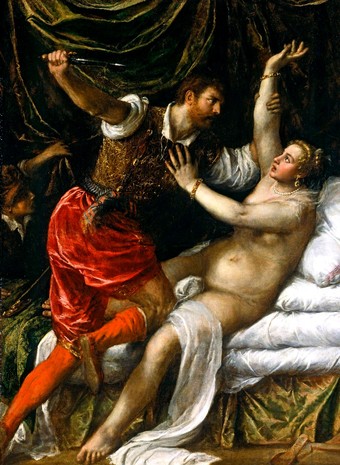
Tarquin and Lucretia
Titian’s Tarquin and Lucretia (1571).
During Tarquinius’s war with
the Rutuli, his son, Sextus Tarquinius, was sent on a military errand to
Collatia, where he was received with great hospitality at the governor’s
mansion. The governor’s wife, Lucretia, hosted Sextus while the governor was
away at war. During the night, Sextus entered her bedroom and raped her. The next
day, Lucretia traveled to her father, Spurius Lucretius, a distinguished
prefect in Rome, and, before witnesses, informed him of what had happened.
Because her father was a chief magistrate of Rome, her pleas for justice and
vengeance could not be ignored. At the end of her pleas, she stabbed
herself in the heart with a dagger, ultimately dying in her own father’s arms.
The scene struck those who had witnessed it with such horror that they
collectively vowed to publicly defend their liberty against the outrages of
such tyrants.
Lucius Junius Brutus, a
leading citizen and the grandson of Rome’s fifth king, Tarquinius Priscus, publicly
opened a debate on the form of government that Rome should have in place of the
existing monarchy. A number of patricians attended the debate, in which Brutus
proposed the banishment of the Tarquins from all territories of Rome, and the
appointment of an interrex to nominate new magistrates and to oversee an
election of ratification. It was decided that a republican form of government
should temporarily replace the monarchy, with two consuls replacing the king
and executing the will of a patrician senate. Spurius Lucretius was elected
interrex, and he proposed Brutus, and Lucius Tarquinius Collatinus, a leading
citizen who was also related to Tarquinius Priscus, as the first two consuls.
His choice was ratified by the comitia
curiata, an organization of patrician families who primarily ratified
decrees of the king.
In order to rally the
plebeians to their cause, all were summoned to a legal assembly in the forum, and Lucretia’s body was paraded through the streets. Brutus gave a speech and a
general election was held. The results were in favor of a republic. Brutus left
Lucretius in command of the city as interrex, and pursued the king in Ardea
where he had been positioned with his army on campaign. Tarquinius, however,
who had heard of developments in Rome, fled the camp before Brutus arrived, and
the army received Brutus favorably, expelling the king’s sons from their
encampment. Tarquinius was subsequently refused entry into Rome and lived as an
exile with his family.
The Establishment of the
Republic
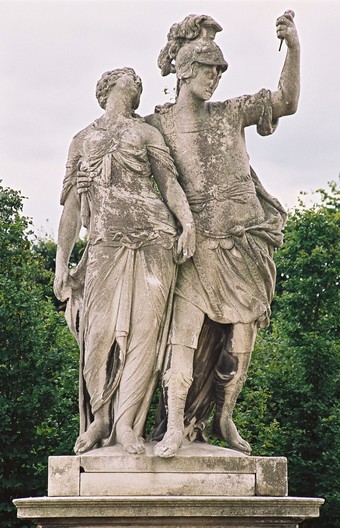
Brutus and Lucretia
The statue shows Brutus holding the knife and swearing the oath, with Lucretia.
Although there is no
scholarly agreement as to whether or not it actually took place, Plutarch and
Appian both claim that Brutus’s first act as consul was to initiate an oath for
the people, swearing never again to allow a king to rule Rome. What is known
for certain is that he replenished the Senate to its original number of 300
senators, recruiting men from among the equestrian class. The new consuls
also created a separate office, called the rex sacrorum, to carry out and oversee
religious duties, a task that had previously fallen to the king.
The two consuls continued to be elected annually by Roman citizens and
advised by the senate. Both consuls were elected for one-year terms and could
veto each other’s actions. Initially, they were endowed with all the powers of
kings past, though over time these were broken down further by the addition of
magistrates to the governmental system. The first magistrate added was the praetor,
an office that assumed judicial authority from the consuls. After the praetor,
the censor was established, who assumed the power to conduct the Roman census.
8.3.2: Structure of the Republic
The Roman Republic was composed of the Senate, a number of legislative assemblies, and elected magistrates.
Learning Objective
Describe the political structure of the Roman Republic
Key Points
- The Constitution of the Roman Republic was a set of guidelines and principles passed down, mainly through precedent. The constitution was largely unwritten and uncodified, and evolved over time.
-
Roman citizenship was a
vital prerequisite to possessing many important legal rights.The Senate passed decrees that were called senatus consulta, ostensibly “advice” from the senate to a magistrate. The focus of the Roman Senate was usually foreign policy.
- There were two types of legislative assemblies. The first was the comitia (“committees”), which were assemblies of all Roman citizens. The second was the concilia (“councils”), which were assemblies of specific groups of citizens.
- The comitia centuriata was the assembly of the centuries (soldiers), and they elected magistrates who had imperium powers (consuls and praetors). The comitia tributa, or assembly of the tribes (the citizens of Rome), was presided over by a consul and composed of 35 tribes. They elected quaestors, curule aediles, and military tribunes.
- Dictators were sometimes elected during times of military emergency, during which the constitutional government would be disbanded.
Key Terms
- patricians
-
A
group of ruling class families in ancient Rome. - plebeian
-
A general body of free Roman citizens who were part of the lower strata of society.
- Roman Senate
-
A political institution in the ancient Roman Republic. It was not an elected body, but one whose members were appointed by the consuls, and later by the censors.
The Constitution of the Roman Republic was a set of guidelines and principles passed down, mainly through precedent. The constitution was largely unwritten and uncodified, and evolved over time. Rather than creating a government that was primarily a democracy (as was ancient Athens), an aristocracy (as was ancient Sparta), or a monarchy (as was Rome before, and in many respects after, the Republic), the Roman constitution mixed these three elements
of governance into their overall political system. The democratic element took the form of legislative assemblies; the aristocratic element took the form of the Senate; and the monarchical element took the form of the many term-limited consuls.
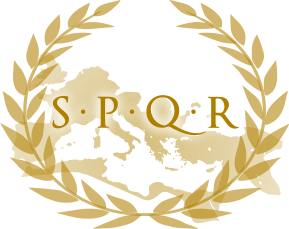
The Roman SPQR Banner
“SPQR” (senatus populusque romanus) was the Roman motto, which stood for “the Senate and people of Rome”.
The Roman Senate
The Senate’s ultimate authority derived from the esteem and prestige of the senators, and was based on both precedent and custom. The Senate passed decrees, which were called senatus consulta, ostensibly “advice” handed down from the senate to a magistrate. In practice, the magistrates usually followed the senatus consulta. The focus of the Roman Senate was usually foreign policy. However, the power of the Senate expanded over time as the power of the legislative assemblies declined, and eventually the Senate took a greater role in civil law-making. Senators were usually appointed by Roman censors, but during times of military emergency, such as the civil wars of the 1st century BCE, this practice became less prevalent, and the Roman dictator, triumvir, or the Senate itself would select its members.
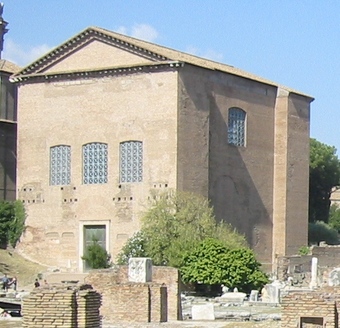
Curia Iulia – The Roman Senate House
The Curia Julia in the Roman Forum, the seat of the imperial Senate.
Legislative Assemblies
Roman citizenship was a vital prerequisite to possessing many important legal rights, such as the rights to trial and appeal, marriage, suffrage, to hold office, to enter binding contracts, and to enjoy special tax exemptions. An adult male citizen with full legal and political rights was called optimo jure. The optimo jure elected assemblies, and the assemblies elected magistrates, enacted legislation, presided over trials in capital cases, declared war and peace, and forged or dissolved treaties. There were two types of legislative assemblies. The first was the comitia (“committees”), which were assemblies of all optimo jure. The second was the concilia (“councils”), which were assemblies of specific groups of optimo jure.
Citizens on these assemblies were organized further on the basis of
curiae
(familial groupings), centuries
(for
military purposes), and tribes (for civil purposes), and each would each gather into their own assemblies.
The
Curiate Assembly served only a symbolic purpose in the late Republic, though
the assembly was used to ratify the powers of newly elected magistrates by
passing laws known as leges curiatae. The comitia centuriata was the assembly of the centuries (soldiers). The president of the comitia centuriata was usually a consul, and the comitia centuriata would elect magistrates who had imperium powers (consuls and praetors). It also elected censors. Only the comitia centuriata could declare war and ratify the results of a census. It also served as the highest court of appeal in certain judicial cases.
The assembly of the tribes, the comitia tributa, was presided over by a consul, and was composed of 35 tribes. The tribes were not ethnic or kinship groups, but rather geographical subdivisions. While it did not pass many laws, the comitia tributa did elect quaestors, curule aediles, and military tribunes. The Plebeian Council was identical to the assembly of the tribes, but excluded the patricians. They elected their own officers, plebeian tribunes, and plebeian aediles. Usually a plebeian tribune would preside over the assembly. This assembly passed most laws, and could also act as a court of appeal.
Since
the tribunes were considered to be the embodiment of the plebeians, they were
sacrosanct. Their sacrosanctness was enforced by a pledge, taken by the plebeians,
to kill any person who harmed or interfered with a tribune during his term of
office. As such, it was considered a capital offense to harm a tribune, to
disregard his veto, or to interfere with his actions. In times of military
emergency, a dictator would be appointed for a term of six months. The
constitutional government would be dissolved, and the dictator would be the
absolute master of the state. When the dictator’s term ended, constitutional
government would be restored.
Executive Magistrates
Magistrates were the
elected officials of the Roman republic. Each magistrate was vested with a
degree of power, and the dictator, when there was one, had the highest level of
power. Below the dictator was the censor (when they existed), and the consuls, the
highest ranking ordinary magistrates. Two were elected every year and wielded
supreme power in both civil and military powers. The ranking among both consuls
flipped every month, with one outranking the other.
Below the consuls were
the praetors, who administered civil law, presided over the courts, and
commanded provincial armies. Censors conducted the Roman census, during which
time they could appoint people to the Senate. Curule aediles were officers
elected to conduct domestic affairs in Rome, who were vested with powers over
the markets, public games, and shows. Finally, at the bottom of magistrate
rankings were the quaestors, who usually assisted the consuls in Rome and the
governors in the provinces with financial tasks. Plebeian tribunes and plebeian
aediles were considered representatives of the people, and acted as a popular
check over the Senate through use of their veto powers, thus safeguarding the
civil liberties of all Roman citizens.
Each magistrate could
only veto an action that was taken by an equal or lower ranked magistrate. The
most significant constitutional power a magistrate could hold was that of imperium
or command, which was held only by consuls and praetors. This gave the
magistrate in question the constitutional authority to issue commands, military
or otherwise.
Election to a magisterial
office resulted in automatic membership in the Senate for life, unless
impeached. Once a magistrate’s annual term in office expired, he had to wait at
least ten years before serving in that office again. Occasionally, however, a
magistrate would have his command powers extended through prorogation, which effectively
allowed him to retain the powers of his office as a promagistrate.
8.3.3: Roman Society Under the Republic
The bulk of Roman politics prior to the 1st century BCE focused on inequalities among the orders.
Learning Objective
Describe the relationship between the government
and the people in the time of the Roman Republic
Key Points
- A number of
developments affected the relationship between Rome’s republican government and
society, particularly in regard to how that relationship differed among
patricians and plebeians. - In 494 BCE, plebeian
soldiers refused to march against a wartime enemy, in order to demand the right
to elect their own officials. - The passage of
Lex Trebonia forbade the co-opting of colleagues to fill vacant positions on
tribunes in order to sway voting in favor of patrician blocs over plebeians. - Throughout the
4th century BCE, a series of reforms were passed that required all laws
passed by the plebeian council to have the full force of law over the entire
population. This gave the plebeian tribunes a positive political impact over the
entire population for the first time in Roman history. - In 445 BCE, the
plebeians demanded the right to stand for election as consul. Ultimately, a
compromise was reached in which consular command authority was granted to a
select number of military tribunes. - The Licinio-Sextian
law was passed in 367 BCE; it addressed the economic plight of the plebeians
and prevented the election of further patrician magistrates. - In the decades following the passage of the Licinio-Sextian law, further legislation was enacted that granted
political equality to the plebeians. Nonetheless, it remained difficult for a
plebeian from an unknown family to enter the Senate, due to the rise of a new
patricio-plebeian aristocracy that was less interested in the plight of the
average plebeian.
Key Terms
- plebeian
-
A general body of free Roman citizens who were
part of the lower strata of society. - patricians
-
A group of ruling class families in ancient
Rome.
In the first few centuries
of the Roman Republic, a number of developments affected the relationship
between the government and the Roman people, particularly in regard to how that
relationship differed across the separate strata of society.
The Patrician Era (509-367
BCE)
The last king of Rome,
Lucius Tarquinius Superbus, was overthrown in 509 BCE. One of the biggest
changes that occurred as a result was the establishment of two chief
magistrates, called consuls, who were elected by the citizens of Rome for an
annual term. This stood in stark contrast to the previous system, in which a
king was elected by senators, for life. Built in to the consul system were
checks on authority, since each consul could provide balance to the decisions
made by his colleague. Their limited terms of office also opened them up to the
possibility of prosecution in the event of abuses of power. However, when
consuls exercised their political powers in tandem, the magnitude and influence
they wielded was hardly different from that of the old kings.
In 494 BCE, Rome was at war
with two neighboring tribes, and plebeian soldiers refused to march against the
enemy, instead seceding to the Aventine Hill. There, the plebeian soldiers took
advantage of the situation to demand the right to elect their own officials. The
patricians assented to their demands, and the plebeian soldiers returned to
battle. The new offices that were created as a result came to be known as “plebeian
tribunes,” and they were to be assisted by “plebeian aediles.”
In the early years of the
republic, plebeians were not permitted to hold magisterial office. Tribunes and
aediles were technically not magistrates, since they were only elected by fellow
plebeians, as opposed to the unified population of plebeians and patricians.
Although plebeian tribunes regularly attempted to block legislation they
considered unfavorable, patricians could still override their veto with the
support of one or more other tribunes. Tension over this imbalance of power led
to the passage of Lex Trebonia, which forbade the co-opting of colleagues to
fill vacant positions on tribunes in order to sway voting in favor of one or
another bloc. Throughout the 4th century BCE, a series of reforms were
passed that required all laws passed by the plebeian council to have equal force over the entire population, regardless of status as patrician or
plebeian. This gave the plebeian tribunes a positive political impact over the
entire population for the first time in Roman history.
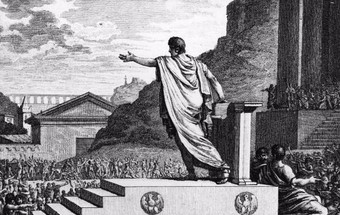
Gaius Gracchus
This 18th century drawing shows Gaius Gracchus, tribune of the people, presiding over the plebeian council.
In 445 BCE, the plebeians
demanded the right to stand for election as consul. The Roman Senate initially refused
them this right, but ultimately a compromise was reached in which consular command
authority was granted to a select number of military tribunes, who, in turn, were
elected by the centuriate assembly with veto power being retained by the
senate.
Around 400 BCE, during a
series of wars that were fought against neighboring tribes, the plebeians
demanded concessions for the disenfranchisement they experienced as
foot soldiers fighting for spoils of war that they were never to see. As a result,
the Licinio-Sextian law was eventually passed in 367 BCE, which addressed the
economic plight of the plebeians and prevented the election of further
patrician magistrates.
The Conflict of the Orders
Ends (367-287 BCE)
In the decades following the passage of the Licinio-Sextian law, further legislation was
enacted that granted political equality to the plebeians. Nonetheless, it
remained difficult for a plebeian from an unknown family to enter the Senate.
In fact, the very presence of a long-standing nobility, and the Roman population’s
deep respect for it, made it very difficult for individuals from unknown
families to be elected to high office. Additionally, elections could be
expensive, neither senators nor magistrates were paid for their services, and
the Senate usually did not reimburse magistrates for expenses incurred during
their official duties, providing many barriers to the entry of high political
office by the non-affluent.
Ultimately, a new
patricio-plebeian aristocracy emerged and replaced the old patrician nobility.
Whereas the old patrician nobility existed simply on the basis of being able to
run for office, the new aristocracy existed on the basis of affluence. Although
a small number of plebeians had achieved the same standing as the patrician
families of the past, new plebeian aristocrats were less interested in the
plight of the average plebeian than were the old patrician aristocrats. For a time,
the plebeian plight was mitigated, due higher employment, income, and patriotism
that was wrought by a series of wars in which Rome was engaged; these things eliminated the
threat of plebeian unrest. But by 287 BCE, the economic conditions of the
plebeians deteriorated as a result of widespread indebtedness, and the
plebeians sought relief. Roman senators, most of whom were also creditors, refused
to give in to the plebeians’ demands, resulting in the first plebeian secession
to Janiculum Hill.
In order to end the plebeian secession, a dictator, Quintus Hortensius,
was appointed. Hortensius, who was himself a plebeian, passed a law known as
the “Hortensian Law.” This law ended the requirement that an auctoritas patrum
be passed before a bill could be considered by either the plebeian council or
the tribal assembly, thus removing the final patrician senatorial check on the
plebeian council. The requirement was not changed, however, in the centuriate
assembly. This provided a loophole through which the patrician senate could still deter
plebeian legislative influence.
8.3.4: Art and Literature in the Roman Republic
Culture flourished during the Roman Republic with the emergence of great authors, such as Cicero and Lucretius, and with the development of Roman relief and portraiture sculpture.
Learning Objective
Recognize the wide extent of art and literature created during the Roman Republic
Key Points
- Roman literature was, from its very inception, influenced heavily by Greek authors. Some of the earliest works we possess are of historical epics that tell the early military history of Rome. However, authors diversified their genres as the Republic expanded.
- Cicero is one of the most famous Republican authors, and his letters provide detailed information about an important period in Roman history.
-
Romans
typically produced historical sculptures in relief, as opposed to Greek
free-standing sculpture. Small sculptures were considered luxury items, while moulded
relief decoration in pottery vessels and small figurines were produced in great
quantities for a wider section of the population. - The most well-known surviving
examples of Roman painting consist of the wall paintings from Pompeii and
Herculaneum that were preserved in the aftermath of the fatal eruption of Mount
Vesuvius in 79 CE. - Veristic portraiture
is a hallmark of Roman art during the Republic, though its use began to diminish during the 1st century BCE as civil wars threatened the empire and individual strong men began amassing more power.
Key Terms
- veristic portraiture
-
A hyper-realistic portrayal of the subject’s facial characteristics; a common style of portraiture in the early to mid-Republic.
- Cicero
-
A Roman philosopher, politician, lawyer, orator, political theorist, consul, and constitutionalist.
Literature
Roman literature was, from its very inception, heavily
influenced by Greek authors. Some of the earliest works we possess are historical epics telling the early military history of Rome, similar to the Greek epic narratives of Homer,
Herodotus, and Thucydides. Virgil, though generally considered to be an Augustan poet, represents the pinnacle of Roman epic poetry.
His Aeneid tells the story of the flight of Aeneas from Troy, and his settlement of the city that would become Rome.
As the Republic expanded, authors began to
produce poetry, comedy, history, and tragedy.
Lucretius, in his De rerum natura (On the Nature of Things), attempted to explicate science in an epic poem. The genre of satire was also common in Rome, and satires were written by, among others, Juvenal and Persius.
The Age of Cicero
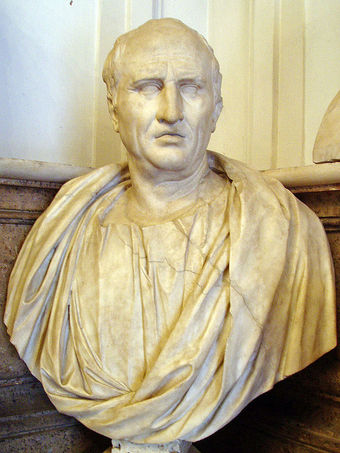
Bust of Cicero
A mid-first century CE bust of Cicero, in the Capitoline Museums, Rome.
Cicero has traditionally been considered the master of Latin prose. The writing he produced from approximately 80 BCE until his death in 43 BCE, exceeds that of any Latin author whose work survives, in terms of quantity and variety of genre and subject matter. It also possesses unsurpassed stylistic excellence. Cicero’s many works can be divided into four groups: letters, rhetorical treatises, philosophical works, and orations. His letters provide detailed information about an important period in Roman history, and offers a vivid picture of public and private life among the Roman governing class. Cicero’s works on oratory are our most valuable Latin sources for ancient theories on education and rhetoric. His philosophical works were the basis of moral philosophy during the Middle Ages, and his speeches inspired many European political leaders, as well as the founders of the United States.
Art
Early Roman art was
greatly influenced by the art of Greece and the neighboring Etruscans, who were
also greatly influenced by Greek art via trade. As the Roman Republic conquered
Greek territory, expanding its imperial domain throughout the Hellenistic world,
official and patrician sculpture grew out of the Hellenistic style that many Romans
encountered during their campaigns, making it difficult to distinguish truly
Roman elements from elements of Greek style. This was especially true since much of what
survives of Greek sculpture are actually copies made of Greek originals by
Romans. By the 2nd century BCE, most sculptors working within Rome were
Greek, many of whom were enslaved following military conquests, and whose names
were rarely recorded with the work they created. Vast numbers of Greek statues
were also imported to Rome as a result of conquest as well as trade.
Rather than create
free-standing works depicting heroic exploits from history or mythology, as the
Greeks had, the Romans produced historical works in relief. Small sculptures
were considered luxury items and were frequently the object of client-patron
relationships. The silver Warren Cup and glass Lycurgus cup are examples of the
high quality works that were produced during this period. For a wider section
of the population, moulded relief decoration in pottery vessels and small figurines
were produced in great quantities, and were often of great quality.
In the 3rd century BCE, Greek art taken during wars became popular, and many Roman homes were decorated with landscapes by Greek artists.
Of the vast body of
Roman painting that once existed, only a few examples survive to the
modern-age. The most well-known surviving examples of Roman painting are the wall paintings from Pompeii and Herculaneum, that were preserved in the
aftermath of the fatal eruption of Mount Vesuvius in 79 CE. A large number of
paintings also survived in the catacombs of Rome, dating from the 3rd century CE to 400, prior to the Christian age, demonstrating a continuation of
the domestic decorative tradition for use in humble burial chambers.Wall
painting was not considered high art in either Greece or Rome. Sculpture and
panel painting, usually consisting of tempera or encaustic painting on wooden
panels, were considered more prestigious art forms.
A large number of Fayum
mummy portraits, bust portraits on wood added to the outside of mummies by the
Romanized middle class, exist in Roman Egypt. Although these are in some ways
distinctively local, they are also broadly representative of the Roman style of
painted portraits.
Roman portraiture during the Republic is identified by its considerable realism, known as veristic portraiture. Verism refers to a hyper-realistic portrayal of the subject’s facial characteristics. The style originated from Hellenistic Greece; however, its use in Republican Rome and survival throughout much of the Republic is due to Roman values, customs, and political life. As with other forms of Roman art, Roman portraiture borrowed certain details from Greek art, but adapted these to their own needs. Veristic images often show their male subject with receding hairlines, deep winkles, and even with warts. While the face of the portrait was often shown with incredible detail and likeness, the body of the subject would be idealized, and did not seem to correspond to the age shown in the face .
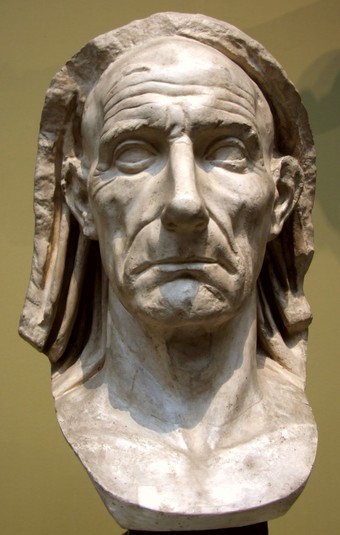
Bust of an Old Man
Veristic portraiture of an Old Man. Verism refers to a hyper-realistic portrayal of the subject’s facial characteristics.
Portrait
sculpture during the period utilized youthful and classical proportions,
evolving later into a mixture of realism and idealism. Advancements were also
made in relief sculptures, often depicting Roman victories. The Romans,
however, completely lacked a tradition of figurative vase-painting comparable
to that of the ancient Greeks, which the Etruscans had also emulated.
The Late Republic
The use of veristic portraiture began to diminish during the Late Republic in the 1st century BCE. During this time, civil wars threatened the empire and individual men began to gain more power. The portraits of Pompey the Great and Julius Caesar, two political rivals who were also the most powerful generals in the Republic, began to change the style of portraits and their use. The portraits of Pompey the Great were neither fully idealized, nor were they created in the same veristic style of Republican senators. Pompey borrowed a specific parting and curl of his hair from Alexander the Great, linking Pompey visually to Alexander’s likeness, and triggering his audience to associate him with Alexander’s characteristics and qualities.
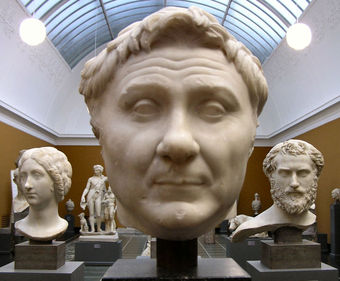
Bust of Pompey the Great
The portraits of Pompey the Great were neither fully idealized, nor were they created in the same veristic style of Republican senators. This bust clearly shows the specific parting and curl of his hair that would have likened him to Alexander the Great.
8.3.5: Republican Wars and Conquest
By the end of the mid-Republic, Rome had achieved military dominance on both the Italian peninsula and within the Mediterranean.
Learning Objective
Describe the key results and effects of major Republican wars
Key Points
- Early Roman Republican wars were wars of both expansion and defense, aimed at protecting Rome from neighboring cities and nations, and establishing its territory within the region.
- The Samnite Wars were fought against the Etruscans and effectively finished off all vestiges of Etruscan power by 282 BCE.
- By the middle of the 3rd century and the end of the Pyrrhic War, Rome had effectively dominated the Italian peninsula and won an international military reputation.
- Over the course of the three Punic Wars, Rome completely defeated Hannibal and razed Carthage to the ground, thereby acquiring all of Carthage’s North African and Spanish territories.
- After four Macedonian Wars, Rome had established its first permanent foothold in the Greek world, and divided the Macedonian Kingdom into four client republics.
Key Terms
- Punic Wars
-
A series of three wars fought between Rome and Carthage, from 264 BCE to 146 BCE, that resulted in the complete destruction of Carthage.
- Pyrrhus
-
Greek general and statesman of the Hellenistic era. Later he became king of Epirus (r. 306-302, 297-272 BCE) and Macedon (r. 288-284, 273-272 BCE). He was one of the strongest opponents of early Rome. Some of his battles, though successful, cost him heavy losses, from which the term “Pyrrhic victory” was coined.
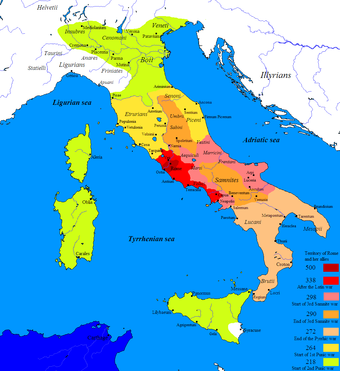
Roman Conquest of the Italian Peninsula
This map shows the expansion of Roman territory through the various wars fought during the Republican period.
Early Republic
Early Campaigns (458-396 BCE)
The first Roman Republican wars were wars of both expansion and defense, aimed at protecting Rome from neighboring cities and nations, as well as establishing its territory in the region. Initially, Rome’s immediate neighbors were either Latin towns and villages or tribal Sabines from the Apennine hills beyond. One by one, Rome defeated both the persistent Sabines and the nearby Etruscan and Latin cities. By the end of this period, Rome had effectively secured its position against all immediate threats.
Expansion into Italy and the Samnite Wars (343-282 BCE)
The First Samnite War, of 343 BCE-341 BCE, was a relatively short affair. The Romans beat the Samnites in two battles, but were forced to withdraw from the war before they could pursue the conflict further, due to the revolt of several of their Latin allies in the Latin War. The Second Samnite War, from 327 BCE-304 BCE, was much longer and more serious for both the Romans and Samnites, but by 304 BCE the Romans had effectively annexed the greater part of the Samnite territory and founded several colonies therein. Seven years after their defeat, with Roman dominance of the area seemingly assured, the Samnites rose again and defeated a Roman army in 298 BCE, to open the Third Samnite War. With this success in hand, they managed to bring together a coalition of several of Rome’s enemies, but by 282 BCE, Rome finished off the last vestiges of Etruscan power in the region.
Pyrrhic War (280-275 BCE)
By the beginning of the 3rd century BCE, Rome had established itself as a major power on the Italian Peninsula, but had not yet come into conflict with the dominant military powers in the Mediterranean Basin at the time: the Carthage and Greek kingdoms. When a diplomatic dispute between Rome and a Greek colony erupted into a naval confrontation, the Greek colony appealed for military aid to Pyrrhus, ruler of the northwestern Greek kingdom of Epirus. Motivated by a personal desire for military accomplishment, Pyrrhus landed a Greek army of approximately 25,000 men on Italian soil in 280 BCE. Despite early victories, Pyrrhus found his position in Italy untenable. Rome steadfastly refused to negotiate with Pyrrhus as long as his army remained in Italy. Facing unacceptably heavy losses with each encounter with the Roman army, Pyrrhus withdrew from the peninsula (thus giving rise to the term “pyrrhic victory”).
In 275 BCE, Pyrrhus again met the Roman army at the Battle of Beneventum. While Beneventum’s outcome was indecisive, it led to Pyrrhus’s
complete withdrawal from Italy, due to the decimation of his army
following years of foreign campaigns, and the diminishing likelihood of further
material gains. These conflicts with Pyrrhus would have a positive effect on Rome. Rome had shown it was capable of pitting its armies successfully against the dominant military powers of the Mediterranean, and that the Greek kingdoms were incapable of defending their colonies in Italy and abroad. Rome quickly moved into southern Italia, subjugating and dividing the Greek colonies. By the middle of the 3rd century, Rome effectively dominated the Italian peninsula, and had won an international military reputation.
Mid-Republic
Punic Wars
The First Punic War began in 264 BCE, when
Rome
and Carthage became interested in using settlements within Sicily to solve their own internal conflicts. The war saw land battles in Sicily early on, but focus soon shifted to naval battles around Sicily and Africa. Before the First Punic War, there was essentially no Roman navy. The new war in Sicily against Carthage, a great naval power, forced Rome to quickly build a fleet and train sailors. Though the first few naval battles of the First Punic War were catastrophic disasters for Rome, Rome was eventually able to beat the Carthaginians and leave them without a fleet or sufficient funds to raise another. For a maritime power, the loss of Carthage’s access to the Mediterranean stung financially and psychologically, leading the Carthaginians to sue for peace.
Continuing distrust led to the renewal of hostilities in the Second Punic War, when, in 218 BCE, Carthaginian commander Hannibal attacked a Spanish town with diplomatic ties to Rome. Hannibal then crossed the Italian Alps to invade Italy. Hannibal’s successes in Italy began immediately, but his brother, Hasdrubal, was defeated after he crossed the Alps on the Metaurus River. Unable to defeat Hannibal on Italian soil, the Romans boldly sent an army to Africa under Scipio Africanus, with the intention of threatening the Carthaginian capital. As a result, Hannibal was recalled to Africa, and defeated at the Battle of Zama.
Carthage never managed to recover after the Second Punic War, and the Third Punic War that followed was, in reality, a simple punitive mission to raze the city of Carthage to the ground. Carthage was almost defenseless, and when besieged offered immediate surrender, conceding to a string of outrageous Roman demands. The Romans refused the surrender and the city was stormed and completely destroyed after a short siege. Ultimately, all of Carthage’s North African and Spanish territories were acquired by Rome.
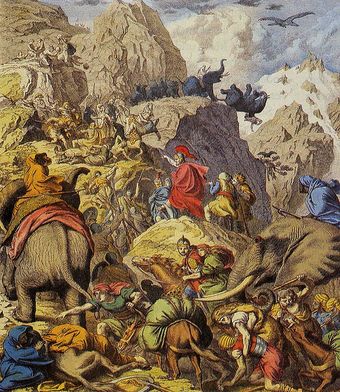
Hannibal’s Famous Crossing of the Alps
Depiction of Hannibal and his army crossing the Alps during the Second Punic War.
Macedon and Greece
Rome’s preoccupation with its war in Carthage provided an opportunity for Philip V of the kingdom of Macedonia, located in the northern part of the Greek peninsula, to attempt to extend his power westward. Over the next several decades, Rome clashed with Macedon to protect their Greek allies throughout the First, Second, and Third Macedonian Wars. By 168 BCE, the Macedonians had been thoroughly defeated, and Rome divided the Macedonian Kingdom into four client republics. After a Fourth Macedonian War, and nearly a century of constant crisis management in Greece (which almost always was a result of internal instability when Rome pulled out), Rome decided to divide Macedonia into two new Roman provinces, Achaea and Epirus.
8.3.6: Crises of the Republic
The 1st century BCE saw tensions between patricians and plebeians erupt into violence, as the Republic became increasingly more divided and unstable.
Learning Objective
Explain how crises in the 1st century BCE further destabilized the Roman Republic
Key Points
-
Though the causes and attributes of individual
crises varied throughout the decades, an underlying theme of conflict between
the aristocracy and ordinary citizens drove the majority of actions. - The Gracchi brothers, Tiberius and Gaius, introduced a number of populist agrarian and land reforms in the 130s and 120s BCE that were heavily opposed by the patrician Senate. Both brothers were murdered by mob violence after political stalemates.
- Political instability continued, as populist Marius and optimate Sulla engaged in a series of conflicts that culminated in Sulla seizing power and marching to Asia Minor against the decrees of the Senate, and Marius seizing power in a coup back at Rome.
- The Catilinarian Conspiracy discredited the populist party,
in turn repairing the image of the Senate, which had come to be seen as weak
and not worthy of such violent attack. - Under the terms of the First Triumvirate, Pompey’s
arrangements would be ratified and Caesar would be elected consul in 59 BCE; he subsequently served as governor of Gaul for five years. Crassus was promised
the consulship later. - The triumvirate crumbled in the wake of growing political
violence and Crassus and Caesar’s daughter’s death. - A resolution was passed by the Senate that declared that if Caesar
did not lay down his arms by July 49 BCE, he would be considered an enemy of
the Republic. Meanwhile, Pompey was granted dictatorial powers over the
Republic. - On January 10, 49 BCE, Caesar
crossed the Rubicon and marched towards Rome. Pompey, the consuls, and the
Senate all abandoned Rome for Greece, and Caesar entered the city unopposed.
Key Terms
- Gracchi Brothers
-
Brothers Tiberius and Gaius, Roman plebeian nobiles who both served as tribunes in the late 2nd century BCE. They attempted to pass land reform legislation that would redistribute the major patrician landholdings among the plebeians.
- plebeian
-
A general body of free Roman citizens who were
part of the lower strata of society. - patrician
-
A group of ruling class families in ancient Rome.
The Crises of the Roman Republic refers to an extended period of political instability and social unrest that culminated in the demise of the Roman Republic, and the advent of the Roman Empire from about 134 BCE-44 BCE. The exact dates of this period of crisis are unclear or are in dispute from scholar to scholar. Though the causes and attributes of individual crises varied throughout the decades,
an underlying theme of conflict between the
aristocracy and ordinary citizens drove the majority of actions.
Optimates were a traditionalist majority of the late Roman
Republic. They wished to limit the power of the popular assemblies and the
Tribune of the Plebeians, and to extend the power of the Senate, which was
viewed as more dedicated to the interests of the aristocrats. In particular,
they were concerned with the rise of individual generals, who, backed by the
tribunate, the assemblies, and their own soldiers, could shift power from the
Senate and aristocracy. Many members of this faction were so-classified because
they used the backing of the aristocracy and the Senate to achieve personal
goals, not necessarily because they favored the aristocracy over the lower
classes. Similarly, the populists did not necessarily champion the lower
classes, but often used their support to achieve personal goals.
Following a period of
great military successes and economic failures of the early Republican period,
many plebeian calls for reform among the classes had been quieted. However, many
new slaves were being imported from abroad, causing an unemployment crisis
among the lower classes. A flood of unemployed citizens entered Rome, giving
rise to populist ideas throughout the city.
The Gracchi Brothers
Tiberius Gracchus took office as a tribune of the plebeians in late 134 BCE. At the time, Roman society was a highly stratified class system with tensions bubbling below the surface. This system consisted of noble families of the senatorial rank (patricians), the knight or equestrian class, citizens (grouped into two or three classes
of self-governing allies of Rome: landowners; and plebs, or tenant
freemen, depending on the time period), non-citizens who lived outside of southwestern Italy, and at the bottom, slaves. The government owned large tracts of farm land that it had gained through invasion or escheat. This land was rented out to either large landowners whose slaves tilled the land, or small tenant farmers
who occupied the property on the basis of a sub-lease. Beginning in 133 BCE, Tiberius tried to redress the grievances of displaced small tenant farmers. He bypassed the Roman Senate, and passed a law limiting the amount of land belonging to the state that any individual could farm, which resulted in the dissolution of large plantations maintained by rich landowners on public land.
A political back-and-forth ensued in the Senate as the other tribune, Octavius, blocked Tiberius’s initiatives, and the Senate denied funds needed for land reform. When Tiberius sought re-election to his one-year term (an unprecedented action), the oligarchic nobles responded by murdering Tiberius, and mass riots broke out in the city in reaction to the assassination. About nine years later, Tiberius Gracchus’s younger brother, Gaius, passed more radical reforms in favor of the poorer plebeians. Once again, the situation ended in violence and murder as Gaius fled Rome and was either murdered by oligarchs or committed suicide. The deaths of the Gracchi brothers marked the beginning of a late Republic trend in which tensions and conflicts erupted in violence.

Gaius Gracchus Addressing the People
Silvestre David Mirys’ rendition of the the tribune, Gaius Gracchus, addressing the people of Rome.
Marius and Sulla
The next major reformer of the time was Gaius Marius, who like the Gracchi, was a populist who championed the lower classes. He was a general who abolished the property requirement for becoming a soldier, which allowed the poor to enlist in large numbers. Lucius Cornelius Sulla was appointed as Marius’s quaestor (supervisor of the financial affairs of the state) in 107 BCE, and later competed with Marius for supreme power. Over the next few decades, he and Marius engaged in a series of conflicts that culminated in Sulla seizing power and marching to Asia Minor against the decrees of the Senate. Marius launched a coup in Sulla’s absence, putting to death some of his enemies and instituting a populist regime, but died soon after.
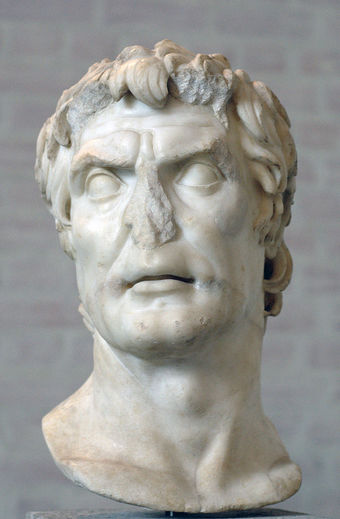
Bust of Sulla
The bust of Lucius Cornelius Sulla, an optimate who marched against Rome and installed himself as dictator in 82-81 BCE.
Pompey, Crassus, and the Catilinarian Conspiracy
In 77 BCE, two of Sulla’s former lieutenants, Gnaeus Pompeius
Magnus (“Pompey the Great”) and Marcus Licinius Crassus, had left Rome to put
down uprisings and found the populist party, attacking Sulla’s constitution upon
their return. In an attempt to forge an agreement with the populist party, both
lieutenants promised to dismantle components of Sulla’s constitution that the
populists found disagreeable, in return for being elected consul. The two were
elected in 70 BCE and held true to their word. Four years later, in 66 BCE, a
movement to use peaceful means to address the plights of the various classes
arose; however, after several failures in achieving their goals, the movement,
headed by Lucius Sergius Catilina and based in Faesulae, a hotbed of agrarian
agitation, decided to march to Rome and instigate an uprising. Marcus Tullius
Cicero, the consul at the time, intercepted messages regarding recruitment and
plans, leading the Senate to authorize the assassination of many Catilinarian
conspirators in Rome, an action that was seen as stemming from dubious
authority. This effectively disrupted the conspiracy and discredited the
populist party, in turn repairing the image of the Senate, which had come to be
seen as weak and not worthy of such violent attack.
First Triumvirate
In 62 BCE, Pompey returned from campaigning in Asia to find
that the Senate, elated by its successes against the Catiline conspirators,
was unwilling to ratify any of Pompey’s arrangements, leaving Pompey
powerless. Julius Caesar returned from his governorship in Spain a year later
and, along with Crassus, established a private agreement with Pompey known as
the First Triumvirate. Under the terms of this agreement, Pompey’s arrangements
would be ratified and Caesar would be elected consul in 59 BCE, subsequently
serving as governor of Gaul for five years. Crassus was promised the consulship
later.
When Caesar became consul, he saw the passage of Pompey’s
arrangements through the Senate, at times using violent means to ensure their
passage. Caesar also facilitated the election of patrician Publius Clodius
Pulcher to the tribunate in 58 BCE, and Clodius sidelined Caesar’s senatorial
opponents, Cato and Cicero. Clodius eventually formed armed gangs that
terrorized Rome and began to attack Pompey’s followers, who formed
counter-gangs in response, marking the end of the political alliance between
Pompey and Caeser. Though the triumvirate was briefly renewed in the face of
political opposition for the consulship from Domitius Ahenobarbus, Crassus’s
death during an expedition against the Kingdom of Parthia, and the death of
Pompey’s wife, Julia, who was also Caesar’s daughter, severed any remaining
bonds between Pompey and Caesar.
Beginning in the
summer of 54 BCE, a wave of political corruption and violence swept Rome,
reaching a climax in January 52 BCE, when Clodius was murdered in a gang war.
Caesar presented an ultimatum to the Senate on January 1, 49 BCE, which was
ultimately rejected. Subsequently, a resolution was passed that declared that if
Caesar did not lay down his arms by July, he would be considered an enemy of
the Republic. The senators adopted Pompey as their champion, and on January 7,
Pompey was granted dictatorial powers over the Republic by the Senate. Pompey’s
army, however, was composed mainly of untested conscripts, and on January 10,
Caesar crossed the Rubicon with his more experienced forces in defiance of
Roman laws, and marched towards Rome. Pompey, the consuls, and the Senate all
abandoned Rome for Greece, in the face of Caeser’s rapidly advancing forces, and
Caesar entered the city unopposed.
8.4: The Roman Empire
8.4.1: Julius Caesar
Julius Caesar was a late Republic statesman and general who waged civil war against the Roman Senate, defeating many patrician conservatives before he declared himself dictator.
Learning Objective
Explain the rise of Julius Caesar and his various successes
Key Points
- In 60 BCE, Julius Caesar, Marcus Licinius Crassus, and Gnaeus Pompeius Magnus (Pompey the Great) formed a political alliance, known as the First Triumvirate, that was to dominate Roman politics for several years, though their populist tactics were opposed by the conservative Senate.
- Caesar enjoyed great success as commander in the Gallic Wars. Upon conclusion of the wars, he refused to return to Rome as ordered by the Senate, and instead, crossed the Rubicon in 49 BCE with a legion, entering Roman territory under arms.
- Caesar fought in a civil war against his old colleague, Pompey, who had aligned himself with conservative interests in the Senate. Caesar quickly defeated his rival and many other Senate conservatives who had previously opposed him.
- With most of his enemies gone, Caesar installed himself as dictator in perpetuity. As dictator, he instituted a series of reforms and, most notably, created the Julian calendar.
- Caesar was assassinated in 44 BCE by his remaining enemies in the Senate, throwing Rome into another period of chaos and civil war.
Key Terms
- dictator
-
During Caesar’s time, in the late Roman Republic, ruler for life. In the early Republic, by contrast, a dictator was a general appointed by the Senate, who served temporarily during a national emergency.
- Julius Caesar
-
A Roman general, statesman, consul, and author, who
played a critical role in the events that led to the demise of the Roman
Republic and the rise of the Roman Empire. - Pompey
-
A military and political leader of the late Roman Republic, who represented the Roman Senate in a civil war against Julius Caesar.
Gaius Julius Caesar was a Roman general, statesman, consul, and notable author of Latin prose. He played a critical role in the events that led to the demise of the Roman Republic and the rise of the Roman Empire. In 60 BCE, Caesar, Marcus Licinius Crassus, and Gnaeus Pompeius Magnus (Pompey the Great) formed a political alliance, known as the First Triumvirate, that was to dominate Roman politics for several years. Caesar made the initial overtures that
led to the informal alliance. An acclaimed military commander who had also
served in a variety of political offices, Caesar sought election as consul in 59 BCE, along with two other candidates. The election was particularly
contentious, with corruption occurring on all sides. Caesar won, as well as conservative Marcus Bibulus, but saw that he could further his political
influence with Crassus and Pompey.
Their attempts to amass power through populist tactics were opposed by the conservative ruling class within the Roman Senate, among them Cato the Younger and Cicero. Meanwhile, Caesar’s victories in the Gallic Wars, completed by 51 BCE, extended Rome’s territory to the English Channel and the Rhine River. Caesar became the first Roman general to cross both when he built a bridge across the Rhine and conducted the first invasion of Britain.
These achievements granted Caesar unmatched military power and threatened to eclipse the standing of his colleague, Pompey, who had realigned himself with the Senate after the death of Crassus in 53 BCE. With the Gallic Wars concluded, the Senate ordered Caesar to step down from his military command and return to Rome. Caesar refused and marked his defiance in 49 BCE by crossing the Rubicon (shallow river in northern Italy) with a legion.
In doing so, he deliberately broke the law on
imperium and engaged in an open act of insurrection and treason.
Civil War ensued, with Pompey representing the Roman Senate forces against Caesar, but Caesar quickly defeated Pompey in 48 BCE, and dispatched Pompey’s supporters in the following year. During this time, many staunch Senate conservatives, such as Cato the Younger, were either killed or committed suicide, thereby greatly decreasing the number of optimates in Rome.
Caesar as Dictator
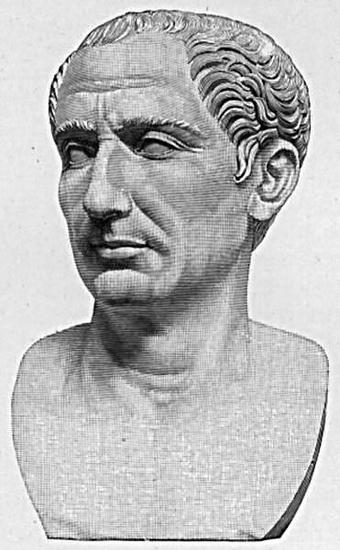
Bust of Julius Caesar
Gaius Julius Caesar was a Roman general, statesman, consul, and notable author of Latin prose.
After assuming control of the government upon the defeat of his enemies in 45 BCE, Caesar began a program of social and governmental reforms that included the creation of the Julian calendar. He centralized the bureaucracy of the Republic and eventually proclaimed himself “dictator in perpetuity.” It is important to note that Caesar did not declare himself rex (king), but instead, claimed the title of dictator. Contrary to the negative connotations that the modern use of the word evokes, the Roman dictator was appointed by the Senate during times of emergency as a unilateral decision-maker who could act more quickly than the usual bureaucratic processes that the Republican government would allow. Upon bringing the Roman state out of trouble, the dictator would then resign and restore power back to the Senate. Thus, Caesar’s declaration ostensibly remained within the Republican framework of power, though the huge amounts of power he had gathered for himself in practice set him up similar to a monarch.
Caesar used his powers to fill the Senate with his own partisans. He also increased the number of magistrates who were elected each year, which created a large pool of experienced magistrates and allowed Caesar to reward his supporters. He used his powers to appoint many new senators, which eventually raised the Senate’s membership to 900. All the appointments were of his own partisans, which robbed the senatorial aristocracy of its prestige and made the Senate increasingly subservient to him. To minimize the risk that another general might attempt to challenge him, Caesar passed a law that subjected governors to term limits. All of these changes watered down the power of the Senate, which infuriated those used to aristocratic privilege. Such anger proved to be fuel for Caesar’s eventual assassination.
Despite the defeat of most of his conservative enemies, however, underlying political conflicts had not been resolved. On the Ides of March (March 15) 44 BCE, Caesar was
scheduled
to appear at a session of the Senate, and a group of senators led by Marcus
Junius Brutus and Gaius Cassius Longinus conspired to assassinate him. Though
some of his assassins may have had ulterior personal vendettas against Caesar,
Brutus is said to have acted out of concern for the Republic in the face of
what he considered to be a monarchical tyrant. Mark Antony, one of Caesar’s
generals and administrator of Italy during Caesar’s campaigns abroad, learned
such a plan existed the night before, and attempted to intercept Caesar, but the
plotters anticipated this and arranged to meet him outside the site of the
session and detain him him there. Caesar was stabbed 23 times and lay dead on
the ground for some time before officials removed his body.
A new series of civil wars broke out following Caesar’s assassination, and the constitutional government of the Republic was never restored. Caesar’s adopted heir, Octavian, later known as Augustus, rose to sole power, and the era of the Roman Empire began.
8.4.2: Founding of the Roman Empire
Augustus rose to power after Julius Caesar’s assassination, through a series of political and military maneuvers, eventually establishing himself as the first emperor of Rome.
Learning Objective
Explain the key features of Augustus’s reign and the reasons for its successes
Key Points
- Following the assassination of his maternal great-uncle Julius Caesar in 44 BCE, Caesar’s will named Octavian as his adopted son and heir when Octavian was only 19 years old.
- By ingratiating himself with his father’s legions, Octavian was able to fulfill the military demands of the Roman Senate. He quickly gained both power and prestige and formed the Second Triumvirate with Antony and Lepidus in 43 BCE.
- By 31 BCE, Octavian had emerged as the sole ruler of Rome, upon the political and military defeat of the two other triumvirs.
Key Terms
- Mark Antony
-
Julius Caesar’s right hand man, and a member of the Second Triumvirate. He was eventually defeated by Octavian at the Battle of Actium in 31 BCE.
- Augustus
-
The founder of the Roman Empire, known as Octavian during his early years and during his rise to power.
Augustus is regarded by many scholars as the founder and first emperor of the Roman Empire. He ruled from 27 BCE until his death in 14 CE.
Rise to Power
Augustus was born Gaius Octavius, and in his early years was known as Octavian. He was from an old and wealthy equestrian branch of the plebeian Octavii family. Following the assassination of his maternal great-uncle, Julius Caesar, in 44 BCE, Caesar’s will named Octavian as his adopted son and heir when Octavian was only 19 years old. The young Octavian quickly took advantage of the situation and ingratiated himself with both the Roman people and his adoptive father’s legions, thereby elevating his status and importance within Rome. Octavian found Mark Antony, Julius Caesar’s
former colleague and the current consul of Rome,
in an uneasy truce with Caesar’s assassins, who had been granted general amnesty
for their part in the plot. Nonetheless, Antony eventually succeeded in driving
most of them out of Rome, using Caesar’s eulogy as an opportunity to mount
public opinion against the assassins.
Mark Antony began amassing political support, and
Octavian set about rivaling it. Eventually, many Caesarian sympathizers began to
view Octavian as the lesser evil of the two. Octavian allied himself with
optimate factions, despite their opposition to Caesar when he was alive. The
optimate orator, Marcus Tullius Cicero, began attacking Antony in a series of
speeches, portraying him as a threat to the republican order of Rome. As public
opinion against him mounted, Antony fled to Cisalpine Gaul at the end of his
consular year.
Octavian further established himself both politically and militarily in the following months. He was declared a senator and granted the power of military command, imperium, in 43 BCE, and was further able to leverage his successes to obtain the vacant consulships left by the two defeated consuls of that year.
Octavian eventually reached an uneasy truce with Mark Antony and Marcus Lepidus in October 43 BCE, and together, the three formed the Second Triumvirate to defeat the assassins of Caesar. Following their victory against Brutus at Phillipi, the Triumvirate divided the Roman Republic among themselves and ruled as military dictators. Relations within the Triumvirate were strained as the various members sought greater political power. Civil war between Antony and Octavian was averted in 40 BCE, when Antony married Octavian’s sister, Octavia Minor. Despite his marriage, Antony continued a love affair with Cleopatra, the former lover of Caesar and queen of Egypt, further straining political ties to Rome. Octavian used Antony’s relationship with Cleopatra to his own advantage, portraying Antony as less committed to Rome. With Lepidus expelled in 36 BCE, the Triumvirate finally disintegrated in the year 33. Finally, disagreements between Octavian and Antony erupted into civil war in the year 31 BCE.
The Roman Senate, at Octavian’s direction, declared war on Cleopatra’s regime in Egypt and proclaimed Antony a traitor. Antony was defeated by Octavian at the naval Battle of Actium the same year. Defeated, Antony fled with Cleopatra to Alexandria where they both committed suicide. With Antony dead, Octavian was left as the undisputed master of the Roman world. Octavian would assume the title Augustus, and reign as the first Roman Emperor.
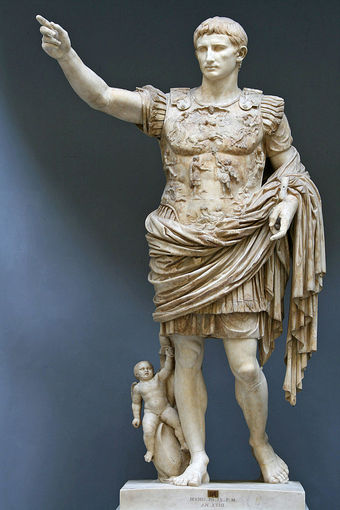
Augustus of Prima Porta
The statue of Augustus of Prima Porta is perhaps one of the best known images of the Emperor Augustus. It portrays the emperor as perpetually youthful, and depicts many of the key propaganda messages that Augustus put forth during his time as emperor.
8.4.3: The Pax Romana
The Pax Romana, which began under Augustus, was a 200-year period of peace in which Rome experienced minimal expansion by military forces.
Learning Objective
Describe the key reasons for and characteristics of the Pax Romana
Key Points
- The Pax Romana was established under Augustus, and for that reason it is sometimes referred to as the Pax Augusta.
- Augustus closed the Gates of Janus three times to signify the onset of peace: in 29 BCE, 25 BCE, and 13 BCE, likely in conjunction with the Ara Pacis ceremony.
- The Romans regarded peace not as an absence of war, but as the rare situation that existed when all opponents had been beaten down and lost the ability to resist. Thus, Augustus had to persuade Romans that the prosperity they could achieve in the absence of warfare was better for the Empire than the potential wealth and honor acquired when fighting a risky war.
- The Ara Pacis is a prime example of the propaganda Augustus employed to promote the Pax Romana, and depicts images of Roman gods and the city of Rome personified amidst wealth and prosperity.
Key Terms
- Pax Romana
-
The long period of relative peace and minimal expansion by military force experienced by the Roman Empire in the 1st and 2nd centuries CE. Also sometimes known as the Pax Augusta.
- Ara Pacis Augustae
-
The Altar of Augustan Peace, a sacrificial altar that displays imagery of the peace and prosperity Augustus achieved during the Pax Romana.
Augustus’s Constitutional Reforms
After the demise of the Second Triumvirate, Augustus restored the
outward facade of the free Republic with governmental power vested in the Roman
Senate, the executive magistrates, and the legislative assemblies. In reality,
however, he retained his autocratic power over the Republic as a military
dictator. By law, Augustus held powers granted to him for life by the Senate,
including supreme military command and those of tribune and censor. It took several
years for Augustus to develop the framework within which a formally republican
state could be led under his sole rule.
Augustus passed a series of laws between the years 30 and 2 BCE that
transformed the constitution of the Roman Republic into the constitution of the
Roman Empire. During this time, Augustus reformed the Roman system of taxation,
developed networks of roads with an official courier system, established a
standing army, established the Praetorian Guard, created official police and
fire-fighting services for Rome, and rebuilt much of the city during his reign.
First Settlement
During the First Settlement, Augustus modified the Roman
political system to make it more palatable to the senatorial classes, eschewing
the open authoritarianism exhibited by Julius Caesar and Mark Anthony. In 28
BCE, in a calculated move, Augustus eradicated the emergency powers he held as
dictator and returned all powers and provinces to the Senate and the Roman
people. Members of the Senate were unhappy with this prospect, and in order to
appease them, Augustus agreed to a ten-year extension of responsibilities over
disorderly provinces. As a result of this, Augustus retained imperium over the provinces where the
majority of Rome’s soldiers were stationed. Augustus also rejected
monarchical titles, instead calling himself princeps civitatis (“First Citizen”). The
resulting constitutional framework became known as the Principate, the first
phase of the Roman Empire.
At this time, Augustus was given honorifics that made his
full name Imperator Caesar divi filius
Augustus. Imperator stressed
military power and victory and emphasized his role as commander-in-chief. Divi filius roughly translates to “son
of the divine,” enhancing his legitimacy as ruler without deifying him completely.
The use of Caesar provided a link
between himself and Julius Caesar, who was still very popular among lower
classes. Finally, the name Augustus raised associations to Rome’s illustrious
and majestic traditions, without creating heavy authoritarian overtones.
By the end of the first settlement, Augustus was in an ideal
political position. Although he no longer held dictatorial powers, he had
created an identity of such influence that authority followed naturally.
Second Settlement
In the wake of Augustus’s poor health, a second settlement
was announced in 23 BCE. During this time, Augustus outwardly appeared to rein
in his constitutional powers, but really continued to extend his dominion
throughout the Empire. Augustus renounced his ten-year consulship, but in
return, secured the following concessions for himself.
- A seat on the consuls’s platform at the front of the Curia
-
The right to speak first in a Senate meeting, or ius primae relationis
-
The right to summon a meeting of the Senate, which was a
useful tool for policy making -
Care of Rome’s grain supply, or cura annonae, which gave him sweeping patronage powers over the plebs
Augustus was also granted the role of tribunicia potestas, which enabled him to act as the guardian of
the citizens of Rome. This position came with a number of benefits, including
the right to propose laws to the Senate whenever he wanted, veto power of laws,
and the ability to grant amnesty to any citizen accused of a crime. Though the
role of tribunicia potestas effectively
gave Augustus legislative supremacy, it also had many positive connotations
hearkening back to the Republic, making Augustus’s position less offensive to
the aristocracy. Beyond Rome, Augustus was granted maius imperium, meaning greater (proconsular) power. This position
enabled him to effectively override the orders of any other provincial governor
in the Roman Empire, in addition to governing his own provinces and armies.
Augustus and the Pax Romana
The Pax Romana (Latin for “Roman peace”) was a long period of relative peace and minimal expansion by military forces experienced by the Roman Empire in the 1st and 2nd centuries CE. Since
this
period was initiated during
Augustus’s reign, it is sometimes called Pax Augusta. Its span was approximately 206 years (27 BCE to 180 CE).
The Pax Romana started after Augustus, then Octavian, met and defeated Mark Antony in the Battle of Actium in 31 BCE. Augustus created a junta of the greatest military magnates and gave himself the titular honor. By binding together these leading magnates into a single title, he eliminated the prospect of civil war. The Pax Romana was not immediate, despite the end of the civil war, because fighting continued in Hispania and in the Alps.
Despite continuous wars of imperial expansion on the Empire’s frontiers
and one year-long civil war over the imperial succession, the Roman world was
largely free from large-scale conflict for more than two centuries. Augustus
dramatically enlarged the Empire, annexing Egypt, Dalmatia, Pannonia, Noricum,
and Raetia, expanded possessions in Africa as well as into Germania, and
completed the conquest of Hispania. Beyond Rome’s frontiers, he secured the
Empire with a buffer region of client states, and made peace with the
troublesome Parthian Empire through diplomacy.
Augustus closed the Gates of Janus (the set of gates to the Temple of Janus, which was closed in times of peace and opened in times of war) three times. The first time was in 29 BCE and the second in 25 BCE. The third closure is undocumented, but scholars have persuasively dated the event to 13 BCE during the Ara Pacis ceremony, which was held after Augustus and Agrippa jointly returned from pacifying the provinces.
Augustus faced some trouble making peace an acceptable mode of life for the Romans, who had been at war with one power or another continuously for 200 years prior to this period. The Romans regarded peace not as an absence of war, but the rare situation that existed when all opponents had been beaten down and lost the ability to resist. Augustus’s challenge was to persuade Romans that the prosperity they could achieve in the absence of war was better for the Empire than the potential wealth and honor acquired from fighting. Augustus succeeded by means of skillful propaganda. Subsequent emperors followed his lead, sometimes producing lavish ceremonies to close the Gates of Janus, issuing coins with Pax on the reverse, and patronizing literature extolling the benefits of the Pax Romana.
The Ara Pacis Augustae
The Ara Pacis Augustae, or Altar of Augustan Peace, is one of the best examples of Augustan artistic propaganda and the prime symbol of the new Pax Romana. It was commissioned by the Senate in 13 BCE to honor the peace and bounty established by Augustus following his return from Spain and Gaul.
The theme of peace is seen most notably in the east
and west walls of the Ara Pacis, each of which had two panels, although only
small fragments remain for one panel on each side. On the east side sits an
unidentified goddess presumed by scholars to be Tellus, Venus, or Peace within
an allegorical scene of prosperity and fertility. Twins sit on her lap along
with a cornucopia of fruits. Personifications of the wind and sea surround her,
each riding on a bird or a sea monster. Beneath the women rests a bull and
lamb, both sacrificial animals, and flowering plants fill the empty space. The
nearly incomplete second eastern panel appears to depict a female warrior,
possibly Roma, amid the spoils of conquest.
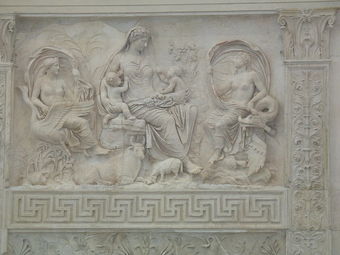
The Tellus Mater Panel of the Ara Pacis
The eastern wall of the Ara Pacis, which depicts the Tellus Mater surrounded by symbols of fertility and prosperity.
Augustus died in 14 CE at the age of 75. He
may have died from natural causes, although unconfirmed rumors swirled that
his wife Livia poisoned him. His adopted son (also stepson and former
son-in-law), Tiberius, succeeded him to the throne.
8.4.4: The Julio-Claudian Emperors
The Julio-Claudian emperors expanded the
boundaries of the Roman Empire and engaged in ambitious construction projects. However, they were met with mixed public reception due to their unique ruling methods.
Learning Objective
Describe the reigns of the emperors who followed
Augustus
Key Points
- Tiberius was the
second emperor of the Roman Empire, and was considered one of Rome’s greatest
generals. - Tiberius
conquered Pannonia, Dalmatia, Raetia, and temporarily, parts of Germania. His
conquests laid the foundations for the northern frontier. - When Tiberius
died on March 16, 37 CE, his estate and titles were left to Caligula and
Tiberius’s grandson, Gemellus. However, Caligula’s first act as Princeps was to
to void Tiberius’s will and have Gemellus executed. - Although
Caligula is described as a noble and moderate ruler during the first six months
of his reign, sources portray him as a cruel and sadistic tyrant, immediately
thereafter. - In 38 CE,
Caligula focused his attention on political and public reform; however, by 39
CE, a financial crisis had emerged as a result of Caligula’s use of political
payments, which had overextended the state’s treasury. Despite financial
difficulties, Caligula began a number of construction projects during this
time. - In 41 CE,
Caligula was assassinated as part of a conspiracy by officers of the Paretorian
Guard, senators, and courtiers. - Claudius, the
fourth emperor of the Roman Empire, was the first Roman Emperor to be born
outside of Italy. - Despite his lack
of experience, Claudius was an able and efficient administrator, as well as an
ambitious builder. He constructed many roads, aqueducts, and canals across the
Empire. - Claudius’s appointment as emperor by the Praetorian Guard damaged his reputation. This was amplified when Claudius became the first
emperor to resort to bribery as a means to secure army loyalty. Claudius also
rewarded the Praetorian Guard that had named him emperor with 15,000 sesterces.
Key Terms
- Julio-Claudian dynasty
-
The first five Roman emperors who ruled the
Roman Empire, including Augustus, Tiberius, Caligula, Claudius, and Nero. - Praetorian Guard
-
A force of bodyguards used by the Roman
emperors. They also served as secret police, and participated in wars.
Tiberius
Tiberius was the second
emperor of the Roman Empire and reigned from 14 to 37 CE. The previous emperor,
Augustus, was his stepfather; this officially made him a Julian. However, his
biological father was Tiberius Claudius Nero, making him a Claudian by birth.
Subsequent emperors would continue the blended dynasty of both families for the
next 30 years, leading historians to name it the Julio-Claudian Dynasty.
Tiberius is also the grand-uncle of Caligula, his successor, the paternal uncle
of Claudius, and the great-grand uncle of Nero.
Tiberius is considered one
of Rome’s greatest generals. During his reign, he conquered Pannonia, Dalmatia,
Raetia, and temporarily, parts of Germania. His conquests laid the foundations
for the northern frontier. However, he was known by contemporaries to be dark,
reclusive, and somber—a ruler who never really wanted to be emperor. The tone
was set early in his reign when the Senate convened to validate his position as
Princeps. During the proceedings, Tiberius attempted to play the part of the
reluctant public servant, but came across as derisive and obstructive. His
direct orders appeared vague, inspiring more debate than action and leaving the
Senate to act on its own. After the death of Tiberius’s son in 23 CE, the
emperor became even more reclusive, leaving the administration largely in the
hands of his unscrupulous Praetorian Prefects.
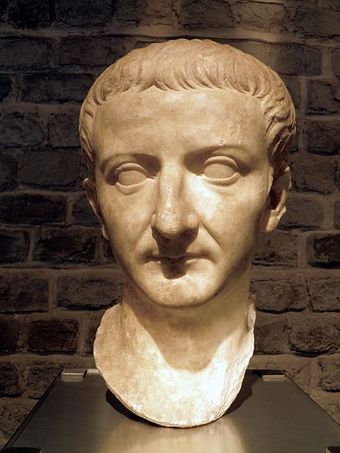
Tiberius
Tiberius, Romisch-Germanisches Museum, Cologne
Caligula
When Tiberius died on March
16, 37 CE, his estate and titles were left to Caligula and Tiberius’s grandson,
Gemellus, with the intention that they would rule as joint heirs. However,
Caligula’s first act as Princeps was to to void Tiberius’s will and have
Gemellus executed. When Tiberius died, he had not been well liked. Caligula, on
the other hand, was almost universally heralded upon his assumption of the
throne. There are few surviving sources on Caligula’s reign. Caligula’s first
acts as emperor were generous in spirit, but political in nature. He granted
bonuses to the military, including the Praetorian Guard, city troops, and the
army outside of Italy. He destroyed Tiberius’s treason papers and declared that
treason trials would no longer continue as a practice, even going so far as to
recall those who had already been sent into exile for treason. He also helped
those who had been adversely affected by the imperial tax system, banished
certain sexual deviants, and put on large public spectacles, such as
gladiatorial games, for the common people.
Although he is described as
a noble and moderate ruler during the first six months of his reign, sources
portray him as a cruel and sadistic tyrant immediately thereafter. The
transitional point seems to center around an illness Caligula experienced in
October of 37 CE. It is unclear whether the incident was merely an illness, or
if Caligula had been poisoned. Either way, following the incident, the young
emperor began dealing with what he considered to be serious threats, by killing
or exiling those who were close to him. During the remainder of his reign, he worked
to increase the personal power of the emperor during his short reign, and
devoted much of his attention to ambitious construction projects and luxurious
dwellings for himself.
In 38 CE, Caligula focused
his attention on political and public reform. He published the accounts of
public funds, which had not been done under Tiberius’s reign, provided aid to
those who lost property in fires, and abolished certain taxes. He also allowed
new members into the equestrian and senatorial orders. Perhaps most
significantly, he restored the practice of democratic elections, which
delighted much of the public but was a cause for concern among the aristocracy.
By 39 CE, a financial crisis
had emerged as a result of Caligula’s use of political payments, which had
overextended the state’s treasury. In order to to restock the treasury,
Caligula began falsely accusing, fining, and even killing individuals in order
to seize their estates. He also asked the public to lend the state money, and
raised taxes on lawsuits, weddings, and prostitution, as well as auctioning the
lives of gladiators at shows. Wills that left items to Tiberius were also
reinterpreted as having left said items to Caligula. Centurions who had
acquired property by plunder were also forced to turn over their spoils to the
state, and highway commissioners were accused of incompetence and embezzlement
and forced to repay money that they might not have taken in the first place. Around
the same time, a brief famine occurred, possibly as a result of the financial
crisis, though its causes remain unclear.
Despite financial
difficulties, Caligula began a number of construction projects during this
time. He initiated the construction of two aqueducts in Rome, Awua Claudia and
Anio Novus, which were considered contemporary engineering marvels. In 39 CE,
he ordered the construction of a temporary floating bridge between the resort
of Baiae and the port of Puteoli, which rivaled the bridge Persian king Xerxes
had constructed across the Hellespont. Caligula had two large ships constructed
for himself that were among the largest constructed in the ancient world. The larger of the two was essentially an elaborate floating palace with marble floors
and plumbing. He also improved the harbors at Rhegium and Sicily, which allowed
for increased grain imports from Egypt, possibly in response to the famine Rome
experienced.
During his reign, the Empire
annexed the Kingdom of Mauretania as a province. Mauretania had previously been
a client kingdom ruled by Ptolemy of Mauretania. Details on how and why
Mauretania was ultimately annexed remain unclear. Ptolemy was had been invited
to Rome by Caligula and suddenly executed in what was seemingly a personal
political move, rather than a calculated response to military of economic needs.
However, Roman possession of Mauretania ultimately proved to be a boon to the
territory, as the subsequent rebellion of Tacfarinas demonstrated how exposed the
African Proconsularis was on its western borders. There also was a northern
campaign to Britannia that was aborted during Caligula’s reign, though there is not a
cohesive narrative of the event.
In 39 CE, relations between
Caligula and the Senate deteriorated. Caligula ordered a new set of treason
investigations and trials, replacing the consul and putting a number of senators
to death. Many other senators were reportedly treated in a degrading fashion and
humiliated by Caligula. In 41 CE, Caligula was assassinated as part of a
conspiracy by officers of the Praetorian Guard, senators, and courtiers. The
conspirators used the assassination as an opportunity to re-institute the
Republic, but were ultimately unsuccessful.
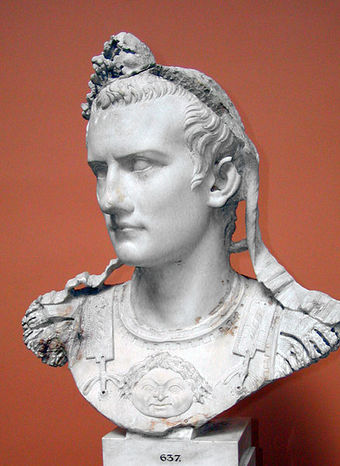
Caligula
Emperor Caligula, Ny Carlsberg Glyptotek.
Claudius
Claudius, the fourth emperor
of the Roman Empire, was the first Roman Emperor to be born outside of Italy.
He was afflicted with a limp and slight deafness, which caused his family to
ostracize him and exclude him from public office until he shared the consulship
with his nephew, Caligula, in 37 CE. Due to Claudius’s afflictions, it is likely
he was spared from the many purges of Tiberius and Caligula’s reigns. As a
result, Claudius was declared Emperor by the Praetorian Guard after Caligula’s
assassination, due to his position as the last man in the Julio-Claudian line.
Despite his lack of
experience, Claudius was an able and efficient administrator, as well as an
ambitious builder; he constructed many roads, aqueducts, and canals across the
Empire. His reign also saw the beginning of the conquest of Britain.
Additionally, Claudius presided over many public trials, and issued up to 20
edicts a day. However, in spite of his capable rule, Claudius continued to be viewed
as vulnerable by the Roman nobility throughout his reign, forcing Claudius to
constantly defend his position. He did so by emphasizing his place within the
Julio-Claudian family, dropping the cognomen, Nero, from his name, and replacing
it with Caesar.
Nonetheless, his appointment as emperor by the Praetorian Guard caused
damage to his reputation, and this was amplified when Claudius became the first
emperor to resort to bribery as a means to secure army loyalty. Claudius also
rewarded the Praetorian Guard that had named him emperor with 15,000 sesterces.
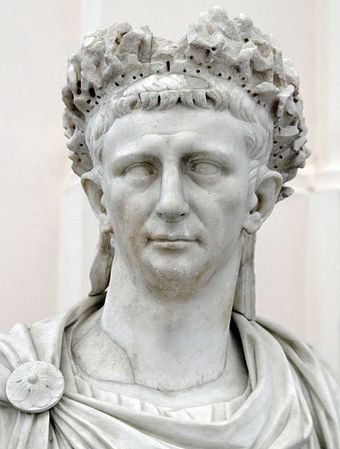
Claudius
Bust of Emperor Claudius.
8.4.5: The Last Julio-Claudian Emperors
Nero’s consolidation of personal power led to rebellion,
civil war, and a year-long period of upheaval, during which four separate
emperors ruled Rome.
Learning Objective
Explain how Nero and other factors contributed
to the fall of the Julio-Claudian Dynasty
Key Points
- Nero reigned as
Roman Emperor from 54 to 68 CE, and was the last emperor in the Julio-Claudian Dynasty. - Very early in
Nero’s rule, problems arose, due to his mother, Agrippina the Younger’s competition for influence with Nero’s two main advisers, Seneca and Burrus. - Nero minimized
the influence of all of his advisers and effectively eliminating all rivals to his
throne. He also slowly removed power from the Senate, despite having promised
to grant them with powers equivalent to those they had under republican rule. - In March 68,
Gaius Gulius Vindex, the governor of Gallia Lugdunensis, rebelled against Nero’s
tax policies and called upon the support of Servius Sulpicius Galba, the
governor of Hispania Tarraconensis, who not only joined the rebellion, but also
declared himself emperor in opposition to Nero. Galba would become the first
emperor in what was known as the Year of the Four Emperors. - Vespasian was the fourth and final emperor to rule in the year 69 CE, and
established the stable Flavian Dynasty, that was to succeed the
Julio-Claudians.
Key Terms
- Praetorian Guard
-
A force of bodyguards used by the Roman
emperors. They also served as secret police and participated in wars. - Julio-Claudian
dynasty -
The first five Roman emperors who ruled the
Roman Empire, including Augustus, Tiberius, Caligula, Claudius, and Nero. - Flavian dynasty
-
A Roman imperial dynasty that ruled the Roman
Empire from 69 to 96 CE, encompassing the reigns of Vespasian and his two sons,
Titus and Domitian.
Nero
Nero reigned as Roman
Emperor from 54 to 68 CE, and was the last emperor in the Julio-Claudian Dynasty. Nero focused on diplomacy, trade, and enhancing the cultural life of
the Empire during his rule. He ordered theaters to be built and promoted
athletic games. However, according to Tacitus, a historian writing one
generation after Nero’s rule, Nero was viewed by many Romans as compulsive and
corrupt. Suetonius, another historian writing a generation after Nero’s rule,
claims that Nero began the Great Fire of Rome in 64 CE, in order to clear land
for a palatial complex he was planning.
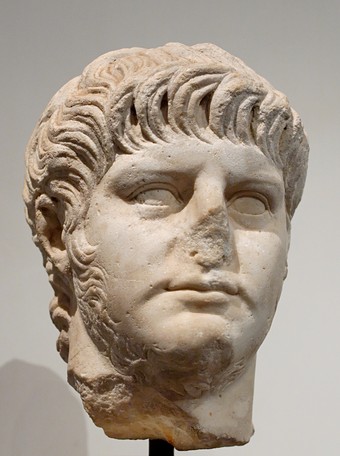
Nero
A marble bust of Nero, at the Antiquarium of the Palatine.
Early Rule
When Claudius died in 54,
Nero was established as the new emperor. According to some ancient historians,
Agrippina the Younger, Nero’s mother, poisoned Claudius in order to make Nero
the youngest Roman emperor (at the age of 17). Very early in Nero’s rule,
problems arose due to Agrippina’s competition for influence with Nero’s two
main advisers, Seneca and Burrus. For example, in the year 54, Agrippina caused
a scandal by attempting to sit with Nero while he met with the Armenian envoy,
an unheard of act, since women were not permitted to be in the same room as men
while official business was being conducted. The next year, Agrippina attempted
to intervene on behalf of Nero’s wife, Octavia, with whom Nero was dissatisfied
and cheating on with a former slave. With the help of his adviser, Seneca, Nero
managed to resist his mother’s interference yet again.
Sensing his resistance to
her influence, Agrippina began pushing for Britannicus, Nero’s stepbrother, to
become emperor. Britannicus was still shy of 14 years old, and legally still a
minor, but because he was the son of the previous emperor, Claudius, by blood,
Agrippina held hope that he would be accepted as the true heir to the throne.
Her efforts were thwarted, however, when Britannicus mysteriously died one day
short of becoming a legal adult. Many ancient historians claim that Britannicus
was poisoned by his stepbrother, Nero. Shortly thereafter, Agrippina was ordered
out of the imperial residence.
Consolidation of Power
Over time, Nero began
minimizing the influence of all advisers and effectively eliminating all rivals
to his throne. Even Seneca and Burrus were accused of conspiring against, and
embezzling from the emperor; they were eventually acquitted, reducing their
roles from careful management of the government to mere moderation of Nero’s
actions on the throne. In 58 CE, Nero became romantically involved with Poppaea
Sabina, the wife of his friend and future emperor, Otho. Because divorcing his
current wife and marrying Poppaea did not seem politically feasible with his
mother still alive, Nero ordered Agrippina’s murder the following year.
Nero’s consolidation of
power included a slow usurpation of authority from the Senate. Although he had
promised the Senate powers equivalent to those it had under republican rule,
over the course of the first decade of Nero’s rule, the Senate was divested of all
its authority, which led directly to the Pisonian Conspiracy of 65. Gaius
Calpurnius Piso, a Roman statesman, organized the conspiracy against Nero with
the help of Subrius Flavus, a tribune, and Sulpicius Asper, a centurion of the
Praetorian Guard, in order to restore the Republic and wrest power from the
emperor. However, the conspiracy failed when it was discovered by a freedman, who reported the details to Nero’s secretary. This led to the execution of all
conspirators. Seneca was also ordered to commit suicide after he admitted to
having prior knowledge of the plot.
Vindex and Galba’s Revolt
In March 68, Gaius Gulius
Vindex, the governor of Gallia Lugdunensis, rebelled against Nero’s tax
policies and called upon the support of Servius Sulpicius Galba, the governor
of Hispania Tarraconensis, who not only joined the rebellion, but also declared
himself emperor in opposition to Nero. Two months later, Vindex’s forces were
defeated at the Battle of Vesontio, and Vindex committed suicide. The legions
that defeated Vindex then attempted to proclaim their own commander, Verginius,
as emperor, but Verginius refused to act against Nero. Meanwhile, public
support for Galba grew despite his being officially declared a public enemy. In
response, Nero began to flee Rome only to turn back when the army officers that
were with him refused to obey his commands. When Nero returned, he received
word that the Senate had declared him a public enemy and intended to beat him
to death—although in actuality, the Senate remained open to mediating an end to
the conflict, and many senators felt a sense of loyalty to Nero, even if only
on account of him being the last of the Julio-Claudian line. However, Nero was
unaware of this and convinced his private secretary to help him take his own
life.
Year of the Four Emperors
The suicide of Emperor Nero
was followed by a brief period of civil war. Then, between June 68 and December
69, four emperors ruled in succession: Galba, Otho, Vitellius, and Vespasian.
Galba was recognized as
emperor following Nero’s suicide, but he did not remain popular for long. On
his march to Rome, he either destroyed or took enormous fines from towns that
did not accept him immediately. Once in Rome, Galba made many of Nero’s reforms
redundant, including ones that benefited important people within Roman
society. Galba executed many senators and equites without trial, in a paranoid
attempt to consolidate his power, which unsettled many, including the
Praetorian Guard. Finally, the legions of Germania Inferior refused to swear
allegiance and obedience to Galba, instead proclaiming the governor Vitellius
as emperor.
This caused Galba to panic
and name Lucius Calpurnius Piso Licinianus, a young senator, as his successor.
This upset many people, but especially Marcus Salvius Otho, who had coveted
after the title for himself. Otho bribed the Praetorian Guard to support him
and embarked upon a coup d’etat, during which Galba was killed by the
Praetorians. Otho was recognized as emperor by the Senate the same day and was
expected by many to be a fair ruler. Unfortunately, soon thereafter, Vitellius
declared himself Imperator in Germania, and dispatched half his army to march on
Italy.
Otho attempted to broker a
peace, but Vitellius was uninterested, especially because his legions were some
of the finest in the empire, which gave him a great advantage over Otho.
Indeed, Otho was eventually defeated at the Battle of Bedriacum, and rather
than flee and attempt a counterattack, Otho committed suicide. He had been emperor
for little more than three months. Vitellius was recognized as emperor by the
Senate. Very quickly thereafter, he proceeded to bankrupt the imperial treasury
by throwing a series of feasts, banquets, and triumphal parades. He tortured
and executed money lenders who demanded payment and killed any citizens who
named him as their heir. He also lured many political rivals to his palace in
order to assassinate them.
Meanwhile, many of the legions in the African province of Egypt, and the
Middle East provinces of Iudaea and Syria, including the governor of Syria,
acclaimed Vespasian as their emperor. A force marched from the Middle East to
Rome, and Vespasian traveled to Alexandria, where he was officially named
Emperor. From there, Vespasian invaded Italy and won a crushing victory over
Vitellius’s army at the Second Battle of Bedriacum. Vitellius was found by
Vespasian’s men at the imperial palace and put to death. The Senate
acknowledged Vespasian as emperor the next day, marking the beginning of the
Flavian Dynasty, which was to succeed the Julio-Claudian line. Vespasian
remained emperor for the rest of his natural life.
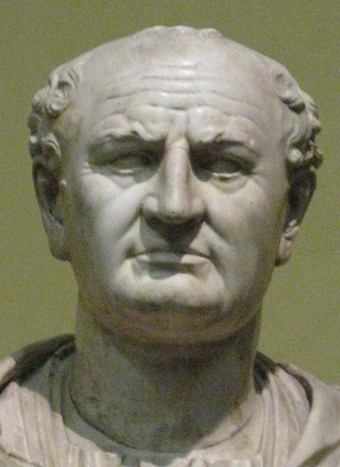
Vespasian
A plaster cast of Vespasian in the Pushkin Museum, after an original held in the Louvre.
8.5: The Flavian Dynasty
8.5.1: The Flavian Dynasty
The Flavian Dynasty, which began under the rule of Vespasian during the Year of the Four Emperors, is known for several significant historic, economic, and military events.
Learning Objective
Analyze how Vespasian consolidated control over the empire
Key Points
- Vespasian, a general for the Roman army, founded the Flavian Dynasty, which ruled the Empire for 27 years.
- While Vespasian besieged Jerusalem during the Jewish rebellion, emperor Nero committed suicide and plunged Rome into a year of civil war, known as the Year of the Four Emperors.
- After Galba and Otho perished in quick succession, Vitellius became the third emperor in April 69 CE.
- The Roman legions of Roman Egypt and Judaea reacted by declaring Vespasian, their commander, emperor on July 1, 69 CE.
- In his bid for imperial power, Vespasian joined forces with Mucianus, the governor of Syria, and Primus, a general in Pannonia, leaving his son, Titus, to command the besieging forces at Jerusalem; Primus and Mucianus led the Flavian forces against Vitellius, while Vespasian took control of Egypt.
- On December 20, 69, Vitellius was defeated, and the following day, Vespasian was declared Emperor by the Senate.
- Little information survives about the government during Vespasian’s ten-year rule; he reformed the financial system at Rome after the campaign against Judaea ended successfully, and initiated several ambitious construction projects.
Key Terms
- Colosseum
-
Also known as the Flavian Amphitheater, an oval amphitheater in the center of the city of Rome, Italy, built of concrete and sand. The largest amphitheater ever built, used for gladiatorial contests and public spectacles, such as mock sea battles, animal hunts, executions, re-enactments of famous battles, and dramas based on Classical mythology.
- Year of the Four Emperors
-
A year in the history of the Roman Empire, 69 CE, in which four emperors ruled in succession: Galba, Otho, Vitellius, and Vespasian.
- Praetorian Guard
-
A force of bodyguards used by Roman Emperors, who also served as secret police and participated in wars.
Overview
The Flavian Dynasty was a Roman imperial dynasty that ruled the Roman Empire between 69 CE and 96 CE, encompassing the reigns of Vespasian (69-79 CE), and his two sons Titus (79-81 CE) and Domitian (81-96 CE). The Flavians rose to power during the civil war of 69, known as the Year of the Four Emperors. After Galba and Otho died in quick succession, Vitellius became emperor in mid 69 CE. His claim to the throne was quickly challenged by legions stationed in the Eastern provinces, who declared their commander, Vespasian, emperor in his place. The Second Battle of Bedriacum tilted the balance decisively in favor of the Flavian forces, who entered Rome on December 20. The following day, the Roman Senate officially declared Vespasian emperor of the Roman Empire, thus commencing the Flavian Dynasty. Although the dynasty proved to be short-lived, several significant historic, economic, and military events took place during their reign.
The Flavians initiated economic and cultural reforms. Under Vespasian, new taxes were devised to restore the Empire’s finances, while Domitian revalued the Roman coinage by increasing its silver content. A massive building program was enacted to celebrate the ascent of the Flavian Dynasty, leaving multiple enduring landmarks in the city of Rome, the most spectacular of which was the Flavian Amphitheater, better known as the Colosseum.
Rise to Power
On June 9, 68 CE, amidst growing opposition of the Senate and the army, Nero committed suicide, and with him the Julio-Claudian Dynasty came to an end. Chaos ensued, leading to a year of brutal civil war, known as the Year of the Four Emperors, during which the four most influential generals in the Roman Empire—Galba, Otho, Vitellius and Vespasian—successively vied for imperial power. News of Nero’s death reached Vespasian as he was preparing to besiege the city of Jerusalem. Almost simultaneously the Senate had declared Galba, then governor of Hispania Tarraconensis (modern Spain), as Emperor of Rome. Rather than continue his campaign, Vespasian decided to await further orders and send Titus to greet the new Emperor. Before reaching Italy however, Titus learned that Galba had been murdered and replaced by Otho, the governor of Lusitania (modern Portugal). At the same time, Vitellius and his armies in Germania had risen in revolt, and prepared to march on Rome, intent on overthrowing Otho. Not wanting to risk being taken hostage by one side or the other, Titus abandoned the journey to Rome and rejoined his father in Judaea.
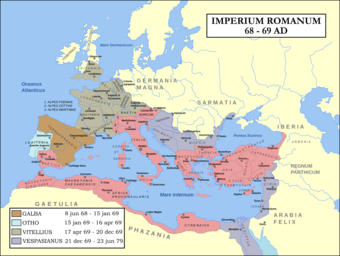
Roman Empire in 69 CE
The Roman Empire during the Year of the Four Emperors (69 CE). Purple areas indicate provinces loyal to Vespasian and Gaius Licinius Mucianus. Green areas indicate provinces loyal to Vitellius.
Otho and Vitellius realized the potential threat posed by the Flavian faction. With four legions at his disposal, Vespasian commanded a strength of nearly 80,000 soldiers. His position in Judaea further granted him the advantage of being nearest to the vital province of Egypt, which controlled the grain supply to Rome. His brother, Titus Flavius Sabinus II, as city prefect, commanded the entire city garrison of Rome. Tensions among the Flavian troops ran high, but as long as Galba and Otho remained in power, Vespasian refused to take action. When Otho was defeated by Vitellius at the First Battle of Bedriacum however, the armies in Judaea and Egypt took matters into their own hands, and declared Vespasian emperor on July 1, 69. Vespasian accepted, and entered an alliance with Gaius Licinius Mucianus, the governor of Syria, against Vitellius. A strong force drawn from the Judaean and Syrian legions marched on Rome under the command of Mucianus, while Vespasian himself travelled to Alexandria, leaving Titus in charge of ending the Jewish rebellion.
Meanwhile in Rome, Domitian was placed under house arrest by Vitellius, as a safeguard against future Flavian aggression. Support for the old emperor was waning however, as more legions throughout the empire pledged their allegiance to Vespasian. On October 24, 69, the forces of Vitellius and Vespasian clashed at the Second Battle of Bedriacum, which ended in a crushing defeat for the armies of Vitellius. In despair, he attempted to negotiate a surrender. Terms of peace, including a voluntary abdication, were agreed upon with Titus Flavius Sabinus II, but the soldiers of the Praetorian Guard—the imperial bodyguard—considered such a resignation disgraceful, and prevented Vitellius from carrying out the treaty. After several skirmishes between the factions, eventually Vitellius was killed and on December 21, the Senate proclaimed Vespasian emperor of the Roman Empire.
Although the war had officially ended, a state of anarchy and lawlessness pervaded in the first days following the demise of Vitellius. In early 70 AD, order was properly restored by Mucianus, who headed an interim government with Domitian as the representative of the Flavian family in the Senate. Upon receiving the tidings of his rival’s defeat and death at Alexandria, the new Emperor at once forwarded supplies of urgently needed grain to Rome, along with an edict or a declaration of policy, in which he gave assurance of an entire reversal of the laws of Nero, especially those relating to treason. However, in early 70, Vespasian was still in Egypt, continuing to consolidate support from the Egyptians before departing. By the end of the year, he finally returned to Rome, and was properly installed as Emperor.
Vespasian’s Rule
Little factual information survives about Vespasian’s government during the ten years he was Emperor. Vespasian spent his first year as a ruler in Egypt, during which the administration of the empire was given to Mucianus, aided by Vespasian’s son, Domitian. Modern historians believe that Vespasian remained there, in order to consolidate support from the Egyptians. In mid-70, Vespasian first came to Rome and immediately embarked on a widespread propaganda campaign to consolidate his power and promote the new dynasty. His reign is best known for financial reforms following the demise of the Julio-Claudian Dynasty, such as the institution of the tax on urinals, and the numerous military campaigns fought during the 70s. The most significant of these was the First Jewish-Roman War, which ended in the destruction of the city of Jerusalem by Titus. In addition, Vespasian faced several uprisings in Egypt, Gaul, and Germania, and reportedly survived several conspiracies against him. Vespasian helped rebuild Rome after the civil war, adding a temple of peace, and beginning construction of the Flavian Amphitheater, better known as the Colosseum.
Many modern historians note the increased amount of propaganda that appeared during Vespasian’s reign. Stories of a supernatural emperor, who was destined to rule, circulated in the empire. Nearly one-third of all coins minted in Rome under Vespasian celebrated military victory or peace. The word vindex was removed from coins so as not to remind the public of rebellious Vindex. Construction projects bore inscriptions praising Vespasian and condemning previous emperors. A temple of peace was constructed in the forum as well. Vespasian approved histories written under his reign, ensuring biases against him were removed.
Vespasian also gave financial rewards to writers. The ancient historians who lived through the period, such as Tacitus, Suetonius, Josephus, and Pliny the Elder, speak suspiciously well of Vespasian, while condemning the emperors who came before him. Tacitus admits that his status was elevated by Vespasian, Josephus identifies Vespasian as a patron and savior, and Pliny dedicated his Natural Histories to Vespasian’s son, Titus.
Those who spoke against Vespasian were punished. A number of stoic philosophers were accused of corrupting students with inappropriate teachings and were expelled from Rome. Helvidius Priscus, a pro-republic philosopher, was executed for his teachings.
Vespasian died of natural causes on June 23, 79, and was immediately succeeded by his eldest son, Titus.
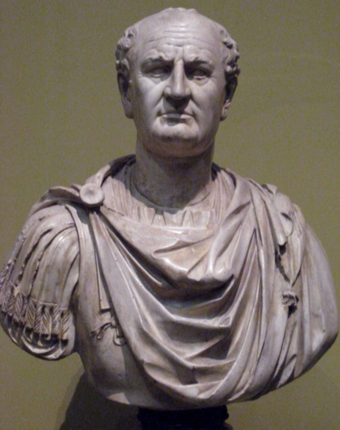
Bust of Vespasian
Vespasian founded the Flavian Dynasty, which ruled the Empire for twenty-seven years.
8.5.2: Military Achievements of the Flavians
The Flavian Dynasty’s military witnessed the siege and destruction of Jerusalem by Titus in 70 CE, and substantial conquests in Great Britain under command of Gnaeus Julius Agricola between 77 and 83 CE.
Learning Objective
Describe some of the military achievements and challenges of the Flavian emperors
Key Points
- The most significant military campaign undertaken during the Flavian period was the siege and destruction of Jerusalem in 70 CE by Titus; it was a response to a failed Jewish rebellion in 66.
- Contemporary estimates claimed that 1,100,000 people were killed during the siege, of which a majority were Jewish.
- Substantial conquests were made in Great Britain under command of Gnaeus Julius Agricola, between 77 and 83.
- The military campaigns undertaken during Domitian’s reign were usually defensive in nature, as the Emperor rejected the idea of expansionist warfare, and the few battles were mainly fought with Germanic tribes, especially the Dacians.
Key Terms
- Limes Germanicus
-
A line of frontier fortifications that bounded the ancient Roman provinces of Germania Inferior, Germania Superior and Raetia, dividing the Roman Empire and the unsubdued Germanic tribes, from the years 83 to about 260 CE.
- Torah
-
The central text of the religious Judaic tradition, often referring specifically to the first five books of the twenty-four books of the Tanakh.
- the Forum
-
A a rectangular forum (plaza) surrounded by the ruins of several important ancient government buildings at the center of the city of Rome, originally a large marketplace.
Overview
The Flavian Dynasty’s military witnessed the siege and destruction of Jerusalem by Titus in 70 CE, following the failed Jewish rebellion of 66. Substantial conquests were made in Great Britain under command of Gnaeus Julius Agricola between 77 and 83, while Domitian was unable to procure a decisive victory against King Decebalus in the war against the Dacians. In addition, the Empire strengthened its border defenses by expanding the fortifications along the Limes Germanicus.
Siege of Jerusalem
The most significant military campaign undertaken during the Flavian period was the siege and destruction of Jerusalem in 70 by Titus. The destruction of the city was the culmination of the Roman campaign in Judaea following the Jewish uprising of 66. The Second Temple was completely demolished, after which Titus’s soldiers proclaimed him imperator, an honorific meaning “commander,” in honor of the victory. Jerusalem was sacked and much of the population killed or dispersed. Josephus claims that 1,100,000 people were killed during the siege, of which a majority were Jewish. 97,000 were captured and enslaved, including Simon Bar Giora and John of Gischala. Many fled to areas around the Mediterranean.
Titus reportedly refused to accept a wreath of victory, as there is “no merit in vanquishing people forsaken by their own God.” Upon his return to Rome in 71, Titus was awarded a triumph. Accompanied by Vespasian and Domitian, he rode into the city, enthusiastically saluted by the Roman populace, and preceded by a lavish parade containing treasures and captives from the war. Josephus describes a procession with large amounts of gold and silver carried along the route, followed by elaborate re-enactments of the war, Jewish prisoners, and finally the treasures taken from the Temple of Jerusalem, including the Menorah and the Torah. Leaders of the resistance were executed in the Forum, after which the procession closed with religious sacrifices at the Temple of Jupiter. The triumphal Arch of Titus, which stands at one entrance to the Forum, memorializes the victory of Titus.
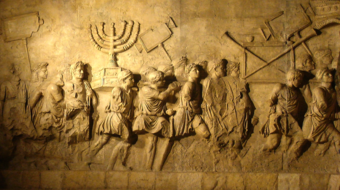
Siege of Jerusalem
This relief from the Arch of Titus depicts Roman soldiers carrying treasures from the Temple of Jerusalem, including the Menorah. The city was besieged and destroyed by Titus in 70 CE.
Conquest of Britain
The conquest of Britain continued under command of Gnaeus Julius Agricola, who expanded the Roman Empire as far as Caledonia, or modern day Scotland, between 77 and 84 AD. In 82, Agricola crossed an unidentified body of water and defeated peoples unknown to the Romans until then. He fortified the coast facing Ireland, and Tacitus recalled that his father-in-law often claimed the island could be conquered with a single legion and a few auxiliaries. He had given refuge to an exiled Irish king whom he hoped he might use as the excuse for conquest. This conquest never happened, but some historians believe that the crossing referred to was in fact a small-scale exploratory or punitive expedition to Ireland. The following year, Agricola raised a fleet and pushed beyond the Forth into Caledonia. To aid the advance, an expansive legionary fortress was constructed at Inchtuthil. In the summer of 84, Agricola faced the armies of the Caledonians, led by Calgacus, at the Battle of Mons Graupius. Although the Romans inflicted heavy losses on the Calidonians, two-thirds of their army managed to escape and hide in the Scottish marshes and Highlands, ultimately preventing Agricola from bringing the entire British island under his control.
Other Military Activity
The military campaigns undertaken during Domitian’s reign were usually defensive in nature, as the Emperor rejected the idea of expansionist warfare. His most significant military contribution was the development of the Limes Germanicus, which encompassed a vast network of roads, forts, and watchtowers constructed along the Rhine river to defend the Empire from the unsubdued Germanic tribes. Nevertheless, several important wars were fought in Gaul, against the Chatti, and across the Danube frontier against the Suebi, the Sarmatians, and the Dacians. Led by King Decebalus, the Dacians invaded the province of Moesia around 84 or 85, wreaking considerable havoc and killing the Moesian governor Oppius Sabinus. Domitian immediately launched a counteroffensive, which resulted in the destruction of a legion during an ill-fated expedition into Dacia. Their commander, Cornelius Fuscus, was killed, and the battle standard of the Praetorian Guard lost.
In 87, the Romans invaded Dacia once more, this time under command of Tettius Julianus, and finally managed to defeat Decebalus late in 88, at the same site where Fuscus had previously been killed. An attack on Dacia’s capital was cancelled, however, when a crisis arose on the German frontier. This forced Domitian to sign a peace treaty with Decebalus that was severely criticized by contemporary authors. For the remainder of Domitian’s reign, Dacia remained a relatively peaceful client kingdom, but Decebalus used the Roman money to fortify his defenses, and continued to defy Rome. It was not until the reign of Trajan, in 106, that a decisive victory against Decebalus was procured. Again, the Roman army sustained heavy losses, but Trajan succeeded in capturing Sarmizegetusa and, importantly, annexed the gold and silver mines of Dacia.
8.5.3: Eruptions of Vesuvius and Pompeii
The eruption of Mount Vesuvius in 79 CE was one of the most catastrophic volcanic eruptions in European history, with several Roman settlements obliterated and buried, and thereby preserved, under ash.
Learning Objective
Describe the events surrounding the Eruption of Mount Vesuvius
Key Points
- The eruption of Mount Vesuvius in 79 CE, during the reign of Emperor Titus, was one of the most catastrophic volcanic eruptions in European history.
- Historians have learned about the eruption from the eyewitness account of Pliny the Younger, a Roman administrator and poet.
- Mount Vesuvius spewed a deadly cloud of volcanic gas, stones, and ash to a height of 21 miles, ejecting molten rock and pulverized pumice at the rate of 1.5 million tons per second, ultimately releasing a hundred thousand times the thermal energy of the Hiroshima bombing.
- Several Roman settlements were obliterated and buried underneath massive pyroclastic surges and ashfall deposits, the most well known of which are Pompeii and Herculaneum.
- The preserved remains of about 1,500 people have been found at Pompeii and Herculaneum, but the overall death toll is still unknown.
Key Terms
- Pliny the Younger
-
A lawyer, author, and magistrate of Ancient Rome who witnessed the eruption of Mount Vesuvius.
- pyroclastic surge
-
A fluidized mass of turbulent gas and rock fragments, ejected during some volcanic eruptions.
- Pompeii
-
An ancient Roman town-city near modern Naples, in the Campania region of Italy, destroyed during the eruption of Mount Vesuvius.
Overview
Although his administration was marked by a relative absence of major military or political conflicts, Titus faced a number of major disasters during his brief reign. On August 24, 79 CE, barely two months after his accession, Mount Vesuvius erupted, resulting in the almost complete destruction of life and property in the cities and resort communities around the Bay of Naples. The cities of Pompeii and Herculaneum were buried under meters of stone and lava, killing thousands of citizens. Titus appointed two ex-consuls to organize and coordinate the relief effort, while personally donating large amounts of money from the imperial treasury to aid the victims of the volcano. Additionally, he visited Pompeii once after the eruption and again the following year.
The city was lost for nearly 1,700 years before its accidental rediscovery in 1748. Since then, its excavation has provided an extraordinarily detailed insight into the life of a city at the height of the Roman Empire, frozen at the moment it was buried on August 24, 79. The Forum, the baths, many houses, and some out-of-town villas, like the Villa of the Mysteries, remain surprisingly well preserved. Today, it is one of the most popular tourist attractions of Italy and a UNESCO World Heritage Site. On-going excavations reveal new insights into the Roman history and culture.
The Eruption
Reconstructions of the eruption and its effects vary considerably in the details but have the same overall features. The eruption lasted for two days. The morning of the first day, August 24, was perceived as normal by the only eyewitness to leave a surviving document, Pliny the Younger, who at that point was staying at Misenum, on the other side of the Bay of Naples, about 19 miles from the volcano, which may have prevented him from noticing the early signs of the eruption. He was not to have any opportunity, during the next two days, to talk to people who had witnessed the eruption from Pompeii or Herculaneum (indeed he never mentions Pompeii in his letter), so he would not have noticed early, smaller fissures and releases of ash and smoke on the mountain, if such had occurred earlier in the morning.
Around 1:00 p.m., Mount Vesuvius violently exploded, throwing up a high-altitude column from which ash began to fall, blanketing the area. Rescues and escapes occurred during this time. At some time in the night or early the next day, August 25, pyroclastic flows in the close vicinity of the volcano began. Lights seen on the mountain were interpreted as fires. People as far away as Misenum fled for their lives. The flows were rapid-moving, dense, and very hot, knocking down wholly or partly all structures in their path, incinerating or suffocating all population remaining there and altering the landscape, including the coastline. These were accompanied by additional light tremors and a mild tsunami in the Bay of Naples. By evening of the second day the eruption was over, leaving only haze in the atmosphere, through which the sun shone weakly.
Pliny the Younger wrote an account of the eruption:
Broad sheets of flame were lighting up many parts of Vesuvius; their light and brightness were the more vivid for the darkness of the night… it was daylight now elsewhere in the world, but there the darkness was darker and thicker than any night.
Casualties
In Pompeii, the eruption destroyed the city, killing its inhabitants and burying it under tons of ash. Evidence for the destruction originally came from a surviving letter by Pliny the Younger, who saw the eruption from a distance and described the death of his uncle, Pliny the Elder, an admiral of the Roman fleet, who tried to rescue citizens. The site was lost for about 1,500 years until its initial rediscovery in 1599, and broader rediscovery almost 150 years later by Spanish engineer Rocque Joaquin de Alcubierre in 1748. The objects that lay beneath the city have been preserved for centuries because of the lack of air and moisture. These artifacts provide an extraordinarily detailed insight into the life of a city during the Pax Romana. During the excavation, plaster was used to fill in the voids in the ash layers that once held human bodies. This allowed archaeologists to see the exact position the person was in when he or she died.
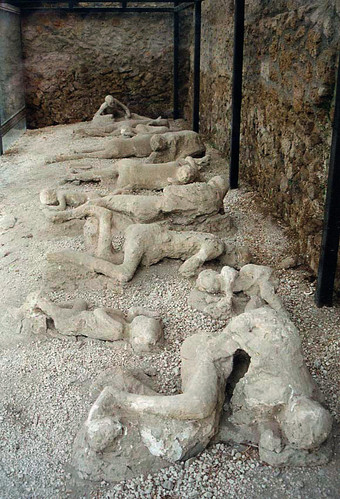
Pompeii’s “Garden of the Fugitives”
Plaster casts of victims still in situ; many casts are in the Archaeological Museum of Naples.
By 2003, around 1,044 casts made from impressions of bodies in the ash deposits had been recovered in and around Pompeii, with the scattered bones of another 100. The remains of about 332 bodies have been found at Herculaneum (300 in arched vaults discovered in 1980). The percentage these numbers represent of the total dead, or the percentage of the dead to the total number at risk, remain completely unknown.
Thirty-eight percent of the 1,044 were found in the ash fall deposits, the majority inside buildings. These are thought to have been killed mainly by roof collapses, with the smaller number of victims found outside buildings probably killed by falling roof slates, or by larger rocks thrown out by the volcano. This differs from modern experience, since over the last four hundred years only around 4% of victims have been killed by ash falls during explosive eruptions. The remaining 62% of remains found at Pompeii were in the pyroclastic surge deposits, and thus were probably killed by them. It was initially believed that due to the state of the bodies found at Pompeii, and the outline of clothes on the bodies, it was unlikely that high temperatures were a significant cause. But in 2010, studies indicated that during the fourth pyroclastic surge–the first surge to reach Pompeii–temperatures reached 572 °F. Volcanologist Giuseppe Mastrolorenzo, who led the study, noted that “[The temperature was] enough to kill hundreds of people in a fraction of a second.” In reference as to why the bodies were frozen in suspended action, he said, “The contorted postures are not the effects of a long agony, but of the cadaveric spasm, a consequence of heat shock on corpses.”
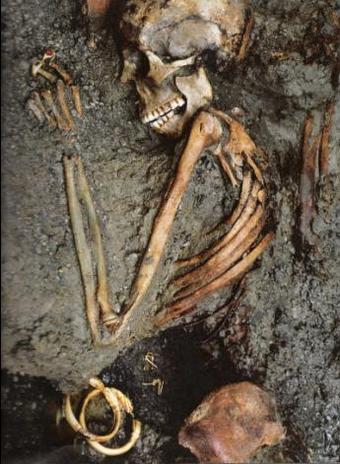
Ring Lady
The skeletal remains of a young woman killed by the eruption of Mount Vesuvius in 79 CE. The skeleton, unearthed from the ruins of Herculaneum in 1982, was named the “Ring Lady” because of the emerald and ruby rings found on the woman’s left hand. Two gold bracelets and gold earrings were also found by the woman’s side.
8.5.4: Flavian Architecture
Under the Flavian Dynasty, a massive building program was undertaken, leaving multiple enduring landmarks in the city of Rome, the most spectacular of which was the Flavian Amphitheater, better known as the Colosseum.
Learning Objective
Identify some of the key structures erected by the Flavian emperors
Key Points
- Perhaps the most enduring legacy of the Flavian Dynasty was their massive building program, which not only erected new buildings to celebrate their successes, but also renovated buildings, statues, and monuments throughout Rome.
- The most spectacular of these buildings was the Flavian Amphitheater, better known as the Colosseum, built from the spoils of the Siege of Jerusalem.
- The Colosseum was used for gladiatorial contests and public spectacles, such as mock sea battles, animal hunts, executions, re-enactments of famous battles, and dramas based on Classical mythology.
- The bulk of the Flavian construction projects was carried out during the reign of Domitian, who spent lavishly to restore and embellish the city of Rome.
Key Terms
- Apollo
-
One of the most important and complex of the Olympian deities, variously recognized as a god of music, truth and prophecy, healing, the sun and light, plague, poetry, and more.
- Flavian Amphitheatre
-
Better known as the Colosseum, an oval amphitheater in the center of the city of Rome, Italy; used for gladiatorial games, among other activities.
Overview
The Flavian Dynasty is perhaps best known for its vast construction program on the city of Rome, intended to restore the capital from the damage it had suffered during the Great Fire of 64, and the civil war of 69. Vespasian added the temple of Peace and the temple to the deified Claudius. In 75, a colossal statue of Apollo, begun under Nero as a statue of himself, was finished on Vespasian’s orders, and he also dedicated a stage of the theater of Marcellus. Construction of the Flavian Amphitheater, presently better known as the Colosseum (probably after the nearby statue), was begun in 70 CE under Vespasian, and finally completed in 80 under Titus. In addition to providing spectacular entertainments to the Roman populace, the building was also conceived as a gigantic triumphal monument to commemorate the military achievements of the Flavians during the Jewish wars. Adjacent to the amphitheater, within the precinct of Nero’s Golden House, Titus also ordered the construction of a new public bath-house, which was to bear his name. Construction of this building was hastily finished to coincide with the completion of the Flavian Amphitheater.
The bulk of the Flavian construction projects was carried out during the reign of Domitian, who spent lavishly to restore and embellish the city of Rome. Much more than a renovation project however, Domitian’s building program was intended to be the crowning achievement of an Empire-wide cultural renaissance. Around 50 structures were erected, restored, or completed, a number second only to the amount erected under Augustus. Among the most important new structures were an odeum, a stadium, and an expansive palace on the Palatine Hill, known as the Flavian Palace, which was designed by Domitian’s master architect, Rabirius. The most important building Domitian restored was the Temple of Jupiter on the Capitoline Hill, which was said to have been covered with a gilded roof. Among those he completed were the Temple of Vespasian and Titus, the Arch of Titus, and the Colosseum, to which he added a fourth level and finished the interior seating area.
The Colosseum
The Colosseum is an oval amphitheater in the center of the city of Rome, Italy. Built of concrete and sand, it is the largest amphitheater ever built. The Colosseum is situated just east of the Roman Forum. Construction began under the emperor Vespasian in 72 CE, and was completed in 80 CE under his successor and heir, Titus. Further modifications were made during the reign of Domitian (81-96).
The Colosseum could hold, it is estimated, between 50,000 and 80,000 spectators, with an average audience of some 65,000; it was used for gladiatorial contests and public spectacles, such as mock sea battles (for only a short time, as the hypogeum was soon filled in with mechanisms to support the other activities), animal hunts, executions, re-enactments of famous battles, and dramas based on Classical mythology.
Construction was funded by the opulent spoils taken from the Jewish Temple after the Great Jewish Revolt in 70 CE led to the Siege of Jerusalem. According to a reconstructed inscription found on the site, “the emperor Vespasian ordered this new amphitheater to be erected from his general’s share of the booty.” Along with the spoils, estimated 100,000 Jewish prisoners were brought back to Rome after the war, and many contributed to the massive workforce needed for construction. The slaves undertook manual labor, such as working in the quarries at Tivoli where the travertine was quarried, along with lifting and transporting the quarried stones 20 miles from Tivoli to Rome. Along with this free source of unskilled labor, teams of professional Roman builders, engineers, artists, painters and decorators undertook the more specialized tasks necessary for building the Colosseum.
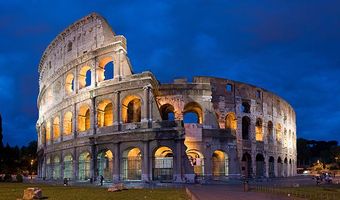
The Flavian Amphitheater
The most enduring landmark of the Flavian Dynasty was the Flavian Amphitheater, better known as the Colosseum. Its construction was begun by Vespasian, and ultimately finished by Titus and Domitian, financed from the spoils of the destruction of the Second Jerusalem Temple.
8.5.5: Fall of the Flavian Emperors
Domitian, the last of the Flavian emperors, was a ruthless autocrat who had many enemies, some of whom eventually assassinated him, giving rise to the long-lived Nerva-Antonine Dynasty.
Learning Objective
Analyze the factors that led to the fall of the Flavian Dynasty
Key Points
- Flavian rule came to an end on September 18, 96, when Domitian was assassinated and was succeeded by the longtime Flavian supporter and advisor Marcus Cocceius Nerva, who founded the long-lived Nerva-Antonine Dynasty.
- Domitian’s government exhibited totalitarian characteristics, which caused disapproval of the Roman Senate, among others.
- He dealt with several revolts during his rule, the last one being a successful assassination.
- The Senate rejoiced at the death of Domitian, and immediately following Nerva’s accession as Emperor, passed damnatio memoriae on his memory: his coins and statues were melted, his arches were torn down, and his name was erased from all public records.
Key Terms
- Marcus Cocceius Nerva
-
Succeeded Domitian as emperor the same day as his assassination. Founded the Nerva-Antonine Dynasty.
- Roman Senate
-
A political institution in ancient Rome, and one of the most enduring institutions in Roman history, established in the first days of the city. By the time of the Roman Empire,it had lost much of its political power as well as its prestige.
- damnatio memoriae
-
Latin for “condemnation of memory,” a form of dishonor that could be passed by the Roman Senate on traitors or others who brought discredit to the Roman State; the intent was to erase the malefactor from history, a task somewhat easier in ancient times, when documentation was limited.
Flavian rule came to an end on September 18, 96, when Domitian was assassinated. He was succeeded by the longtime Flavian supporter and advisor, Marcus Cocceius Nerva, who founded the long-lived Nerva-Antonine Dynasty.
Opposition to Domitian
Domitian’s government exhibited totalitarian characteristics; he saw himself as the new Augustus, an enlightened despot destined to guide the Roman Empire into a new era of brilliance. Religious, military, and cultural propaganda fostered a cult of personality, and by nominating himself perpetual censor, he sought to control public and private morals. As a consequence, Domitian was popular with the people and army, but considered a tyrant by members of the Roman Senate.
Since the fall of the Republic, the authority of the Roman Senate had largely eroded under the quasi-monarchical system of government established by Augustus, known as the Principate. The Principate allowed the existence of a de facto dictatorial regime, while maintaining the formal framework of the Roman Republic. Most Emperors upheld the public facade of democracy, and in return the Senate implicitly acknowledged the Emperor’s status as a de facto monarch.
Some rulers handled this arrangement with less subtlety than others. Domitian was not so subtle. From the outset of his reign, he stressed the reality of his autocracy. He disliked aristocrats and had no fear of showing it, withdrawing every decision-making power from the Senate, and instead relying on a small set of friends and equestrians to control the important offices of state.
The dislike was mutual. After Domitian’s assassination, the senators of Rome rushed to the Senate house, where they immediately passed a motion condemning his memory to oblivion. Under the rulers of the Nervan-Antonian Dynasty, senatorial authors published histories that elaborated on the view of Domitian as a tyrant. Modern revisionists have instead characterized Domitian as a ruthless but efficient autocrat, whose cultural, economic, and political program provided the foundation of the peaceful 2nd century.
Assassination
Domitian dealt with several revolts during his rule, the last of which was a successful plot to assassinate him. Domitian was assassinated on September 18, 96, in a palace conspiracy organized by court officials. A highly detailed account of the plot and the assassination is provided by Suetonius, who alleges that Domitian’s chamberlain, Parthenius, was the chief instigator behind the conspiracy, citing the recent execution of Domitian’s secretary, Epaphroditus, as the primary motive. The murder itself was carried out by a freedman of Parthenius, named Maximus, and a steward of Domitian’s niece Flavia Domitilla, named Stephanus.
The precise involvement of the Praetorian Guard is less clear. At the time, the Guard was commanded by Titus Flavius Norbanus and Titus Petronius Secundus, and the latter was almost certainly aware of the plot. Cassius Dio, writing nearly a hundred years after the assassination, includes Domitia Longina among the conspirators, but in light of her attested devotion to Domitian—even years after her husband had died—her involvement in the plot seems highly unlikely.
Dio further suggests that the assassination was improvised, while Suetonius implies a well-organized conspiracy. For some days before the attack took place, Stephanus feigned an injury so as to be able to conceal a dagger beneath his bandages. On the day of the assassination, the doors to the servants’ quarters were locked while Domitian’s personal weapon of last resort, a sword he concealed beneath his pillow, had been removed in advance.
Domitian and Stephanus wrestled on the ground for some time, until the Emperor was finally overpowered and fatally stabbed by the conspirators; Stephanus was stabbed by Domitian during the struggle and died shortly afterward. Around noon, Domitian, just one month short of his 45th birthday, was dead. His body was carried away on a common bier, and unceremoniously cremated by his nurse Phyllis, who later mingled the ashes with those of his niece Julia, at the Flavian temple.
The End of the Flavian Dynasty
The same day as Domitian’s death, the Senate proclaimed Marcus Cocceius Nerva to be emperor. Despite his political experience, this was a remarkable choice. Nerva was old and childless, and had spent much of his career out of the public light, prompting both ancient and modern authors to speculate on his involvement in Domitian’s assassination.
According to Cassius Dio, the conspirators approached Nerva as a potential successor prior to the assassination, suggesting that he was at least aware of the plot. He does not appear in Suetonius’ version of the events, but this may be understandable, since his works were published under Nerva’s direct descendants, Trajan and Hadrian. To suggest the dynasty owed its accession to murder would have been less than sensitive.
On the other hand, Nerva lacked widespread support in the Empire, and as a known Flavian loyalist, his track record would not have recommended him to the conspirators. The precise facts have been obscured by history, but modern historians believe Nerva was proclaimed emperor solely on the initiative of the Senate, within hours after the news of the assassination broke. The decision may have been hasty so as to avoid civil war, but neither appears to have been involved in the conspiracy.
The Senate nonetheless rejoiced at the death of Domitian, and immediately following Nerva’s accession as Emperor, passed damnatio memoriae on his memory: his coins and statues were melted, his arches were torn down, and his name was erased from all public records. Domitian and, over a century later, Publius Septimius Geta, were the only emperors known to have officially received a damnatio memoriae, though others may have received de facto ones. In many instances, existing portraits of Domitian, such as those found on the Cancelleria Reliefs, were simply recarved to fit the likeness of Nerva, which allowed quick production of new images and recycling of previous material. Yet the order of the Senate was only partially executed in Rome, and wholly disregarded in most of the provinces outside Italy.
Although Nerva’s brief reign was marred by financial difficulties and his inability to assert his authority over the Roman army (who were still loyal to Domitian), his greatest success was his ability to ensure a peaceful transition of power after his death, thus founding the Nerva-Antonine Dynasty.
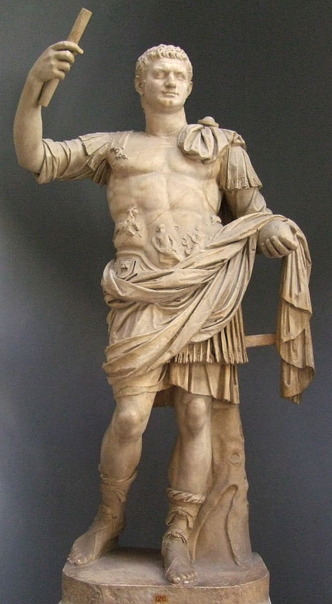
Domitian
Domitian as Emperor (Vatican Museums), possibly recut from a statue of Nero.
8.6: Nerva-Antonine Dynasty
8.6.1: The Nerva-Antonine Dynasty
The Golden Age of Rome was a period of prosperity that fell under the “Five Good Emperors” of the Nerva-Antonine Dynasty: Nerva, Trajan, Hadrian, Antoninus Pius, and Marcus Aurelius.
Learning Objective
Describe the characteristics of the Golden Age and the achievements of the Five Good Emperors
Key Points
- The first five of the six successions within the Nerva-Antonine Dynasty were notable in that the reigning emperor adopted the candidate of his choice to be his successor, rather than choosing a biological heir.
- Although much of his life remains obscure, Nerva was considered a wise and moderate emperor by ancient historians. Nerva’s greatest success was his ability to ensure a peaceful transition of power after his death, thus founding the Nerva-Antonine Dynasty.
- Trajan is remembered as a successful soldier-emperor who presided over the greatest military expansion in Roman history, and led the empire to attain its maximum territorial extent by the time of his death.
- Hadrian was known to be a humanist and a philhellene, renowned for his building projects and commitment to his military lifestyle.
- Marcus Aurelius, the philosopher-emperor, enjoyed not only military successes during his reign, but also authored a defining Stoic tome on equanimity in the midst of conflict.
Key Terms
- Marcus Aurelius
-
Roman Emperor from 161 to 180 CE, as well as a notable Stoic philosopher.
- Hadrian
-
Roman Emperor from 117 to 138 CE. Known for his grand building projects and his philhellenism.
- Trajan
-
Roman emperor from 98 CE until 117 CE. Officially declared by the Senate as optimus princeps, and known for his bold expansion of Roman borders.
Nerva-Antonine Dynasty
The Nerva-Antonine Dynasty was a dynasty of seven Roman Emperors who ruled over the Roman Empire during a period of prosperity from 96 CE to 192 CE. These emperors are Nerva, Trajan, Hadrian, Antoninus Pius, Marcus Aurelius, Lucius Verus, and Commodus.
The first five of the six successions within this dynasty were notable in that the reigning emperor adopted the candidate of his choice to be his successor. Under Roman law, an adoption established a bond legally as strong as that of kinship. As such, the second through sixth Nerva-Antonine emperors are also called Adoptive Emperors.
The importance of official adoption in Roman society has often been considered as a conscious repudiation of the principle of dynastic inheritance, and has been deemed as one of the factors of the period’s prosperity. However, this was not a new practice. It was common for patrician families to adopt, and Roman emperors had adopted heirs in the past; Emperor Augustus had adopted Tiberius, and Emperor Claudius had adopted Nero. Julius Caesar, dictator perpetuo and considered to be instrumental in the transition from Republic to Empire, adopted Gaius Octavius, who would become Augustus, Rome’s first emperor. Moreover, there was a family connection, as Trajan adopted his first cousin once removed and great-nephew by marriage, Hadrian. Hadrian made his half-nephew by marriage, and heir Antoninus Pius, adopt both Hadrian’s second cousin three times removed, and half-great-nephew by marriage, Marcus Aurelius, also Antoninus’ nephew by marriage, and the son of his original planned successor, Lucius Verus. The naming by Marcus Aurelius of his son, Commodus, was considered to be an unfortunate choice and the beginning of the Empire’s decline.
With Commodus’ murder in 192, the Nerva-Antonine Dynasty came to an end; it was followed by a period of turbulence, known as the Year of the Five Emperors.
The Five Good Emperors
The rulers commonly known as the “Five Good Emperors” were Nerva, Trajan, Hadrian, Antoninus Pius, and Marcus Aurelius. The term was coined by the political philosopher, Niccolò Machiavelli, in 1503:
From the study of this history we may also learn how a good government is to be established; for while all the emperors who succeeded to the throne by birth, except Titus, were bad, all were good who succeeded by adoption, as in the case of the five from Nerva to Marcus. But as soon as the empire fell once more to the heirs by birth, its ruin recommenced. Titus, Nerva, Trajan, Hadrian, Antoninus, and Marcus had no need of praetorian cohorts, or of countless legions to guard them, but were defended by their own good lives, the good-will of their subjects, and the attachment of the Senate.
An alternative hypothesis posits that adoptive succession is thought to have arisen because of a lack of biological heirs. All but the last of the adoptive emperors had no legitimate biological sons to succeed them. They were thus obliged to pick a successor somewhere else; as soon as the Emperor could look towards a biological son to succeed him, adoptive succession was set aside. Nonetheless, this period was a time of peace and prosperity.
Nerva
In 96 CE, Domitian was assassinated in a palace conspiracy involving members of the Praetorian Guard and several of his freedmen. On the same day, Nerva was declared emperor by the Roman Senate. This occasion marked the first time the Senate elected a Roman Emperor.
Nerva’s brief reign was marred by financial difficulties and his inability to assert his authority over the Roman army. A revolt by the Praetorian Guard in October 97 essentially forced him to adopt an heir. After some deliberation, Nerva chose Trajan, a young and popular general, as his successor. After barely fifteen months in office, Nerva died of natural causes in 98, and upon his death, he was succeeded and deified by Trajan. Although much of his life remains obscure, Nerva was considered a wise and moderate emperor by ancient historians. Nerva’s greatest success was his ability to ensure a peaceful transition of power after his death, thus founding the Nerva-Antonine Dynasty.
Trajan
Trajan was Roman emperor from 98 CE until his death in 117 CE. Officially declared by the Senate as optimus princeps (“the best ruler”), Trajan is remembered as a successful soldier-emperor who presided over the greatest military expansion in Roman history, and led the empire to attain its maximum territorial extent by the time of his death. He is also known for his philanthropic rule, and oversaw extensive public building programs and implemented social welfare policies.
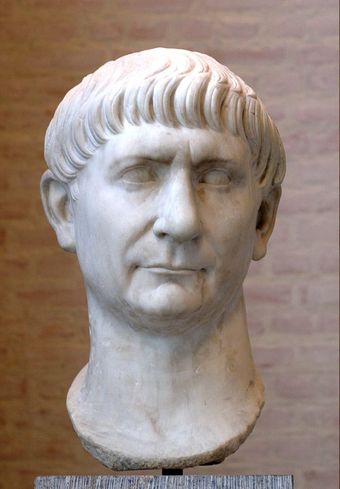
Bust of Trajan
Bust of the Emperor Trajan, who ruled from 98-117 CE.
Hadrian
Hadrian was Roman Emperor from 117 to 138 CE. Known for his grand building projects, he re-built the Pantheon and constructed the Temple of Venus and Roma. He is also known for building Hadrian’s Wall, which marked the northern limit of Roman Britain. During his reign, Hadrian traveled to nearly every province of the Empire. An ardent admirer of Greece, he sought to make Athens the cultural capital of the empire, and created a popular cult in the name of his Greek lover, Antinous. He spent extensive amounts of his time with the military; he usually wore military attire and even dined and slept amongst the soldiers.
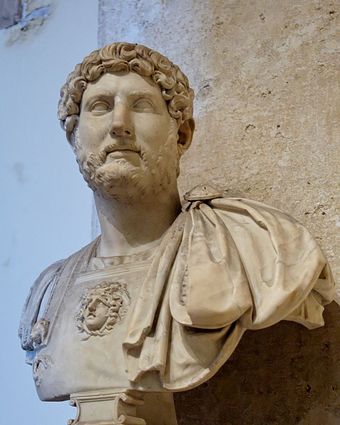
Bust of Hadrian
Bust of the Emperor Hadrian, who ruled from 117-138 CE.
Marcus Aurelius
Hadrian was succeeded by Antoninus Pius, who was subsequently succeeded by Marcus Aurelius, who was Roman Emperor from 161 to 180 CE. He ruled with Lucius Verus as co-emperor from 161 until Verus’ death in 169. He was the last of the Five Good Emperors and was a practitioner of Stoicism. His untitled writing, commonly known as the Meditations, is the most significant source of our modern understanding of ancient Stoic philosophy.
Marcus Aurelius was an effective military commander, and Rome enjoyed various military successes against outsiders who were beginning to threaten the Empire. During his reign, the Empire defeated a revitalized Parthian Empire in the East: Aurelius’ general, Avidius Cassius, sacked the capital Ctesiphon in 164. In central Europe, Aurelius fought the Marcomanni, Quadi, and Sarmatians with success during the Marcomannic Wars, although the threat of the Germanic tribes began to represent a troubling reality for the empire. A revolt in the East led by Avidius Cassius failed to gain momentum and was suppressed immediately.
His Meditations, written in Greek while he was on a campaign between 170 and 180, is still revered as a literary monument to a philosophy of service and duty, which describes how to find and preserve equanimity in the midst of conflict by following nature as a source of guidance and inspiration.
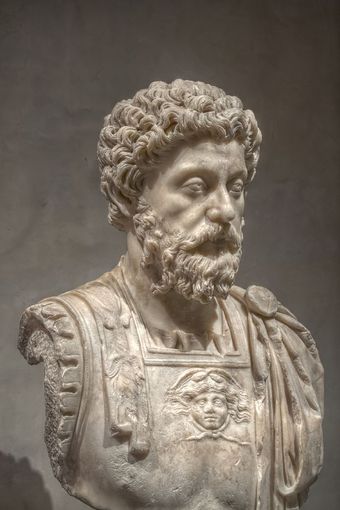
Bust of Marcus Aurelius
Bust of Marcus Aurelius, who ruled from 161 to 180 CE.
8.6.2: Military Successes of the Nerva-Antonine Dynasty
The Nerva-Antonine Dynasty saw the greatest military expansion in Roman history, leading the empire to attain its maximum territorial extent.
Learning Objective
Examine the military efforts of the Nerva-Antonine emperors
Key Points
- The second emperor in the dynasty, Trajan, is remembered as a successful soldier-emperor who presided over the greatest military expansion in Roman history, through the Dacian Wars.
- The conclusion of the Dacian Wars marked the beginning of a period of sustained growth and relative peace in Rome.
- Despite his own great reputation as a military administrator, Hadrian’s reign was marked by a general lack of documented major military conflicts, apart from the Second Roman–Jewish War, and instead is marked by pacifist tendencies.
- The peace policy was strengthened by the erection of permanent fortifications along the empire’s borders, the most famous of these being the massive Hadrian’s Wall in Great Britain.
Key Terms
- Dacian Wars
-
Two military campaigns fought between the Roman Empire and Dacia during Roman Emperor Trajan’s rule.
- Hadrian’s Wall
-
A defensive fortification in the Roman province of Britannia, begun in 122 CE during the reign of the emperor Hadrian.
Several of the Nerva-Antonine Dynasty emperors were known for their notable military successes.
Trajan and the Dacian Wars
After Nerva’s short rule, his adoptive heir, Trajan, a popular military leader, ruled as emperor from 98-117 CE. Officially declared by the Senate as optimus princeps (“the best ruler”), Trajan is remembered as a successful soldier-emperor who presided over the greatest military expansion in Roman history, leading the empire to attain its maximum territorial extent by the time of his death.
The Dacian Wars (101-102, 105-106) were two military campaigns fought between the Roman Empire and Dacia during Roman Emperor Trajan’s rule. The conflicts were triggered by the constant Dacian threat on the Danubian Roman Province of Moesia, and also by the increasing need for resources in the economy of the Roman Empire.
Dacia, an area north of Macedon and Greece, and east of the Danube, had been on the Roman agenda since before the days of Caesar, when they defeated a Roman army at the Battle of Histria. In 85 CE, the Dacians swarmed over the Danube and pillaged Moesia, and initially defeated the army that Emperor Domitian sent against them. The Romans were defeated in the Battle of Tapae in 88, and a truce was established.
Emperor Trajan recommenced hostilities against Dacia and, following an uncertain number of battles, defeated the Dacian King Decebalus in the Second Battle of Tapae in 101. With Trajan’s troops pressing towards the Dacian capital, Sarmizegetusa Regia, Decebalus once more sought truce terms. Decebalus rebuilt his power over the following years and attacked Roman garrisons again in 105. In response, Trajan again marched into Dacia, besieging the Dacian capital in the Siege of Sarmizegetusa, and razing it. With Dacia quelled, Trajan subsequently invaded the Parthian empire to the east, his conquests expanding the Roman Empire to its greatest extent. Rome’s borders in the east were indirectly governed through a system of client states for some time, leading to less direct campaigning than in the west in this period.
The conclusion of the Dacian Wars marked a triumph for Rome and its armies. Trajan announced 123 days of celebrations throughout the Empire. Dacia’s rich gold mines were secured, and it is estimated that Dacia then contributed 700 million Denarii per annum to the Roman economy, providing finance for Rome’s future campaigns, and assisting with the rapid expansion of Roman towns throughout Europe.
The two wars were notable victories in Rome’s extensive expansionist campaigns, gaining Trajan the people’s admiration and support. The conclusion of the Dacian Wars marked the beginning of a period of sustained growth and relative peace in Rome. Trajan began extensive building projects and became an honorable civil leader, improving Rome’s civic infrastructure, thereby paving the way for internal growth and reinforcement of the empire as a whole.
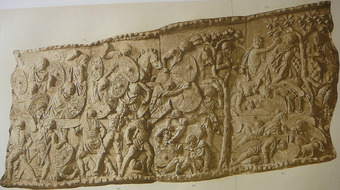
Dacian Wars
Fiery battle scene between the Roman and Dacian armies.
Hadrian and Hadrian’s Wall
Despite his own great reputation as a military administrator, Hadrian’s reign was marked by a general lack of documented major military conflicts, apart from the Second Roman-Jewish War. Hadrian had already surrendered Trajan’s conquests in Mesopotamia, considering them to be indefensible. In the East, Hadrian contented himself with retaining suzerainty over Osroene, which was ruled by the client king, Parthamaspates, once client king of Parthia under Trajan.
Hadrian’s abandonment of an aggressive policy was something the Senate and its historians never forgave: the fourth century historian, Aurelius Victor, charged him with being jealous of Trajan’s exploits and deliberately trying to downplay their worthiness. It is more probable that Hadrian simply considered that the financial strain to be incurred through keeping a policy of conquests was something the Roman Empire could not afford. Proof of this is the disappearance during his reigns of two entire legions. Also, the acknowledgement of the indefensible character of the Mesopotamian conquests had perhaps already been made by Trajan himself, who had disengaged from them at the time of his death.
The peace policy was strengthened by the erection of permanent fortifications along the empire’s borders. The most famous of these is the massive Hadrian’s Wall in Great Britain, built on stone and doubled on its rear by a ditch (Vallum Hadriani), which marked the boundary between a strictly military zone and the province. The Danube and Rhine borders were strengthened with a series of mostly wooden fortifications, forts, outposts, and watchtowers, the latter specifically improving communications and local area security.
To maintain morale and prevent the troops from becoming restive, Hadrian established intensive drill routines, and personally inspected the armies. Although his coins showed military images almost as often as peaceful ones, Hadrian’s policy was peace through strength, even threat, with an emphasis on discipline, which was the subject of two monetary series.
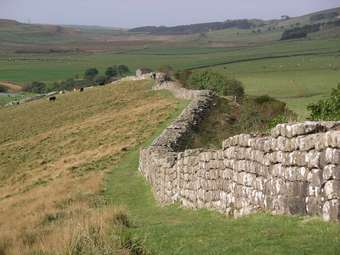
Hadrian’s Wall
Sections of Hadrian’s Wall remain along the route, though much of it has been dismantled over the years, in order to use the stones for various nearby construction projects.
8.6.3: Art and Culture Under the Nerva-Antonines
Emperor Hadrian, among other Nerva-Antonine emperors, patronized the arts, held public festivals, and influenced the culture of Rome and beyond.
Learning Objective
Describe trends in art and culture under the Nerva-Antonines
Key Points
- Trajan was known for his philanthropic rule, overseeing extensive public building programs and implementing social welfare policies, as well as hosting major public festivals in the Colosseum.
- Emperor Hadrian had a major influence on Roman culture through his love of Greek culture.
- He patronized the arts, building and rebuilding important and influential structures, such as Hadrian’s Villa. He also introduced Greek styles into public use, such as wearing a beard instead of being clean-shaven.
- As a cultural Hellenophile, Hadrian was familiar with the work of the philosophers Epictetus, Heliodorus, and Favorinus, and used their ideas to improve social welfare in Rome.
Key Terms
- philhellenism
-
Used to describe both non-Greeks, such as Romans, who were fond of Greek culture, and Greeks who patriotically upheld their culture.
- Hadrian’s Villa
-
A large Roman archaeological complex at Tivoli, Italy, built by Emperor Hadrian and based on Greek architectural styles.
Several of the Nerva-Antonine emperors are known for their support of the arts and culture of Rome.
Trajan
Trajan was known for his philanthropic rule, overseeing extensive public building programs and implementing social welfare policies, which earned him his enduring reputation as the second of the Five Good Emperors who presided over an era of peace and prosperity in the Mediterranean world. During a period of peace after the Dacian wars, he initiated a three-month gladiatorial festival in the great Colosseum in Rome (the precise date is unknown). Combining chariot racing, beast fights, and close-quarters gladiatorial bloodshed, this gory spectacle reputedly left 11,000 dead (mostly slaves and criminals, not to mention the thousands of wild animals killed alongside them), and attracted a total of five million spectators over the course of the festival. The care bestowed by Trajan on the managing of such public spectacles led the orator Fronto to state approvingly that Trajan had paid equal attention to entertainments as well as to serious issues. Fronto concluded that “neglect of serious matters can cause greater damage, but neglect of amusements greater discontent.”
Hadrian
Hadrian has been described—
first in an ancient anonymous source and later echoed by Ronald Syme, among others—as the most versatile of all the Roman emperors. He also liked to demonstrate knowledge of all intellectual and artistic fields. Above all, Hadrian patronized the arts. Hadrian’s Villa at Tibur was the greatest Roman example of an Alexandrian garden, recreating a sacred landscape, albeit lost in large part to the despoliation of the ruins by the Cardinal d’Este, who had much of the marble removed to build Villa d’Este. In Rome, the Pantheon, originally built by Agrippa but destroyed by fire in 80, was rebuilt under Hadrian in the domed form it retains to this day. It is among the best-preserved of Rome’s ancient buildings, and was highly influential to many of the great architects of the Italian Renaissance and Baroque periods.
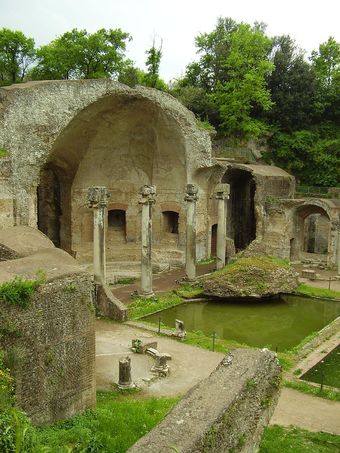
Hadrian’s Villa
The ruins of Hadrian’s Villa in their present state.
Another of Hadrian’s contributions to popular Roman culture was the beard, which symbolised his philhellenism; Dio of Prusa had equated the generalized using of the beard with Hellenic ethos. Since the time of Scipio Africanus, it had been fashionable among the Romans to be clean-shaven. Also, all Roman emperors before Hadrian, except for Nero (also a great admirer of Greek culture), were clean shaven. Most of the emperors after Hadrian would be portrayed with beards. Their beards, however, were not worn out of an appreciation for Greek culture, but because the beard had, thanks to Hadrian, become fashionable. This new fashion lasted until the reign of Constantine the Great and was revived again by Phocas at the start of the 7th century. Notwithstanding his philhellenism, however, in all other everyday life matters, Hadrian behaved as a Roman civic traditionalist, who demanded the use of the toga by senators and knights in public, and strict separation between the sexes in the public baths and theaters.
Hadrian wrote poetry in both Latin and Greek; one of the few surviving examples is a Latin poem he reportedly composed on his deathbed . Some of his Greek productions found their way into the Palatine Anthology.
As a cultural Hellenophile, Hadrian was familiar with the work of the philosophers Epictetus, Heliodorus, and Favorinus. At home he attended to social needs. Hadrian mitigated slavery; masters were forbidden from killing their slaves unless allowed by a court to punish them for a grave offense. Masters were forbidden to sell slaves to a gladiator trainer or to a procurer, except as justified punishment. Hadrian also had the legal code humanized and forbade torture of free defendants and witnesses, legislating against the common practice of condemning free persons in order to have them tortured as a means of gathering information on their supposed activities and accomplices. He also abolished ergastula—private prisons for slaves in which kidnapped free men could also be kept.
8.7: Christianity and the Late Roman Empire
8.7.1: Crises of the Roman Empire
The Crisis of the Third Century was a period in which the Roman Empire nearly collapsed under the combined pressures of invasion, civil war, plague, and economic depression.
Learning Objective
Describe the problems afflicting the Roman Empire during the third century
Key Points
- The situation of the Roman Empire became dire in 235 CE, when emperor Alexander Severus was murdered by his own troops after defeat by Germanic tribes.
- In the years following the emperor’s death, generals of the Roman army fought each other for control of the Empire, and neglected their duties of defending the empire from invasion. As a result, various provinces became victims of frequent raids.
- By 268, the Empire had split into three competing states: the Gallic Empire, including the Roman provinces of Gaul, Britannia, and Hispania; the Palmyrene Empire, including the eastern provinces of Syria Palaestina and Aegyptus; and the Italian-centered and independent Roman Empire proper.
- One of the most profound and lasting effects of the Crisis of the Third Century was the disruption of Rome’s extensive internal trade network under the Pax Romana.
- The continuing problems of the Empire would be radically addressed by Diocletian, allowing the Empire to continue to survive in the West for over a century, and in the East for over a millennium.
Key Terms
- Pax Romana
-
The long period of relative peacefulness and minimal expansion by the Roman military force that was experienced by the Roman Empire after the end of the Final War of the Roman Republic, and before the beginning of the Crisis of the Third Century.
- coloni
-
A tenant farmer from the late Roman Empire and Early Middle Ages; sharecroppers.
- Crisis of the Third Century
-
A period in which the Roman Empire nearly collapsed under the combined pressures of invasion, civil war, plague, and economic depression.
Overview
The Crisis of the Third Century, also known as Military Anarchy or the Imperial Crisis, (235-284 CE) was a period in which the Roman Empire nearly collapsed under the combined pressures of invasion, civil war, plague, and economic depression. The Crisis began with the assassination of Emperor Severus Alexander by his own troops in 235, initiating a 50-year period in which there were at least 26 claimants to the title of Emperor, mostly prominent Roman army generals, who assumed imperial power over all or part of the Empire. Twenty-six men were officially accepted by the Roman Senate as emperor during this period, and thus became legitimate emperors.
By 268, the Empire had split into three competing states: the Gallic Empire, including the Roman provinces of Gaul, Britannia, and (briefly) Hispania; the Palmyrene Empire, including the eastern provinces of Syria Palaestina and Aegyptus; and the Italian-centered and independent Roman Empire proper, between them. Later, Aurelian (270-275) reunited the empire; the Crisis ended with the ascension and reforms of Diocletian in 284.
The Crisis resulted in such profound changes in the Empire’s institutions, society, economic life, and, eventually, religion, that it is increasingly seen by most historians as defining the transition between the historical periods of classical antiquity and late antiquity.
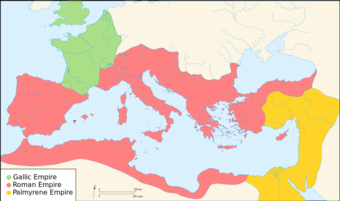
The Roman Empire in 271 CE
The divided Empire during the Crisis of the Third Century.
History of the Crisis
The situation of the Roman Empire became dire in 235 CE, when Emperor Alexander Severus was murdered by his own troops. Many Roman legions had been defeated during a campaign against Germanic peoples raiding across the borders, while the emperor was focused primarily on the dangers from the Sassanid Persian Empire. Leading his troops personally, Alexander Severus resorted to diplomacy and paying tribute, in an attempt to pacify the Germanic chieftains quickly. According to Herodian, this cost him the respect of his troops, who may have felt they should be punishing the tribes who were intruding on Rome’s territory.
In the years following the emperor’s death, generals of the Roman army fought each other for control of the Empire and neglected their duties of defending the empire from invasion. Provincials became victims of frequent raids along the length of the Rhine and Danube rivers, by such foreign tribes as the Carpians, Goths, Vandals, and Alamanni, and attacks from Sassanids in the east. Climate changes and a rise in sea levels ruined the agriculture of what is now the Low Countries, forcing tribes to migrate. Additionally, in 251, the Plague of Cyprian (possibly smallpox) broke out, causing large-scale death, and possibly weakened the ability of the Empire to defend itself.
After the loss of Valerian in 260, the Roman Empire was beset by usurpers, who broke it up into three competing states. The Roman provinces of Gaul, Britain, and Hispania broke off to form the Gallic Empire. After the death of Odaenathus in 267, the eastern provinces of Syria, Palestine, and Aegyptus became independent as the Palmyrene Empire, leaving the remaining Italian-centered Roman Empire proper in the middle.
An invasion by a vast host of Goths was defeated at the Battle of Naissus in 268 or 269. This victory was significant as the turning point of the crisis, when a series of tough, energetic soldier-emperors took power. Victories by Emperor Claudius II Gothicus over the next two years drove back the Alamanni and recovered Hispania from the Gallic Empire. When Claudius died in 270 of the plague, Aurelian, who had commanded the cavalry at Naissus, succeeded him as the emperor and continued the restoration of the Empire.
Aurelian reigned (270-275) through the worst of the crisis, defeating the Vandals, the Visigoths, the Palmyrenes, the Persians, and then the remainder of the Gallic Empire. By late 274, the Roman Empire was reunited into a single entity, and the frontier troops were back in place. More than a century would pass before Rome again lost military ascendancy over its external enemies. However, dozens of formerly thriving cities, especially in the Western Empire, had been ruined, their populations dispersed and, with the breakdown of the economic system, could not be rebuilt. Major cities and towns, even Rome itself, had not needed fortifications for many centuries; many then surrounded themselves with thick walls.
Finally, although Aurelian had played a significant role in restoring the Empire’s borders from external threat, more fundamental problems remained. In particular, the right of succession had never been clearly defined in the Roman Empire, leading to continuous civil wars as competing factions in the military, Senate, and other parties put forward their favored candidate for emperor. Another issue was the sheer size of the Empire, which made it difficult for a single autocratic ruler to effectively manage multiple threats at the same time. These continuing problems would be radically addressed by Diocletian, allowing the Empire to continue to survive in the West for over a century, and in the East for over a millennium.
Impact
One of the most profound and lasting effects of the Crisis of the Third Century was the disruption of Rome’s extensive internal trade network. Ever since the Pax Romana, starting with Augustus, the Empire’s economy had depended in large part on trade between Mediterranean ports and across the extensive road systems to the Empire’s interior. Merchants could travel from one end of the Empire to the other in relative safety within a few weeks, moving agricultural goods produced in the provinces to the cities, and manufactured goods produced by the great cities of the East to the more rural provinces.
With the onset of the Crisis of the Third Century, however, this vast internal trade network broke down. The widespread civil unrest made it no longer safe for merchants to travel as they once had, and the financial crisis that struck made exchange very difficult with the debased currency. This produced profound changes that, in many ways, foreshadowed the very decentralized economic character of the coming Middle Ages.
Large landowners, no longer able to successfully export their crops over long distances, began producing food for subsistence and local barter. Rather than import manufactured goods from the Empire’s great urban areas, they began to manufacture many goods locally, often on their own estates, thus beginning the self-sufficient “house economy” that would become commonplace in later centuries, reaching its final form in the Middle Ages’ manorialism. The common free people of the Roman cities, meanwhile, began to move out into the countryside in search of food and better protection.
Made desperate by economic necessity, many of these former city dwellers, as well as many small farmers, were forced to give up hard-earned, basic civil rights in order to receive protection from large land-holders. In doing so, they became a half-free class of Roman citizen known as coloni. They were tied to the land, and in later Imperial law their status was made hereditary. This provided an early model for serfdom, the origins of medieval feudal society and of the medieval peasantry.
8.7.2: Diocletian and the Tetrarchy
Facing the pressures of civil war, plague, invasion, and economic depression, Diocletian was able to stabilize the Roman Empire for another hundred years through economic reform and the establishment of the Tetrarchy.
Learning Objective
Describe the change in attitudes towards Christians and their statuses within the Roman Empire
Key Points
- Diocletian secured the empire’s borders and purged it of all threats to his power. He separated and enlarged the empire’s civil and military services, and reorganized the empire’s provincial divisions, establishing the largest and most bureaucratic government in the history of the empire.
- Diocletian also restructured the Roman government by establishing the Tetrarchy, a system of rule in which four men shared rule over the massive Roman Empire. The empire was effectively divided in two, with an Augustus and a subordinate Caesar in each half.
- Diocletian established administrative capitals for each of the Tetrarchs, which were located closer to the empire’s borders. Though Rome retained its unique Prefect of the City, it was no longer the administrative capital.
- By 313, therefore, there remained only two emperors: Constantine in the west and Licinius in the east. The tetrarchic system was at an end, although it took until 324 for Constantine to finally defeat Licinius, reunite the two halves of the Roman Empire, and declare himself sole Augustus.
Key Terms
- tetrarchy
-
A form of government in which power is divided between four individuals. In ancient Rome, a system of government instituted by Diocletian that split power between two rulers in the east, and two rulers in the west.
- Diocletian
-
Roman emperor from 284 to 305 CE. Established the tetrarchy and instituted economic and tax reforms to stabilize the Roman Empire.
Diocletian and the Stabilization of the Roman Empire
Diocletian was Roman emperor from 284 to 305 CE. Born to a family of low status in the Roman province of Dalmatia, Diocletian rose through the ranks of the military to become cavalry commander to the Emperor Carus. After the deaths of Carus and his son Numerian on campaign in Persia, Diocletian was proclaimed emperor. Diocletian’s reign stabilized the empire, and marked the end of the Crisis of the Third Century. He appointed fellow officer, Maximian, as Augustus, co-emperor, in 286. Diocletian delegated further in 293, appointing Galerius and Constantius as caesars, junior co-emperors. Under this “tetrarchy,” or “rule of four,” each emperor would rule over a quarter-division of the empire. Diocletian further secured the empire’s borders and purged it of all threats to his power.
He separated and enlarged the empire’s civil and military services and reorganized the empire’s provincial divisions, establishing the largest and most bureaucratic government in the history of the empire. He established new administrative centers in Nicomedia, Mediolanum, Antioch, and Trier, closer to the empire’s frontiers than the traditional capital at Rome had been. Building on third-century trends towards absolutism, he styled himself an autocrat, elevating himself above the empire’s masses with imposing forms of court ceremonies and architecture. Bureaucratic and military growth, constant campaigning, and construction projects increased the state’s expenditures and necessitated a comprehensive tax reform. From at least 297 on, imperial taxation was standardized, made more equitable, and levied at generally higher rates.
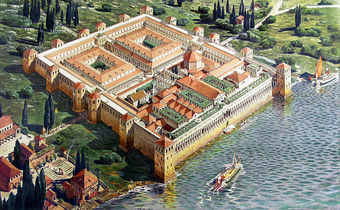
Illustration depicting Diocletian’s Palace (original appearance)
Reconstruction of Diocletian’s Palace in its original appearance, upon completion in 305 CE (viewed from the south-west).
The Tetrarchy
The first phase of Diocletian’s government restructuring, sometimes referred to as the diarchy (“rule of two”), involved the designation of the general Maximian as co-emperor—first as Caesar (junior emperor) in 285, then Augustus in 286. This reorganization allowed Diocletian to take care of matters in the eastern regions of the empire, while Maximian similarly took charge of the western regions, thereby halving the administrative work required to oversee an empire as large as Rome’s. In 293, feeling more focus was needed on both civic and military problems, Diocletian, with Maximian’s consent, expanded the imperial college by appointing two Caesars (one responsible to each Augustus)—Galerius and Constantius Chlorus.
In 305, the senior emperors jointly abdicated and retired, allowing Constantius and Galerius to be elevated in rank to Augusti. They in turn appointed two new Caesars—Severus II in the west under Constantius, and Maximinus in the east under Galerius—thereby creating the second tetrarchy.
The four tetrarchs based themselves not at Rome but in other cities closer to the frontiers, mainly intended as headquarters for the defense of the empire against bordering rivals. Although Rome ceased to be an operational capital, it continued to be the nominal capital of the entire Roman Empire, not reduced to the status of a province, but under its own, unique Prefect of the City (praefectus urbis).
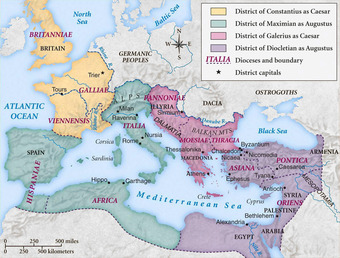
Zones of Influence in the Roman Tetrarchy
This map shows the four zones of influence under Diocletian’s tetrarchy.
In terms of regional jurisdiction, there was no precise division between the four tetrarchs, and this period did not see the Roman state actually split up into four distinct sub-empires. Each emperor had his zone of influence within the Roman Empire, but this influence mainly applied to the theater of war. The tetrarch was himself often in the field, while delegating most of the administration to the hierarchic bureaucracy headed by his respective Praetorian Prefect. The Praetorian Prefect was the title of a high office in the Roman Empire, originating as the commander of the Praetorian Guard, the office gradually acquired extensive legal and administrative functions, with its holders becoming the emperor’s chief aides.
Demise of the Tetrarchy
When, in 305, the 20-year term of Diocletian and Maximian ended, both abdicated. Their Caesares, Galerius and Constantius Chlorus, were both raised to the rank of Augustus, and two new Caesares were appointed: Maximinus (Caesar to Galerius) and Flavius Valerius Severus (Caesar to Constantius). These four formed the second tetrarchy.
However, the system broke down very quickly thereafter. When Constantius died in 306, Galerius promoted Severus to Augustus while Constantine, Constantius’ son, was proclaimed Augustus by his father’s troops. At the same time, Maxentius, the son of Maximian, who also resented being left out of the new arrangements, defeated Severus before forcing him to abdicate and then arranging his murder in 307. Maxentius and Maximian both then declared themselves Augusti. By 308, there were therefore no fewer than four claimants to the rank of Augustus (Galerius, Constantine, Maximian and Maxentius), and only one to that of Caesar (Maximinus).
In 308, Galerius, together with the retired emperor Diocletian and the supposedly retired Maximian, called an imperial “conference” at Carnuntum on the River Danube. The council agreed that Licinius would become Augustus in the West, with Constantine as his Caesar. In the East, Galerius remained Augustus, and Maximinus remained his Caesar. Maximian was to retire, and Maxentius was declared an usurper. This agreement proved disastrous: by 308 Maxentius had become de facto ruler of Italy and Africa even without any imperial rank, and neither Constantine nor Maximinus—who had both been Caesares since 306 and 305, respectively—were prepared to tolerate the promotion of the Augustus Licinius as their superior.
After an abortive attempt to placate both Constantine and Maximinus with the meaningless title filius Augusti (“son of the Augustus,” essentially an alternative title for Caesar), they both had to be recognized as Augusti in 309. However, four full Augusti all at odds with each other did not bode well for the tetrarchic system.
Between 309 and 313, most of the claimants to the imperial office died or were killed in various civil wars. Constantine forced Maximian’s suicide in 310. Galerius died naturally in 311. Maxentius was defeated by Constantine at the Battle of the Milvian Bridge in 312, and subsequently killed. Maximinus committed suicide at Tarsus in 313, after being defeated in battle by Licinius.
By 313, therefore, there remained only two emperors: Constantine in the west and Licinius in the east. The tetrarchic system was at an end, although it took until 324 for Constantine to finally defeat Licinius, reunite the two halves of the Roman Empire, and declare himself sole Augustus.
8.7.3: The Rise of Christianity
Though the early Christians were persecuted under some emperors, such as Nero and Diocletian, the religion continued to thrive and grow, eventually becoming the official religion of the Roman Empire under Constantine.
Learning Objective
Describe the challenges Christians faced in the Roman Empire
Key Points
- Christians suffered from sporadic and localized persecutions over a period of two and a half centuries, as their refusal to participate in Imperial Cult of Rome was considered an act of treason, and was thus punishable by execution.
- The Diocletianic, or Great Persecution, was the last and most severe persecution of Christians in the Roman Empire, which lasted from 302-311 CE. Galerius issued an edict of toleration in 311, which granted Christians the right to practice their religion, but did not restore any taken property back to them.
- The Edict of Milan in 313 made the empire officially neutral with regard to religious worship; it neither made the traditional religions illegal nor made Christianity the state religion.
Key Terms
- the Great Persecution
-
The last and most severe persecution of Christians in the Roman Empire.
- Edict of Milan
-
An agreement in 313 CE by Constantine and Licinius to treat Christians benevolently within the Roman Empire.
Persecution of Early Christians
Christianity posed a serious threat to the traditional Romans. The idea of monotheism was considered offensive against the polytheistic Roman pantheon, and came into further conflict with the Imperial Cult, in which emperors and some members of their families were worshipped as divine. As such, Christianity was considered criminal and was punished harshly.
The first recorded official persecution of Christians on behalf of the Roman Empire was in 64 CE, when, as reported by the Roman historian Tacitus, Emperor Nero blamed Christians for the Great Fire of Rome. According to Church tradition, it was during the reign of Nero that Peter and Paul were martyred in Rome. However, modern historians debate whether the Roman government distinguished between Christians and Jews prior to Nerva’s modification of the Fiscus Judaicus in 96, from which point practicing Jews paid the tax and Christians did not.
The Diocletianic or Great Persecution was the last and most severe persecution of Christians in the Roman Empire, which lasted from 302-311 CE. In 303, the emperors Diocletian, Maximian, Galerius, and Constantius issued a series of edicts rescinding the legal rights of Christians and demanding that they comply with traditional Roman religious practices. Later edicts targeted the clergy and ordered all inhabitants to sacrifice to the Roman gods (a policy known as universal sacrifice). The persecution varied in intensity across the empire—it was weakest in Gaul and Britain, where only the first edict was applied, and strongest in the Eastern provinces. Persecutory laws were nullified by different emperors at different times, but Constantine and Licinius’s Edict of Milan (313) has traditionally marked the end of the persecution.
During the Great Persecution, Diocletian ordered Christian buildings and the homes of Christians torn down, and their sacred books collected and burned during the Great Persecution. Christians were arrested, tortured, mutilated, burned, starved, and condemned to gladiatorial contests to amuse spectators. The Great Persecution officially ended in April of 311, when Galerius, senior emperor of the Tetrarchy, issued an edict of toleration which granted Christians the right to practice their religion, though it did not restore any property to them. Constantine, Caesar in the western empire, and Licinius, Caesar in the east, also were signatories to the edict of toleration. It has been speculated that Galerius’ reversal of his long-standing policy of Christian persecution has been attributable to one or both of these co-Caesars.
The Rise of Christianity
The Diocletianic persecution was ultimately unsuccessful. As one modern historian has put it, it was simply “too little and too late.” Christians were never purged systematically in any part of the empire, and Christian evasion continually undermined the edicts’ enforcement. Although the persecution resulted in death, torture, imprisonment, or dislocation for many Christians, the majority of the empire’s Christians avoided punishment. Some bribed their way to freedom or fled. In the end, the persecution failed to check the rise of the church. By 324, Constantine was sole ruler of the empire, and Christianity had become his favored religion.
By 324, Constantine, the Christian convert, ruled the entire empire alone. Christianity became the greatest beneficiary of imperial largesse. The persecutors had been routed. As the historian J. Liebeschuetz has written: “The final result of the Great Persecution provided a testimonial to the truth of Christianity, which it could have won in no other way.” After Constantine, the Christianization of the Roman empire would continue apace. Under Theodosius I (r. 378-395), Christianity became the state religion. By the 5th century, Christianity was the empire’s predominant faith, and filled the same role paganism had at the end of the 3rd century. Because of the persecution, however, a number of Christian communities were riven between those who had complied with imperial authorities (traditores) and those who had refused. In Africa, the Donatists, who protested the election of the alleged traditor, Caecilian, to the bishopric of Carthage, continued to resist the authority of the central church until after 411. The Melitians in Egypt left the Egyptian Church similarly divided.
The Edict of Milan
In 313, Constantine and Licinius announced in the Edict of Milan “that it was proper that the Christians and all others should have liberty to follow that mode of religion which to each of them appeared best,” thereby granting tolerance to all religions, including Christianity. The Edict of Milan went a step further than the earlier Edict of Toleration by Galerius in 311, and returned confiscated Church property. This edict made the empire officially neutral with regard to religious worship; it neither made the traditional religions illegal, nor made Christianity the state religion (as did the later Edict of Thessalonica in 380 CE). The Edict of Milan did, however, raise the stock of Christianity within the empire, and it reaffirmed the importance of religious worship to the welfare of the state.
8.7.4: Constantine
Constantine the Great was a Roman Emperor from 306 to 337 CE; he adopted Christianity and declared it the religion of the Roman Empire.
Learning Objective
Evaluate Constantine’s rise to power and relationship with Christianity
Key Points
- The age of Constantine marked a distinct epoch in the history of the Roman Empire, both for founding Byzantium in the east, as well as his adoption of Christianity as a state religion.
- As emperor, Constantine enacted many administrative, financial, social, and military reforms to strengthen the empire.
- Constantine experienced a dramatic event in 312 at the Battle of the Milvian Bridge, after which Constantine claimed the emperorship in the west and converted to Christianity.
- According to some sources, on the evening of October 27, with the armies preparing for battle, Constantine had a vision of a cross, which led him to fight under the protection of the Christian god.
- The accession of Constantine was a turning point for early Christianity; after his victory, Constantine took over the role of patron of the Christian faith.
Key Terms
- Battle of the Milvian Bridge
-
A battle that took place between the Roman Emperors, Constantine I and Maxentius, on October 28, 312, and is often seen as the beginning of Constantine’s conversion to Christianity.
- Edict of Milan
-
The February 313 CE agreement to treat Christians benevolently within the Roman Empire, thereby ending years of persecution.
- Chi-Rho
-
One of the earliest forms of christogram, which is used by some Christians, and was used by the Roman emperor, Constantine I (r. 306-337), as part of a military standard.
Constantine the Great was a Roman Emperor from 306-337 CE. Constantine was the son of Flavius Valerius Constantius, a Roman army officer, and his consort, Helena. His father became Caesar, the deputy emperor in the west, in 293 CE. Constantine was sent east, where he rose through the ranks to become a military tribune under the emperors Diocletian and Galerius. In 305, Constantius was raised to the rank of Augustus, senior western emperor, and Constantine was recalled west to campaign under his father in Britannia (modern Great Britain). Acclaimed as emperor by the army at Eboracum (modern-day York) after his father’s death in 306 CE, Constantine emerged victorious in a series of civil wars against the emperors Maxentius and Licinius, to become sole ruler of both west and east by 324 CE.
As emperor, Constantine enacted many administrative, financial, social, and military reforms to strengthen the empire. The government was restructured and civil and military authority separated. A new gold coin, the solidus, was introduced to combat inflation. It would become the standard for Byzantine and European currencies for more than a thousand years. As the first Roman emperor to claim conversion to Christianity, Constantine played an influential role in the proclamation of the Edict of Milan in 313, which decreed tolerance for Christianity in the empire. He called the First Council of Nicaea in 325, at which the Nicene Creed was professed by Christians. In military matters, the Roman army was reorganized to consist of mobile field units and garrison soldiers capable of countering internal threats and barbarian invasions. Constantine pursued successful campaigns against the tribes on the Roman frontiers—the Franks, the Alamanni, the Goths, and the Sarmatians—even resettling territories abandoned by his predecessors during the Crisis of the Third Century.
Constantine’s reputation flourished during the lifetime of his children and for centuries after his reign. The medieval church upheld him as a paragon of virtue, while secular rulers invoked him as a prototype, a point of reference, and the symbol of imperial legitimacy and identity. One of his major political legacies, aside from moving the capital of the empire to Constantinople, was that, in leaving the empire to his sons, he replaced Diocletian’s tetrarchy with the principle of dynastic succession.
The Battle of the Milvian Bridge
Eusebius of Caesarea, and other Christian sources, record that Constantine experienced a dramatic event in 312 at the Battle of the Milvian Bridge, after which Constantine claimed the emperorship in the west, and converted to Christianity. The Battle of the Milvian Bridge took place between the Roman Emperors, Constantine I and Maxentius, on October 28, 312. It takes its name from the Milvian Bridge, an important route over the Tiber. Constantine won the battle and started on the path that led him to end the tetrarchy and become the sole ruler of the Roman Empire. Maxentius drowned in the Tiber during the battle, and his body was later taken from the river and decapitated.
According to chroniclers, such as Eusebius of Caesarea and Lactantius, the battle marked the beginning of Constantine’s conversion to Christianity. Eusebius of Caesarea recounts that Constantine looked up to the sun before the battle and saw a cross of light above it, and with it the Greek words Ἐν Τούτῳ Νίκα (“in this sign, conquer!”), often rendered in a Latin version, “in hoc signo vinces.” Constantine commanded his troops to adorn their shields with a Christian symbol (the Chi-Rho), and thereafter they were victorious. The Arch of Constantine, erected in celebration of the victory, certainly attributes Constantine’s success to divine intervention; however, the monument does not display any overtly Christian symbolism, so there is no scholarly consensus on the events’ relation to Constantine’s conversion to Christianity.
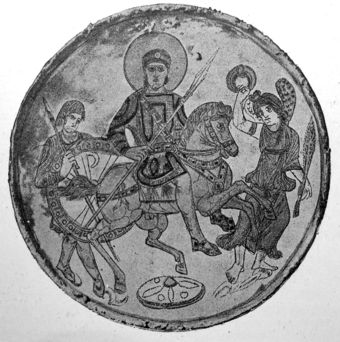
Constantine
Missorium depicting Constantine’s son Constantius II, accompanied by a guardsman with the Chi Rho monogram depicted on his shield.
Following the battle, Constantine ignored the altars to the gods prepared on the Capitoline, and did not carry out the customary sacrifices to celebrate a general’s victorious entry into Rome, instead heading directly to the imperial palace. Most influential people in the empire, however, especially high military officials, had not been converted to Christianity, and still participated in the traditional religions of Rome; Constantine’s rule exhibited at least a willingness to appease these factions. The Roman coins minted up to eight years after the battle still bore the images of Roman gods. The monuments he first commissioned, such as the Arch of Constantine, contained no reference to Christianity.
Constantine and Christianity
While the Roman Emperor Constantine the Great reigned (306-337 CE), Christianity began to transition to the dominant religion of the Roman Empire. Historians remain uncertain about Constantine’s reasons for favoring Christianity, and theologians and historians have argued about which form of Early Christianity he subscribed to. There is no consensus among scholars as to whether he adopted his mother Helena’s Christianity in his youth, or (as claimed by Eusebius of Caesarea) encouraged her to convert to the faith himself. Some scholars question the extent to which he should be considered a Christian emperor: “Constantine saw himself as an ’emperor of the Christian people.’ If this made him a Christian is the subject of debate,” although he allegedly received a baptism shortly before his death.
Constantine’s decision to cease the persecution of Christians in the Roman Empire was a turning point for early Christianity, sometimes referred to as the Triumph of the Church, the Peace of the Church, or the Constantinian Shift. In 313, Constantine and Licinius issued the Edict of Milan, decriminalizing Christian worship. The emperor became a great patron of the Church and set a precedent for the position of the Christian emperor within the Church, and the notion of orthodoxy, Christendom, ecumenical councils, and the state church of the Roman Empire, declared by edict in 380. He is revered as a saint and isapostolos in the Eastern Orthodox Church and Oriental Orthodox Church for his example as a “Christian monarch.”
8.7.5: The Shift East
Constantine built a new imperial residence in Byzantium and renamed the city Constantinople after himself; the city eventually became the capital of the empire for over one thousand years.
Learning Objective
Explain why Constantine moved the capital of the empire to Constantinople, and the consequences that had for the empire as a whole
Key Points
- After defeating Maxentius and his rebellion, Constantine gradually consolidated his military superiority over his rivals in the crumbling Tetrarchy, in particular Licinius.
- Eventually, Constantine defeated Licinius, making him the sole emperor of the empire, thereby ending the tetrarchy.
- Licinius’ defeat came to represent the defeat of a rival center of Pagan and Greek-speaking political activity in the east, and it was proposed that a new eastern capital should represent the integration of the east into the Roman Empire as a whole; Constantine chose Byzantium.
- The city was thus founded in 324, dedicated on May 11, 330, and renamed Constantinople.
- The Byzantine Empire considered Constantine its founder, and the Holy Roman Empire reckoned him among the venerable figures of its tradition.
Key Terms
- Byzantium
-
An ancient Greek colony on the site that later became Constantinople, and eventually Istanbul.
- Byzantine Empire
-
Also referred to as the Eastern Roman Empire, was the continuation of the Roman Empire in the east during Late Antiquity and the Middle Ages, when the empire’s capital city was Constantinople.
The age of Constantine marked a distinct epoch in the history of the Roman Empire. He built a new imperial residence at Byzantium, and renamed the city Constantinople after himself (the laudatory epithet of “New Rome” came later, and was never an official title). It would later become the capital of the empire for over one thousand years; for this reason the later Eastern Empire would come to be known as the Byzantine Empire.
Background: War With Licinius
After defeating Maxentius, Constantine gradually consolidated his military superiority over his rivals in the crumbling tetrarchy. In 313, he met Licinius in Milan to secure their alliance by the marriage of Licinius and Constantine’s half-sister, Constantia. During this meeting, the emperors agreed on the so-called Edict of Milan, officially granting full tolerance to Christianity and all religions in the Empire. In the year 320, Licinius allegedly reneged on the religious freedom promised by the Edict of Milan in 313, and began to oppress Christians anew, generally without bloodshed, but resorting to confiscations and sacking of Christian office-holders.
This dubious arrangement eventually became a challenge to Constantine in the west, climaxing in the great civil war of 324. Licinius, aided by Goth mercenaries, represented the past and the ancient Pagan faiths. Constantine and his Franks marched under the standard of the labarum Chi-Rho, and both sides saw the battle in religious terms. Outnumbered, but fired by their zeal, Constantine’s army emerged victorious in the Battle of Adrianople. Licinius fled across the Bosphorus and appointed Martius Martinianus, the commander of his bodyguard, as Caesar, but Constantine next won the Battle of the Hellespont, and finally the Battle of Chrysopolis on September 18, 324. Licinius and Martinianus surrendered to Constantine at Nicomedia on the promise their lives would be spared: they were sent to live as private citizens in Thessalonica and Cappadocia, respectively, but in 325, Constantine accused Licinius of plotting against him and had them both arrested and hanged. Licinius’s son (the son of Constantine’s half-sister) was also killed. Thus, Constantine became the sole emperor of the Roman Empire.
Foundation of Constantinople
Licinius’ defeat came to represent the defeat of a rival center of Pagan and Greek-speaking political activity in the east, as opposed to the Christian and Latin-speaking Rome, and it was proposed that a new eastern capital should represent the integration of the east into the Roman Empire as a whole, as a center of learning, prosperity, and cultural preservation for the whole of the eastern Roman Empire. Among the various locations proposed for this alternative capital, Constantine appears to have toyed earlier with Serdica (present-day Sofia), as he was reported saying that “Serdica is my Rome.” Sirmium and Thessalonica were also considered. Eventually, however, Constantine decided to work on the Greek city of Byzantium, which offered the advantage of having already been extensively rebuilt on Roman patterns of urbanism, during the preceding century, by Septimius Severus and Caracalla, who had already acknowledged its strategic importance.
The city was thus founded in 324, dedicated on May 11, 330, and renamed Constantinopolis (“Constantine’s City” or Constantinople in English). Special commemorative coins were issued in 330 to honor the event. The new city was protected by the relics of the True Cross, the Rod of Moses, and other holy relics, though a cameo now at the Hermitage Museum also represented Constantine crowned by the tyche of the new city. The figures of old gods were either replaced or assimilated into a framework of Christian symbolism. Constantine built the new Church of the Holy Apostles on the site of a temple to Aphrodite. Generations later there was the story that a divine vision led Constantine to this spot, and an angel no one else could see led him on a circuit of the new walls. The capital would often be compared to the ‘old’ Rome as Nova Roma Constantinopolitana, the “New Rome of Constantinople.” Constantinople was a superb base from which to guard the Danube River, and it was reasonably close to the eastern frontiers. Constantine also began the building of the great fortified walls, which were expanded and rebuilt in subsequent ages.
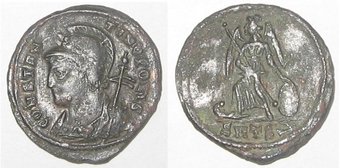
Constantinopolis Coin
Coin struck by Constantine I to commemorate the founding of Constantinople.
Legacy
Historian J.B. Bury asserts that “the foundation of Constantinople […] inaugurated a permanent division between the Eastern and Western, the Greek and the Latin, halves of the empire—a division to which events had already pointed—and affected decisively the whole subsequent history of Europe.”
The Byzantine Empire considered Constantine its founder, and the Holy Roman Empire reckoned him among the venerable figures of its tradition. In the later Byzantine state, it had become a great honor for an emperor to be hailed as a “new Constantine.” Ten emperors, including the last emperor of the Eastern Roman Empire, carried the name. Monumental Constantinian forms were used at the court of Charlemagne to suggest that he was Constantine’s successor and equal. Constantine acquired a mythic role as a warrior against “heathens.”
8.7.6: The Decline and Fall of the Roman Empire
The Fall of the Western Roman Empire was the period of decline during which the empire disintegrated and split into numerous successor states.
Learning Objective
Analyze, broadly, the causes of the fall of the Roman Empire
Key Points
- Throughout the 5th century, the empire’s territories in western Europe and northwestern Africa, including Italy, fell to various invading or indigenous peoples, in what is sometimes called the Migration Period.
- By the late 3rd century, the city of Rome no longer served as an effective capital for the emperor, and various cities were used as new administrative capitals. Successive emperors, starting with Constantine, privileged the eastern city of Byzantium, which he had entirely rebuilt after a siege.
- In 476, after being refused lands in Italy, Odacer and his Germanic mercenaries took Ravenna, the Western Roman capital at the time, and deposed Western Emperor Romulus Augustus. The whole of Italy was quickly conquered, and Odoacer’s rule became recognized in the Eastern Empire.
- Four broad schools of thought exist on the decline and fall of the Roman Empire: decay owing to general malaise, monocausal decay, catastrophic collapse, and transformation.
Key Terms
- Migration Period
-
Also known as the period of the Barbarian Invasions, it was a period of intensified human migration in Europe from about 400 to 800 CE, during the transition from Late Antiquity to the Early Middle Ages.
- Odoacer
-
A soldier, who came to power in the Western Roman Empire in 476 CE. His reign is commonly seen as marking the end of the Western Roman Empire.
The Fall of the Western Roman Empire was the process of decline during which the empire failed to enforce its rule, and its vast territory was divided into several successor polities. The Roman Empire lost the strengths that had allowed it to exercise effective control; modern historians mention factors including the effectiveness and numbers of the army, the health and numbers of the Roman population, the strength of the economy, the competence of the emperor, the religious changes of the period, and the efficiency of the civil administration. Increasing pressure from barbarians outside Roman culture also contributed greatly to the collapse. The reasons for the collapse are major subjects of the historiography of the ancient world, and they inform much modern discourse on state failure.
By 476 CE, when Odoacer deposed Emperor Romulus, the Western Roman Empire wielded negligible military, political, or financial power and had no effective control over the scattered western domains that could still be described as Roman. Invading “barbarians” had established their own polities on most of the area of the Western Empire. While its legitimacy lasted for centuries longer and its cultural influence remains today, the Western Empire never had the strength to rise again.
It is important to note, however, that the so-called fall of the Roman Empire specifically refers to the fall of the Western Roman Empire, since the Eastern Roman Empire, or what became known as the Byzantine Empire, whose capital was founded by Constantine, remained for another 1,000 years. Theodosius was the last emperor who ruled over the whole empire. After his death in 395, he gave the two halves of the empire to his two sons, Arcadius and Honorius; Arcadius became ruler in the east, with his capital in Constantinople, and Honorius became ruler in the west, with his capital in Milan, and later Ravenna.
Rome in the 5th Century CE
Throughout the 5th century, the empire’s territories in western Europe and northwestern Africa, including Italy, fell to various invading or indigenous peoples in what is sometimes called the Migration Period, also known as the Barbarian Invasions, from the Roman and South European perspective. The first migrations of peoples were made by Germanic tribes, such as the Goths, Vandals, Angles, Saxons, Lombards, Suebi, Frisii, Jutes and Franks; they were later pushed westwards by the Huns, Avars, Slavs, and Bulgars.
Although the eastern half still survived with borders essentially intact for several centuries (until the Muslim conquests), the Empire as a whole had initiated major cultural and political transformations since the Crisis of the Third Century, with the shift towards a more openly autocratic and ritualized form of government, the adoption of Christianity as the state religion, and a general rejection of the traditions and values of Classical Antiquity.
The reasons for the decline of the Empire are still debated today, and are likely multiple. Historians infer that the population appears to have diminished in many provinces (especially western Europe), judging from the diminishing size of fortifications built to protect the cities from barbarian incursions from the 3rd century on. Some historians even have suggested that parts of the periphery were no longer inhabited, because these fortifications were restricted to the center of the city only. By the late 3rd century, the city of Rome no longer served as an effective capital for the emperor, and various cities were used as new administrative capitals. Successive emperors, starting with Constantine, privileged the eastern city of Byzantium, which he had entirely rebuilt after a siege. Later renamed Constantinople, and protected by formidable walls in the late 4th and early 5th centuries, it was to become the largest and most powerful city of Christian Europe in the Early Middle Ages. Since the Crisis of the Third Century, the empire was intermittently ruled by more than one emperor at once (usually two), presiding over different regions.
The Latin-speaking west, under dreadful demographic crisis, and the wealthier Greek-speaking east, also began to diverge politically and culturally. Although this was a gradual process, still incomplete when Italy came under the rule of barbarian chieftains in the last quarter of the 5th century, it deepened further afterward, and had lasting consequences for the medieval history of Europe.
In 476, after being refused lands in Italy, Orestes’ Germanic mercenaries, under the leadership of the chieftain Odoacer, captured and executed Orestes and took Ravenna, the Western Roman capital at the time, deposing Western Emperor Romulus Augustus. The whole of Italy was quickly conquered, and Odoacer’s rule became recognized in the Eastern Empire. Meanwhile, much of the rest of the Western provinces were conquered by waves of Germanic invasions, most of them being disconnected politically from the east altogether, and continuing a slow decline. Although Roman political authority in the west was lost, Roman culture would last in most parts of the former western provinces into the 6th century and beyond.
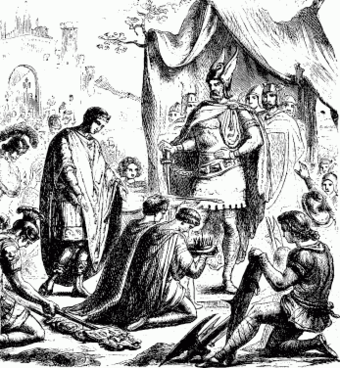
Romulus Augustus Resigns the Crown
Charlotte Mary Yonge’s 1880 artist rendition of Romulus Augustus resigning the crown to Odoacer.
Theories on the Decline and Fall
The various theories and explanations for the fall of the Roman Empire in the west may be very broadly classified into four schools of thought (although the classification is not without overlap):
- Decay owing to general malaise
- Monocausal decay
- Catastrophic collapse
- Transformation
The tradition positing general malaise goes back to the historian, Edward Gibbon, who argued that the edifice of the Roman Empire had been built on unsound foundations from the beginning. According to Gibbon, the fall was—in the final analysis—inevitable. On the other hand, Gibbon had assigned a major portion of the responsibility for the decay to the influence of Christianity, and is often, though perhaps unjustly, seen as the founding father of the school of monocausal explanation. On the other hand, the school of catastrophic collapse holds that the fall of the empire had not been a pre-determined event and need not be taken for granted. Rather, it was due to the combined effect of a number of adverse processes, many of them set in motion by the Migration Period, that together applied too much stress to the empire’s basically sound structure. Finally, the transformation school challenges the whole notion of the ‘fall’ of the empire, asking instead to distinguish between the fall into disuse of a particular political dispensation, anyway unworkable towards its end; and the fate of the Roman civilization that under-girded the empire. According to this school, drawing its basic premise from the Pirenne thesis, the Roman world underwent a gradual (though often violent) series of transformations, morphing into the medieval world. The historians belonging to this school often prefer to speak of Late Antiquity, instead of the Fall of the Roman Empire.
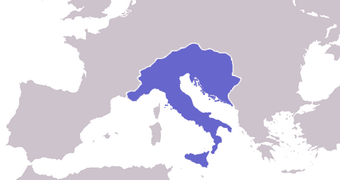
Ostrogothic Kingdom
The Ostrogothic Kingdom, which rose from the ruins of the Western Roman Empire.
Chapter 7: Ancient Greece and the Hellenistic World
7.1: Early Periods in Greek History
7.1.1: Greek Dark Ages
The Greek Dark Ages were ushered in by a period of violence, and characterized by the disruption of Greek cultural progress.
Learning Objective
Understand the characteristics of the Greek Dark Ages
Key Points
- The Late Bronze Age collapse, also known as the Age of
Calamities, was a transition in the Aegean Region, Eastern Mediterranean, and
Southwestern Asia. It took place from the Late Bronze Age to the Early Iron
Age. Historians believe this period was violent, sudden, and culturally
disruptive. - Many historians attribute the fall of the
Mycenaeans, and overall Bronze Age collapse, to climatic or environmental
catastrophe combined with an invasion by the Dorians (or Sea Peoples). - During the Dark Ages, Greece was most likely divided into independent
regions according to kinship groups, and the oikoi, or
households. - Toward the end of the Greek Dark Ages,
communities began to develop that were governed by elite groups of aristocrats, as opposed to singular kings or chieftains of earlier periods. Additionally, trade with
other communities in the Mediterranean and the Levant began to strengthen, based
upon findings from archaeological sites.
Key Terms
- oikoi
-
The
basic unit of society in most Greek city-states. In some usage, it refers to
the line of descent from a father to a son throughout generations.
Alternatively, it can refer to everybody living in a given house. - Linear B
-
Syllabic
script that was used for writing Mycenaean Greek, the earliest documented form
of the Greek language. - palace
economy -
A
system of economic organization in which a substantial share of wealth flows
into the control of a centralized administration (i.e., the palace), and then
outward to the general population.
Age of Calamities
The Late Bronze Age collapse, or Age of Calamities, was a
transition in the Aegean Region, Eastern Mediterranean, and Southwestern Asia
that took place from the Late Bronze Age to the Early Iron Age. Historians
believe this period was violent, sudden, and culturally disruptive. The palace
economy of the Aegean Region that had characterized the Late Bronze Age, was
replaced, after a hiatus, by the isolated village cultures of the Greek Dark
Ages—
a period that lasted for more than 400 years. Cities like Athens
continued to be occupied, but with a more local sphere of influence, limited
evidence of trade, and an impoverished culture, which took centuries to
recover.
Fall of the Mycenaeans
Many historians attribute the fall of the Mycenaeans, and
overall Bronze Age collapse, to climatic or environmental catastrophe, combined
with an invasion by the Dorians or Sea Peoples—a group of people who possibly
originated from different parts of the Mediterranean like the Black Sea, though
their origins remain obscure. Historians also point to the widespread
availability of edged iron weapons as an exasperating factor. Despite this, no
single explanation fits all available archaeological evidence in explaining the
fall of the Mycenaean culture.
Many large-scale revolts took place in several parts of the
eastern Mediterranean during this time, and attempts to overthrow existing
kingdoms were made as a result of economic and political instability by peoples
already plagued with famine and hardship. Some regions in Greece, such as
Attica, Euboea, and central Crete, recovered economically quicker from these
events than other regions, but life for the poorest Greeks would have remained
relatively unchanged. Farming, weaving, metalworking, and potting continued at
lower levels of output and for local use. Some technical innovations were
introduced around 1050 BCE with the start of the Proto-geometric style. However, the overall trend was toward simpler, less intricate pieces with fewer
resources being devoted to the creation of art.
None of the Mycenaean palaces of the Late Bronze Age
survived, with the possible exception of the Cyclopean fortifications on the
Acropolis of Athens. The archaeological record shows that destruction was
heaviest at palaces and fortified sites. Up to 90% of small sites in the
Peloponnese were abandoned, suggesting major depopulation. The Linear B writing
of the Greek language used by Mycenaean bureaucrats ceased, and decorations on
Greek pottery after about 1100 BCE lacks the figurative decoration of the
Mycenaeans, and was restricted to simpler geometric styles.
Society During the Greek Dark Ages
Greece was most likely divided into independent regions according to kinship groups and the oikoi, or households. Excavations of Dark Age
communities, such as Nichoria in the Peloponnese, have shown how a Bronze Age
town was abandoned in 1150 BCE, but then reemerged as a small village cluster
by 1075 BCE. Archaeological evidence suggests that only 40 families lived in
Nichoria and that there was abundant farming and grazing land. Some remains
appear to have been the living quarters of a chieftain. High status
individuals did exist during the Dark Ages; however, their standards of living
were not significantly higher than others in their village.
By the mid- to late 8th century BCE, a new alphabet system
was adopted by the Greek, and borrowed from the Phoenician writing system. This
writing system introduced characters for vowel sounds, creating the first truly
alphabetic (as opposed to abjad) writing system. The new system of writing
spread throughout the Mediterranean, and was used not only to write in Greek,
but also Phrygian and other languages.
It was previously believed that all contact had
been lost between mainland Hellenes and foreign powers during this period;
however, artifacts from excavations at Lefkandi in Euboea show that significant
cultural and trade links with the east, especially the Levant coast, developed
from approximately 900 BCE onward. Evidence has also emerged of a Hellenic
presence in sub-Mycenaean Cyprus, and on the Syrian coast at Al Mina. The
archaeological record of many sites demonstrates that the economic recovery of
Greece was well advanced by the beginning of the 8th century BCE. Many burial
sites contained offerings from the Near East, Egypt, and Italy. The decoration
of pottery also became more elaborate, featuring figured scenes that parallel
the stories of Homeric tradition. Iron tools and weapons also became better in
quality, and communities began to develop that were governed by elite groups of
aristocrats, as opposed to singular kings or chieftains of earlier periods.
7.1.2: Archaic Greece
The
Archaic Period saw the increasing urbanization of Greek communities, and the
development of the concept of the polis.
Learning Objective
Understand the changes to Greek society during the Archaic Period
Key Points
- The Archaic period saw significant urbanization, and the development of the concept of the polis, as it was used in classical
Greece. - Archaic Greece, from the mid-seventh century
onward, has been referred to as an “age of tyrants.” - The Homeric Question concerns the doubts and
consequent debate over the historicity of the Iliad and the Odyssey, as well as the identity of their author, Homer.
Key Terms
- synoecism
-
The
amalgamation of several small settlements into a single urban center. - polis
-
The
literal translation of this word from Greek is “city.” It typically refers to
the Greek city-states of the Archaic and Classical periods.
Archaic Greece
The Archaic period of Greek history lasted from the 8th
century BCE to the second Persian invasion of Greece in 480 BCE. The period
began with a massive increase in the Greek population and a structural
revolution that established the Greek city-states, or polis. The Archaic
period saw developments in Greek politics, economics, international relations,
warfare, and culture. It also laid the groundwork for the classical period,
both politically and culturally. During this time, the Greek alphabet developed, and the earliest surviving Greek literature was composed. Monumental sculpture
and red-figure pottery also developed in Greece, and in Athens, the earliest
institutions of democracy were implemented.
Some written accounts of life exist from this time period in
the form of poetry, law codes, inscriptions on votive offerings, and epigrams
inscribed on tombs. However, thorough written histories, such as those that
exist from the Greek classical period, are lacking. Historians do have access
to rich archaeological evidence from this period, however, that informs our
understanding of Greek life during the Archaic period.
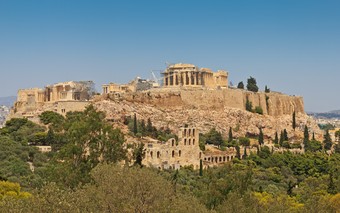
View from Philopappos, Acropolis Hill
The Acropolis of Athens, a noted polis of classical Greece.
Development of the Polis
The Archaic period saw significant urbanization and the
development of the concept of the polis as it was used in classical Greece. However,
the polis did not become the dominant form of sociopolitical organization
throughout Greece during the Archaic period, and in the north and west of the
country it did not become dominant until later in the classical period. The
process of urbanization known as “synoecism” (or the amalgamation of several
small settlements into a single urban center), took place in much of Greece
during the 8th century. Both Athens and Argos, for example, coalesced into
single settlements near the end of that century. In some settlements, physical
unification was marked by the construction of defensive city walls. The
increase in population, and evolution of the polis as a sociopolitical structure, necessitated a new form of political organization.
Age of Tyranny
Archaic Greece from the mid-7th century onward has been
referred to as an “age of tyrants.” Various explanations have been provided for
the rise of tyranny in the 7th century. The most popular explanation dates
back to Aristotle, who argued that tyrants were set up by the people in response
to the nobility becoming less tolerable. Because there is no evidence from this
time period demonstrating this to be the case, historians have looked for
alternate explanations. Some argue that tyrannies were set up by individuals
who controlled privates armies, and that early tyrants did not need the support
of the people at all. Others suggest that tyrannies were established as a
consequence of in-fighting between rival oligarchs, rather than as a result of
fighting between oligarchs and the people.
Other historians question the existence of a 7th century “age of tyrants” altogether. In the Archaic period, the Greek word tyrannos did
not have the negative connotations it had later in the classical period. Often
the word could be used as synonymous with “king.” As a result, many historians
argue that Greek tyrants were not considered illegitimate rulers, and cannot be
distinguished from any other rulers during the same period.
The Homeric Question
The Homeric Question concerns the doubts and
consequent debate over the identity of Homer, the author of the Iliad and the
Odyssey; it also questions the historicity of the two books. Many scholars agree that regardless of who
authored Homer’s works, it is highly likely that the poems attributed to him
were part of a generations-old oral tradition, with many scholars believing the
works to be transcribed some time in the 6th century BCE or earlier. Many
estimates place the events of Homer’s Trojan War as preceding the Greek Dark
Ages, of approximately 1250 to 750 BCE. The Iliad, however, has been placed
immediately following the Greek Dark Age period.
7.1.3: The Rise of Classical Greece
Classical Greece rose after the fall of the Athenian tyrants and the institution of Cleisthenes’ democratic reforms, and lasted throughout the 5th and 4th centuries BCE.
Learning Objective
Understand the significance of Cleisthenes’ reforms to the rise of Classical Greece
Key Points
- The classical period followed the Archaic period, and was succeeded by the Hellenistic period.
- Much of modern Western politics, artistic and scientific thought, literature, and philosophy derives from this period of Greek history.
- Through Cleisthenes’ reforms, the people endowed their city with isonomic institutions, and established ostracism.
- A corpus of reforms made to Athenian political administration during this time led to the emergence of a wider democracy in the 460s and 450s BCE.
Key Terms
- Classical Greece
-
A 200 year period in Greek culture, lasting from the 5th through 4th centuries BCE.
- Cleisthenes
-
A noble Athenian of the Alcmaeonid family, credited with reforming the constitution of ancient Athens, and setting it on a democratic footing in 508/7 BCE.
- isonomic
-
A word used by ancient Greek writers to refer to various kinds of popular government with the general goal of “equal rights.”
- ostracism
-
A procedure under Athenian democracy by which any citizen could be expelled from the city-state of Athens for ten years.
- trittyes
-
Population divisions in ancient Attica, established by the reforms of Cleisthenes in 508 BCE.
Classical Greece was a 200-year period in Greek culture lasting from the 5th to the 4th centuries BCE. This period saw the annexation of much of modern-day Greece by the Persian Empire, as well as its subsequent independence. Classical Greece also had a powerful influence on the Roman Empire, and greatly influenced the foundations of Western civilization. Much of modern Western politics, artistic and scientific thought, literature, and philosophy derives from this period of Greek history. The classical period was preceded by the Archaic period, and was succeeded by the Hellenistic period.
Rise
of the City-States
The
term “city-state,” which is English in origin, does not fully translate the
Greek term for these same entities, polis.
Poleis were different from ancient
city-states in that they were ruled by bodies of the citizens who lived there.
Many were initially established, as in Sparta, via a network of villages, with a
governance center being established in a central urban center. As notions of
citizenship rose to prominence among landowners, polis came to embody an entire body of citizens and the term could
be used to describe the populace of a place, rather than the physical location
itself. Basic elements of a polis
often included the following:
- Self-governance,
autonomy, and independence -
A
social hub and financial marketplace, called an agora -
Urban
planning and architecture -
Temples,
altars, and other sacred precincts, many of which would be dedicated to the
patron deity of the city -
Public
spaces, such as gymnasia and theaters -
Defensive
walls to protect against invasion -
Coinage minted by the city
Polis
were established and expanded by synoecism, or the absorption of nearby
villages and tribes. Most cities were composed of several tribes that were in
turn composed of groups sharing common ancestry, and their extended families.
Territory was a less helpful means of thinking about the shape of a polis than regions of shared religious
and political associations.
Dwellers
of a polis were typically divided
into four separate social classes, with an individual’s status usually being
determined at birth. Free adult men born of legitimate citizens were considered
citizens with full legal and political rights, including the right to vote, be
elected into office, and bear arms, with the obligation to serve in the army
during wartime. The female relatives and underage children of full citizens
were also considered citizens, but they had no formal political rights. They
were typically represented within society by their adult male relatives. Citizens
of other poleis who chose to reside
in a different polis possessed full
rights in their place of origin, but had no political rights in their new place
of residence. Otherwise, such citizens had full personal and property rights
subject to taxation. Finally, slaves were considered possessions of their owner
and had no rights or privileges other than those granted by their owner.
Greco-Persian
Wars
The
Greco-Persian Wars, also referred to as the Persian Wars, were a series of
conflicts that began in 499 BCE and lasted until 449 BCE, between the Achaemenid Empire of Persia (modern-day Iran) and Greek
city-states. The conflict began
when Cyrus the Great conquered the Greek-inhabited region of Ionia in 547 BCE.
After struggling to control the cities of Ionia, the Persians appointed tyrants
to rule each of them. When the tyrant of Miletus embarked on an unsuccessful expedition
to conquer the island of Naxos with Persian support, however, a rebellion was
incited throughout Hellenic Asia Minor against the Persians. This rebellion,
known as the Ionian Revolt, lasted until 493 BCE, and drew increasingly more
regions throughout Asia Minor into the conflict.
Eventually
the Ionians suffered a decisive defeat and the rebellion collapsed.
Subsequently, Darius the Great, the Persian ruler, sought to secure his empire
from further revolts and interference from the mainland Greeks, and embarked
upon a scheme to conquer all of Greece. The first Persian invasion of Greece
began in 492 BCE, and was successful in conquering Macedon and re-subjugating
Thrace. In 490 BCE, a second force was sent to Greece across the Aegean Sea,
successfully subjugating the Cyclades. However, the Persians were defeated by the
Athenians at the Battle of Marathon, putting a halt to Darius’s plan until his
death in 486 BCE.
In
480 BCE, Darius’s son, Xerxes, personally led the second Persian invasion of
Greece with one of the largest ancient armies ever assembled. His invasion was
successful and Athens was burned. However, the following year, the Allied
Greek states went on the offensive, defeating the Persian army at the Battle of
Plataea and ending the invasion of Greece. The Greeks continued to expel
Persian forces from Greece and surrounding areas, but the actions of Spartan
General Pausanias at the siege of Byzantium alienated many of the Greek states
from the Spartans, causing the anti-Persian alliance to be reconstituted around
Athenian leadership in what became known as the Delian League. The Delian
League continued the campaign against the Persians for the next three decades.
Some historical sources suggest the end of hostilities between the Greeks and
the Persians was marked by a peace treaty between Athens and Persia, called the
Peace of Callias.
Athenian Democracy
Athenian democracy
developed around the 5th century BCE, in the Greek city-state of Athens. It is
the first known democracy in the world. Other Greek cities set up democracies,
most following the Athenian model, but none are as well documented as Athens. Athenian
democracy was a system of direct democracy, in which participating citizens
voted directly on legislation and executive bills. Participation was open to adult,
land-owning men, which historians estimate numbered between 30,000 and 50,000
individuals, out of a total population of approximately 250,000 to 300,000.
Before the first attempt at
democratic government, Athens was ruled by a series of archons, or chief
magistrates, and the Areopagus, which was made up of ex-archons. Archons were typically
aristocrats who ruled to their own advantage. Additionally, a series of
laws codified by Draco in 621 BCE reinforced the power of the aristocracy over
all other citizens. A mediator called Solon reshaped the city-state by
restructuring the way citizenship was defined in order to absorb the
traditional aristocracy within it, and established the right of every Athenian to
participate in meetings of governing assemblies. The Areopagus, however,
retained ultimate lawmaking authorities.
Cleisthenes
In 510 BCE, Spartan troops helped the Athenians overthrow their king, the tyrant Hippias, son of Peisistratos. Cleomenes I, king of Sparta, put in place a pro-Spartan oligarchy headed by Isagoras. But his rival, Cleisthenes, with the support of the middle class and aided by democrats, managed to take over. Cleomenes intervened in 508 and 506 BCE, but could not stop Cleisthenes, who was then supported by the Athenians. Through his reforms, the people endowed their city with institutions furnished with equal rights (i.e., isonomic institutions), and established ostracism,
a
procedure by which any citizen could be expelled from the city-state of Athens
for ten years.
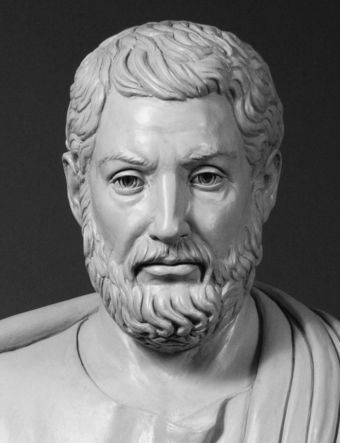
Bust of Cleisthenes
Modern bust of Cleisthenes, known as “the father of Athenian democracy,” on view at the Ohio Statehouse, Columbus, Ohio. Cleisthenes, the father of Greek democracy, reformed traditional Athenian government controlled by ruling tribes into the first government “of the people” (a demos, or democracy).
The isonomic and isegoric democracy was first organized into about 130 demes— political subdivisions created throughout Attica. Ten thousand citizens exercised their power via an assembly (the ekklesia, in Greek), of which they all were a part, that was headed by a council of 500 citizens chosen at random. The city’s administrative geography was reworked, the goal being to have mixed political groups—not federated by local interests linked to the sea, the city, or farming—whose decisions (declaration of war, etc.) would depend on their geographical situations. The territory of the city was subsequently divided into 30 trittyes. It was this corpus of reforms that would allow the emergence of a wider democracy in the 460s and 450s BCE.
7.2: Sparta
7.2.1: Sparta
Sparta, known for its militaristic culture and unequaled women’s rights, was a dominant military power in classical Greece.
Learning Objective
Distinguish key differences between Athens and Sparta
Key Points
- Sparta was a prominent city-state in ancient Greece, situated on the banks of the Eurotas River in Laconia in southeastern Peloponnese.
- Given its military preeminence, Sparta was recognized as the overall leader of the combined Greek forces during the Greco-Persian Wars, and defeated Athens during the Peloponnesian War.
- Sparta’s defeat by Thebes in the Battle of Leuctra in 371 BCE ended Sparta’s prominent role in Greece, but it maintained its political independence until the Roman conquest of Greece in 146 BCE.
- Sparta functioned under an oligarchy of two hereditary kings.
- Unique in ancient Greece for its social system and constitution, Spartan society focused heavily on military training and excellence.
- Spartan women enjoyed status, power, and respect that was unequaled in the rest of the classical world.
Key Terms
- Sparta
-
A prominent city-state in ancient Greece situated on the banks of the Eurotas River in Laconia. The dominant military power in ancient Greece.
- agoge
-
The rigorous education and training regimen mandated for all male Spartan citizens, except for the firstborn sons of the ruling houses Eurypontid and Agiad.
Sparta was a prominent city-state in ancient Greece situated on the banks of the Eurotas River in Laconia in southeastern Peloponnese. It emerged as a political entity around the 10th century BCE, when the invading Dorians subjugated the local, non-Dorian population. Around 650 BCE, it rose to become the dominant military power in ancient Greece. Given its military preeminence, Sparta was recognized as the overall leader of the combined Greek forces during the Greco-Persian Wars. Between 431 and 404 BCE, Sparta was the principal enemy of Athens during the Peloponnesian War, from which it emerged victorious, though at great cost. Sparta’s defeat by Thebes in the Battle of Leuctra in 371 BCE ended Sparta’s prominent role in Greece. However, it maintained its political independence until the Roman conquest of Greece in 146 BCE.
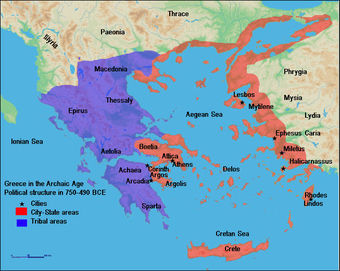
Political geography of ancient Greece
The map shows the political structure of Greece in the Archaic Age.
The Rise of Classical Sparta
The Spartans were already considered a land-fighting force to
be reckoned with when, in 480 BCE, a small force of Spartans, Thespians, and
Thebans made a legendary final stand at the Battle of Thermopylae against the
massive Persian army during the Greco-Persian Wars. The Greek forces suffered
very high casualties before finally being encircled and defeated. One year
later, Sparta led a Greek alliance against the Persians at the Battle of Plataea
where their superior weaponry, strategy, and bronze armor proved a huge asset
in achieving a resounding victory. This decisive victory put an end to the
Greco-Persian War, as well as Persian ambitions of spreading into Europe.
Despite being fought as part of a alliance, the victory was credited to Sparta,
which had been the de facto leader of the entire Greek expedition.
In the later
classical period, Sparta fought amongst Athens, Thebes, and Persia for
supremacy within the region. As a result of the Peloponnesian War, Sparta
developed formidable naval power, enabling it to subdue many key Greek states
and even overpower the elite Athenian navy. A period of Spartan Hegemony was
inaugurated at the end of the 5th century BCE, when Sparta defeated
the Athenian Empire and invaded Persian provinces in Anatolia.
Spartan Culture and Government
Sparta functioned under an oligarchy. The state was ruled by two hereditary kings of the Agiad and Eurypontid families, both supposedly descendants of Heracles, and equal in authority so that one could not act against the power and political enactments of his colleague. Unique in ancient Greece for its social system and constitution, Spartan society was completely focused on military training and excellence. Its inhabitants were classified as Spartiates (Spartan citizens who enjoyed full rights), Mothakes (non-Spartan, free men raised as Spartans), Perioikoi (freed men), and Helots (state-owned serfs, part of the enslaved, non-Spartan, local population).
Male Spartans began military training at age seven. The training was designed to encourage discipline and physical toughness, as well as emphasize the importance of the Spartan state. Boys lived in communal messes and, according to Xenophon, whose sons attended the agoge, the boys were fed “just the right amount for them never to become sluggish through being too full, while also giving them a taste of what it is not to have enough.” Besides physical and weapons training, boys studied reading, writing, music, and dancing. Special punishments were imposed if boys failed to answer questions sufficiently laconically (i.e., briefly and wittily).
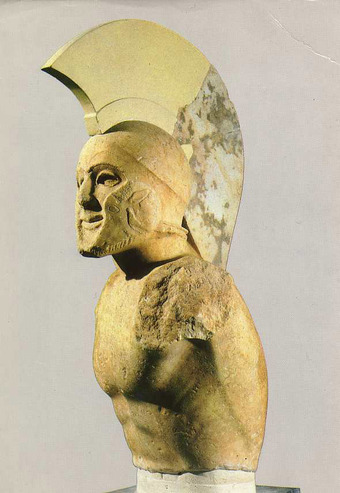
Spartan Hoplite
Marble statue of a helmed hoplite (5th century BCE), Archaeological Museum of Sparta, Greece.
At age 20, the Spartan citizen began his membership in one of the syssitia (dining messes or clubs), which were composed of about 15 members each, and were compulsory. Here each group learned how to bond and rely on one another. The Spartans were not eligible for election to public office until the age of 30. Only native Spartans were considered full citizens, and were obliged to undergo military training as prescribed by law, as well as participate in, and contribute financially to, one of the syssitia.
Spartan Women
Female Spartan citizens enjoyed status, power, and respect that was unequaled in the rest of the classical world. The higher status of females in Spartan society started at birth. Unlike in Athens, Spartan girls were fed the same food as their brothers. Nor were they confined to their father’s house or prevented from exercising or getting fresh air. Spartan women even competed in sports. Most important, rather than being married at the age of 12 or 13, Spartan law forbade the marriage of a girl until she was in her late teens or early 20s. The reasons for delaying marriage were to ensure the birth of healthy children, but the effect was to spare Spartan women the hazards and lasting health damage associated with pregnancy among adolescents.
Spartan women, better fed from childhood and fit from exercise, stood a far better chance of reaching old age than their sisters in other Greek cities, where the median life expectancy was 34.6 years, or roughly ten years below that of men. Unlike Athenian women, who wore heavy, concealing clothes and were rarely seen outside the house, Spartan women wore dresses (peplos) slit up the side to allow freer movement, and moved freely about the city, either walking or driving chariots.
7.2.2: Culture in Classical Sparta
Although
Spartan society was highly regimented, militarily and socially, enslaved classes
and women were afforded greater privileges relative to the populations of other
Greek city-states.
Learning Objective
Understand the key characteristics of Sparta’s society
Key Points
- Sparta was an oligarchic city-state, ruled by two
hereditary kings equal in authority. - Spartan society was largely structured around
the military, and around military training. - Inhabitants were classified as Spartiates
(Spartan citizens, who enjoyed full rights), Mothakes (non-Spartan, free men
raised as Spartans), Perioikoi (free, but non-citizen inhabitants), and Helots
(state-owned serfs, part of the enslaved non-Spartan, local population). - Spartiates began military training at the age of
seven. - At the age of 20, Spartiates were initiated
into full citizenship and joined a syssitia. - Helots were granted
many privileges, in comparison to enslaved populations in other Greek city-states. - The Helot population
outnumbered the Spartiate population, and grew over time, causing societal
tensions. - Female Spartans enjoyed status, power, and respect
that was unequaled in the rest of the classical world.
Key Terms
- ephors
-
Ephors
were ancient Spartan officials who shared power with the hereditary kings. Five
individuals were elected annually to swear on behalf of the city, whereas kings
served for a lifetime and swore only on their own behalf. - gerousia
-
The
gerousia were a council of Spartan elders comprised of men over the age of 60, who were elected for life, and usually were members of one of the two kings’
households. - Delphi
-
A famous
ancient sanctuary that served as the seat of an oracle, who consulted on
important decisions throughout the ancient classical world.
The Spartan Political System
Sparta functioned under an
oligarchy. The state was ruled by two hereditary kings of the Agiad and
Eurypontid families, both supposedly descendants of Heracles, and equal in
authority so that one could not act against the power and political enactments
of his colleague. The duties of the kings were religious, judicial, and
military in nature. They were the chief priests of the state, and maintained
contact with Delphi, the sanctuary that exercised great authority in Spartan
politics.
By 450 BCE, the kings’ judicial
authority was restricted to cases dealing with heiresses, adoptions, and public
roads. Over time, royal prerogatives were curtailed further until, aside
from their service as military generals, the kings became mere figureheads. For
example, from the time of the Greco-Persian Wars, the kings lost the right to
declare war and were shadowed in the field by two officials, known as ephors. The ephors also
supplanted the kings’ leadership in the realm of foreign policy. Civil and
criminal cases were also decided by ephors, as well as a council of 28 elders
over the age of 60, called the gerousia.
The gerousia were elected for life, and usually were members of one of the two kings’ households. The gerousia discussed high state policy
decisions, then proposed action alternatives to the damos—a collective body of Spartan citizenry, who would then
select one of the options by voting.
Spartan Citizenship
Unique in ancient Greece for its
social system, Spartan society was completely focused on military training and
excellence. Its inhabitants were classified as Spartiates (Spartan citizens,
who enjoyed full rights), Mothakes (non-Spartan, free men raised as Spartans),
Perioikoi (free, but non-citizen inhabitants), and Helots (state-owned serfs, part of the
enslaved, non-Spartan, local population).
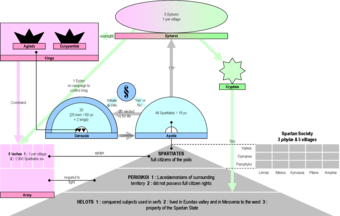
Structure of Spartan society
Spartan society was highly regimented, with a clearly delineated class system.
Male Spartans began military
training at age seven. The training was designed to encourage discipline and physical
toughness, as well as emphasize the importance of the Spartan state. Typically
only men who were to become Spartiates underwent military training, although
two exceptions existed to this rule. Trophimoi,
or “foster sons,” from other Greek city-states were allowed to attend training
as foreign students. For example, the Athenian general Xenophon sent his two
sons to Sparta as trophimoi.
Additionally, sons of a Helot could enroll as a syntrophos if a Spartiate formally adopted him and paid his way. If
a syntrophos did exceptionally well
in training, he could be sponsored to become a Spartiate. Likewise, if a Spartan
could not afford to pay the expenses associated with military training, they
potentially could lose their right to citizenship.
Boys who underwent training lived
in communal messes and, according to Xenophon, whose sons attended the agoge, the boys were
fed “just the right amount for them never to become sluggish through being
too full, while also giving them a taste of what it is not to have
enough.” Besides physical and weapons training, boys studied reading,
writing, music, and dancing. Special punishments were imposed if boys failed to
answer questions sufficiently laconically (i.e., briefly and wittily).
At age 20, the Spartan citizen began his membership in one of the syssitia (dining messes or clubs), which were
composed of about 15 members each, and were compulsory. Here each group learned
how to bond and rely on one another. The Spartans were not eligible for
election to public office until the age of 30. Only native Spartans were
considered full citizens, and were obliged to undergo military training as
prescribed by law, as well as participate in, and contribute financially to, one
of the syssitia.
Helots
Spartiates
were actually a minority within Sparta, and Helots made up the largest class of
inhabitants of the city-state. Helots were originally free Greeks that the
Spartans had defeated in battle, and subsequently enslaved. In contrast to
populations conquered by other Greek cities, the male Helot population was not
exterminated, and women and children were not treated as chattel. Instead,
Helots were given a subordinate position within Spartan society more comparable
to the serfs of medieval Europe. Although Helots did not have voting rights,
they otherwise enjoyed a relatively privileged position, in comparison to slave
populations in other Greek city-states.
The
Spartan poet, Tyrtaios, gives account that Helots were permitted to marry and retain
half the fruits of their labor. They were also allowed religious freedoms and
could own a limited amount of personal property. Up to 6,000 Helots even
accumulated enough wealth to buy their own freedom in 227 BCE.
Since
Spartiates were full-time soldiers, manual labor fell to the Helot population
who worked as unskilled serfs, tilling the Spartan land or accompanying the
Spartan army as non-combatants. Helot women were often used as wet nurses.
Relations between Helots and their Spartan masters were often strained, and
there is evidence that at least one Helot revolt occurred circa 465-460 BCE.
Many historians argue that because the Helots were permitted such privileges as
the maintenance of family and kinship groups and ownership of property, they
were better able to retain their identity as a conquered people and thus were
more effective at organizing rebellions. Over time, the Spartiate population
continued to decline and the Helot population grew, and the imbalance in power
exasperated tensions that already existed.
Spartan Women
Female Spartans enjoyed status, power, and respect that
was unequaled in the rest of the classical world. The higher status of females
in Spartan society started at birth. Unlike in Athens, Spartan girls were fed
the same food as their brothers. Nor were they confined to their father’s house
or prevented from exercising or getting fresh air. Spartan women even competed
in sports. Most important, rather than being married at the age of 12 or
13, Spartan law forbade the marriage of a girl until she was in her late teens
or early 20s. The reasons for delaying marriage were to ensure the birth of
healthy children, but the effect was to spare Spartan women the hazards and
lasting health damage associated with pregnancy among adolescents.
Spartan women, better fed from childhood and fit from
exercise, stood a far better chance of reaching old age than their sisters in
other Greek cities where the median life expectancy was 34.6 years, or roughly ten years below that of men. Unlike Athenian women who wore heavy, concealing
clothes and were rarely seen outside the house, Spartan women wore dresses (peplos)
slit up the side to allow freer movement, and moved freely about the city,
either walking or driving chariots.
7.3: The Persian Wars
7.3.1: The Persian Wars
The Persian Wars led to the rise of Athens as the head of the Delian League.
Learning Objective
Explain the consequences of the Persian Wars.
Key Points
- The Persian Wars began in 499 BCE, when Greeks in the Persian-controlled territory rose in the Ionian Revolt.
- Athens, and other Greek cities, sent aid, but were quickly forced to back down after defeat in 494 BCE.
- Subsequently, the Persians suffered many defeats at the hands of the Greeks, led by the Athenians.
- Silver mining contributed to the funding of a massive Greek army that was able to rebuke Persian assaults and eventually defeat the Persians entirely.
- The end of the Persian Wars led to the rise of Athens as the leader of the Delian League.
Key Terms
- Persian Wars
-
A series of conflicts, from 499-449 BCE, between the Achaemenid Empire of Persia and city-states of the Hellenic world.
- hoplites
-
A citizen-soldier of one of the ancient Greek city-states, armed primarily with spears and a shield.
The Persian Wars (499-449 BCE) were fought between the Achaemenid Empire and the Hellenic world during the Greek classical period. The conflict saw the rise of Athens, and led to its Golden Age.
Origins of the Conflict
Greeks
of the classical period believed, and historians generally agree, that in the
aftermath of the fall of Mycenaean civilization, many Greek tribes emigrated
and settled in Asia Minor. These settlers were from three tribal groups: the
Aeolians, Dorians, and Ionians. The Ionians settled along the coasts of Lydia
and Caria, and founded 12 towns that remained politically separate from one
another, although they did recognize a shared cultural heritage. This formed
the basis for an exclusive Ionian “cultural league.” The Lydians of western
Asia Minor conquered the cities of Ionia, which put the region at conflict with
the Median Empire, the precursor to the Achaemenid Empire of the Persian Wars, and a power that the Lydians opposed.
In
553 through 550 BCE, the Persian prince Cyrus led a successful revolt against
the last Median king Astyages, and founded the Achaemenid Empire. Seeing an
opportunity in the upheaval, the famous Lydian king Croesus asked the oracle at
Delphi whether he should attack the Persians in order to extend his realm.
According to Herodotus, he received the ambiguous answer that “if Croesus was
to cross the Halys [River] he would destroy a great empire.” Croesus chose to
attack, and in the process he destroyed his own empire, with Lydia falling to
Prince Cyrus. The Ionians sought to maintain autonomy under the Persians as
they had under the Lydians, and resisted the Persians militarily for some time. However, due to their unwillingness to rise against the Lydians during previous
conflicts, they were not granted special terms. Finding the Ionians difficult
to rule, the Persians installed tyrants in every city, as a means of control.
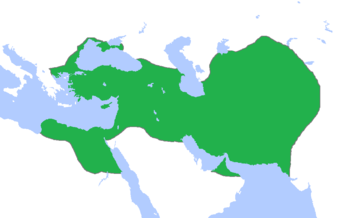
Achaemenid Empire Map
The Achaemenid Empire at its greatest extent.
The Ionian Revolt
In 499 BCE, Greeks in the region rose up against Persian rule in the Ionian Revolt.
At the heart of the rebellion lay a deep dissatisfaction
with the tyrants who were appointed by the Persians to rule the local Greek
communities. Specifically, the riot was incited by the Milesian tyrant
Aristagoras, who in the wake of a failed expedition to conquer Naxos, utilized
Greek unrest against Persian king Darius the Great to his own political
purposes.
Athens and other Greek cities sent aid, but were quickly forced to back down after defeat in 494 BCE, at the Battle of Lade. As a result, Asia Minor returned to Persian control.
Nonetheless, the Ionian Revolt remains
significant as the first major conflict between Greece and the Persian Empire, as well as the first phase of the Persian Wars. Darius vowed to exact revenge
against Athens, and developed a plan to conquer all Greeks in an attempt to
secure the stability of his empire.
First Persian Invasion of Greece
In 492 BCE, the Persian general, Mardonius, led a campaign through Thrace and Macedonia.
During this campaign, Mardonius re-subjugated Thrace and forced Macedonia
to become a fully submissive client of the Persian Empire, whereas before they
had maintained a broad degree of autonomy.
While victorious, he was wounded and forced to retreat back into Asia Minor. Additionally, he lost his 1200-ship naval fleet to a storm off the coast of Mount Athos.
Darius sent ambassadors to all Greek cities to demand full submission in
light of the recent Persian victory, and all cities submitted, with the
exceptions of Athens and Sparta, both of which executed their respective
ambassadors. These actions signaled Athens’ continued defiance and brought
Sparta into the conflict.
In 490 BCE, approximately 100,000 Persians landed in Attica intending to conquer Athens, but were defeated at the Battle of Marathon by a Greek army of 9,000 Athenian hoplites and 1,000 Plateans, led by the Athenian general, Miltiades. The Persian fleet continued to sail to Athens but, seeing it garrisoned, decided not to attempt an assault.
The Battle of Marathon was a watershed moment in the Persian Wars, in
that it demonstrated to the Greeks that the Persians could be defeated. It also
demonstrated the superiority of the more heavily armed Greek hoplites.
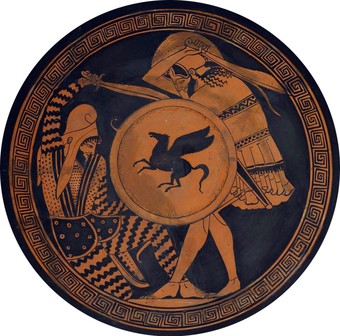
Greek-Persian duel
Depiction of a Greek hoplite and a Persian warrior fighting each other on an ancient kylix.
Interbellum (490-480 BCE)
After the failure of the first Persian invasion, Darius
raised a large army with the intent of invading Greece again. However, in 486
BCE, Darius’s Egyptian subjects revolted, postponing any advancement against
Greece. During preparations to march on Egypt, Darius died and his son, Xerxes
I, inherited the throne. Xerxes quickly crushed the Egyptians and resumed
preparations to invade Greece.
Second Invasion of
Greece
In 480 BCE, Xerxes sent a much more powerful force of 300,000 soldiers by land, with 1,207 ships in support, across a double pontoon bridge over the Hellespont. This army took Thrace before descending on Thessaly and Boetia, whilst the Persian navy skirted the coast and resupplied the ground troops. The Greek fleet, meanwhile, dashed to block Cape Artemision. After being delayed by Leonidas I, the Spartan king of the Agiad Dynasty, at the Battle of Thermopylae (a battle made famous due to the sheer imbalance of forces, with 300 Spartans facing the entire Persian Army), Xerxes advanced into Attica, where he captured and burned Athens. But the Athenians had evacuated the city by sea, and under the command of Themistocles, defeated the Persian fleet at the Battle of Salamis.
In 483 BCE, during the period of peace between the two Persian invasions, a vein of silver ore had been discovered in the Laurion (a small mountain range near Athens), and the ore that was mined there paid for the construction of 200 warships to combat Aeginetan piracy. A year later, the Greeks, under the Spartan Pausanias, defeated the Persian army at Plataea. Meanwhile, the allied Greek navy won a decisive victory at the Battle of
Mycale, destroying the Persian fleet, crippling Xerxe’s sea power, and marking
the ascendency of the Greek fleet. Following the Battle of Plataea and the Battle of Mycale, the Persians began withdrawing from Greece and never attempted an invasion again.
Greek Counterattack
The
Battle
of Mycale was in many ways a turning point, after which the Greeks went on the
offensive against the Persian fleet. The Athenian fleet turned to chasing the Persians from the Aegean Sea, and in 478 BCE, the fleet then proceeded to capture Byzantium. In the course of doing so, Athens enrolled all the island states, and some mainland states, into an alliance called the Delian League—
so named because its treasury was kept on the sacred island of Delos,
whose
purpose was to continue fighting the Persian Empire, prepare for future
invasions, and organize a means of dividing the spoils of war. The Spartans, although they had taken part in the war, withdrew into isolation afterwards.
The
Spartans believed that the war’s purpose had already been reached through the
liberation of mainland Greece and the Greek cities of Asia Minor. Historians
also speculate that Sparta was unconvinced of the ability of the Delian League
to secure long-term security for Asian Greeks. The Spartan withdrawal from the
League allowed Athens to establish unchallenged naval and commercial power within the Hellenic world.
7.3.2: Effects of the Persian Wars
Despite their victories in the Persian Wars, the Greek
city-states emerged from the conflict more divided than united.
Learning Objective
Understand the effect the Persian Wars had on the balance of power throughout the classical world
Key Points
- After the second Persian invasion of Greece was
halted, Sparta withdrew from the Delian League and reformed the Peloponnesian
League with its original allies. - Many Greek city-states had been alienated from
Sparta following the violent actions of Spartan leader Pausanias during the
siege of Byzantium. - Following Sparta’s departure from the Delian
League, Athens was able to use the resources of the League to its own ends,
which led it into conflict with less powerful members of the League. - The Persian Empire adopted a divide-and-rule
strategy in relation to the Greek city-states in the wake of the Persian Wars,
stoking already simmering conflicts, including the rivalry between Athens and
Sparta, to protect the Persian Empire against further Greek attacks.
Key Terms
- Peloponnesian League
-
An alliance formed around Sparta in the Peloponnesus, from the 6th to 4th centuries BCE.
- Delian League
-
An association
of Greek city-states under the leadership of Athens, the purpose of which was to continue
fighting the Persian Empire after the Greek victories at the end of the Second
Persian invasion of Greece. - hegemony
-
The
political, economic, or military predominance or control of one state over
others.
Aftermath of the Persian Wars
As a result of the allied Greek success, a large contingent
of the Persian fleet was destroyed and all Persian garrisons were expelled from
Europe, marking an end of Persia’s advance westward into the continent. The
cities of Ionia were also liberated from Persian control. Despite their
successes, however, the spoils of war caused greater inner conflict within the
Hellenic world. The violent actions of Spartan leader Pausanias at the siege of
Byzantium, for instance, alienated many of the Greek states from Sparta, and led
to a shift in the military command of the Delian League from Sparta to Athens. This set the stage for Sparta’s eventual withdrawal from the Delian League.
Two Leagues
Following the two Persian invasions of Greece, and during
the Greek counterattacks that commenced after the Battles of Plataea and
Mycale, Athens enrolled all island and some mainland city-states into an
alliance, called the Delian League, the purpose of which was to pursue conflict
with the Persian Empire, prepare for future invasions, and organize a means of
dividing the spoils of war. The Spartans, although they had taken part in the
war, withdrew from the Delian League early on, believing that the war’s initial
purpose had been met with the liberation of mainland Greece and the Greek
cities of Asia Minor. Historians also speculate that Sparta decided to leave the
League for pragmatic reasons, remaining unconvinced that it was possible to
secure long-term security for Greeks residing in Asia Minor, and as a result of
their unease with Athenian efforts to increase their power. Once Sparta
withdrew from the Delian League after the Persian Wars, it reformed the
Peloponnesian League, which had originally been formed in the 6th
century and provided the blueprint for what was now the Delian League. The
Spartan withdrawal from the League had the effect, however, of allowing Athens
to establish unchallenged naval and commercial power, unrivaled throughout the
Hellenic world. In fact, shortly after the League’s inception, Athens began to
use the League’s navy for its own purposes, which frequently led it into
conflict with other, less powerful League members.
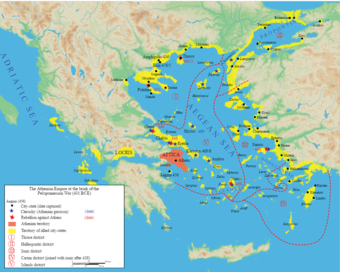
Map of the Athenian Empire c. 431 BCE
The Delian League was the basis for the Athenian Empire, shown here on the brink of the Peloponnesian War (c. 431 BCE).
Delian League Rebellions
A series of rebellions occurred between Athens and the
smaller city-states that were members of the League. For example, Naxos was the
first member of the League to attempt to secede, in approximately 471 BCE. It
was later defeated and forced to tear down its defensive city walls, surrender
its fleet, and lost voting privileges in the League. Thasos, another League
member, also defected when, in 465 BCE, Athens founded the colony of Amphipolis
on the Strymon River, which threatened Thasos’ interests in the mines of Mt
Pangaion. Thasos allied with Persia and petitioned Sparta for assistance, but
Sparta was unable to help because it was facing the largest helot revolution in
its history. Nonetheless, relations between Athens and Sparta were soured by
the situation. After a three-year long siege, Thasos was recaptured and forced
back into the Delian League, though it also lost its defensive walls and fleet,
its mines were turned over to Athens, and the city-state was forced to pay
yearly tribute and fines. According to Thucydides, the siege of Thasos marked
the transformation of the League from an alliance into a hegemony.
Persia
Following their defeats at the hands of the
Greeks, and plagued by internal rebellions that hindered their ability to fight
foreign enemies, the Persians adopted a policy of divide-and-rule. Beginning in
449 BCE, the Persians attempted to aggravate the growing tensions between Athens
and Sparta, and would even bribe politicians to achieve these aims. Their
strategy was to keep the Greeks distracted with in-fighting, so as to stop the
tide of counterattacks reaching the Persian Empire. Their strategy was largely
successful, and there was no open conflict between the Greeks and Persia until
396 BCE, when the Spartan king Agesilaus briefly invaded Asia Minor.
7.4: Athens
7.4.1: Athens
Athens attained its Golden Age under Pericles in the 5th century BCE, and flourished culturally as the hegemonic power of the Hellenic world.
Learning Objective
Understand the factors contributing to the rise and fall of Athens
Key Points
- Cleisthenes overthrew the dictator Hippias in 511/510 BCE in order to establish democracy at Athens.
- Athens entered its Golden Age in the 5th century BCE, when it abandoned the pretense of parity and relocated the treasury of the Delian League from Delos to Athens. This money funded the building of the Athenian Acropolis, put half the Athenian population on the public payroll, and allowed Athens to build and maintain the dominant naval power in the Greek world.
- With the empire’s funds, military dominance, and its political fortunes as guided by statesman and orator Pericles, Athens produced some of the most influential and enduring cultural artifacts of the Western tradition.
- Tensions within the Delian League brought about the Peloponnesian War (431-404 BCE), during which Athens was defeated by its rival, Sparta. Athens lost further power when the armies of Philip II defeated an alliance of Greek city-states.
Key Terms
- Acropolis
-
A settlement, especially a citadel, built upon an area of elevated ground, frequently a hill with precipitous sides, chosen for purposes of defense. Often the nuclei of large cities of classical antiquity.
- Pericles
-
A prominent and influential Greek statesman, orator, and general of Athens during its Golden Age, in the time between the Persian and Peloponnesian wars.
- Delian League
-
Founded in 478 BCE, an association of Greek city-states under the leadership of Athens, whose purpose was to fight the Persian Empire during the Greco-Persian Wars.
The Rise of Athens (508-448 BCE)
In 514 BCE, the dictator Hippias established stability and prosperity with his rule of Athens, but remained very unpopular as a ruler. With the help of an army from Sparta in 511/510 BCE, he was overthrown by Cleisthenes, a radical politician of aristocratic background who established democracy in Athens.
Prior to the rise of Athens, Sparta, a city-state with a militaristic culture, considered itself the leader of the Greeks, and enforced an hegemony. In 499 BCE, Athens sent troops to aid the Ionian Greeks of Asia Minor, who were rebelling against the Persian Empire during the Ionian Revolt. This provoked two Persian invasions of Greece, both of which were repelled under the leadership of the soldier-statesmen Miltiades and Themistocles, during the Persian Wars. In the decades that followed, the Athenians, with the help of the Spartans and other allied Greek city-states, managed to rout the Persians. These victories enabled Athens to bring most of the Aegean, and many other parts of Greece, together in the Delian League, creating an Athenian-dominated alliance from which Sparta and its allies withdrew.
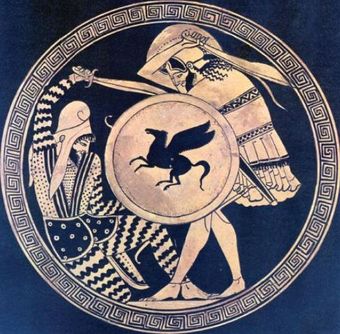
Greek-Persian Duel
Athenian Hegemony and the Age of Pericles
The 5th century BCE was a period of Athenian political hegemony, economic growth, and cultural flourishing that is sometimes referred to as the Golden Age of Athens. The latter part of this time period is often called The Age of Pericles. After peace was made with Persia in the 5th century BCE, what started as an alliance of independent city-states became an Athenian empire. Athens moved to abandon the pretense of parity among its allies, and relocated the Delian League treasury from Delos to Athens, where it funded the building of the Athenian Acropolis, put half its population on the public payroll, and maintained the dominant naval power in the Greek world. With the empire’s funds, military dominance, and its political fortunes as guided by statesman and orator Pericles, Athens produced some of the most influential and enduring cultural artifacts of Western tradition, during what became known as the Golden Age of Athenian democracy, or the Age of Pericles. The playwrights Aeschylus, Sophocles, and Euripides all lived and worked in Athens during this time, as did historians Herodotus and Thucydides, the physician Hippocrates, and the philosopher Socrates.
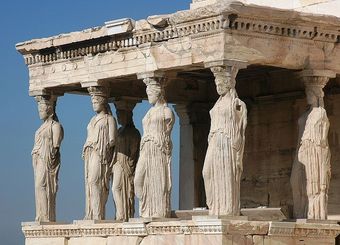
Caryatid Statues
The caryatid statues of the Erechtheion on the Acropolis.
Pericles was
arguably the most prominent and influential Greek statesman, orator, and
general of Athens during its Golden Age.
One of his most popular reforms while in power was to allow thetes (Athenians without wealth) to occupy public office. Another success of his administration was the creation of the misthophoria, a special salary for the citizens that attended the courts as jurors. As Athens’ ruler, he helped the city to prosper with a resplendent culture and democratic institutions.
5th century Athenian
Political Institutions
The administration of
the Athenian state was managed by a group of people referred to as magistrates, who were submitted to rigorous public control and chosen by lot. Only two
magistrates were directly elected by the Popular Assembly: strategos (or generals), and magistrates of finance. All magistrates
served for a year or less, with the exception of Pericles, who was elected year
after year to public office. At the end of their service, magistrates were required
to give an account of their administration and use of public finances.
The most elite posts in
the Athenian political system belonged to archons. In ages past, they served as
heads of the Athenian state, but in the Age of Pericles they lost much of their
influence and power, though they still presided over tribunals. The Assembly of
the People was the first organ of democracy in Athens. In theory, it was
composed of all the citizens of Athens. However, it is estimated that the
maximum number of participants it witnessed was 6,000. The Assembly met in
front of the Acropolis and decided on laws and decrees. Once the Assembly gave
its decision in a certain matter, the issue was raised to the Council, or Boule, to provide definitive approval.
The Council consisted of
500 members, 50 from each tribe, and functioned as an extension of the
Assembly. Council members were chosen by lot in a similar manner to magistrates
and supervised the work of the magistrates in addition to other legal projects
and administrative details. They also oversaw the city-state’s external
affairs.
Athenian Defeat and Conquest By Macedon
Originally intended as an association of Greek city-states to continue the fight against the Persians, the Delian League soon turned into a vehicle for Athens’s own imperial ambitions and empire-building. The resulting tensions brought about the Peloponnesian War (431-404 BCE), in which Athens was defeated by its rival, Sparta. By the mid-4th century BCE, the northern Greek kingdom of Macedon was becoming dominant in Athenian affairs. In 338 BCE, the armies of Philip II of Macedon defeated an alliance of some of the Greek city-states, including Athens and Thebes, at the Battle of Chaeronea, effectively ending Athenian independence.
7.4.2: Athenian Society
Classical Athenian society was structured as a democratic
patriarchy that strived towards egalitarian ideals.
Learning Objective
Understand the structures of Athenian society in the classical period
Key Points
- The citizens of Athens decided matters of state
in the Assembly of the People, the principle organ of Athen’s democracy. - The Athenian democracy provided a number of
governmental resources to its population in order to encourage participation in the
democratic process. - Many governmental posts in classical Athens were
chosen by lot, in an attempt to discourage corruption and patronage. - The Athenian elite lived relatively modestly, and
wealth and land were not concentrated in the hands of the few, but rather
distributed fairly evenly across the upper classes. - Thetes occupied the lowest rung of Athenian
society, but were granted the right to hold public office during the reforms of
Ephialtes and Pericles. - Athenian society was a patriarchy; men held
all rights and advantages, such as access to education and power. - Athenian women were dedicated to the care and
upkeep of the family home.
Key Terms
- thetes
-
The
lowest social class of citizens in ancient Athens. - Assembly of the People
-
The
democratic congregation of classical Athens, which, in theory, brought together
all citizens to decide upon proposed laws and decrees.
Structure of the Athenian Government
In the Assembly of the People, Athenian citizens decided
matters of state. In theory, it was composed of all the citizens of Athens; however, it is estimated that the maximum number of participants it included
was 6,000. Since many citizens were incapable of exercising political rights, due to their poverty or ignorance, a number of governmental resources existed
to encourage inclusivity. For example, the Athenian democracy provided the
following to its population:
- Concession of salaries to public functionaries
-
Help finding work for the poor
-
Land grants for dispossessed villagers
-
Public assistance for war widows, invalids,
orphans, and indigents
In order to discourage corruption and patronage, most public
offices that did not require specialized expertise were appointed by lot rather
than by election. Offices were also rotated so that members could serve in all
capacities in turn, in order to ensure that political functions were instituted
as smoothly as possible regardless of each individual official’s capacity.
When the Assembly of the People reached decisions on laws and
decrees, the issue was raised to a body called the Council, or Boule, to provide definitive approval.
The Council consisted of 500 members, 50 from each tribe, and functioned as an
extension of the Assembly. Council members, who were chosen by lot, supervised
the work of other government officials, legal projects, and other
administrative details. They also oversaw the city-state’s external affairs.
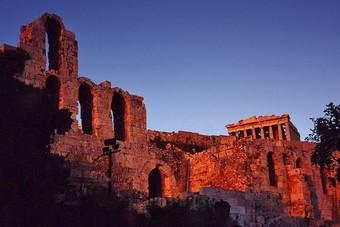
The Acropolis
View of the Acropolis in Athens, Greece.
Athenians in the Age of Pericles
The Athenian elite lived modestly and without great luxuries
compared to the elites of other ancient societies. Wealth and land ownership
was not typically concentrated in the hands of a few people. In fact, 71-73% of
the citizen population owned 60-65% of the land. By contrast, thetes occupied the lowest social class
of citizens in Athens. Thetes worked
for wages or had less than 200 medimnoi
as yearly income. Many held crucial roles in the Athenian navy as rowers, due to
the preference of many ancient navies to rely on free men to row their galleys.
During the reforms of Ephialtes and Pericles around 460-450 BCE, thetes were granted the right to hold
public office.
Boys were educated at home until the age of seven, at which
time they began formal schooling. Subjects included reading, writing,
mathematics, and music, as well as physical education classes that were intended
to prepare students for future military service. At the age of 18, service in
the army was compulsory.
Athenian women were dedicated to the care and
upkeep of the family home. Athenian society was a patriarchy; men held all
rights and advantages, such as access to education and power. Nonetheless, some
women, known as hetaeras, did receive
an education with the specific purpose of entertaining men, similar to the
Japanese geisha tradition. Hetaeras were considered higher in status than other women, but lower in status than
men. One famous example of a hetaera is Pericles’ mistress, Aspasia of Miletus,
who is said to have debated with prominent writers and thinkers, including
Socrates.
7.5: Culture in Classical Greece
7.5.1: Classical Greek Philosophy
The three most famous Classical Greek philosophers are Socrates, Plato, and Aristotle.
Learning Objective
Understand the main philosophical beliefs of Socrates, Plato, and Aristotle
Key Points
- Socrates is best known for having pursued a probing question-and-answer style of examination on a number of topics, usually attempting to arrive at a defensible and attractive definition of a virtue.
- In 399 BCE, Socrates was charged for his philosophical inquiries, convicted, and sentenced to death.
- Plato was a student of Socrates, and is the author of numerous dialogues and letters, as well as one of the primary sources available to modern scholars on Socrates’ life.
- In his defining work, The Republic, Plato reaches the conclusion that a utopian city is likely impossible because philosophers would refuse to rule and the people would refuse to compel them to do so.
- Aristotle was a student of Plato, the tutor of Alexander the Great, and founder of the Lyceum and Peripatetic School of philosophy in Athens. He wrote on a number of subjects, including logic, physics, metaphysics, ethics, rhetoric, politics, and botany.
Key Terms
- allegory of the cave
-
A paradoxical analogy wherein Socrates argues that the invisible world is the most intelligible, and the visible world is the least knowable and obscure. Plato has Socrates describe a gathering of people who have lived chained to the wall of a cave all of their lives, facing a blank wall upon which shadows are projected. The shadows are as close as the prisoners get to viewing reality.
- Aristotle
-
The student of Plato, tutor to Alexander the Great, and founder of the Lyceum. A Greek philosopher who wrote on a number of topics, including logic, ethics, and metaphysics.
- aporia
-
In philosophy, a paradox or state of puzzlement; in rhetoric, a useful expression of doubt.
- Socrates
-
A classical Greek (Athenian) philosopher credited as one of the founders of Western philosophy. Known for a question-answer style of examination.
- Plato
-
The student of Socrates and author of The Republic. A philosopher and mathematician in classical Greece.
Classical Greece saw a flourishing of philosophers, especially in Athens during its Golden Age. Of these philosophers, the most famous are Socrates, Plato, and Aristotle.
Socrates
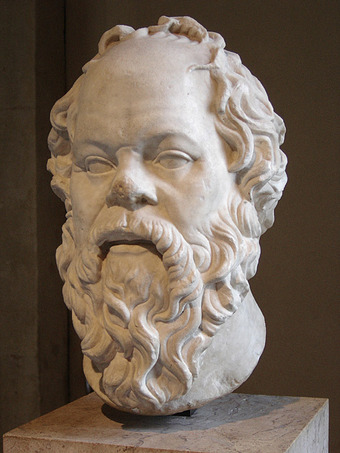
Socrates
Bust of Socrates, currently in the Louvre.
Socrates, born in Athens in the 5th century BCE, marks a watershed in ancient Greek philosophy. Athens was a center of learning, with sophists and philosophers traveling from across Greece to teach rhetoric, astronomy, cosmology, geometry, and the like. The great statesman Pericles was closely associated with these new teachings, however, and his political opponents struck at him by taking advantage of a conservative reaction against the philosophers. It became a crime to investigate issues above the heavens or below the earth because they were considered impious. While other philosophers, such as Anaxagoras, were forced to flee Athens, Socrates was the only documented individual charged under this law, convicted, and sentenced to death in 399 BCE. In the version of his defense speech presented by Plato, he claims that the envy others experience on account of his being a philosopher is what will lead to his conviction.
Many conversations involving Socrates (as recounted by Plato and Xenophon) end without having reached a firm conclusion, a style known as aporia. Socrates is said to have pursued this probing question-and-answer style of examination on a number of topics, usually attempting to arrive at a defensible and attractive definition of a virtue. While Socrates’ recorded conversations rarely provide a definitive answer to the question under examination, several maxims or paradoxes for which he has become known recur. Socrates taught that no one desires what is bad, and so if anyone does something that truly is bad, it must be unwillingly or out of ignorance; consequently, all virtue is knowledge. He frequently remarks on his own ignorance (claiming that he does not know what courage is, for example). Plato presents Socrates as distinguishing himself from the common run of mankind by the fact that, while they know nothing noble and good, they do not know that they do not know, whereas Socrates knows and acknowledges that he knows nothing noble and good.
Socrates was morally, intellectually, and politically at odds with many of his fellow Athenians. When he was on trial, he used his method of elenchos, a dialectic method of inquiry that resembles
the scientific method, to demonstrate to the jurors that their moral values are wrong-headed. He tells them they are concerned with their families, careers, and political responsibilities when they ought to be worried about the “welfare of their souls.” Socrates’ assertion that the gods had singled him out as a divine emissary seemed to provoke irritation, if not outright ridicule. Socrates also questioned the Sophistic doctrine that arete (virtue) can be taught. He liked to observe that successful fathers (such as the prominent military general Pericles) did not produce sons of their own quality. Socrates argued that moral excellence was more a matter of divine bequest than parental nurture.
Plato
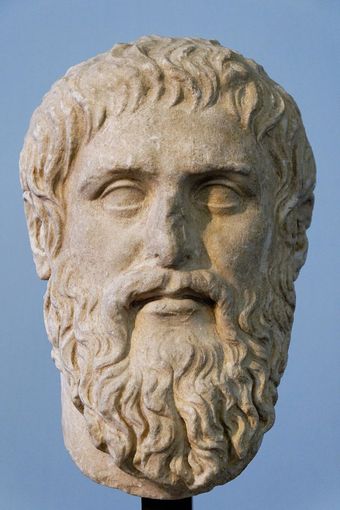
Plato
A copy of Plato’s portrait bust by Silanion.
Plato was an Athenian of the generation after Socrates. Ancient tradition ascribes 36 dialogues and 13 letters to him, although of these only 24 of the dialogues are now universally recognized as authentic. Most modern scholars believe that at least 28 dialogues, and two of the letters, were in fact written by Plato, although all of the 36 dialogues have some defenders. Plato’s dialogues feature Socrates, although not always as the leader of the conversation. Along with Xenophon, Plato is the primary source of information about Socrates’ life and beliefs, and it is not always easy to distinguish between the two.
Much of what is known about Plato’s doctrines is derived from what Aristotle reports about them, and many of Plato’s political doctrines are derived from Aristotle’s works, The Republic, the Laws, and the Statesman. The Republic contains the suggestion that there will not be justice in cities unless they are ruled by philosopher kings; those responsible for enforcing the laws are compelled to hold their women, children, and property in common; and the individual is taught to pursue the common good through noble lies. The Republic determines that such a city is likely impossible, however, and generally assumes that philosophers would refuse to rule if the citizenry asked them to, and moreover, the citizenry would refuse to compel philosophers to rule in the first place.
“Platonism” is a term coined by scholars to refer to the intellectual consequences of denying, as Plato’s Socrates often does, the reality of the material world. In several dialogues, most notably The Republic, Socrates inverts the common man’s intuition about what is knowable and what is real. While most people take the objects of their senses to be real if anything is, Socrates is contemptuous of people who think that something has to be graspable in the hands to be real. Socrates’s idea that reality is unavailable to those who use their senses is what puts him at odds with the common man and with common sense. Socrates says that he who sees with his eyes is blind, and this idea is most famously captured in his allegory of the cave, a paradoxical analogy wherein Socrates argues that the invisible world is the most intelligible and that the visible world is the least knowable and most obscure.
In the allegory,
Socrates describes a gathering of people who have lived chained to the wall of
a cave facing a blank wall. The people watch shadows projected on the wall from
the fire burning behind them, and the people begin to name and describe the
shadows, which are the closest images they have to reality. Socrates then
explains that a philosopher is like a prisoner released from that cave who
comes to understand the shadows on the wall are not reality.
Aristotle
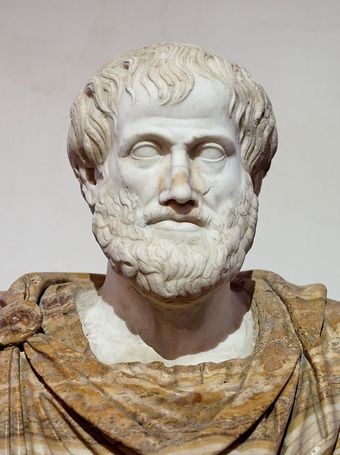
Aristotle
Roman copy in marble of a Greek bronze bust of Aristotle by Lysippus, c. 330 BCE. The alabaster mantle is modern.
Aristotle moved to Athens from his native Stageira in 367 BCE, and began to study philosophy, and perhaps even rhetoric, under Isocrates. He eventually enrolled at Plato’s Academy. He left Athens approximately twenty years later to study botany and zoology, became a tutor of Alexander the Great, and ultimately returned to Athens a decade later to establish his own school, the Lyceum.
He is the founder of the Peripatetic School of philosophy, which aims to
glean facts from experiences and explore the “why” in all things. In other
words, he advocates learning by induction.
At least 29 of Aristotle’s treatises have survived, known as the corpus Aristotelicum, and address a variety of subjects including logic, physics, optics, metaphysics, ethics, rhetoric, politics, poetry, botany, and zoology. Aristotle is often portrayed as disagreeing with his teacher, Plato. He criticizes the regimes described in Plato’s Republic and Laws, and refers to the theory of forms as “empty words and poetic metaphors.” He preferred utilizing empirical observation and practical concerns in his works.
Aristotle did not consider virtue to be simple knowledge as Plato did,
but founded in one’s nature, habit, and reason. Virtue was gained by acting in
accordance with nature and moderation.
7.5.2: Classical Greek Poetry and History
Homer, one of the greatest Greek poets, significantly influenced
classical Greek historians as their field turned increasingly towards scientific
evidence-gathering and analysis of cause and effect.
Learning Objective
Explain how epic poetry influenced the development of classical Greek historical texts
Key Points
- The formative influence of the Homeric epics in shaping Greek culture was widely recognized, and Homer was described as the teacher of Greece.
- The Iliad, sometimes referred to as the Song of Ilion or Song of Ilium, is set during the Trojan War and recounts the battles and events surrounding a quarrel between King Agamemnon and the warrior Achilles.
-
Herodotus is referred to as “The Father of History,” and is
the first historian known to have broken from Homeric tradition in order to
treat historical subjects as a method of investigation arranged into a
historiographic narrative. - Thucydides, who had been trained in rhetoric, provided a
model of historical prose-writing based more firmly in factual progression of a
narrative, whereas Herodotus, due to frequent digressions and asides, appeared
to minimize his authorial control. - Thucydides is sometimes known as the father of “scientific
history,” or an early precursor to 20th century scientific
positivism, because of his strict adherence to evidence-gathering and analysis
of historical cause and effect without reference to divine intervention. - Despite its heavy
political slant, scholars cite strong literary and philosophical influences in
Thucydides’ work.
Key Terms
- Homer
-
A Greek poet of the 7th or 8th century BCE; author of the Iliad and the Odyssey.
- dactylic hexameter
-
A form of meter in poetry or a rhythmic scheme. Traditionally associated with the quantitative meter of classical epic poetry in both Greek and Latin, and consequently considered to be the grand style of classical poetry.
Homer
In the Western classical tradition, Homer is the author of the Iliad and the Odyssey, and is revered as the greatest of ancient Greek epic poets. These epics lie at the beginning of the Western canon of literature, and have had an enormous influence on the history of literature.
Whether and when Homer lived is unknown. The ancient Greek author Herodotus estimates that Homer lived 400 years before his own time, which would place him at around 850 BCE, while other ancient sources claim that he lived much nearer to the supposed time of the Trojan War, in the early 12th century BCE. Most modern researchers place Homer in the 7th or 8th centuries BCE.
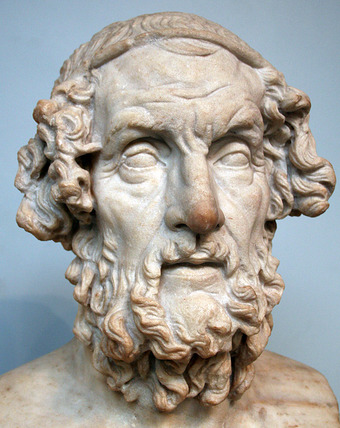
Homer
Idealized portrayal of Homer dating to the Hellenistic period; located at the British Museum.
The formative influence of the Homeric epics in shaping Greek culture was widely recognized, and Homer was described as the “Teacher of Greece.” Homer’s works, some 50% of which are speeches, provided models in persuasive speaking and writing that were emulated throughout the ancient and medieval Greek worlds. Fragments of Homer account for nearly half of all identifiable Greek literary papyrus finds.
The Iliad
The Iliad (sometimes referred to as the Song of Ilion or Song of Ilium) is an ancient Greek epic poem in dactylic hexameter. Set during the Trojan War (the ten-year siege of the city of Troy (Ilium) by a coalition of Greek states), it tells of the battles and events surrounding a quarrel between King Agamemnon and the warrior Achilles. Although the story covers only a few weeks in the final year of the war, the Iliad mentions or alludes to many of the Greek legends about the siege. The epic narrative describes events prophesied for the future, such as Achilles’ looming death and the sack of Troy. The events are prefigured and alluded to more and more vividly, so that when the story reaches an end, the poem has told a more or less complete tale of the Trojan War.
Nineteenth
century excavations at Hisarlik provided scholars with historical evidence for
the events of the Trojan War, as told by Homer in the Iliad. Additionally, linguistic studies into oral epic traditions
in nearby civilizations, and the deciphering of Linear B in the 1950s, provided
further evidence that the Homeric poems could have been derived from oral
transmissions of long-form tales about a war that actually took place. The
likely historicity of the Iliad as a
piece of literature, however, must be balanced against the creative license
that would have been taken over years of transmission, as well as the alteration of historical fact to conform with tribal preferences and provide entertainment
value to its intended audiences.
Herodotus
Herodotus was a Greek historian who was born in
Halicarnassus (modern-day Bodrum, Turkey) and lived in the 5th century BCE. He
was a contemporary of Socrates. He is referred to as “The Father of History” and is the first historian known to have broken from Homeric tradition in order
to treat historical subjects as a method of investigation arranged into a
historiographic narrative. His only known work is a history on the origins of
the Greco-Persian Wars, entitled, The
Histories. Herodotus states that he only reports that which was told to
him, and some of his stories are fanciful and/or inaccurate; however, the
majority of his information appears to be accurate.
Athenian tragic poets and storytellers appear to
have provided heavy inspiration for Herodotus, as did Homer. Herodotus appears
to have drawn on an Ionian tradition of storytelling, collecting and
interpreting oral histories he happened upon during his travels in much the
same way that oral poetry formed the basis for much of Homer’s works. While
these oral histories often contained folk-tale motifs and fed into a central
moral, they also related verifiable facts relating to geography, anthropology,
and history. For this reason, Herodotus drew criticism from his contemporaries,
being touted as a mere storyteller and even a falsifier of information. In
contrast to this type of approach, Thucydides, who had been trained in
rhetoric, provided a model of historical prose-writing based more firmly in
factual progression of a narrative, whereas Herodotus, due to frequent
digressions and asides, appeared to minimize his authorial control.
Thucydides
Thucydides was an Athenian historian and general.
His History of the Peloponnesian War
recounts the 5th century BCE war between Athens and Sparta. Thucydides
is sometimes known as the father of “scientific history,” or an early precursor
to 20th century scientific positivism, because of his strict
adherence to evidence-gathering and analysis of historical cause and effect
without reference to divine intervention. He is also considered the father of
political realism, which is a school of thought within the realm of political
science that views the political behavior of individuals and the relations
between states to be governed by self-interest and fear. More generally,
Thucydides’ texts show concern with understanding why individuals react the way
they do during such crises as plague, massacres, and civil war.
Unlike Herodotus, Thucydides did not view his
historical accounts as a source of moral lessons, but rather as a factual
reporting of contemporary political and military events. Thucydides viewed life
in political terms rather than moral terms, and viewed history in political terms. Thucydides also tended to omit, or at least downplay, geographic and
ethnographic aspects of events from his work, whereas Herodotus recorded all
information as part of the narrative. Thucydides’ accounts are
generally held to be more unambiguous and reliable than those of Herodotus. However, unlike his predecessor, Thucydides does not reveal his sources. Curiously,
although subsequent Greek historians, such as Plutarch, held up Thucydides’
writings as a model for scholars of their field, many of them continued to view
history as a source of moral lessons, as did Herodotus.
Despite its heavy
political slant, scholars cite strong literary and philosophical influences in
Thucydides’ work. In particular, the History
of the Peloponnesian War echoes the narrative tradition of Homer, and draws
heavily from epic poetry and tragedy to construct what is essentially a
positivistic account of world events. Additionally, it brings to the forefront themes
of justice and suffering in a similar manner to the philosophical texts of
Aristotle and Plato.
7.5.3: Classical Greek Theater
Classical Greek theater, whether tragic or comic, has
had great influence on modern literature and drama.
Learning Objective
Describe the common themes found in classical Greek plays
Key Points
-
The city-state of Athens was the center of
cultural power during this period, and held a drama festival in honor of the god
Dionysus, called the Dionysia. - Two dramatic genres to emerge from this era of
Greek theater were tragedy and comedy, both of which rose to prominence around
500-490 BCE. - Greek tragedy is an extension of the ancient
rites carried out in honor of Dionysus; it heavily influenced the theater of ancient
Rome and the Renaissance. - Tragic plots were often based upon myths from
the oral traditions of archaic epics, and took the form of narratives presented
by actors. - Aeschylus was the first tragedian to codify the
basic rules of tragic drama, and is considered by many to be the “father of
tragedy.” - Athenian comedy is divided into three periods:
Old Comedy, Middle Comedy, and New Comedy.
Key Terms
- chorus
-
In
the context of Greek theatre, a homogeneous, non-individualized group of
performers who comment, with a collective voice, on dramatic action. - deus ex machina
-
A plot
device whereby a seemingly unsolvable problem is suddenly and abruptly resolved
by the unexpected intervention of some new event, character, ability, or
object. - monody
-
In
the context of ancient Greek theater and literature, lyric poetry sung by a
single performer rather than by a chorus.
The theatrical culture of ancient Greece flourished from
approximately 700 BCE onward. The city-state of Athens was the center of
cultural power during this period and held a drama festival in honor of the god
Dionysus, called the Dionysia. This festival was exported to many of Athen’s
numerous colonies to promote a common cultural identity across the empire. Two dramatic
genres to emerge from this era of Greek theater were tragedy and comedy, both
of which rose to prominence around 500-490 BCE.
Greek Tragedy
Sometimes referred to as Attic tragedy, Greek tragedy is an
extension of the ancient rites carried out in honor of Dionysus, and it heavily
influenced the theater of ancient Rome and the Renaissance. Tragic plots were
often based upon myths from the oral traditions of archaic epics, and took the
form of narratives presented by actors. Tragedies typically began with a
prologue, in which one or more characters introduce the plot and explain the
background to the ensuing story. The prologue is then followed by paraodos, after which the story unfolds
through three or more episodes. The episodes are interspersed by stasima, or choral interludes that
explain or comment on the situation that is developing. The tragedy then ends
with an exodus, which concludes the
story.
Aeschylus and the Codification of Tragic Drama
Aeschylus was the first tragedian to codify the basic rules
of tragic drama. He is often described as the father of tragedy. He is credited
with inventing the trilogy, a series of three tragedies that tell one long
story. Trilogies were often performed in sequence over the course of a day,
from sunrise to sunset. At the end of the last play, a satyr play was staged to
revive the spirits of the public after they had witnessed the heavy events of
the tragedy that had preceded it.
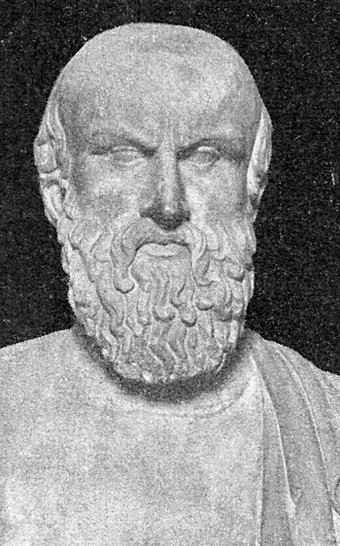
Marble bust of Aeschylus
According to Aristotle, Aeschylus also expanded the number
of actors in theater to allow for the dramatization of conflict on stage.
Previously, it was standard for only one character to be present and interact
with the homogeneous chorus, which commented in unison on the dramatic action
unfolding on stage. Aeschylus’s works show an evolution and enrichment in
dialogue, contrasts, and theatrical effects over time, due to the rich
competition that existed among playwrights of this era. Unfortunately, his
plays, and those of Sophocles and Euripides, are the only works of classical
Greek literature to have survived mostly intact, so there are not many rival
texts to examine his works against.
The Reforms of Sophocles
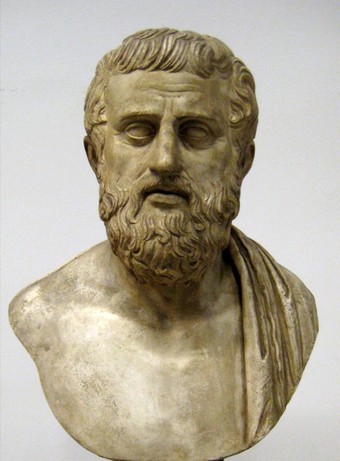
Cast of Sophocles’ bust in the Pushkin Museum
Sophocles was one such rival who triumphed against the
famous and previously unchallenged Aeschylus. Sophocles introduced a third
actor to staged tragedies, increased the chorus to 15 members, broke the cycle
of trilogies (making possible the production of independent dramas), and introduced
the concept of scenery to theater. Compared to the works of Aeschylus, choruses
in Sophocles’ plays did less explanatory work, shifting the focus to deeper
character development and staged conflict. The events that took place were often left unexplained or unjustified, forcing the audience to reflect upon the
human condition.
The Realism of Euripides
Euripides differs from Aeschylus and Sophocles in his search
for technical experimentation and increased focus on feelings as a mechanism to
elaborate the unfolding of tragic events. In Euripides’ tragedies, there are
three experimental aspects that reoccur. The first is the transition of the
prologue to a monologue performed by an actor informing spectators of a story’s
background. The second is the introduction of deus ex machina, or a plot device whereby a seemingly unsolvable
problem is suddenly and abruptly resolved by the unexpected intervention of
some new event, character, ability, or object. Finally, the use of a chorus was
minimized in favor of a monody sung by the characters.
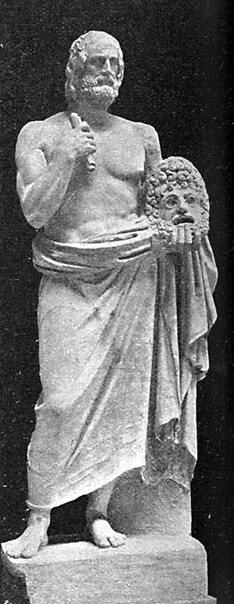
Statue of Euripides
Another novelty introduced by Euripidean drama is the
realism with which characters’ psychological dynamics are portrayed. Unlike in
Aeschylus or Sophocles’ works, heroes in Euripides’ plays were portrayed as
insecure characters troubled by internal conflict rather than simply resolute.
Female protagonists were also used to portray tormented sensitivity and
irrational impulses that collided with the world of reason.
Greek Comedy
As Aristotle wrote in his Poetics, comedy is defined by the representation of laughable
people, and involves some kind of blunder or ugliness that does not cause pain
or disaster. Athenian comedy is divided into three periods: Old Comedy, Middle
Comedy, and New Comedy. The Old Comedy period is largely represented by the 11
surviving plays of Aristophanes, whereas much of the work of the Middle Comedy
period has been lost. New Comedy is known primarily by the substantial papyrus
fragments of Menander. In general, the divisions between these periods is
largely arbitrary, and ancient Greek comedy almost certainly developed
constantly over the years.
Old Comedy and Aristophanes
Aristophanes, the most important Old Comic dramatist, wrote
plays that abounded with political satire, as well as sexual and scatological
innuendo. He lampooned the most important personalities and institutions of his
day, including Socrates in The Clouds.
His works are characterized as definitive to the genre of comedy even today.
Middle Comedy
Although the line between Old and Middle Comedy is not
clearly marked chronologically, there are some important thematic differences between
the two. For instance, the role of the chorus in Middle Comedy was
largely diminished to the point where it had no influence on the plot.
Additionally, public characters were no longer impersonated or personified
onstage, and objects of ridicule tended to be more general rather than
personal, and in many instances, literary rather than political. For some time,
mythological burlesque was popular among Middle Comic poets. Stock characters
also were employed during this period. In-depth assessment and critique of the
styling of Middle Comedy is difficult, given the lack of complete bodies of
work. However, given the revival of this style in Sicily and Magna Graecia, it
appears that the works of this period did have considerable widespread
literary and social impact.
New Comedy
The style of New Comedy is comparable to what is
contemporarily referred to as situation comedy or comedy of manners. The
playwrights of Greek New Comedy built upon the devices, characters, and
situations their predecessors had developed. Prologues to shape the audience’s
understanding of events, messengers’ speeches to announce offstage action, and ex machina endings were all well
established tropes that were used in New Comedies. Satire and farce occupied
less importance in the works of this time, and mythological themes and subjects
were replaced by everyday concerns. Gods and goddesses were, at best,
personified abstractions rather than actual characters, and no miracles or
metamorphoses occurred. For the first time, love became a principal element in
this type of theater.
Three playwrights are well known from this period: Menander,
Philemon, and Diphilus. Menander was the most successful of the New Comedians.
Menander’s comedies focused on the fears and foibles of the ordinary man, as
opposed to satirical accounts of political and public life, which perhaps lent
to his comparative success within the genre. His comedies are the first to
demonstrate the five-act structure later to become common in modern plays. Philemon’s
comedies dwell on philosophical issues, whereas Diphilus was noted for his use
of farcical violence.
7.5.4: Classical Greek Architecture
Classical Greek architecture can be divided into
three separate styles: the Doric Order, the Ionic Order, and the Corinthian
Order.
Learning Objective
Describe the distinguishing characteristics of Classical Greek Architecture
Key Points
- Classical Greek
architecture is best represented by substantially intact ruins of temples and
open-air theaters. - The
architectural style of classical Greece can be divided into three separate
orders: the Doric Order, the Ionic Order, and the Corinthian Order. All three
styles have had a profound impact on Western architecture of later periods. -
While the three
orders of Greek architecture are most easily recognizable by their capitals,
the orders also governed the form, proportions, details, and relationships of
the columns, entablature, pediment, and stylobate. - The Parthenon is considered the most important
surviving building of classical Greece, and the zenith of Doric Order
architecture.
Key Terms
- capitals
-
In architecture, a capital forms the topmost
member of a column. - entablature
-
An entablature is the superstructure of moldings
and bands that lay horizontally above columns and rest on capitals. - pediment
-
A pediment is an element in classical,
neoclassical, and baroque architecture that is placed above the horizontal
structure of an entablature, and is typically supported by columns. - stylobate
-
In classical Greek architecture, a stylobate is
the top step of a stepped platform upon which colonnades of temple columns are
placed. In other words, the stylobate comprises the temple flooring.
Classical Greek architecture
is highly formalized in structure and decoration, and is best known for its
temples, many of which are found throughout the region as substantially intact
ruins. Each classical Greek temple appears to have been conceived as a
sculptural entity within the landscape, and is usually raised on higher ground
so that its proportions and the effects of light on its surface can be viewed
from multiple angles. Open-air theaters are also an important type of building
that survives throughout the Hellenic world, with the earliest dating from
approximately 525-480 BCE.
Greek architectural style
can be divided into three separate orders: the Doric Order, the Ionic Order,
and the Corinthian Order. These styles have had a profound impact on Western
architecture of later periods. In particular, the architecture of ancient Rome
grew out of Greek architecture. Revivals of Classicism have also brought about renewed
interest in the architectural styles of ancient Greece. While the three orders
of Greek architecture are most easily recognizable by their capitals, the
orders also governed the form, proportions, details, and relationships of the
columns, entablature, pediment, and stylobate. Orders were applied to the whole
range of buildings and monuments.
The Doric Order
The Doric Order developed on mainland Greece and spread to
Italy. It is most easily recognized by its capital, which appears as a circular
cushion placed on top of a column onto which a lintel rests. In early examples
of the Doric Order, the cushion is splayed and flat, but over time, it became more
refined, deeper, and with a greater curve.
Doric columns almost always feature fluting down the
length of the column, numbering up to 20 flutes. The flutes meet at sharp edges, called
arrises. Doric columns typically have no bases, with the exception of a few
examples dating from the Hellenistic period. Columns of an early Doric temple, such as the Temple of Apollo at Syracuse, could have a column height to an entablature ratio of 2:1, and a column height to a base diameter ratio of only
4:1. Later, a column height to a diameter ratio of 6:1 became more usual, and there is a column height to an entablature ratio at the Parthenon oapproximately 3:1.
Doric entablatures consist of three parts: the architrave,
the frieze, and the cornice. The architrave is composed of stone lintels that
span the space between columns. On top of this rests the frieze, one of the
major areas of sculptural decoration. The frieze is divided into triglyps and
metopes. The triglyphs have three vertical grooves, similar to columnar
fluting, and below them are guttae, small strips that appear to connect the
triglyps to the architrave below. The triglyps are located above the center of
each capital and the center of each lintel.
Pediments in the Doric style were decorated with figures in
relief in early examples; however, by the time the sculptures on the Parthenon
were created, many pediment decorations were freestanding.
The Parthenon
The Parthenon is considered the most important surviving
building of classical Greece and the zenith of Doric Order architecture. It is
a former temple on the Athenian Acropolis dedicated to the patron goddess of
Athens, Athena. Construction began on the Parthenon in 447 BCE, when the
Athenian Empire was at its peak. Construction was completed in 438 BCE, but
decoration of the building continued until 432 BCE. Although most architectural
elements of the Parthenon belong to the Doric Order, a continuous sculptured
frieze in low relief that sits above the architrave belongs to the Ionic style.
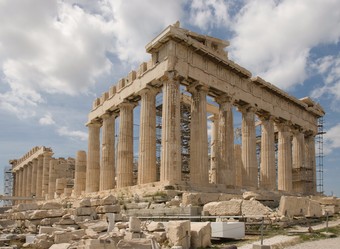
The Parthenon
The Parthenon under restoration in 2008.
The Ionic Order
The Ionic Order coexisted with the Doric Order and was
favored by Greek cities in Ionia, Asia Minor, and the Aegean Islands. It did
not evolve into a clearly defined style until the mid-5th century
BCE. Early Ionic temples in Asia Minor were particularly ambitious in scale.
The Ionic Order is most easily identified by its voluted
capital. The cushion placed on top of the column is similarly shaped to that of
the Doric Order, but is decorated with a stylized ornament and surmounted by a
horizontal band that scrolls under to either side.
Ionic Order columns are fluted with narrow, shallow flutes
that do not meet at a sharp edge, but have a flat band between them. The usual
number of flutes is 24, but there can be as many as 44. The architrave is
not always decorated, but more often it rises in three outwardly-stepped
bands. The frieze runs in a continuous band and is separated from other members
by rows of small projecting blocks.
The Ionic Order is lighter in appearance than the Doric
Order, with columns that have a 9:1 ratio, and the diameter and the whole
entablature appears much narrower and less heavy than those of the Doric.
Decorations were distributed with some variation, and Ionic entablatures often
featured formalized bands of motifs. The external frieze often contained a
continuous band of figurative sculpture of ornament, though this was not always
the case. Caryatids—draped female figures used as supporting members to the
entablature—were also a feature of the Ionic Order.
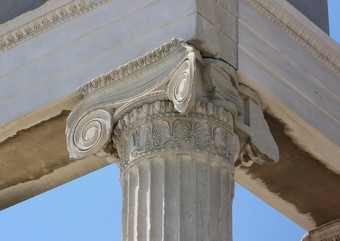
The Erechteum on the Acropolis of Athens, Greece
Corner capital in the Ionic style with a diagonal volute, showing also details of the fluting separated by fillets.
The Corinthian Order
The Corinthian Order grew directly from the Ionic in the
mid-5th century BCE, and was initially of a very similar style and
proportion, with the only distinguishing factor being its more ornate capitals.
The capitals of the Corinthian Order were much deeper than those of the Doric
and Ionic Orders. They were shaped like a bell-shaped mixing bowl and
ornamented with a double row of acanthus leaves above which rose splayed, voluted
tendrils. The ratio of column height to diameter of the Corinthian
Order is generally 10:1, with the capital taking up more than a tenth of the
height. The ratio of capital height to diameter is generally about 1:16:1.
Initially the Corinthian Order was used
internally in such sites as the Temple of Apollo Epicurius at Bassae. By the
late 300s, features of the Corinthian Order began to be used externally at
sites such as the Choragic Monument of Lysicrates and the Temple of Zeus
Olympia, both in Athens. During the Hellenistic period, Corinthian columns were
sometimes built without fluting. The Corinthian Order became popular among
the Romans, who added a number of refinements and decorative details.
7.5.5: Scientific Advancements in the Classical Period
The Hellenistic Period witnessed significant scientific advancements, due to the mixing of Greek and Asian culture and royal patronage.
Learning Objective
Describe the various scientific advancements made during the Hellenistic period
Key Points
- Great seats of learning rose during the Hellenistic Period, including those at Alexandria and Antioch.
- Scientific inquiries were often sponsored by royal patrons.
- The
discoveries of several Greek mathematicians, including Pythagoras and Euclid,
are still used in mathematical teaching today. Important developments include the
basic rules of geometry, the idea of a formal mathematical proof, and
discoveries in number theory, mathematical analysis, and applied mathematics. - The
Greeks also developed the field of astronomy, which they treated as a branch of
mathematics to a highly sophisticated level. - Hippocrates was a physician
of the classical period, and is considered one of the most outstanding figures
in the history of medicine. Most notably, he founded the Hippocratic school of
medicine, which revolutionized medicine in ancient Greece by establishing it as
a discipline distinct from other fields, and making medicine a profession.
Key Terms
- Hellenistic period
-
The period of ancient Greek and Mediterranean history between the death of Alexander the Great in 323 BCE and the emergence of the Roman Empire, as signified by the Battle of Actium in 31 BCE.
- Alexandria
-
An important seat of learning within the Hellenistic civilization and the capital of Hellenistic, Roman, and Byzantine Egypt for almost 1,000 years, until the Muslim conquest of Egypt in 641 CE.
Hellenistic Culture
Hellenistic culture produced seats of learning in Alexandria, Egypt and Antioch, Syria, along with Greek-speaking populations across several monarchies. Hellenistic science differed from Greek science in at least two ways. First, it benefited from the cross-fertilization of Greek ideas with those that had developed in the larger Hellenistic world. Secondly, to some extent, it was supported by royal patrons in the kingdoms founded by Alexander’s successors.
Especially important to Hellenistic science was the city of Alexandria in Egypt, which became a major center of scientific research in the 3rd century BCE. Two institutions established there during the reigns of Ptolemy I Soter (reigned 323-283 BCE) and Ptolemy II Philadelphus (reigned 281-246 BCE) were the Library and the Museum. Unlike Plato’s Academy and Aristotle’s Lyceum, these institutions were officially supported by the Ptolemies, although the extent of patronage could be precarious, depending on the policies of the current ruler.
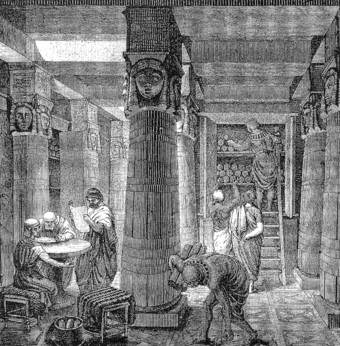
The Great Library of Alexandria
The Great Library of Alexandria, O. Von Corven. 19th century.
Mathematics and
Astronomy
The discoveries of
several Greek mathematicians, including Pythagoras and Euclid, are still used
in mathematical teaching today. Important developments include the basic rules
of geometry, the idea of a formal mathematical proof, and discoveries in number
theory, mathematical analysis, and applied mathematics. Ancient Greek
mathematicians also came close to establishing integral calculus.
The Greeks also
developed the field of astronomy, which they treated as a branch of
mathematics, to a highly sophisticated level. The first geometrical,
three-dimensional models to explain the apparent motion of the planets was developed
in the 4th century BCE, by Eudoxus of Cnidus and Callippus of
Cyzicus. Their younger contemporary, Heraclides Ponticus, proposed that the Earth
rotates around its axis. In the 3rd century BCE, Aristarchus of
Samos was the first to suggest a heliocentric system. In the 2nd
century BCE, Hipparchus of Nicea made a number of contributions, including the
first measurement of precession and the compilation of the first star catalog, in which he proposed the modern system of apparent magnitudes.
The Antikythera
mechanism, a device for calculating the movements of the planets, was the first
ancestor of the astronomical computer. It dates from about 80 BCE, and was
discovered in an ancient shipwreck off the Greek island of Antikythera. The
device became famous for its use of a differential gear, which was previously
believed to have been invented in the 16th century, as well as the
miniaturization and complexity of its parts, which has been compared to that of
clocks produced in the 18th century.
The Medical Field
The ancient Greeks also
made important discoveries in the medical field. Hippocrates was a physician of
the classical period, and is considered one of the most outstanding figures in
the history of medicine. He is sometimes even referred to as the “father of
medicine.” Most notably, he founded the Hippocratic school of medicine, which
revolutionized medicine in ancient Greece by establishing it as a discipline
distinct from other fields, and making medicine a profession.
Other notable Hellenistic scientists and their achievements include:
- Herophilos (335-280 BCE), who was the first to base medical conclusions on dissection of the human body and to describe the nervous system
- Archimedes (c. 287-212 BCE), a geometer, physicist, and engineer who laid the foundations of hydrostatics and statics, and explained the principle of the lever
- Eratosthenes (c. 276 BCE-195/194 BCE), who measured the distance between the Sun and the Earth, as well as the size of the Earth
7.6: The Peloponnesian War
7.6.1: Introduction to the Peloponnesian War
The
Peloponnesian War provided a dramatic end to the 5th century BCE, shattering
religious and cultural taboos, devastating vast swathes of countryside, and
destroying whole cities.
Learning Objective
Describe the events of the Peloponnesian War
Key Points
-
The Peloponnesian War (431-404 BCE) was fought
between Athens and its empire, known as the Delian League, and the
Peloponnesian League, led by Sparta. - During this conflict, Greek warfare evolved from
an originally limited and formalized form of conflict, to all-out struggles
between city-states, with large-scale atrocities. - During the first phase, known as the Archidamian
War, Sparta launched repeated invasions of Attica while Athens took advantage
of its naval supremacy to raid the Peloponnese coast. - Initially Athens’ strategy, as guided by
Pericles, was to avoid open battle with the more numerous and better trained
Spartan hoplites, and to instead rely on Athens’ superior naval fleet. - In the aftermath of a devastating plague,
Athenians turned against Pericles’s defensive strategy in favor of a more
aggressive one that would bring war directly to Sparta and its allies. - The Peace of Nicias was signed in 421 BCE,
and concluded the first phase of the war. The treaty was undermined, however, by
continued fighting and calls for revolt throughout the Peloponnese. - The destruction of Athens’ fleet at Aegospotami during
the Decelean War effectively ended the Peloponnesian War. Athens surrendered a
year later in 404 BCE.
Key Terms
- hoplites
-
Hoplites
were citizen-soldiers of Ancient Greek city-states who were primarily armed
with spears and shields. - helot
-
Helots
were a subjugated population group that formed the main population of Laconia
and Messenia, the territories controlled by Sparta.
The Peloponnesian War (431-404 BCE) was fought between
Athens and its empire, known as the Delian League, and the Peloponnesian League, led by Sparta. During this conflict, Greek warfare evolved from an originally
limited and formalized form of conflict, to all-out struggles between
city-states, complete with large-scale atrocities. The Peloponnesian War
provided a dramatic end to the 5th century BCE, shattering religious and
cultural taboos, devastating vast swathes of countryside, and destroying whole
cities. Historians have traditionally divided the war into several different phases.
The Archidamian War
During the first phase, known as the Archidamian War, Sparta
launched repeated invasions of Attica while Athens took advantage of its naval
supremacy to raid the Peloponnese coast. Sparta and its allies, with the
exception of Corinth, were almost exclusively land-based powers, whereas the Athens empire, though based on a peninsula, had developed impressive naval power. As a result, the two powers were relatively unable to
fight decisive battles.The Spartan strategy during the Archidamian War was to
invade the land surrounding Athens, depriving Athenians of the productive land
around their city. However, Athens maintained access to the sea and did not
suffer much from this strategy, though many citizens of Attica abandoned their
farms and moved inside the long walls connecting Athens to port Piraeus.
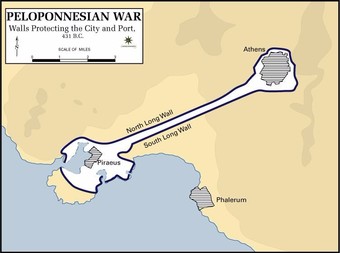
The Walls Protecting Athens
The walls protecting Athens during the Peloponnesian War.
Initially Athens’ strategy, as guided by Pericles, was to
avoid open battle with the more numerous, and better trained Spartan hoplites, and to instead rely on Athens’ superior fleet. As a result, Athens’ fleet went
on the offensive, winning a victory at Naupactus. Their victory was short-lived,
however, because in 430 BCE, an outbreak of plague hit Athens, ravaging the
densely packed city and wiping out over 30,000 citizens, sailors, and soldiers,
which amounted to roughly one-third to two-thirds of the Athenian population. As a
result, Athenian manpower was drastically reduced, and due to widespread fears
of plague, foreign mercenaries refused to hire themselves out to Athens. Sparta
also abandoned its invasion of Attica during this time, unwilling to risk
contact with their diseased enemy.
Pericles and his sons perished as a result of plague, and in
the aftermath, Athenians turned against Pericles’s defensive strategy in favor
of a more aggressive one that would bring war directly to Sparta and its
allies. Initially this strategy met with some success as Athens pursued naval
raids throughout the Peloponnese. Their successes allowed them to fortify posts
throughout the Peloponnese. One such post was near Pylos, on a tiny island
called Sphacteria. It began attracting helot runaways from Sparta, which in
turn raised Spartan fears that Athenian activities throughout the Peloponnese
would incite a mass helot revolt. As a result, the Spartans were driven into
action. During the ensuing conflicts, 300 to 400 Spartans were taken hostage,
providing Athens with a bargaining chip.
In return, the Spartans raised an army of allies and helots
and marched the length of Greece to the Athenian colony of Amphipolis, which
controlled several nearby silver mines. These mines were particularly important
because they provided much of the money that financed the Athenian war effort.
The capture of this colony provided Sparta a bargaining chip as well, and the
two rival city-states agreed to sign a truce, exchanging the Spartan hostages
for Amphipolis and its silver mines.
Peace of Nicias
The Peace of Nicias was signed in 421 BCE, concluding the
first phase of the war. Due to the loss of war hawks in both city-states during
the previous conflict, the peace endured for approximately six years. The
treaty was undermined, however, by continued fighting and calls for revolt
throughout the Peloponnese. Although the Spartans refrained from such actions
themselves, their allies remained vocal, particularly Argos. The Athenians
supported the Argives and encouraged them to form a coalition of democratic
states within the Peloponnese and separate from Sparta. Early Spartan attempts to
thwart such a coalition ultimately failed, and the Argives, their allies, and a
small Athenian force moved to seize the city of Tegea, near Sparta.
The Battle of Mantinea was the largest land battle fought
within Greece during the Peloponnesian War. The Argive allied coalition
initially utilized the sheer strength of their combined forces to score early
successes, but failed to capitalize on them, providing the elite Spartan forces
opportunities to defeat the coalition and save their city from a strategic
defeat. The Argive democratic alliance was broken up, and most members were
reincorporated into Sparta’s Peloponnesian League, reestablishing Spartan
hegemony throughout the region.
The Sicilian Expedition
During the 17th year of war, Athens received news
that one of their distant allies in Sicily was under attack from Syracuse. The
people of Syracuse were ethnically Dorian like the Spartans, and Sicily and
their allies, the Athenians, were ethnically Ionian. In 415 BCE, Athens
dispatched a massive expeditionary force to attack Syracuse in Sicily. The
Athenian force consisted of more than 100 ships, approximately 5,000
infantry, and lightly armored troops. However, their cavalry was limited to about
30 horses, which proved to be no match for the large and highly trained
Syracusan cavalry.
Meanwhile, the Syracusans petitioned Sparta for assistance in
the matter, and Sparta sent their general, Gylippus, to Sicily with reinforcements.
Subsequent Athenian attacks failed and Athens’ entire force was destroyed by
413 BCE.
The Second War
This ushered in the final phase of the war, known as the
Decelean War, or the Ionian War. By this time, Sparta was receiving support from
Persia, and Sparta bolstered rebellions in Athens’ Aegean Sea and Ionian subject
states, in order to undermine Athens empire. This eventually led to the erosion
of Athens’ naval supremacy. The Lacedaemonians were no longer content with
simply sending aid to Sicily as a means of supporting their ally. Instead, their
focus shifted to an offensive strategy against Athens. As a result, Decelea, a
town near Athens, was fortified in order to prevent the Athenians from making
use of their land year-round, and to thwart overland shipments of supplies. Nearby
silver mines were also disrupted, with Spartan hoplites freeing as many as
20,000 Athenian slaves in the vicinity. Due to this disruption in finance,
Athens was forced to demand increased tribute from its subject allies, further
increasing tension and the threat of rebellion throughout the Athenian empire.
Members of the Peloponnesian League continued to
send reinforcements to Syracuse in hopes of driving off the Athenians, but
instead, Athens sent another 100 ships and 5,000 troops to Sicily. Gylippus’s
forces, combined with those of the Syracusans, defeated the Athenians on land. The
destruction of Athens’ fleet at Aegospotami effectively ended the war, and
Athens surrendered a year later in 404 BCE. Corinth and Thebes demanded that
Athens be destroyed and all its citizens enslaved, but Sparta refused to
destroy a city that had done good service at a time of great danger to Greece,
and took Athens into their own alliance system.
7.6.2: Effects of the Peloponnesian War
Following the Peloponnesian War, Athens underwent a period
of harsh oligarchic governance and Sparta enjoyed a brief hegemonic period.
Learning Objective
Understand the effects of the Peloponnesian War on the Greek city-states
Key Points
- The Peloponnesian War ended in victory for
Sparta and its allies, but signaled the demise of Athenian naval and political
hegemony throughout the Mediterranean. - Democracy in Athens was briefly overthrown in
411 BCE as a result of its poor handling of the Peloponnesian War. Lysander,
the Spartan admiral who commanded the Spartan fleet at Aegospotami in 405 BCE, helped
to organize the Thirty Tyrants as Athens’ government for the 13 months they
maintained power. - Lysander established many pro-Spartan
governments throughout the Aegean, where the ruling classes were more loyal to
him than to Sparta as a whole. Eventually Spartan kings, Agis and Pausanias, abolished
these Aegean decarchies, curbing Lysander’s political influence. - Agesilaus II was one of two Spartan kings during
the period of Spartan hegemony, and is remembered for his multiple campaigns in
the eastern Aegean and Persian territories. - Agesilaus’s loss at the Battle of Leuctra
effectively ended Spartan hegemony throughout the region.
Key Terms
- hegemony
-
The
political, economic, or military predominance or control of one state over
others. - harmosts
-
A Spartan
term for a military governor. - oligarchy
-
A form
of power structure in which a small group of people hold all power and
influence in a state.
The Peloponnesian War ended in victory for Sparta and its
allies, and led directly to the rising naval power of Sparta. However, it
marked the demise of Athenian naval and political hegemony throughout the Mediterranean.
The destruction from the Peloponnesian War weakened and divided the Greeks for
years to come, eventually allowing the Macedonians an opportunity to conquer
them in the mid-4th century BCE.
Athens
Democracy in Athens was briefly overthrown in 411 BCE as a
result of its poor handling of the Peloponnesian War. Citizens reacted against
Athens’ defeat, blaming democratic politicians, such as Cleon and Cleophon. The
Spartan army encouraged revolt, installing a pro-Spartan oligarchy within
Athens, called the Thirty Tyrants, in 404 BCE. Lysander, the Spartan admiral who
commanded the Spartan fleet at Aegospotami in 405 BCE, helped to organize the
Thirty Tyrants as a government for the 13 months they maintained power.
During the Thirty Tyrants’ rule, five percent of the
Athenian population was killed, private property was confiscated, and
democratic supporters were exiled. The Thirty appointed a council of 500 to
serve the judicial functions that had formerly belonged to all citizens. Despite
all this, not all Athenian men had their rights removed. In fact, 3,000 such men
were chosen by the Thirty to share in the government of Athens. These men were
permitted to carry weapons, entitled to jury trial, and allowed to reside with
the city limits. This list of men was constantly being revised, and selection
was most likely a reflection of loyalty to the regime, with the majority of
Athenians not supporting the Thirty Tyrants’ rule.
Nonetheless, the Thirty’s regime was not met with much overt
opposition for the majority of their rule, as a result of the harsh penalties
placed on dissenters. Eventually, the level of violence and brutality carried
out by the Thirty in Athens led to increased opposition, stemming primarily
from a rebel group of exiles led by Thrasybulus, a former trierarch in the
Athenian navy. The increased opposition culminated in a revolution that
ultimately overthrew the Thirty’s regime. In the aftermath, Athens gave amnesty
to the 3,000 men who were given special treatment under the regime, with the
exception of those who comprised the governing Thirty and their associated
governmental officials. Athens struggled to recover from the upheaval caused by
the Thirty Tyrants in the years that followed.
Sparta
As a result of the Peloponnesian War, Sparta, which had
primarily been a continental culture, became a naval power. At its peak, Sparta
overpowered many key Greek states, including the elite Athenian navy. By the
end of the 5th century BCE, Sparta’s successes against the Athenian Empire
and ability to invade Persian provinces in Anatolia ushered in a period of
Spartan hegemony. This hegemonic period was to be short-lived, however.
Lysander
After the end of the Peloponnesian War, Lysander established
many pro-Spartan governments throughout the Aegean. Most of the ruling systems
set up by Lysander were ten-man oligarchies, called decarchies, in which
harmosts, Spartan military governors, were the heads of the government. Because
Lysander appointed from within the ruling classes of these governments, the
men were more loyal to Lysander than Sparta, making these Aegean outposts
similar to a private empire.
Lysander and Spartan king Agis were in agreement with Corinth
and Thebes that Athens should be totally destroyed in the aftermath of the
Peloponnesian War, but they were opposed by a more moderate faction, headed by
Pausanias. Eventually, Pausanias’ moderate faction gained the upper hand and
Athens was spared, though its defensive walls and port fortifications at Piraeus
were demolished. Lysander also managed to require Athens to recall its exiles,
causing political instability within the city-state, of which Lysander took
advantage to establish the oligarchy that came to be known as the Thirty
Tyrants. Because Lysander was also directly involved in the selection of the Thirty,
these men were loyal to him over Sparta, causing King Agis and King Pausanias
to agree to the abolishment of his Aegean decarchies, and eventually the
restoration of democracy in Athens, which quickly curbed Lysander’s political
influence.
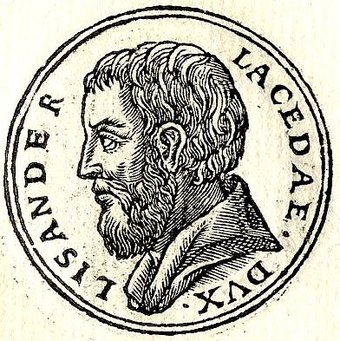
Lysander
A 16th century engraving of Lysander
Agesilaus and His Campaigns
Agesilaus II was one of two Spartan kings during the period
of Spartan hegemony. Lysander was one of Agesilaus’s biggest supporters, and was even a mentor. During his kingship, Agesilaus embarked on a number of military
campaigns in the eastern Aegean and Persian territories. During these
campaigns, the Spartans under Agesilaus’s command met with numerous rebelling
Greek poleis, including the Thebans. The Thebans, Argives, Corinthians, and Athenians
had rebelled during the Corinthian War from 395-386 BCE, and the Persians
aided the Thebans, Corinthians, and Athenians against the Spartans.
During the winter of 379/378 BCE, a group of
Theban exiles snuck into Thebes and succeeded in liberating it, despite
resistance from a 1,500-strong Spartan garrison. This led to a number of Spartan
expeditions against Thebes, known as The Boeotian War. The Greek city-states
eventually attempted to broker peace, but Theban diplomat Epaminondas angered
Agesilaus by arguing for the freedom of non-Spartan citizens within Laconia. As
a result, Agesilaus excluded the Thebans from the treaty, and the Battle of
Leuctra broke out in 371 BCE; the Spartans eventually lost. Sparta’s
international political influence precipitated quickly after their defeat.
7.7: Macedonian Conquest
7.7.1: The Rise of the Macedon
Philip II’s conquests during the Third Sacred
War cemented his power, as well as the influence of Macedon, throughout the Hellenic
world.
Learning Objective
Describe Philip II’s achievements and how he built up Macedon
Key Points
- The military skills
Philip II learned while in Thebes, coupled with his expansionist vision of
Macedonian greatness, brought him early successes when he ascended to the throne
in 359 BCE. - Philip earned
immense prestige, and secured Macedon’s position in the Hellenic world during
his involvement in the Third Sacred War, which began in Greece in 356 BCE. - War with Athens
would arise intermittently for the duration of Philip’s campaigns, due to
conflicts over land, and/or with allies. - In 337 BCE,
Philip created and led the League of Corinth, a federation of Greek states that
aimed to invade the Persian Empire. - In 336 BCE,
Philip was assassinated during the earliest stages of the League of Corinth’s Persian
venture. - Many Macedonian institutions and demonstrations
of power mirrored established Achaemenid conventions.
Key Term
- sarissas
-
A long spear or pike about 13-20 feet in length, used in ancient Greek and Hellenistic warfare, that was initially introduced by
Philip II of Macedon.
Macedon rose from a small
kingdom on the periphery of classical Greek affairs, to a dominant player in the
Hellenic world and beyond, within the span of 25 years between 359 and 336 BCE.
Macedon’s rise is largely attributable to the policies during Philip II’s rule.
Background
In the aftermath of the
Peloponnesian War, Sparta rose as a hegemonic power in classical Greece.
Sparta’s dominance was challenged by many Greek city-states who had
traditionally been independent during the Corinthian War of 395-387 BCE. Sparta
prevailed in the conflict, but only because Persia intervened on their behalf,
demonstrating the fragility with which Sparta held its power over the other
Greek city-states. In the next decade, the Thebans revolted against Sparta,
successfully liberating their city-state, and later defeating the Spartans at
the Battle of Leuctra (371 BCE). Theban general Epaminondas then led an
invasion of the Peloponnesus in 370 BCE, invaded Messenia, and liberated the
helots, permanently crippling Sparta.
These series of events
allowed the Thebans to replace Spartan hegemonic power with their own. For the
next nine years, Epaminondas and Theban general Pelopidas further extended
Theban power and influence via a series of campaigns throughout Greece,
bringing almost every city-state in Greece into the conflict. These years of
war ultimately left Greece war-weary and depleted, and during Epaminondas’s
fourth invasion of the Peloponnesus in 362 BCE, Epaminondas was killed at the
Battle of Mantinea. Although Thebes emerged victorious, their losses were
heavy, and the Thebans returned to a defensive policy, allowing Athens to
reclaim its position at the center of the Greek political system for the first
time since the Peloponnesian War. The Athenians’ second confederacy would be
Macedon’s main rivals for control of the lands of the north Aegean.
Philip II’s Accession
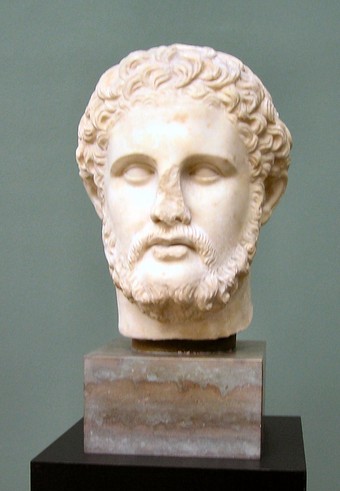
Philip II of Macedon
Bust of Philip II.
While Philip was young, he
was held hostage in Thebes, and received a military and diplomatic education
from Epaminondas. By 364 BCE, Philip returned to Macedon, and the skills he
learned while in Thebes, coupled with his expansionist vision of Macedonian
greatness, brought him early successes when he ascended to the throne in 359
BCE. When he assumed the throne, the eastern regions of Macedonia had been
sacked and invaded by the Paionians, and the Thracians and the Athenians had
landed a contingent on the coast at Methoni. Philip pushed the Paionians and
Thracians back, promising them tributes, and defeated the 3,000 Athenian hoplites
at Methoni. In the interim between conflicts, Philip focused on strengthening
his army and his overall position domestically, introducing the phalanx
infantry corps and arming them with long spears, called sarissas.
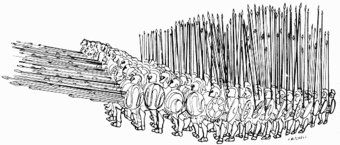
A Macedonian Phalanx
Depiction of a Macedonian phalanx armed with sarissas.
In 358 BCE, Philip marched
against the Illyrians, establishing his authority inland as far as Lake Ohrid.
Subsequently, he agreed to lease the gold mines of Mount Pangaion to the
Athenians in exchange for the return of the city of Pydna to Macedon. Ultimately,
after conquering Amphipolis in 357 BCE, he reneged on his agreement, which led
to war with Athens. During that conflict, Philip conquered Potidaea, but ceded
it to the Chalkidian League of Olynthus, with which he was allied. A year
later, he also conquered Crenides and changed its name to Philippi, using the
gold from the mines there to finance subsequent campaigns.
Third Sacred War
Philip earned immense
prestige and secured Macedon’s position in the Hellenic world during his
involvement in the Third Sacred War, which began in Greece in 356 BCE. Early in
the war, Philip defeated the Thessalians at the Battle of Crocus Field,
allowing him to acquire Pherae and Magnesia, which was the location of an
important harbor, Pagasae. He did not attempt to advance further into central
Greece, however, because the Athenians occupied Thermopylae. Although there
were no open hostilities between the Athenians and Macedonians at the time,
tensions had arisen as a result of Philip’s recent land and resource acquisitions.
Instead, Philip focused on subjugating the Balkan hill-country in the west and
north, and attacking Greek coastal cities, many of which Philip maintained
friendly relations with, until he had conquered their surrounding territories. Nonetheless,
war with Athens would arise intermittently for the duration of Philip’s
campaigns, due to conflicts over land and/or with allies.
Persian Influences
For many Macedonian rulers, the Achaemenid Empire in Persia
was a major sociopolitical influence, and Philip II was no exception. Many
institutions and demonstrations of his power mirrored established Achaemenid
conventions. For example, Philip established a Royal Secretary and Archive, as
well as the institution of Royal Pages, which would mount the king on his horse
in a manner very similar to the way in which Persian kings were mounted. He
also aimed to make his power both political and religious in nature, utilizing
a special throne stylized after those of the Achaemenid court, to demonstrate
his elevated rank. Achaemenid administrative practices were also utilized in
Macedonia rule of conquered lands, such as Thrace in 342-334 BCE.
In 337 BCE, Philip created and led the League of Corinth. Members of the
league agreed not to engage in conflict with one another unless their aim was
to suppress revolution. Another stated aim of the league was to invade the
Persian Empire. Ironically, in 336 BCE, Philip was assassinated during the
earliest stages of the Persian venture, during the marriage of his daughter
Cleopatra to Alexander I of Epirus.
7.7.2: Alexander the Great
In a little over 30 years, Alexander the Great created one of the largest empires in the ancient world, using his military and tactical genius.
Learning Objective
Examine Alexander the Great’s successes and failures
Key Points
- Alexander the Great spent most of his ruling years on an unprecedented military campaign through Asia and northeast Africa. By the age of 30, he created an empire that stretched from Greece to Egypt, and into present-day Pakistan.
- Alexander inherited a strong kingdom and experienced army, both of which contributed to his successes.
- Alexander’s legacy includes the cultural diffusion his engendered conquests, and the rise of Hellenistic culture as a result of his military campaigns.
- Alexander’s impressive record was largely due to his smart use of terrain, phalanx and cavalry tactics, bold and adaptive strategy, and the fierce loyalty of his troops.
Key Terms
- Philip II
-
A king of the Greek kingdom of Macedon from 359 BCE until his assassination in 336 BCE. He was the father of Alexander the Great.
- Alexander the Great
-
Formally Alexander III of Macedon, a Macedonian king who was undefeated in battle and is considered one of history’s most successful commanders.
- phalanx
-
A rectangular mass military formation, usually composed entirely of heavy infantry armed with spears, pikes, sarissas, or similar weapons.
Following the decline of the Greek city-states, the Greek kingdom of Macedon rose to power under Philip II. Alexander III, commonly known as Alexander the Great, was born to Philip II in Pella in 356 BCE, and succeeded his father to the throne at the age of 20. He spent most of his ruling years on an unprecedented military campaign through Asia and northeast Africa, and by the age of 30, had created one of the largest empires of the ancient world, which stretched from Greece to Egypt and into present-day Pakistan. He was undefeated in battle and is considered one of history’s most successful commanders.
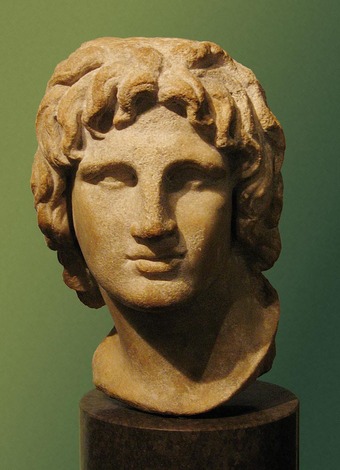
Alexander the Great
Bust of a young Alexander the Great from the Hellenistic era, now at the British Museum.
During his youth, Alexander was tutored by the philosopher Aristotle, until the age of 16. When he succeeded his father to the throne in 336 BCE, after Philip was assassinated, Alexander inherited a strong kingdom and an experienced army. He had been awarded the generalship of Greece, and used this authority to launch his father’s military expansion plans. In 334 BCE, he invaded the Achaemenid Empire, ruled Asia Minor, and began a series of campaigns that lasted ten years. Alexander broke the power of Persia in a series of decisive battles, most notably the battles of Issus and Gaugamela. He overthrew the Persian King Darius III, and conquered the entirety of the Persian Empire. At that point, his empire stretched from the Adriatic Sea to the Indus River.
Seeking to reach the “ends of the world and the Great Outer Sea,” he invaded India in 326 BCE, but was eventually forced to turn back at the demand of his troops. Alexander died in Babylon in 323 BCE, the city he planned to establish as his capital, without executing a series of planned campaigns that would have begun with an invasion of Arabia. In the years following his death, a series of civil wars tore his empire apart, resulting in several states ruled by the Diadochi, Alexander’s surviving generals and heirs. Alexander’s legacy includes the cultural diffusion his engendered conquests. He founded some 20 cities that bore his name, the most notable being Alexandria in Egypt. Alexander’s settlement of Greek colonists, and the spread of Greek culture in the east, resulted in a new Hellenistic civilization, aspects of which were still evident in the traditions of the Byzantine Empire in the mid-15th century. Alexander became legendary as a classical hero in the mold of Achilles, and he features prominently in the history and myth of Greek and non-Greek cultures. He became the measure against which military leaders compared themselves, and military academies throughout the world still teach his tactics.
Military Generalship
Alexander earned the honorific epithet “the Great” due to his unparalleled success as a military commander. He never lost a battle, despite typically being outnumbered. His impressive record was largely due to his smart use of terrain, phalanx and cavalry tactics, bold strategy, and the fierce loyalty of his troops. The Macedonian phalanx, armed with the sarissa, a spear up to 20 feet long, had been developed and perfected by Alexander’s father, Philip II. Alexander used its speed and maneuverability to great effect against larger, but more disparate, Persian forces. Alexander also recognized the potential for disunity among his diverse army, due to the various languages, cultures, and preferred weapons individual soldiers wielded. He overcame the possibility of unrest among his troops by being personally involved in battles, as was common among Macedonian kings.
In his first battle in Asia, at Granicus, Alexander used only a small part of his forces—
perhaps 13,000 infantry, with 5,000 cavalry—against a much larger Persian force of 40,000. Alexander placed the phalanx at the center, and cavalry and archers on the wings, so that his line matched the length of the Persian cavalry line. By contrast, the Persian infantry was stationed behind its cavalry. Alexander’s military positioning ensured that his troops would not be outflanked; further, his phalanx, armed with long pikes, had a considerable advantage over the Persians’ scimitars and javelins. Macedonian losses were negligible compared to those of the Persians.
At Issus in 333 BCE, his first confrontation with Darius, he used the same deployment, and again the central phalanx pushed through. Alexander personally led the charge in the center and routed the opposing army. At the decisive encounter with Alexander at Gaugamela, Darius equipped his chariots with scythes on the wheels to break up the phalanx and equipped his cavalry with pikes. Alexander in turn arranged a double phalanx, with the center advancing at an angle, which parted when the chariots bore down and reformed once they had passed. The advance proved successful and broke Darius’s center, and Darius was forced to retreat once again.
When faced with opponents who used unfamiliar fighting techniques, such as in Central Asia and India, Alexander adapted his forces to his opponents’ style. For example, in Bactria and Sogdiana, Alexander successfully used his javelin throwers and archers to prevent outflanking movements, while massing his cavalry at the center. In India, confronted by Porus’s elephant corps, the Macedonians opened their ranks to envelop the elephants, and used their sarissas to strike upwards and dislodge the elephants’ handlers.
7.7.3: Alexander’s Empire
Alexander the Great’s legacy was the dissemination of Greek culture throughout Asia.
Learning Objective
Describe the legacy Alexander left within his conquered territories
Key Points
- Alexander’s campaigns greatly increased contacts and trade between the East and West, and vast areas to the east were significantly exposed to Greek civilization and influence. Successor states remained dominant for the next 300 years during the Hellenistic period.
- Over the course of his conquests, Alexander founded some 20 cities that bore his name, and these cities became centers of culture and diversity. The most famous of these cities is Egypt’s Mediterranean port of Alexandria.
- Hellenization refers to the spread of Greek language, culture, and population into the former Persian empire after Alexander’s conquest.
- Alexander’s death was sudden and his empire disintegrated into a 40-year period of war and chaos in 321 BCE. The Hellenistic world eventually settled into four stable power blocks: the Ptolemaic Kingdom of Egypt, the Seleucid Empire in the east, the Kingdom of Pergamon in Asia Minor, and Macedon.
Key Term
- Hellenization
-
The spread of Greek language, culture, and population into the former Persian empire after Alexander’s conquests.
Alexander’s legacy extended beyond his military conquests. His campaigns greatly increased contacts and trade between the East and West, and vast areas to the east were exposed to Greek civilization and influence. Some of the cities he founded became major cultural centers, and many survived into the 21st century. His chroniclers recorded valuable information about the areas through which he marched, while the Greeks themselves attained a sense of belonging to a world beyond the Mediterranean.
Hellenistic Kingdoms
Alexander’s most immediate legacy was the introduction of Macedonian rule to huge swathes of Asia. Many of the areas he conquered remained in Macedonian hands or under Greek influence for the next 200 to 300 years. The successor states that emerged were, at least initially, dominant forces, and this 300 year period is often referred to as the Hellenistic period.
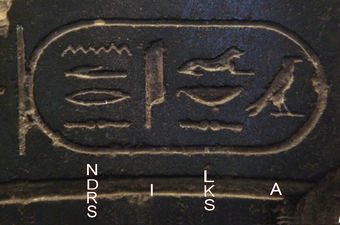
Alexander’s name in hieroglyphics
Name of Alexander the Great in Egyptian hieroglyphs (written from right to left), c. 330 BCE, Egypt; Louvre Museum.
The eastern borders of Alexander’s empire began to collapse during his lifetime. However, the power vacuum he left in the northwest of the Indian subcontinent directly gave rise to one of the most powerful Indian dynasties in history. Taking advantage of this, Chandragupta Maurya (referred to in Greek sources as Sandrokottos), of relatively humble origin, took control of the Punjab, and with that power base proceeded to conquer the Nanda Empire.
Hellenization
The term
“Hellenization” was coined to denote the spread of Greek language,
culture, and population into the former Persian empire after Alexander’s
conquest. Alexander deliberately pursued Hellenization policies in the
communities he conquered. While his intentions may have simply been to
disseminate Greek culture, it is more likely that his policies were pragmatic
in nature and intended to aid in the rule of his enormous empire via cultural
homogenization. Alexander’s Hellenization policies can also be viewed as a
result of his probable megalomania. Later his successors explicitly rejected these
policies. Nevertheless, Hellenization occurred throughout the region,
accompanied by a distinct and opposite “Orientalization” of the successor
states.
The core of
Hellenistic culture was essentially Athenian. The close association of men from
across Greece in Alexander’s army directly led to the emergence of the largely
Attic-based koine (or
“common”) Greek dialect. Koine spread
throughout the Hellenistic world, becoming the lingua
franca of
Hellenistic lands, and eventually the ancestor of modern Greek. Furthermore,
town planning, education, local government, and art during the Hellenistic
periods were all based on classical Greek ideals, evolving into distinct new
forms commonly grouped as Hellenistic.
The Founding of Cities
Over the course of his conquests, Alexander founded some 20 cities that bore his name, most of them east of the Tigris River. The first, and greatest, was Alexandria in Egypt, which would become one of the leading Mediterranean cities. The cities’ locations reflected trade routes, as well as defensive positions. At first, the cities must have been inhospitable, and little more than defensive garrisons. Following Alexander’s death, many Greeks who had settled there tried to return to Greece. However, a century or so after Alexander’s death, many of these cities were thriving with elaborate public buildings and substantial populations that included both Greek and local peoples.
Alexander’s cities were
most likely intended to be administrative headquarters for his empire,
primarily settled by Greeks, many of whom would have served in Alexander’s
military campaigns. The purpose of these administrative centers was to control the
newly conquered subject populations. Alexander attempted to create a unified
ruling class in conquered territories like Persia, often using marriage ties to
intermingle the conquered with conquerors. He also adopted elements of the Persian
court culture, adopting his own version of their royal robes, and imitating some
court ceremonies. Many Macedonians resented these policies, believing
hybridization of Greek and foreign cultures to be irreverent.
Alexander’s attempts at
unification also extended to his army. He placed Persian soldiers, some of who
had been trained in the Macedonian style, within Macedonian ranks, solving
chronic manpower problems.
Division of the Empire
Alexander’s death was so sudden that when reports of his death reached Greece, they were not immediately believed. Alexander had no obvious or legitimate heir because his son, Alexander IV, was born after Alexander’s death. According to Diodorus, an ancient Greek historian, Alexander’s companions asked him on his deathbed to whom he bequeathed his kingdom. His laconic reply was, tôi kratistôi (“to the strongest”). Another, more plausible, story claims that Alexander passed his signet ring to Perdiccas, a bodyguard and leader of the companion cavalry, thereby nominating him as his official successor.
Perdiccas initially did not claim power, instead suggesting that Alexander’s unborn baby would be king, if male. He also offered himself, Craterus, Leonnatus, and Antipater, as guardians of Alexander’s unborn child. However, the infantry rejected this arrangement since they had been excluded from the discussion. Instead, they supported Alexander’s half-brother, Philip Arrhidaeus, as Alexander’s successor. Eventually the two sides reconciled, and after the birth of Alexander IV, Perdiccas and Philip III were appointed joint kings, albeit in name only.
Dissension and rivalry soon afflicted the Macedonians. After the assassination of Perdiccas in 321 BCE, Macedonian unity collapsed, and 40 years of war between “The Successors” (Diadochi) ensued, before the Hellenistic world settled into four stable power blocks: the Ptolemaic Kingdom of Egypt, the Seleucid Empire in the east, the Kingdom of Pergamon in Asia Minor, and Macedon. In the process, both Alexander IV and Philip III were murdered.
7.7.4: The Legacy of Alexander the Great
Four stable power blocks emerged following the
death of Alexander the Great: the Ptolemaic Kingdom of Egypt, the Seleucid
Empire, the Attalid Dynasty of the Kingdom of Pergamon, and Macedon.
Learning Objective
Evaluate Alexander the Great’s legacy as carried
out by his successors
Key Points
- After the assassination of Perdiccas in 321 BCE,
Macedonian unity collapsed, and 40 years of war between “The
Successors” (Diadochi) ensued
before the Hellenistic world settled into four stable power blocks: the
Ptolemaic Kingdom of Egypt, the Seleucid Empire, the Kingdom of Pergamon in
Asia Minor, and Macedon. - The Ptolemaic Kingdom was ruled by the Ptolemaic
dynasty, starting with Ptolemy I Soter’s accession to the throne following the
death of Alexander the Great. The dynasty survived until the death of Cleopatra
VII in 30 BCE, at which point Egypt was conquered by the Romans. - Although the Ptolemaic Kingdom observed the Egyptian
religion and customs, Greek inhabitants were treated as a privileged minority. - The Seleucid Empire was a major center of
Hellenistic culture where Greek customs prevailed and the Greek political elite
dominated, though mostly in urban areas. - The Attalid kingdom of Pergamon began as a rump
state, but was expanded by subsequent rulers. - The Attalids were some of the most loyal
supporters of Rome in the Hellenistic world and were known for their generous and
intelligent rule. - The Macedonian regime
is the only successor state to Alexander the Great’s empire that maintained
archaic perceptions of kingship, and elided the adoption of Hellenistic
monarchical customs.
Key Terms
- satrap
-
A governor of a province in the Hellenistic
empire. The word is also used metaphorically to refer to leaders who are
heavily influenced by larger superpowers or hegemonies, and regionally act as a surrogate
for those larger players. - proskynesis
-
A traditional Persian act of bowing or prostrating oneself before a
person of higher social rank.
Background
Alexander’s death was so sudden that when reports of his
death reached Greece, they were not immediately believed. Alexander had no
obvious or legitimate heir because his son, Alexander IV, was born after
Alexander’s death. According to Diodorus, an ancient Greek historian,
Alexander’s companions asked him on his deathbed to whom he bequeathed his
kingdom. His laconic reply was tôi kratistôi (“to the
strongest”). Another, more plausible, story claims that Alexander passed
his signet ring to Perdiccas, a bodyguard and leader of the companion cavalry, thereby
nominating him as his official successor.
Perdiccas initially did not claim power, instead suggesting
that Alexander’s unborn baby would be king, if male. He also offered himself,
Craterus, Leonnatus, and Antipater, as guardians of Alexander’s unborn child.
However, the infantry rejected this arrangement since they had been excluded
from the discussion. Instead, they supported Alexander’s half-brother, Philip
Arrhidaeus, as Alexander’s successor. Eventually the two sides reconciled, and
after the birth of Alexander IV, Perdiccas and Philip III were appointed joint
kings, albeit in name only.
Dissension and rivalry soon afflicted the
Macedonians. After the assassination of Perdiccas in 321 BCE, Macedonian unity
collapsed, and 40 years of war between “The Successors” (Diadochi) ensued before the
Hellenistic world settled into four stable power blocks: the Ptolemaic Kingdom
of Egypt, the Seleucid Empire in the east, the Kingdom of Pergamon in Asia
Minor, and Macedon. In the process, both Alexander IV and Philip III were
murdered.
The Ptolemaic Kingdom of Egypt
The Ptolemaic Kingdom was a Hellenistic kingdom
based in Egypt, and ruled by the Ptolemaic dynasty, starting with Ptolemy I Soter’s
accession to the throne following the death of Alexander the Great. The
Ptolemaic dynasty survived until the death of Cleopatra VII in 30 BCE, at which
point Egypt was conquered by the Romans. Ptolemy was appointed as satrap of
Egypt in 323 BCE, by Perdiccas during the succession crisis that erupted
following Alexander the Great. From that time, Ptolemy ruled Egypt nominally in
the name of joint kings Philip III and Alexander IV. As Alexander the Great’s
empire disintegrated, however, Ptolemy established himself as a ruler in his
own right. In 321 BCE, Ptolemy defended Egypt against an invasion by Perdiccas.
During the Wars of the Diadochi (322-301 BCE), Ptolemy further consolidated his
position within Egypt and the region by taking the title of King.
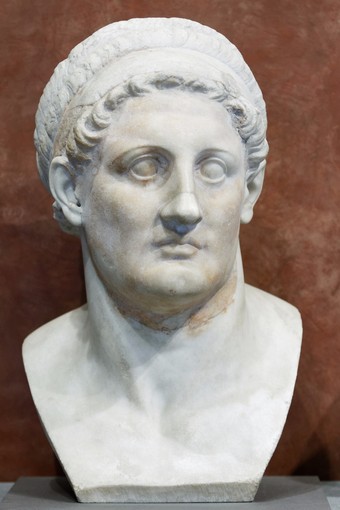
Ptolemy I Soter
Bust of Ptolemy I Soter, king of Egypt (305-282 BCE) and founder of the Ptolemaic dynasty. The identification is based upon coin effigies.
Early in the Ptolemaic dyansty, Egyptian religion
and customs were observed, and magnificent new temples were built in the style
of the old pharaohs. During the reign of Ptolemies II and III, thousands of
Macedonian veterans were rewarded with farm land grants, and settled in colonies
and garrisons throughout the country. Within a century, Greek influence had
spread throughout the country and intermarriage produced a large Greco-Egyptian
educated class. Despite this, the Greeks remained a privileged minority in Ptolemaic
Egypt. Greek individuals lived under Greek law, received a Greek education,
were tried in Greek courts, and were citizens of Greek cities, rather than
Egyptian cities.
The Seleucid Empire
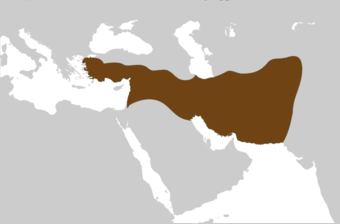
Seleucid Empire
Seleucid Empire at its greatest extent, 281 BCE.
The Seleucid Empire was a Hellenistic state ruled
by the Seleucid Dynasty, which existed from 312 BCE-63 BCE. It was founded
by Seleucus I Nicator following the dissolution of Alexander the Great’s
empire. Following Ptolemy’s successes in the Wars of the Diadochi, Seleucus,
then a senior officer in the Macedonian Royal Army, received Babylonia. From
there, he expanded his dominion to include much of Alexander’s near eastern
territories. At the height of its power, the Seleucid Empire encompassed central
Anatolia, Persia, the Levant, Mesopotamia, and what is now Kuwait, Afghanistan,
and parts of Pakistan and Turkmenistan. Seleucus himself traveled as far as
India in his campaigns. Seleucid expansion into Anatolia and Greece was halted,
however, after decisive defeats at the hands of the Roman army.
The Seleucid Empire was a major center of
Hellenistic culture, where Greek customs prevailed and the Greek political elite
dominated, though mostly in urban areas. Existing Greek populations within the
empire were supplemented with Greek immigrants.
The Kingdom of Pergamon
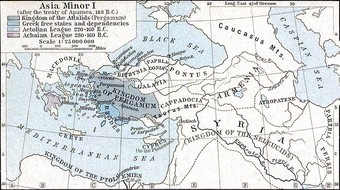
Asia Minor, 188 BCE
The Kingdom of Pergamon (colored olive), shown at its greatest extent in 188 BCE.
The ancient Greek city of Pergamon was taken by
Lysimachus, King of Thrace, in 301 BCE, a short-lived possession that ended
when the kingdom of Thrace collapsed. It became the capital of a new kingdom of
Pergamon, which Philetaerus founded in 281 BCE, thus beginning the rule of the
Attalid Dynasty. The Attalid kingdom began as a rump state, but was expanded by
subsequent rulers. The Attalids themselves were some of the most loyal
supporters of Rome in the Hellenistic world. Under Attalus I (r. 241-197 BCE),
the Attalids allied with Rome against Philip V of Macedon, during the first and
second Macedonian Wars. They allied with Rome again under Eumenes II (r. 197-158
BCE) against Perseus of Macedon, during the Third Macedonian War. Additionally,
in exchange for their support against the Seleucids, the Attalids were given
all former Seleucid domains in Asia Minor.
The Attalids were known for their intelligent and
generous rule. Many historical documents from the era demonstrate that the
Attalids supported the growth of towns by sending in skilled artisans and remitting
taxes. They also allowed Greek cities to maintain nominal independence and sent
gifts to Greek cultural sites, such as Delphi, Delos, and Athens, and even remodeled the Acropolis of Pergamon after the Acropolis in Athens. When Attalus III (r. 138-133
BCE) died without an heir, he bequeathed his entire kingdom to Rome to prevent civil
war.
Macedon

The Kingdom of Macedon at the death of Philip II (336 BCE)
Macedon, or Macedonia, was the dominant state of
Hellenistic Greece. In the partition of Alexander’s empire among the Diadochi,
Macedon fell to the Antipatrid Dynasty, which was headed by Antipater and his
son, Cassander. Following Cassander’s death in 297 BCE, Macedon slid into a long
period of civil strife. Antigonus II (r. 277-239 BCE) successfully restored
order and prosperity in the region, and established a stable monarchy under the
Antigonid Dynasty, though he lost control of many Greek city-states in the process.
Notably, the Macedonian regime is the only
successor state to Alexander the Great’s empire that maintained archaic
perceptions of kingship, and elided the adoption of Hellenistic monarchical
customs. The Macedonian king was never deified in the same way that kings of the
Ptolemaic and Seleucid Dynasties had been. Additionally, the custom of proskynesis,
a traditional Persian act of bowing or prostrating oneself before a person of
higher social rank, was never adopted. Instead, Macedonian subjects addressed
their kings in a far more casual manner, and kings still consulted with their
aristocracy in the process of making decisions.
During the reigns of
Philip V (r. 221-179 BCE) and his son Perseus (r. 179-168 BCE), Macedon clashed
with the rising Roman republic. During the 2nd and 1st centuries BCE, Macedon
fought a series of wars against Rome. Two decisive defeats in 197 and 168 BCE
resulted in the deposition of the Antigonid Dynasty, and the dismantling of the
kingdom of Macedon.
Chapter 6: Early Civilizations in the Indian Subcontinent
6.1: The Indus River Valley Civilizations
6.1.1: The Indus River Valley Civilization
The Indus River Valley Civilization, located in modern Pakistan,
was one of the world’s three earliest widespread societies.
Learning Objective
Identify the importance of the discovery of the Indus River Valley Civilization
Key Points
-
The Indus Valley Civilization
(also known as the Harappan Civilization) was a Bronze Age society extending
from modern northeast Afghanistan to Pakistan and northwest India. - The civilization developed in
three phases: Early Harappan Phase (3300 BCE-2600 BCE), Mature Harappan Phase
(2600 BCE-1900 BCE), and Late Harappan Phase (1900 BCE-1300 BCE). - Inhabitants of the ancient Indus
River valley developed new techniques in handicraft, including Carnelian
products and seal
carving, and metallurgy with
copper, bronze, lead, and tin. -
Sir John Hubert Marshall led an
excavation campaign in 1921-1922, during which he discovered the ruins of the
city of Harappa. By 1931, the Mohenjo-daro site had been mostly excavated by
Marshall and Sir Mortimer Wheeler. By 1999, over 1,056 cities and settlements of
the Indus Civilization were located.
Key Terms
- seal
-
An emblem used as
a means of authentication. Seal can refer to an impression in paper, wax, clay, or other medium. It can also refer to the device used. - metallurgy
-
The scientific and mechanical technique of working with bronze. copper, and tin.
The Indus Valley Civilization existed through its
early years of 3300-1300 BCE, and its mature period of
2600-1900 BCE. The area of this civilization extended along the Indus River
from what today is northeast Afghanistan, into Pakistan and northwest India. The
Indus Civilization was the most widespread of the three early civilizations of
the ancient world, along with Ancient Egypt and Mesopotamia. Harappa and Mohenjo-daro were thought to be the two great
cities of the Indus Valley Civilization, emerging around 2600 BCE along the
Indus River Valley in the Sindh and Punjab provinces of Pakistan. Their discovery
and excavation in the 19th and 20th centuries provided important archaeological
data about ancient cultures.
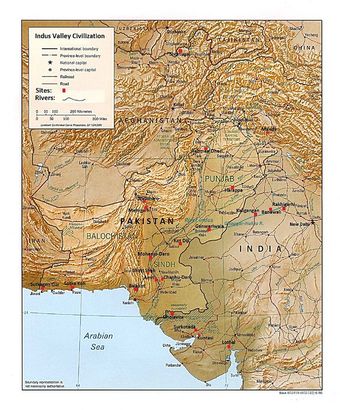
Map of the Indus Valley Civilization
The major sites of the Indus Valley Civilization.
Indus Valley Civilization
The
Indus Valley Civilization was one
of the three “Ancient East” societies that are considered to be the cradles of civilization
of the old world of man, and are among the most widespread; the other two “Ancient East” societies are Mesopotamia and Pharonic Egypt. The lifespan of
the Indus Valley Civilization is often separated into three phases: Early Harappan Phase
(3300-2600 BCE), Mature Harappan Phase (2600-1900 BCE) and Late Harappan Phase
(1900-1300 BCE).
At its peak, the Indus Valley
Civilization may had a population of over five million people. It is considered a Bronze
Age society, and inhabitants of the ancient Indus River Valley developed new
techniques in metallurgy—the science of working with copper, bronze, lead, and
tin. They also performed intricate handicraft, especially using products made
of the semi-precious gemstone Carnelian, as well as seal carving—
the cutting
of patterns into the bottom face of a seal used for stamping. The Indus cities
are noted for their urban planning, baked brick houses, elaborate
drainage systems, water supply systems, and clusters of large, non-residential
buildings.
The
Indus Valley Civilization is also known as the Harappan Civilization, after
Harappa, the first of its sites to be excavated in the 1920s, in what was then
the Punjab province of British India and is now in Pakistan. The discoveries of
Harappa, and the site of its fellow Indus city Mohenjo-daro, were the
culmination of work beginning in 1861 with the founding of the Archaeological
Survey of India in the British Raj, the common name for British imperial rule
over the Indian subcontinent from 1858 through 1947.
Harappa
and Mohenjo-daro
Harappa
was a fortified city in modern-day Pakistan that is believed to have been home
to as many as 23,500 residents living in sculpted houses with flat roofs made
of red sand and clay. The city spread over 150 hectares (370 acres) and had
fortified administrative and religious centers of the same type used in Mohenjo-daro.
The modern village of Harappa, used as a railway station during the Raj, is six
kilometers (3.7 miles) from the ancient city site, which suffered heavy damage
during the British period of rule.
Mohenjo-daro
is thought to have been built in the 26th century BCE and became not only the
largest city of the Indus Valley Civilization but one of the world’s earliest,
major urban centers. Located west of the Indus River in the Larkana District,
Mohenjo-daro was one of the most sophisticated cities of the period, with
sophisticated engineering and urban planning. Cock-fighting was thought to have
religious and ritual significance, with domesticated chickens bred for religion
rather than food (although the city may have been a point of origin for the
worldwide domestication of chickens). Mohenjo-daro was abandoned around 1900 BCE
when the Indus Civilization went into sudden decline.
The
ruins of Harappa were first described in 1842 by Charles Masson in his book, Narrative of Various Journeys in Balochistan,
Afghanistan, the Panjab, & Kalât. In 1856, British engineers John and
William Brunton were laying the East Indian Railway Company line connecting the
cities of Karachi and Lahore, when their crew discovered hard, well-burnt bricks
in the area and used them for ballast for the railroad track,
unwittingly dismantling the ruins of the ancient city of Brahminabad.
Excavations
In 1912, John Faithfull Fleet, an English civil servant working with the
Indian Civil Services, discovered several Harappan seals.
This prompted an excavation campaign from 1921-1922 by Sir John Hubert Marshall, Director-General
of the Archaeological Survey of India, which resulted in the
discovery of Harappa. By 1931, much of
Mohenjo-Daro had been excavated, while the next director of the Archaeological
Survey of India, Sir Mortimer Wheeler, led additional excavations.
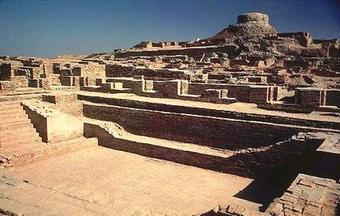
Excavated Ruins of Mohenjo-daro
The Great Bath at Mohenjo-daro, a city in the Indus River Valley Civilization.
The Partition of India, in 1947, divided the country to create the new nation
of Pakistan. The bulk of the archaeological finds that followed were inherited by Pakistan.
By 1999, over 1,056 cities and settlements had been found, of which 96 have
been excavated.
6.1.2: Cities of the Indus Valley Civilization
The Indus River Valley Civilization (IVC) contained urban centers with
well-conceived and organized infrastructure, architecture, and systems of governance.
Learning Objective
Explain the significance of the urban centers in the IVC
Key Points
-
The Indus Valley Civilization
contained more than 1,000 cities and settlements. -
These cities contained
well-organized wastewater drainage systems, trash collection systems, and
possibly even public granaries and
baths. -
Although there were large walls
and citadels,
there is no evidence of monuments, palaces, or temples. -
The uniformity of Harappan
artifacts suggests some form of authority and governance to regulate seals,
weights, and bricks.
Key Terms
- urban planning
-
A technical and
political process concerned with the use of land and design of the urban
environment that guides and ensures the orderly development of settlements and
communities. - granaries
-
A storehouse or room in a barn for threshed grain or animal feed.
- citadels
-
A central area in a city that is heavily fortified.
- Harappa and Mohenjo-daro
-
Two of the major cities of the Indus Valley Civilization during the Bronze Age.
By
2600 BCE, the small Early Harappan communities had become
large urban centers. These cities include Harappa, Ganeriwala, and Mohenjo-daro
in modern-day Pakistan, and Dholavira, Kalibangan, Rakhigarhi, Rupar, and Lothal
in modern-day India. In total, more than 1,052 cities and settlements have been
found, mainly in the general region of the Indus River and its tributaries. The
population of the Indus Valley Civilization may have once been as large as five million.
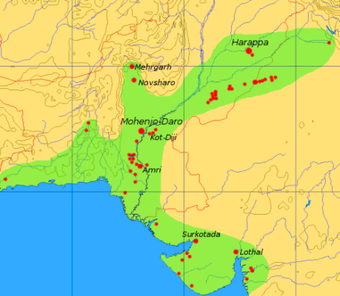
Indus Valley Civilization Sites
This map shows a cluster of Indus Valley Civilization cities and excavation sites along the course of the Indus River in Pakistan.
The
remains of the Indus Valley Civilization cities indicate remarkable organization; there were well-ordered wastewater drainage and trash collection systems, and
possibly even public granaries and baths. Most city-dwellers were artisans and merchants grouped together in
distinct neighborhoods. The quality of urban planning suggests efficient municipal
governments that placed a high priority on hygiene or religious ritual.
Infrastructure
Harappa, Mohenjo-daro, and the recently, partially-excavated Rakhigarhi demonstrate the
world’s first known urban sanitation systems. The ancient Indus systems of
sewerage and drainage developed and used in cities throughout the Indus region
were far more advanced than any found in contemporary urban sites in the Middle
East, and even more efficient than those in many areas of Pakistan and India
today. Individual homes drew water from wells, while waste water was directed
to covered drains on the main streets. Houses opened only to inner courtyards
and smaller lanes, and even the smallest homes on the city outskirts were
believed to have been connected to the system, further supporting the
conclusion that cleanliness was a matter of great importance.
Architecture
Harappans
demonstrated advanced architecture with dockyards, granaries, warehouses, brick
platforms, and protective walls. These massive walls likely protected the
Harappans from floods and may have dissuaded military conflicts. Unlike
Mesopotamia and Ancient Egypt, the inhabitants of the Indus Valley Civilization
did not build large, monumental structures. There is no conclusive evidence of
palaces or temples (or even of kings, armies, or priests), and the largest
structures may be granaries. The city of Mohenjo-daro contains the “Great
Bath,” which may have been a large, public bathing and social area.
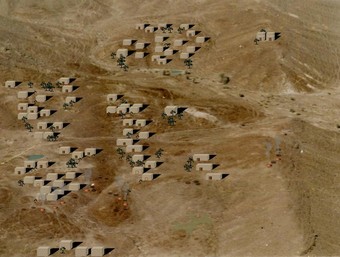
Sokhta Koh
Sokhta Koh, a Harappan
coastal settlement near Pasni, Pakistan, is depicted in a computer
reconstruction. Sokhta Koh means “burnt hill,” and corresponds to the browned-out
earth due to extensive firing of pottery in open pit ovens.
Authority
and Governance
Archaeological
records provide no immediate answers regarding a center of authority, or depictions
of people in power in Harappan society. The extraordinary uniformity of
Harappan artifacts is evident in pottery, seals, weights, and bricks with
standardized sizes and weights, suggesting some form of authority and
governance.
Over time, three major theories have developed concerning Harappan governance
or system of rule. The first is that there was a single state encompassing all
the communities of the civilization, given the similarity in artifacts, the
evidence of planned settlements, the standardized ratio of brick size, and the apparent
establishment of settlements near sources of raw material. The second theory posits
that there was no single ruler, but a number of them representing each of the urban
centers, including Mohenjo-daro, Harappa, and other communities. Finally, experts
have theorized that the Indus Valley Civilization had no rulers as we understand
them, with everyone enjoying equal status.
6.1.3: Harappan Culture
The Indus River Valley Civilization, also known as Harappan, included
its own advanced technology, economy, and culture.
Learning Objective
Identify how artifacts and ruins provided insight into the IRV’s technology, economy, and culture
Key Points
- The Indus River Valley Civilization,
also known as Harappan civilization, developed the first accurate system of
standardized weights and measures, some as accurate as to 1.6 mm. -
Harappans created sculpture, seals,
pottery, and jewelry from materials, such as terracotta, metal, and stone. - Evidence shows Harappans participated
in a vast maritime trade network extending from Central Asia to modern-day
Iraq, Iran, Kuwait, and Syria. - The Indus
Script remains indecipherable without any comparable
symbols, and is thought to have evolved independently of the writing in
Mesopotamia and Ancient Egypt.
Key Terms
- steatite
-
Also known as Soapstone, steatite is a talc-schist, which is a type of metamorphic rock. It is very soft and has been a medium for carving for thousands of years.
- Indus Script
-
Symbols produced by the ancient Indus Valley Civilization.
- chalcolithic period
-
A period also
known as the Copper Age, which lasted from 4300-3200 BCE.
The Indus
Valley Civilization is the earliest known culture of the Indian subcontinent of
the kind now called “urban” (or centered on large municipalities), and the largest
of the four ancient civilizations, which also included Egypt, Mesopotamia, and
China. The society of the Indus River Valley has been dated from the Bronze Age,
the time period from approximately 3300-1300 BCE. It was located in modern-day India and Pakistan, and covered an area as large as Western
Europe.
Harappa and Mohenjo-daro were the two great cities of the Indus Valley
Civilization, emerging around 2600 BCE along the Indus River Valley in the
Sindh and Punjab provinces of Pakistan. Their discovery and excavation in the
19th and 20th centuries provided important archaeological data regarding the
civilization’s technology, art, trade, transportation, writing, and
religion.
Technology
The
people of the Indus Valley, also known as Harappan (Harappa was the first
city in the region found by archaeologists), achieved many notable advances in technology,
including great accuracy in their systems and tools for measuring length and
mass.
Harappans
were among the first to develop a system of uniform weights and measures that conformed
to a successive scale. The smallest division, approximately 1.6 mm, was marked
on an ivory scale found in Lothal, a prominent Indus Valley city in the modern Indian
state of Gujarat. It stands as the smallest division ever recorded on a Bronze
Age scale. Another indication of an advanced measurement system is the fact that
the bricks used to build Indus cities were uniform in size.
Harappans
demonstrated advanced architecture with dockyards, granaries, warehouses, brick
platforms, and protective walls. The ancient Indus systems of sewerage and
drainage developed and used in cities throughout the region were far more
advanced than any found in contemporary urban sites in the Middle East, and even
more efficient than those in many areas of Pakistan and India today.
Harappans
were thought to have been proficient in seal carving, the cutting of patterns
into the bottom face of a seal, and used distinctive seals for the
identification of property and to stamp clay on trade goods. Seals have been
one of the most commonly discovered artifacts in Indus Valley cities, decorated
with animal figures, such as elephants, tigers, and water buffalos.
Harappans also
developed new techniques in metallurgy—the science of working with copper, bronze,
lead, and tin—and performed intricate handicraft using products made of the
semi-precious gemstone, Carnelian.
Art
Indus
Valley excavation sites have revealed a number of distinct examples of the
culture’s art, including sculptures, seals, pottery, gold jewelry, and
anatomically detailed figurines in terracotta, bronze, and steatite—more commonly known as Soapstone.
Among
the various gold, terracotta, and stone figurines found, a figure of a “Priest-King” displayed
a beard and patterned robe. Another figurine in bronze, known as the “Dancing
Girl,” is only 11 cm. high and shows a female figure in a pose that suggests the
presence of some choreographed dance form enjoyed by members of the
civilization. Terracotta works also included cows, bears, monkeys, and dogs. In
addition to figurines, the Indus River Valley people are believed to have created
necklaces, bangles, and other ornaments.
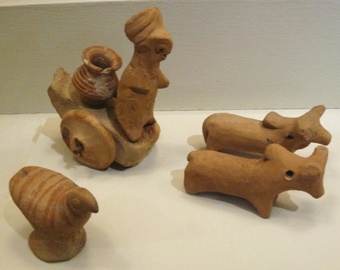
Miniature Votive Images or Toy Models from Harappa, c. 2500 BCE
The Indus River Valley Civilization created figurines from terracotta, as well as bronze and steatite. It is still unknown whether these figurines have religious significance.
Trade and
Transportation
The
civilization’s economy appears to have depended significantly on trade, which
was facilitated by major advances in transport technology. The Harappan
Civilization may have been the first to use wheeled transport, in the form of
bullock carts that are identical to those seen throughout South Asia today. It
also appears they built boats and watercraft—a claim supported by
archaeological discoveries of a massive, dredged canal, and what is regarded as
a docking facility at the coastal city of Lothal.
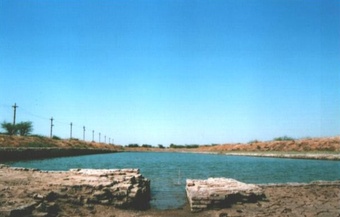
The docks and canal in the ancient city of Lothal, located in modern India
Archaeological evidence suggests that the Indus River Valley Civilization constructed boats and may have participated in an extensive maritime trade network.
Trade
focused on importing raw materials to be used in Harappan city workshops, including minerals from Iran and Afghanistan, lead and copper from other parts
of India, jade from China, and cedar wood floated down rivers from the
Himalayas and Kashmir. Other trade goods included terracotta pots, gold,
silver, metals, beads, flints for making tools, seashells, pearls, and colored gem
stones, such as lapis lazuli and turquoise.
There
was an extensive maritime trade network operating between the Harappan and Mesopotamian
civilizations. Harappan seals and jewelry have been found at archaeological sites
in regions of Mesopotamia, which includes most of modern-day Iraq, Kuwait, and
parts of Syria. Long-distance sea trade over bodies of water, such as the
Arabian Sea, Red Sea and the Persian Gulf, may have become feasible with the
development of plank watercraft that was equipped with a single central mast supporting
a sail of woven rushes or cloth.
During
4300-3200 BCE of the Chalcolithic period,
also known as the Copper
Age, the Indus Valley Civilization area shows ceramic similarities with
southern Turkmenistan and northern Iran. During the Early Harappan period
(about 3200-2600 BCE), cultural similarities in pottery, seals, figurines, and
ornaments document caravan trade with Central Asia and the Iranian plateau.
Writing
Harappans
are believed to have used Indus Script, a language consisting of symbols. A
collection of written texts on clay and stone tablets unearthed at Harappa,
which have been carbon dated 3300-3200 BCE, contain trident-shaped, plant-like markings. This Indus Script suggests that writing developed
independently in the Indus River Valley Civilization from the script employed
in Mesopotamia and Ancient Egypt.

Indus Script
These ten Indus Script symbols were found on a “sign board” in the ancient city of Dholavira.
As
many as 600 distinct Indus symbols have been found on seals, small tablets,
ceramic pots, and more than a dozen other materials. Typical Indus inscriptions
are no more than four or five characters in length, most of which are very
small. The longest on a single surface, which is less than 1 inch (or 2.54 cm.) square, is 17 signs long. The characters are largely pictorial, but include
many abstract signs that do not appear to have changed over time.
The inscriptions are thought to have been primarily written from right
to left, but it is unclear whether this script constitutes a complete language.
Without a “Rosetta Stone” to use as a comparison with other writing systems, the
symbols have remained indecipherable to linguists and archaeologists.
Religion
The
Harappan religion remains a topic of speculation. It has been widely suggested
that the Harappans worshipped a mother goddess who symbolized fertility. In
contrast to Egyptian and Mesopotamian civilizations, the Indus Valley
Civilization seems to have lacked any temples or palaces that would give clear
evidence of religious rites or specific deities. Some Indus Valley seals show a
swastika symbol, which was included in later Indian religions including
Hinduism, Buddhism, and Jainism.
Many
Indus Valley seals also include the forms of animals, with some depicting them
being carried in processions, while others showing chimeric creations, leading
scholars to speculate about the role of animals in Indus Valley religions. One
seal from Mohenjo-daro shows a half-human, half-buffalo monster attacking a
tiger. This may be a reference to the Sumerian myth of a monster created by Aruru,
the Sumerian earth and fertility goddess, to fight Gilgamesh, the hero of an ancient Mesopotamian
epic poem. This is a further suggestion of international trade in
Harappan culture.
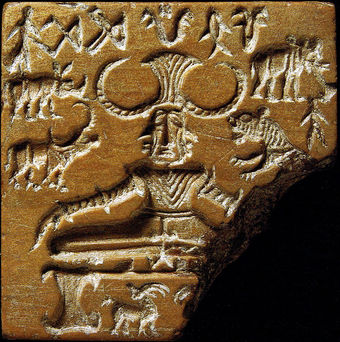
The “Shiva Pashupati” seal
This seal was excavated in Mohenjo-daro and depicts a seated and possibly ithyphallic figure, surrounded by animals.
6.1.4: Disappearance of the Indus Valley Civilization
The Indus Valley Civilization declined around 1800 BCE due to climate
change and migration.
Learning Objective
Discuss the causes for the disappearance of the Indus Valley Civilization
Key Points
- One theory suggested that a nomadic, Indo-European tribe, called the Aryans, invaded and conquered the Indus Valley Civilization.
- Many scholars now believe the collapse of the Indus Valley Civilization was caused by climate change.
- The eastward shift of monsoons may have reduced the water supply, forcing the Harappans of the Indus River Valley to migrate and establish smaller villages and isolated farms.
- These small communities could not produce the agricultural surpluses needed to support cities, which where then abandoned.
Key Terms
- Indo-Aryan Migration theory
-
A theory suggesting the Harappan culture of the Indus River Valley was assimilated during a migration of the Aryan people into northwest India.
- monsoon
-
Seasonal changes in atmospheric circulation and precipitation; usually winds that bring heavy rain once a year.
- Aryans
-
A nomadic, Indo-European tribe called the Aryans suddenly overwhelmed and conquered the Indus Valley Civilization.
The great
Indus Valley Civilization, located in modern-day India and Pakistan, began to
decline around 1800 BCE. The civilization eventually disappeared
along with its two great cities, Mohenjo-daro and Harappa. Harappa lends its name
to the Indus Valley people because it was the civilization’s first city to be
discovered by modern archaeologists.
Archaeological
evidence indicates that trade with Mesopotamia, located largely in modern Iraq, seemed
to have ended. The advanced drainage system and baths of the great cities were
built over or blocked. Writing began to disappear and the standardized weights
and measures used for trade and taxation fell out of use.
Scholars
have put forth differing theories to explain the disappearance of the Harappans,
including an Aryan Invasion and climate change marked by overwhelming monsoons.
The Aryan
Invasion Theory (c. 1800-1500 BC)
The Indus
Valley Civilization may have met its demise due to invasion. According to one
theory by British archaeologist Mortimer Wheeler, a nomadic, Indo-European
tribe, called the Aryans, suddenly overwhelmed and conquered the Indus River
Valley.
Wheeler,
who was Director-General of the Archaeological Survey of India from 1944 to
1948, posited that many unburied corpses found in the top levels of the Mohenjo-daro
archaeological site were victims of war. The theory suggested that by using
horses and more advanced weapons against the peaceful Harappan people, the
Aryans may have easily defeated them.
Yet shortly
after Wheeler proposed his theory, other scholars dismissed it by explaining
that the skeletons were not victims of invasion massacres, but rather the
remains of hasty burials. Wheeler himself eventually admitted that the theory
could not be proven and the skeletons indicated only a final phase of human
occupation, with the decay of the city structures likely a result of it becoming
uninhabited.
Later
opponents of the invasion theory went so far as to state that adherents to the idea
put forth in the 1940s were subtly justifying the British government’s policy
of intrusion into, and subsequent colonial rule over, India.
Various
elements of the Indus Civilization are found in later cultures, suggesting the
civilization did not disappear suddenly due to an invasion. Many scholars came
to believe in an Indo-Aryan Migration theory stating that the Harappan culture
was assimilated during a migration of the Aryan people into northwest India.
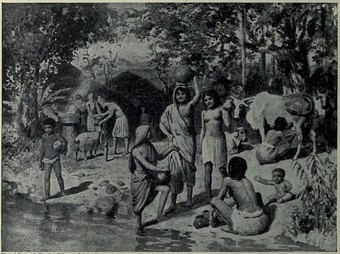
Aryans in India
An early 20th-century depiction of Aryan people settling in agricultural villages in India.
The Climate
Change Theory (c. 1800-1500 BC)
Other
scholarship suggests the collapse of Harappan society resulted from climate
change. Some experts believe the drying of the Saraswati River, which began
around 1900 BCE, was the main cause for climate change, while others conclude
that a great flood struck the area.
Any
major environmental change, such as deforestation, flooding or droughts due to
a river changing course, could have had disastrous effects on Harappan society, such
as crop failures, starvation, and disease. Skeletal evidence suggests many
people died from malaria, which is most often spread by mosquitoes. This also
would have caused a breakdown in the economy and civic order within the urban
areas.
Another disastrous change in the Harappan climate might have been
eastward-moving monsoons, or winds that bring heavy rains. Monsoons can be both
helpful and detrimental to a climate, depending on whether they support or
destroy vegetation and agriculture. The monsoons that came to the Indus River
Valley aided the growth of agricultural surpluses, which supported the
development of cities, such as Harappa. The population came to rely on seasonal
monsoons rather than irrigation, and as the monsoons
shifted eastward, the water supply would have dried up.
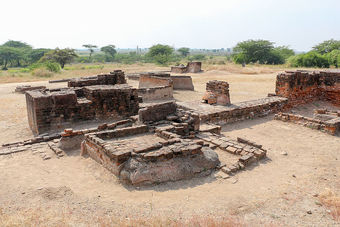
Ruins of the city of Lothal
Archaeological evidence
shows that the site, which had been a major city before the downfall of the
Indus Valley Civilization, continued to be inhabited by a much smaller
population after the collapse. The few people who remained in Lothal did not repair
the city, but lived in poorly-built houses and reed huts instead.
By
1800 BCE, the Indus Valley climate grew cooler and drier, and a tectonic event
may have diverted the Ghaggar Hakra river system toward the Ganges Plain. The Harappans may have migrated
toward the Ganges basin in the east, where they established villages
and isolated farms.
These small communities could not produce the same agricultural
surpluses to support large cities. With the reduced production of goods, there
was a decline in trade with Egypt and Mesopotamia. By around 1700 BCE, most of
the Indus Valley Civilization cities had been abandoned.
6.2: Indo-European Civilizations
6.2.1: The Indo-Aryan Migration and the Vedic Period
Different theories explain the Vedic Period, c. 1200 BCE, when Indo-Aryan
people on the Indian subcontinent migrated to the Ganges Plain.
Learning Objective
Describe the defining characteristics of the Vedic Period and the cultural consequenes of the Indo-Aryan Migration
Key Points
-
The Indo-Aryans were
part of an expansion into the Indus Valley and Ganges
Plain from
1800-1500 BCE. This is explained through Indo-Aryan Migration and Kurgan theories. - The Indo-Aryans continued to
settle the Ganges Plain, bringing their distinct religious beliefs and
practices. - The Vedic Period (c. 1750-500 BCE)
is named for the
Vedas, the oldest scriptures in Hinduism, which were composed during this period. The period can be divided into the Early Vedic (1750-1000 BCE) and Later Vedic
(1000-500 BCE) periods.
Key Terms
- Rig-Veda
-
A sacred
Indo-Aryan collection of Vedic Sanskrit hymns. It is counted among the four canonical
sacred texts of Hinduism, known as the Vedas. - the Vedas
-
The oldest
scriptures of Hinduism composed in Vedic Sanskrit, and originating in ancient
India during the Vedic Period (c. 1750-500 BCE). - Ganges Plain
-
A large, fertile
plain encompassing most of northern and eastern India, where the Indo-Aryans
migrated.
Scholars
debate the origin of Indo-Aryan peoples in northern India. Many have rejected
the claim of Indo-Aryan origin outside of India entirely, claiming the
Indo-Aryan people and languages originated in India. Other origin hypotheses include
an Indo-Aryan Migration in the period 1800-1500 BCE, and a fusion
of the nomadic people known as Kurgans. Most history of this period is derived
from the Vedas, the oldest scriptures in Hinduism, which help chart the
timeline of an era from 1750-500 BCE, known as the Vedic Period.
The
Indo-Aryan Migration (1800-1500 BCE)
Foreigners
from the north are believed to have migrated to India and settled in the Indus
Valley and Ganges Plain from 1800-1500 BCE. The most prominent of these groups
spoke Indo-European languages and were called Aryans, or “noble
people” in the Sanskrit language. These Indo-Aryans were a branch of the
Indo-Iranians, who originated in present-day northern Afghanistan. By 1500 BCE,
the Indo-Aryans had created small herding and agricultural communities across
northern India.
These
migrations took place over several centuries and likely did not involve an
invasion, as hypothesized by British archaeologist Mortimer Wheeler in the
mid-1940s. Wheeler, who was Director-General of the Archaeological Survey of
India from 1944 to 1948, suggested that a nomadic, Indo-European tribe, called
the Aryans, suddenly overwhelmed and conquered the Indus River Valley. He based
his conclusions on the remains of unburied corpses found in the top levels of
the archaeological site of Mohenjo-daro, one of the great cities of the Indus
Valley Civilization, whom he said were victims of war. Yet shortly after
Wheeler proposed his theory, other scholars dismissed it by explaining that the
skeletons were not those of victims of invasion massacres, but rather the remains of
hasty burials. Wheeler himself eventually admitted that the theory could not be
proven.
The Kurgan
Hypothesis
The
Kurgan Hypothesis is the most widely accepted scenario of Indo-European
origins. It postulates that people of a so-called Kurgan Culture, a grouping of
the Yamna or Pit Grave culture and its predecessors, of the Pontic Steppe were the speakers of the Proto-Indo-European language. According to this theory, these
nomadic pastoralists expanded throughout
the Pontic-Caspian steppe and into Eastern Europe by early 3000 BCE. The Kurgan
people may have been mobile because of their domestication of horses and later use
of the chariot.
The Vedic
Period (c. 1750-500 BCE)
The
Vedic Period refers to the time in history from approximately 1750-500 BCE, during
which Indo-Aryans settled into northern India, bringing with them specific religious
traditions. Most history of this period is derived from the Vedas, the oldest
scriptures in the Hindu religion, which were composed by the Aryans in Sanskrit.
Vedic
Civilization is believed to have been centered in the northwestern parts of the
Indian subcontinent and spread around 1200 to the Ganges Plain, a 255-million
hectare area (630 million acres) of flat, fertile land named after the Ganges
River and covering most of what is now northern and eastern India, eastern
parts of Pakistan, and most of Bangladesh. Many scholars believe Vedic
Civilization was a composite of the Indo-Aryan and Harappan, or Indus Valley,
cultures.
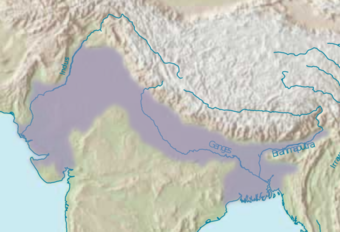
The Ganges Plain (Indo-Gangetic Plain)
The Ganges Plain is supported by the Indus and Ganges river systems. The Indo-Aryans settled various parts of the plain during their migration and the Vedic Period.
Early
Vedic Period (c. 1750-1000 BCE)
The
Indo-Aryans in the Early Vedic Period, approximately 1750-1000 BCE, relied
heavily on a pastoral, semi-nomadic economy with limited agriculture. They
raised sheep, goats, and cattle, which became symbols of wealth.
The
Indo-Aryans also preserved collections of religious and literary works by memorizing
and reciting them, and handing them down from one generation to the next in their
sacred language, Sanskrit. The Rigveda, which was likely composed during
this time, contains several mythological and poetical accounts of the origins
of the world, hymns praising the gods, and ancient prayers for life and
prosperity.
Organized
into tribes, the Vedic Aryans regularly clashed over land and resources. The Rigveda describes the most notable of
these conflicts, the Battle of the Ten Kings, between the Bharatas tribe and a
confederation of ten competing tribes on the banks of what is now the Ravi River
in northwestern India and eastern Pakistan. Led by their king, Sudas, the
Bharatas claimed victory and merged with the defeated Purus tribe to form the
Kuru, a Vedic tribal union in northern India.
Later
Vedic Period (c. 1000-500 BCE)
After
the 12th century BCE, Vedic society transitioned from semi-nomadic to settled
agriculture. From approximately 1000-500 BCE, the development of iron axes and
ploughs enabled the Indo-Aryans to settle the thick forests on the western
Ganges Plain.
This agricultural expansion led to an increase in trade and competition
for resources, and many of the old tribes coalesced to form larger political
units. The Indo-Aryans cultivated wheat, rice and barley and implemented new
crafts, such as carpentry, leather work, tanning, pottery, jewelry crafting, textile
dying, and wine making.
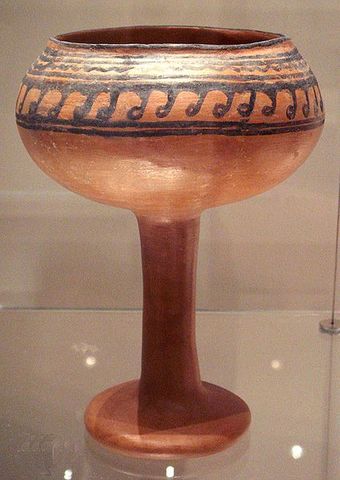
Ceramic goblet from Navdatoli, Malwa, c. 1300 BCE
As the Indo-Aryans developed an agricultural society during the Later Vedic Period (c. 1000-500), they further developed crafts, such as pottery.
Economic
exchanges were conducted through gift giving, particularly between kings and
priests, and barter using cattle as a unit of currency. While gold, silver,
bronze, copper, tin, and lead are mentioned in some hymns as trade items,
there is no indication of the use of coins.
The
invasion of Darius I (a Persian ruler of the vast Achaemenid Empire that stretched
into the Indus Valley) in the early 6th century BCE marked the beginning of
outside influence in Vedic society. This continued into what became the Indo-Greek
Kingdom, which covered various parts of South Asia and was centered mainly in modern
Afghanistan and Pakistan.
6.2.2: The Caste System
A caste system developed among Indo-Aryans of the Vedic Period,
splitting society into four major groups.
Learning Objective
Explain the history of the caste system
Key Points
-
The institution of the caste system,
influenced by stories of the gods in the Rig-Veda epic,
assumed and reinforced the idea that lifestyles, occupations, ritual statuses,
and social statuses were inherited. - Aryan society
was patriarchal in the Vedic Period, with men in positions of authority and
power handed down only through the male line. - There were four classes in the
caste system: Brahmins (priests and scholars), Kshatriyas (kings, governors, and
warriors), Vaishyas (cattle herders, agriculturists, artisans,
and merchants), and Shudras (laborers and service providers). A fifth group, Untouchables,
was excluded from the caste system and historically performed the undesirable
work. -
The caste system may have been
more fluid in Aryan India than it is in modern-day India.
Key Terms
- jatis
-
The term used to
denote the thousands of clans, tribes, religions, communities and sub-communities
in India. - varnas
-
The four broad
ranks of the caste system in the Indo-Aryan culture, which included Brahmins
(priests and scholars), Kshatriyas (kings, governors and warriors), Vaishyas
(cattle herders, agriculturists, artisans, and merchants), and Shudras
(laborers and service providers).
Caste
systems through which social status was inherited developed independently in ancient
societies all over the world, including the Middle East, Asia, and Africa. The
caste system in ancient India was used to establish separate classes of inhabitants
based upon their social positions and employment functions in the community.
These roles and their importance, including the levels of power and significance
based on patriarchy, were influenced by stories of the gods in the Rig-Veda
epic.
Origins
The
caste system in India may have several origins, possibly starting with the
well-defined social orders of the Indo-Aryans in the Vedic Period, c. 1750-500
BCE. The Vedas were ancient scriptures, written
in the Sanskrit language, which contained hymns, philosophies, and rituals handed
down to the priests of the Vedic religion. One of these four sacred canonical
texts, the Rig-Veda, described the origins of the world and points to the gods
for the origin of the caste system.
The castes were a form of social stratification in Aryan India characterized
by the hereditary transmission of lifestyle, occupation, ritual status, and
social status. These social distinctions may have been more fluid in ancient
Aryan civilizations than in modern India, where castes still exist but sociologists
are observing inter-caste marriages and interactions becoming more fluid and
less rigid.
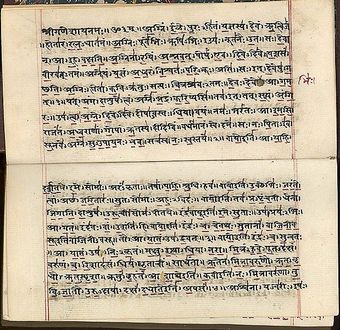
The Rig-Veda
A page of the Rig-Veda,
one of the four sacred Veda texts, which described the origins of the world and
the stories of the gods. The Rig-Veda influenced the development of the
patriarchal society and the caste systems in Aryan India.
Structure
The
classes, known as varnas, enforced
divisions in the populations that still affect this area of the world today. By
around 1000 BCE, the Indo-Aryans developed four main caste distinctions:
Brahamin, consisting of priests, scholars, and teachers; Kshatriyas, the kings,
governors, and warriors; Vaishyas, comprising agriculturists, artisans, and
merchants; and Sudras, the service providers and artisans who were originally
non-Aryans but were admitted to Vedic society.
Each
varna was divided into jatis, or sub-castes, which identified the
individual’s occupation and imposed marriage restrictions. Marriage was only
possible between members of the same jati or two that were very close. Both
varnas and jatis determined a person’s purity level. Members of higher varnas
or jatis had higher purity levels, and if contaminated by members of lower
social groups, even by touch, they would have to undergo extensive cleansing
rites.
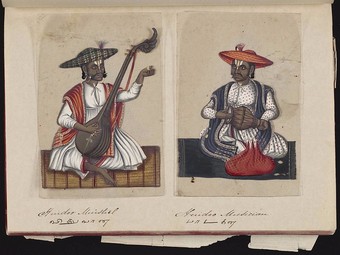
Castes in India
A page from the manuscript Seventy-two Specimens of Castes in India, which consists of 72 full-color hand-painted images of men and women of the various castes and religious and ethnic groups found in Madura, India at that time. Each drawing was made on mica, a transparent, flaky mineral that splits into thin, transparent sheets. As indicated on the presentation page, the album was compiled by the Indian writing master at an English school established by American missionaries in Madura, and given to the Reverend William Twining. The manuscript shows Indian dress and jewelry adornment in the Madura region as they appeared before the onset of Western influences on South Asian dress and style. Each illustrated portrait is captioned in English and in Tamil, and the title page of the work includes English, Tamil, and Telugu.
As
the Aryans expanded their influence, newly conquered groups were assimilated
into society by forming a new group below the Sudras, outside the caste system.
These outcasts were called Untouchables, as they performed the least desirable
activities and jobs, such as dealing with dead bodies, cleaning toilets and
washrooms, and tanning and dyeing leather.
Development
of Patriarchy
Society
during the Vedic Period (c.1750-500 BCE) was patriarchal and patrilineal, meaning to trace ancestral
heritage through the male line. Marriage and childbearing were especially
important to maintain male lineage. The institution of marriage was important, and different types of marriages—monogamy, polygyny and polyandry—are
mentioned in the Rig Veda. All priests, warriors, and tribal chiefs were men, and
descent was always through the male line.
In
other parts of society, women had no public authority; they only were able to
influence affairs within their own homes. Women were to remain subject to the
guidance of males in their lives, beginning with their father, then husband, and
lastly their sons. Male gods were considered more important than female gods.
These distinct gender roles may have contributed to the social stratification
of the caste system.
Enduring
Influence
The
caste system that influenced the social structure of Aryan India has been
maintained to some degree into modern-day India. The caste system survived for
over two millennia, becoming one of the basic features of traditional Hindu
society. Although the Constitution of India, the supreme law document of the Republic
of India, formally abolished the caste system in 1950, some people maintain prejudices
against members of lower social classes.
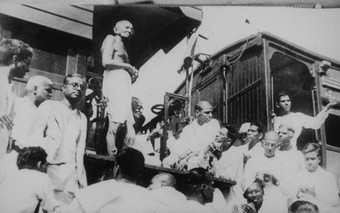
Gandhi at Madras, 1933
Mahatma Gandhi visits Madras, now Chennai, during a tour of India in 1933. As leader of the Indian independence movement, Gandhi frequently spoke out against discrimination created by the caste system.
6.2.3: Sanskrit
Vedic Sanskrit evolved to Classical Sanskrit, which has
influenced modern Indian languages and is used in religious rites.
Learning Objective
Explain the importance of Sanskrit
Key Points
-
Sanskrit is originated as Vedic
Sanskrit as early as 1700-1200 BCE, and was orally preserved as a part of the
Vedic chanting tradition. - The scholar Panini standardized
Vedic Sanskrit into Classical Sanskrit when he defined the grammar, around 500
BCE. - Vedic Sanskrit is the language of the
Vedas, the oldest scriptures of Hinduism. - Knowledge of Sanskrit became a
marker of high social class during and after the Vedic Period.
Key Terms
- Hinduism
-
The dominant
religion of the modern Indian subcontinent, which makes use of Sanskrit in its
texts and practices. - Panini
-
The scholar who standardized the grammar of Vedic Sanskrit to create Classical Sanskrit.
Sanskrit
is the primary sacred language of Hinduism, and has been used as a
philosophical language in the religions of Hinduism, Buddhism, and Jainism. Sanskrit is a standardized
dialect of Old Indo-Aryan, originating as Vedic Sanskrit as early as 170001200
BCE.
One
of the oldest Indo-European languages for which substantial documentation
exists, Sanskrit is believed to have been the general language of the greater
Indian Subcontinent in ancient times. It is still used today in Hindu religious
rituals, Buddhist hymns and chants, and Jain texts.
Origins
Sanskrit
traces its linguistic ancestry to Proto-Indo-Iranian and ultimately to
Proto-Indo-European languages, meaning that it can be traced historically back
to the people who spoke Indo-Iranian, also called the Aryan languages, as well as the
Indo-European languages, a family of several hundred related languages and
dialects. Today, an estimated 46% of humans speak some form of Indo-European
language. The most widely-spoken Indo-European languages are English, Hindi, Bengali,
Punjabi, Spanish, Portuguese, and Russian, each with over 100 million speakers.
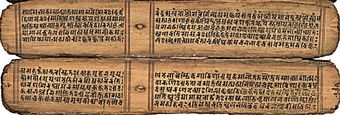
Sanskrit manuscript on palm-leaf, in Bihar or Nepal, 11th century
Sanskrit evolved from Proto-Indo-European languages and was used to write the Vedas, the Hindu religious texts compiled between 1500-500 BCE.
Vedic
Sanskrit is the language of the Vedas, the most ancient Hindu scripts, compiled c. 1500-500 BCE. The Vedas contain hymns, incantations called Samhitas, and
theological and philosophical guidance for priests of the Vedic religion. Believed
to be direct revelations to seers among the early Aryan people of India, the
four chief collections are the Rig Veda, Sam Veda, Yajur Vedia, and Atharva
Veda. (Depending on the source consulted, these are spelled, for example,
either Rig Veda or Rigveda.)
Vedic
Sanskrit was orally preserved as a part of the Vedic chanting tradition,
predating alphabetic writing in India by several centuries. Modern linguists
consider the metrical hymns of the Rigveda Samhita, the
most ancient layer
of text in the Vedas, to have been composed by many authors over several
centuries of oral tradition.
Sanskrit Literature
Sanskrit
Literature began with the spoken or sung literature of the Vedas from c. 1500
BCE, and continued with the oral tradition of the Sanskrit Epics of Iron Age
India, the period after the Bronze Age began, around 1200 BCE. At approximately
1000 BCE, Vedic Sanskrit began the transition from a first language to a second
language of religion and learning.
Around 500 BCE, the ancient scholar Panini standardized the grammar of
Vedic Sanskrit, including 3,959 rules of syntax, semantics, and morphology (the study of words and how they are formed and relate to each other). Panini’s Astadhyayi is the most important of the surviving
texts of Vyakarana, the linguistic
analysis of Sanskrit, consisting of eight chapters laying out his rules and their
sources. Through this standardization, Panini helped create what is now known
as Classical Sanskrit.
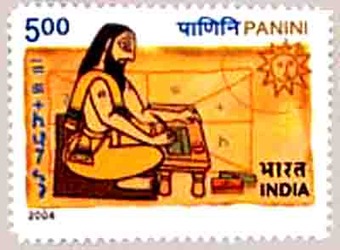
A 2004 Indian stamp honoring Panini, the great Sanskrit grammarian
The scholar Panini standardized the grammar of Vedic Sanskrit to create Classical Sanskrit. With this standardization, Sanskrit became a language of religion and learning.
The
classical period of Sanskrit literature dates to the Gupta period and the
successive pre-Islamic middle kingdoms of India, spanning approximately the 3rd
to 8th centuries CE. Hindu Puranas, a genre of Indian
literature that includes myths and legends, fall into the period of Classical Sanskrit.
Drama
as a distinct genre of Sanskrit literature emerged in the final centuries BCE, influenced
partly by Vedic mythology. Famous Sanskrit dramatists include Shudraka, Bhasa,
Asvaghosa, and Kalidasa; their numerous plays are still available, although
little is known about the authors themselves. Kalidasa’s play, Abhijnanasakuntalam, is generally
regarded as a masterpiece and was among the first Sanskrit works to be
translated into English, as well as numerous other languages.
Works
of Sanskrit literature, such as the Yoga-Sutras of Patanjali, which are still consulted
by practitioners of yoga today, and the Upanishads,
a series of sacred Hindu treatises, were translated into Arabic and Persian. Sanskrit
fairy tales and fables were characterized by ethical reflections and proverbial
philosophy, with a particular style making its way into Persian and Arabic
literature and exerting influence over such famed tales as One Thousand and One Nights, better known in English as Arabian Nights.
Poetry
was also a key feature of this period of the language. Kalidasa was the
foremost Classical Sanskrit poet, with a simple but beautiful style, while
later poetry shifted toward more intricate techniques including stanzas that
read the same backwards and forwards, words that could be split to produce
different meanings, and sophisticated metaphors.
Importance
Sanskrit
is vital to Indian culture because of its extensive use in religious
literature, primarily in Hinduism, and because most modern Indian languages
have been directly derived from, or strongly influenced by, Sanskrit.
Knowledge
of Sanskrit was a marker of social class and educational attainment in ancient
India, and it was taught mainly to members of the higher castes (social groups based on birth
and employment status). In the medieval era, Sanskrit continued to be spoken and
written, particularly by Brahmins (the name for Hindu priests of the highest
caste) for scholarly communication.
Today,
Sanskrit is still used on the Indian Subcontinent. More than 3,000 Sanskrit
works have been composed since India became independent in 1947, while more
than 90 weekly, biweekly, and quarterly publications are published in Sanskrit. Sudharma, a daily newspaper written in
Sanskrit, has been published in India since 1970. Sanskrit is used extensively
in the Carnatic and Hindustani branches of classical music, and it continues to
be used during worship in Hindu temples as well as in Buddhist and Jain
religious practices.
Sanskrit is a major feature of the academic linguistic field of
Indo-European studies, which focuses on both extinct and current Indo-European
languages, and can be studied in major universities around the world.
6.2.4: The Vedas
The Vedas are the oldest texts of the Hindu religion and contain
hymns, myths and rituals that still resonate in India today.
Key Points
-
The Vedas, meaning “knowledge,”
are the oldest texts of Hinduism. - They are derived from the ancient
Indo-Aryan culture of the Indian Subcontinent and began as an oral tradition
that was passed down through generations before finally being written in Vedic
Sanskrit between 1500 and 500 BCE (Before Common Era). - The Vedas are structured in four
different collections containing hymns, poems, prayers, and religious
instruction. - The Indian caste system is based
on a fable from the Vedas about the sacrifice of the deity Purusha.
Key Terms
- Rig Veda
-
The oldest and most important of the four Vedas.
- Caste System
-
An ancient social structure based upon one of the fables in the Vedas, castes persist in modern India.
- Vedas
-
The oldest scriptures of Hinduism, originally passed down orally but then written in Vedic Sanskrit between 1500 and 500 BCE.
- Hinduism
-
A major world religion that began on the Indian Subcontinent.
The
Indo-Aryan Vedas remain the oldest scriptures of Hinduism, which is considered
one of the oldest religions in the world. Vedic ritualism, a composite of ancient
Indo-Aryan and Harappan culture, contributed to the deities and traditions of
Hinduism over time. The Vedas are split into four major texts and contain
hymns, mythological accounts, poems, prayers, and formulas considered sacred to
the Vedic religion.
Structure
of the Vedas
Vedas,
meaning “knowledge,” were written in Vedic Sanskrit between 1500 and
500 BCE in the northwestern region the Indian Subcontinent. The Vedas were
transmitted orally during the course of numerous subsequent generations before
finally being archived in written form. Not much is known about the authors of
the Vedas, as the focus is placed on the ideas found in Vedic tradition rather
than those who originated the ideas. The oldest of the texts is the Rig Veda,
and while it is not possible to establish precise dates for each of the ancient
texts, it is believed the collection was completed by the end of the 2nd millennium
BCE (Before Common Era).
There
are four Indo-Aryan Vedas: the Rig Veda contains hymns about their mythology;
the Sama Veda consists mainly of hymns about religious rituals; the Yajur Veda
contains instructions for religious rituals; and the Atharva Veda consists of
spells against enemies, sorcerers, and diseases. (Depending on the source
consulted, these are spelled, for example, either Rig Veda or Rigveda.)
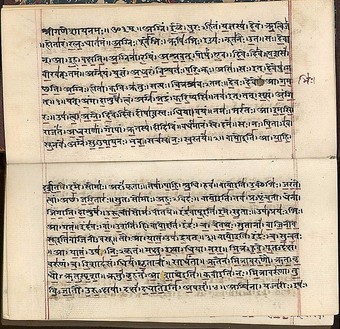
Rigveda Manuscript
A manuscript copy of the Rigveda, the oldest and most important of the four Vedas of the Vedic religion, from the early 19th century.
The
Rig Veda is the largest and considered the most important of the collection,
containing 1,028 hymns divided into 10 books called mandalas. The verses of the
Sam Veda are taken almost completely from the Rig Veda, but arranged
differently so they may be chanted. The Yajur Veda is divided into the White
and Black halves and contains prose commentaries on how religious and
sacrifices should be performed. The Atharva Veda includes charms and magic
incantations written in the style of folklore.
Each
Veda was further divided in two sections: the Brahmanas, instructions for
religious rituals, and the Samhitas, mantras or hymns in praise of various
deities. Modern linguists consider the metrical hymns of the Rigveda Samhita, the
most ancient layer
of text in the Vedas, to have been composed by many authors over several
centuries of oral tradition.
Although
the focus of the Vedas is on the message rather than the messengers, such as
Buddha or Jesus Christ in their respective religions, the Vedic religion still
held gods in high regard.
Vedic
Religion
The
Aryan pantheon of gods is described in great detail in the Rig Veda. However,
the religious practices and deities are not uniformly consistent in these
sacred texts, probably because the Aryans themselves were not a homogenous
group. While spreading through the Indian Subcontinent, it is probable that
their initial religious beliefs and practices were shaped by the absorption of
local religious traditions.
According
to the hymns of the Rig Veda, the most important deities were Agni, the god of
Fire, intermediary between the gods and humans; Indra, the god of Heavens and
War, protector of the Aryans against their enemies; Surya, the Sun god; Vayu,
the god of Wind; and Prthivi, the goddess of Earth.
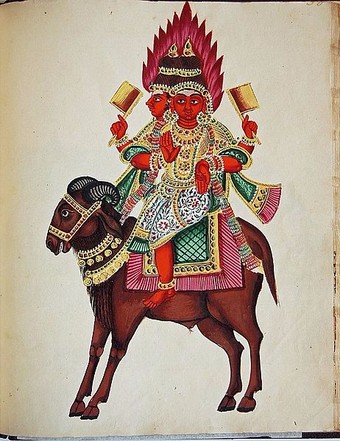
Agni, God of Fire
Agni, the Indian God of Fire from the ancient Vedic religion, shown riding a ram.
Vedas and
Castes
The Caste System, or groups based on birth or employment status, has been part of the
social fabric of the Indian Subcontinent since ancient times. The castes are
thought to have derived from a hymn found in the Vedas to the deity Purusha,
who is believed to have been sacrificed by the other gods. Afterward Purusha’s
mind became the Moon, his eyes became the Sun, his head the Sky, and his feet
the Earth.
The
passage describing the classes of people derived from the sacrifice of Purusha
is the first indication of a caste system. The Brahmins, or priests, came from
Purusha’s mouth; the Kshatriyas, or warrior rulers, came from Purusha’s arms;
the Vaishyas, or commoners such as landowners and merchants, came from Purusha’s
thighs; and the Shudras, or laborers and servants, came from Purusha’s feet.
Today
the castes still exist in the form of varna, or class system, based on the
original four castes described in the Vedas. A fifth group known as Dalits,
historically excluded from the varna system, are ostracized and called
untouchables. The caste system as it exists today is thought to be a product of
developments following the collapse of British colonial rule in India. The system
is frowned upon by many people in Indian society and was a focus of social justice
campaigns during the 20th century by prominent progressive activists such as B.
R. Ambedkar, an architect of the Indian Constitution, and Mahatma Gandhi, the revered
leader of the nonviolent Indian independence movement.
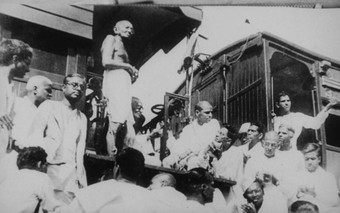
Gandhi at Madras, 1933
Indian independence leader Mahatma Gandhi visits Madras, now Chennai, on a tour of India in 1933. During his appearances Gandhi frequently spoke out against the discrimination of the Indian caste system.
6.3: Religion in the Indian Subcontinent
6.3.1: The Rise of Hinduism
Hinduism evolved as a synthesis of cultures and traditions,
including the Indo-Aryan Vedic religion.
Learning Objective
Explain the evolution of hinduism
Key Points
- The Vedic religion was influenced
by local cultures and traditions adopted by Indo-Aryans as
they spread throughout India. Vedic ritualism heavily influenced the rise of
Hinduism, which rose to prominence after c. 400 BCE. - The Vedas—
the oldest texts of
the Hindu religion—describe deities,
mythology, and instructions for religious rituals. -
The Upanishads are
a collection of Vedic texts particularly important to Hinduism that
contain revealed truths concerning the nature of ultimate reality, and
describing the character and form of human salvation. -
During the 14th and 15th centuries, the Hindu Vijayanagar Empire served as a barrier against Muslim invasion, fostering a reconstruction of Hindu life and administration.
The Hindu Maratha Confederacy rose to power in the 18th century and eventually overthrew Muslim rule in India.
Key Terms
- moksha
-
The character and
form of human salvation, as described in the Upanishads. - Sramana
-
Meaning “seeker,” Sramana refers to several Indian religious movements that existed alongside the Vedic religion, the historical predecessor of modern Hinduism.
- brahman
-
The nature of ultimate reality, as described in the Upanishads.
- Upanishads
-
A collection of Vedic texts that contain the earliest emergence of some of the central religious concepts of Hinduism, Buddhism, and Jainism.
Hinduism
is considered one of the oldest religions in the world. Western scholars regard
Hinduism as a synthesis, or fusion, of various Indian cultures and traditions,
with diverse roots and no stated founder. This synthesis is believed to
have developed after Vedic times, between 500 BCE and 300 CE. However, Vedic ritualism, a composite of Indo-Aryan and Harappan culture,
contributed to the deities and traditions of Hinduism. The Indo-Aryan Vedas
remain the oldest scriptures of the Hindu religion, which has grown culturally
and geographically through modern times to become one of the world’s four major
religions.
The Vedas
Vedas,
meaning “knowledge,” were written in Vedic Sanskrit between 1500 and
500 BCE in the northwestern region of the Indian Subcontinent. There are four
Indo-Aryan Vedas: the Rig Veda contains hymns about mythology; the Sama Veda
consists mainly of hymns about religious rituals; the Yajur Veda contains
instructions for religious rituals; and the Atharva Veda consists of spells
against enemies, sorcerers and diseases. (Depending on the source consulted,
these are spelled, for example, either Sama Veda or Samaveda.) The Rig Veda is
the largest and considered the most important of the collection, containing
1,028 hymns divided into ten books, called mandalas.
The
Aryan pantheon of gods is described in great detail in the Rig Veda. However,
the religious practices and deities are not uniformly consistent in these
sacred texts, probably because the Aryans themselves were not a homogenous
group. While spreading through the Indian subcontinent, it is probable their
initial religious beliefs and practices were shaped by the absorption of local
religious traditions.
According
to the hymns of the Rig Veda, the most important deities were Agni, the god of
Fire, and the intermediary between the gods and humans; Indra, the god of Heavens and
War, protector of the Aryans against their enemies; Surya, the Sun god; Vayu,
the god of Wind; and Prthivi, the goddess of Earth.
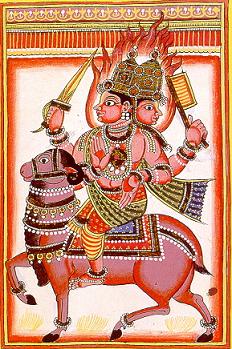
Modern Hindu representation of Agni, god of fire
The Rig Veda describes the varied deities of Vedic religion. These gods persisted as Vedic religion was assimilated into Hinduism.
The
Upanishads
The
Upanishads are a collection of Vedic texts that contain the earliest emergence
of some of the central religious concepts of Hinduism, Buddhism, and Jainism. Also known as Vedanta,
“the end of the Veda,” the collection is one of the sacred texts of
Hinduism thought to contain revealed truths concerning the nature of ultimate
reality, or brahman, and describing the character and form of human salvation, called
moksha. The Upanishads are found in the conclusion of the commentaries on the Vedas, and have been passed down by oral
tradition.
Hindu Synthesis
Sramana,
meaning “seeker,” refers to several Indian religious movements, including Buddhism
and Jainism, that existed alongside the Vedic religion—the historical
predecessor of modern Hinduism. The Sramana traditions drove the so-called Hindu
synthesis after the Vedic period that spread to southern Indian and parts of
Southeast Asia. As it spread, this new Hinduism assimilated popular non-Vedic
gods and other traditions from local cultures, and integrated societal
divisions, called the caste system. It is also thought to
have included both Buddhist and Sramana influences.
Splinter and Rise of Hinduism
During
the reign of the Gupta Empire (between 320-550 CE), which included the period
known as the Golden Age of India, the first known stone and cave temples
dedicated to Hindu deities were built. After the Gupta period, central power disintegrated
and religion became regionalized to an extent, with variants arising within Hinduism
and competing with each other, as well as sects of Buddhism and Jainism. Over
time, Buddhism declined but some of its practices were integrated into
Hinduism, with large Hindu temples being built in South and Southeast Asia.
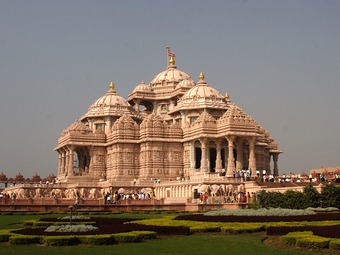
The Swaminarayan Akshardham Temple in Delhi, the world’s largest Hindu temple
Hinduism evolved as a combination of various cultures and traditions, including Vedic religion and the Upanishads.
The
Hindu religion maintained its presence and continued to grow despite a long period
of Muslim rule in India, from 1200-1750 CE, during which Hindus endured violence
as Islam grew to become what is now the second largest religion in India,
behind Hinduism. Akbar I, emperor of the ruling Mughal Dynasty in India from
1556-1605 CE, ended official persecution of non-Muslims and recognized Hinduism,
protected Hindu temples, and abolished discriminatory taxes against Hindus.
Hindu Prominence
During
the 14th and 15th centuries, the Hindu Vijayanagar Empire had arisen and served
as a barrier against invasion by Muslim rulers to the north, fostering a
reconstruction of Hindu life and administration. Vidyaranya, a minister and
mentor to three generations of kings in the Vijayanagar Empire beginning around
1336, helped spread the historical and cultural influence of Shankara—an Indian
philosopher of the 8th century CE credited with unifying and establishing the
main currents of thought in Hinduism.
The
Hindu Maratha Confederacy rose to power in the 18th century and eventually
overthrew Muslim rule in India. In the 19th century, the Indian subcontinent became
a western colony during the period of the British Raj (the name of the British
ruling government) beginning in 1858.
Through
the period of the Raj, until its end in 1947, there was a Hindu resurgence, known
as the Bengali Renaissance, in the Bengal region of India. It included a
cultural, social, intellectual, and artistic movement. Indology, an academic study
of Indian culture, was also established in the 19th century, and spread
knowledge of Vedic philosophy and literature and promoted western interest in
Hinduism.
In
the 20th century, Hinduism gained prominence as a political force and source of
national identity in India. According to the 2011 census, Hindus account for
almost 80% of India’s population of 1.21 billion people, with 960
million practitioners. Other nations with large Hindu populations include Nepal, with 23 million followers, and Bangladesh, with 15 million. Hinduism counts over
1 billion adherents across the globe, or approximately 15% of the world’s
population.

Singapore Diwali Decorations
Diwali decorations in Little India are part of an annual Hindu celebration in Singapore, where there are over 260,000 Hindus.
6.3.2: The Sramana Movement
Sramana broke with Vedic Hinduism over the
authority of the Brahmins and the need to follow ascetic lives.
Learning Objective
Understand the Sramana movement
Key Points
-
Sramana was an ancient Indian
religious movement with origins in the Vedic religion. However, it took a divergent
path, rejecting Vedic Hindu ritualism and the authority of the Brahmins—the
traditional priests of the Hindu religion. - Sramanas were those who practiced an ascetic, or
strict and self-denying, lifestyle in pursuit of spiritual liberation. They are commonly known as monks. - The Sramana movement gave rise to Jainism and Buddhism.
Key Terms
- Sramana
-
An ancient Indian religious movement that began as an offshoot of the Vedic religion and focused on ascetic lifestyle and principles.
- Brahmin
-
A member of a caste in Vedic Hinduism, consisting of priests and teachers who are held as intermediaries between deities and followers, and who are considered the protectors of the sacred learning found in the Vedas.
- Sramanas
-
Sramana followers who renounced married and domestic life, and adopted an ascetic path. The Sramanas rejected the authority of the Brahmins.
- Vedic Religion
-
The historical predecessor of modern Hinduism. The Vedas are the oldest scriptures in the Hindu religion.
- ascetic
-
A person who practices severe self-discipline and abstention from worldly pleasures as a way of seeking spiritual enlightenment and freedom.
Sramana
was an ancient Indian religious movement that began as an offshoot of the Vedic
religion and gave rise to other similar but varying movements, including
Buddhism and Jainism. Sramana, meaning “seeker,” was a tradition that began around
800-600 BCE when new philosophical groups, who believed in a more austere path to spiritual
freedom, rejected the authority of the Brahmins (the priests of Vedic Hinduism). Modern Hinduism can be regarded as a
combination of Vedic and Sramana traditions; it is substantially influenced
by both.
Vedic Roots
The
Vedic Religion was the historical predecessor of modern Hinduism. The
Vedic Period refers to the time period from approximately 1750-500 BCE, during
which Indo-Aryans settled into northern India, bringing with them specific
religious traditions. Most history of this period is derived from the Vedas, the
oldest scriptures in the Hindu religion. Vedas, meaning “knowledge,”
were composed by the Aryans in Vedic Sanskrit between 1500 and 500 BCE, in the northwestern
region the Indian subcontinent.
There
are four Indo-Aryan Vedas: the Rig Veda contains hymns about their mythology;
the Sama Veda consists mainly of hymns about religious rituals; the Yajur Veda
contains instructions for religious rituals; and the Atharva Veda consists of
spells against enemies, sorcerers, and diseases. (Depending on the source
consulted, these are spelled, for example, either Rig Veda or Rigveda.)
Sramana Origins
Several
Sramana movements are known to have existed in India before the 6th century
BCE. Sramana existed in parallel to,
but separate from, Vedic Hinduism. The dominant Vedic ritualism contrasted with
the beliefs of the Sramanas followers who renounced married and domestic life
and adopted an ascetic path, one of severe self-discipline and abstention from
all indulgence, in order to achieve spiritual liberation. The Sramanas rejected the
authority of the Brahmins, who were considered the protectors of the sacred
learning found in the Vedas.
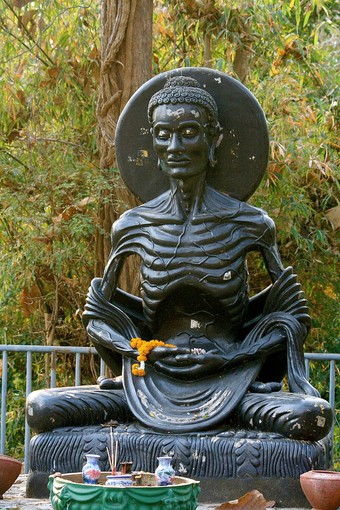
Emaciated Fasting Buddha
Buddha practiced severe asceticism before his enlightenment and recommended a non-ascetic middle way.
Brahmin
is a caste, or social group, in Vedic Hinduism consisting of priests and
teachers who are held as intermediaries between deities and followers. Brahmins
are traditionally responsible for religious rituals in temples, and for reciting
hymns and prayers during rite of passage rituals, such as weddings.
In
India, Sramana originally referred to any ascetic, recluse, or religious
practitioner who renounced secular life and society in order to focus solely on finding religious
truth. Sramana evolved in India over two phases: the Paccekabuddha, the tradition of the individual ascetic, the “lone
Buddha” who leaves the world behind; and the Savaka, the phase of disciples, or
those who gather together as a community, such as a sect of monks.
Sramana Traditions
A “tradition” is a belief or behavior passed down within a group or society, with symbolic
meaning or special significance. Sramana traditions drew upon established Brahmin concepts to
formulate their own doctrines.
The
Sramana traditions subscribe to diverse philosophies, and at times significantly disagree
with each other, as well as with orthodox Hinduism and its six schools of Hindu philosophy.
The differences range from a belief that every individual has a soul, to the
assertion that there is no soul. In terms of lifestyle, Sramana traditions include
a wide range of beliefs that can vary, from vegetarianism to meat eating, and from family
life to extreme asceticism denying all worldly pleasures.
The
varied Sramana movements arose in the same circles of ancient India that led to
the development of Yogic practices, which include the Hindu philosophy of
following a course of physical and mental discipline in order to attain liberation from
the material world, and a union between the self and a supreme being or principle.
The
Sramana traditions drove the so-called Hindu synthesis after the Vedic period, which spread to southern Indian and parts of Southeast Asia. As it spread, this
new Hinduism assimilated popular non-Vedic gods and other traditions from local
cultures, as well as the integrated societal divisions, called the caste system.
Sramaṇa traditions later gave rise to Yoga, Jainism, Buddhism, and
some schools of Hinduism. They also led to popular concepts in all major Indian religions, such as saṃsāra, the cycle of birth and death, and moksha, liberation from that cycle.
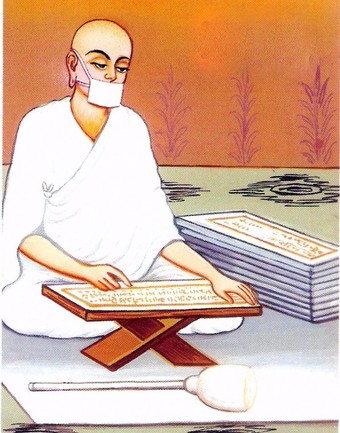
Jain Monk in Meditation
An image of a Jain monk, one of the practitioners of the varied Sramana traditions.
6.3.3: Buddhism
After attaining Enlightenment, Siddhartha Gautama became known
as the Buddha, and taught a Middle Way that became a major world religion, known as Buddhism.
Learning Objective
Understand the development of Buddhism as a major world religion
Key Points
-
Sramanas were those who practiced an
ascetic, or strict and self-denying, lifestyle in pursuit of spiritual liberation. They are commonly known as monks. - The Sramana movement gave rise to Buddhism,
a non-theistic religion that encompasses a variety of traditions, beliefs, and
practices, and arose when Siddhartha Gautama began following Sramana traditions
in the 5th century BCE. - Following his “Enlightenment,” Siddhartha became known as Buddha, or “Awakened One.” He began teaching a
Middle Way to spiritual Nirvana, a release from all earthly burdens. - Buddhism has spread to become one
of the world’s great religions, with an estimated 488 million followers.
Key Terms
- Noble Eightfold Path
-
The eight concepts taught by Buddha as the means to achieving Nirvana.
- Siddhartha Gautama
-
An aristocratic young man who gave up worldly comforts to follow Sramana, then attained Enlightenment and became known as the Buddha, teaching a Middle Way toward spiritual Nirvana.
- Nirvana
-
A sublime state
that marks the release from the cycle of rebirths, known in the Sramana tradition as samsara. - Sramana
-
An offshoot of the Vedic religion that promoted an ascetic lifestyle; Sramana gave rise to Buddhism and other similar traditions.
Buddhism
arose between 500-300 BCE, when Siddhartha Gautama, a young man from an
aristocratic family, left behind his worldly comforts to
seek spiritual enlightenment. He became a teacher commonly known as the Buddha,
meaning “the awakened one,” and Buddhism spread to become a non-theistic
religion that encompasses a variety of traditions, beliefs, and practices
largely based on his teachings.
Sramana Origins
Buddhism
is based on an ancient Indian religious philosophy called Sramana, which began
as an offshoot of the Vedic religion. Several Sramana movements are known to
have existed in India before the 6th century BCE. Sramana existed in parallel to, but separate
from, Vedic Hinduism, which followed the teachings and rituals found in the
Vedas, the most ancient texts of the Vedic religion. Sramana, meaning “seeker,” was a tradition that began when new philosophical groups who believed in a more
austere path to spiritual freedom rejected the authority of the Vedas and the Brahmins,
the priests of Vedic Hinduism, around 800-600 BCE.
Sramana
promoted spiritual concepts that became popular in all major Indian religions,
such as saṃsāra, the cycle of
birth and death, and moksha, liberation from that cycle. The
Sramanas renounced married and domestic life, and adopted an ascetic path—
one
of severe self-discipline and abstention from all indulgence—in order to achieve
spiritual liberation. Sramaṇa traditions (or its religious and moral practices) later gave rise to varying schools of
Hinduism, as well as Yoga, Jainism, and Buddhism.
Origins of
Buddhism
Early
texts suggest Siddhartha Gautama was born into the Shakya Clan, a community on
the eastern edge of the Indian subcontinent in the 5th century BCE. His father
was an elected chieftain, or oligarch, of the small republic. Gautama is thought
to have been born in modern-day Nepal, and raised in the Shakya capital of
Kapilvastu, which may have been in Nepal or India. Most scholars agree that he
taught and founded a monastic order during the reign of the Magadha Empire. In
addition to the Vedic Brahmins, the Buddha’s lifetime coincided with the flourishing
of influential Sramana schools of thought, including Jainism.
Buddhist
teachings explain that Siddhartha was a young man from a respected family, who
renounced his family and left his father’s palace at age 29 in search of truth and
enlightenment through Sramana. Siddhartha began this quest through a period of
starvation and, according to legend, grew so thin he could feel his hands if he
placed one on his back and the other on his stomach. This explains statues that
depict Buddha as thin and withered, rather than the better known depiction of him
seated with a large belly.
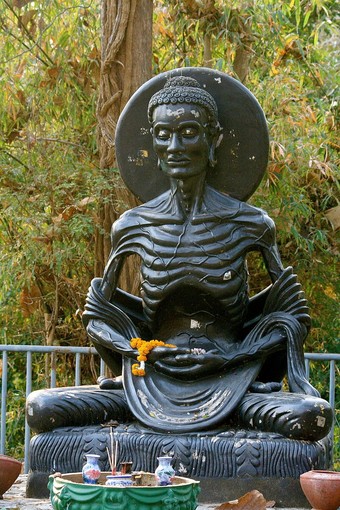
Emaciated Fasting Buddha
This statue in Chiang Mai, Thailand, depicts the Buddha practicing severe asceticism before his Enlightenment.
Buddha lived as a Sramana ascetic for approximately six years until he had an “awakening”
in a place called Bodh Gaya, in the Gaya district of the modern Indian state of
Bihar. Sitting under what became known as the Bodhi Tree, Siddhartha discovered
what Buddhists call the Noble Eightfold Path, and attained Buddhatva, or
Enlightenment, which is said to be a state of being completely free of lust
(raga), hatred (dosa), and delusion (moha).
Siddhartha,
thereafter known as Buddha, or “awakened one,” was recognized by his followers,
called Buddhists, as an enlightened teacher. He taught what he called the
Middle Way or Middle Path, the character of the Noble Eightfold Path. This includes
eight concepts to be sought after: right view, right resolve, right speech,
right conduct, right livelihood, right effort, right mindfulness, and right
samadhi (the state of intense concentration brought on through meditation).
His
insights were intended to help sentient beings end their suffering through the
elimination of ignorance and craving. This could be achieved through understanding the noble path, which
is the way to achieve the sublime state of Nirvana. The literal meaning of
Nirvana in the Sanskrit language is “blowing out” or “quenching,” and is the
ultimate spiritual goal of Buddhism. It marks the release from the cycle of
rebirths, known in the Sramana tradition as samsara.
Another
important Buddhist concept is Bodhisattva, a Sanskrit word for anyone who has been
motivated by great compassion and a wish to attain buddhahood for the benefit
of all sentient beings—those who have a conscious awareness of the self but are
in contrast with buddhahood. Sentient beings are characteristically not yet
enlightened and are thus confined to the death, rebirth and dukkha (suffering) found in the cycle of samsara. Bodhisattvas, therefore, are those who
have set themselves on the path toward enlightenment and hope to benefit others
through their journey. Depictions of the bodhisattva path are a popular subject
in Buddhist art.
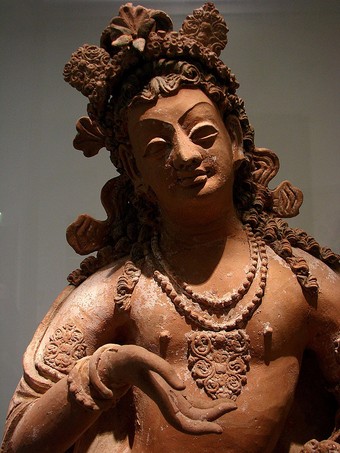
Bodhisattva
Clay sculpture of a bodhisattva, Afghanistan, 7th century.
Rise of Buddhism
Buddha
is thought to have died around 483 BCE, after 45 years of travel and teaching.
Buddhists believe he passed into a state of Nirvana. Small communities of
monks and nuns, known as bhikkus, sprung up along the routes Buddha traveled. Buddhism was overshadowed by the more dominant Hindu religion, but this began to change
in the 3rd century BCE; this was when one of the Indian subcontinent’s great
rulers, Ashoka I of the Maurya Empire, renounced wars, despite having waged war
to build his own kingdom. In a major break from others rulers of the time, he converted
to Buddhism.
Ashoka
promoted the religion’s expansion by deploying monks to spread Buddha’s
teaching. This began a wave of conversion throughout India as well as in surrounding
nations, such as Nepal, Tibet, and Burma, but also further afield in Asia, including in China and Japan. Over time Buddhism grew, as greater numbers of people
became aware of its teachings, including those in western nations, eventually
becoming one of the major religions practiced around the world.
Today, Buddhism is practiced by an estimated 488 million people. China
is the nation with the largest number of Buddhists, approximately 244 million
followers, or more than 18% of its total population. Other countries that have
a large number of Buddhists among their populations include Myanmar with 48.4
million, Japan with 45.8 million, Sri Lanka with 14.2 million, Cambodia with
13.7 million, South Korea with 11 million, Thailand, Laos, Singapore, Taiwan,
and Nepal. The United States is home to an estimated 1.2 million Buddhists, or
1.2% of the American population.
6.3.4: Jainism
Jainism is a pre-Buddhist religion with roots in the Sramana
tradition. It focuses on karma.
Learning Objective
Understand the origins and principles of Jainism
Key Points
-
Sramanas were those who practiced an
ascetic, or strict and self-denying, lifestyle in pursuit of spiritual liberation. They are commonly known as monks. - The Sramana movement gave rise to Jainism, which is considered an
independent, pre-Buddhist religion with possible roots in the Indus Valley
Civilization. - The predominance of karma is one of the key features of Jainism. Karma is the sum of a person’s actions in this and previous lives; it determines his or her fate in future existences.
Key Terms
- Jainism
-
An Indian
religion that prescribes a path of non-violence toward all living beings, and
emphasizes spiritual independence and equality between all forms of life. - ascetic
-
A person who
practices severe self-discipline and abstention from worldly pleasures in order to attain a higher level of spirituality. - karma
-
The principle of
causality in which intent and actions of an individual influence the future of
that person; this is a key concept in Jainism, as well as in Hinduism and
Buddhism. - saṃsāra
-
The repeating
cycle of birth, life, and death (reincarnation) within Jainism, Hinduism, and
Buddhism.
Jainism,
one of the world’s major religions, is believed to have roots in the Indus
Valley Civilization, and follows aspects of the Sramana traditions of
asceticism—self-denial and control in order to achieve a higher level of
spirituality. Although Jainism is considered pre-Buddhist, the two religions
have a link through a focus on karma—the concept that good deeds in one life
will lead to a better existence in the next life. The ultimate aim of Jainism
is to achieve liberation of the soul.
Sramana Origins
Jainism
is based on an ancient Indian religious philosophy called Sramana, which began
as an offshoot of the Vedic religion. Several Sramana movements are known to
have existed in India before the 6th century BCE. Sramana existed in parallel to, but separate
from, Vedic Hinduism, which followed the teachings and rituals found in the
Vedas, the most ancient texts of the Vedic religion. Sramana, meaning “seeker,” was a tradition that began around 800-600 BCE, when new philosophical groups, who believed in a more
austere path to spiritual freedom, rejected the authority of the Vedas and the Brahmins (the priests of Vedic Hinduism).
Sramana
promoted spiritual concepts that became popular in all major Indian religions,
such as saṃsāra, the cycle of
birth and death, and moksha, liberation from that cycle. The
Sramanas renounced married and domestic life and adopted an ascetic path (one
of severe self-discipline and abstention from all indulgence) in order to achieve
spiritual liberation. Sramaṇa traditions (or religious and moral practices) later gave rise to varying schools of
Hinduism, as well as Yoga, Buddhism, and Jainism.
Origins of
Jainism
Jainism
is considered an independent, pre-Buddhist religion that began c. 700 BCE, although its origins are
disputed. Some scholars claim Jainism has its roots in the Indus Valley
Civilization, reflecting native spirituality prior to the Indo-Aryan migration
into India.
Various seals from Indus Valley Civilizations
bear resemblance to Rishabha, the first Jain as the visual representation of
Vishnu. Many relics depict Jain symbols, including standing nude male figures,
images with serpent-heads, and the bull symbol of Vrshabadeva. However, other
scholars believe the Sramana traditions were separate and contemporaneous with
Indo-Aryan religious practices of the historical Vedic religion.
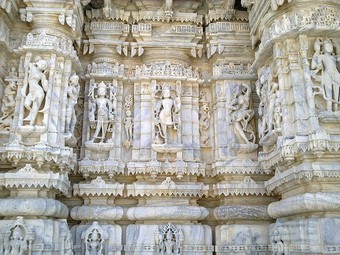
An Elaborate Mirpur Jain Temple Wall
The Jain Temple in Mirpur, India, was built c. 800 CE.
Jainism Beliefs
The
distinguishing features of Jain philosophy are its belief in the independent
existence of soul and matter; the denial of a creative and omnipotent God, combined with a belief in an eternal universe; and a strong
emphasis on non-violence, morality, and ethics. The word Jain derives from the
Sanskrit word jina, meaning conqueror, and the ultimate aim of Jain life is to
achieve liberation of the soul.
The predominance
of karma is one of the key features of
Jainism. Karma is the sum of a person’s actions in this and previous lives that
determine his or her fate in future existences. A Sanskrit word, karma means action,
word, or deed. Its focus is on the spiritual principle of cause and effect, with
individual actions influencing individual effects. Good intent and good deeds
contribute to good karma and future happiness, while bad intent and deeds
produce bad karma and future suffering. Karma is a concept associated with
rebirth, or the idea that death is the beginning of a new existence. This idea also
appears in other Asian religions, including Buddhism.
The
motto of Jainism is Parasparopagraho Jivanam, meaning “the function of souls is
to help one another.” This is associated with the idea of good deeds, and is incorporated
into the main principles of Jainism: ahimsa, non-violence; anekantavada,
non-absolutism; and aparigraha, non-possessiveness or non-attachment. Followers
take five main vows that include ahimsa and aparigraha, as well as satya, not
lying; asteya, not stealing; and brahmacharya, chastity. Jain monks and nuns
adhere to these vows absolutely, placing Jainism squarely in the ascetic and
self-discipline traditions of Sramana.
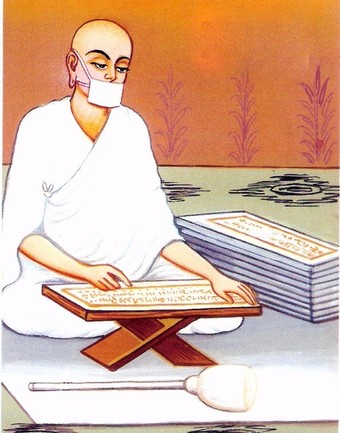
Jain Monk
An image of a Jain monk meditating over religious texts.
Jainism Followers
The
majority of Jains live in India, which counts between 4 and 6 million
followers. Some of the largest Jain communities outside India are in the United
States, which has more than 79,000 followers; Kenya, which has nearly 69,000
adherents; the United Kingdom, which counts nearly 17,000 followers; and Canada,
with approximately 12,000 followers. Other countries with notable Jain
populations include Tanzania, Nepal, Uganda, Burma, Malaysia, South Africa,
Fiji, Australia, and Japan.
Contemporary
Jainism is divided into two major schools, or sects, called Digambara and
Svetambara. The Svetambara, meaning “white clad,” describes its ascetic
adherents’ practice of wearing white clothes, while the monks of the “sky clad” Digambara do not wear clothing at all, a practice upon which they disagree.
The most important religious festival of Jainism is Mahavir Jayanti,
which celebrates the birth of Mahavira—the 24th and last Tirthankara, or
teaching god. Other important festivals include Diwali, marking the Nirvana, or
liberation, of Mahavira’s soul; and the holy event of Paryushana, also known as
Das Lakshana, which is a period of between eight and ten days in August or
September of fasting, prayer, and meditation.
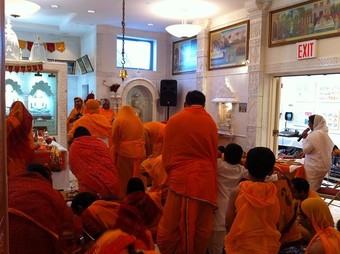
Paryushana Celebrations
Followers of Jainism celebrate Paryushana at the Jain Center of America in New York City.
6.4: The Persian Empire
6.4.1: The Achaemenid Empire
Under Cyrus the Great and Darius the Great, the Achaemenid Empire became the first global empire.
Learning Objective
Discuss the Achaemenid as the first global empire
Key Points
- Around 550 BCE, Cyrus
the Great (Cyrus
II) conquered the Median
Empire and
started the expansion of the Achaemenid Empire, assimilating the neighboring
Lydian and Neo-Babylonian empires. - Cyrus the Great was succeeded by
his son Cambryses II in 530 BCE and then the usurper Gaumata, and finally by Darius
the Great in
522 BCE. - By the time of Darius the Great
and his son, Xerxes, the Achaemenid Empire had expanded to include Mesopotamia,
Egypt, Anatolia, the Southern Caucasus, Macedonia, the western Indus basin, as well as parts of Central Asia, northern Arabia and northern Libya. - At its height around 475 BCE, the
Achaemenid Empire ruled over 44% of the world’s population, the highest figure
for any empire in history.
Key Terms
- Median Empire
-
One of the four
major powers of the ancient Near East (with Babylonia, Lydia, and Egypt), until it was conquered by Cyrus the Great in 550 BCE. - Pasargadae
-
The capital of
the Achaemenid Empire under Cyrus the Great. - Cyrus the Great
-
Cyrus II of
Persia, also known as Cyrus the Great, created the largest empire the world had
seen. - Darius the Great
-
The third king of
the Persian Achaemenid Empire, who ruled at its peak from c. 522-486 BCE.
The
Achaemenid Empire, c. 550-330 BCE, or First Persian Empire,
was founded in the 6th century BCE by Cyrus the Great, in Western and Central
Asia. The dynasty drew its name from Achaemenes, who, from 705-675 BCE, ruled
Persis, which was land bounded on the west by the Tigris River and on the south by the
Persian Gulf. It was the first centralized nation-state, and during expansion in
approximately 550-500 BCE, it became the first global empire and eventually ruled
over significant portions of the ancient world.
Empire Beginnings
By
the 7th century BCE, a group of ancient Iranian people had established the
Median Empire, a vassal state under the Assyrian Empire that later tried to gain its
independence in the 8th century BCE. After Assyria fell in 605 BCE, Cyaxares,
king of the Medes, extended his rule west across Iran.
Around 550 BCE, Cyrus II of Persia, who became known as Cyrus the Great,
rose in rebellion against the Median Empire, eventually conquering the Medes to
create the first Persian Empire, also known as the Achaemenid Empire. Cyrus utilized
his tactical genius, as well as his understanding of the socio-political
conditions governing his territories, to eventually assimilate the neighboring
Lydian and Neo-Babylonian empires into the new Persian Empire.
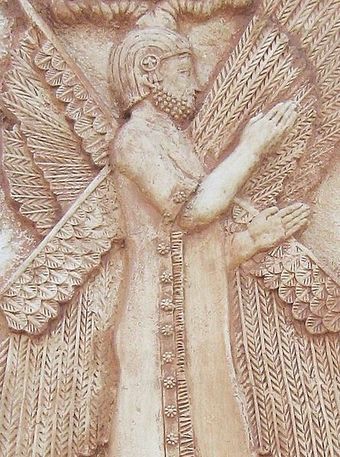
Relief of Cyrus the Great
Cyrus II of Persia,
better known as Cyrus the Great, was the founder of the Achaemenid Empire.
Under his rule, the empire assimilated all the civilized states of the ancient
Near East, and eventually conquered most of Southwest Asia and much of Central
Asia and the Caucasus.
Achaemenid
Expansion
The
empire was ruled by a series of monarchs who joined its disparate tribes by
constructing a complex network of roads. The unified form of the empire came in
the form of a central administration around the city of Pasargadae, which was erected by Cyrus
c. 550 BCE. After his death in 530 BCE, Cyrus was succeeded by his son
Cambyses II, who conquered Egypt, Nubia, and Cyrenaica in 525 BCE; he died
in 522 BCE during a revolt.
During
the king’s long absence during his expansion campaign, a Zoarastrian priest, named Guamata, staged a coup by impersonating Cambryses II’s
younger brother, Bardiya, and seized the throne. Yet in 522 BCE, Darius I, also
known as Darius the Great, overthrew Gaumata and solidified control of the
territories of the Achaemenid Empire, beginning what would be a historic
consolidation of lands.
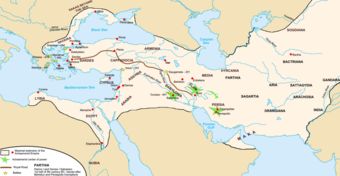
Achaemenid Empire in the time of Darius and Xerxes
At its height, the
Achaemenid Empire ruled over 44% of the world’s population, the highest figure
for any empire in history.
Between
c. 500-400 BCE, Darius the Great and his son, Xerxe I, ruled the Persian Plateau
and all of the territories formerly held by the Assyrian Empire, including
Mesopotamia, the Levant, and Cyprus. It eventually came
to control Egypt, as well. This expansion continued even further afield with
Anatolia and the Armenian Plateau, much of the Southern Caucasus, Macedonia,
parts of Greece and Thrace, Central Asia as far as the Aral Sea, the Oxus and
Jaxartes areas, the Hindu Kush and the western Indus basin, and
parts of northern Arabia and northern Libya.
This
unprecedented area of control under a single ruler stretched from the Indus
Valley in the east to Thrace and Macedon on the northeastern border of
Greece. At its height, the Achaemenid Empire ruled over 44% of the world’s
population, the highest such figure for any empire in history.
6.4.2: Government and Trade in the Achaemenid Empire
Emperors Cyrus II and Darius I created a centralized government
and extensive trade network in the Achaemenid Empire.
Learning Objective
Discuss how the central government provided cultural and economic reform
Key Points
- Cyrus
the Great maintained
control over a vast empire by installing regional governors, called satraps, to
rule individual provinces. -
When Darius
the Great ascended
the throne in 522 BCE, he organized a new uniform monetary system and
established Aramaic as
the official language of the empire. - Trade infrastructure facilitated
the exchange of commodities in the far reaches of the empire, including the Royal
Road, standardized language, and a postal service. - Tariffs on trade from the
territories were one of the empire’s main sources of revenue, in addition to agriculture and tribute.
Key Terms
- Cyrus Cylinder
-
An ancient clay artifact that has been called the oldest-known charter of human rights.
- Behistun
Inscription -
An inscription carved in a cliff face of Mount Behistrun in Iran; it provided a key to deciphering cuneiform script.
- satrap
-
The governor of a province in the ancient Median and Achaemenid (Persian) Empires.
- satrapy
-
The territory under the rule of a satrap.
The
Achaemenid Empire reached enormous size under the leadership of Cyrus II of
Persia (576-530 BCE), commonly known as Cyrus the Great, who created a multi-state
empire. Called Cyrus the Elder by the Greeks, he founded an empire initially
comprising all the previous civilized states of the ancient Near East and eventually
most of Southwest and Central Asia and the Caucus region, stretching from the
Mediterranean Sea to the Indus River. Control of this large territory involved a
centralized government, territorial monarchs who served as proxy rulers for the
emperor, and an extensive system of commerce and trade.
Government
Organization
Cyrus,
whose rule lasted between 29 and 31 years, until his death in battle in 530 BCE, controlled the vast Achaemenid Empire through the use of regional
monarchs, called satrap, who each oversaw a territory called
a satrapy. The
basic rule of governance was based upon the loyalty and obedience of the satrapy to the central power, the king,
and compliance with tax laws. Cyrus also connected the various regions of the
empire through an innovative postal system that made use of an extensive
roadway and relay stations.
Cyrus
the Great was recognized for achievements in human rights and politics, having
influenced both Eastern and Western Civilization. The ancient Babylonians
called him “The Liberator,” while the modern nation of Iran calls Cyrus its “father.”
Cyrus
Cylinder
The
Cyrus Cylinder is an ancient clay artifact, now broken into several fragments, that
has been called the oldest-known charter of universal human rights and a symbol
of his humanitarian rule.
The
cylinder dates from the 6th century BCE, and was discovered in the ruins of
Babylon in Mesopotamia, now Iraq, in 1879. In addition to describing the
genealogy of Cyrus, the declaration in Akkadian cuneiform script on the
cylinder is considered by many Biblical scholars to be evidence of Cyrus’s policy
of repatriation of the Jewish people following their captivity in Babylon.
The
historical nature of the cylinder has been debated, with some scholars arguing
that Cyrus did not make a specific decree, but rather that the cylinder
articulated his general policy allowing exiles to return to their homelands and
rebuild their temples.
In fact, the policies of Cyrus with respect to treatment
of minority religions were well documented in Babylonian texts, as well as in Jewish sources. Cyrus was known to have an overall attitude of religious
tolerance throughout the empire, although it has been debated whether this was
by his own implementation or a continuation of Babylonian and Assyrian
policies.
Darius Improvements
When
Darius I (550-486 BCE), also known as Darius the Great, ascended the throne of
the Achaemenid Empire in 522 BCE, he established Aramaic as the official
language and devised a codification of laws for Egypt. Darius also sponsored work
on construction projects throughout the empire, focusing on improvement of the cities
of Susa, Pasargadae, Persepolis, Babylon, and
various municipalities in Egypt.
When
Darius moved his capital from Pasargadae to Persepolis, he revolutionized the
economy by placing it on a silver and gold coinage and introducing a regulated
and sustainable tax system. This structure precisely tailored the taxes of each satrapy
based on its projected productivity and economic potential. For example,
Babylon was assessed for the highest amount of silver taxes, while Egypt owed grain
in addition to silver taxes.
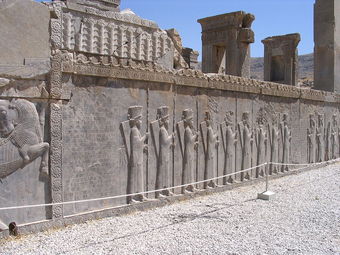
Persian reliefs in the city of Persepolis
Darius the Great moved the capital of the Achaemenid Empire to Persepolis c. 522 BCE. He initiated several major architectural projects, including the construction of a palace and a treasure house.
Behistun
Inscription
Sometime
after his coronation, Darius ordered an inscription to be carved on a limestone cliff
of Mount Behistun in modern Iran. The Behistun Inscription, the text of which
Darius wrote, came to have great linguistic significance as a crucial clue in
deciphering cuneiform script.
The
inscription begins by tracing the ancestry of Darius, followed by a description
of a sequence of events following the deaths of the previous two Achaemenid
emperors, Cyrus the Great and Cyrus’s son, Cambyses II, in which Darius fought
19 battles in one year to put down numerous rebellions throughout the Persian
lands.
The inscription,
which is approximately 15 meters high and 25 meters wide, includes three
versions of the text in three different cuneiform languages: Old Persian,
Elamite and Babylonian, which was a version of Akkadian. Researchers were able
to compare the scripts and use it to help decipher ancient languages, in this
way making the Behistun Inscription as valuable to cuneiform as the Rosetta
Stone is to Egyptian hieroglyphs.
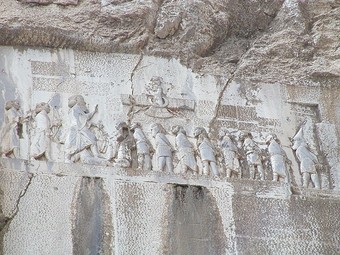
Behistun Inscription
A section of the Behistun Inscription on a limestone cliff of Mount Behistun in western Iran, which became a key in deciphering cuneiform script.
Commerce
and Trade
Under
the Achaemenids, trade was extensive and there was an efficient infrastructure
that facilitated the exchange of commodities in the far reaches of the empire.
Tariffs on trade were one of the empire’s main sources of revenue, in addition to agriculture and tribute.
The satrapies were linked by a 2,500-kilometer
highway, the most impressive stretch of which was the Royal Road, from Susa to
Sardis. The relays of mounted couriers could reach the most remote areas in 15
days. Despite the relative local independence afforded by the satrapy system, royal inspectors regularly
toured the empire and reported on local conditions using this route.
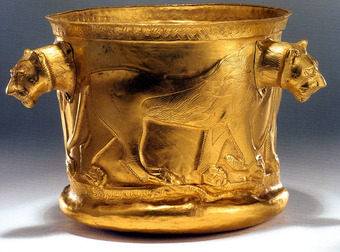
Achaemenid golden bowl with lion imagery
Trade in the Achaemenid Empire was extensive. Infrastructure, including the Royal Road, standardized language, and a postal service facilitated the exchange of commodities in the far reaches of the empire.
Military
Cyrus
the Great created an organized army to enforce national authority, despite the ethno-cultural
diversity among the subject nations, the empire’s enormous geographic size, and
the constant struggle for power by regional competitors.
This
professional army included the Immortals unit, comprising 10,000 highly trained
heavy infantry. Under Darius the Great, Persia would become the first empire to
inaugurate and deploy an imperial navy, with personnel that included Phoenicians,
Egyptians, Cypriots, and Greeks.
6.4.3: Zoroastrianism
Zoroastrianism, an ancient Persian religion, had a major influence on the culture and religion of all other monotheistic religions in the region.
Learning Objective
Explain Zoroastrianism and its impact on Persian culture
Key Points
- Zoroastrianism is ascribed to the teachings of Zoroaster, an Iranian prophet, who worshiped Ahura Mazda (Wise Lord), as its Supreme Being.
- Leading characteristics, such as messianism, heaven and hell, and free will are said to have influenced other religious systems, including Second Temple Judaism, Gnosticism, Christianity, and Islam.
- Zoroastrianism served as the state religion of the pre-Islamic Iranian empires from c. 600 BCE to 650 CE, but saw a steep decline after the Muslim conquest of Persia.
- The religion states that active participation in life through good deeds is necessary to ensure happiness and to keep chaos at bay.
Key Terms
- eschatological
-
A part of theology concerned with the final events of history, or the ultimate destiny of humanity, often referred to as the “end times.”
- Sassanids
-
The last Iranian empire before the rise of Islam.
- Gnosticism
-
A modern term categorizing a collection of ancient religions whose adherents shunned the material world—
which they viewed as created by the demiurge—and embraced the spiritual world.
- messianism
-
The belief in a messiah, who acts as a savior, redeemer or liberator of a group of people.
Overview and Theology
Zoroastrianism is one of the world’s oldest religions. It ascribed to the teachings of the Iranian prophet Zoroaster (or Zarathustra), and exalted their deity of wisdom, Ahura Mazda (Wise Lord), as its Supreme Being. Leading characteristics, such as messianism, heaven and hell, and free will are said to have influenced other religious systems, including Second Temple Judaism, Gnosticism, Christianity, and Islam. With possible roots dating back to the second millennium BCE, Zoroastrianism enters recorded history in the 5th-century BCE. It served as the state religion of the pre-Islamic Iranian empires from around 600 BCE to 650 CE. Zoroastrianism was suppressed from the 7th century onwards, following the Muslim conquest of Persia. Recent estimates place the current number of Zoroastrians at around 2.6 million, with most living in India and Iran.
The most important texts of the religion are those of the Avesta, which includes the writings of Zoroaster, known as the Gathas and the Yasna. The Gathas are enigmatic poems that define the religion’s precepts, while the Yasna is the scripture. The full name by which Zoroaster addressed the deity is: Ahura, The Lord Creator, and Mazda, Supremely Wise. He proclaimed that there is only one God, the singularly creative and sustaining force of the Universe. He also stated that human beings are given a right of choice, and because of cause and effect are also responsible for the consequences of their choices. The contesting force to Ahura Mazda was called Angra Mainyu, or angry spirit. Post-Zoroastrian scripture introduced the concept of Ahriman, the Devil, which was effectively a personification of Angra Mainyu.
In Zoroastrianism, water (apo, aban) and fire (atar, azar) are agents of ritual purity, and the associated purification ceremonies are considered the basis of ritual life. In Zoroastrian cosmogony, water and fire are respectively the second and last primordial elements to have been created, and scripture considers fire to have its origin in the waters. Both water and fire are considered life-sustaining, and both water and fire are represented within the precinct of a fire temple. Zoroastrians usually pray in the presence of some form of fire (which can be considered evident in any source of light), and the culminating rite of the principle act of worship constitutes a “strengthening of the waters.” Fire is considered a medium through which spiritual insight and wisdom is gained, and water is considered the source of that wisdom.
The religion states that active participation in life through good deeds is necessary to ensure happiness and to keep chaos at bay. This active participation is a central element in Zoroaster’s concept of free will, and Zoroastrianism rejects all forms of monasticism. Ahura Mazda will ultimately prevail over the evil Angra Mainyu or Ahriman, at which point the universe will undergo a cosmic renovation and time will end. In the final renovation, all of creation—even the souls of the dead that were initially banished to “darkness”—will be reunited in Ahura Mazda, returning to life in the undead form. At the end of time, a savior-figure (a Saoshyant) will bring about a final renovation of the world (frashokereti), in which the dead will be revived.
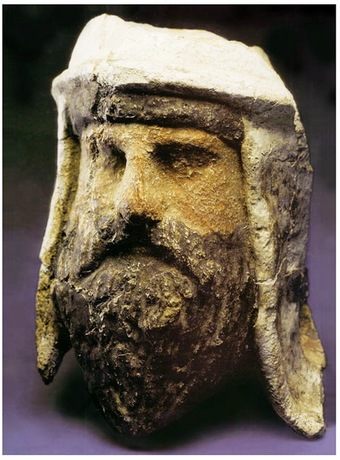
Zoroastrian Priest
Painted clay and alabaster head of a Zoroastrian priest wearing a distinctive Bactrian-style headdress, Takhti-Sangin, Tajikistan, Greco-Bactrian kingdom, 3rd-2nd century BCE.
History
The roots of Zoroastrianism are thought to have emerged from a common prehistoric Indo-Iranian religious system dating back to the early 2nd millennium BCE. The prophet Zoroaster himself, though traditionally dated to the 6th century BCE, is thought by many modern historians to have been a reformer of the polytheistic Iranian religion who lived in the 10th century BCE. Zoroastrianism as a religion was not firmly established until several centuries later. Zoroastrianism enters recorded history in the mid-5th century BCE. Herodotus’ The Histories (completed c. 440 BCE) includes a description of Greater Iranian society with what may be recognizably Zoroastrian features, including exposure of the dead.
The Histories is a primary source of information on the early period of the Achaemenid era (648-330 BCE), in particular with respect to the role of the Magi. According to Herodotus i.101, the Magi were the sixth tribe of the Medians (until the unification of the Persian empire under Cyrus the Great, all Iranians were referred to as “Mede” or “Mada” by the peoples of the Ancient World). The Magi appear to have been the priestly caste of the Mesopotamian-influenced branch of Zoroastrianism today known as Zurvanism, and they wielded considerable influence at the courts of the Median emperors.
Darius I, and later Achaemenid emperors, acknowledged their devotion to Ahura Mazda in inscriptions (as attested to several times in the Behistun inscription), and appear to have continued the model of coexistence with other religions. Whether Darius was a follower of Zoroaster has not been conclusively established, since devotion to Ahura Mazda was (at the time) not necessarily an indication of an adherence to Zoroaster’s teaching. A number of the Zoroastrian texts that today are part of the greater compendium of the Avesta have been attributed to that period.
The religion would be professed many centuries following the demise of the Achaemenids in mainland Persia and the core regions of the former Achaemenid Empire—
most notably Anatolia, Mesopotamia, and the Caucasus. In the Cappadocian kingdom (whose territory was formerly an Achaemenid possession), Persian colonists who were cut off from their co-religionists in Iran proper continued to practice the Zoroastrianism of their forefathers. There, Strabo, observing in the first century BCE, records that these “fire kindlers” possessed many “holy places of the Persian Gods,” as well as fire temples. Strabo furthermore relates, that they were “noteworthy enclosures; and in their midst there is an altar, on which there is a large quantity of ashes and where the magi keep the fire ever burning.” Throughout, and after, the Hellenistic periods in the aforementioned regions, the religion would be strongly revived.
As late as the Parthian period, a form of Zoroastrianism was without a doubt the dominant religion in the Armenian lands. The Sassanids aggressively promoted the Zurvanite form of Zoroastrianism, often building fire temples in captured territories to promote the religion. During the period of their centuries long suzerainty over the Caucasus, the Sassanids made attempts to promote Zoroastrianism there with considerable successes. It was also prominent in the pre-Christian Caucasus (especially modern-day Azerbaijan).
6.5: The Maurya Empire
6.5.1: Rise of the Maurya Empire
Chandragupta Maurya founded the Maurya Empire in 322 BCE when he conquered the kingdom of Magadha and the northwestern Macedonian satrapies.
Learning Objective
Understand the history and significance of the Maurya Empire
Key Points
- The Maurya Empire was founded in 322 BCE by Chandragupta Maurya, who had overthrown the Nanda Dynasty and rapidly expanded his power westward across central and western India in order to take advantage of the disruptions of local powers in the wake of the withdrawal by Alexander the Great’s armies.
- According to legend, the teacher Chanakya convinced his disciple, Chandragupta Maurya, to conquer the the kingdom of Magadha (the Nanda Empire) when he was insulted by its king Dhana Nanda.
- Chandragupta Maurya expanded the Maurya Empire north and west as he conquered the Macedonian Satrapies and won the Seleucid-Mauryan war.
- In its time, the Maurya Empire was one of the largest empires of the world.
Key Terms
- Takshashila
-
An early city in modern-day Pakistan that was believed to be one of the earliest global settings of learning and culture. It is now modern-day Taxila.
- Chanakya
-
Maurya’s teacher and loyal advisor during the foundation and expansion of the Maurya Empire.
- Nanda Empire
-
The kingdom led by Dhana Nanda; it was conquered by Chandragupta Maurya in 321 BCE.
- Chandragupta Maurya
-
The founder of the Maurya Empire; he lived from 340-298 BCE.
The Maurya Empire was a geographically extensive Iron Age historical power in ancient India, ruled by the Maurya dynasty from 322-185 BCE. Originating from the kingdom of Magadha in the Indo-Gangetic Plain (modern Bihar, eastern Uttar Pradesh) in the eastern side of the Indian subcontinent, the empire had its capital city at Pataliputra (modern Patna). The empire was the largest to have ever existed in the Indian subcontinent, spanning over 5 million square kilometres at its zenith under Ashoka.
The Empire was founded in 322 BCE by Chandragupta Maurya, who had overthrown the Nanda Dynasty, and rapidly expanded his power,with Chanakya’s help, westward across central and western India. His expansion took advantage of the disruptions of local powers in the wake of the withdrawal westward by Alexander the Great’s armies. By 316 BCE, the empire had fully occupied Northwestern India, defeating and conquering the satraps left by Alexander. Chandragupta then defeated the invasion led by Seleucus I, a Macedonian general from Alexander’s army, and gained additional territory west of the Indus River.
In its time, the Maurya Empire was one of the largest empires of the world. At its greatest extent, the empire stretched to the north along the natural boundaries of the Himalayas, to the east into Assam, to the west into Balochistan (southwest Pakistan and southeast Iran) and into the Hindu Kush mountains of what is now Afghanistan. The Empire was expanded into India’s central and southern regions by the emperors Chandragupta and Bindusara, but it excluded a small portion of unexplored tribal and forested regions near Kalinga (modern Odisha), until it was conquered by Ashoka. It declined for about 50 years after Ashoka’s rule ended, and it dissolved in 185 BCE with the foundation of the Shunga Dynasty in Magadha.
Conquest of Magadha and foundation of the Maurya Empire (c. 321 BCE)
According to several legends, Chanakya traveled to Magadha, a kingdom that was large and militarily powerful and feared by its neighbors, but was insulted by its king Dhana Nanda, of the Nanda Dynasty. Chanakya swore revenge and vowed to destroy the Nanda Empire.
The Nanda Empire originated from the region of Magadha in ancient India during the 4th century BCE, and lasted until between 345-321 BCE. At its greatest extent, the empire ruled by the Nanda Dynasty extended from Bengal in the east, to the Punjab region in the west, and as far south as the Vindhya Range. The rulers of this dynasty were famed for the great wealth that they accumulated.
Chanakya encouraged the young Chandragupta Maurya and his army to take over the throne of Magadha. Using his intelligence network, Chandragupta gathered many young men from across Magadha and other provinces, who were upset over the corrupt and oppressive rule of King Dhana, as well as the resources necessary for his army to fight a long series of battles. These men included the former general of Taxila, accomplished students of Chanakya, the representative of King Porus of Kakayee, his son Malayketu, and the rulers of small states.
Maurya devised a strategy to invade Pataliputra, the capital of the Nanda Empire. A battle was announced and the Magadhan army was drawn from the city to a distant battlefield in order to engage Maurya’s forces. Meanwhile, Maurya’s general and spies bribed the Nanda’s corrupt general, and created an atmosphere of civil war in the kingdom, which culminated in the death of the heir to the throne.
Upon the civil unrest in the kingdom, Nanda resigned and disappeared into exile. Chanakya contacted the prime minister, Rakshasa, and convinced him that his loyalty was to Magadha, not to the Nanda Dynasty, and that he should remain in office. Chanakya reiterated that choosing to resist would start a war that would severely affect Magadha and destroy the city. Rakshasa accepted Chanakya’s reasoning, and Chandragupta Maurya was legitimately installed as the new King of Magadha in 321 BCE, at the age of 21. Rakshasa became Chandragupta’s chief advisor, and Chanakya assumed the position of an elder statesman.
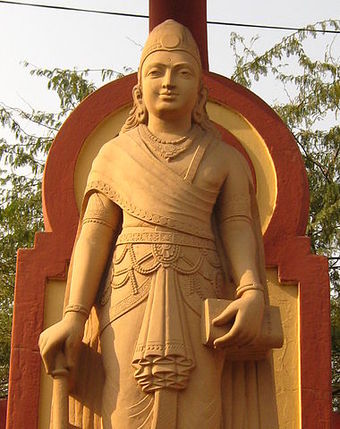
Statue of Chandragupta Maurya at the Birla Mandir Hindu temple, Delhi
Chandragupta Maurya conquered the kingdom of Magadha to found the Maurya Empire in 231 BCE, at the age of 21.
Northwest Expansion
With his new seat of power in Magadha, Chandragupta Maurya defeated the remaining Macedonian satraps, and consolidated his reign of the new Maurya Empire. He rapidly expanded his power westward across central and western India, taking advantage of the disruptions of local powers in the wake of the withdrawal westward by Alexander the Great’s Greek armies. By 320 BCE, the empire had fully occupied Northwestern India. Chandragupta Maurya would become the first emperor to unify India into one state, creating one of the world’s largest empires in its time, and the largest ever in the Indian subcontinent.
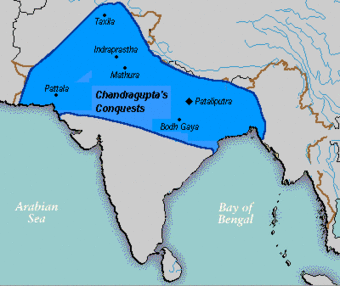
The Maurya Empire c. 320 BCE
The Maurya Empire when it was first founded by Chandragupta Maurya c. 320 BCE, after conquering the Nanda Empire when he was only about 20 years old.
6.5.2: Expansion of the Maurya Empire
After winning the Seleucid-Mauryan war, the Maurya Empire expanded into the southern Indian subcontinent under the rule of Ashoka the Great.
Learning Objective
Understand the expansion of the Maurya Empire
Key Points
- The Seleucid Empire tried and failed to reconquer the northwestern part of the Maurya Empire during the Seleucid-Mauryan war, from 305-303 BCE.
- As part of the peace offering, the Maurya Empire gained five territories in exchange for 500 war elephants.
- Several Greeks remained at the Mauryan court as ambassadors to the Hellenistic world.
- Chandragupta Maurya was succeed by his son, Bindusara, in 298 BCE, and then by Bindusara’s son, Ashoka the Great, in 272 BCE.
- Under Ashoka the Great, the Maurya Empire expanded into the southern part of the Indian subcontinent.
- Ashoka erected the Edicts of Ashoka, which state his policies and accomplishments, and which were written in both Greek and Sanskrit.
Key Terms
- satrapies
-
The governors of the provinces of the ancient Median and Achaemenid (Persian) Empires, and several of their successors, such as the Sasanian Empire and the Hellenistic empires.
- Edicts of Ashoka
-
Stone edicts that depicted the policies and accomplishments of Ashoka the Great, and were written in both Greek and Sanskrit.
- Ashoka the Great
-
Lived 304-232 BCE. As the king of the Maurya Empire, he conquered the Indian subcontinent.
- Seleucus
-
The king of the Seleucid Empire who tried to reconquer northwestern Indian, but lost the Selecucid-Mauryan War.
The Seleucid-Mauryan War
In 305 BCE, Emperor Chandragupta Maurya led a series of campaigns to retake the satrapies left behind by Alexander the Great when he returned westward. Seleucus I fought to defend these territories, but both sides made peace in 303 BCE.
Seleucus, one of Alexander’s generals, received Babylonia and, from there, expanded his dominions to include much of Alexander’s near eastern territories. Seleucus established himself in Babylon in 312 BC, the year used as the foundation date of the Seleucid Empire. He ruled not only Babylonia, but the entire enormous eastern part of Alexander’s empire. The Seleucid Empire was a major center of Hellenistic culture. In the areas where a Greek-Macedonian political elite dominated (mostly urban), it maintained the preeminence of Greek customs.
In 305 BCE, Seleucus I tried to reconquer the northwestern parts of India in order to claim them for the growing Seleucid Empire. Little is known of the campaign in which Chandragupta fought with Seleucus over the Indus Valley and the region of Gandhara—
a very wealthy kingdom that had submitted decades earlier to Alexander the Great.
Seleucus lost the Seleucid-Mauryan War, and the two rulers reconciled with a peace treaty. The Greeks offered a Macedonian princess for marriage to Chandragupta, and several territories, including the satrapies of Paropamisade (modern-day Kamboja and Gandhara), Arachosia (modern-day Kandhahar), and Gedrosia (modern-day Balochistan). In return, Chandragupta sent 500 war elephants, a military asset which would play a decisive role in Seleucus’ victory against western Hellenistic kings at the Battle of Ipsus in 301 BCE.
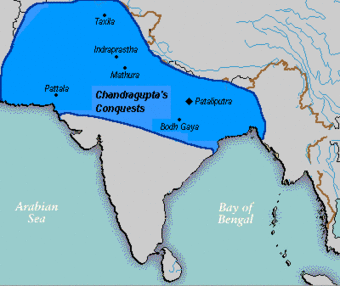
The Maurya Empire c. 305 BCE
Chandragupta extended the borders of the Maurya Empire toward Seleucid Persia, after defeating Seleucus c. 305 BCE.
In addition to this treaty, Seleucus dispatched two Greek ambassadors, Megasthenes and, later, Deimakos, to the Mauryan court at Pataliputra. Later, Ptolemy II Philadelphus, the ruler of Ptolemaic Egypt, sent an ambassador named Dionysius to the Mauryan court. Thus, continuing ties between the Hellenistic world and the Mauryan Empire.
Expansion Under Bindusara
Chandragupta Maurya ruled from 322 BCE until his voluntary retirement and abdication, in favor of his son, Bindusara, in 298 BCE. Bindusara (320-272 BCE) was the son of Maurya and his queen, Durdhara. During his reign, Bindusara expanded the Maurya Empire southward, with Chanakya as his advisor. He brought 16 states under the Maurya Empire and thus conquered almost all of the Indian peninsula. Bindusara ignored the friendly Dravidian kingdoms of the Cholas, ruled by King Ilamcetcenni, the Pandyas, and Cheras. Apart from these southern states, Kalinga (modern-day Odisha) was the only kingdom in India independent from Bindusara’s empire.
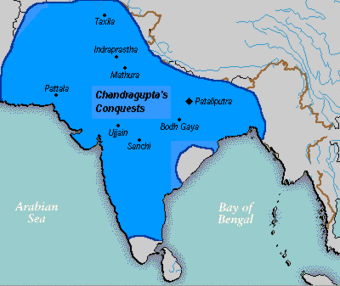
The Maurya Empire c. 290 BCE
Bindausara (ruler 298-272 BCE) extended the borders of the empire southward into the Deccan Plateau c. 290 BCE.
Ashoka the Great
Bindusara died in 272 BCE, and was succeeded by his son, Ashoka the Great (304-232 BCE). As a young prince, Ashoka (r. 272-232 BCE) was a brilliant commander who crushed revolts in Ujjain and Taxila. As monarch, he was ambitious and aggressive, reasserting the Empire’s superiority in southern and western India. But it was his conquest of Kalinga (262-261 BCE) that proved to be the pivotal event of his life. Although Ashoka’s army succeeded in overwhelming Kalinga forces of royal soldiers and civilian units, an estimated 100,000 soldiers and civilians were killed in the furious warfare, including over 10,000 of Ashoka’s own men. Hundreds of thousands of people were adversely affected by the destruction and fallout of war. When he personally witnessed the devastation, Ashoka began feeling remorse. Although the annexation of Kalinga was completed, Ashoka embraced the teachings of Buddhism, and renounced war and violence. He sent out missionaries to travel around Asia and spread Buddhism to other countries.
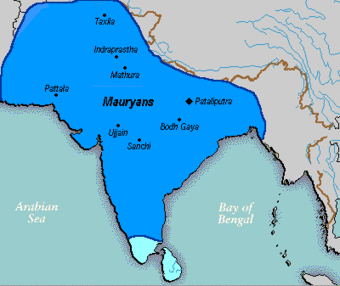
Extent of the Maurya Empire at its height in 265 BCE
Ashoka the Great extended into Kalinga during the Kalinga War c. 265 BCE, and established superiority over the southern kingdoms.
As ruler, Ashoka implemented principles of ahimsa (the principle of “to not injure”) by banning hunting and violent sports activities, and ending indentured and forced labor (many thousands of people in war-ravaged Kalinga had been forced into hard labor and servitude). While he maintained a large and powerful army to keep the peace, Ashoka expanded friendly relations with states across Asia and Europe, and sponsored Buddhist missions. He undertook a massive public works building campaign across the country. Among these works were the construction of stupas, or Buddhist religious structures, containing relics. One notable stupas created during the reign of Ashoka was The Great Stupa, which stands in Sanchi, India. Over 40 years of peace, harmony, and prosperity made Ashoka one of the most successful and famous monarchs in Indian history. He remains an idealized figure of inspiration in modern India.
The Edicts of Ashoka
Perhaps one of the greatest-known accomplishments of Ashoka was his creation of his edicts, which were erected between 269 BCE and 232 BCE. The Edicts of Ashoka, set in stone, are found throughout the Subcontinent. Ranging from as far west as Afghanistan, and as far south as Andhra (Nellore District), Ashoka’s edicts state his policies and accomplishments. Although predominantly written in Prakrit, two of them were written in Greek, and one in both Greek and Aramaic. Ashoka’s edicts refer to the Greeks, Kambojas, and Gandharas as peoples forming a frontier region of his empire. They also attest to Ashoka’s envoys’ travels to the Greek rulers in the west as far as the Mediterranean. Ashoka’s edicts also mentioned social and cultural attributes of his empire, emphasizing Buddhism, though not condemning other religions. For this, the Edicts of Ashoka are known as an early document that promoted religious tolerance.
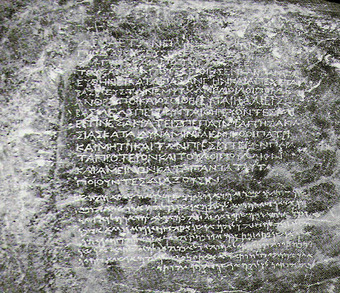
An Edict of Asoka
Bilingual inscription (Greek and Aramaic) by king Asoka, from Kandahar. Kabul Museum
6.5.3: Centralization in the Maurya Empire
The Mauryan Empire encouraged economic prosperity through political
stability and a unified central government.
Learning Objective
Describe the significance of the political stability offered by the Mauryan Empire
Key Points
-
The Mauryan Empire was divided
into four provinces, each governed by the Kumara,
who served as the king’s representative. - Emperor Ashoka maintained a
massive standing
army to
protect the Mauryan Empire and instill stability and peace across West and
South Asia. - Chandragupta
Maurya, Ashoka’s
grandfather, had established a single currency
across India, a network of regional governors and administrators, and a civil
service to provide justice and security for merchants, farmers and traders that
continued throughout the Mauryan Dynasty. - The Mauryan international network
of trade extended to the Greek states and Hellenic kingdoms
in West Asia and into Southeast Asia.
Key Terms
- Arthashastra
-
An ancient Indian treatise on government, statecraft, military, and economy.
- Khyber Pass
-
A strategically important trade stop on the modern boundary of Pakistan and Afghanistan.
- standing army
-
A permanent army composed of full-time soldiers that is not disbanded during times of peace.
- Kumara
-
A royal prince who oversaw the Mauryan provinces on behalf of the emperor.
Employing
a carefully organized bureaucratic system, the Maurya Empire was able to
maintain security and political unity across large parts of western and southern
Asia. This included a common economic system supporting stable agriculture in
its vast landholdings, as well as successful trade and commerce. Through this
centralized authority, which included a powerful military, the rulers of the
empire bound together the previously fractured regions of the Indian Subcontinent.
Unification
and Military
Chandragupta
Maurya, the founder of the Maurya Empire, ruled from 324-297 BCE, before voluntarily abdicating in favor of his son, Bindusara, who ruled
from 297 BCE until his death in 272 BCE. This led to a war of succession in which Bindusara’s
son, Ashoka, defeated his brother, Susima, and rose to the throne in 268 BCE, eventually
becoming the greatest ruler of the Maurya Dynasty.
Before
the Mauryan Empire, the Indian subcontinent was fragmented into hundreds of
kingdoms. These were ruled by powerful regional chieftains with small armies that
engaged in internecine warfare. The Mauryan Army eliminated regional chieftains,
private armies, and even gangs of bandits, who sought to impose their own
supremacy in small areas.
The Mauryan
Army, the largest standing military force of its time, supported the expansion
and defense of the empire. According to scholars, the empire wielded 600,000
infantry, 30,000 cavalry, and 9,000 war elephants, while a vast espionage system
collected intelligence for both internal and external security purposes. Although
Emperor Ashoka renounced offensive warfare and expansionism, he maintained this
standing army to protect the empire from external threats and maintain
stability and peace across Western and Southern Asia.
Administration
The Mauryan
Empire was divided into four provinces, with the imperial capital at
Pataliputra, near the Ganges River in the modern state of Bihar in India. The Edicts of Ashoka, a collection of inscriptions
made during Ashoka’s reign from 268-232 BCE, give the names of the Maurya
Empire’s four provincial capitals: Tosali in the east, Ujjain in the west,
Suvarnagiri in the south, and Taxila in the north.
The
organizational structure began at the imperial level with the emperor and his
Mantriparishad, or Council of Ministers. The head of the provincial
administration was the Kumara, or royal prince, who governed the provinces as the
king’s representative, with the assistance of Mahamatyas, who were essentially regional
prime ministers. Through this sophisticated system of bureaucracy, the empire governed
all aspects of government at every level, from municipal hygiene to
international trade.
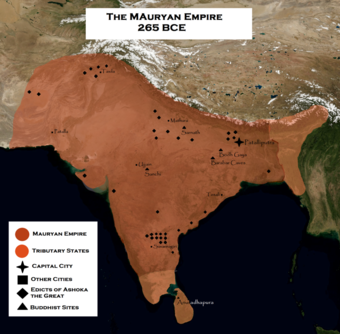
Maurya Empire at its greatest extent (dark orange), including vassal kingdoms (light orange), 265 BCE
The Maurya Empire provided political stability with a unified central government, which in turn encouraged economic prosperity.
Centralization
and Taxation
Chandragupta
Maurya, the father of the dynasty, established a single currency across India,
a network of regional governors and administrators, and a civil service to
provide justice and security for merchants, farmers, and traders.
Through
the disciplined central authority of the Mauryan Empire, farmers were freed of
tax and crop collection burdens from regional kings. Instead, they paid a
nationally administered system of taxation that was strict but fair. The system
operated under the principles of the Arthashastra,
an ancient Indian treatise on economic policy, statecraft, and military
strategy. Written in Sanskrit and adhering to Hindu philosophies, the Arthashastra includes books on the
nature of government, law, civil and criminal courts, ethics, and economic
topics, including markets and trade, agriculture, mineralogy, mining and metals,
forestry, and others.
Although
regimental in revenue collection, the Mauryan Empire funded numerous public
works projects to enhance productivity. Like his father and grandfather, Ashoka
sponsored the construction of thousands of roads, waterways, canals, rest houses,
hospitals, and other types of infrastructure.
Under
continued Mauryan rule, political unity and military security encouraged a
common economic system, increased agricultural productivity, and enhanced widespread
trade and commerce for the first time in West and South Asia.
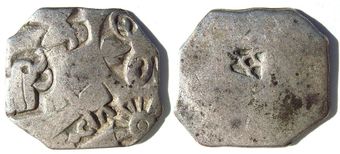
Coins of the Maurya Empire
Chandragupta Maurya established a single currency across India, including these silver punch mark coins with symbols of wheel and elephant, 3rd century BCE
Trade and
Commerce
The Maurya
Empire’s political unity and internal peace encouraged the expansion of trade
in India. Under the Indo-Greek friendship treaty during Ashoka’s reign, the
Mauryan international network of trade saw great expansion.
The Khyber Pass, on the modern boundary of
Pakistan and Afghanistan, became a strategically important point of trade and interaction
with the outside world. Greek states and Hellenic kingdoms in West Asia became
trading partners. Trade also extended through the Malay Peninsula into
Southeast Asia. India’s exports included silk, textiles, spices, and exotic
foods. The outside world gained new scientific knowledge and
technology through expanded trade with the Mauryan Empire.
6.5.4: Ashoka’s Conversion
Mauryan emperor Ashoka embraced Buddhism after witnessing the mass deaths of the Kalinga War, which he himself had waged out of a desire for conquest.
Learning Objective
Discuss the effects of Ashoka the Great’s conversion to Buddhism
Key Points
- While the early part of Ashoka’s reign was apparently quite bloodthirsty, he became a follower of the Buddha’s teachings after his conquest of Kalinga.
- According to a contemporary text, the Edicts of Ashoka, Ashoka converted to Buddhism because he “felt remorse on account of the conquest of Kalinga because, during the subjugation of a previously unconquered country, slaughter, death, and taking away captive of the people necessarily occur.”
- In one source, his conversion is presented as a gradual process coming from intense personal anguish, rather than spurred by a specific event.
- As a Buddhist emperor, Ashoka believed that Buddhism is beneficial for all human beings, as well as animals and plants, so he built a number of stupas. He also well spread Buddhism to neighboring kingdoms.
Key Terms
- Edicts of Ashoka
-
A collection of 33 inscriptions on the Pillars of Ashoka, as well as boulders and cave walls, made by the Emperor Ashoka of the Mauryan Empire during his reign, from 269 BCE to 232 BCE.
- Dharma
-
Cosmic law and order, behaviors that are considered to be in accord with the order that makes life and the universe possible, including duties, rights, laws, conduct, virtues, and ‘‘right way of living.” Also specifically signifies the teachings of the Buddha.
Background: Conquest of Kalinga
While the early part of Ashoka’s reign was apparently quite bloodthirsty, he became a follower of the Buddha’s teachings after his conquest of Kalinga on the east coast of India in the present-day states of Odisha and North Coastal Andhra Pradesh. Kalinga was a state that prided itself on its sovereignty and democracy. With its monarchical parliamentary democracy, it was quite an exception in ancient Bharata where there existed the concept of Rajdharma. Rajdharma means the duty of the rulers, which was intrinsically entwined with the concept of bravery and dharma. The Kalinga War happened eight years after his coronation. From Ashoka’s 13th inscription, we come to know that the battle was a massive one and caused the deaths of more than 100,000 soldiers and many civilians who rose up in defence; over 150,000 were deported. When he was walking through the grounds of Kalinga after his conquest, rejoicing in his victory, he was moved by the number of bodies strewn there and the wails of the bereaved.
Conversion to Buddhism
Edict 13 on the Edicts of Ashoka Rock Inscriptions reflect the great remorse the king felt after observing the destruction of Kalinga:
His Majesty felt remorse on account of the conquest of Kalinga because, during the subjugation of a previously unconquered country, slaughter, death, and taking away captive of the people necessarily occur, whereas His Majesty feels profound sorrow and regret.
The edict goes on to address the even greater degree of sorrow and regret resulting from Ashoka’s understanding that the friends and families of deceased would suffer greatly too.
Legend says that one day after the war was over, Ashoka ventured out to roam the city and all he could see were burnt houses and scattered corpses. The lethal war with Kalinga transformed the vengeful Emperor Ashoka into a stable and peaceful emperor, and he became a patron of Buddhism. According to the prominent Indologist, A. L. Basham, Ashoka’s personal religion became Buddhism, if not before, then certainly after the Kalinga War. However, according to Basham, the Dharma officially propagated by Ashoka was not Buddhism at all. Nevertheless, his patronage led to the expansion of Buddhism in the Mauryan empire and other kingdoms during his rule, and worldwide from about 250 BCE.
After the Kalinga War and Ashoka’s conversion, the Empire experienced nearly half a century of peace and security. Mauryan India also enjoyed an era of social harmony, religious transformation, and expansion of the sciences and of knowledge. Chandragupta Maurya’s embrace of Jainism increased social and religious renewal and reform across his society, while Ashoka’s embrace of Buddhism has been said to have been the foundation of the reign of social and political peace and non-violence across all of India.
Buddhist Kingship
One of the more enduring legacies of Ashoka Maurya was the model that he provided for the relationship between Buddhism and the state. Throughout Theravada Southeastern Asia, the model of rulership embodied by Ashoka replaced the notion of divine kingship that had previously dominated (in the Angkor kingdom, for instance). Under this model of “Buddhist kingship,” the king sought to legitimize his rule, not through descent from a divine source, but by supporting and earning the approval of the Buddhist sangha. Following Ashoka’s example, kings established monasteries, funded the construction of stupas, and supported the ordination of monks in their kingdom. Many rulers also took an active role in resolving disputes over the status and regulation of the sangha, as Ashoka had by calling a conclave to settle a number of contentious issues during his reign. This development ultimately led to a close association in many Southeast Asian countries between the monarchy and the religious hierarchy, an association that can still be seen today in the state-supported Buddhism of Thailand, and the traditional role of the Thai king as both a religious and secular leader. Ashoka also said that his courtiers always governed the people in a moral manner.
As a Buddhist emperor, Ashoka believed that Buddhism is beneficial for all human beings, as well as animals and plants, so he built a number of stupas, Sangharama, viharas, chaitya, and residences for Buddhist monks all over South Asia and Central Asia. According to the Ashokavadana, he ordered the construction of 84,000 stupas to house the Buddhas relics. In the Aryamanjusrimulakalpa, Ashoka takes offerings to each of these stupas, traveling in a chariot adorned with precious metals. He gave donations to viharas and mathas. He sent his only daughter, Sanghamitra, and son, Mahindra, to spread Buddhism in Sri Lanka (then known as Tamraparni).
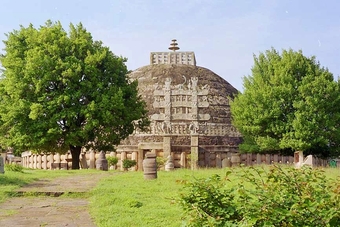
Stupa
Great Stupa (3rd century BC), Sanchi, India. Ashoka ordered the construction of 84,000 stupas to house the Buddhas relics.
Debate About Ashoka’s Conversion and Rule
The use of Buddhist sources in reconstructing the life of Ashoka has had a strong influence on perceptions of Ashoka, as well as the interpretations of his Edicts. Building on traditional accounts, early scholars regarded Ashoka as a primarily Buddhist monarch who underwent a conversion to Buddhism and was actively engaged in sponsoring and supporting the Buddhist monastic institution. Some scholars have tended to question this assessment. The only source of information not attributable to Buddhist sources are the Ashokan Edicts, and these do not explicitly state that Ashoka was a Buddhist. In his edicts, Ashoka expresses support for all the major religions of his time: Buddhism, Brahmanism, Jainism, and Ajivikaism. His edicts addressed to the population at large (there are some addressed specifically to Buddhists, which is not the case for the other religions) generally focus on moral themes that members of all the religions would accept.
However, the edicts alone strongly indicate that he was a Buddhist. In one edict he belittles rituals, and he banned Vedic animal sacrifices; these strongly suggest that he at least did not look to the Vedic tradition for guidance. Furthermore, many edicts are expressed to Buddhists alone; in one, Ashoka declares himself to be an “upasaka,” and in another he demonstrates a close familiarity with Buddhist texts. He erected rock pillars at Buddhist holy sites, but did not do so for the sites of other religions. He also used the word “dhamma” to refer to qualities of the heart that underlie moral action; this was an exclusively Buddhist use of the word. Finally, he promoted ideals that correspond to the first three steps of the Buddha’s graduated discourse.
Interestingly, the Ashokavadana, presents an alternate view of the familiar Ashoka. In this source, his conversion has nothing to do with the Kalinga War or his descent from the Maurya dynasty. Instead, Ashoka’s reason for adopting non-violence appears much more personal. The Ashokavadana shows that the main source of Ashoka’s conversion, and the acts of welfare that followed, are rooted instead in intense personal anguish, from a wellspring inside himself rather than spurred by a specific event. It thereby illuminates Ashoka as more humanly ambitious and passionate, with both greatness and flaws. This Ashoka is very different from the “shadowy do-gooder” of later Pali chronicles.
6.5.5: Decline of the Maurya Empire
The Sunga Dynasty usurped the Maurya Dynasty, and parts of the
empire were incorporated into the Indo-Greek Kingdom.
Learning Objective
Describe the factors that contributed to the decline of the Maurya Empire
Key Points
-
Ashoka
the Great’s rule was followed by 50 years of weak kings who did
not retain strong central authority. This eventually led to the dissolution of
the Maurya Empire. - General Pusyamitra Sunga staged
a coup against
the Maurya Dynasty in 185 BCE. As a result, he ascended the throne and founded the Sunga Dynasty. - In 180 BCE, the Greco-Bactrian
King Demetrius conquered the northwestern Indian territories and founded the
Indo-Greek Kingdom. - Buddhism lost
favor when the Sunga Dynasty gained power, but remained dominant in the
Ind0-Greek Kingdom.
Key Terms
- Khyber Pass
-
A mountain pass
connecting Afghanistan and Pakistan; it has been an important trade route
between Central Asia and South Asia, and a strategic military location. - Demetrius
-
The
Greco-Bactrian king who established the Indo-Greek kingdom when he conquered
parts of northwestern India, around 180 BCE. - Sunga
-
The dynasty founded by the general Pusyamitra Sunga after he staged a coup against the Maurya dynasty in 185 BCE.
- Buddhism
-
A religion encompassing a variety of traditions, beliefs, and spiritual practices largely based on teachings attributed to the Buddha.
A
50-year succession of weak kings followed the reign of Ashoka the Great, the
Indian emperor of the Maurya Dynasty who died in 232 BCE.
As Ashoka’s highly centralized government lost power, the Maurya Empire lost
control over its territories. The different cultures and economies began to
break apart, although the kings maintained Buddhism as the state religion.
Sunga Coup
and Rule
Brihadratha,
the last ruler of the Maurya Dynasty, was assassinated in 185 BCE. The
commander-in-chief of his guard, Brahmin General Pusyamitra Sunga, killed Brihadratha
during a military parade and ascended the throne. He established the Sunga Dynasty,
which prospered from approximately 187 to 78 BCE. Pusyamitra was succeeded
after 36 years by his son, Agnimitra, beginning the dynasty of ten Sunga rulers
overall. They conducted wars with both foreign and indigenous powers, including
the Kalinga, the Satavahana Dynasty, and the Indo-Greek Kingdom. The Sungas were
succeeded by the Kanva Dynasty around 73 BCE.
Sunga rulers helped establish the tradition of royal sponsorship of education
and the arts at a time when some of the most important developments in Hindu
thought were taking place. The Mathura art style took hold during this time,
and many small terracotta images, larger stone sculptures, and architectural
monuments from the Sunga period are still in existence.
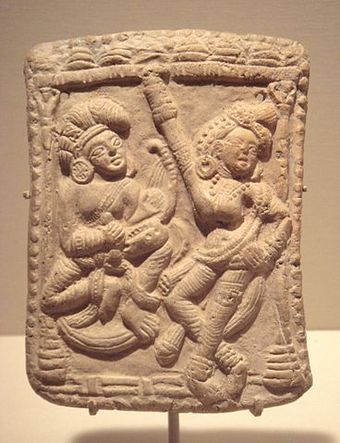
Sunga Royal Family, c. 150 BCE
Art and learning prospered under Sunga patronage, as seen in this terracotta tablet of the Sunga Royal family.
Sunga and
Buddhism
The
Sungas favored Hinduism over Buddhism. Buddhist sources, such as the Ashokavadana, an Indian
Sanskrit text describing the birth and reign of Ashoka the Great, mention that
Pusyamitra was hostile towards Buddhists and allegedly persecuted members of
the Buddhist faith. A large number of Buddhist monasteries, called viharas,
were allegedly converted to Hindu temples in such places as Nalanda, Bodhgaya,
Sarnath, or Mathura. Some historians argue, however, that Buddhist accounts of Sunga
persecution are largely exaggerated.
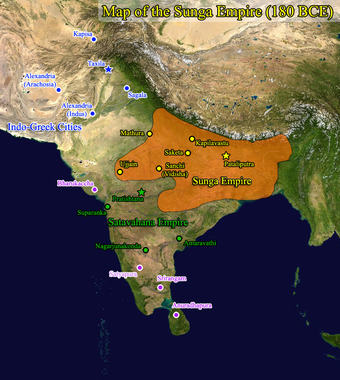
Sunga Empire, c. 185 BCE
The Sunga Dynasty was established following a coup by General Pusyamitra Sunga, marking the end of the Maurya Empire.
Indo-Greek
Kingdom
In
the east, the fall of the Mauryas left the Khyber Pass unguarded, and a wave of foreign
invasion followed. The Greco-Bactrian king, Demetrius, capitalized on the break-up and
conquered southern Afghanistan and parts of northwestern India around 180 BCE,
forming the Indo-Greek Kingdom. The Indo-Greeks maintained territorial holdings
for about a century in the Trans-Indus Region, in what is now Pakistan and parts of central India.
Demetrius, who lived from 175 to 140 BCE, founded the city of Sirkap,
combining Greek and Indian influences without signs of segregation between the
two cultures. The Greek expansion into Indian territory may have been intended
to protect Greek populations in India, as well as to protect the Buddhist faith
from the alleged religious persecutions of the Sungas.
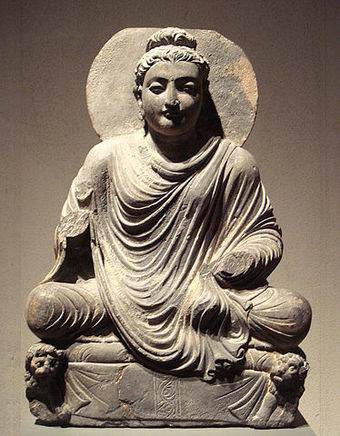
Seated Buddha statue showing Greek influences
Buddhism was favored in the Indo-Greek Kingdom. Many statues of Buddha from this period display Greek stylistic elements including Greek clothing.
Demetrius
was succeeded by Menander, who conquered the largest territory and was one of
the most successful Indo-Greek kings. His coins that have been discovered are
the most numerous and widespread of all the Indo-Greek kings. According to
Buddhist literature, Menander converted to Buddhism and is sometimes described
as the Milinda Panha. He helped Buddhism flourish and established the new
capital of Sagala.
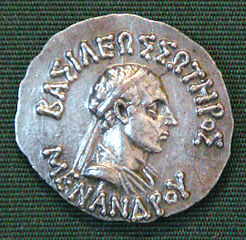
Coin depicting Menander I
Described in both Greek and Indian accounts, Menander I became the most important of the Indo-Greek rulers. He converted to Buddhism and expanded the Indo-Greek Kingdom.
In
Indian literature, the Indo-Greeks are described as “Yavanas” in
Sanskrit, or “Yonas” in Pali, which are both thought to be
transliterations of “Ionians.” The Buddhist scripture, Majjhima Nikaya, explains that in
contrast with the numerous Indian castes, there were only two classes of
people in Indo-Greek culture: the Aryas, translated as the masters; and Dasas,
the servants.
Indo-Greek
Fall
Throughout the first century BCE, the Indo-Greeks progressively lost
ground to the Indians in the East, and the Scythians, the Yuezhi, and the Parthians in the
West. About 20 Indo-Greek kings are known during this period, including last
known Indo-Greek ruler, Strato II, who ruled in the Punjab region until around
55 BCE.
6.6: The Kushan Empire
6.6.1: Expansion and Decline of the Kushan Empire
The Kushan Empire expanded from Greco-Bactrian lands
into China and India, until its collapse in 375 CE.
Learning Objective
Explain the importance of the Kushan Empire
Key Points
-
The Yuezhi invaded
the Greco-Bactrian
kingdom around
135 BCE, displacing the Greek dynasties. The
Kushans, a Yuezhi branch,
spread south into the region traditionally known as
Gandhara, and then expanded across the northern parts of the Indian
subcontinent. - Around 152 CE, the emperor Kanishka sent his armies north to capture
territories in present-day western China, and south into modern central India. A
direct road from the Kushan Empire and China, as well as the security offered by the
Kushan Empire, facilitated trade with the Roman Empire, Sassanid Persia,
Aksumite Empire, and Han China. -
The Kushans were influenced by
the Hellenistic kingdoms, and maintained a wide variety of faiths, including Zoroastrianism, Buddhism, and Hinduism. - Kushan control fragmented into
semi-independent kingdoms as the Sassanians attacked from the west and the
Guptas attacked from the east, collapsing the Kushan Empire around 375 CE.
Key Terms
- Greco-Bactrian Kingdom
-
The easternmost
part of the Hellenistic world, covering Bactria and Sogdiana in Central Asia
from 250-125 BCE. The Greco-Bactrians expanded into northern India and established
the Indo-Greek Kingdom in 180 BCE, which lasted until around 10 CE. - The Kushans
-
One of five branches of the Yuezhi, who invaded Bactria in 135 BCE, and spread southeast to form the Kushan Empire around 30 CE.
- Yuezhi
-
An ancient Indo-European people who originally settled in the grasslands of the eastern Tarim Basin, part of modern China.
- Zoroastrianism
-
One of the world’s oldest monotheistic religions, founded by the Prophet Zoroaster in ancient Iran approximately 3,500 years ago.
- Indo-Sassanids
-
A branch of the
Sassanid Persians, who established their rule in the northwestern Indian
subcontinent during the third and fourth centuries, at the expense of the
declining Kushans. - Kanishka
-
Buddhist emperor who expanded the Kushan Empire east into the middle of the Indian subcontinent, and north into China.
The
Kushan Empire in South Asia originally formed in the early 1st century CE, in the territories of ancient Bactria, around the Oxus River in Central
Asia. The Kushans spread from the Kabul River Valley to defeat other Central
Asian tribes. These conquests included parts of the northern central Iranian
Plateau, once ruled by the Parthian Empire—
a major political and cultural power
in ancient Iran and Iraq. The Kushans reached their peak under Emperor Kanishka
(127-151 CE), a Buddhist whose realm stretched from China to northern and
eastern India and parts of Pakistan.
Kushan Origins
(30-375 CE)
The
Kushans were one of five branches of the Yuezhi confederation, an Indo-European
nomadic people. The Yuezhi lived in the grasslands
of eastern Central Asia’s Tarim Basin, in modern-day Xinjiang, China (possibly
speaking varieties of Indo-European languages), until they were driven west by
the Xiongnu in 176-160 BCE.
The
Yuezhi reached the Greco-Bactrian Kingdom, located in northern Afghanistan and
Uzbekistan, around 135 BCE, and displaced the Greek dynasties that resettled to
the southeast in areas of the Hindu Kush and the Indus basin, in present-day
Afghanistan and Pakistan. The Kushans spread out from Bactria to defeat other
Central Asian tribes.
Kushan Expansion
As they wrested territories from the Scythian tribes, the Kushans
expanded south into the region traditionally known as Gandhara, establishing
the twin capitals Kapisa and Pushklavati, near modern-day Kabul and Peshawar,
respectively. During the 1st and early 2nd centuries CE, the Kushans expanded
across the northern parts of the Indian subcontinent. Around 152 CE, Emperor
Kanishka, a Buddhist, sent his armies north of the Karakoram Mountains to
capture additional territories, and subsequently opened a direct road from
Gandhara to China that remained under Kushan control for more than a century.
Diplomacy
and Trade
At
the height of the dynasty, the Kushans loosely ruled a territory that extended
to the Aral Sea through present-day Uzbekistan, Afghanistan, and Pakistan, into
northern India. They had diplomatic contacts with the Roman Empire, Sassanid
Persia, Aksumite Empire, and Han China. The Kushan Empire linked the seagoing
trade of the Indian Ocean with the commerce of the Silk Road, via the Indus Valley, while
providing security that encouraged travel across the Khunjerab Pass and
facilitated the spread of Mahayana Buddhism to China.
Culture
and Religion
Although
philosophy, art, and science developed within its borders, the only textual
record we have of the Kushan Empire’s history comes from inscriptions and
accounts in other languages, particularly Chinese. The Kushans are believed to
have been predominantly practitioners of Zoroastrianism, one of the world’s
oldest monotheistic religions founded by the Prophet Zoroaster in ancient Iran
approximately 3,500 years ago. Yet, the Kushans also adopted aspects of Buddhist
culture and, like the Egyptians, absorbed remnants of the Greek culture of the
Hellenistic kingdoms. Kushan emperors represented a wide variety of faiths, including Zoroastrianism, Buddhism, and possibly Saivism, a sect of Hinduism.
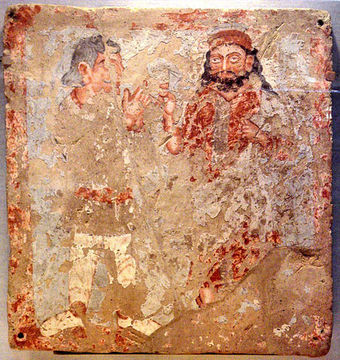
Kushan worshipper with Zeus/Serapis/Ohrmazd, 3rd century CE
The Kushans were influenced by the Hellenistic kingdoms and maintained a wide variety of faiths, including Zoroastrianism, Buddhism, and Hinduism.
Kushan Decline
After
the death of Emperor Vasudeva I in 225, the Kushan Empire split into western
and eastern halves. The western Kushans in Afghanistan were soon conquered by
the Persian Sassanid Empire. In 248 CE, they were defeated again by Persians,
who deposed the western dynasty and replaced them with Persian vassals—
cities or
kingdoms that forfeited foreign policy independence, in exchange for full
autonomy and, in some cases, formal tribute—known as the Indo-Sassanids, or Kushanshas.
The eastern
Kushan kingdom was based in the Punjab. Around 270 CE, their territories on the
Gangetic Plain became independent under local dynasties, such as the Yaudheyas.
In the mid-4th century they were subjugated by the Gupta Empire under its
leader, Samudragupta. The last of the Kushan and Sassanian kingdoms were eventually
overwhelmed by the Hepthalites, another Indo-European people from the north.
6.7: The Gupta Empire
6.7.1: Rise of the Gupta Empire
From 320-550 CE, the Gupta Empire assimilated neighboring kingdoms, through
conquest or political alliances.
Learning Objective
Explain the factors that contributed to the rise of the Gupta Empire
Key Points
- Sri Gupta founded the Gupta
Empire c. 240-280 CE, and was succeeded by his son, Ghatotkacha, c. 280-319 CE, followed
by Ghatotkacha’s son, Chandragupta, c. 319-335 CE. - After Chandragupta married
princess Kumaradevi from the kingdom of Magadha, he conquered or assimilated
the nearby kingdoms and assumed the imperial title of Maharajadhiraja, meaning “King of Kings.” - Chandragupta’s son, Samudragupta,
assumed the throne in 335 CE, and conquered several neighboring kingdoms; eventually, the Gupta Empire extended across the entire Indian subcontinent. - Samudragupta was succeeded by his
son, Chandragupta
II, who continued to expand the Gupta Empire through
conquest and political alliances.
Key Terms
- Maharajadhiraja
-
A Sanskrit title
for “Prince of Princes” or “King of Kings,” several
degrees higher than the title Maharaja, which means “Great King.” - Ashwamedha
-
A Vedic ritual
horse sacrifice; Samudragupta commemorated his territorial conquests with one
of these rituals.
The
Gupta Empire, founded by Maharaja Sri Gupta, was an ancient Indian realm that covered much of the Indian Subcontinent from approximately 320-550 CE. Gupta rule, while solidified by territorial expansion through
war, began a period of peace and prosperity marked by advancements in science,
technology, engineering, art, dialectics, literature, logic, mathematics,
astronomy, religion, and philosophy.
Gupta
Empire Origins
The
Gupta Empire was believed to be a dynasty of the Vaishya caste, the third of
the four Hindu castes representing merchants and farmers. Founded by Sri Gupta
c. 240-280 CE, there are contradictory theories regarding the original homeland
of the Guptas. Historians believe Sri Gupta and his son may have been Kushan vassals, or
rulers who swore allegiance to the Kushan Empire. Sri Gupta’s son and successor, Ghatotkacha, ruled
from c. 280-319 CE, while his son, Chandragupta, ascended the throne around 319
and ruled until 335 CE.
Chandragupta married princess Kumaradevi from the Kingdom of Magadha,
which was one of the Mahajanapadas (or great countries) of ancient India during
the 4th century CE. With a dowry and political alliance from the marriage,
Chandragupta conquered or assimilated the kingdoms of Magadha, Prayaga, and
Saketa. By 321 CE, he established a realm stretching along the Ganges River to
Prayag, the modern-day city of Allahabad, in the Indian state of Uttar Pradesh.
Hindus believe the god Brahma offered his first sacrifice after creating the
world at Prayag.
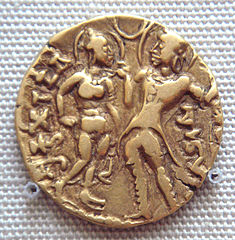
Queen Kumaradevi and King Chandragupta I
A coin from the period of
Indian Emperor Samudragupta, 335-380 CE, depicting his parents, King Chandragupta
and Queen Kumaradevi.
Gupta
Empire Expansion
Samudragupta
succeeded his father, Chandragupta I, in 335 CE, and ruled for about 45 years.
He conquered the kingdoms of Ahichchhatra and Padmavati early in his reign,
then attacked neighboring tribes, including the Malwas, Yaudheyas, Arjunayanas, Maduras,
and Abhiras. By his death in 380 CE, Samudragupta had incorporated over 20
kingdoms into his realm, and extended the Gupta Empire from the Himalayas to the
Narmada River in central India, and from the Brahmaputra River that cuts through
four modern Asian nations to the Yamuna—
the longest tributary of the Ganges
River in northern India.
To
celebrate his conquest, Samudragupta performed the royal Vedic ritual of Ashwamedha, or horse sacrifice. Special
coins were minted to commemorate the Ashvamedha, and the king took the title of
Maharajadhiraja (or “King of Kings”) even higher than the traditional
ruler’s title of Maharaja.
According
to the Gupta records, Samudragupta nominated his son, Prince Chandragupta II,
born of Queen Dattadevi, as his successor. However, his eldest son, Ramagupta,
may have been his immediate successor until he was dethroned by Chandragupta II
in 380 CE.
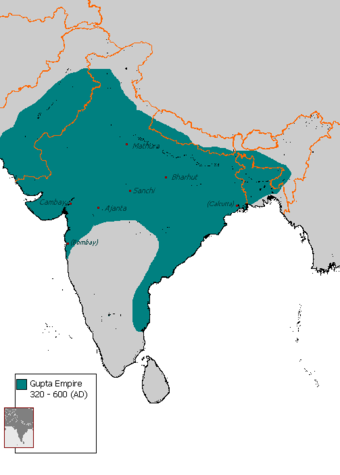
Gupta Empire, 320-600 CE
The Gupta Empire expanded through conquest and political alliances until 395 CE, when it extended across the entire Indian subcontinent.
Gupta
Empire of Chandragupta II
After
gaining power, Chandragupta II expanded the Gupta Empire through conquest and
political marriages until the end of his reign in 413 CE. By 395 CE, his
control over India extended coast-to-coast. At the high point of his rule, Chandragupta
II established a second capital at Ujjain, the largest city in the modern state
of Madhya Pradesh in central India. Ujjain, on the eastern bank of the Kshipra
River, remained an important political, commercial, and cultural hub through the
early 19th century.
Vikramaditya
is the name of an emperor of ancient Indian legend, characterized as the ideal
king known for generosity, courage, and as a patron of scholars. A number of
historians believe that some of these legends are based on Chandragupta II, who
is thought to have adopted the title of Vikramaditya.
In
the legends, Vikramaditya is said to have thwarted an invasion by the Saka, a
group of eastern Iranian nomadic tribes, also known as Scythians, and gained the
title of Sakari, or Enemy of the Saka. Chandragupta II conquered the western
Indian region of Malwa after defeating the Western Kshatrapas, a branch of the
Sakas, as well as expelling the Kushana Empire from the northern Indian
city state Mathura. These victories were likely transposed onto the legendary character
of Vikramaditya.
Chandragupta
II issued gold coin types introduced by his father, Samudragupta, but also
introduced several new types of coins, differentiated by the designs on the
face of each coin line, such as the Archer or the Tiger-Slayer. He was also the
first Gupta king to issue silver coins.
One
of the most curious structures in Delhi, India (an iron pillar dating back to
the 4th century CE) bears an inscription stating that it was erected as a
flagstaff in honor of the Hindu god Vishnu, and in memory of Chandragupta II.
The pillar, made of 98% wrought iron, is considered a highlight of ancient
Indian achievements in metallurgy; it has stood more than 1,600 years
without rusting or decomposing.
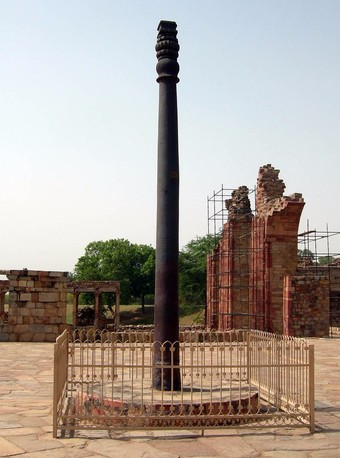
Iron Pillar of Delhi
The Iron Pillar of Delhi, India, erected by Chandragupta II to honor the Hindu god Vishnu, in the 4th century CE.
Despite
the expansion of the Gupta Empire through war, there were numerous examples of
cultural sophistication during the Gupta era, with architecture, sculptures and
paintings surviving as reminders of the creativity of the time. Under Gupta
rule, a number of notable scholars thrived, including Kalidasa, considered the
greatest poet and dramatist of the Sanskrit language; Aryabhata, the first of
the Indian mathematician-astronomers who worked on the approximation for Pi; Vishnu Sharma, thought to be the author
of the Panchatantra fables, one of
the most widely-translated, non-religious books in history; and the Hindu
philosopher Vatsyayana, author of the Kama
Sutra.
The
period of Gupta rule, especially the reign of Chandragupta II, is still remembered
as the Golden Age of India.
6.7.2: The Golden Age of India
The prosperity of the Gupta Empire produced a golden age of
cultural and scientific advancements.
Learning Objective
Understand the significance of the Golden Age of India
Key Points
-
Prosperity in the Gupta
Empire initiated a period known as the Golden Age of India, marked by extensive
inventions and discoveries in science, technology, engineering, art, dialectic,
literature, logic, mathematics, astronomy, religion, and philosophy. - Chandragupta
II promoted
the synthesis of science, art, philosophy, and religion, in part because his
court contained the Navartna, or the Nine
Jewels, a group of nine scholars who produced advancements in many academic
fields. - Chinese traveler Fa
Xian visited
India from 399-405 CE, during the reign of Emperor Chandragupta II. He recorded
all of his observations in a journal that was later published.
Key Terms
- Navartna
-
Also called the
Nine Jewels; a group of nine scholars in the court of Chandragupta II
who contributed many advancements in their academic fields. - Fa Xian
-
A Chinese
traveler who recorded detailed observations about his experience in the Gupta
Empire in his journal. It was later published. - Chandragupta II
-
His reign, from
375-415 CE, promoted the synthesis of science, art, philosophy, and religion
during the Golden Age of India. - Golden Age of India
-
A period at the height of the Gupta Empire, marked by extensive inventions and
discoveries that contributed to
Hindu culture, in subjects such as science, technology, engineering, art, dialectic, literature,
logic, mathematics, astronomy, religion, and philosophy. - ayurvedic
-
A form of alternative medicine established in India.
The
prosperity created under the leadership of the Gupta Empire, which
covered much of the Indian subcontinent from approximately 320-550 CE, enabled the wide pursuit of scientific and artistic endeavors.
This period became known as the Golden Age of India because it was marked by
extensive inventions and discoveries in science, technology, engineering, art,
dialectic, literature, logic, mathematics, astronomy, religion, and philosophy. These discoveries crystallized elements of what is generally considered Hindu culture.
Science,
Literature, and Art
Although
Chandragupta I and his son, Samudragupta, were prominent rulers, the reign of
Chandragupta II included the greatest promotion of science, art, philosophy,
and religion by the government. Chandragupta’s court was even more influential than
those that came before or after because it contained the Navaratnas, or the Nine
Jewels, a group of nine scholars who produced advancements in many academic
fields.
These
scholars included Aryabhata, who is believed to have envisioned the concept of
zero, as well as working on the approximation for the long-form number Pi. Aryabhata is also believed to be the
first of the Indian mathematician-astronomers who postulated the theory that the
Earth moves round the Sun and is not flat, but instead is round and rotates
on its own axis. He also may have discovered that the moon and planets shine due to reflected sunlight.
Varahamihira
was an astronomer, astrologer, and mathematician, whose main work is a treatise
on mathematical astronomy. Sushruta, a famed Indian physician of the Gupta
period, wrote the Samhita, a Sanskrit text on all of the
major concepts of ayurvedic medicine, with innovative chapters
on surgery. Other scholars of the Golden Age helped create the first Indian
numeral systems with a base of ten. The game of chess also likely originated during
this period, where its early form, Chaturanga,
contained game pieces for infantry, cavalry, elephants, and chariots, each of which would evolve into the modern pawn, knight, rook, and bishop, respectively.
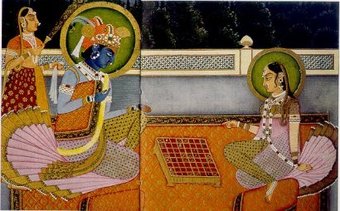
Krishna and Radha playing Chaturanga
Scholars during the reign
of Chandragupta II contributed many scientific advancements in the fields of
astronomy, mathematics, and medicine.
Kalidasa,
considered the greatest poet and dramatist of the Sanskrit language, also belonged
primarily to this period. He wrote plays, such as Shakuntala, which is said to have inspired the famed German writer
and statesman, Johann von Goethe, centuries later. Kalidasa also became
renowned for his study of the shringara, or romantic, element of
literature. The Indian scholar and Hindu philosopher Vatsyayana, authored the Kama Sutra, which became a standard work
on human sexual behavior, while Vishnu Sharma was thought to be the author of
the Panchatantra fables, one of the
most widely-translated, non-religious books in history.
The cultural creativity of the Golden Age of India produced magnificent
architecture, including palaces and temples, as well as sculptures and paintings
of the highest quality. The walls of Buddhist shrines and monasteries were decorated
with colorful frescoes, a type of wall paintings. These showed scenes from the
life of the Buddha, the ascetic and philosopher, who lived in the eastern part
of the Indian subcontinent sometime between 6th and 4th centuries, on
whose teachings the Buddhist religion is based. Some shrines were cut out of
the cliffs, and although dark, they were also decorated with sculptures and
paintings.
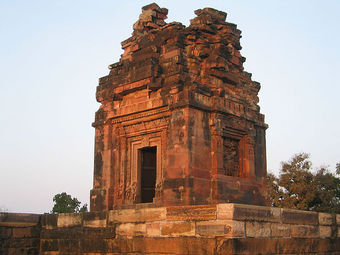
The Dashavatara Temple
The Golden Age of India
produced many temples, decorated with various sculptures and paintings, such as
the Dashavatara Temple, also known as the Vishnu Temple, in central India.
Influence
on East and Southeast Asia
The
Gupta Dynasty promoted Hinduism, but supported Buddhist and Jain
cultures as well. Gupta Buddhist art influenced East and Southeast Asia as
trade between regions increased. The Gupta Empire became an important cultural
center and influenced nearby kingdoms and regions in Burma, Sri Lanka, and
Southeast Asia. Classical forms of Indian music and dance, created under the
Guptas, are still practiced all over Asia today.
Fa
Xian was one of the first Chinese travelers to visit India during the reign of
Gupta Emperor Chandragupta II. He started his journey from China in 399 CE, and reached
India in 405 CE. He recorded all of his observations in a journal that was
eventually published.
During his stay in India, until c. 411 CE, Fa Xian went on a pilgrimage to
Mathura, Kanauj, Kapilavastu, Kushinagar, Vaishali, Pataliputra, Kashi, and
Rajgriha. His writings express pleasure in the mildness of the administrations
in these places.
6.7.3: Decline of the Gupta Empire
After many years of dominance, the Gupta Empire collapsed in 550
CE, due to invasions and weak leadership of successive rulers.
Learning Objective
Understand the decline of the Gupta Empire
Key Points
-
The Gupta Empire flourished under
Chandragupta II, but began to falter under his son, Kumaragupta, and grandson,
Skandagupta. -
The Huna People, also known as
Huns, invaded Gupta territory and caused significant damage to the empire. -
The Gupta Empire ended in 550 CE, when it disintegrated into regional kingdoms after a series of weak rulers and
invasions from the east, west, and north.
Key Terms
- Huna
-
A Central Asian Xionite tribe that consisted of four hordes that repeatedly invaded Gupta territory, and helped cause the downfall of the Gupta Empire.
- Skandagupta
-
Son of Kumaragupta I; the emperor of the Gupta Dynasty from c. 455-467 CE.
- Kumaragupta I
-
Son of Chandragupta II; the emperor of the Gupta Dynasty from c. 415-455 CE.
- Chandragupta II
-
The emperor of the Gupta Dynasty of ancient India from c. 380-415 CE.
The Gupta Empire flourished, in military
and territorial conquests as well as cultural and scholastic advancements, during
the reign of Emperor Chandragupta II. Yet the succeeding rulers, beginning with
Kumaragupta I and then Skandagupta, oversaw the eventual end of the Gupta
Empire through military defeats, devalued money and withering leadership.
Kumaragupta
In
415 CE, Chandragupta II was succeeded by his second son, Kumaragupta I, who
ruled successfully until 455 CE. The late years of his reign, however, faced
difficulties. The Pushyamitras, a tribe of central India, rose up in rebellion
against Kumaragupta, while Gupta territories were invaded by the Western Huna people, also known as White Huns.
Kumaragupta
defeated both groups and celebrated his victory by performing the royal Vedic
ritual of Ashwamedha, or
horse sacrifice, which had previously been performed by his grandfather,
Emperor Samudragupta, to celebrate his own great military victories.
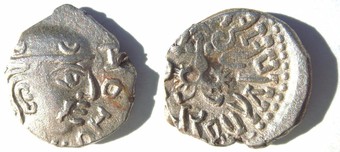
Coin of Kumaragupta I
A silver coin from the reign of Gupta Emperor Kumaragupta I, c. 415-455 CE.
As
his grandfather and father did before him, Kumaragupta also issued news coins
to mark his reign. They were stamped with images of his namesake god, Lord Kumara,
regarded by Hindus as Regent of Earth.
Skandagupta
Upon Kumaragupta’s
death in 455 CE, his son, Skandagupta, assumed the throne and
ruled until c. 467 CE. He is considered the last of the great Gupta rulers
prior to the collapse of the empire.
Skandagupta,
who was celebrated as a great warrior for his victorious clashes with the Huns
during his father’s reign, defeated several rebellions and external threats
from the Huna people, notably an invasion in 455 CE. Although victorious, the
expenses of the wars against the Hunas drained the empire’s resources. The
value of the coinage issued under Skandagupta becoming severely reduced.
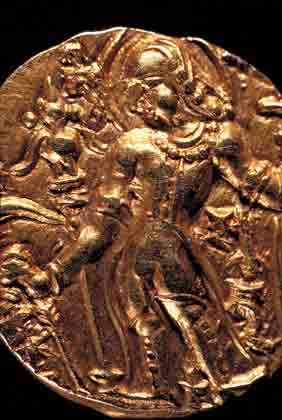
Coin of Skandagupta
A coin emblazoned with the image of Gupta Dynasty Emperor Skandagupta, who ruled c. 455-467 CE.
The Huna and Gupta’s Demise
The
Huna were a Central Asian Xionite tribe that consisted of four hordes: Northern
Huna, also known as the Black Huns; Southern Huna, the Red Huns; Eastern Huna,
the Celestial Huns; and the White Huns, the Western Huna. The White Huns, those
who invaded the Gupta Empire during the reign of Kumaragupta, were also known
as the Hephthalites, and caused great damage to the failing Gupta Empire. Skandagupta
died in 467 CE, and was followed onto the throne by his half-brother, Purugupta,
who ruled from 467-473 CE.
Thereafter
came a succession of weak kings, beginning with Kumaragupta II from 473-476 CE, followed by Budhagupta, the son of Purugupta. The Hephthalites broke through the Gupta
military defenses in the northwest in the 480s, during the reign of Budhagupta,
and by 500 CE much of the empire in northwest was overrun by the Huna.
The empire
thereafter disintegrated into numerous regional kingdoms, ruled by chieftains. A
minor line of the Gupta Clan continued to rule Magadha, one of the 16 Indian
Mahajanapadas, or “Great Countries,” but the Gupta Empire fell by 550
CE.
Chapter 5: Early Chinese Dynasties
5.1: The Mythical Period
5.1.1: The Mythical Period
Early prehistoric China is called the “Mythical Period.” It encompassed the legends of Pangu, and the rule of the Three Sovereigns, and the Five Emperors. The period ended when the last Emperor, Shun, left his throne to Yu the Great, and the Xia Dynasty began.
Learning Objective
Recall what innovations emerged under the legendary rulers of China’s Mythical Period
Key Points
- By 2000 BCE, cities developed in China, and the various cultures of the area began to merge into a larger, more unified Chinese culture.
- Most of what we know about the first part of prehistoric China is from Chinese mythology, which is why it’s now known as the Mythical Period.
- The Mythical Period includes the rule of the Three Sovereigns and the Five Emperors.
- The last of the Five Emperors was Emperor Shun. He left his throne to Yu the Great, who founded the Xia dynasty and instituted the practice of passing rulership to a son.
Key Terms
- urbanism
-
The change in a country or region when its population migrates from rural to urban areas.
- millet
-
Any of a group of various types of grass or its grains used as food, widely cultivated in the developing world.
- Go
-
An abstract strategy board game for two players, where the object is to surround more territory than the opponent.
- Yangtze
-
The longest river in Asia, the Yangtze flows from the highlands of Tibet through central China, and empties into the Pacific Ocean at Shanghai.
- Yellow River
-
Huang He in Chinese. A river of northern China which flows for 5,463 km (3,000 miles) to the Yellow Sea.
- Pangu
-
A mythical Chinese being who created the universe.
- Huai
-
A major river in China located about midway between the Yellow and Yangtze Rivers.
- Gilgamesh
-
The hero of a Babylonian epic, and the legendary king of the Sumerian city state of Uruk.
History as Told by Archaeological Evidence
As in Mesopotamia, Egypt, and the Indus River valley, civilization in China developed around a great river. The Yellow River and the Huai and Yangtze Rivers, created fertile land, ripe for experimentation with agriculture. By around 4000 BCE, villages began to appear in these areas. The Neolithic Chinese cultivated a number of crops; the most important was a grain called millet. They also domesticated animals, such as pigs, dogs, and chickens. Silk production, through the domestication of silkworms, also likely began in this early period.
These villages influenced each other more and more over time, and by 2000 BCE a unified Chinese culture began to develop. There is also evidence of urbanism and the use of early writing d this time. These phenomena took place in China about 1000 years later than in Mesopotamia, Egypt, and the Indus River valley.
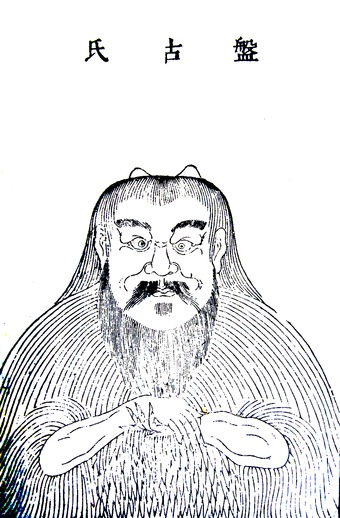
Pangu
Portrait of Pangu, the creator of the universe according to Chinese mythology. This portrait is from Sancai Tuhui, a Chinese encyclopedia published in 1609, during the Ming Dynasty.
History as Told by Chinese Legend
Chinese mythology tells a different story of the beginning of civilization. It holds that the universe was created by Pangu, the first living being. After his death, Pangu’s left eye became the sun and his right eye became the moon. The Three Sovereigns and the Five Emperors, a series of legendary sage emperors and heroes, helped create man. These legendary rulers taught the ancient Chinese to speak, use fire, build houses, farm, and make clothing. Fuxi and his wife, Nüwa, were credited with introducing domesticated animals and creating the basic social structure of family life. Shennong was a divine farmer who gave the people knowledge of agriculture.
The existence of these emperors occurred before written Chinese history, and so the dates of reign are uncertain. The Five Emperors began with Huangdi, or the Yellow Emperor, whose reign is believed to be from 2698-2599 BCE. He was considered the founding ancestor of the Han Chinese ethnic group, and is credited with the invention of Chinese characters, silk, and traditional Chinese medicine.
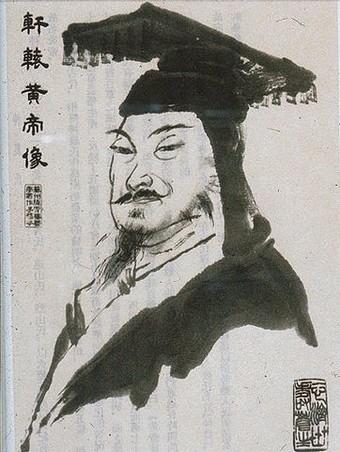
The Yellow Emperor, or Huangdi.
Portrait of the first of the Five Emperors, who was considered the original ancestor for Han Chinese.
Next came Zhuanxu, who was credited with the invention of the Chinese calendar and the introduction of religion and astrology. Little is known about Emperor Ku’s reign, believed to be from 2412-2343 BCE. Emperor Yao, whose reign was from 2317-2234 BCE, was credited with being a role model in dignity and diligence to future emperors, and was the inventor of the game “weiqi” (also known as “Go”). The last was Emperor Shun, whose reign was from 2233-2205 BCE, was known for his devotion. He left his throne to Yu the Great, who founded the Xia dynasty, and instituted the practice of passing rulership to a son. While these events are mythological, at their root there may be ancient memories of very early kings and rulers who emerged among the prehistoric Chinese, similar to the tales of Gilgamesh in Mesopotamia.
5.1.2: The Xia Dynasty
The final part of the Mythical Period was under the rule of the legendary Xia Dynasty, which may have been mythological. After the final ruler became corrupt, he was overthrown by Cheng Tang, who founded the Shang Dynasty.
Learning Objective
Recall characteristics of the Xia Dynasty
Key Points
- Sima Qian’s “Historical Records,” the first comprehensive history of China, said that the last of the Five Emperors, Emperor Shun, left his throne to Yu the Great, who founded the Xia Dynasty.
- The Xia Dynasty was the first Chinese dynasty; it is still not known whether this dynasty existed or is only mythological.
- According to mythology, when the last Xia king became corrupt and cruel, Cheng Tang overthrew him in c. 1760 BCE and founded the Shang Dynasty.
- Many argue that the Zhou Dynasty, which ruled China much later, invented the idea of the Xia Dynasty to support their claim that China could only be, and had always been, ruled by one ruler.
Key Terms
- Mandate of Heaven
-
The Chinese philosophical concept of the circumstances under which a ruler is allowed to rule. Good rulers were allowed to rule under the Mandate of heaven, while despotic, unjust rulers had the Mandate revoked.
- Sima Qian
-
A renowned Chinese historiographer of the 2nd century BCE who wrote about the Xia Dynasty.
- Shang Dynasty
-
Also called the Yin Dynasty, succeeded the Xia Dynasty and followed the Zhou Dynasty. It existed in the second millennium BCE.
Sima Qian’s Historical Records
The earliest comprehensive history of China is the Historical Records, written by Sima Qian, a renowned Chinese historiographer of the 2nd century BCE. This history begins around 3600 BCE, with an account of the Five Emperors. According to this history, the last of the great Five Emperors, Emperor Shun, left his throne to Yu the Great, who founded China’s First Dynasty, the Xia Dynasty. Yu supposedly began the practice of inherited rule (passing power from father to son), a model that was perpetuated in the later Shang and Zhou dynasties.
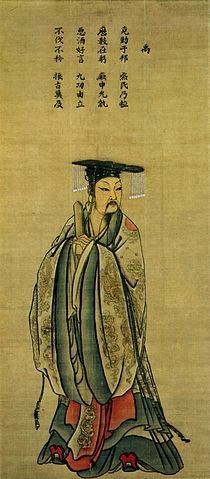
Depiction of Yu the Great
This hanging scroll shows Yu the Great, as imagined by Song Dynasty painter Ma Lin.
According to mythology, Yu’s descendants ruled China for nearly 500 years, until the last Xia king became corrupt and cruel. This led to his overthrow in c. 1760 BCE by Cheng Tang, who founded a new dynasty, the Shang Dynasty, in the Huang River Valley.
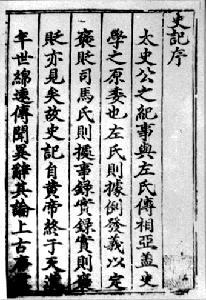
Sima Qian’s Historical Records
The first page of Sima Qian’s Historical Records.
Debate Over the Existence of the Xia Dynasty
There is much debate among scholars about how much of this mythology is true. Many argue that the Zhou Dynasty, which ruled China much later, invented the idea of the Xia Dynasty to support their claim that China could only be, and had always been, ruled by one ruler. The Zhou created the idea of the “Mandate of Heaven,” which stated that there could be only one legitimate ruler of China at any given time. If he was a good ruler, he would have the support of heaven; if he was despotic, he would be overthrown. The various small states that had comprised Neolithic and Bronze Age China contradicted this version of history. Some people argue, therefore, that the Zhou may have created the idea of an ancient Xia Dynasty to support the idea that China always had one ruler.
Nonetheless, the Xia Dynasty may not be a complete fabrication; recent archaeological evidence may support its existence. (For a long time it was believed that the later Shang Dynasty may also have been purely mythological, until archaeology proved that it was real.) Archaeologists have discovered an advanced Bronze Age culture in China. Its capital, Erlitou, was a huge city around 2000 BCE. This may in fact be the people referred to in Chinese mythology as the Xia. It is believed that the Xia may have created a primitive writing system, though no evidence of this has been found. However, evidence does suggest that the Xia developed agricultural methods and experienced considerable prosperity. However, lack of irrigation and flood protection made the region prone to frequent floods and other natural disasters.
5.2: The Shang Dynasty
5.2.1: Introduction to the Shang Dynasty
The Shang Dynasty existed in the Yellow River Valley during the second millennium BCE. It built huge cities, monopolized bronze, and developed writing, until it was overthrown by the Zhou.
Learning Objective
Compare the Shang Dynasty with the earlier Xia Dynasty
Key Points
- The Shang Dynasty (also called the Yin Dynasty) succeeded the Xia Dynasty, and was followed by the Zhou Dynasty. It was located in the Yellow River valley, during the second millennium BCE.
- The Shang Dynasty is the first period of prehistoric China that has been conclusively proven to have existed by archaeological evidence, such as excavated graves and oracle bones, the oldest substantial evidence of Chinese writing.
- Writing during the Shang Dynasty was already in an advanced form, suggesting that the written language had already existed for a long time.
- Under the Shang Dynasty, the Chinese built huge cities with strong social class divisions, expanded irrigation systems, and monopolized the use of bronze.
- The Shang Dynasty was overthrown in 1046 BCE by the Zhou, who established their own dynasty.
Key Terms
- Oracle bones
-
Inscriptions of divination records on the bones or shells of animals, dating to the Shang Dynasty of ancient China.
- Anyang
-
A city from the Shang Dynasty, the excavation of which yielded large numbers of oracle bones. This helped prove the existence of the Shang Dynasty.
- Zhengzhou
-
The modern-day area where the new capital of Shang was established during the Shang Dynasty.
- Xia Dynasty
-
The first dynasty in traditional Chinese history.
The Shang Dynasty (also
called the Yin Dynasty) succeeded the Xia Dynasty, and was followed by the Zhou
Dynasty. It was located in the Yellow River valley during the second millennium
BCE.
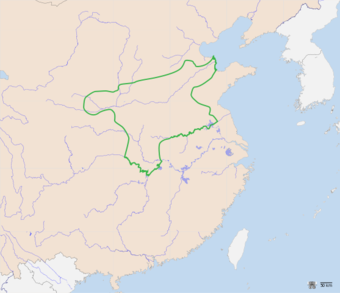
Map of Shang Dynasty
This map shows the location of the Shang Dynasty in the Yellow River valley.
Jie, the last king of the Xia Dynasty (the first Chinese dynasty), was overthrown c. 1760 BCE by Cheng Tang. It is estimated the Shang ruled from either 1766-1122 or 1556-1046
BCE.
While scholars still debate whether the Xia Dynasty actually existed, there is little doubt that the Shang Dynasty existed. The Shang Dynasty is, therefore, generally considered China’s first historical dynasty.
Under the Shang Dynasty, a unified sense of Chinese culture emerged. This culture would continue to thrive and evolve, and many modern Chinese still see the Shang culture as China’s dominant culture. Under the Shang Dynasty, the Chinese built huge cities with strong social class divisions, expanded irrigation systems, monopolized the use of bronze, and developed a system of writing. Shang kings were believed to fulfill sacred, not political, purposes. Instead, a council of chosen advisers administered various aspects of the government. The border territories of Shang rule were led by chieftains, who gained the right to govern through connections with royalty.
The Shang Dynasty was overthrown in 1046 BCE by the Zhou, a subject people living in the western part of the kingdom.
Archaeological Evidence
The Shang Dynasty is the oldest
Chinese dynasty supported by archaeological finds. These have included 11 major Yin royal tombs and building sites of palaces and rituals, as well as weapons
and remains of human and animal sacrifices, and artifacts, including bronze,
jade, stone, bone, and ceramic.
The oldest surviving form of Chinese writing is inscriptions of divination records on the bones or shells of animals—so-called oracle bones. However, the writing on the oracle bones shows evidence of complex development, indicating that written language had existed for a long time. In fact, modern scholars are able to read it because the language was very similar to the modern Chinese writing system.
Archaeologists have also found ancient cities that correspond with the Shang Dynasty. When Cheng Tang overthrew the last king of the Xia Dynasty, he supposedly founded a new capital for his dynasty at a town called Shang, near modern-day Zhengzhou. Archaeological remains of this town may have been found—it seems to have functioned as a sacred capital, where the most sacred temples and religious objects were housed. This city also had palaces, workshops, and city walls.
Anyang, in modern-day Henan, is another important (but slightly later) Shang city that has been excavated. This site yielded large numbers of oracle bones that describe the travels of eleven named kings. The names and timeframes of these kings match traditional lists of Shang kings. Anyang was a huge city, with an extensive cemetery of thousands of graves and 11 large tombs—evidence of the city’s labor force, which may have belonged to the 11 Shang kings.
5.2.2: Society Under the Shang Dynasty
The Shang Dynasty was located in the Yellow River valley in China during the second millennium BCE. It was a society that followed a class system of land-owners, soldiers, bronze workers, and peasants.
Learning Objective
Summarize the social class system during the Shang Dynasty
Key Points
- The Shang Dynasty (also called the Yin Dynasty) succeeded the Xia Dynasty, and was followed by the Zhou Dynasty. It was located in the Yellow River valley during the second millennium BCE. Citizens of the Shang Dynasty were classified into four social classes: the king and aristocracy, the military, artisans and craftsmen, and peasants.
- Members of the aristocracy were the most respected social class, and were responsible for governing smaller areas of the dynasty.
- Next in social status were the Shang military—both the infantry and the chariot warriors.
- The Shang “middle class” were artisans and craftsmen, who mainly worked with bronze.
- The poorest class in Shang society were the peasants, who were mostly farmers. Some scholars believe they functioned as slaves; others believe they were more like serfs.
Key Terms
- aristocracy
-
The nobility, or the hereditary ruling class.
- artisans
-
Skilled manual workers, who use tools and machinery in a particular craft.
- peasants
-
Members of the lowest social class, who toil on the land. This social class consisted of small farmers and tenants, sharecroppers, farmhands, and other laborers on the land, forming the main labor force in agriculture and horticulture.
The Shang Dynasty (also called the Yin Dynasty) succeeded the Xia Dynasty, and was followed by the Zhou Dynasty. It was located in the Yellow River valley during the second millennium BCE. It featured a stratified social system made up of aristocrats, soldiers, artisans and craftsmen, and peasants.
The Aristocracy and the Military
The aristocracy were centered around Anyang, the Shang capital, and conducted governmental affairs for the surrounding areas. Regional territories farther from the capital were also controlled by the wealthy.
The Shang military were next in social status, and who were respected and honored for their skill. There were two subdivisions of the military: the infantry (foot soldiers) and the chariot warriors. The latter were noted for their great skill in warfare and hunting. Archaeological evidence has supported the use of horses and other cavalry during the late Shang period, c. 1250 BCE.
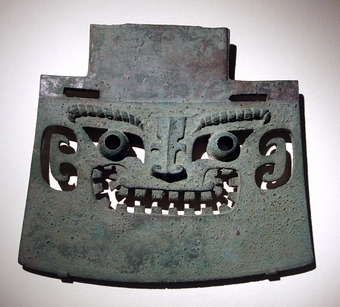
Bronze battle-axe
A bronze battle-axe dated to the Shang Dynasty.
Artisans and Craftsmen
Artisans and craftsmen comprised the middle class of Shang society. Their largest contribution was their work with bronze, which the Chinese developed as early as 1500 BCE. Their work with bronze was a very important aspect of society. Bronze weapons and pottery were commonly made, but the most prominent creations included ritual vessels and treasures, many of which were discovered via archaeological findings in the 1920s and 1930s. Shang aristocrats and the royalty were likely buried with large numbers of bronze valuables, particularly wine vessels and other ornate structures.
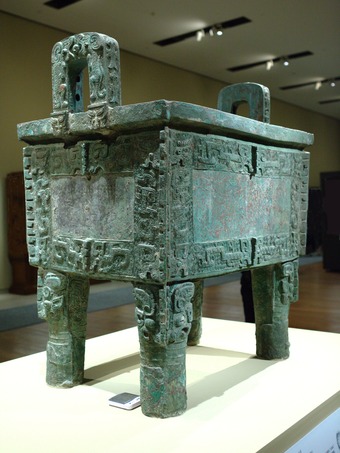
Houmuwu Ding
The “Houmuwu Ding” is the heaviest piece of bronze work found in China so far.
Peasants
At the bottom of the social ladder were the peasants, the poorest of Chinese citizens. They comprised the majority of the population, and were limited to farming and selling crops for profit. Archaeological findings have shown that masses of peasants were buried with aristocrats, leading some scholars to believe that they were the equivalent of slaves. However, other scholars have countered that they may have been similar to serfs. Peasants were governed directly by local aristocrats.
5.2.3: Shang Religion
Shang religion was characterized by a combination of animism, shamanism, spiritual control of the world, divination, and respect and worship of dead ancestors, including through sacrifices.
Learning Objective
Explain the religious foundation of Shang Dynasty culture
Key Points
- The Shang believed in spiritual control of the world by various gods. They also practiced ancestor worship. They appealed to the gods, including the supreme god Shangdi, and consulted their ancestors through oracle bones.
- The Shang established a lunar calendar using 29-day months, and 12-month years.
- There appears to have been a belief in the afterlife during the Shang Dynasty, evidenced by human and animal bodies and artifacts found in tombs.
Key Terms
- shamanism
-
A shaman is a person who is seen to have access
to and influence in the world of spirits, and who typically enters a trance
state during rituals, and practices divination and healing. - animism
-
The belief that spirits inhabit some or all classes of natural objects or phenomena, and that an immaterial force animates the universe.
- oracle bones
-
Inscriptions of divination records on the bones or shells of animals, dating to the Shang Dynasty of ancient China.
- divination
-
The
practice of seeking knowledge of the future or the unknown by supernatural
means.
Shang Religion
Shang religion was characterized by a combination of animism, shamanism, spiritual control of the world, divination, and respect and worship of dead ancestors, including through sacrifice. Different gods represented natural and mythological symbols, such as the moon, sun, wind, rain, dragon, and phoenix. Peasants prayed to these gods for bountiful harvests. Festivals to celebrate gods were also common. In particular, the Shang kings, who considered themselves divine rulers, consulted the great god Shangdi (the “Supreme Being” who ruled over humanity and nature) for advice and wisdom. The Shang believed that the ancestors could also confer good fortune, so they would also consult ancestors through oracle bones in order to seek approval for any major decision, and to learn about future success in harvesting, hunting, or battle.
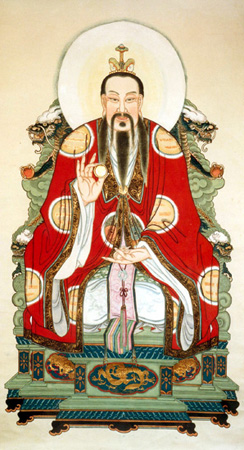
Shangdi
One depiction of Shangdi, the Supreme Being who ruled over humanity and nature.
Oracle Bones and Divination
The
oldest surviving form of Chinese writing is inscriptions of divination records
on the bones or shells of animals—so-called oracle bones. Oracle
bones were pieces of bone or turtle shell used by the ancient Chinese,
especially Chinese kings, in attempts to predict the future. The ancient kings
would inscribe their name and the date on the bone along with a question. They
would then heat the bone until it cracked, and then interpret the shape of the
crack, which was believed to provide an answer to their question.
Questions were carved into oracle bones, such as, “Will we win the upcoming
battle?”, or “How many soldiers should we commit to the battle?” The bones reveal a great deal about what was important to Shang
society. Many of the oracle bones ask questions about war, harvests, and
childbirth.
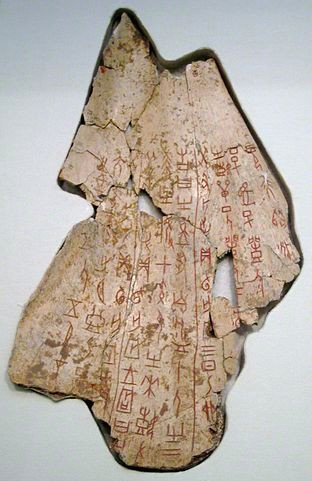
Oracle Bone
This oracle bone from the Shang Dynasty dates to the reign of King Wu Ding.
The Afterlife
It appears that there was belief in the afterlife during the Shang Dynasty. Archaeologists have found Shang tombs surrounded by the skulls and bodies of human sacrifices. Some of these contain jade, which was seen to protect against decay and give immortality. Archaeologists believed that Shang tombs were very similar to those found in the Egyptian pyramids, in that they buried servants with them. Chinese archaeologists theorize that the Shang, like the ancient Egyptians, believed their servants would continue to serve them in the afterlife, so aristocrats’ servants would be killed and buried with them when they died. Another interpretation is that these were enemy warriors captured in battle.
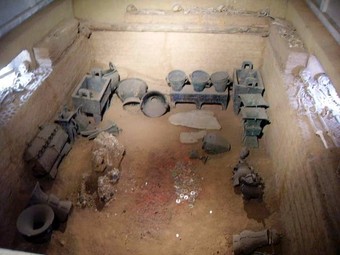
The Burial Pit at the Tomb of Lady Fu Hao
This tomb is located in the ruins of the ancient Shang Dynasty capital, Yin.
The Lunar Calendar
The Shang also established a lunar calendar that was used to predict and record events, such as harvests, births, and deaths (of rulers and peasants alike). The system assumed a 29-day month that began and ended with each new moon; twelve lunar months comprised one lunar year. Priests and astronomers were trained to recalculate the lunar year and add enough days so that each year lasted 365 days. Because the calendar was used to time both crop planting and the harvest, the king had to employ skilled astronomers to predict dates (and successes) of annual harvests; this would help him maintain support from the people.
5.2.4: Advancements Under the Shang
During the Shang Dynasty, bronze casting became more sophisticated. Military technology also advanced as horses were domesticated and chariots came into existence.
Learning Objective
Describe some of the technical advancements made under the Shang Dynasty
Key Points
- Bronze casting was perhaps
the most important technology during the Shang Dynasty. The Shang made
many objects out of bronze, including ceremonial tools, swords, and
spearheads for the military. - The Shang also domesticated horses and developed the chariot, which gave them a massive military advantage over their opponents.
- With these technologies, the Shang military expanded the kingdom’s borders significantly.
Key Terms
- chariot
-
A two-wheeled, horse-drawn vehicle used in ancient warfare and racing.
- Oracle bone
-
Pieces of ox scapula or turtle plastron, used for divination in ancient China.
Shang Bronze Technology
The Shang ruled China during its Bronze Age; perhaps the most important
technology at the time was bronze casting. The Shang cast bronze objects by
creating molds out of clay, carving a design into the clay, and then pouring
molten bronze into the mold. They allowed the bronze to cool and then broke the
clay off, revealing a completed bronze object.
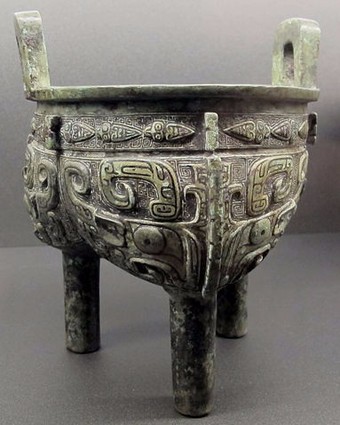
Shang Dynasty Bronze
This bronze ding vessel dates to the Shang Dynasty.
The
upper classes had the most access to bronze, and they used it for ceremonial
objects, and to make offerings to ancestors. Bronze objects were also buried
in the tombs of Shang elite. The Shang government used bronze for military
weapons, such as swords and spearheads. These weapons gave them a distinct advantage
over their enemies.
Shang Military Technology
The chariot was military technology that allowed the Shang to excel at war. Under the Shang, the Chinese domesticated the horse. Horses of that
time were still too small to ride, but the Chinese gradually
developed the chariot, which harnessed the horse’s power. The chariot was a
devastating weapon in battle, and it also allowed Shang soldiers to move vast
distances at great speeds. A chariot burial site at Anyang (modern-day Henan) dates to the rule of King Wu Ding of the Shang Dynasty (c. 1200 BCE). Oracle bone inscriptions show that the Shang used chariots as mobile command vehicles and in royal hunts. Members of the royal household were often buried with a chariot, horses and a charioteer.
These
military technologies were important, because the Shang were
constantly at war. A significant number of Shang oracle bones were concerned
with battle. The Shang armies expanded the borders of the kingdom and captured
precious resources and prisoners of war, who could be enslaved or used as human sacrifice. The
oracle bones also show deep concern over the “barbarians” living
outside the empire, who were a constant threat to the safety and stability of
the kingdom; the military had to be constantly ready to fight them.
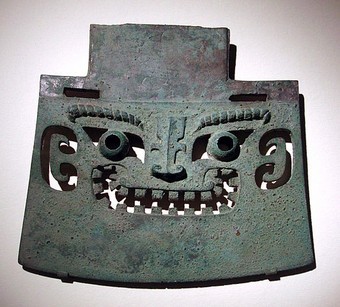
Shang Dynasty Bronze Battle Axe
This bronze axe is an example of Shang bronze work.
5.3: The Zhou Dynasty
5.3.1: The Mandate of Heaven
The Zhou Dynasty overthrew the Shang Dynasty, and used the Mandate of Heaven as justification.
Learning Objective
Describe the Zhou Dynasty’s justification for overthrowing the Shang Dynasty
Key Points
- In 1046 BCE, the Shang Dynasty was overthrown at the Battle of Muye, and the Zhou Dynasty was established.
- The Zhou created the Mandate of Heaven: the idea that there could be only one legitimate ruler of China at a time, and that this ruler had the blessing of the gods. They used this Mandate to justify their overthrow of the Shang, and their subsequent rule.
- Some scholars think the earlier Xia Dynasty never existed—that it was invented by the Zhou to support their claim under the Mandate that there had always been only one ruler of China.
Key Terms
- Battle of Muye
-
The battle that resulted with the Zhou, a subject people living in the western part of the kingdom, overthrew the Shang Dynasty.
- Mandate of Heaven
-
The Chinese philosophical concept of the circumstances under which a ruler is allowed to rule. Good rulers were allowed to rule under the Mandate of Heaven, while despotic, unjust rulers had the Mandate revoked.
The Fall of the Shang
In 1046 BCE, the Zhou, a subject people living in the western part of the kingdom, overthrew the Shang Dynasty at the Battle of Muye. This was a battle between Shang and Zhou clans, over the Shang’s expansion. They largely had the support of the Chinese people: Di Xin (the final king of the Shang Dynasty) had become cruel, spent state money on drinking and gambling, and ignored the state. The Zhou established authority by forging alliances with regional nobles, and founded their new dynasty with its capital at Fenghao (near present-day Xi’an, in western China).
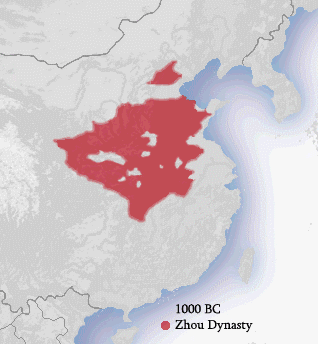
Map of Zhou Dynasty
This map shows the location of the ancient Zhou Dynasty.
The Mandate of Heaven
Under the Zhou Dynasty, China moved away from worship of Shangdi (“Celestial Lord”) in favor of worship of Tian (“heaven”), and they created the Mandate of Heaven. According to this idea, there could be only one legitimate ruler of China at a time, and this ruler reigned as the “Son of Heaven” with the approval of the gods. If a king ruled unfairly he could lose this approval, which would result in his downfall. Overthrow, natural disasters, and famine were taken as a sign that the ruler had lost the Mandate of Heaven.

The Chinese Character for “Tian”
The Chinese character for “Tian,” meaning “heaven,” in (from left to right) Bronze script, Seal script, Oracle script, and modern simplified.
The Mandate of Heaven did not require a ruler to be of noble birth, and had no time limitations. Instead, rulers were expected to be good and just in order to keep the Mandate. The Zhou claimed that their rule was justified by the Mandate of Heaven. In other words, the Zhou believed that the Shang kings had become immoral with their excessive drinking, luxuriant living, and cruelty, and so had lost their mandate. The gods’ blessing was given instead to the new ruler under the Zhou Dynasty, which would rule China for the next 800 years.
The need for the Zhou to create a history of a unified China is also why some scholars think the Xia Dynasty may have been an invention of the Zhou. The Zhou needed to erase the various small states of prehistoric China from history, and replace them with the monocratic Xia Dynasty in order for their Mandate of Heaven to seem valid (i.e., to support the claim that there always would be, and always had been, only one ruler of China).
The Zhou ruled until 256 BCE, when the state of Qin captured Chengzhou. However, the Mandate of Heaven philosophy carried on throughout ancient China.
5.3.2: Society Under the Zhou Dynasty
Under the initial period of the Zhou Dynasty (called the Western Zhou period), a number of innovations were made, rulers were legitimized under the Mandate of Heaven, a feudal system developed, and new forms of irrigation allowed the population to expand.
Learning Objective
Describe the main accomplishments of the Western Zhou period
Key Points
- The first period of Zhou rule, during which the Zhou held undisputed power over China, is known as the Western Zhou period.
- During the Western Zhou period, the focus of religion changed from the supreme god, Shangdi, to “Tian,” or heaven; advances were made in farming technology; and the feudal system was established.
- Under the feudal system, the monarchy would reward loyal nobles with large pieces of land.
- Over time, the king grew weaker, and the lords of the feudal system grew stronger, until finally, in 711 BCE, one lord joined forces with an invading group of barbarians and killed the king.
Key Terms
- Duke of Zhou
-
A regent to the king who established the feudal system, and held a lot of power during the Western Zhou period.
- Western Zhou period
-
The first period of Zhou rule, during which the Zhou held undisputed power over China (1046-771 BCE).
- feudal system
-
A social system based on personal ownership of resources and personal fealty between a suzerain (lord) and a vassal (subject). Defining characteristics include direct ownership of resources, personal loyalty, and a hierarchical social structure reinforced by religion.
The first period of Zhou rule, during which the Zhou held undisputed power over China, is known as the Western Zhou period. This period ended when the capital was moved eastward. A number of important innovations took place during this period: the Zhou moved away from worship of Shangdi, the supreme god under the Shang, in favor of Tian (“heaven”); they legitimized rulers, through the Mandate of Heaven (divine right to rule); they moved to a feudal system; developed Chinese philosophy; and made new advances in irrigation that allowed more intensive farming and made it possible for the lands of China to sustain larger populations.
China created a substantial amount of literature during the Zhou Dynasty. These include The Book of History and The Book of Diviners, which was used by fortune tellers. Books dedicated to songs and ceremonial rites were also created. While many of these writings have been destroyed over time, their lasting impression on history is evidence of the strength of Zhou culture.
Like other river valley civilizations of the time, the people under the Zhou Dynasty followed patriarchal roles. Men chose which children would be educated and whom their daughters were married. The household usually consisted of the head male, his wife, his sons and unmarried daughters.
The feudal system in China was structurally similar to ones that followed, such as pre-imperial Macedon, Europe, and Japan. At the beginning of the Zhou Dynasty’s rule, the Duke of Zhou, a regent to the king, held a lot of power, and the king rewarded the loyalty of nobles and generals with large pieces of land. Delegating regional control in this way allowed the Zhou to maintain control over a massive land area. Under this feudal (fengjian) system, land could be passed down within families, or broken up further and granted to more people.
Most importantly, the peasants who farmed the land were controlled by the feudal system. Slavery had been common during the Shang Dynasty, but this decreased and finally disappeared under the Zhou Dynasty, as social status became more fluid and transitory.
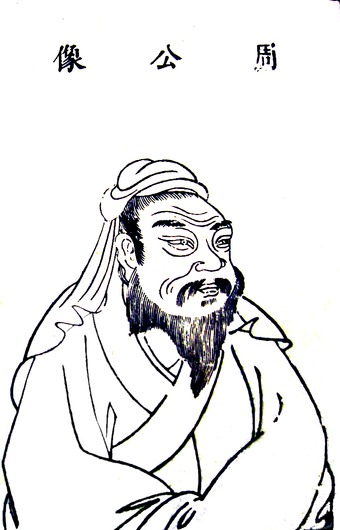
The Duke of Zhou
Portrait of the Duke of Zhou in Sancai Tuhui, a Chinese encyclopedia published in 1609 during the Ming Dynasty.
When the Duke of Zhou stepped down, China was united and at peace, leading to years of prosperity. But this only lasted for about seventy-five years. Over time, the central power of the Zhou Dynasty slowly weakened, and the lords of the fiefs originally bestowed by the Zhou came to equal the kings in wealth and influence. They began to actively compete with them for power, and the fiefs gained independence as individual states.
Finally, in 711 BCE, one rebellious noble, the Marquess of Shen, joined forces with invading barbarians, the Quanrong, to defeat the King You. No one came to the king’s defense, and he was killed. The Zhou capital was sacked by the barbarians, and with this the Western Zhou period ended.
5.3.3: Art Under the Zhou Dynasty
Under the Zhou Dynasty, many art forms expanded and became more detailed, including bronze, bronze inscriptions, painting, and lacquerware.
Learning Objective
Identify some of the art forms prevelant under the Zhou Dynasty
Key Points
- Work in bronze, including inscriptions, continued and expanded in the Zhou Dynasty.
- Few paintings have survived from this period, but we know that they were representations of the real world.
- The production of lacquerware expanded during this period.
Key Term
- lacquer
-
A natural varnish, originating in China or Japan, and extracted from the sap of a sumac tree.
Bronze, Ceramics, and Jade
Chinese script cast onto bronzeware, such as bells and cauldrons, carried over from the Shang Dynasty into the Zhou; it showed continued changes in style over time, and by region. Under the Zhou, expansion of this form of writing continued, with the inclusion of patrons and ancestors.
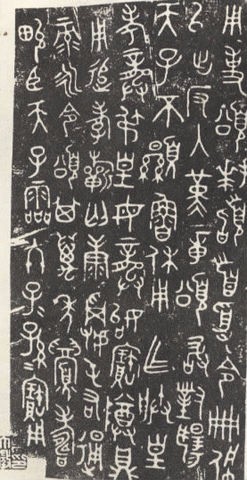
Example of Bronze Inscription
This example of bronze inscription was cast on the Song ding, ca. 800 BCE. The text records the appointment of a man named Song (颂) as supervisor of the storehouses in Chengzhou, and is repeated on at least 3 tripod pots (鼎 dǐng), 5 tureens (簋 guǐ) and their lids, and 2 vases (壺 hú) and their lids.
Other improvements to bronze objects under the Eastern Zhou included greater attention to detail and aesthetics. The casting process itself was improved by a new technique, called the lost wax method of production.
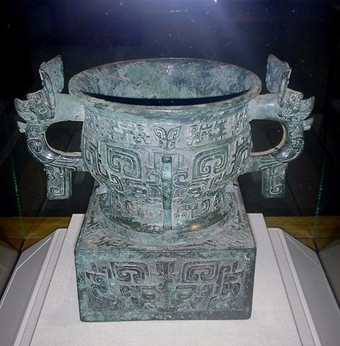
Example of Western Zhou Bronze
A Chinese bronze “gui” ritual vessel on a pedestal, used as a container for grain. From the Western Zhou Dynasty, dated c. 1000 BC. The written inscription of 11 ancient Chinese characters on the bronze vessel states its use and ownership by Zhou royalty.
Ceramic and Jade art continued from the Shang Dynasty, and was improved and refined, especially during the Warring States Period.
Paintings
Very few paintings from the Zhou have survived, however written descriptions of the works have remained. Representations of the real world, in the form of paintings of figures, portraits, and historical scenes, were common during the time. This was a new development. Painting was also done on pottery, tomb walls, and on silk.
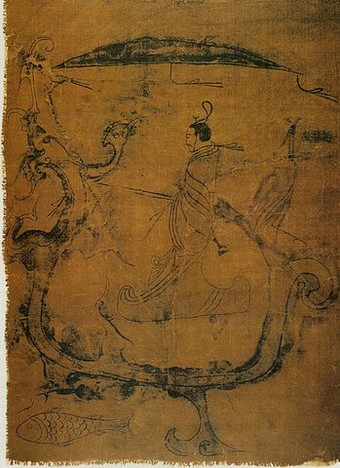
Example of Silk Painting
This example of silk painting shows a man riding a dragon, and has been dated to the 5th-3rd century BCE.
Lacquerware
Lacquerware was a technique through which objects were decoratively covered by a wood finish and cured to a hard, durable finish. The lacquer itself might also be inlaid or carved. The Zhou continued and developed lacquer work done in the Shang Dynasty. During the Eastern Zhou period, a large quantity of lacquerware began to be produced.
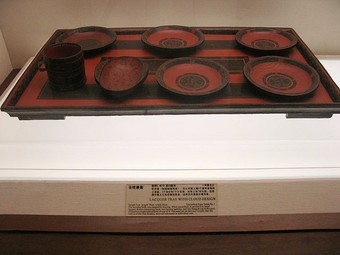
Example of Lacquerware
These are Chinese Western Han (202 BC – 9 CE) era lacquerwares and lacquer tray unearthed from the 2nd-century-BCE Han Tomb No.1 at Mawangdui, Changsha, China in 1972.
5.3.4: The Eastern Zhou Period
The Eastern Zhou period was divided into two halves. In the Spring and Autumn period, power became decentralized as nobles vied for power. In the Warring States period, strong states fought each other in large-scale war. During the period, there were substantial intellectual and military developments.
Learning Objective
Explain the main political and military developments during the Eastern Zhou period
Key Points
- During the first part of the Eastern Zhou period, called the Spring and Autumn period, the king became less powerful and the regional feudal became lords more so, until only seven consolidated powerful feudal states were left.
- During the second part of the period, called the Warring States period, strong states vied for power until the Qin conquered them all and created a unified dynasty.
- Developments during the period included increasing use of infantry, a trend toward bureaucracy and large-scale projects, the use of iron over bronze, and intellectual and philosophical developments.
Key Terms
- Hegemony
-
Domination, influence, or authority over another, especially by one political group over a society or by one nation over others.
- feudalism
-
A social system in which nobility hold lands from the King in exchange for military service, and peasants lived on the nobles’ land and provided services.
- decentralized
-
Moving away from a single point of administration to multiple locations, and usually giving them a degree of autonomy.
- infantry
-
Soldiers marching or fighting on foot.
The End of the Western Zhou Period
The first period of Zhou rule, which lasted from 1046-771 BCE and was referred to as the Western Zhou period, was characterized mostly by unified, peaceful rule. The lords under feudalism gained increasing power, and ultimately the Zhou King You was assassinated, and the capital, Haojing, was sacked in 770 BCE. The capital was quickly moved east to Chengzhou, near modern-day Luoyang, and the Zhou abandoned the western regions. Thus, the assassination marked the end of the Western Zhou period and the beginning of the Eastern Zhou period.
The Spring and Autumn Period of Eastern Zhou
The first part of the Eastern Zhou period is known as the Spring and Autumn period, named after the Spring and Autumn Annals, a text that narrated events on a year-by-year basis, and marked the beginning of China’s deliberately recorded history. This period lasted from about 771-476 BCE. During this time, power became increasingly decentralized as regional feudal lords began to absorb smaller powers and vie for hegemony. The monarchy continued to lose power, and the people were nearly always at war.
The period from 685-591 BCE was called The Five Hegemons, and featured, in order, the Hegemony of Qi, Song, Jin, Qin, and Chu. By the end of 5th century BCE, the feudal system was consolidated into seven prominent and powerful states—Han, Wei, Zhao, Yue, Chu, Qi, and Qin—and China entered the Warring States period, when each state vied for complete control.
The Warring States Period
This period, in the second half of the Eastern Zhou, lasted from about 475-221 BCE, when China was united under the Qin Dynasty. The partition of the Jin state created seven major warring states. After a series of wars among these powerful states, King Zhao of Qin defeated King Nan of Zhou and conquered West Zhou in 256 BCE; his grandson, King Zhuangxiang of Qin, conquered East Zhou, bringing the Zhou Dynasty to an end.
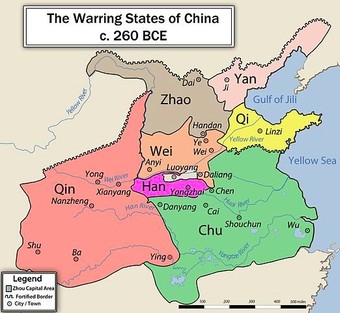
A Map of the Warring States of China
This map shows the Warring States late in the period. Qin has expanded southwest, Chu north and Zhao northwest.
Developments During the Eastern Zhou
While the chariot remained in use, there was a shift during the period to infantry, possibly because of the invention of the crossbow. This meant that war became larger scale, as peasants were drafted to take the place of nobility as soldiers and needed complex logistical support. The aristocracy’s importance dwindled as the king’s became stronger, and strong central bureaucracies took hold. The Art of War, attributed to Sun Tzu, was written during this time; it remains a very influential book about strategy.
A sophisticated form of commercial arithmetic was in place during the period, as shown by a bundle of bamboo slips showing two digit decimal multiplication.
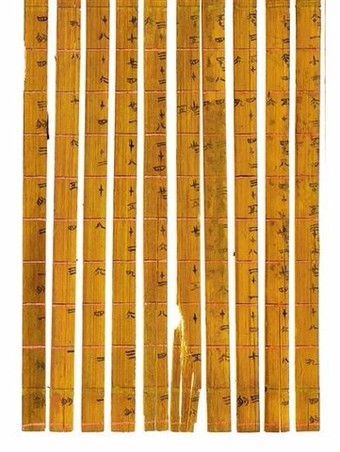
Bamboo Slips Showing Arithmetic
These bamboo slips show a sophisticated two digit decimal multiplication table.
A history of the Spring and Autumn Period, called the Zuo Commentary on the Spring and Autumn Annals, was published during this time.
Developments in iron work replaced bronze as the dominant metal used in warfare. Trade became increasingly important among states within China. Large-scale works, including the Dujiangyan Irrigation System and the Zhengguo Canal, were completed and increased agricultural production.
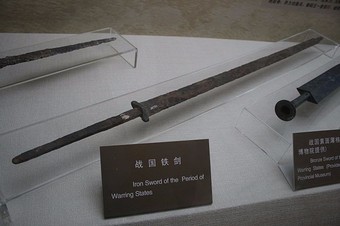
Iron Sword from the Warring States Period
This iron sword is an example of the metal work done during this period.
5.3.5: The Warring States Period
The Warring States period saw technological and philosophical development, and the emergence of the Qin Dynasty.
Learning Objective
Demonstrate understanding of the main characteristics of the Warring States period
Key Points
- The second part of the Eastern Zhou period is known as the Warring States period. During this time, the seven states remaining from the Spring and Autumn period intensely and unrelentingly battled each other for total power.
- It was during this period that the Iron Age spread in China, leading to stronger tools and weapons made from iron instead of bronze.
- This period also saw the further development of Confucianism (by Mencius), Daoism, Legalism, and Mohism.
- By this time, two key Chinese social characteristics had solidified: l) the concept of the patrilineal family as the basic unit of society, and 2) the concept of natural social differentiation into classes.
- Iron replaced the use of bronze, sophisticated math came into use, and large-scale projects were undertaken.
- Ultimately, in 221 BCE, the Qin state emerged victorious and unified China once more under the Qin Dynasty.
Key Term
- crossbow
-
A mechanised weapon, based on the bow and arrow, that fires bolts; it was invented during the Warring States period of the Zhou Dynasty, when its low cost and ease of use made it a preferable weapon to the chariot.
Over the course of the Spring and Autumn period, regional feudal lords consolidated and absorbed smaller powers; by 476 BCE, seven prominent states were left, all led by individual kings. The second part of the Eastern Zhou period is known as the Warring States period; during this time these few remaining states battled each other for total power.
Conflict Among the Seven States
The king by now was powerless, and the rulers of the seven independent states began to refer to themselves as kings as well. These major Chinese states were in constant competition. Since none of the states wanted any one rival to become too powerful, if one state became too strong, the others would join forces against it, so no state achieved dominance. This led to nearly 250 years of inconclusive warfare that became larger and larger in scale. It was also at this point that there first emerged the concept of a Chinese emperor who would rule over all the various kings, though the first Chinese emperors did not rule until China was unified under the later Qin Dynasty. The crossbow was invented, and its low cost and easy use (as compared to the expensive chariot) resulted in the increased conscription of peasants as expandable infantry.
Technological and Philosophical Development
The Iron Age had reached China by 600 CE, but it was during this period that the age spread and took root in China: by the time of the Warring States Period, China saw a widespread adoption of iron tools and weapons that were significantly stronger than their bronze counterparts.
This period also saw the further development of the philosophical movements that originated in the Hundred Schools of Thought of the Spring and Autumn period. Mencius further developed Confucian philosophy, expanding upon its doctrines and asserting the innate goodness of the individual and the importance of destiny. Daoism, Legalism, and Mohism became more developed. Archaic writing also gave way to a far more recognizable form of Chinese script.
Cultural, Economic, and Social Development
Two fundamental Chinese social characteristics had become apparent by this time: l) the concept of the patrilineal family as the basic unit in society, with high importance placed on blood relations, and 2) the concept of natural social differentiation into classes, each regarded in terms of their contributions to society.
Large-scale projects, like the Dujiangyan Irrigation System and the Zhengguo Canal, were carried out. Sophisticated arithmetic was carried out, including two digit decimal multiplication.
The Zuo Commentary on the Spring and Autumn Annals was a literary achievement. In other literary works, sayings of philosophers of the period were recorded in the Analects and the Art of War.
The Rise of the Qin State and Resolution of the Warring States Period
Though the military rivalries and alliances in the Warring States period were complex and constantly in flux, over time the Qin state, under the leadership of King Zheng, emerged as the most powerful. The Qin were particularly strongly rooted in Legalist philosophy, which advocated the importance of the state at the expense of the individual. They were also known for being ruthless and ignoring etiquette and protocol of war in order to win at all costs. In particular, Shang Yang, adviser to Zheng, enacted laws to force subjects of the kingdom to act in ways that helped the state; he forced them to marry early, have many children, and produce certain quotas of food. Ultimately, in 221 BCE, the Qin state conquered the others and established the Qin Dynasty.
5.3.6: Chinese Philosophy
Confucianism, Daoism, Legalism, and Mohism all began during the Zhou Dynasty in the 6th century BCE, and had very strong influences on Chinese civilization.
Learning Objective
Discuss Confucianism, Daoism, Legalism, and Mohism.
Key Points
- Confucius stressed tradition and believed that an individual should strive to be virtuous and respectful, and to fit into his or her place in society.
- Confucianism remained prevalent in China from the Han Dynasty in 202 BCE to the end of dynastic rule in 1911.
- Lao-tzu was the legendary founder of Daoism, recorded in the form of the book the Tao Te Ching.
- Daoism advocated that the individual should follow a mysterious force, called The Way (dao), of the universe, and that all things were one.
- Legalism held that humans were inherently bad and needed to be kept in line by a strong state. According to Legalism, the state was far more important than the individual.
- Legalists could be divided into three types: those concerned with the position of ruler, those concerned with laws, and those concerned with tactics to keep the state safe.
- Mohism emerged under the philosopher Mozi, and its most well-known concept was “impartial care.” Mohism also stated that all people should be equal in their material benefit, and in their protection from harm.
Key Terms
- Five Classics
-
The basis of civil examinations in imperial China and the Confucian canon. They consist of the Book of Odes, the Book of Documents, the Book of Changes, the Book of Rites, and the Spring and Autumn Annals.
- chi
-
Life force or body energy, which supposedly circulates through the body along meridians.
- Tao Te Ching
-
The book which forms the basis of Daoist philosophy.
- Analects
-
The document in which the students of Confucius recorded his teachings.
- jen
-
Human virtue, under Confucianism.
Confucianism
Confucius, who lived during the 6th century BCE, was one of the foremost Chinese philosophers. He looked back on the Western
Zhou period, with its strong centralized state, as an ideal. He was pragmatic
and sought to reform the existing government, encouraging a system of mutual
duty between superiors and inferiors. Confucius stressed tradition and believed
that an individual should strive to be virtuous and respectful, and to fit into
his or her place in society. After his death in 479 BCE, his students wrote down his ethical and moral teachings in the Lun-yü, or Analects.
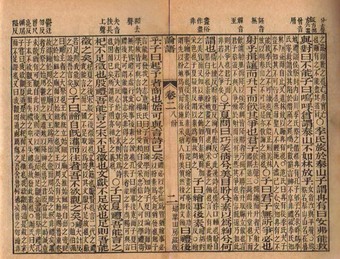
The Analects of Confucius
The ethical and moral teachings of Confucius were written down by his students in this document.
Being a good and virtuous human in every ordinary situation was the goal of Confucianism. This virtue was called “jen,” and humans were seen as perfectible and basically good creatures. Ceremonies and rituals based on the Five Classics, especially the I Ching, were strongly instituted. Some ethical concepts included Yì (the moral disposition to do good), Lǐ (ritual norms for everyday life) and Zhì (the ability to see what is right in the behavior of others).
Confucianism remained prevalent in China from the Han Dynasty in 202 BCE to the end of dynastic rule in 1911. It was reformulated during the Tang Dynasty (618-907) as Neo-Confucianism, and became the basis of imperial exams.
Daoism
Another important
philosopher in this period was Lao-tzu (also called Laozi), who founded Daoism (also called Taoism) during the same period as Confucianism. Lao-tzu is a legendary figure—it is uncertain if he actually existed. According to myth, Lao-tzu was born around 604 BCE as an old man. As he left his home to live a life of solitude, he was asked by the city gatekeeper to write down his thoughts. He did so in a book called Tao Te Ching, and was never seen again.
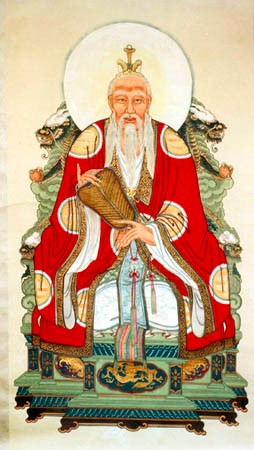
Lao-Tzu
A depiction of Lao-Tzu, the founder of Daoism.
Daoism advocated that the individual
should follow a mysterious force, called The Way (dao), of the universe and act in accordance with nature.
Daoism stressed the oneness of all things, and was strictly individualistic, as opposed to
Confucianism, which advocated acting as society expected.
Daoism as a religion arose over time, and involved the worship of gods and ancestors, the cultivation of “chi” energy, a system of morals, and the use of alchemy to achieve immortality. It is still practice today.
Legalism
Although Confucianism and Daoism are
the Chinese philosophies that have endured most to this day, even more
important to this early period was a lesser-known philosophy called Legalism. This held that humans are inherently bad and need to be kept in line by a
strong state. According to Legalism, the state was far more important than the
individual. While Legalism held that laws should be clear and public and that
everyone should be subject to them, it also contended that rulers had supreme
power and must use stealth and secrecy to remain in power. Legalists also believed that society must strive to dominate other societies.
Legalists could be divided into three types. The first was concerned with shi, or the investment of the position of ruler with power (rather than the person) and the necessity of obtaining facts to rule well. The second was concerned with fa, or laws, regulations, and standards. This meant all were equal under the ruler, and the state was run by law, not a ruler. The third was the concept of shu, or tactics to keep the state safe. Legalism was
generally in competition with Confucianism, which advocated a just and
reciprocal relationship between the state and its subjects.
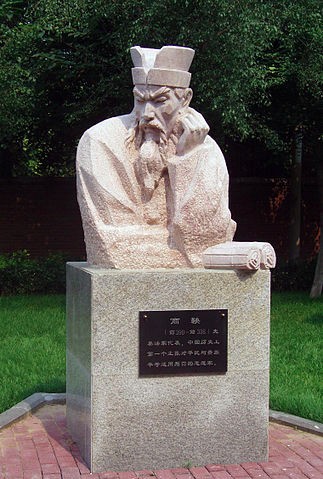
Depiction of Shang Yang
Shang Yang was a Legalist reformer under the Qin.
Mohism
Mohism emerged around the same time as the other philosophies discussed here, under the philosopher Mozi (c. 470-391 BCE). The most well-known concept under Mohism was “impartial care,” also known as “universal love.” This meant that people should care equally about other people, regardless of their true relationship to that person. This opposed the ideas of Confucianism, which said that love should be greater for close relationships. Mohism also stressed the ideas of self-restraint, reflection and authenticity.
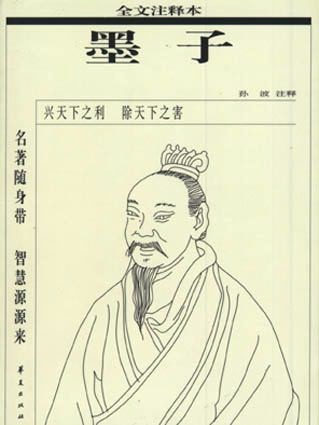
Depiction of Mozi
The Chinese philosopher who began Mohism is shown here.
Mohism also stated that all people should be equal in their material benefit and in their protection from harm. Society could be improved by having it function like an organism, with a uniform moral compass. Those who were qualified should receive jobs, and thus the ruler would be surrounded by people of talent and skill. An unrighteous ruler would result in seven disasters for the state, including neglect of military defense, repression, illusions about strength, distrust, famine, and more.
5.4: The Qin Dynasty
5.4.1: The Qin Dynasty
The Qin Dynasty saw rich cultural and technological innovation, but brutal rule, and gave way to the Han Dynasty after only 15 years.
Learning Objective
Support the argument that the Qin Dynasty, though short-lived, was one of the most important periods of China’s Classical Age
Key Points
- The leader of the victorious Qin state established the Qin Dynasty and recast himself as Shi Huangdi, the First Emperor of China.
- The Qin Dynasty was one of the shortest in all of Chinese history, lasting only about 15 years, but was also one of the most important. It was marked by a strong sense of unification and crucial technological and cultural innovation.
- Shi Huangdi standardized writing throughout the empire, built expansive infrastructure, such as highways and canals, standardized currency and measurement, conducted a census, and established a postal system.
- Legalism was the official philosophy, and other philosophies, such as Confucianism, were suppressed. Shi Huangdi also built the Great Wall of China, roughly 1,500 miles long and guarded by a massive army, to protect the nation against northern invaders.
- The Qin Dynasty collapsed after only 15 years. There was a brief period of chaos until the Han Dynasty was established.
Key Terms
- Legalism
-
A Chinese philosophy claiming that a strong state is necessary to curtail human self-interest.
- Mandate of Heaven
-
The belief, dating from ancient China, that heaven gives a ruler the right to rule fairly.
- Great Wall of China
-
An ancient Chinese fortification, almost 4,000 miles long, originally designed to protect China from the Mongols. Construction began during the Qin Dynasty, under Shi Huangdi.
When the Qin state emerged victorious from the Warring States period in 221 BCE, the state’s leader, King Zheng, claimed the Mandate of Heaven and established the Qin Dynasty. He renamed himself Shi Huangdi (First Emperor), a far grander title than King, establishing the way in which China would be ruled for the next two millennia. Today he is known as Qin Shi Huang, meaning First Qin Emperor. He relied on brutal techniques and Legalist doctrine to consolidate and expand his power. The nobility were stripped of control and authority so that the independent and disloyal nobility that had plagued the Zhou would not pose a problem.
The Qin Dynasty was one of the shortest in all of Chinese history, lasting only about 15 years, but it was also one of the most important. With Qin Shi Huang’s standardization of society and unification of the states, for the first time in centuries, into the first Chinese empire, he enabled the Chinese to think of themselves as members of a single kingdom. This laid the foundation for the consolidation of the Chinese territories that we know today, and resulted in a very bureaucratic state with a large economy, capable of supporting an expanded military.
Innovations of Emperor Shi Huangdi
The First Emperor divided China into provinces, with civil and military officials in a hierarchy of ranks. He built the Lingqu Canal, which joined the Yangtze River basin to the Canton area via the Li River. This canal helped send half a million Chinese troops to conquer the lands to the south.
Qin Shi Huang standardized writing, a crucial factor in the overcoming of cultural barriers between provinces, and unifying the empire. He also standardized systems of currency, weights, and measures, and conducted a census of his people. He established elaborate postal and irrigation systems, and built great highways.
In contrast, in line with his attempt to impose Legalism, Qin Shi Huang strongly discouraged philosophy (particularly Confucianism) and history—he buried 460 Confucian scholars alive and burned many of their philosophical texts, as well as many historical texts that were not about the Qin state. This burning of books and execution of philosophers marked the end of the Hundred Schools of Thought. The philosophy of Mohism in particular was completely wiped out.
Finally, Qin Shi Huang began the building of the Great Wall of China, one of the greatest construction feats of all time, to protect the nation against barbarians. Seven hundred thousand forced laborers were used in building the wall, and thousands of them were crushed beneath the massive gray rocks. The wall was roughly 1,500 miles long, and wide enough for six horses to gallop abreast along the top. The nation’s first standing army, possibly consisting of millions, guarded the wall from northern invaders.
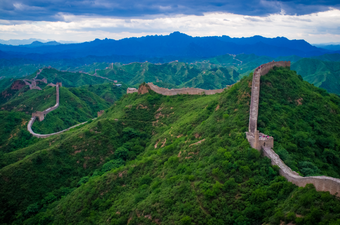
The Great Wall of China
Sections of the Great Wall of China, from the part known as Jinshanling.
The Terracotta Army
Another of Qin Shi Huang’s most impressive building projects was the preparation he made for his own death. He had a massive tomb created for him on Mount Li, near modern-day Xi’an, and was buried there when he died. The tomb was filled with thousands and thousands of life-sized (or larger) terracotta soldiers meant to guard the emperor in his afterlife. This terracotta army was rediscovered in the twentieth century. Each soldier was carved with a different face, and those that were armed had real weapons.
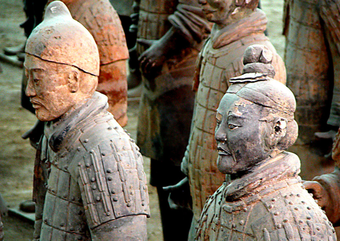
The Terracotta Army
A close-up of two soldiers in the terracotta army. Note how their faces differ from each other—each soldier was constructed to be unique.
Collapse of the Qin Dynasty
Qin Shi Huang was paranoid about his death, and because of this he was able to survive numerous assassination attempts. He became increasingly obsessed with immortality and employed many alchemists and sorcerers. Ironically, he ultimately died by poisoning in 210 BCE, when he drank an “immortality potion.”
The First Emperor’s brutal techniques and tyranny produced resistance among the people, especially the conscripted peasants and farmers whose labors built the empire. Upon the First Emperor’s death, China plunged into civil war, exacerbated by floods and droughts. In 207 BCE, Qin Shi Huang’s son was killed, and the dynasty collapsed entirely. Chaos reigned until 202 BCE, when Gaozu, a petty official, became a general and reunited China under the Han Dynasty.
5.5: The Han Dynasty
5.5.1: The Rise of the Han Dynasty
The strong but benevolent Han Dynasty began a golden age of reform and expansion. The first period, called the Western Han, lasted until 9 CE.
Learning Objective
Compare the Han Dynasty with the earlier Qin Dynasty, and explain the Western Han period
Key Points
- The Han Dynasty put an end to civil war and reunified China in 202 BCE, ushering in a golden age of peace and prosperity during which progress and cultural development took place.
- The Western Han period continued a lot of the Qin’s policies, but modified them with Confucian ideals. Because of this, the Han lasted far longer than the harsher Qin Dynasty—
the Western Han period in particular lasted until 9 CE, when there was a brief rebellion.
- One of the most exalted Han emperors was Emperor Wu. He made Confucianism the official philosophy, encouraged reciprocity between the state and its people, reformed the economy and agriculture, made contact with India, defended China from the Huns, and doubled the size of the empire.
- Rebellions and external threats posed challenges to the Western Han, but it was able to survive.
Key Terms
- four occupations
-
A hierarchy in which aristocratic scholars had the highest social status, followed by farmers, then craftsmen and artisans, and finally merchants.
- patrilineal
-
Descent through the male line in a family.
- golden age
-
A happy age of peace and prosperity; a time of great progress or achievement.
- xian
-
Mythical afterlife paradise during the Han Dynasty.
- Chu-Han Contention
-
A four-year (206-202 BCE) civil war between the Chu and Han states.
- socialism
-
A political philosophy based on principles of community decision making, social equality, and the avoidance of economic and social exclusion, with preference to community goals over individual ones.
- laissez-faire
-
A policy of governmental non-interference in economic affairs.
Formation of the Han Dynasty
By the time the Qin Dynasty collapsed in 207 BCE, eighteen separate kingdoms had declared their independence. The Han and Chu states emerged as the most powerful, but the Han state was the victor of the Chu-Han Contention, a four-year civil war. Gaozu, who had been born a peasant, founded the Han Dynasty in 202 BCE, reunifying China.
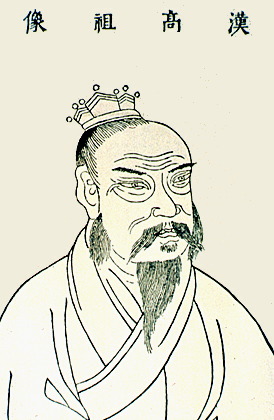
Emperor Gaozu of the Han Dynasty
Emperor Gaozu, formerly known as Liu Bang, founded the Han Dynasty.
The Han Dynasty would become one of the most important and long-lasting dynasties in all of Chinese history. It would rule China for over four hundred years, from 206 BCE-220 CE, and ushered in a golden age of peace, prosperity, and development. Today, both the majority ethnic group in China and Chinese script are called Han.
Comparison of Han to Qin
In many ways, the Han carried on policies that began in the Qin. Provincial rule occurred in both, and the Han continued Legalist rule, although in much less stricter fashion. Confucianism was banned during the Qin, but resurrected during the Han. The Qin, with its focus on the power of the state, was not shaped by religion in the same way the Han was. The Han were considered with the afterlife, and worshipped their ancestors. Both had defined social classes, but in the Han, peasants were treated with greater respect and classes were based on occupations.
The Western Han Period and Political Reform
At first the Han Dynasty established its capital at Chang’an, in western China. This Western Han period would last from 206 BCE to 9 CE, when the dynasty’s rule would be briefly interrupted by rebellion and the short-lived Xin Dynasty.
Throughout the Western Han period, the Han largely continued the governing policies of the Qin, continuing to expand the bureaucracy and encouraging a centralized state. There were, however, differences between the two dynasties, and it was perhaps these differences that allowed the Han to rule for so much longer than the Qin. The Han were more interested in the lives and well-being of their subjects, and they modified some of the harsher aspects of the earlier dynasty’s rule with Confucian ideals of government. Freedom of speech and writing was restored, and the more laissez-faire style of governing allowed harmony, prosperity, and population growth.
This period also saw the further development of the four-class hierarchy, called the “four occupations,” which gave aristocratic scholars the highest social status, followed by farmers, then craftsmen and artisans, and finally merchants.
The family during this time was patrilineal and featured a small number of nuclear family members. Arranged, monogamous marriages were the norm for most. Sons received equal shares of family property and were often sent away when married.
Ritual sacrifices of animals and food were made to deities, spirits, and ancestors at temples and shrines. Each person was seen as having a two-part soul. The spirit-soul, which went to the afterlife paradise of immortals, called xian, and the body-soul, which remained in its earthly tomb.
Other innovations included the first use of negative numbers in mathematics, the recording of stars and comets, the armillary sphere, which represented star movements in three dimensions, the waterwheel, and other engineering feats.
Emperor Wu
One of the most exalted Han emperors was Emperor Wu, who ruled from 141-87 BCE. He was responsible for a great number of innovations and political and military feats.
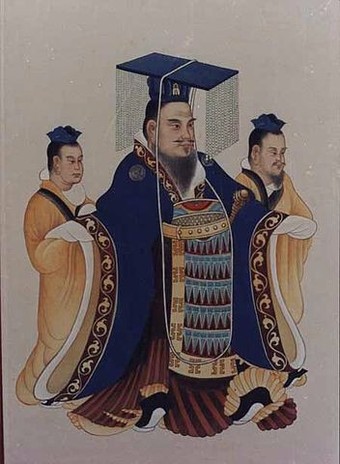
Emperor Wu of the Han Dynasty
A portrait of Emperor Wu, one of the most influential rulers of the Han Dynasty.
Emperor Wu experimented with socialism, and made Confucianism the single official philosophy. The Confucian classics were reassembled and transcribed. The Confucian ideal of each person accepting his social position helped legitimize the state and made people more willing to accept its power. At the same time, these ideals encouraged the state to act justly toward its people. There was reciprocity too in the fact that the state was funded partly by land taxes (a portion of the harvest); this meant that the prosperity of the agricultural estates determined the prosperity of the Han government.
Emperor Wu also founded great government industries and transportation and delivery services, developed governmental control of profit, and imposed a 5% income tax. He created civil-service examinations to test potential government officials on their knowledge of the Confucian classics, so that bureaucrats would be chosen for their intelligence instead of their social connections. Emperor Wu also reformed the Chinese economy and nationalized the salt and iron industries, and he initiated reforms that made farming more efficient.
Through Emperor Wu’s southern and western conquests, the Han Dynasty made contact with the Indian cultural sphere. Emperor Wu repelled the invading barbarians (the Xiongnu, or Huns, a nomadic-pastoralist warrior people from the Eurasian steppe), and roughly doubled the size of the empire, claiming lands that included Korea, Manchuria, and even part of Turkistan. As China pushed its borders further, trade contacts were established with lands to the west, most notably via the Silk Road.
Challenges During the Western Han Period
Nonetheless, the Han faced many challenges. Emperor Gaozu rewarded his supporters with grants of land, which started again the same problems that had brought down the Zhou Dynasty. Several rebellions broke out, the most serious of which was the Rebellion of the Seven States. Nonetheless, the Han emperors stamped out the rebellions and gradually reduced the power of the small kingdoms (though never abolished them completely).
Another major danger to the Han was the external threat of the barbarians, the most dangerous of whom were the Huns. However, the Han Dynasty was able to face these internal and external threats and survive because of the strong centralized state they had established.
5.5.2: The Silk Road
The Silk Road was established by China’s Han Dynasty, and led to cultural integration across a vast area of Asia. It persisted until the fall of the Mongolian Empire in 1360 CE.
Learning Objective
Describe the importance of the Silk Road
Key Points
- The Silk Road was established by China’s Han Dynasty (206 BCE-220 CE) through territorial expansion.
- The Silk Road was a series of trade and cultural transmission routes that were central to cultural interaction between the West and East.
- A great deal of protection and stability was provided on the Silk Road by the Han.
- A second Pax Sinica in 737 CE helped the Silk Road reach its golden age of cultural integration.
- The Mongol Empire, and Pax Mongolica, strengthened and re-established the Silk Road between 1207 and 1360 CE. However, as the Mongol Empire disintegrated, so did the Silk Road.
Key Terms
- Pax Sinica
-
Latin term for “Chinese peace” maintained by Chinese hegemony.
- nomadic-pastoralist
-
A lifestyle in which livestock are herded to find fresh grazing pastures in an irregular pattern of movement.
- Pax Mongolica
-
Latin term for “Mongolian peace” during their Empire.
- Tang Dynasty
-
An imperial dynasty of China, from 618-907 CE.
Establishment of the Silk Road
Through southern and western
conquests, the Han Dynasty of China (206 BCE-220 CE) made contact with the Indian cultural sphere.
Emperor Wu repelled the invading barbarians (the Xiongnu, or Huns, a
nomadic-pastoralist warrior people from the Eurasian steppe) and roughly doubled
the size of the empire, claiming lands that included Korea, Manchuria, and even
part of Turkistan. As China pushed its borders further, trade contacts were
established with lands to the west, most notably via the Silk Road.
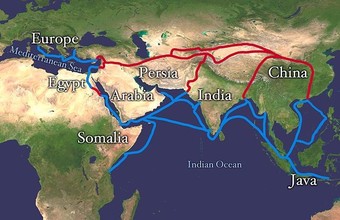
Map of Silk Road
In this map of the Silk Road, red shows the land route and blue shows the maritime route.
The Silk Road was a series
of trade and cultural transmission routes that were central to cultural
interaction between the West and East. Silk was certainly the major trade item
from China, but many other goods were traded as well. These routes enabled strong
trade relationships to develop with Persia, India, and the Roman Empire.
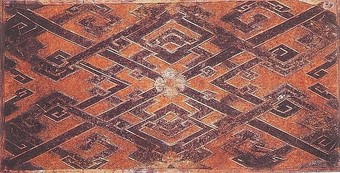
Example of Woven Silk Textile
This woven silk textile from the Western Han era was found at Tomb No. 1 at Mawangdui, Changsha, Hunan Province.
Chinese Control of the Silk Road
This expanded western territory became
particularly important because of the silk routes. By this century, the Chinese had become very active in the silk trade, though
until the Hans provided sufficient protection, the Silk Road had not functioned
well because of nomad pirates. Expansion by the Han took place around 114 BCE, led mainly by imperial envoy Zhang Qian. The Great Wall of China was expanded to provide extra protection.
The Tang Dynasty reopened the route in 639 CE, but then lost it to the Tibetans in 678 CE. Control of the Silk Road would shuttle between China and Tibet until 737 CE. This second Pax Sinica helped the Silk Road reach its golden age. China was open to foreign cultures, and its urban areas could be quite cosmopolitan. The Silk Road helped to integrate cultures, but also exposed tribal and pastoral societies to new developments, sometimes causing them to become skilled warriors.
The Mongolian Empire and the Disintegration of the Silk Road
The Mongol Empire, and Pax Mongolica, strengthened and re-established the Silk Road between 1207 and 1360 CE. However, as the Mongol Empire disintegrated, so did the Silk Road. Gunpowder hastened the failing integration, and the Silk Road stopped being a shipping route for silk around 1453 CE. A lasting effect of this was to inspire Europeans to find alternate routes to Asia for trade, including Christopher Columbus’ famous overseas voyage in 1492.
5.5.3: The Eastern Han Period
The Eastern Han period was a time of reunification and prosperity that also saw the perfection of paper and porcelain.
Learning Objective
Describe the Eastern Han period
Key Points
- The 400-year Han Dynasty was briefly interrupted by the rebellious Xin Dynasty. The first part of the Han Dynasty is known as the Western Han period; the Eastern Han period began when the Han overthrew the rebellion and reestablished the dynasty in 25 CE.
- Emperor Guangwu, the first emperor of the Eastern Han period, regained lost land and pacified the people.
- The Rule of Ming and Zhang was an era of prosperity; taxes were reduced, Confucian ideals were encouraged, the government was capable and strong, and the processes of creating paper and porcelain were perfected.
- A series of rebellions led to powerful generals who attempted to control the young emperor. Eventually, three states gained control and the Han Dynasty was ended.
Key Terms
- Chimei
-
A rebel army that ended the Xin dynasty after unrest.
- regent
-
A relative in a royal family who looks after the throne for an underaged king until he is mature enough to receive power.
- porcelain
-
A Chinese innovation perfected during the Eastern Han Period; durable, high-quality, and attractive ceramic ware.
Interruption by the Xin Dynasty
When the Western Han period ended in 9 CE, the regent to the prior emperor, Wang Mang, proclaimed his own new dynasty, the Xin Dynasty. He attempted a number of radical reforms, such as new forms of currency, a ban on slavery, and a return to old models of land distribution. A series of major floods on the Yellow River, however, displaced thousands of peasants, and caused massive unrest. A rebel army called the Chimei (“Red Eyebrows”) developed out of the peasantry, and they defeated Wang Mang’s armies and stormed the capital of Chang’an. They killed Wang Mang and put their own puppet ruler on the throne.
The Eastern Han Period
A new Han emperor, Emperor Guangwu, took control and ruled from Luoyang, in eastern China; thus began the Eastern Han period, which lasted from 25-220 CE. He defeated the Chimei rebels, as well as rival warlords, to reunify China again under the Han Dynasty.
Under Emperor Guangwu, the empire was strengthened considerably. Areas that had fallen away from Chinese control, such as Korea and Vietnam, were reconquered. The Hun Confederation, which had grown strong during China’s period of instability, was pacified.
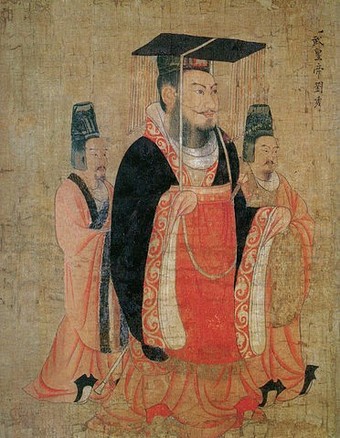
Emperor Guangwu
Emperor Guangwu ruled during the Eastern Han Dynasty.
Emperor Guangwu was succeeded by Emperor Ming, followed by Emperor Zhang. The Rule of Ming and Zhang, as it is called, is remembered for being an era of prosperity. Taxes were reduced, Confucian ideals were encouraged, and the emperors appointed able administrators. It was also in this period that paper, one of China’s most important inventions, emerged. Though early forms of paper had existed for centuries, the process was now perfected. With paper, Chinese texts could circulate on a durable and relatively inexpensive medium, instead of on clay, silk, or bamboo. This allowed Chinese texts to become more readily available and encouraged learning. Another important innovation of this time was porcelain. Porcelain existed in previous forms for centuries, but was perfected in the Eastern Han period. The improvement of porcelain allowed for durable, high-quality, and attractive ceramic ware.
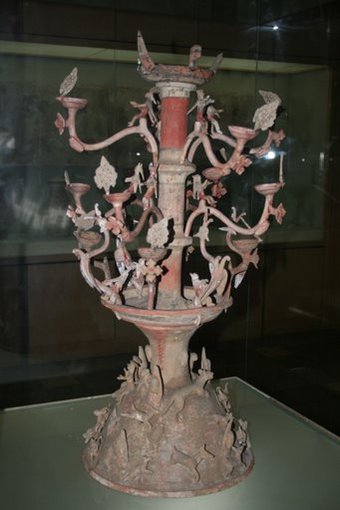
Ceramic Candle Holder from the Eastern Han Dynasty
A ceramic candle holder from the Eastern Han Dynasty, with prancing animal figures.
The Fall of the Eastern Han
A series of rebellions, including the Yellow Turban and Five Pecks of Rice, began in 184 CE. Military generals appointed during these crises kept their militia forces intact even after defeating the rebels. General-in-Chief He Jin plotted to overthrow palace eunuchs. He was discovered and killed, however, in the end 2,000 eunuchs were also killed. A series of generals attempted to control the young emperor, culminating in three spheres of influence. Cao Cao ruled the north, Sun Quan ruled the south, and Liu Bei controlled the west. After Cao Cao’s death, his son Cao Pi forced Emperor Xian to give up his throne to him. This ended the Han Dynasty, and started a period of conflict between these three states, called Cao Wei, Eastern Wu and Shu Han.
5.5.4: Invention of Paper
Paper was invented by Cai Lun during the Han Dynasty of ancient China. It was used for a variety of purposes, including wrapping and writing, and eventually spread throughout the world.
Learning Objective
Analyze the importance of paper and its invention
Key Points
- Cai Lun (202 BCE-220 CE), a Chinese official working in the Imperial court during the Han Dynasty, is attributed with the invention of paper.
- A basic process is still followed today that consists of creating felted sheets of fiber suspended in water, then draining the water and allowing the fibers to dry in a thin matted sheet.
- Early paper was used for wrapping and writing, as well as for toilet paper, tea bags, and napkins.
- After the Battle of Talas in 751 CE, during which the Chinese were defeated, two Chinese prisoners are believed to have leaked the secrets to making paper.
Key Terms
- bast fibers
-
Fibrous material from the phloem of a plant, used as fiber in matting, cord, etc.
- papyrus
-
A material prepared in ancient Egypt from the pithy stem of a water plant, used in sheets throughout the ancient Mediterranean world as a surface for writing or painting.
While the word “paper” is derived from papyrus, the early Egyptian thick writing sheets, it is made quite differently. While papyrus is made from the dried pith of the papyrus plant that has been woven, paper has been disintegrated and reformed.
During the Shang (1600-1050 BCE) and Zhou (1050-250 BCE) dynasties, bone, bamboo, and sometimes silk were used as writing tablets. Cai Lun (202 BCE-220 CE), a Chinese official working in the Imperial court during the Han Dynasty, is attributed with the invention of paper. However, earlier examples have been found, and he may have simply improved upon a known process. Legend states that he was inspired by the nests of paper wasps.
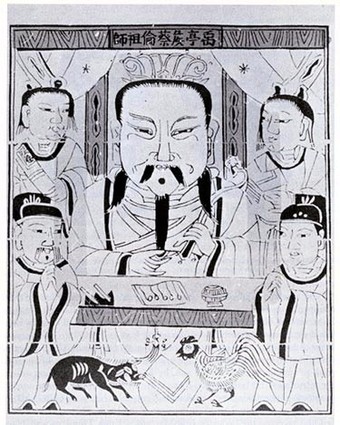
Portrait of Cai Lun
This portrait of Cai Lun depicts the invention of paper.
Cai Lun’s paper was made using mulberry and other bast fibers along with fishnets, old rags, and hemp waste. The bark of the Paper Mulberry and Sandalwood were often used and highly valued during the period. His basic process of creating felted sheets of fiber suspended in water, then draining the water and allowing the fibers to dry in a thin matted sheet is still followed today.
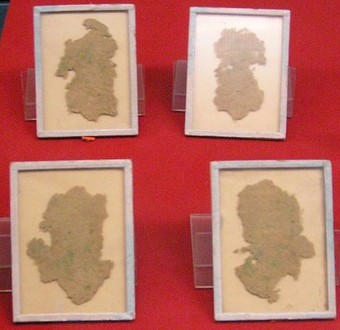
Chinese Hemp Wrapping Paper
These examples of Chinese hemp wrapping paper date from 100 BCE.
Uses of Paper
Paper was often used as a wrapping material. Paper used to wrap bronze mirrors has been dated to the reign of Emperor Wu in the 2nd century BCE. Paper was also used to wrap poisonous medicines. By the 3rd century CE, paper was commonly used for writing, and by 875 CE it was used as toilet paper. During the Tang dynasty (618-907 CE), paper was folded and sewn into tea bags, and used to make paper cups and napkins. During the Song dynasty (960-1279 CE), the world’s first known paper money was produced, and often presented in special paper envelopes.
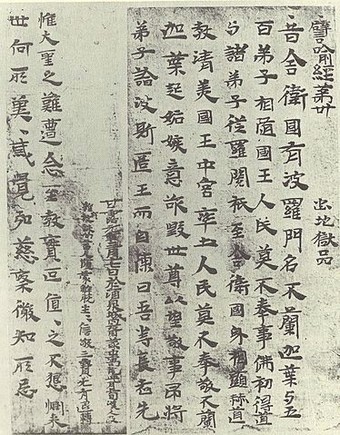
The Oldest Paper Book
This is the oldest paper book, dating to 256 CE.
Spread of Paper-making to the Islamic World
After the Battle of Talas in 751 CE, during which the Chinese were defeated, two Chinese prisoners are believed to have leaked the secrets to making paper. A paper mill was soon established, and many refinements were made to the process.
5.5.5: The Fall of the Han and the Three Kingdoms Period
As the Han Dynasty government weakened over time and ultimately collapsed, the empire fractured into the war-torn Three Kingdoms period.
Learning Objective
Demonstrate the significance of the Battle of the Red Cliffs and the Three Kingdoms Period
Key Points
- The Han government began to weaken and fracture by the end of the second century CE. General Dong Zhuo captured Emperor Shao and installed his own puppet ruler, Emperor Xian.
- The warlord Cao Cao attempted to reunify China under the Han, but was defeated at the Battle of Red Cliffs.
- The Han Dynasty ultimately collapsed in 220 CE, and China splintered into three warlord kingdoms in what is known as the Three Kingdoms period.
- The Three Kingdoms period was war-torn, but also a time of great technological advancement.
Key Terms
- hydraulic
-
An engineering technique in which liquid is in motion and transmits energy.
- Battle of Red Cliffs
-
A turning point in history that marked the last attempt to reunite the Han, and the beginning of a time of bloodshed for the Chinese.
After the death of Emperor Zhang (of the Eastern Han period’s Rule of Ming and Zhang) in 88 CE, corrupt officials increasingly gained control of the state, while family feuds tore the dynasty apart. As the power of the emperor weakened, military commanders acted more independently and tried to secure power for themselves.
The Fall of the Han Dynasty
In 184 CE, two major Daoist rebellions—the Yellow Turban Rebellion and the Five Pecks of Rice Rebellion—broke out. In order to fight these rebellions Emperor Ling gave military commanders control over their own provinces, but this gave way to a long power struggle. In 189 CE, Emperor Ling died and was succeeded by his 13 year old son, Liu Bian, known as Emperor Shao. Empress Dowager He was regent, and her older brother, General-in-Chief He Jin, became the most powerful official in the court. He Jin wanted to exterminate the Ten Attendants, a group of influential eunuch officials. He summoned General Dong Zhuo to march on the city. The plot was discovered by the eunuchs, and He Jin was killed. In response the Emperor ordered indiscriminate killing of the eunuchs. The survivors kidnapped the Emperor and fled, only to later commit suicide upon General Dong Zhuo’s arrival. The General would then replace Emperor Shao with the Prince of Cheniliu, known as Emperor Xian. Xian would be the last emperor of the Han Dynasty.
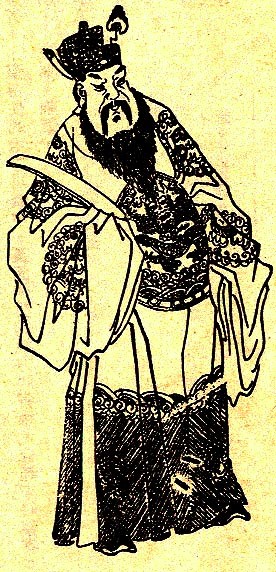
Portrait of Dong Zhuo
This portrait of Dong Zhuo dates from a Qing Dynasty edition of the Romance of the Three Kingdoms.
Dong Zhuo was eventually assassinated and was succeeded by another warlord, Cao Cao, who wanted to reunite the Han Empire by defeating the rebellious warlords. He nearly succeeded but was defeated in 208 CE at the Battle of Red Cliffs, a memorable turning point in history. With this defeat, most of the hope that the Han Empire would be reunited disappeared. When Cao Cao died in 220 CE, Emperor Xian abdicated the throne, claiming that he had failed to keep the Mandate of Heaven. China splintered into three kingdoms ruled by warlords; this marks the beginning of the Three Kingdoms period of Chinese history.
The Three Kingdoms Period
When the Han Dynasty collapsed in 220 CE, no one was powerful enough to reunify China under a single emperor. The result was the period of the Three Kingdoms, which lasted until 280 CE, when the Jin Dynasty took over. These three kingdoms, Wei, Shu, and Wu, battled for control in a long series of wars. This was one of the bloodiest times in Chinese history—according to census data, the population decreased from 50 million to 16 million—but it also has long been romanticized in East Asian cultures and remembered as a time of chivalry and honor. It has been celebrated and popularized in operas, folk stories, and novels, and in more recent times, films, television, and video games.
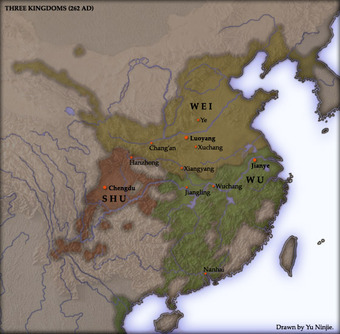
The Three Kingdoms
The Three Kingdoms in 262 CE after the fall of the Han dynasty.
Technology advanced significantly during this period. Shu chancellor Zhuge Liang invented the wooden ox, suggested to be an early form of the wheelbarrow, and improved on the repeating crossbow. Wei mechanical engineer, Ma Jun, invented a hydraulic-powered, mechanical puppet theatre designed for his emperor. He also invented a new irrigation device, the south-pointing chariot, and a non-magnetic directional compass.
Chapter 4: Ancient Egypt
4.1: Introduction to Ancient Egypt
4.1.1: The Rise of Egyptian Civilization
In prehistoric times (pre-3200 BCE), many different cultures lived in Egypt along the Nile River, and became progressively more sedentary and reliant on agriculture. By the time of the Early Dynastic Period, these cultures had solidified into a single state.
Learning Objective
Describe the rise of civilization along the Nile River
Key Points
- The prehistory of Egypt spans from early human settlements to the beginning of the Early Dynastic Period of Egypt (c. 3100 BCE), and is equivalent to the Neolithic period.
- The Late Paleolithic in Egypt began around 30,000 BCE, and featured mobile buildings and tool-making industry.
- The Mesolithic saw the rise of various cultures, including Halfan, Qadan, Sebilian, and Harifian.
- The Neolithic saw the rise of cultures, including Merimde, El Omari, Maadi, Tasian, and Badarian.
- Three phases of Naqada culture included: the rise of new types of pottery (including blacktop-ware and white cross-line-ware), the use of mud-bricks, and increasingly sedentary lifestyles.
- During the Protodynastic period (3200-3000 BCE) powerful kings were in place, and unification of the state occurred, which led to the Early Dynastic Period.
Key Terms
- Neolithic
-
The later part of the Stone Age, during which ground or polished stone weapons and implements were used.
- nomadic pastoralism
-
The herding of livestock to find fresh pasture to graze.
- Fertile Crescent
-
Also known as the Cradle of Civilization, the Fertile Crescent is a crescent-shaped region containing the comparatively moist and fertile land of Western Asia, the Nile Valley, and the Nile Delta.
- serekhs
-
An ornamental vignette combining a view of a palace facade and a top view of the royal courtyard. It was used as a royal crest.
The prehistory of Egypt spans from early human settlements to the beginning of the Early Dynastic Period of Egypt (c. 3100 BCE), which started with the first Pharoah Narmer (also known as Menes). It is equivalent to the Neolithic period, and is divided into cultural periods, named after locations where Egyptian settlements were found.
The Late Paleolithic
This period began around 30,000 BCE. Ancient, mobile buildings, capable of being disassembled and reassembled were found along the southern border near Wadi Halfa. Aterian tool-making industry reached Egypt around 40,000 BCE, and Khormusan industry began between 40,000 and 30,000 BCE.
The Mesolithic
Halfan culture arose along the Nile Valley of Egypt and in Nubia between 18,000 and 15,000 BCE. They appeared to be settled people, descended from the Khormusan people, and spawned the Ibero-Marusian industry. Material remains from these people include stone tools, flakes, and rock paintings.
The Qadan culture practiced wild-grain harvesting along the Nile, and developed sickles and grinding stones to collect and process these plants. These people were likely residents of Libya who were pushed into the Nile Valley due to desiccation in the Sahara. The Sebilian culture (also known as Esna) gathered wheat and barley.
The Harifian culture migrated out of the Fayyum and the Eastern deserts of Egypt to merge with the Pre-Pottery Neolithic B; this created the Circum-Arabian Nomadic Pastoral Complex, who invented nomadic pastoralism, and may have spread Proto-Semitic language throughout Mesopotamia.
The Neolithic
Expansion of the Sahara desert forced more people to settle around the Nile in a sedentary, agriculture-based lifestyle. Around 6000 BCE, Neolithic settlements began to appear in great number in this area, likely as migrants from the Fertile Crescent returned to the area. Weaving occurred for the first time in this period, and people buried their dead close to or within their settlements.
The Merimde culture (5000-4200 BCE) was located in Lower Egypt. People lived in small huts, created simple pottery, and had stone tools. They had cattle, sheep, goats, and pigs, and planted wheat, sorghum, and barley. The first Egyptian life-size clay head comes from this culture.
The El Omari culture (4000-3100 BCE) lived near modern-day Cairo. People lived in huts, and had undecorated pottery and stone tools. Metal was unknown.
The Maadi culture (also known as Buto Maadi) is the most important Lower Egyptian prehistoric culture. Copper was used, pottery was simple and undecorated, and people lived in huts. The dead were buried in cemeteries.
The Tasian culture (4500-3100 BCE) produced a kind of red, brown, and black pottery, called blacktop-ware. From this period on, Upper Egypt was strongly influenced by the culture of Lower Egypt.
The Badarian culture (4400-4000 BCE) was similar to the Tasian, except they improved blacktop-ware and used copper in addition to stone.
The Amratian culture (Naqada I) (4000-3500 BCE) continued making blacktop-ware, and added white cross-line-ware, which featured pottery with close, parallel, white, crossed lines. Mud-brick buildings were first seen in this period in small numbers.
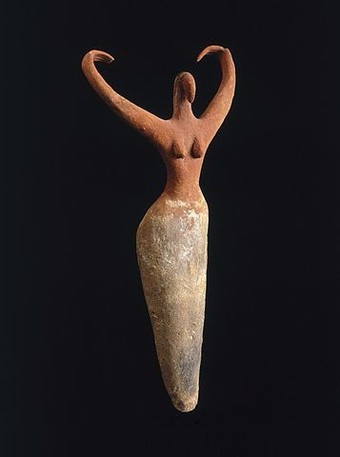
Amratian (Naqada I) Terracotta Figure
This terracotta female figure, c. 3500-3400 BCE, is housed at the Brooklyn Museum.
The Gerzean culture (Naqada II, 3500-3200 BCE) saw the laying of the foundation for Dynastic Egypt. It developed out of Amratian culture, moving south through Upper Egypt. Its pottery was painted dark red with pictures of animals, people and ships. Life was increasingly sedentary and focused on agriculture, as cities began to grow. Mud bricks were mass-produced, copper was used for tools and weapons, and silver, gold, lapis, and faience were used as decorations. The first Egyptian-style tombs were built.
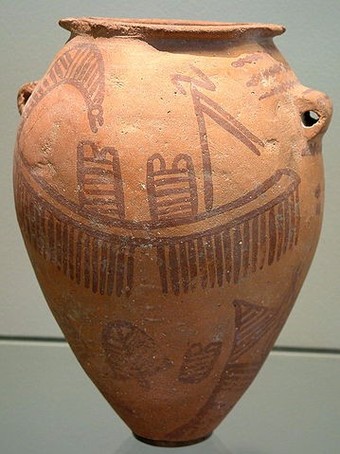
Naqada II Pottery
This pottery has a ship theme, and is done in the style of Naqada II.
Protodynastic Period (Naqada III) (3200 – 3000 BCE)
During this period, the process of state formation, begun in Naqada II, became clearer. Kings headed up powerful polities, but they were unrelated. Political unification was underway, which culminated in the formation of a single state in the Early Dynastic Period. Hieroglyphs may have first been used in this period, along with irrigation. Additionally, royal cemeteries and serekhs (royal crests) came into use.
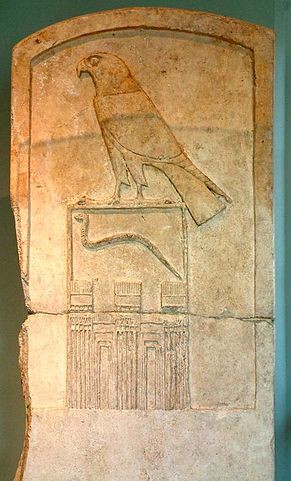
Serekh of King Djet
This serekh (royal crest) shows the Horus falcon.
4.2: The Old Kingdom
4.2.1: The Old Kingdom
The Old Kingdom, spanning the Third to Sixth Dynasties of Egypt (2686-2181 BCE), saw the prolific construction of pyramids, but declined due to civil instability, resource shortages, and a drop in precipitation.
Learning Objective
Explain the reasons for the rise and fall of the Old Kingdom
Key Points
- The Old Kingdom is the name commonly given to the period when Egypt gained in complexity and achievement, spanning from the Third Dynasty through the Sixth Dynasty (2686-2181 BCE).
- The royal capital of Egypt during the Old Kingdom was located at Memphis, where the first notable king of the Old Kingdom, Djoser, established his court.
- In the Third Dynasty, formerly independent ancient Egyptian states became known as Nomes, which were ruled solely by the pharaoh. The former rulers of these states were subsequently forced to assume the role of governors, or otherwise work in tax collection.
- Egyptians during this Dynasty worshipped their pharaoh as a god, and believed that he ensured the stability of the cycles that were responsible for the annual flooding of the Nile. This flooding was necessary for their crops.
- The Fourth Dynasty saw multiple large-scale construction projects under pharaohs Sneferu, Khufu, and Khufu’s sons Djedefra and Khafra, including the famous pyramid and Sphinx at Giza.
- The Fifth Dynasty saw changes in religious beliefs, including the rise of the cult of the sun god Ra, and the deity Osiris.
- The Sixth Dynasty saw civil war and the loss of centralized power to nomarchs.
Key Terms
- Ra
-
The sun god, or the supreme Egyptian deity, worshipped as the creator of all life, and usually portrayed with a falcon’s head bearing a solar disc.
- Osiris
-
The Egyptian god of the underworld, and husband and brother of Isis.
- Nomes
-
Subnational, administrative division of Ancient Egypt.
- nomarchs
-
Semi-feudal rulers of Ancient Egyptian provinces.
- Old Kingdom
-
Encompassing the Third to Eighth Dynasties, the name commonly given to the period in the 3rd millennium BCE, when Egypt attained its first continuous peak of complexity and achievement.
- Djoser
-
An ancient Egyptian pharaoh of the Third Dynasty, and the founder of the Old Kingdom.
- necropolis
-
A cemetery, especially a large one belonging to an ancient city.
- Sneferu
-
A king of the Fourth Dynasty, who used the greatest mass of stones in building pyramids.
The Old Kingdom is the name commonly given to the period from the Third Dynasty through the Sixth Dynasty (2686-2181 BCE), when Egypt gained in complexity and achievement. The Old Kingdom is the first of three so-called “Kingdom” periods that mark the high points of civilization in the Nile Valley. During this time, a new type of pyramid (the step) was created, as well as many other massive building projects, including the Sphinx. Additionally, trade became more widespread, new religious ideas were born, and the strong centralized government was subtly weakened and finally collapsed.
The king (not yet called Pharaoh) of Egypt during this period resided in the new royal capital, Memphis. He was considered a living god, and was believed to ensure the annual flooding of the Nile. This flooding was necessary for crop growth. The Old Kingdom is perhaps best known for a large number of pyramids, which were constructed as royal burial places. Thus, the period of the Old Kingdom is often called “The Age of the Pyramids.”
Egypt’s Old Kingdom was also a dynamic period in the development of Egyptian art. Sculptors created early portraits, the first life-size statues, and perfected the art of carving intricate relief decoration. These had two principal functions: to ensure an ordered existence, and to defeat death by preserving life in the next world.
The Beginning: Third Dynasty (c. 2650-2613 BCE)
The first notable king of the Old Kingdom was Djoser (reigned from 2691-2625 BCE) of the Third Dynasty, who ordered the construction of the step pyramid in Memphis’ necropolis, Saqqara. It was in this era that formerly independent ancient Egyptian states became known as nomes, and were ruled solely by the king. The former rulers of these states were forced to assume the role of governors or tax collectors.
Golden Age: Fourth Dynasty (2613-2494 BCE)
The Old Kingdom and its royal power reached a zenith under the Fourth Dynasty, which began with Sneferu (2613-2589 BCE). Using a greater mass of stones than any other king, he built three pyramids: Meidum, the Bent Pyramid, and the Red Pyramid. He also sent his military into Sinai, Nubia and Libya, and began to trade with Lebanon for cedar.
Sneferu was succeeded by his (in)famous son, Khufu (2589-2566 BCE), who built the Great Pyramid of Giza. After Khufu’s death, one of his sons built the second pyramid, and the Sphinx in Giza. Creating these massive projects required a centralized government with strong powers, sophistication and prosperity. Builders of the pyramids were not slaves but peasants, working in the farming off-season, along with specialists like stone cutters, mathematicians, and priests. Each household needed to provide a worker for these projects, although the wealthy could have a substitute.
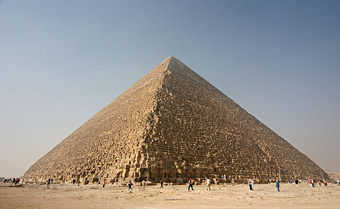
The Pyramid of Khufu at Giza
The Great Pyramid of Giza was built c. 2560 BCE, by Khufu during the Fourth Dynasty. It was built as a tomb for Khufu and constructed over a 20-year period. Modern estimates place construction efforts to require an average workforce of 14,567 people and a peak workforce of 40,000.
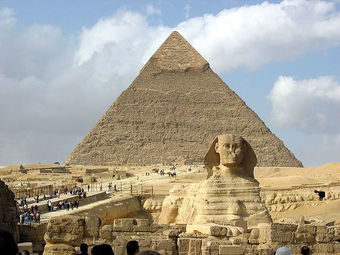
Great Sphinx of Giza and the pyramid of Khafre
The Sphinx is a limestone statue of a reclining mythical creature with a lion’s body and a human head that stands on the Giza Plateau on the west bank of the Nile in Giza, Egypt. The face is generally believed to represent the face of King Khafra.
The later kings of the Fourth Dynasty were king Menkaura (2532-2504 BCE), who built the smallest pyramid in Giza, Shepseskaf (2504-2498 BCE), and perhaps Djedefptah (2498-2496 BCE). During this period, there were military expeditions into Canaan and Nubia, spreading Egyptian influence along the Nile into modern-day Sudan.
Religious Changes: Fifth Dynasty (2494-2345 BCE)
The Fifth Dynasty began with Userkaf (2494-2487 BCE), and with several religious changes. The cult of the sun god Ra, and temples built for him, began to grow in importance during the Fifth Dynasty. This lessened efforts to build pyramids. Funerary prayers on royal tombs (called Pyramid Texts) appeared, and the cult of the deity Osiris ascended in importance.
Egyptians began to build ships to trade across maritime routes. Goods included ebony, incense, gold, and copper. They traded with Lebanon for cedar, and perhaps with modern-day Somalia for other goods. Ships were held together by tightly tied ropes.
Decline and Collapse: The Sixth Dynasty (2345-2181 BCE)
The power of the king and central government declined during this period, while that of nomarchs (regional governors) increased. These nomarchs were not part of the royal family. They passed down the title through their lineage, thus creating local dynasties that were not under the control of the king. Internal disorder resulted during and after the long reign of Pepi II (2278-2184 BCE), due to succession struggles, and eventually led to civil war. The final blow was a severe drought between 2200-2150 BCE, which prevented Nile flooding. Famine, conflict, and collapse beset the Old Kingdom for decades.
4.2.2: The First Intermediate Period
The First Intermediate Period, the Seventh to Eleventh dynasties, spanned approximately one hundred years (2181-2055 BCE), and was characterized by political instability and conflict between the Heracleopolitan and Theban Kings.
Learning Objective
Describe the processes by which the First Intermediate Period occurred, and then transitioned into the Middle Kingdom
Key Points
- The First Intermediate Period was a dynamic time in history, when rule of Egypt was roughly divided between two competing power bases. One of those bases resided at Heracleopolis in Lower Egypt, a city just south of the Faiyum region. The other resided at Thebes in Upper Egypt.
- The Old Kingdom fell due to problems with succession from the Sixth Dynasty, the rising power of provincial monarchs, and a drier climate that resulted in widespread famine.
- Little is known about the Seventh and Eighth Dynasties due to a lack of evidence, but the Seventh Dynasty was most likely an oligarchy, while Eighth Dynasty rulers claimed to be the descendants of the Sixth Dynasty kings. Both ruled from Memphis.
- The Heracleopolitan Kings saw periods of both violence and peace under their rule, and eventually brought peace and order to the Nile Delta region.
- Siut princes to the south of the Heracleopolitan Kingdom became wealthy from a variety of agricultural and economic activities, and acted as a buffer during times of conflict between the northern and southern parts of Egypt.
- The Theban Kings enjoyed a string of military successes, the last of which was a victory against the Heracleopolitan Kings that unified Egypt under the Twelfth Dynasty.
Key Terms
- First Intermediate Period
-
A period of political conflict and instability lasting approximately 100 years and spanning the Seventh to Eleventh Dynasties.
- Mentuhotep II
-
A pharaoh of the Eleventh Dynasty, who defeated the Heracleopolitan Kings and unified Egypt. Often considered the first pharaoh of the Middle Kingdom.
- nomarchs
-
Ancient Egyptian administration officials responsible for governing the provinces.
- oligarchy
-
A form of power structure in which power effectively rests with a small number of people who are distinguished by royalty, wealth, family ties, education, corporate, or military control.
The First Intermediate Period (c. 2181-2055 BCE), often described as a “dark period” in ancient Egyptian history after the end of the Old Kingdom, spanned approximately 100 years. It included the Seventh, Eighth, Ninth, Tenth, and part of the Eleventh dynasties.
The First Intermediate Period was a dynamic time in history when rule of Egypt was roughly divided between two competing power bases: Heracleopolis in Lower Egypt, and Thebes in Upper Egypt. It is believed that political chaos during this time resulted in temples being pillaged, artwork vandalized, and statues of kings destroyed. These two kingdoms eventually came into military conflict. The Theban kings conquered the north, which resulted in the reunification of Egypt under a single ruler during the second part of the Eleventh dynasty.
Events Leading to the First Intermediate Period
The Old Kingdom, which preceded this period, fell for numerous reasons. One was the extremely long reign of Pepi II (the last major king of the Sixth Dynasty), and the resulting succession issues. Another major problem was the rise in power of the provincial nomarchs. Toward the end of the Old Kingdom, the positions of the nomarchs had become hereditary, creating family legacies independent from the king. They erected tombs in their own domains and often raised armies, and engaged in local rivalries. A third reason for the dissolution of centralized kingship was the low level of the Nile inundation, which may have resulted in a drier climate, lower crop yields, and famine.
The Seventh and Eighth Dynasties at Memphis
The Seventh and Eighth dynasties are often overlooked because very little is known about the rulers of these two periods. The Seventh Dynasty was most likely an oligarchy based in Memphis that attempted to retain control of the country. The Eighth Dynasty rulers, claiming to be the descendants of the Sixth Dynasty kings, also ruled from Memphis.
The Heracleopolitan Kings
After the obscure reign of the Seventh and Eighth dynasty kings, a group of rulers rose out of Heracleopolis in Lower Egypt, and ruled for approximately 94 years. These kings comprise the Ninth and Tenth Dynasties, each with 19 rulers.
The founder of the Ninth Dynasty, Wahkare Khety I, is often described as an evil and violent ruler who caused much harm to the inhabitants of Egypt. He was seized with madness, and, as legend would have it, was eventually killed by a crocodile. Kheti I was succeeded by Kheti II, also known as Meryibre, whose reign was essentially peaceful but experienced problems in the Nile Delta. His successor, Kheti III, brought some degree of order to the Delta, although the power and influence of these Ninth Dynasty kings were still insignificant compared to that of the Old Kingdom kings.
A distinguished line of nomarchs rose out of Siut (or Asyut), which was a powerful and wealthy province in the south of the Heracleopolitan kingdom. These warrior princes maintained a close relationship with the kings of the Heracleopolitan royal household, as is evidenced by the inscriptions in their tombs. These inscriptions provide a glimpse at the political situation that was present during their reigns, and describe the Siut nomarchs digging canals, reducing taxation, reaping rich harvests, raising cattle herds, and maintaining an army and fleet. The Siut province acted as a buffer state between the northern and southern rulers and bore the brunt of the attacks from the Theban kings.
The Theban Kings
The Theban kings are believed to have been descendants of Intef or Inyotef, the nomarch of Thebes, often called the “Keeper of the Door of the South. ” He is credited with organizing Upper Egypt into an independent ruling body in the south, although he himself did not appear to have tried to claim the title of king. Intef II began the Theban assault on northern Egypt, and his successor, Intef III, completed the attack and moved into Middle Egypt against the Heracleopolitan kings. The first three kings of the Eleventh Dynasty (all named Intef) were, therefore, also the last three kings of the First Intermediate Period. They were succeeded by a line of kings who were all called Mentuhotep. Mentuhotep II, also known as Nebhepetra, would eventually defeat the Heracleopolitan kings around 2033 BCE, and unify the country to continue the Eleventh Dynasty and bring Egypt into the Middle Kingdom.
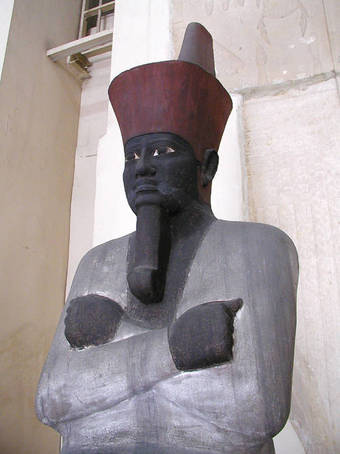
Mentuhotep II
Painted sandstone seated statue of Nebhepetre Mentuhotep II, Egyptian Museum, Cairo.
4.3: The Middle Kingdom
4.3.1: The Middle Kingdom
The Middle Kingdom was a period of Egyptian history spanning the Eleventh through Twelfth Dynasty (2000-1700 BCE), when centralized power consolidated a unified Egypt.
Learning Objective
Describe the various characteristics of Sensuret III’s rule during the height of the Middle Kingdom
Key Points
- The Middle Kingdom had two phases: the end of the Eleventh Dynasty, which ruled from Thebes, and the Twelfth Dynasty onwards, which was centred around el-Lisht.
- During the First Intermediate Period, the governors of the nomes of Egypt—
called nomarchs—
gained considerable power. Amenemhet I also instituted a system of co-regency, which ensured a smooth transition from monarch to monarch and contributed to the stability of the Twelfth Dynasty.
- The height of the Middle Kingdom came under the rules of Sensuret III and Amenemhat III, the former of whom established clear boundaries for Egypt, and the latter of whom efficiently exploited Egyptian resources to bring about a period of economic prosperity.
- The Middle Kingdom declined into the Second Intermediate Period during the Thirteenth Dynasty, after a gradual loss of dynastic power and the disintegration of Egypt.
Key Terms
- Amenemhat III
-
Egyptian king who saw a great period of economic prosperity through efficient exploitation of natural resources.
- nomes
-
Subnational administrative divisions within ancient Egypt.
- Middle Kingdom
-
Period of unification in Ancient Egyptian history, stretching from the end of the Eleventh Dynasty to the Thirteenth Dynasty, roughly between 2030-1640 BCE.
- Senusret III
-
Warrior-king during the Twelfth Dynasty, who centralized power within Egypt through various military successes.
- Sobekneferu,
-
The first known female ruler of Egypt.
- waret
-
Administrative divisions in Egypt.
- genut
The Middle Kingdom, also known as the Period of Reunification, is a period in the history of Ancient Egypt stretching from the end of the Eleventh Dynasty to the end of the Twelfth Dynasty, roughly between 2000-1700 BCE. There were two phases: the end of the Eleventh Dynasty, which ruled from Thebes, and the Twelfth Dynasty onwards, which was centred around el-Lisht.
The End of the Eleventh Dynasty and the Rise of the Twelfth Dynasty
Toward the end of the First Intermediate Period, Mentuhotep II and his successors unified Egypt under a single rule, and commanded such faraway locations as Nubia and the Sinai. He reigned for 51 years and restored the cult of the ruler, considering himself a god and wearing the headdresses of Amun and Min. His descendants ruled Egypt, until a vizier, Amenemhet I, came to power and initiated the Twelfth Dynasty.
From the Twelfth dynasty onward, pharaohs often kept well-trained standing armies, which formed the basis of larger forces raised for defense against invasion, or for expeditions up the Nile or across the Sinai. However, the Middle Kingdom remained defensive in its military strategy, with fortifications built at the First Cataract of the Nile, in the Delta and across the Sinai Isthmus.
Amenemhet I never held the absolute power commanded, in theory, by the Old Kingdom pharaohs. During the First Intermediate Period, the governors of the nomes of Egypt—
nomarchs—gained considerable power. To strengthen his position, Amenemhet required registration of land, modified nome borders, and appointed nomarchs directly when offices became vacant. Generally, however, he acquiesced to the nomarch system, creating a strongly feudal organization.
In his 20th regnal year, Amenemhat established his son, Senusret I, as his co-regent. This instituted a practice that would be used throughout the Middle and New Kingdoms. The reign of Amenemhat II, successor to Senusret I, has been characterized as largely peaceful. It appears Amenemhet allowed nomarchs to become hereditary again. In his 33rd regnal year, he appointed his son, Senusret II, co-regent.
There is no evidence of military activity during the reign of Senusret II. Senusret instead appears to have focused on domestic issues, particularly the irrigation of the Faiyum. He reigned only fifteen years, and was succeeded by his son, Senusret III.
Height of the Middle Kingdom
Senusret III was a warrior-king, and launched a series of brutal campaigns in Nubia. After his victories, Senusret built a series of massive forts throughout the country as boundary markers; the locals were closely watched.
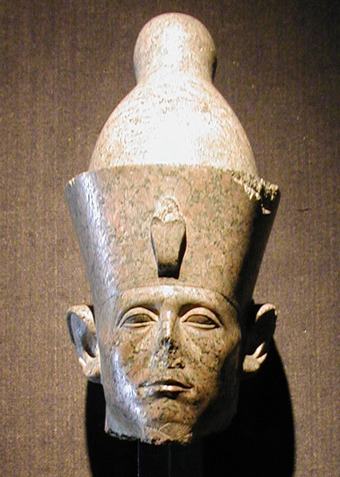
Statue head of Sensuret III
Statue head of Sensuret III, one of the kings in the Twelfth Dynasty.
Domestically, Senusret has been given credit for an administrative reform that put more power in the hands of appointees of the central government. Egypt was divided into three warets, or administrative divisions: North, South, and Head of the South (perhaps Lower Egypt, most of Upper Egypt, and the nomes of the original Theban kingdom during the war with Herakleopolis, respectively). The power of the nomarchs seems to drop off permanently during Sensuret’s reign, which has been taken to indicate that the central government had finally suppressed them, though there is no record that Senusret took direct action against them.
The reign of Amenemhat III was the height of Middle Kingdom economic prosperity, and is remarkable for the degree to which Egypt exploited its resources. Mining camps in the Sinai, that had previously been used only by intermittent expeditions, were operated on a semi-permanent basis. After a reign of 45 years, Amenemhet III was succeeded by Amenemhet IV, under whom dynastic power began to weaken. Contemporary records of the Nile flood levels indicate that the end of the reign of Amenemhet III was dry, and crop failures may have helped to destabilize the dynasty. Furthermore, Amenemhet III had an inordinately long reign, which led to succession problems. Amenemhet IV was succeeded by Sobekneferu, the first historically attested female king of Egypt, who ruled for no more than four years. She apparently had no heirs, and when she died the Twelfth Dynasty came to a sudden end.
Decline into the Second Intermediate Period
After the death of Sobeknefru, Egypt was ruled by a series of ephemeral kings for about 10-15 years. Ancient Egyptian sources regard these as the first kings of the Thirteenth Dynasty.
After the initial dynastic chaos, a series of longer reigning, better attested kings ruled for about 50-80 years. The strongest king of this period, Neferhotep I, ruled for 11 years, maintained effective control of Upper Egypt, Nubia, and the Delta, and was even recognized as the suzerain of the ruler of Byblos. At some point during the Thirteenth Dynasty, the provinces of Xois and Avaris began governing themselves. Thus began the final portion of the Thirteenth Dynasty, when southern kings continued to reign over Upper Egypt; when the unity of Egypt fully disintegrated, however, the Middle Kingdom gave way to the Second Intermediate Period.
4.3.2: The Second Intermediate Period
The Second Intermediate Period (c. 1650-1550 BCE) spanned the Fourteenth to Seventeenth Dynasties, and was a period in which decentralized rule split Egypt between the Theban-based Seventeenth Dynasty in Upper Egypt and the Sixteenth Dynasty under the Hyksos in the north.
Learning Objective
Explain the dynamics between the various groups of people vying for power during the Second Intermediate Period
Key Points
- The brilliant Twelfth Dynasty was succeeded by a weaker Thirteenth Dynasty, which experienced a splintering of power.
- The Hyksos made their first appearance during the reign of Sobekhotep IV, and overran Egypt at the end of the Fourteenth Dynasty. They ruled through the Fifteenth and Sixteenth Dynasties.
- The Abydos Dynasty was a short-lived Dynasty that ruled over part of Upper Egypt, and was contemporaneous with the Fifteenth and Sixteenth Dynasties.
- The Seventeeth Dynasty established itself in Thebes around the time that the Hyksos took power in Egypt, and co-existed with the Hyksos through trade for a period of time. However, rulers from the Seventeenth Dynasty undertook several wars of liberation that eventually once again unified Egypt in the Eighteenth Dynasty.
Key Terms
- Hyksos
-
An Asiatic people from West Asia who took over the eastern Nile Delta, ending the Thirteenth dynasty of Egypt and initiating the Second Intermediate Period.
- Abydos Dynasty
-
A short-lived local dynasty ruling over parts of Upper Egypt during the Second Intermediate Period in Ancient Egypt.
- Baal
-
The native storm god of the Hyksos.
- Second Intermediate Period
-
Spanning the Fourteenth to Seventeenth Dynasties, a period of Egyptian history where power was split between the Hyksos and a Theban-based dynasty in Upper Egypt.
The Second Intermediate Period (c. 1782-1550 BCE) marks a time when Ancient Egypt once again fell into disarray between the end of the Middle Kingdom, and the start of the New Kingdom. It is best known as the period when the Hyksos, who reigned during the Fifteenth and Sixteenth Dynasties, made their appearance in Egypt.
The Thirteenth Dynasty (1803 – 1649 BCE)
The brilliant Egyptian Twelfth Dynasty—
and the Golden Age of the Middle Kingdom— came to an end around 1800 BCE with the death of Queen Sobekneferu (1806-1802 BCE), and was succeeded by the much weaker Thirteenth Dynasty (1803-1649 BCE). Pharoahs ruled from Memphis until the Hyksos conquered the capital in 1650 BCE.
The Fourteenth Dynasty (c. 1725-1650 BCE)
The Thirteenth Dynasty proved unable to hold onto the long land of Egypt, and the provincial ruling family in Xois, located in the marshes of the western Delta, broke away from the central authority to form the Fourteenth Dynasty. The capital of this dynasty was likely Avaris. It existed concurrently with the Thirteenth Dynasty, and its rulers seemed to be of Canaanite or West Semitic descent.
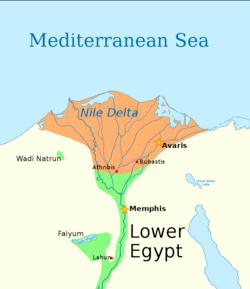
Fourteenth Dynasty Territory
The area in orange is the territory possibly under control of the Fourteenth Dynasty.
The Fifteenth Dynasty (c. 1650-1550 BCE)
The Hyksos made their first appearance in 1650 BCE and took control of the town of Avaris. They would also conquer the Sixteenth Dynasty in Thebes and a local dynasty in Abydos (see below). The Hyksos were of mixed Asiatic origin with mainly Semitic components, and their native storm god, Baal, became associated with the Egyptian storm god Seth. They brought technological innovation to Egypt, including bronze and pottery techniques, new breeds of animals and new crops, the horse and chariot, composite bow, battle-axes, and fortification techniques for warfare. These advances helped Egypt later rise to prominence.
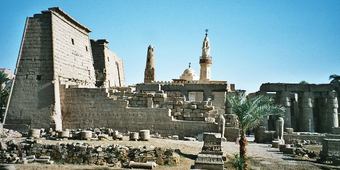
Luxor Temple
Thebes was the capital of many of the Sixteenth Dynasty pharaohs.
The Sixteenth Dynasty
This dynasty ruled the Theban region in Upper Egypt for 70 years, while the armies of the Fifteenth Dynasty advanced against southern enemies and encroached on Sixteenth territory. Famine was an issue during this period, most notably during the reign of Neferhotep III.
The Abydos Dynasty
The Abydos Dynasty was a short-lived local dynasty that ruled over part of Upper Egypt and was contemporaneous with the Fifteenth and Sixteenth Dynasties c. 1650-1600 BCE. The royal necropolis of the Abydos Dynasty was found in the southern part of Abydos, in an area called Anubis Mountain in ancient times, adjacent to the tombs of the Middle Kingdom rulers.
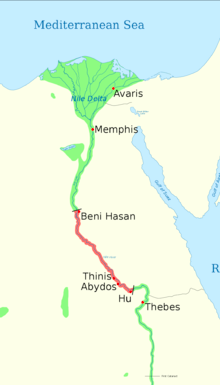
The Abydos Dynasty
This map shows the possible extent of power of the Abydos Dynasty (in red).
The Seventeenth Dynasty (c. 1580-1550 BCE)
Around the time Memphis and Itj-tawy fell to the Hyksos, the native Egyptian ruling house in Thebes declared its independence from Itj-tawy and became the Seventeenth Dynasty. This dynasty would eventually lead the war of liberation that drove the Hyksos back into Asia. The Theban-based Seventeenth Dynasty restored numerous temples throughout Upper Egypt while maintaining peaceful trading relations with the Hyksos kingdom in the north. Indeed, Senakhtenre Ahmose, the first king in the line of Ahmoside kings, even imported white limestone from the Hyksos-controlled region of Tura to make a granary door at the Temple of Karnak. However, his successors—the final two kings of this dynasty—,Seqenenre Tao and Kamose, defeated the Hyksos through several wars of liberation. With the creation of the Eighteenth Dynasty around 1550 BCE, the New Kingdom period of Egyptian history began with Ahmose I, its first pharaoh, who completed the expulsion of the Hyksos from Egypt and placed the country, once again, under centralized administrative control.
4.4: The New Kingdom
4.4.1: The New Kingdom
The New Kingdom of Egypt spanned the Eighteenth to Twentieth Dynasties (c. 1550-1077 BCE), and was Egypt’s most prosperous time. It was ruled by pharaohs Hatshepsut, Thutmose III, Akhenaten, Tutankhamun and Ramesses II.
Learning Objective
Explain the reasons for the collapse of the New Kingdom
Key Points
- The New Kingdom saw Egypt attempt to create a buffer against the Levant and by attaining its greatest territorial by extending into Nubia and the Near East. This was possibly a result of the foreign rule of the Hyksos during the Second Intermediate Period,
- The Eighteenth Dynasty contained some of Egypt’s most famous pharaohs, including Hatshepsut, Akhenaten, Thutmose III, and Tutankhamun. Hatshepsut concentrated on expanding Egyptian trade, while Thutmose III consolidated power.
- Akhenaten’s devotion to Aten defined his reign with religious fervor, while art flourished under his rule and attained an unprecedented level of realism.
- Due to Akenaten’s lack of interest in international affairs, the Hittites gradually extended their influence into Phoenicia and Canaan.
- Ramesses II attempted war against the Hittites, but eventually agreed to a peace treaty after an indecisive result.
- The heavy cost of military efforts in addition to climatic changes resulted in a loss of centralized power at the end of the Twentieth Dynasty, leading to the Third Intermediate Period.
Key Terms
- New Kingdom
-
The period in ancient Egyptian history between the 16th century BCE and the 11th century BCE that covers the Eighteenth, Nineteenth, and Twentieth Dynasties of Egypt. Considered to be the peak of Egyptian power.
- Thutmose III
-
The sixth pharaoh of the Eighteenth Dynasty, who greatly consolidated political power through a series of military conquests.
- Akhenaten
-
Pharaoh of the Eighteenth Dynasty known for his religious fervor to the god Aten.
- Hatshepsut
-
The fifth pharaoh of the Eighteenth Dynasty, who expanded Egyptian trade.
- Tutankhamun
-
An Egyptian pharaoh of the 18th dynasty (ruled c. 1332 BC-1323 BC in the conventional chronology), during the period of Egyptian history known as the New Kingdom. He is popularly referred to as King Tut.
- Aten
-
The disk of the sun in ancient Egyptian mythology, and originally an aspect of Ra.
- Ramesses II
-
The third pharaoh of the Nineteenth Dynasty of Egypt, who made peace with the Hittites. Often regarded as the greatest, most celebrated, and most powerful pharaoh of the Egyptian Empire.
The New Kingdom of Egypt, also referred to as the Egyptian Empire, is the period in ancient Egyptian history between 1550-1070 BCE, covering the Eighteenth, Nineteenth, and Twentieth Dynasties of Egypt. The New Kingdom followed the Second Intermediate Period, and was succeeded by the Third Intermediate Period. It was Egypt’s most prosperous time and marked the peak of its power.
The Nineteenth and Twentieth Dynasties (1292-1069 BCE) are also known as the Ramesside period, after the eleven pharaohs that took the name of Ramesses. The New Kingdom saw Egypt attempt to create a buffer against the Levant and attain its greatest territorial extent. This was possibly a result of the foreign rule of the Hyksos during the Second Intermediate Period
The Eighteenth Dynasty (c. 1543-1292 BCE)
The Eighteenth Dynasty, also known as the Thutmosid Dynasty, contained some of Egypt’s most famous pharaohs, including Ahmose I, Hatshepsut, Thutmose III, Amenhotep III, Akhenaten (c. 1353-1336 BCE) and his queen Nefertiti, and Tutankhamun. Queen Hatshepsut (c. 1479 – 1458 BCE) concentrated on expanding Egypt’s external trade by sending a commercial expedition to the land of Punt, and was the longest-reigning woman pharaoh of an indigenous dynasty. Thutmose III, who would become known as the greatest military pharoah, expanded Egypt’s army and wielded it with great success to consolidate the empire created by his predecessors. These victories maximized Egyptian power and wealth during the reign of Amenhotep III. It was also during the reign of Thutmose III that the term “pharaoh,” originally referring to the king’s palace, became a form of address for the king.
One of the best-known Eighteenth Dynasty pharaohs is Amenhotep IV (c. 1353-1336 BCE), who changed his name to Akhenaten in honor of Aten and whose exclusive worship of the deity is often interpreted as the first instance of monotheism. Under his reign Egyptian art flourished and attained an unprecedented level of realism. Toward the end of this dynasty, the Hittites had expanded their influence into Phoenicia and Canaan, the outcome of which would be inherited by the rulers of the Nineteenth Dynasty.
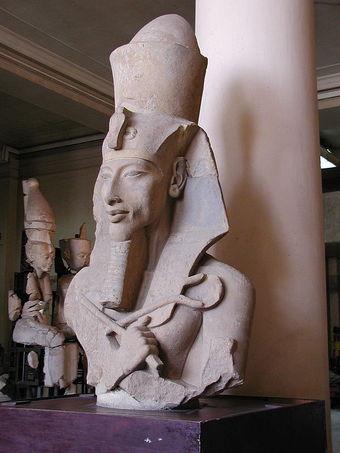
Bust of Akhenaten
Akhenaten, born Amenhotep IV, was the son of Queen Tiye. He rejected the old Egyptian religion and promoted the Aten as a supreme deity.
The Nineteenth Dynasty (c. 1292-1187 BCE)
New Kingdom Egypt would reach the height of its power under Seti I and Ramesses II, who fought against the Libyans and Hittites. The city of Kadesh was a flashpoint, captured first by Seti I and then used as a peace bargain with the Hatti, and later attacked again by Ramesses II. Eventually, the Egyptians and Hittites signed a lasting peace treaty.
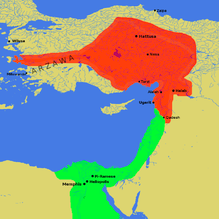
Egyptian and Hittite Empires
This map shows the Egyptian (green) and Hittite (red) Empires around 1274 BCE.
Ramesses II had a large number of children, and he built a massive funerary complex for his sons in the Valley of the Kings. The Nineteenth Dynasty ended in a revolt led by Setnakhte, the founder of the Twentieth Dynasty.
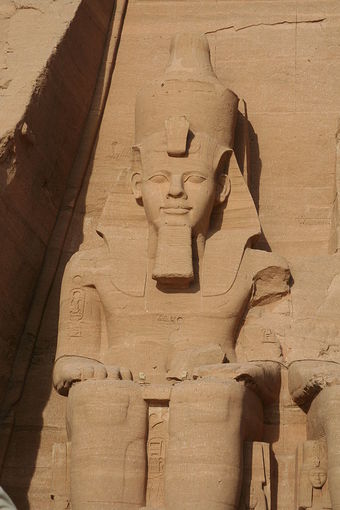
Temple of Ramesses II
Detail of the Temple of Ramesses II.
The Twentieth Dynasty (c. 1187-1064 BCE)
The last “great” pharaoh from the New Kingdom is widely regarded to be Ramesses III. In the eighth year of his reign, the Sea Peoples invaded Egypt by land and sea, but were defeated by Ramesses III.
The heavy cost of warfare slowly drained Egypt’s treasury and contributed to the gradual decline of the Egyptian Empire in Asia. The severity of the difficulties is indicated by the fact that the first known labor strike in recorded history occurred during the 29th year of Ramesses III’s reign, over food rations. Despite a palace conspiracy which may have killed Ramesses III, three of his sons ascended the throne successively as Ramesses IV, Ramesses VI and Ramesses VIII. Egypt was increasingly beset by droughts, below-normal flooding of the Nile, famine, civil unrest, and official corruption. The power of the last pharaoh of the dynasty, Ramesses XI, grew so weak that, in the south, the High Priests of Amun at Thebes became the de facto rulers of Upper Egypt. The Smendes controlled Lower Egypt even before Ramesses XI’s death. Menes eventually founded the Twenty-first Dynasty at Tanis.
4.4.2: Hatshepsut
Hatshepsut ruled Egypt in the Eighteenth Dynasty (1478-1458 BCE), and brought wealth and a focus on large building projects. She was one of just a handful of female rulers.
Learning Objective
Describe the achievements of Hatshepsut in Ancient Egypt
Key Points
- Hatshepsut reigned Egypt from 1478-1458 BCE, during the Eighteenth Dynasty. She ruled longer than any other woman of an indigenous Egyptian dynasty.
- Hatshepsut established trade networks that helped build the wealth of the Eighteenth Dynasty.
- Hundreds of construction projects and statuary were commissioned by Hatshepsut, including obelisks and monuments at the Temple of Karnak.
- While not the first female ruler of Egypt, Hatshepsut’s reign was longer and more prosperous; she oversaw a peaceful, wealthy era.
- The average woman in Egypt was quite liberated for the time, and had a variety of property and other rights.
- Hatshepsut died in 1458 BCE in middle age, possibly of diabetes and bone cancer. Her mummy was discovered in 1903 and identified in 2007.
Key Terms
- kohl
-
A black powder used as eye makeup.
- obelisks
-
Stone pillars, typically having a square or rectangular cross section and a pyramidal tip, used as a monument.
- co-regent
-
The situation wherein a monarchical position, normally held by one person, is held by two.
Hatshepsut reigned in Egypt from 1478-1458 BCE, during the Eighteenth Dynasty, longer than any other woman of an indigenous Egyptian dynasty. According to Egyptologist James Henry Breasted, she was “the first great woman in history of whom we are informed.” She was the daughter of Thutmose I and his wife Ahmes. Hatshepsut’s husband, Thutmose II, was also a child of Thutmose I, but was conceived with a different wife. Hatshepsut had a daughter named Neferure with her husband, Thutmose II. Thutmose II also fathered Thutmose III with Iset, a secondary wife. Hatshepsut ascended to the throne as co-regent with Thutmose III, who came to the throne as a two-year old child.
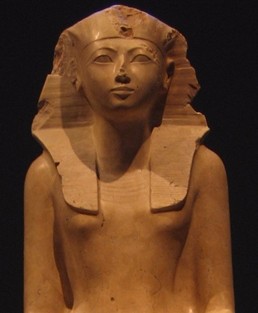
Statue of Hatshepsut
This statue of Hatshepsut is housed at the Metropolitan Museum of Art in New York City.
Trade Networks
Hatshepsut established trade networks that helped build the wealth of the Eighteenth Dynasty. This included a successful mission to the Land of Punt in the ninth year of her reign, which brought live myrrh trees and frankincense (which Hatshepsut used as kohl eyeliner) to Egypt. She also sent raiding expeditions to Byblos and Sinai, and may have led military campaigns against Nubia and Canaan.
Building Projects
Hatshepsut was a prolific builder, commissioning hundreds of construction projects and statuary. She had monuments constructed at the Temple of Karnak, and restored the original Precinct of Mut at Karnak, which had been ravaged during the Hyksos occupation of Egypt. She installed twin obelisks (the tallest in the world at that time) at the entrance to this temple, one of which still stands. Karnak’s Red Chapel was intended as a shrine to her life, and may have stood with these obelisks.
The Temple of Pakhet was a monument to Bast and Sekhmet, lioness war goddesses. Later in the Nineteenth Dynasty, King Seti I attempted to take credit for this monument. However, Hatshepsut’s masterpiece was a mortuary temple at Deir el-Bahri; the focal point was the Djeser-Djeseru (“the Sublime of Sublimes”), a colonnaded structure built 1,000 years before the Greek Parthenon. The Hatshepsut needle, a granite obelisk, is considered another great accomplishment.
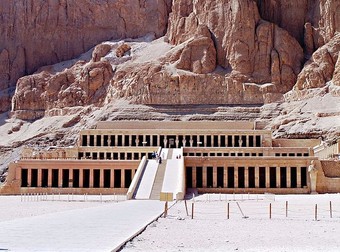
Hatshepsut Temple
The colonnaded design is evident in this temple.
Female Rule
Hatshepsut was not the first female ruler of Egypt. She had been preceded by Merneith of the First Dynasty, Nimaathap of the Third Dynasty, Nitocris of the Sixth Dynasty, Sobekneferu of the Twelfth Dynasty, Ahhotep I of the Seventeenth Dynasty, Ahmose-Nefertari, and others. However, Hatshepsut’s reign was longer and more prosperous; she oversaw a peaceful, wealthy era. She was also proficient at self-promotion, which was enabled by her wealth.
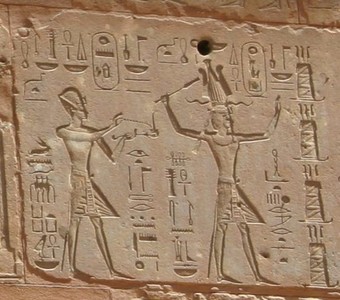
Hieroglyphs of Thutmose III and Hatshepsut
Hatshepsut, on the right, is shown having the trappings of a greater role.
The word “king” was considered gender-neutral, and women could take the title. During her father’s reign, she held the powerful office of God’s Wife, and as wife to her husband, Thutmose II, she took an active role in administration of the kingdom. As pharaoh, she faced few challenges, even from her co-regent, who headed up the powerful Egyptian army and could have unseated her, had he chosen to do so.
Women’s Status in Egypt
The average woman in Egypt was quite liberated for the time period. While her foremost role was as mother and wife, an average woman might have worked in weaving, perfume making, or entertainment. Women could own their own businesses, own and sell property, serve as witnesses in court cases, be in the company of men, divorce and remarry, and have access to one-third of their husband’s property.
Hatshepsut’s Death
Hatshepsut died in 1458 BCE in middle age; no cause of death is known, although she may have had diabetes and bone cancer, likely from a carcinogenic skin lotion. Her mummy was discovered in the Valley of the Kings by Howard Carer in 1903, although at the time, the mummy’s identity was not known. In 2007, the mummy was found to be a match to a missing tooth known to have belonged to Hatshepsut.
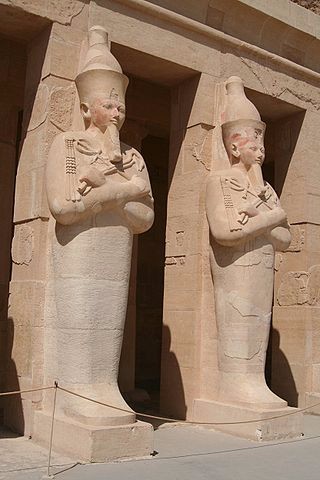
Osirian Statues of Hatshepsut
These statues of Hatshepsut at her tomb show her holding the crook and flail associated with Osiris.
After her death, mostly during Thutmose III’s reign, haphazard attempts were made to remove Hatshepsut from certain historical and pharaonic records. Amenhotep II, the son of Thutmose III, may have been responsible. The Tyldesley hypothesis states that Thutmose III may have decided to attempt to scale back Hatshepsut’s role to that of regent rather than king.
4.4.3: The Third Intermediate Period
The Third Intermediate Period (c. 1069-664 BCE) spanned the Twenty-first to Twenty-sixth Dynasties, and was marked by internal divisions within Egypt, as well as conquest and rule by foreigners.
Learning Objective
Describe the general landscape of the political chaos during Third Intermediate Period
Key Points
- The period of the Twenty-first Dynasty was characterized by the country’s fracturing kingship, as power became split more and more between the pharaoh and the High Priests of Amun at Thebes.
- Egypt was temporarily reunified during the Twenty-second Dynasty, and experienced a period of stability, but shattered into two states after the reign of Osorkon II.
- Civil war raged in Thebes and was eventually quelled by Osorkon B, who founded the Upper Egyptian Libyan Dynasty. This dynasty collapsed, however, with the rise of local city-states.
- The Twenty-fourth Dynasty saw the conquest of the Nubians over native Egyptian rulers, and the Nubians ruled through the Twenty-Fifth Dynasty, when they expanded Egyptian power to the extent of the New Kingdom and restored many temples. Due to lacking military power, however, the Egyptians were conquered by the Assyrians toward the end of the Twenty-fifth Dynasty.
- The end of the Third Intermediate Period and the Twenty-sixth Dynasty saw Assyrian rule over Egypt. Although some measure of independence was regained, Egypt faced pressure and eventual defeat at the hands of the Persians.
Key Terms
- Nubia
-
A region along the Nile river, located in northern Sudan and southern Egypt.
- Third Intermediate Period
-
Spanning the Twenty-first to Twenty-sixth Dynasties. A period of Egyptian decline and political instability.
- Assyrians
-
A major Mesopotamian East Semitic-speaking people.
- High Priests of Amun
-
The highest-ranking priest in the priesthood of the Ancient Egyptian god, Amun. Assumed significant power along with the pharaoh in the Twenty-First Dynasty.
The Third Intermediate Period of Ancient Egypt began with the death of the last pharaoh of the New Kingdom, Ramesses XI in 1070 BCE, and ended with the start of the Postdynastic Period. The Third Intermediate Period was one of decline and political instability. It was marked by a division of the state for much of the period, as well as conquest and rule by foreigners. However, many aspects of life for ordinary Egyptians changed relatively little.
The Twenty-First Dynasty (c. 1077-943 BCE)
The period of the Twenty-first Dynasty was characterized by the country’s fracturing kingship. Even in Ramesses XI’s day, the Twentieth Dynasty of Egypt was losing its grip on power in the city of Thebes, where priests were becoming increasingly powerful. The Amun priests of Thebes owned 2/3 of all the temple lands in Egypt, 90% of ships, and many other resources. Consequently, the Amun priests were as powerful as the Pharaoh, if not more so. After the death of Ramesses XI, his successor, Smendes I, ruled from the city of Tanis, but was mainly active only in Lower Egypt. Meanwhile, the High Priests of Amun at Thebes effectively ruled Middle and Upper Egypt in all but name. During this time, however, this division was relatively insignificant, due to the fact that both priests and pharaohs came from the same family.
The Twenty-Second (c. 943-716 BCE) and Twenty-Third (c. 880-720 BCE) Dynasties
The country was firmly reunited by the Twenty-second Dynasty, founded by Shoshenq I in approximately 943 BCE. Shoshenq I descended from Meshwesh immigrants originally from Ancient Libya. This unification brought stability to the country for well over a century, but after the reign of Osorkon II, the country had shattered in two states. Shoshenq III of the Twenty-Second Dynasty controlled Lower Egypt by 818 BCE, while Takelot II and his son Osorkon (the future Osorkon III) ruled Middle and Upper Egypt. In Thebes, a civil war engulfed the city between the forces of Pedubast I, a self-proclaimed pharaoh. Eventually Osorkon B defeated his enemies, and proceeded to found the Upper Egyptian Libyan Dynasty of Osorkon III, Takelot III, and Rudamun. This kingdom quickly fragmented after Rudamun’s death with the rise of local city-states.
The Twenty-Fourth Dynasty (c. 732-720 BCE)
The Nubian kingdom to the south took full advantage of the division of the country. Nubia had already extended its influence into the Egyptian city of Thebes around 752 BCE, when the Nubian ruler Kashta coerced Shepenupet into adopting his own daughter Amenirdis as her successor. Twenty years later, around 732 BCE, these machinations bore fruit for Nubia when Kashta’s successor Piye marched north in his Year 20 campaign into Egypt, and defeated the combined might of the native Egyptian rulers.
The Twenty-Fifth Dynasty (c. 760-656 BCE)
Following his military conquests, Piye established the Twenty-fifth Dynasty and appointed the defeated rulers as his provincial governors. Rulers under this dynasty originated in the Nubian Kingdom of Kush. Their reunification of Lower Egypt, Upper Egypt, and Kish created the largest Egyptian empire since the New Kingdom. They assimilated into Egyptian culture but also brought some aspects of Kushite culture. During this dynasty, the first widespread building of pyramids since the Middle Kingdom resumed. The Nubians were driven out of Egypt in 670 BCE by the Assyrians, who installed an initial puppet dynasty loyal to the Assyrians.
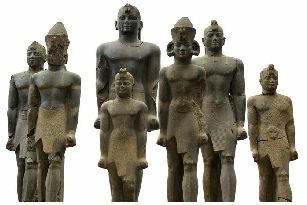
Nubian Pharaohs
Statues of the Nubian Pharaohs of the Twenty-fifth Dynasty.
End of the Third Intermediate Period
Upper Egypt remained under the rule of Tantamani for a time, while Lower Egypt was ruled by the Twenty-sixth Dynasty, starting in 664 BCE. Although originally established as clients of the Assyrians, the Twenty-sixth Dynasty managed to take advantage of the time of troubles facing the Assyrian empire to successfully bring about Egypt’s political independence. In 656 BCE, Psamtik I (last of the Twenty-sixth Dynasty kings) occupied Thebes and became pharaoh, the King of Upper and Lower Egypt. He proceeded to reign over a united Egypt for 54 years from his capital at Sais. Four successive Saite kings continued guiding Egypt through a period of peace and prosperity from 610-525 BCE. Unfortunately for this dynasty, however, a new power was growing in the Near East: Persia. Pharaoh Psamtik III succeeded his father, Ahmose II, only six months before he had to face the Persian Empire at Pelusium. The new king was no match for the Persians, who had already taken Babylon. Psamtik III was defeated and briefly escaped to Memphis. He was ultimately imprisoned, and later executed at Susa, the capital of the Persian king Cambyses. With the Saite kings exterminated, Camybes assumed the formal title of Pharaoh.
4.4.4: The Decline of Ancient Egypt
Ancient Egypt went through a series of occupations and suffered a slow decline over a long period of time. First occupied by the Assyrians, then the Persians, and later the Macedonians and Romans, Egyptians would never again reach the glorious heights of self-rule they achieved during previous periods.
Learning Objective
Explain why Ancient Egypt declined as an economic and political force
Key Points
- After a renaissance in the 25th Dynasty, ancient Egypt was occupied by Assyrians, initiating the Late Period.
- In 525 BCE, Egypt was conquered by Persia, and incorporated into the Achaemenid Persian Empire.
- In 332 BCE, Egypt was given to Macedonia and Alexander the Great. During this period, the new capital of Alexandria flourished.
- Egypt became a Roman province after the defeat of Marc Antony and Queen Cleopatra VII in 30 BCE. During this period, religious and other traditions slowly declined.
Key Terms
- Hellenistic
-
Relating to Greek history, language, and culture, during the time between the death of Alexander the Great and the defeat of Mark Antony and Cleopatra in 31 BCE.
- hieroglyphics
-
A formal writing system used by ancient Egyptians, consisting of pictograms.
- pagan
-
A person holding religious beliefs other than those of the main world religions, Christianity, Judaism, and Islam.
Ancient Egypt went through a series of occupations and suffered a slow decline over a long period of time. First occupied by the Assyrians, then the Persians, and later the Macedonians and Romans, Egyptians would never again reach the glorious heights of self-rule they achieved during previous periods.
Third Intermediate Period (1069-653 BCE)
After a renaissance in the Twenty-fifth dynasty, when religion, arts, and architecture (including pyramids) were restored, struggles against the Assyrians led to eventual conquest of Egypt by Esarhaddon in 671 BCE. Native Egyptian rulers were installed but could not retain control of the area, and former Pharaoh Taharqa seized control of southern Egypt for a time, until he was defeated again by the Assyrians. Taharqa’s successor, Tanutamun, also made a failed attempt to regain Egypt, but was defeated.
Late Period (672-332 BCE)
Having been victorious in Egypt, the Assyrians installed a series of vassals known as the Saite kings of the Twenty-sixth Dynasty. In 653 BCE, one of these kings, Psamtik I, was able to achieve a peaceful separation from the Assyrians with the help of Lydian and Greek mercenaries. In 609 BCE, the Egyptians attempted to save the Assyrians, who were losing their war with the Babylonians, Chaldeans, Medians, and Scythians. However, they were unsuccessful.
In 525 BCE, the Persians, led by Cambyses II, invaded Egypt, capturing the Pharaoh Psamtik III. Egypt was joined with Cyprus and Phoenicia in the sixth satrapy of the Achaemenid Persian Empire, also called the Twenty-seventh Dynasty. This ended in 402 BCE, and the last native royal house of dynastic Egypt, known as the Thirtieth Dynasty, was ruled by Nectanebo II. Persian rule was restored briefly in 343 BCE, known as the Thirty-first Dynasty, but in 332 BCE, Egypt was handed over peacefully to the Macedonian ruler, Alexander the Great.
Macedonian and Ptolemaic Period (332-30 BCE)
Alexander the Great was welcomed into Egypt as a deliverer, and the new capital city of Alexandria was a showcase of Hellenistic rule, capped by the famous Library of Alexandria. Native Egyptian traditions were honored, but eventually local revolts, plus interest in Egyptian goods by the Romans, caused the Romans to wrest Egypt from the Macedonians.
Roman Period (30 BCE-641CE)
Egypt became a Roman province after the defeat of Marc Antony and Queen Cleopatra VII in 30 BCE. Some Egyptian traditions, including mummification and worship of local gods, continued, but local administration was handled exclusively by Romans. The spread of Christianity proved to be too powerful, and pagan rites were banned and temples closed. Egyptians continued to speak their language, but the ability to read hieroglyphics disappeared as temple priests diminished.
4.5: Ancient Egyptian Society
4.5.1: Ancient Egyptian Religion
Ancient Egyptian religion lasted for more than 3,000 years, and consisted of a complex polytheism. The pharaoh’s role was to sustain the gods in order to maintain order in the universe.
Learning Objective
Describe the religious beliefs and practices of Ancient Egypt
Key Points
- The religion of Ancient Egypt lasted for more than 3,000 years, and was polytheistic, meaning there were a multitude of deities, who were believed to reside within and control the forces of nature.
- Formal religious practice centered on the pharaoh, or ruler, of Egypt, who was believed to be divine, and acted as intermediary between the people and the gods. His role was to sustain the gods so that they could maintain order in the universe.
- The Egyptian universe centered on Ma’at, which has several meanings in English, including truth, justice and order. It was fixed and eternal; without it the world would fall apart.
- The most important myth was of Osiris and Isis. The divine ruler Osiris was murdered by Set (god of chaos), then resurrected by his sister and wife Isis to conceive an heir, Horus. Osiris then became the ruler of the dead, while Horus eventually avenged his father and became king.
- Egyptians were very concerned about the fate of their souls after death. They believed ka (life-force) left the body upon death and needed to be fed. Ba, or personal spirituality, remained in the body. The goal was to unite ka and ba to create akh.
- Artistic depictions of gods were not literal representations, as their true nature was considered mysterious. However, symbolic imagery was used to indicate this nature.
- Temples were the state’s method of sustaining the gods, since their physical images were housed and cared for; temples were not a place for the average person to worship.
- Certain animals were worshipped and mummified as representatives of gods.
- Oracles were used by all classes.
Key Terms
- Ma’at,
-
The Egyptian universe.
- heka
-
The ability to use natural forces to create “magic.”
- pantheon
-
The core actors of a religion.
- polytheistic
-
A religion with more than one worshipped god.
- ka
-
The spiritual part of an individual human being or god that survived after death.
- Duat
-
The realm of the dead; residence of Osiris.
- ba
-
The spiritual characteristics of an individual person that remained in the body after death. Ba could unite with the ka.
- akh
-
The combination of the ka and ba living in the afterlife.
The religion of Ancient Egypt lasted for more than 3,000 years, and was polytheistic, meaning there were a multitude of deities, who were believed to reside within and control the forces of nature. Religious practices were deeply embedded in the lives of Egyptians, as they attempted to provide for their gods and win their favor. The complexity of the religion was evident as some deities existed in different manifestations and had multiple mythological roles. The pantheon included gods with major roles in the universe, minor deities (or “demons”), foreign gods, and sometimes humans, including deceased Pharaohs.
Formal religious practice centered on the pharaoh, or ruler, of Egypt, who was believed to be divine, and acted as intermediary between the people and the gods. His role was to sustain the gods so that they could maintain order in the universe, and the state spent its resources generously to build temples and provide for rituals. The pharaoh was associated with Horus (and later Amun) and seen as the son of Ra. Upon death, the pharaoh was fully deified, directly identified with Ra and associated with Osiris, the god of death and rebirth. However, individuals could appeal directly to the gods for personal purposes through prayer or requests for magic; as the pharaoh’s power declined, this personal form of practice became stronger. Popular religious practice also involved ceremonies around birth and naming. The people also invoked “magic” (called heka) to make things happen using natural forces.
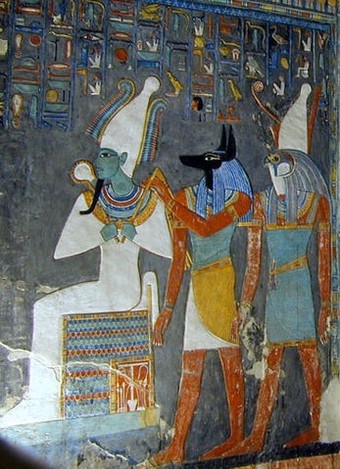
Gods of the Pantheon
This wall painting shows, from left to right, the gods Osiris, Anubis and Horus.
Cosmology
The Egyptian universe centered on Ma’at, which has several meanings in English, including truth, justice and order. It was fixed and eternal (without it the world would fall apart), and there were constant threats of disorder requiring society to work to maintain it. Inhabitants of the cosmos included the gods, the spirits of deceased humans, and living humans, the most important of which was the pharaoh. Humans should cooperate to achieve this, and gods should function in balance. Ma’at was renewed by periodic events, such as the annual Nile flood, which echoed the original creation. Most important of these was the daily journey of the sun god Ra.
Egyptians saw the earth as flat land (the god Geb), over which arched the sky (goddess Nut); they were separated by Shu, the god of air. Underneath the earth was a parallel underworld and undersky, and beyond the skies lay Nu, the chaos before creation. Duat was a mysterious area associated with death and rebirth, and each day Ra passed through Duat after traveling over the earth during the day.
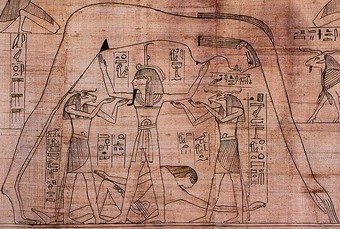
Egyptian Cosmology
In this artwork, the air god Shu is assisted by other gods in holding up Nut, the sky, as Geb, the earth, lies beneath.
Myths
Egyptian myths are mainly known from hymns, ritual and magical texts, funerary texts, and the writings of Greeks and Romans. The creation myth saw the world as emerging as a dry space in the primordial ocean of chaos, marked by the first rising of Ra. Other forms of the myth saw the primordial god Atum transforming into the elements of the world, and the creative speech of the intellectual god Ptah.
The most important myth was of Osiris and Isis. The divine ruler Osiris was murdered by Set (god of chaos), then resurrected by his sister and wife Isis to conceive an heir, Horus. Osiris then became the ruler of the dead, while Horus eventually avenged his father and became king. This myth set the Pharaohs, and their succession, as orderliness against chaos.
The Afterlife
Egyptians were very concerned about the fate of their souls after death, and built tombs, created grave goods and gave offerings to preserve the bodies and spirits of the dead. They believed humans possessed ka, or life-force, which left the body at death. To endure after death, the ka must continue to receive offerings of food; it could consume the spiritual essence of it. Humans also possessed a ba, a set of spiritual characteristics unique to each person, which remained in the body after death. Funeral rites were meant to release the ba so it could move, rejoin with the ka, and live on as an akh. However, the ba returned to the body at night, so the body must be preserved.
Mummification involved elaborate embalming practices, and wrapping in cloth, along with various rites, including the Opening of the Mouth ceremony. Tombs were originally mastabas (rectangular brick structures), and then pyramids.
However, this originally did not apply to the common person: they passed into a dark, bleak realm that was the opposite of life. Nobles did receive tombs and grave gifts from the pharaoh. Eventually, by about 2181 BCE, Egyptians began to believe every person had a ba and could access the afterlife. By the New Kingdom, the soul had to face dangers in the Duat before having a final judgment, called the Weighing of the Heart, where the gods compared the actions of the deceased while alive to Ma’at, to see if they were worthy. If so, the ka and ba were united into an akh, which then either traveled to the lush underworld, or traveled with Ra on his daily journey, or even returned to the world of the living to carry out magic.
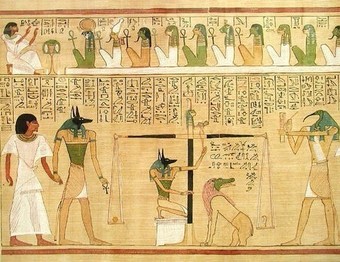
Funerary Text
In this section from the Book of the Dead for the scribe Hunefer, the Weighing of the Heart is shown.
Rise and Fall of Gods
Certain gods gained a primary status over time, and then fell as other gods overtook them. These included the sun god Ra, the creator god Amun, and the mother goddess Isis. There was even a period of time where Egypt was monotheistic, under Pharaoh Akhenaten, and his patron god Aten.
The Relationships of Deities
Just as the forces of nature had complex interrelationships, so did Egyptian deities. Minor deities might be linked, or deities might come together based on the meaning of numbers in Egyptian mythology (i.e., pairs represented duality). Deities might also be linked through syncretism, creating a composite deity.
Artistic Depictions of Gods
Artistic depictions of gods were not literal representations, since their true nature was considered mysterious. However, symbolic imagery was used to indicate this nature. An example was Anubis, a funerary god, who was shown as a jackal to counter its traditional meaning as a scavenger, and create protection for the mummy.
Temples
Temples were the state’s method of sustaining the gods, as their physical images were housed and cared for; they were not a place for the average person to worship. They were both mortuary temples to serve deceased pharaohs and temples for patron gods. Starting as simple structures, they grew more elaborate, and were increasingly built from stone, with a common plan. Ritual duties were normally carried out by priests, or government officials serving in the role. In the New Kingdom, professional priesthood became common, and their wealth rivaled that of the pharaoh.
Rituals and Festivals
Aside from numerous temple rituals, including the morning offering ceremony and re-enactments of myths, there were coronation ceremonies and the sed festival, a renewal of the pharaoh’s strength during his reign. The Opet Festival at Karnak involved a procession carrying the god’s image to visit other significant sites.
Animal Worship
At many sites, Egyptians worshipped specific animals that they believed to be manifestations of deities. Examples include the Apis bull (of the god Ptah), and mummified cats and other animals.
Use of Oracles
Commoners and pharaohs asked questions of oracles, and answers could even be used during the New Kingdom to settle legal disputes. This might involve asking a question while a divine image was being carried, and interpreting movement, or drawing lots.
4.5.2: Ancient Egyptian Art
Ancient Egyptian art included painting, sculpture, pottery, glass work, and architecture. Many surviving art is related to tombs and monuments. Aside from the brief Amarna period, Egyptian art remained relatively unchanged for thousands of years.
Learning Objective
Examine the development of Egyptian Art under the Old Kingdom
Key Points
- Ancient Egyptian art includes painting, sculpture, architecture, and other forms of art, such as drawings on papyrus, created between 3000 BCE and 100 CE.
- Most of this art was highly stylized and symbolic. Much of the surviving forms come from tombs and monuments, and thus have a focus on life after death and preservation of knowledge.
- Symbolism meant order, shown through the pharaoh’s regalia, or through the use of certain colors.
- In Egyptian art, the size of a figure indicates its relative importance.
- Paintings were often done on stone, and portrayed pleasant scenes of the afterlife in tombs.
- Ancient Egyptians created both monumental and smaller sculptures, using the technique of sunk relief.
- Ka statues, which were meant to provide a resting place for the ka part of the soul, were often made of wood and placed in tombs.
- Faience was sintered-quartz ceramic with surface vitrification, used to create relatively cheap small objects in many colors. Glass was originally a luxury item but became more common, and was used to make small jars, for perfume and other liquids, to be placed in tombs. Carvings of vases, amulets, and images of deities and animals were made of steatite. Pottery was sometimes covered with enamel, particularly in the color blue.
- Papyrus was used for writing and painting, and and was used to record every aspect of Egyptian life.
- Architects carefully planned buildings, aligning them with astronomically significant events, such as solstices and equinoxes. They used mainly sun-baked mud brick, limestone, sandstone, and granite.
- The Amarna period (1353-1336 BCE) represents an interruption in ancient Egyptian art style, subjects were represented more realistically, and scenes included portrayals of affection among the royal family.
Key Terms
- scarabs
-
Ancient Egyptian gem cut in the form of a scarab beetle.
- Faience
-
Glazed ceramic ware.
- ushabti
-
Ancient Egyptian funerary figure.
- Ka
-
The supposed spiritual part of an individual human being or god that survived after death, and could reside in a statue of the person.
- sunk relief
-
Sculptural technique in which the outlines of modeled forms are incised in a plane surface beyond which the forms do not project.
- regalia
-
The emblems or insignia of royalty.
- papyrus
-
A material prepared in ancient Egypt from the stem of a water plant, used in sheets for writing or painting on.
Ancient Egyptian art includes painting, sculpture, architecture, and other forms of art, such as drawings on papyrus, created between 3000 BCE and 100 AD. Most of this art was highly stylized and symbolic. Many of the surviving forms come from tombs and monuments, and thus have a focus on life after death and preservation of knowledge.
Symbolism
Symbolism in ancient Egyptian art conveyed a sense of order and the influence of natural elements. The regalia of the pharaoh symbolized his or her power to rule and maintain the order of the universe. Blue and gold indicated divinity because they were rare and were associated with precious materials, while black expressed the fertility of the Nile River.
Hierarchical Scale
In Egyptian art, the size of a figure indicates its relative importance. This meant gods or the pharaoh were usually bigger than other figures, followed by figures of high officials or the tomb owner; the smallest figures were servants, entertainers, animals, trees and architectural details.
Painting
Before painting a stone surface, it was whitewashed and sometimes covered with mud plaster. Pigments were made of mineral and able to stand up to strong sunlight with minimal fade. The binding medium is unknown; the paint was applied to dried plaster in the “fresco a secco” style. A varnish or resin was then applied as a protective coating, which, along with the dry climate of Egypt, protected the painting very well. The purpose of tomb paintings was to create a pleasant afterlife for the dead person, with themes such as journeying through the afterworld, or deities providing protection. The side view of the person or animal was generally shown, and paintings were often done in red, blue, green, gold, black and yellow.
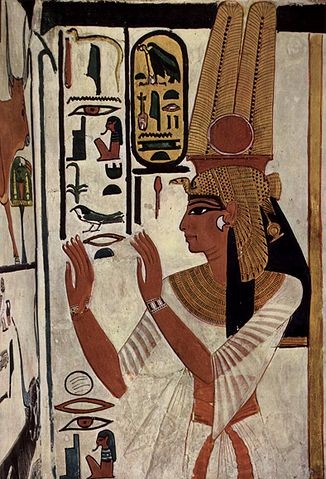
Wall Painting of Nefertari
In this wall painting of Nefertari, the side view is apparent.
Sculpture
Ancient Egyptians created both monumental and smaller sculptures, using the technique of sunk relief. In this technique, the image is made by cutting the relief sculpture into a flat surface, set within a sunken area shaped around the image. In strong sunlight, this technique is very visible, emphasizing the outlines and forms by shadow. Figures are shown with the torso facing front, the head in side view, and the legs parted, with males sometimes darker than females. Large statues of deities (other than the pharaoh) were not common, although deities were often shown in paintings and reliefs.
Colossal sculpture on the scale of the Great Sphinx of Giza was not repeated, but smaller sphinxes and animals were found in temple complexes. The most sacred cult image of a temple’s god was supposedly held in the naos in small boats, carved out of precious metal, but none have survived.
Ka statues, which were meant to provide a resting place for the ka part of the soul, were present in tombs as of Dynasty IV (2680-2565 BCE). These were often made of wood, and were called reserve heads, which were plain, hairless and naturalistic. Early tombs had small models of slaves, animals, buildings, and objects to provide life for the deceased in the afterworld. Later, ushabti figures were present as funerary figures to act as servants for the deceased, should he or she be called upon to do manual labor in the afterlife.
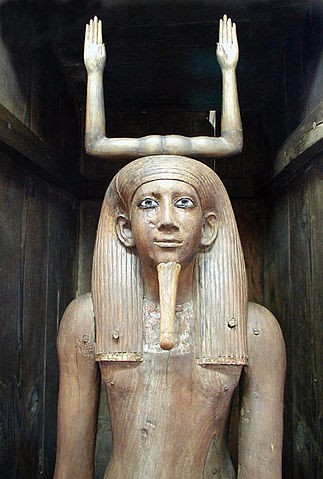
Ka Statue
The ka statue was placed in the tomb to provide a physical place for the ka to manifest. This statue is found at the Egyptian Museum of Cairo.
Many small carved objects have been discovered, from toys to utensils, and alabaster was used for the more expensive objects. In creating any statuary, strict conventions, accompanied by a rating system, were followed. This resulted in a rather timeless quality, as few changes were instituted over thousands of years.
Faience, Pottery, and Glass
Faience was sintered-quartz ceramic with surface vitrification used to create relatively cheap, small objects in many colors, but most commonly blue-green. It was often used for jewelry, scarabs, and figurines. Glass was originally a luxury item, but became more common, and was to used to make small jars, of perfume and other liquids, to be placed in tombs. Carvings of vases, amulets, and images of deities and animals were made of steatite. Pottery was sometimes covered with enamel, particularly in the color blue. In tombs, pottery was used to represent organs of the body removed during embalming, or to create cones, about ten inches tall, engraved with legends of the deceased.
Papyrus
Papyrus is very delicate and was used for writing and painting; it has only survived for long periods when buried in tombs. Every aspect of Egyptian life is found recorded on papyrus, from literary to administrative documents.
Architecture
Architects carefully planned buildings, aligning them with astronomically significant events, such as solstices and equinoxes, and used mainly sun-baked mud brick, limestone, sandstone, and granite. Stone was reserved for tombs and temples, while other buildings, such as palaces and fortresses, were made of bricks. Houses were made of mud from the Nile River that hardened in the sun. Many of these houses were destroyed in flooding or dismantled; examples of preserved structures include the village Deir al-Madinah and the fortress at Buhen.
The Giza Necropolis, built in the Fourth Dynasty, includes the Pyramid of Khufu (also known as the Great Pyramid or the Pyramid of Cheops), the Pyramid of Khafre, and the Pyramid of Menkaure, along with smaller “queen” pyramids and the Great Sphinx.
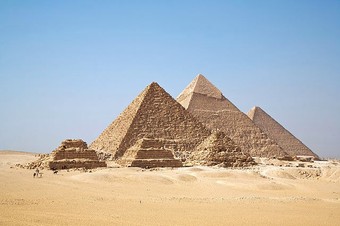
The Pyramids of Giza
The Pyramid of Khufu (Great Pyramid) is the largest of the pyramids pictured here.
The Temple of Karnak was first built in the 16th century BCE. About 30 pharaohs contributed to the buildings, creating an extremely large and diverse complex. It includes the Precincts of Amon-Re, Montu and Mut, and the Temple of Amehotep IV (dismantled).
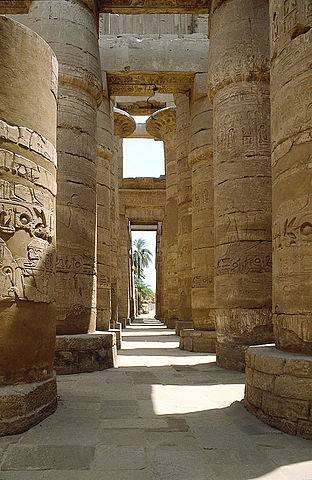
The Temple of Karnak
Shown here is the hypostyle hall of the Temple of Karnak.
The Luxor Temple was constructed in the 14th century BCE by Amenhotep III in the ancient city of Thebes, now Luxor, with a major expansion by Ramesses II in the 13th century BCE. It includes the 79-foot high First Pylon, friezes, statues, and columns.
The Amarna Period (1353-1336 BCE)
During this period, which represents an interruption in ancient Egyptian art style, subjects were represented more realistically, and scenes included portrayals of affection among the royal family. There was a sense of movement in the images, with overlapping figures and large crowds. The style reflects Akhenaten’s move to monotheism, but it disappeared after his death.
4.5.3: Ancient Egyptian Monuments
Ancient Egyptian monuments included pyramids, sphinxes, and temples. These buildings and statues required careful planning and resources, and showed the influence Egyptian religion had on the state and its people.
Learning Objective
Describe the impressive attributes of the monuments erected by Egyptians in the Old Kingdom
Key Points
- Ancient Egyptian architects carefully planned buildings, aligning them with astronomically significant events, such as solstices and equinoxes, and used mainly sun-baked mud brick, limestone, sandstone, and granite.
- Egyptian pyramids were highly reflective, referenced the sun, and were usually placed on the West side of the Nile River.
- About 135 pyramids have been discovered in Egypt, with the largest (in Egypt and the world) being the Great Pyramid of Giza.
- The Great Sphinx of Giza is a reclining sphinx (a mythical creature with a lion’s body and a human head); its face is meant to represent the Pharaoh Khafra. It is the world’s oldest and largest monolith.
- Egyptian temples were used for official, formal worship of the gods by the state, and to commemorate pharaohs. The temple was the house of a particular god, and Egyptians would perform rituals, give offerings, re-enact myths, and keep order in the universe (ma’at).
- The Temple of Karnak was first built in the 16th century BCE. About 30 pharaohs contributed to the buildings, creating an extremely large and diverse complex.
- The Luxor Temple was constructed in the 14th century BCE by Amenhotep III in the ancient city of Thebes, now Luxor. It later received a major expansion by Ramesses II in the 13th century BCE.
Key Terms
- monolith
-
A large single upright block of stone, especially one shaped into, or serving as, a pillar or monument.
- friezes
-
Broad, horizontal bands of sculpted or painted decoration.
- pylon
-
In ancient Egypt, two tapering towers with a less elevated section between them, forming a gateway.
- peristyle courts
-
In ancient Egypt, courts that open to the sky.
- Hypostyle halls
-
In ancient Egypt, covered rooms with columns.
- equinoxes
-
Either of the two times in the year when the sun crosses the celestial equator, and day and night are of equal length.
- solstices
-
Either of the two times in the year (summer and winter) when the sun reaches its highest or lowest point in the sky at noon.
- ma’at
-
The ancient Egyptian concept of truth, balance, order, harmony, law, morality and justice.
- obelisks
-
Stone pillars, typically having a square or rectangular cross section and pyramidal top, used as monuments or landmarks.
Ancient Egyptian architects carefully planned buildings, aligning them with astronomically significant events, such as solstices and equinoxes. They used mainly sun-baked mud brick, limestone, sandstone, and granite. Stone was reserved for tombs and temples, while other buildings, such as palaces and fortresses, were made of bricks.
Pyramids
Egyptian pyramids referenced the rays of the sun, and appeared highly polished and reflective, with a capstone that was generally a hard stone like granite, sometimes plated with gold, silver or electrum. Most were placed west of the Nile, to allow the pharaoh’s soul to join with the sun during its descent.
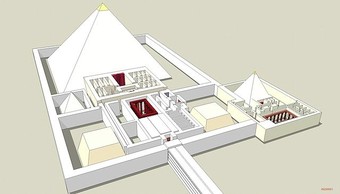
Old Kingdom Pyramid Temple Reconstruction
In this reconstruction, a causeway leads out to the valley temple.
About 135 pyramids have been discovered in Egypt, with the largest (in Egypt and the world) being the Great Pyramid of Giza. Its base is over 566,000 square feet in area, and was one of the Seven Wonders of the Ancient World. The Giza Necropolis, built in the Fourth Dynasty, includes the Pyramid of Khufu (also known as the Great Pyramid or the Pyramid of Cheops), the Pyramid of Khafre and the Pyramid of Menkaure, along with smaller “queens” pyramids and the Great Sphinx.
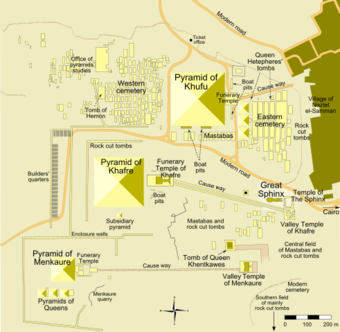
Map of Giza Pyramid Complex
A map showing the layout of the Giza Pyramid area, including the Pyramids of Khufu, Khafre, Menkaure, and the Great Sphinx.
The Great Sphinx of Giza
This limestone statue of a reclining sphinx (a mythical creature with a lion’s body and a human head) is located on the Giza Plateau to the west of the Nile. It is believed the face is meant to represent the Pharaoh Khafra. It is the largest and oldest monolith statue in the world, at 241 feet long, 63 feet wide, and 66.34 feet tall. It is believed to have been built during the reign of Pharaoh Khafra (2558-2532 BCE). It was probably a focus of solar worship, as the lion is a symbol associated with the sun.
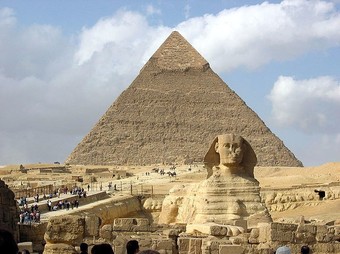
The Great Sphinx of Giza
Here the Great Sphinx is shown against the Pyramid of Kahfre.
Temples
Egyptian temples were used for official, formal worship of the gods by the state, and to commemorate pharaohs. The temple was the house dedicated to a particular god, and Egyptians would perform rituals there, give offerings, re-enact myths and keep order in the universe (ma’at). Pharaohs were in charge of caring for the gods, and they dedicated massive resources to this task. Priests assisted in this effort. The average citizen was not allowed into the inner sanctum of the temple, but might still go there to pray, give offerings, or ask questions of the gods.
The inner sanctuary had a cult image of the temple’s god, as well as a series of surrounding rooms that became large and elaborate over time, evolving into massive stone edifices during the New Kingdom. Temples also often owned surrounding land and employed thousands of people to support its activities, creating a powerful institution. The designs emphasized order, symmetry and monumentality. Hypostyle halls (covered rooms filled with columns) led to peristyle courts (open courts), where the public could meet with priests. At the front of each court was a pylon (broad, flat towers) that held flagpoles. Outside the temple building was the temple enclosure, with a brick wall to symbolically protect from outside disorder; often a sacred lake would be found here. Decoration included reliefs (bas relief and sunken relief) of images and hieroglyphic text and sculpture, including obelisks, figures of gods (sometimes in sphinx form), and votive figures. Egyptian religions faced persecution by Christians, and the last temple was closed in 550 AD.
The Temple of Karnak was first built in the 16th century BCE. About 30 pharaohs contributed to the buildings, creating an extremely large and diverse complex. It includes the Precincts of Amon-Re, Montu and Mut, and the Temple of Amehotep IV (dismantled).
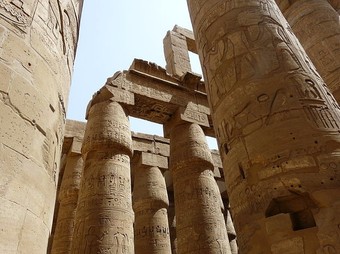
Temple of Karnak
This view of the Temple of Karnak shows they hypostyle hall, with massive columns.
The Luxor Temple was constructed in the 14th century BCE by Amenhotep III in the ancient city of Thebes, now Luxor, with a major expansion by Ramesses II in the 13th century BCE. It includes the 79-foot high First Pylon, friezes, statues, and columns.
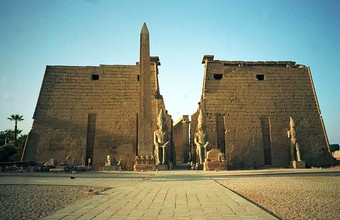
Luxor Temple
Shown here is the entrance pylon of Luxor Temple, one of the major New Kingdom temples.
4.5.4: Ancient Egyptian Trade
Ancient Egyptians traded with their African and Mediterranean neighbors to obtain goods, such as cedar, lapis lazuli, gold, ivory, and more. They exported goods, such as papyrus, linen, and finished objects using a variety of land and maritime trading routes.
Learning Objective
Describe the economic structure of ancient Egypt
Key Points
- Trade was occurring in the 5th century BCE onwards, especially with Canaan, Lebanon, Nubia and Punt.
- Just before the First Dynasty, Egypt had a colony in southern Canaan that produced Egyptian pottery for export to Egypt.
- In the Second Dynasty, Byblos provided quality timber that could not be found in Egypt.
- By the Fifth Dynasty, trade with Punt gave Egyptians gold, aromatic resins, ebony, ivory, and wild animals.
- A well-traveled land route from the Nile to the Red Sea crossed through the Wadi Hammamat. Another route, the Darb el-Arbain, was used from the time of the Old Kingdom of Egypt.
- Egyptians built ships as early as 3000 BCE by lashing planks of wood together and stuffing the gaps with reeds. They used them to import goods from Lebanon and Punt.
Key Terms
- papyrus
-
A material prepared in ancient Egypt from the stem of a water plant, used in sheets for writing, painting, or making rope, sandals, and boats.
- obsidian
-
A hard, dark, glasslike volcanic rock.
- electrum
-
A natural or artifical alloy of gold, with at least 20% silver, used for jewelry.
- myrrh
-
A fragrant gum resin obtained from certain trees, often used in perfumery, medicine and incense.
- malachite
-
A bright green mineral consisting of copper hydroxyl carbonate.
Early examples of ancient Egyptian trade included contact with Syria in the 5th century BCE, and importation of pottery and construction ideas from Canaan in the 4th century BCE. By this time, shipping was common, and the donkey, camel, and horse were domesticated and used for transportation. Lebanese cedar has been found in the tombs of Nekhen, dated to the Naqada I and II periods. Egyptians during this period also imported obsidian from Ethiopia, gold and incense from Nubia in the south, oil jugs from Palestine, and other goods from the oases of the western desert and the cultures of the eastern Mediterranean. Egyptian artifacts from this era have been found in Canaan and parts of the former Mesopotamia. In the latter half of the 4th century BCE, the gemstone lapis lazuli was being imported from Badakhshan (modern-day Afghanistan).
Just before the First Dynasty, Egypt had a colony in southern Canaan that produced Egyptian pottery for export to Egypt. In the Second Dynasty, Byblos provided quality timber that could not be found in Egypt. By the Fifth Dynasty, trade with Punt gave Egyptians gold, aromatic resins, ebony, ivory, and wild animals. Egypt also traded with Anatolia for tin and copper in order to make bronze. Mediterranean trading partners provided olive oil and other fine goods.
Egypt commonly exported grain, gold, linen, papyrus, and finished goods, such as glass and stone objects.
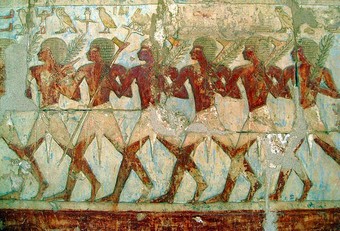
Depiction of Queen Hatshepsut’s Expedition to Punt
This painting shows Queen Hatshepsut’s expedition to Punt.
Land Trade Routes
A well-traveled land route from the Nile to the Red Sea crossed through the Wadi Hammamat, and was known from predynastic times. This route allowed travelers to move from Thebes to the Red Sea port of Elim, and led to the rise of ancient cities.
Another route, the Darb el-Arbain, was used from the time of the Old Kingdom of Egypt to trade gold, ivory, spices, wheat, animals, and plants. This route passed through Kharga in the south and Asyut in the north, and was a major route between Nubia and Egypt.
Maritime Trade Routes
Egyptians built ships as early as 3000 BCE by lashing planks of wood together and stuffing the gaps with reeds.
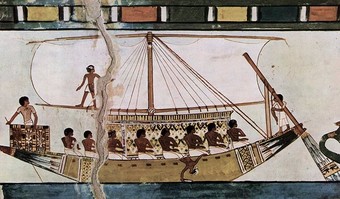
Egyptian Sailing Ship
This painting depicts an Egyptian ship from c. 1420 BCE.
Pharaoh Sahure, of the Fifth Dynasty, is known to have sent ships to Lebanon to import cedar, and to the Land of Punt for myrrh, malachite, and electrum. Queen Hatshepsut sent ships for myrrh in Punt, and extended Egyptian trade into modern-day Somalia and the Mediterranean.
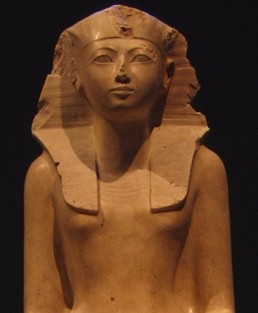
Queen Hatshepsut
Queen Hatshepsut expanded trade into modern-day Somalia and the Mediterranean.
An ancient form of the Suez Canal is believed to have been started by Pharaoh Senusret II or III of the Twelfth Dynasty, in order to connect the Nile River with the Red Sea.
4.5.5: Ancient Egyptian Culture
The Middle Kingdom was a golden age for ancient Egypt, when arts, religion, and literature flourished. Two major innovations of the time were block statues and new forms of literature.
Learning Objective
Examine the artistic and social developments of the Middle Kingdom
Key Points
- The Middle Kingdom (2134-1690 BCE) was a time of prosperity and stability, as well as a resurgence of art, literature, and architecture.Block statue was a new type of sculpture invented in the Middle Kingdom, and was often used as a funerary monument.
- Literature had new uses during the Middle Kingdom, and many classics were written during the period.
Key Term
- funerary monuments
-
Sculpture meant to decorate a tomb within a pyramid.
The Middle Kingdom (2134-1690 BCE) was a time of prosperity and stability, as well as a resurgence of art, literature, and architecture. Two major innovations of the time were the block statue and new forms of literature.
The Block Statue
The block statue came into use during this period. This type of sculpture depicts a squatting man with knees drawn close to the chest and arms folded on top of the knees. The body may be adorned with a cloak, which makes the body appear to be a block shape. The feet may be covered by the cloak, or left uncovered. The head was often carved in great detail, and reflected Egyptian beauty ideals, including large ears and small breasts. The block statue became more popular over the years, with its high point in the Late Period, and was often used as funerary monuments of important, non-royal individuals. They may have been intended as guardians, and were often fully inscribed.
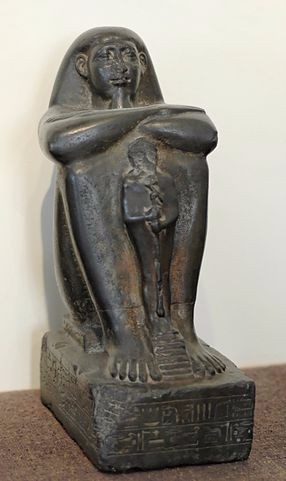
Example of Block Statue
An example of a block statue from the Late Period, c. 650-633 BCE.
Literature
In the Middle Kingdom period, due to growth of middle class and scribes, literature began to be written to entertain and provide intellectual stimulation. Previously, literature served the purposes of maintaining divine cults, preserving souls in the afterlife, and documenting practical activities. However, some Middle Kingdom literature may have been transcriptions of the oral literature and poetry of the Old Kingdom. Future generations of Egyptians often considered Middle Kingdom literature to be “classic,” with the ultimate example being the Story of Sinuhe.
4.6: Nubia and Ancient Egypt
4.6.1: Nubia and Ancient Culture
Nubia was a region along the Nile River. Its history can be traced from c. 2000 BCE to modern day. It was culturally close to ancient Egypt, and the two regions had periods of both peace and war.
Learning Objective
Describe the Nubian kingdoms, emphasizing their relationship with Egypt
Key Points
- Nubia consisted of two major regions along the Nile River, from Aswan to Khartoum.
- Nubian history can be traced from c. 2000 BCE onward to 1504 AD, when Nubia was divided between Egypt and the Sennar sultanate and became Arabized.
- Nubia and Ancient Egypt had periods of both peace and war.
- Around 3500 BCE, the “A-Group” of Nubians arose, existing side-by-side with the Naqada of Upper Egypt.
- Nubia was first mentioned by ancient Egyptian trading accounts in 2300 BCE.
- During the Egyptian Middle Kingdom (c. 2040-1640 BCE), Egypt began expanding into Nubian territory in order to control trade routes, and to build a series of forts along the Nile.
- The “Medjay” were people from the Nubia region who worked in the Egyptian military.
- Some Egyptian pharaohs were of Nubian origin, especially during the Kushite Period, although they closely followed the usual Egyptian methods of governing.
Key Term
- pharaohs
-
A ruler in ancient Egypt.
Nubia consisted of two major regions along the Nile River, from Aswan to Khartoum. Upper Nubia sat between the Second and Sixth Cataracts of the Nile (modern-day central Sudan), and Lower Nubia sat between the First and Second Cataracts (modern-day southern Egypt and northern Sudan).
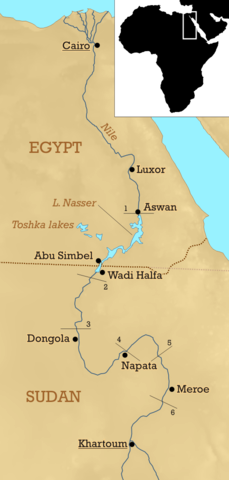
The Nubian Region
This map shows the modern-day location of Nubia.
Nubian history can be traced from c. 2000 BCE onward to 1504 AD, when Nubia was divided between Egypt and the Sennar sultanate and became Arabized. It was later united within the Ottoman Egypt in the 19th century, and the Kingdom of Egypt from 1899 to 1956.
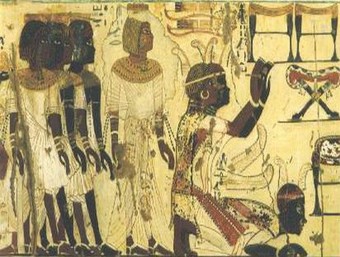
Depiction of Nubians Worshipping
This painting shows Nubians at worship.
Nubia and Egypt
Nubia and Ancient Egypt had periods of both peace and war. It is believed, based on rock art, that Nubian rulers and early Egyptian pharaohs used similar royal symbols. There was often peaceful cultural exchange and cooperation, and marriages between the two did occur. Egyptians did, however, conquer Nubian territory at various times. Nubians conquered Egypt in the 25th Dynasty.
Egyptians called the Nubian region “Ta-Seti,” which means “The Land of the Bow,” a reference to Nubian archery skills. Around 3500 BCE, the “A-Group” of Nubians arose, existing side-by-side with the Naqada of Upper Egypt. These two groups traded gold, copper tools, faience, stone vessels, pots, and more. Egyptian unification in 3300 BCE may have been helped along by Nubian culture, which was conquered by Upper Egypt.
Nubia was first mentioned by ancient Egyptian trading accounts in 2300 BCE. Nubia was a gateway to the riches of Africa, and goods like gold, incense, ebony, copper, ivory, and animals flowed through it. By the Sixth Dynasty, Nubia was fractured into a group of small kingdoms; the population (called “C-Group”) may have been made up of Saharan nomads.
During the Egyptian Middle Kingdom (c. 2040-1640 BCE), Egypt began expanding into Nubian territory in order to control trade routes, and to build a series of forts along the Nile.
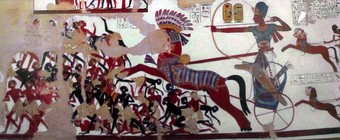
Depiction of Battle with the Nubians
This painting shows Ramses II battling Nubians from his war chariot.
The Egyptians called a certain region of northern modern-day Sudan, where ancient Nubians lived, “Medjay.” This name gradually began to reference people, not the region. Those who lived in this region worked in the Egyptian military as scouts, later as garrison troops, and finally as elite paramilitary police.
Some Egyptian pharaohs were of Nubian origin, especially during the Kushite Period, although they closely followed the usual Egyptian methods of governing. In fact, they were seen, and saw themselves, as culturally Egyptian. The two cultures were so close that some scholars see them as indistinguishable. Nubians appear to have been assimilated into Egyptian culture.
Chapter 3: Early Civilizations
3.1: Ancient Societies on the Mediterranean
3.1.1: The Hittites
The Hittites were an ancient Anatolian people of the Bronze Age, who manufactured advanced iron goods, ruled through government officials with independent authority over various branches of government, and worshipped storm gods.
Learning Objective
Describe the key characteristics of the Hittite Empire
Key Points
- The Hittite Empire was established at Hattusa in north-central Anatolia around 1600 BCE, and reached its height during the mid-14th century BCE under Suppiluliuma I.
- After c. 1180 BCE, the empire came to an end during the Bronze Age collapse and splintered into several independent “Neo-Hittite” city-states, some of which survived until the 8th century BCE.
- The Hittite language was a member of the Anatolian branch of the Indo-European language family.
- The Hittite military made successful use of chariots and advanced iron working technologies.
- After 1180 BCE, amid general turmoil in the Levant associated with the sudden arrival of the Sea Peoples, the kingdom disintegrated into several independent “Neo-Hittite” city-states.
- The head of the Hittite state was the king, but other officials exercised independent authority over various branches of the government.
- Storm gods featured prominently in the Hittite religion, which was heavily influenced by Hattic, Mesopotamian, and Hurrian religions.
Key Terms
- Indo-European language
-
A member of a family of several hundred related languages and dialects that includes most major current languages of Europe, the Iranian plateau, the Indian subcontinent, and ancient Anatolia.
- Hittite Empire
-
An ancient Anatolian people who established an empire at Hattusa in north-central Anatolia around 1600 BCE. It reached its height during the mid-14th century BCE.
- Tarhunt
-
The Hurrian god of sky and storm who oversaw Hittite conflicts with foreign powers.
- cuneiform
-
Wedge-shaped characters used in ancient Mesopotamian writings, typically on clay tablets.
The Hittites were an ancient Anatolian people who established an empire at Hattusa in north-central Anatolia around 1600 BCE. The Hittite Empire reached its height during the mid-14th century BCE under Suppiluliuma I, when it encompassed an area that included most of Asia Minor as well as parts of the northern Levant and Upper Mesopotamia. After c. 1180 BCE, the empire came to an end during the Bronze Age collapse, and splintered into several independent “Neo-Hittite” city-states, some of which survived until the 8th century BCE.
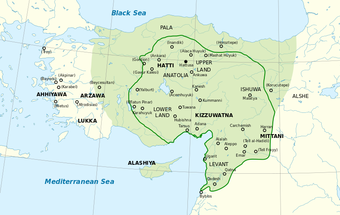
The Hittite Empire at its greatest extent under Suppiluliuma I (c. 1350–1322 BCE) and Mursili II (c. 1321–1295 BCE)
The approximate extent of the maximum area of the Hittite rule (light green) and the Hittite rule c. 1350-1300 BCE (green line).
The Hittite language was a member of the Anatolian branch of the Indo-European language family. They referred to their native land as Hatti. The conventional name “Hittites” is due to their initial identification with the Biblical Hittites, according to 19th century archaeology. The Hebrew Bible refers to “Hittites” in several passages, and links them to an eponymous ancestor Heth, a descendant of Ham through his son Canaan. The Hittites are thereby counted among the Canaanites. The Hittites are usually depicted as a people living among the Israelites—Abraham purchases the Patriarchal burial-plot from “Ephron HaChiti” (Ephron the Hittite), and Hittites serve as high military officers in David’s army. In 2 Kings 7:6, they are depicted as a people with their own kingdoms.
Despite the use of Hatti as the core of their territory, the Hittites should be distinguished from the Hattians, an earlier people who inhabited the same region (until the beginning of the 2nd millennium BCE), and spoke a different language, possibly in the Northwest Caucasian language group known as Hattic.
The Hittite military made successful use of chariots. Although their civilization thrived during the Bronze Age, the Hittites were the forerunners of the Iron Age and were manufacturing iron artifacts from as early as the 14th century BCE. Correspondence with rulers from other empires reveal a foreign demand for iron goods.
After 1180 BCE, amid general turmoil in the Levant associated with the sudden arrival of the Sea Peoples, the kingdom disintegrated into several independent “Neo-Hittite” city-states. The history of the Hittite civilization is known mostly from cuneiform texts found in the area of their kingdom, and from diplomatic and commercial correspondence found in various archives in Egypt and the Middle East.
Culture
Government
The head of the Hittite state was the king, followed by the heir-apparent. However, some officials exercised independent authority over various branches of the government. One of the most important of these posts was that of the Gal Mesedi (Chief of the Royal Bodyguards). It was superseded by the rank of the Gal Gestin (Chief of the Wine Stewards), who, like the Gal Mesedi, was generally a member of the royal family. The kingdom’s bureaucracy was headed by the Gal Dubsar (Chief of the Scribes).
Religion
Hittite religion and mythology were heavily influenced by their Hattic, Mesopotamian, and Hurrian counterparts. In earlier times, Indo-European elements may still be clearly discerned.
“Storm gods” were prominent in the Hittite pantheon. Tarhunt was referred to as “The Conqueror,” “The King of Kummiya,” “King of Heaven,” and “Lord of the land of Hatti.” As the god of battle and victory, especially against foreign powers, he was chief among the gods and was depicted as a bearded man astride two mountains and bearing a club.
3.1.2: The Phoenicians
Known for their alphabet, the Phoenicians were an ancient Semitic maritime trading culture in the Mediterranean. They fell under both Persian and Hellenistic rule.
Learning Objective
Describe key aspects of Phoenician culture
Key Points
- Phoenicia was an ancient Semitic maritime trading culture situated on the western, coastal part of the Fertile Crescent and centered on the coastline of modern Lebanon and Tartus Governorate in Syria from 1550 to 300 BCE.
- The Phoenicians used the galley, a man-powered sailing vessel, and are credited with the invention of the bireme.
- Each Phoenician city-state was a politically independent unit. City-states often came into conflict with others of its kind, or formed leagues and alliances.
- A league of independent city-state ports, with others on the islands and along other coasts of the Mediterranean Sea, was ideally suited for trade between the Levant area (which was rich in natural resources) and the rest of the ancient world.
- Cyrus the Great of Persia conquered Phoenicia in 539 BCE, and divided Phoenicia into four vassal kingdoms: Sidon, Tyre, Arwad, and Byblos.
- Alexander the Great conquered Phoenicia beginning with Tyre in 332 BCE. The rise of Hellenistic Greece gradually ousted the remnants of Phoenicia’s former dominance over the Eastern Mediterranean trade routes.
Key Terms
- city-state
-
An independent or autonomous entity, not administered as a part of another local government, whose territory consists of a city and possibly its surrounding territory.
- bireme
-
An ancient oared warship (galley) with two decks of oars, probably invented by the Phoenicians.
- Phoenicia
-
An ancient Semitic maritime trading culture situated on the western, coastal part of the Fertile Crescent.
- Cyrus the Great
-
Also known as Cyrus II of Persia, Cyrus the Elder. Founder of the Achaemenid Empire.
- Alexander the Great
-
Also known as Alexander III of Macedon. His military was extremely successful, and he created one of the largest empires in history.
Phoenicia was an ancient Semitic civilization situated on the western, coastal part of the Fertile Crescent near modern-day Lebanon, Israel, Jordan, Palestine, and Syria. All major Phoenician cities were on the coastline of the Mediterranean. It was an enterprising maritime trading culture that spread across the Mediterranean from 1550 BCE to 300 BCE. The Phoenicians used the galley, a man-powered sailing vessel, and are credited with the invention of the bireme oared ship. They were famed in Classical Greece and Rome as “traders in purple,” which refers to their monopoly on the precious purple dye of the Murex snail, used for royal clothing, among other things.
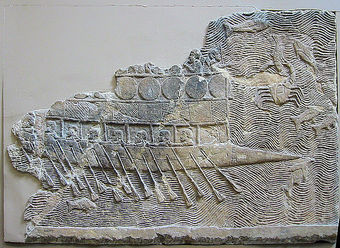
Assyrian Warship
Assyrian warship (probably built by Phoenicians) with two rows of oars, relief from Nineveh, c. 700 BCE.
Phoenician became one of the most widely used writing systems. It was spread by Phoenician merchants across the Mediterranean world, where it evolved and was assimilated by many other cultures. The Aramaic alphabet, a modified form of Phoenician, was the ancestor of modern Arabic script, while Hebrew script is a stylistic variant of the Aramaic script. The Greek alphabet (and by extension its descendants, such as the Latin, the Cyrillic, and the Coptic) was a direct successor of Phoenician, though certain letter values were changed to represent vowels.
Phoenicians are widely thought to have originated from the earlier Canaanite inhabitants of the region. Although Egyptian seafaring expeditions had already been made to Byblos to bring back “cedars of Lebanon” as early as the 3rd millennium BCE, continuous contact only occurred in the Egyptian New Empire period.
It is important to note that Phoenicia is a Classical Greek term used to refer to the region of the major Canaanite port towns, and does not correspond exactly to a cultural identity that would have been recognized by the Phoenicians themselves. It is uncertain to what extent the Phoenicians viewed themselves as a single ethnicity and nationality. Their civilization was organized in city-states, similar to that of ancient Greece. However, in terms of archaeology, language, life style and religion, there is little to set the Phoenicians apart as markedly different from other Semitic cultures of Canaan. As Canaanites, they were unique in their remarkable seafaring achievements.
Each Phoenician city-state was a politically independent unit. City-states often came into conflict with one another, with the result that one may dominate another. City-states were also inclined to collaborate in leagues and alliances. Though ancient boundaries of city-centered cultures fluctuated, the city of Tyre held the southernmost border of Phoenician territory.
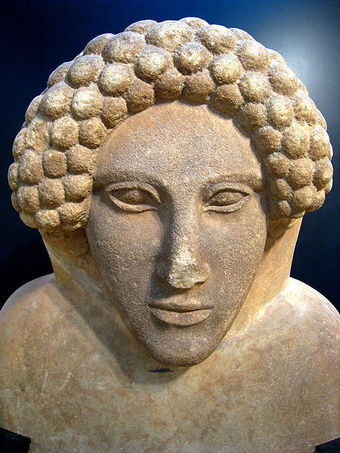
Phoenician Sarcophagus
A Phoenician sarcophagus at the burial grounds of Antarados, northern Lebanon, 480-450 BCE. Made from Greek marble.
Rise and Decline
The high point of Phoenician culture and sea power is usually placed c. 1200-800 BCE, though many of the most important Phoenician settlements had been established long before this period. Archeology has identified cultural elements of the Phoenician zenith as early as the 3rd millennium BCE. The league of independent city-state ports, with others on the islands and along other coasts of the Mediterranean Sea, was ideally suited for trade between the Levant area (which was rich in natural resources) and the rest of the ancient world. During the early Iron Age, around 1200 BCE, Sea Peoples appeared in the area from the north, which weakened and destroyed the Egyptians and Hittites, respectively. In the resulting power vacuum, a number of Phoenician cities rose as significant maritime powers.
These societies rested on three power-bases: the king; the temple and its priests; and the councils of elders. Byblos first became the predominant center from where the Phoenicians dominated the Mediterranean and Erythraean (Red) Sea routes. It was here that the first inscription in the Phoenician alphabet was found, on the sarcophagus of Ahiram (c. 1200 BCE). Tyre rose to power several hundred years later. One of its kings, the priest Ithobaal (887–856 BCE), ruled Phoenicia as far north as Beirut and Cyprus. Carthage was founded in 814 BCE, under Pygmalion of Tyre (820–774 BCE). The collection of city-states constituting Phoenicia came to be characterized by outsiders and the Phoenicians as Sidonia or Tyria. Phoenicians and Canaanites alike were called Sidonians or Tyrians, as one Phoenician city came to prominence after another.
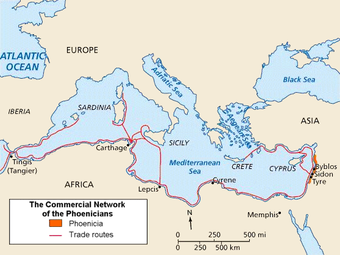
Phoenician Trade Network
Map of Phoenicia and its trade routes.
Persian Rule
Cyrus the Great of Persia conquered Phoenicia in 539 BCE. The Persians divided Phoenicia into four vassal kingdoms: Sidon, Tyre, Arwad, and Byblos. Though these vassal kingdoms prospered and furnished fleets for the Persian kings, Phoenician influence declined after this period. It is likely that much of the Phoenician population migrated to Carthage and other colonies following the Persian conquest. In 350 or 345 BCE, a rebellion in Sidon was crushed by Artaxerxes III.
Hellenistic Rule
Alexander the Great took Tyre in 332 BCE after the Siege of Tyre, and kept the existing king in power. He gained control of the other Phoenician cities peacefully, and the rise of Hellenistic Greece gradually ousted the remnants of Phoenicia’s former dominance over the Eastern Mediterranean trade routes. Phoenician culture disappeared entirely in the motherland. Carthage continued to flourish in North Africa. It oversaw the mining of iron and precious metals from Iberia, and used its considerable naval power and mercenary armies to protect commercial interests. It was finally destroyed by Rome in 146 BC, at the end of the Punic Wars.
3.1.3: The Minoans
The Minoans were an Aegean Bronze Age civilization on the island of Crete that flourished between 2800-1450 BCE. They left behind extensive material culture showing the extent of their handicraft and influence upon Mycenaean culture.
Learning Objective
Evaluate the impact of Minoan culture on other cultures and empires of the time
Key Points
- The Minoan civilization was an Aegean Bronze Age civilization that arose on the island of Crete, and flourished from approximately the 27th century to the 15th century BCE.
- The term “Minoan” was coined after the mythic “king” Minos, who was associated in Greek myth with the labyrinth identified with the site at Knossos.
- The Bronze Age allowed upper Minoan classes to practice leadership activities and to expand their influence, eventually replacing the original hierarchies of the local elites with monarchist power structures.
- The apex of Minoan civilization occurred during a period of large building projects, as palaces were rebuilt and settlements sprung up throughout Crete.
- Evidence of the influence of Minoan civilization outside Crete can be seen in Minoan handicraft on the Greek mainland, likely the result of a connection between Mycene and Minoan trade networks. The Minoans were also connected to Egypt and the Canaanite civilization.
- The Minoan civilization declined due to natural catastrophe, but the Dynasty of Knossos was able to spread its influence over Crete until it was overrun by the Mycenaean Greeks.
- Minoan culture is known best for its pottery and handiwork, and its religion was based primarily on the worship of female goddesses.
Key Terms
- Linear B
-
A syllabic script that was used for writing Mycenaean Greek—
the earliest attested form of Greek.
- Minoan civilization
-
An Aegean Bronze Age civilization that arose on the island of Crete and flourished from approximately the 27th century to the 15th century BCE.
- Knossos
-
A syllabic script that was used for writing Mycenaean Greek, the earliest attested form of Greek.
- Neopalatial period
-
The period of the new or second palaces of Minoan Crete, corresponding roughly with 17th and 16th centuries BCE.
- Linear A
-
The primary script used in palace and religious writings of the Minoan civilization, one of two currently undeciphered writing systems used in ancient Crete.
The Minoan civilization was an Aegean Bronze Age civilization that arose on the island of Crete, and flourished from approximately the 27th century to the 15th century BCE.
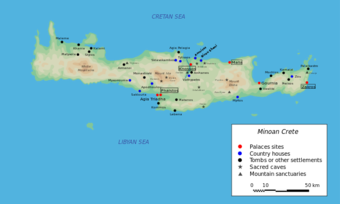
Minoan Crete
A map of Minoan Crete.
The early inhabitants of Crete settled as early as 128,000 BCE, during the Middle Paleolithic Age. It was not until 5000 BCE that the first signs of advanced agriculture appeared, marking the beginning of civilization. The term “Minoan” was coined by Arthur Evans after the mythic “king” Minos. Minos was associated in Greek myth with the labyrinth, which is identified with the site at Knossos.
The Bronze Age began in Crete around 2700 BCE, when several localities on the island developed into centers of commerce and handwork. This development enabled the upper classes to continuously practice leadership activities and to expand their influence. It is likely that the original hierarchies of the local elites were replaced by monarchist power structures— a precondition for the creation of the great palaces.
Around 1700 BCE, there was a large disturbance in Crete, possibly an earthquake or an invasion from Anatolia. The palaces at Knossos, Phaistos, Malia, and Kato Zakros were destroyed. But with the start of the Neopalatial period (the 17th and 16th centuries BCE), population increased again, palaces were rebuilt on a larger scale, and new settlements sprung up all over the island. This period represents the apex of the Minoan civilization.
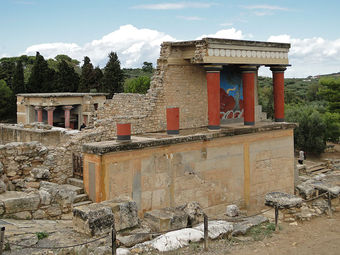
Knossos – North Portico
Restored North Entrance of the Knossos palace complex, with the charging bull fresco.
The influence of the Minoan civilization outside Crete has been seen in the evidence of valuable Minoan handicraft items on the Greek mainland. It is likely that the ruling house of Mycene was connected to the Minoan trade network. After c. 1700 BCE, the material culture on the Greek mainland achieved a new level due to Minoan influence. Connections between Egypt and Crete are also prominent. Minoan ceramics are found in Egyptian cities, and the Minoans imported several items from Egypt, especially papyrus, as well as architectural and artistic ideas. The Egyptian hieroglyphs served as a model for Minoan pictographic writing, from which the famous Linear A and Linear B writing systems later developed. There has also been evidence of Minoan influence among Canaanite artifacts.
The Minoan culture began to decline c. 1450 BCE, following an earthquake, the eruption of the Thera volcano, or another possible natural catastrophe. Several important palaces in locations such as Mallia, Tylissos, Phaistos, Hagia Triade, as well as the living quarters of Knossos were destroyed, but the palace in Knossos seems to have remained largely intact. The preservation of this palace resulted in the Dynasty in Knossos spreading its influence over large parts of Crete until it was overrun by Mycenaean Greeks.
Society and Culture
Pottery
The best surviving examples of Minoan art are its pottery and palace architecture with frescos that include landscapes, stone carvings, and intricately carved seal stones. Ceramics from the Early Minoan period are characterized by linear patterns of spirals, triangles, curved lines, crosses, and fishbone motifs. In the Middle Minoan period, naturalistic designs such as fish, squid, birds, and lilies were common. In the Late Minoan period, flowers and animals were still the most characteristic, but the variability had increased. The “palace style” of the region around Knossos is characterized by a strong geometric simplification of naturalistic shapes and monochromatic paintings. The similarities between Late Minoan and Mycenaean art are notable. Frescoes were the main form of art during the period of Late Minoan culture.
Religion
The Minoans seem to have worshiped primarily goddesses, and can be described as a “matriarchal religion.” Although there is some evidence of male gods, depictions of Minoan goddesses vastly outnumber depictions of anything that could be considered a Minoan god. While some of these depictions of women are speculated to be images of worshippers and priestesses officiating at religious ceremonies, as opposed to the deity, several goddesses appear to be portrayed. These include a mother goddess of fertility, a mistress of the animals, a protectress of cities, the household, the harvest, and the underworld, to name a few. The goddesses are often depicted with serpents, birds, or poppies, and are often shown with a figure of an animal upon her head.
3.2: Ancient Africa
3.2.1: Sao
The Sao lived in modern-day Cameroon and Chad from the 6th century BCE to the 16th century CE.
Learning Objective
Identify where and when the Sao lived
Key Points
- The Sao civilization flourished in Middle Africa from the 6th century BCE to as late as the 16th century CE. Due to a lack of written records, little is known about the Sao’s culture or political organization.
- One theory of the origin of the Sao states that they descended from the Hyksos, who conquered Ancient Egypt and later moved south, from the Nile valley to mid-Africa, after fleeing invaders. The Sao were made up of several patrilineal clans who were united into a single polity with one language, race, and religion.
- It is unclear why the Sao declined, but it may have been due to conquest or assimilation.
- Today, several ethnic groups of northern Cameroon and southern Chad, particularly the Sara, claim to be descendants of the Sao.
Key Terms
- Hyksos
-
A people of mixed Semitic and Asian descent who invaded Egypt and settled in the Nile delta c. 1640 BCE. They were driven out of Egypt c. 1532 BCE.
- patrilineal
-
Pertaining to descent through male lines.
- Islamization
-
The process of a society’s shift toward the religion of Islam.
The Sao civilization flourished in Middle Africa from the 6th century BCE to as late as the 16th century CE. They lived by the Chari River, south of Lake Chad, in parts of modern-day Cameroon and Chad.
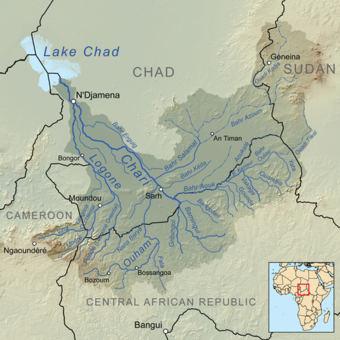
Chari River
Region including Lake Chad, Cameroon, and environs.
For more than 2,000 years, the Chadian Basin has been inhabited by agricultural and sedentary people. The region became a crossroads of civilizations. The earliest of these were the legendary Sao, known today only from artifacts and oral histories. They left no written records and are known only through archaeological finds and the oral history of their successors in the territory. Unfortunately, little is known about the Sao’s culture or political organization. One theory of the origin of the Sao states that they descended from the Hyksos, who conquered Ancient Egypt and later moved south, from the Nile valley to mid-Africa, after fleeing invaders.
Sao artifacts show that they were skilled workers in bronze, copper, and iron. They made bronze sculptures and terra cotta statues of human and animal figures, funerary urns, and highly decorated pottery. The Sao were made up of several patrilineal clans who were united into a single polity with one language, race, and religion.
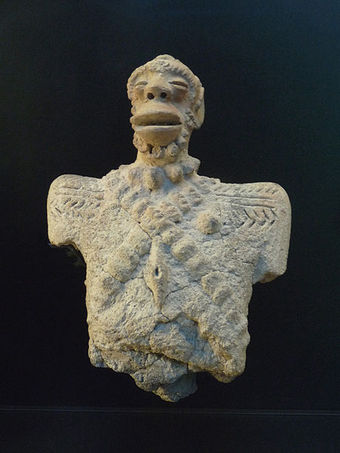
Sao Sculpture
A Sao sculpture from Chad.
The Sao’s demise may have come about due to conquest, Islamization, or a combination of the two. Traditional tales say that the Sao west of Lake Chad fell to “Yemenites” from the east. If true, the newcomers may have been Arab Bedouin or Sayfuwa raiders coming from the east, who moved into the region in the 14th century CE. Although some scholars estimate that the Sao civilization south of Lake Chad lasted until the 14th or 15th century CE, the majority opinion is that it ceased to exist as a separate culture sometime in the 16th century CE.
The Sao fell to the Kanem Empire, the first and longest-lasting of the empires that developed in Chad’s Sahelian strip by the end of the 1st millennium CE. The power of Kanem and its successors was based on control of the trans-Saharan trade routes that passed through the region.
Today, several ethnic groups of northern Cameroon and southern Chad, particularly the Sara, claim to be descendants of the Sao. The Sara are an ethnic group who reside in southern Chad and Central African Republic. They make up 27.7% of Chad’s total population (year 1993 Census). Other ethnic groups in the Lake Chad basin area, including the Buduma, Gamergu, Kanembu, Kotoko and Musgum, also claim to be descended from the Sao.
3.2.2: Ancient Carthage
Ancient Carthage was a North African civilization that lasted from c. 650 BCE to 146 BCE.
Learning Objective
Explain Carthage’s culture and the Punic Wars
Key Points
- Ancient Carthage was the empire born of the Phoenician city-state Carthage.
- Carthage practiced highly advanced and productive agriculture and manufacturing.
- Carthage traded in almost every commodity wanted by the ancient world, including spices from Arabia, Africa, and India. It also participated in the slave trade.
- The military of Carthage was one of the largest military forces in the ancient world; its navy was its strongest force.
- The Punic Wars were fought with Rome from 265 BCE to 146 BCE. The main cause was the conflict of interest between the existing Carthaginian Empire and the expanding Roman Republic.
- The Third Punic War began in 149 BCE, and culminated in the defeat of Carthage.
- The Roman domination during the Punic Wars was the beginning of a rise in status that would last until the 5th century CE.
Key Terms
- Phoenician
-
A Semitic people inhabiting ancient Phoenicia and its colonies.
- polytheism
-
The belief in, or worship of, more than one god.
- Punic Wars
-
A set of three wars between Carthage and Rome that culminated in the fall of Carthage.
Ancient Carthage was a North African, Phoenician civilization that lasted from c. 650 BCE to 146 BCE. They were defeated by the Romans in 146 BCE. Carthage eventually extended across northern Africa and into the south of modern-day Spain.
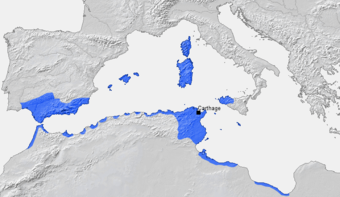
Carthage
Ancient Carthage in 264 BCE.
Culture
Carthaginian religion was based on Phoenician religion (derived from the faiths of the Levant), a form of polytheism. Many of the gods the Carthaginians worshiped were localized, and are now known only under their local names.
Carthage produced finely embroidered silks, dyed textiles of cotton, linen,and wool, artistic and functional pottery, and perfumes. Its artisans worked expertly with ivory, glassware, and wood, as well as with metals and precious stones. It traded in salted Atlantic fish and fish sauce (garum), and brokered the products of almost every Mediterranean people. In addition to manufacturing, Carthage practiced highly advanced and productive agriculture, using iron ploughs, irrigation, and crop rotation.
Carthaginian commerce extended by sea throughout the Mediterranean, and perhaps into the Atlantic as far as the Canary Islands, and by land across the Sahara desert. According to Aristotle, the Carthaginians and others had treaties of commerce to regulate their exports and imports.The empire of Carthage depended heavily on its trade with cities of the Iberian peninsula, from which it obtained vast quantities of silver, lead, copper and—
most importantly —tin ore, which was essential for the manufacture of bronze objects by the civilizations of antiquity.
Carthaginian trade-relations with the Iberians (and the naval strength that enforced Carthage’s monopoly on Iberian trade and that with tin-rich Britain), made it the sole significant broker of tin and maker of bronze in its day. Maintaining this monopoly was one of the major sources of power and prosperity for Carthage; Carthaginian merchants strove to keep the location of the tin mines secret. In addition to its role as the sole significant distributor of tin, Carthage’s central location in the Mediterranean and control of the waters between Sicily and Tunisia allowed it to control the eastern peoples’ supply of tin. Carthage was also the Mediterranean’s largest producer of silver mined in Iberia and on the North African coast; after the tin monopoly, silver was one of its most profitable trades.
Carthage also sent caravans into the interior of Africa and Persia. It traded its manufactured and agricultural goods to the coastal and interior peoples of Africa for salt, gold, timber, ivory, ebony, apes, peacocks, skins, and hides. Its merchants invented the practice of sale by auction and used it to trade with the African tribes. In other ports, they tried to establish permanent warehouses, or sell their goods in open-air markets.
Carthage obtained amber from Scandinavia, and from the Celtiberians, Gauls, and Celts they got amber, tin, silver, and furs. Sardinia and Corsica produced gold and silver for Carthage, and Phoenician settlements on islands, such as Malta and the Balearic Islands, produced commodities that would be sent back to Carthage for large-scale distribution. The city supplied poorer civilizations with simple products (such as pottery, metallic objects, and ornamentations), often displacing the local manufacturing, and meanwhile brought its best works to wealthier civilizations (such as the Greeks and Etruscans). Carthage traded in almost every commodity wanted by the ancient world, including spices from Arabia, Africa and India. It also participated in the slave trade.
Military and Warfare
The military of Carthage was one of the largest military forces in the ancient world. Although Carthage’s navy was always its main military force, the army acquired a key role in the spread of Carthaginian power over the native peoples of northern Africa and southern Iberian Peninsula, from the 6th century BC to the 3rd century BC. Carthage’s military also allowed it to expand into Sardinia and the Balearic Islands. This expansion transformed the military from a body of citizen-soldiers into a multinational force composed primarily of foreign mercenary units.
Ancient Carthage was almost constantly at war with the Greeks or the Romans. One set of wars was called the Punic Wars. They were fought with Rome from 265 BCE to 146 BCE. The main cause of the Punic Wars was the conflict of interest between the existing Carthaginian Empire and the expanding Roman Republic. The Romans were initially interested in expansion via Sicily (at that time a cultural melting pot), part of which lay under Carthaginian control. At the start of the first Punic War, Carthage was the dominant power of the Western Mediterranean, with an extensive maritime empire. Rome, meanwhile, was the rapidly ascending power in Italy, which still lacked the naval power of Carthage.
It was during the Second Punic War that the Carthaginian leader Hannibal launched his famous overland attack on Rome. By the end of the third war, which began in 149 BCE, many hundreds of thousands of soldiers from both sides had been lost, and Rome succeeded in conquering Carthage’s empire. The Romans completely destroyed Carthage, and became the most powerful state in the Western Mediterranean. During this period, Rome emerged as the dominant Mediterranean power and one of the most powerful cities in classical antiquity. The Roman victories over Carthage in these wars gave Rome a preeminent status, a status it would retain until the 5th century CE.
3.3: The Ancient Andes
3.3.1: The Caral Civilization
The Caral civilization flourished in the Andean region between the 30th and 18th centuries BCE. This peaceful, urban center yielded several major discoveries, including a method of keeping records known as quipu.
Learning Objective
Describe the significance of the Caral civilization of the Andes
Key Points
- The Caral civilization (also known as Caral-Supe) was part of the Norte Chico civilization complex, in what is now the Norte Chico region of north-central coastal Peru.
- The urban complex of Caral takes up more than 150 acres, and contains plazas, dwellings, and a 28-meters-high temple.
- Some scholars have suggested that Norte Chico was founded on seafood and maritime resources, rather than development of agricultural cereal and crop surpluses.
- One of the artifacts found at Caral is a knotted textile piece, called a quipu, which archaeologists believe was a method of keeping records.
- Evidence of warfare has not been found in Caral.
- A geoglyph of a human with long hair and open mouth was discovered in 2000 by Marco Machacuay and Rocio Aramburu just west of Caral.
- At its peak, approximately 3,000 people are believed to have lived in Caral.
- Norte Chico civilizations are pre-ceramic cultures of the pre-Columbian Late Archaic; they completely lacked ceramics, and apparently had almost no art. The most impressive achievement of these civilizations was its monumental architecture.
Key Terms
- Caral civilization
-
A complex pre-Columbian society that included as many as 30 major population centers, in what is now the Norte Chico region of north-central coastal Peru.
- geoglyph
-
A large design produced on the ground, typically formed by rocks, stones, trees, gravel, or earth.
- quipu
-
A knotted textile piece found at the Caral site, believed to be used for record-keeping.
The Caral civilization (also known as the Norte Chico civilization and as Caral-Supe) was a complex pre-Columbian society, located in what is now the Norte Chico region of north-central coastal Peru, near Supe, Barranca province, Peru (200 km north of Lima). Its location allowed it to take advantage of three rivers: the Fortaleza, the Pativilca, and the Supe. It has been established as the oldest known civilization in the Americas, and as one of the six sites where civilization separately originated in the ancient world.
The Caral flourished between the 30th and 18th centuries BCE. This complex society arose a millennium after Sumer in Mesopotamia, was contemporaneous with the Egyptian pyramids, and predated the Mesoamerican Olmec by nearly two millennia.
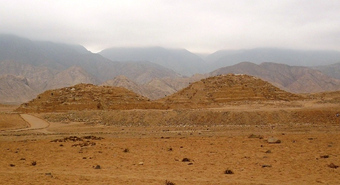
Caral
The remains of the Caral site in Peru
Caral was discovered by Paul Kosok in 1948, and further studied by archaeologist Ruth Shady. The urban complex of Caral takes up more than 150 acres, and holds plazas, dwellings, and a 28-meters-high temple. Its urban plan was used by Andean civilizations for the next four thousand years. One of the artifacts found at Caral is a knotted textile piece named a quipu, which archaeologists believe was a method of keeping records. Other pieces found include flutes made of condor and pelican bones, and cornetts made of deer and llama bones. Evidence of warfare has not been found. A geoglyph was discovered in 2000 by Marco Machacuay and Rocio Aramburu just west of Caral. The lines of the etching form a human face with long hair and an open mouth. At its peak, approximately 3,000 people are believed to have lived in Caral.
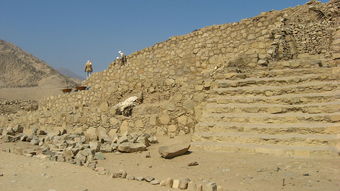
Caral Temple
A view of the Caral temple
The Norte-Chico Region
In archaeological nomenclature, Norte Chico civilizations are pre-ceramic cultures of the pre-Columbian Late Archaic; they completely lacked ceramics and apparently had almost no art. The most impressive achievement of these civilizations was its monumental architecture, including large earthwork platform mounds and sunken circular plazas. Archaeological evidence suggests use of textile technology and, possibly, the worship of common god symbols, both of which recur in pre-Columbian Andean cultures. Sophisticated government is assumed to have been required to manage the ancient Norte Chico. Questions remain over its organization, particularly the political influence of food resources. Some scholars have suggested that Norte Chico was founded on seafood and maritime resources, as opposed to the development of agricultural cereal and crop surpluses, which have been considered essential to the rise of other ancient civilizations.
3.3.2: The Chavín Civilization
The Chavín civilization, which lasted from 900-250 BCE in Peru, featured ingenious art and architecture, and had widespread influence on other local cultures.
Learning Objective
Describe the significance of the Chavín civilization
Key Points
- The Chavín civilization developed in the northern Andean highlands of Peru between 900-250 BCE.
- There were three stages of development: Urabarriu (900-500 BCE), Chakinani (500-400 BCE), and Jarabarriu (400-250 BCE).
- Chavín had a small, powerful elite that was legitimized through a claim to divine authority.
- The chief example of Chavín architecture is the Chavín de Huántar temple, the design of which displays a complex and innovative adaptation to the highland environment of Peru.
- The Chavín people showed advanced knowledge of acoustics, metallurgy, soldering, and temperature control. One of their main economic resources was ch’arki, or llama jerky.
- Chavín art represents the first widespread, recognizable artistic style in the Andes, and can be divided into two phases: the first phase corresponds to the construction of the “Old Temple” at Chavín de Huántar (c. 900-500 BCE); the second phase corresponds to the construction of Chavín de Huántar’s “New Temple” (c. 500-200 BCE).
- Significant pieces of art include the Lanzón, Tello Obelisk, and tenon heads.
Key Terms
- camelids
-
A mammal of the camel family (Camelidae).
- Lanzón
-
A stone stela found in the Chavín de Huántar temple.
- Tello Obelisk
-
A huge sculpted shaft depicting a Chavín creation myth.
- ch’arki
-
Llama jerky.
- Chavín civilization
-
A civilization in the northern Andean highlands
of Peru from 900-250 BCE, known for their construction of temples and their
advancements in engineering and metallurgy. - axis mundi
-
A pivot point linking heaven, earth and the underworld.
- psychotropic drugs
-
A chemical substance that changes brain function and results in alterations in perception, mood, or consciousness.
- Urabarriu
-
A stage of development in the Chavín civilization from 900-500 BCE.
- Chakinani
-
A stage of development in the Chavín civilization from 500-400 BCE.
- Jarabarriu
-
A stage of development in the Chavín civilization from 400-250 BCE.
The Chavín civilization developed in the northern Andean highlands of Peru
between 900-250 BCE. Their influence extended to other civilizations along
the coast. The Chavín civilization was located in the Mosna Valley, where the Mosna and
Huachecsa rivers merge. It is now a UNESCO World Heritage site.
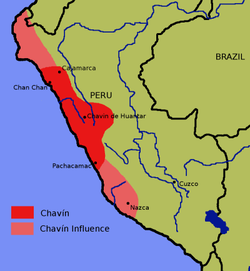
Map Showing Location of the Chavín
This map shows the location of the Chavín culture, as well as the areas the Chavín influenced.
Stages of Development
Urabarriu lasted from 900-500 BCE, and just a few hundred people lived at Chavín de Huantar. Ceramics were influenced by other cultures, and the people grew some maize and potatoes. Chakinani, from 500-400 BCE, was a transitional time, when residents migrated to the ceremonial center. From 400-250 BCE, Jarabarriu saw a dramatic increase in population, with an urban/suburban pattern of settlement.
Society
Chavín had a small, powerful elite that was legitimized through a claim to divine authority. These shamans were able to control and influence local citizens (probably partially through the use of psychotropic drugs), and were able to plan and carry out construction of temples and stone-walled galleries.
Architecture
The
chief example of Chavín architecture is the Chavín de Huántar temple. The temple’s
design shows complex innovation to adapt to the highland environment of Peru.
To avoid flooding and the destruction of the temple during the rainy season,
the Chavín people created a successful drainage system with canals under the
temple structure; the rushing water during the rainy season sounds like one of the Chavín’s sacred animals, the jaguar.
Economic Activity
The Chavín people showed advanced knowledge of acoustics, metallurgy, soldering, and
temperature control to accommodate the rainy season. The Chavín were also
skilled in developing refined goldwork, and used early techniques of melting
metal and soldering.
The
Chavín people domesticated camelids, such as llamas, which were used as pack animals, and for fiber and meat. The Chavin produced ch’arki, or llama jerky, which was commonly
traded by camelid herders and was the main economic resource for the Chavín
people. They also successfully cultivated several crops, including
potatoes, quinoa, and maize. They developed an irrigation system to assist the
growth of these crops.
Art
Chavín art represents the first widespread, recognizable artistic style in the
Andes, and can be divided into two phases: the first phase corresponds to the
construction of the “Old Temple” at Chavín de Huántar (c. 900-500
BCE); the second phase corresponds to the construction of Chavín de Huántar’s
“New Temple” (c. 500-200 BCE). The Old Temple featured the Lanzón, which was housed in a central cruciform chamber in a labyrinth of underground passages. The Lanzón functions as axis mundi, or a pivot point linking the heavens, earth, and underworld.
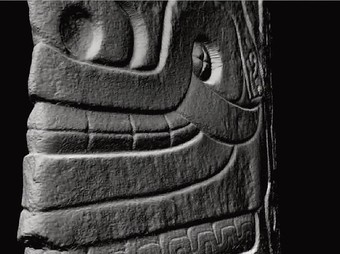
The Lanzón at Chavín
Shown here is the most important stela statue of the central deity of the Chavín, called the Lanzón.
Chavín
art decorated the walls of the temple and includes carvings, sculptures and
pottery. Artists depicted exotic creatures found in other regions, such as
jaguars and eagles, rather than local plants and animals. The feline figure is
one of the most important motifs seen in Chavín art. It has an important
religious meaning and is repeated on many carvings and sculptures.
Eagles are also commonly seen throughout Chavín art. It was intentionally difficult to interpret and understand, as it was meant to be read by the high priests alone.
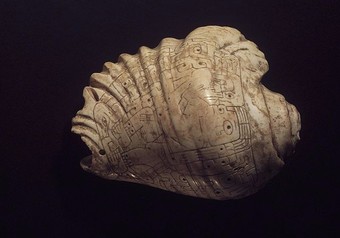
Incised Strombus-Shell Trumpet
This shell trumpet was likely used in ceremonies. The incised designs show a person of high rank playing a shell trumpet, surrounded by snakes.
The Tello Obelisk is a huge sculpted shaft decorated with images of plants, animals, including caymans and birds, and humans, which may be portraying a creation myth. Tenon heads are massive stone carvings of fanged jaguar heads, found at the tops of interior walls in Chavín de Huantar.
Influence
Chavín had wide-ranging influence, with its art and architecture styles spreading for miles around. There is little evidence of warfare in Chavín relics; instead, local citizens were likely controlled by a combination of religious pressure and environmental conditions.
3.3.3: The Valdivia Culture
The Valdivia culture of Ecuador (3500-1800 BCE) is one of the oldest settled cultures recorded in the Americas. They were a sedentary, egalitarian people, known for their early use of pottery, and feminine ceramic figures.
Learning Objective
Describe the significance of the Valdivia culture
Key Points
- The Valdivia culture of Ecuador (3500-1800 BCE) is one of the oldest settled cultures recorded in the Americas.
- The Valdivia lived in a community that built its houses in a circle or oval around a central plaza and were sedentary, egalitarian people.
- Valdivian pottery (bowls, jars, and feminine figures) are the oldest in the Americas, dating to 2700 BCE.
- Valdivians created rafts with sails, and built a maritime trade network with tribes in the Andes and Amazon.
- A main trading item was the red shell of the thorny oyster, called Spondylus.
Key Terms
- Spondylus
-
A genus of bivalve mollusks, also known as thorny oysters.
- cassava
-
The starchy tuberous root of a tropical tree.
- egalitarian
-
Believing in the principle that all people are equal.
The Valdivia culture is one of the oldest settled cultures recorded in the
Americas. It emerged from the earlier Las Vegas culture, and thrived on the Santa
Elena peninsula near the modern-day town of Valdivia, Ecuador, between 3500-1800
BCE.
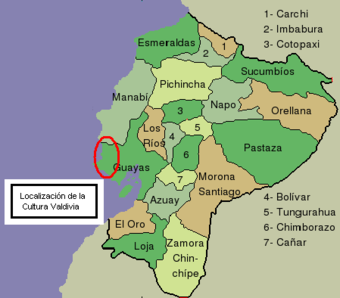
Map of Valdivian Culture
Shown here is the location of the Valdivia culture.
Life Among the Valdivians
The Valdivia lived in a community that built its houses in a circle or oval
around a central plaza. They were sedentary, egalitarian people who lived off farming and
fishing, and occasional deer hunting. From the remains that
have been found, it has been determined that Valdivians cultivated maize,
kidney beans, squash, cassava, chili peppers, and cotton plants, the latter of
which was used to make clothing.
Pottery
Valdivian pottery, which has been dated to 2700 BCE, was initially rough and
practical, but over time became splendid, delicate, and large. Bowls, jars, and female statues were used in daily life and religious ceremonies. They generally
used the colors red and gray, and polished dark red pottery is characteristic
of the Valdivia period. In their ceramics and stone works, the Valdivia culture
showed a progression from the most simple, to much more complicated works. Valdivians were the first Americans to use pottery.
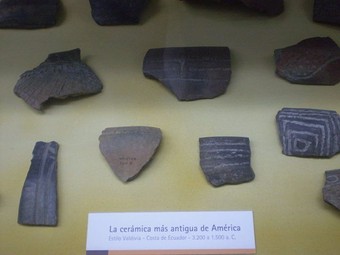
Valdivian Pottery
Valdivian pottery is the oldest in America, on display in this image at the
Museo de La Plata in Argentina.
The trademark Valdivia pottery piece is the
“Venus” of Valdivia: feminine ceramic figures. The “Venus”
of Valdivia likely represented actual people; each figurine is individual
and unique, as can be seen in the hairstyles. They were made by joining two rolls
of clay, leaving the lower portion separated as legs and forming the body and
head from the top portion. The arms were usually very short, and in most cases
were bent towards the chest, holding the breasts or chin.
Trade
Valdivians created rafts with sails, and built a maritime trade network with tribes in the Andes and Amazon. A main trading item was the red shell of the thorny oyster, called Spondylus, which were often made into ornaments, and were considered more valuable than gold or silver.
Chapter 2: Ancient Mesopotamian Civilizations
2.1: The First Urban Civilizations
2.1.1: The Sumerians
The Sumerian people lived in Mesopotamia from the 27th-20th century BCE. They were inventive and industrious, creating large city-states, trading goods, mass-producing pottery, and perfecting many forms of technology.
Learning Objective
To understand the history and accomplishments of the Sumerian people
Key Points
- The Sumerians were a people living in Mesopotamia from the 27th-20th century BCE.
- The major periods in Sumerian history were the Ubaid period (6500-4100 BCE), the Uruk period (4100-2900 BCE), the Early Dynastic period (2900-2334 BCE), the Akkadian Empire period (2334 – 2218 BCE), the Gutian period (2218-2047 BCE), Sumerian Renaissance/Third Dynasty of Ur (2047-1940 BCE), and then decline.
- Many Sumerian clay tablets have been found with writing. Initially, pictograms were used, followed by cuneiform and then ideograms.
- Sumerians believed in anthropomorphic polytheism, or of many gods in human form that were specific to each city-state.
- Sumerians invented or perfected many forms of technology, including the wheel, mathematics, and cuneiform script.
Key Terms
- City-states
-
A city that with its surrounding territory forms an independent state.
- cuneiform script
-
Wedge-shaped characters used in the ancient writing systems of Mesopotamia, surviving mainly on clay tablets.
- ideograms
-
Written characters symbolizing an idea or entity without indicating the sounds used to say it.
- pictograms
-
A pictorial symbol for a word or phrase. They are the earliest known forms of writing.
- pantheon
-
The collective gods of a people or religion.
- Epic of Gilgamesh
-
An epic poem from the Third Dynasty of Ur (circa 2100 BCE), which is seen as the earliest surviving great work of literature.
- anthropomorphic
-
Having human characteristics.
“Sumerian” is the name given by the Semitic-speaking Akkadians to non-Semitic speaking people living in Mespotamia. City-states in the region, which were organized by canals and boundary stones and dedicated to a patron god or goddess, first rose to power during the prehistoric Ubaid and Uruk periods. Sumerian written history began in the 27th century BCE, but the first intelligible writing began in the 23rd century BCE. Classical Sumer ends with the rise of the Akkadian Empire in the 23rd century BCE, and only enjoys a brief renaissance in the 21st century BCE. The Sumerians were eventually absorbed into the Akkadian/Babylonian population.
Periods in Sumerian History
The Ubaid period (6500-4100 BCE) saw the first settlement in southern Mesopotamia by farmers who brought irrigation agriculture. Distinctive, finely painted pottery was evident during this time.
The Uruk period (4100-2900 BCE) saw several transitions. First, pottery began to be mass-produced. Second, trade goods began to flow down waterways in southern Mespotamia, and large, temple-centered cities (most likely theocratic and run by priests-kings) rose up to facilitate this trade. Slave labor was also utilized.
The Early Dynastic period (2900-2334 BCE) saw writing, in contrast to pictograms, become commonplace and decipherable. The Epic of Gilgamesh mentions several leaders, including Gilgamesh himself, who were likely historical kings. The first dynastic king was Etana, the 13th king of the first dynasty of Kish. War was on the increase, and cities erected walls for self-preservation. Sumerian culture began to spread from southern Mesopotamia into surrounding areas.
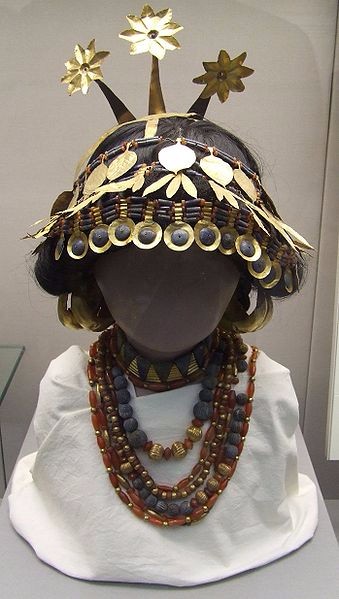
Sumerian Necklaces and Headgear
Sumerian necklaces and headgear discovered in the royal (and individual) graves, showing the way they may have been worn.
During the Akkadian Empire period (2334-2218 BCE), many in the region became bilingual in both Sumerian and Akkadian. Toward the end of the empire, though, Sumerian became increasingly a literary language.
The Gutian period (2218-2047 BCE) was marked by a period of chaos and decline, as Guti barbarians defeated the Akkadian military but were unable to support the civilizations in place.
The Sumerian Renaissance/Third Dynasty of Ur (2047-1940 BCE) saw the rulers Ur-Nammu and Shulgi, whose power extended into southern Assyria. However, the region was becoming more Semitic, and the Sumerian language became a religious language.
The Sumerian Renaissance ended with invasion by the Amorites, whose dynasty of Isin continued until 1700 BCE, at which point Mespotamia came under Babylonian rule.
Language and Writing
Many Sumerian clay tablets written in cuneiform script have been discovered. They are not the oldest example of writing, but nevertheless represent a great advance in the human ability to write down history and create literature. Initially, pictograms were used, followed by cuneiform, and then ideograms. Letters, receipts, hymns, prayers, and stories have all been found on clay tablets.
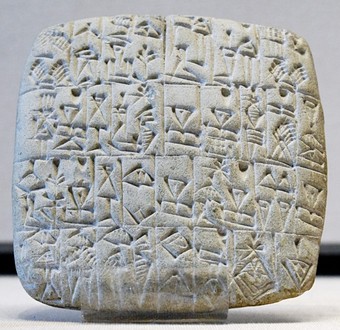
Bill of Sale on a Clay Tablet
This clay tablet shows a bill of sale for a male slave and building, circa 2600 BCE.
Religion
Sumerians believed in anthropomorphic polytheism, or of many gods in human form, which were specific to each city-state. The core pantheon consisted of An (heaven), Enki (a healer and friend to humans), Enlil (gave spells spirits must obey), Inanna (love and war), Utu (sun-god), and Sin (moon-god).
Technology
Sumerians invented or improved a wide range of technology, including the wheel, cuneiform script, arithmetic, geometry, irrigation, saws and other tools, sandals, chariots, harpoons, and beer.
2.1.2: The Assyrians
The Assyrians were a major Semitic empire of the Ancient Near East, who existed as an independent state for approximately nineteen centuries between c. 2500-605 BCE, enjoying widespread military success in its heyday.
Learning Objective
Describe key characteristics and notable events of the Assyrian Empire
Key Points
- Centered on the Upper Tigris river in northern Mesopotamia, the Assyrians came to rule powerful empires at several times, the last of which grew to be the largest and most powerful empire the world had yet seen.
- At its peak, the Assyrian empire stretched from Cyprus in the Mediterranean Sea to Persia, and from the Caucasus Mountains (Armenia, Georgia, Azerbaijan) to the Arabian Peninsula and Egypt. It was at the height of technological, scientific, and cultural achievements for its time.
- In the Old Assyrian period, Assyria established colonies in Asia Minor and the Levant, and asserted itself over southern Mesopotamia under king Ilushuma.
- Assyria experienced fluctuating fortunes in the Middle Assyrian period, with some of its kings finding themselves under the influence of foreign rulers while others eclipsed neighboring empires.
- Assyria became a great military power during the Neo-Assyrian period, and saw the conquests of large empires, such as Egyptians, the Phoenicians, the Hittites, and the Persians, among others.
- After its fall in the late 600s BCE, Assyria remained a province and geo-political entity under various empires until the mid-7th century CE.
Key Terms
- Aššur
-
The original capital of the Assyrian Empire, which dates back to 2600 BCE.
- Assyrian Empire
-
A major Semitic kingdom of the Ancient Near East, which existed as an independent state for a period of approximately nineteen centuries from c. 2500-605 BCE.
The Assyrian Empire was a major Semitic kingdom, and often empire, of the Ancient Near East. It existed as an independent state for a period of approximately 19 centuries from c. 2500 BCE to 605 BCE, which spans the Early Bronze Age through to the late Iron Age. For a further 13 centuries, from the end of the 7th century BCE to the mid-7th century CE, it survived as a geo-political entity ruled, for the most part, by foreign powers (although a number of small Neo-Assyrian states arose at different times throughout this period).
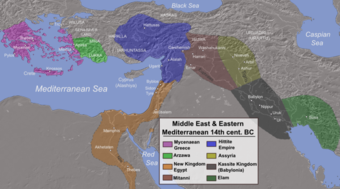
Map of the Ancient Near East during the 14th century BCE, showing the great powers of the day
This map shows the extent of the empires of Egypt (orange), Hatti (blue), the Kassite kingdom of Babylon (black), Assyria (yellow), and Mitanni (brown). The extent of the Achaean/Mycenaean civilization is shown in purple.
Centered on the Upper Tigris river, in northern Mesopotamia (northern Iraq, northeast Syria, and southeastern Turkey), the Assyrians came to rule powerful empires at several times, the last of which grew to be the largest and most powerful empire the world had yet seen.
As a substantial part of the greater Mesopotamian “Cradle of Civilization,” Assyria was at the height of technological, scientific, and cultural achievements for its time. At its peak, the Assyrian empire stretched from Cyprus in the Mediterranean Sea to Persia (Iran), and from the Caucasus Mountains (Armenia, Georgia, Azerbaijan) to the Arabian Peninsula and Egypt. Assyria is named for its original capital, the ancient city of Ašur (a.k.a., Ashur) which dates to c. 2600 BCE and was located in what is now the Saladin Province of northern Iraq. Ashur was originally one of a number of Akkadian city states in Mesopotamia. In the late 24th century BCE, Assyrian kings were regional leaders under Sargon of Akkad, who united all the Akkadian Semites and Sumerian-speaking peoples of Mesopotamia under the Akkadian Empire (c. 2334 BC-2154 BCE). Following the fall of the Akkadian Empire, c. 2154 BCE, and the short-lived succeeding Sumerian Third Dynasty of Ur, which ruled southern Assyria, Assyria regained full independence.
The history of Assyria proper is roughly divided into three periods, known as Old Assyrian (late 21st-18th century BCE), Middle Assyrian (1365-1056 BCE), and Neo-Assyrian (911- 612BCE). These periods roughly correspond to the Middle Bronze Age, Late Bronze Age, and Early Iron Age, respectively. In the Old Assyrian period, Assyria established colonies in Asia Minor and the Levant. Under king Ilushuma, it asserted itself over southern Mesopotamia. From the late 19th century BCE, Assyria came into conflict with the newly created state of Babylonia, which eventually eclipsed the older Sumero-Akkadian states in the south, such as Ur, Isin, Larsa and Kish. Assyria experienced fluctuating fortunes in the Middle Assyrian period. Assyria had a period of empire under Shamshi-Adad I and Ishme-Dagan in the 19th and 18th centuries BCE. Following the reigns of these two kings, it found itself under Babylonian and Mitanni-Hurrian domination for short periods in the 18th and 15th centuries BCE, respectively.
However, a shift in the Assyrian’s dominance occurred with the rise of the Middle Assyrian Empire (1365 BCE-1056 BCE). This period saw the reigns of great kings, such as Ashur-uballit I, Arik-den-ili, Tukulti-Ninurta I, and Tiglath-Pileser I. Additionally, during this period, Assyria overthrew Mitanni and eclipsed both the Hittite Empire and Egyptian Empire in the Near East. Long wars helped build Assyria into a warrior society, supported by landed nobility, which supplied horses to the military. All free male citizens were required to serve in the military, and women had very low status.
Beginning with the campaigns of Adad-nirari II from 911 BCE, Assyria again showed itself to be a great power over the next three centuries during the Neo-Assyrian period. It overthrew the Twenty-Fifth dynasty of Egypt, and conquered a number of other notable civilizations, including Babylonia, Elam, Media, Persia, Phoenicia/Canaan, Aramea (Syria), Arabia, Israel, and the Neo-Hittites. They drove the Ethiopians and Nubians from Egypt, defeated the Cimmerians and Scythians, and exacted tribute from Phrygia, Magan, and Punt, among others.
After its fall (between 612-605 BCE), Assyria remained a province and geo-political entity under the Babylonian, Median, Achaemenid, Seleucid, Parthian, Roman, and Sassanid Empires, until the Arab Islamic invasion and conquest of Mesopotamia in the mid-7th century CE when it was finally dissolved.
Assyria is mainly remembered for its military victories, technological advancements (such as using iron for weapons and building roads), use of torture to inspire fear, and a written history of conquests. Its military had not only general troops, but charioteers, cavalry, bowmen, and lancers.
2.2: Akkadian Empire
2.2.1: River Valley Civilizations
The first civilizations formed in river valleys, and were characterized by a caste system and a strong government that controlled water access and resources.
Learning Objective
Explain why early civilizations arose on the banks of rivers
Key Points
- Rivers were attractive locations for the first civilizations because they provided a steady supply of drinking water and game, made the land fertile for growing crops, and allowed for easy transportation.
- Early river civilizations were all hydraulic empires that maintained power and control through exclusive control over access to water. This system of government arose through the need for flood control and irrigation, which requires central coordination and a specialized bureaucracy.
- Hydraulic hierarchies gave rise to the established permanent institution of impersonal government, since changes in ruling were usually in personnel, but not in the structure of government.
Key Terms
- Fertile Crescent
-
A crescent-shaped region containing the comparatively moist and fertile land of otherwise arid and semi-arid Western Asia, and the Nile Valley and Nile Delta of northeast Africa. Often called the cradle of civilization.
- hydraulic empire
-
A social or governmental structure that maintains power through exclusive control of water access.
- caste
-
A form of social stratification characterized by endogamy (hereditary transmission of a lifestyle). This lifestyle often includes an occupation, ritual status in a hierarchy, and customary social interaction and exclusion based on cultural notions of purity and pollution.
- Water crisis
-
There is not enough fresh, clean water to meet local demand.
- Water shortage
-
Water is less available due to climate change, pollution, or overuse.
- Neolithic Revolution
-
Also called the Agricultural Revolution, this was the wide-scale transition of human cultures from being hunter-gatherers to being settled agriculturalists.
- Water stress
-
Difficulty in finding fresh water, or the depletion of available water sources.
The First Civilizations
The first civilizations formed on the banks of rivers. The most notable examples are the Ancient Egyptians, who were based on the Nile, the Mesopotamians in the Fertile Crescent on the Tigris/Euphrates rivers, the Ancient Chinese on the Yellow River, and the Ancient India on the Indus. These early civilizations began to form around the time of the Neolithic Revolution (12000 BCE).
Rivers were attractive locations for the first civilizations because they provided a steady supply of drinking water and made the land fertile for growing crops. Moreover, goods and people could be transported easily, and the people in these civilizations could fish and hunt the animals that came to drink water. Additionally, those lost in the wilderness could return to civilization by traveling downstream, where the major centers of human population tend to concentrate.
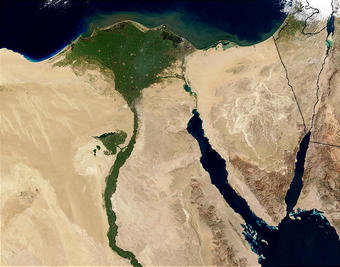
The Nile River and Delta
Most of the Ancient Egyptian settlements occurred along the northern part of the Nile, pictured in this satellite image taken from orbit by NASA.
Hydraulic Empires
Though each civilization was uniquely different, we can see common patterns amongst these first civilizations since they were all based around rivers. Most notably, these early civilizations were all hydraulic empires. A hydraulic empire (also known as hydraulic despotism, or water monopoly empire) is a social or governmental structure which maintains power through exclusive control over water access. This system of government arises through the need for flood control and irrigation, which requires central coordination and a specialized bureaucracy. This political structure is commonly characterized by a system of hierarchy and control based around class or caste. Power, both over resources (food, water, energy) and a means of enforcement, such as the military, are vital for the maintenance of control. Most hydraulic empires exist in desert regions, but imperial China also had some such characteristics, due to the exacting needs of rice cultivation. The only hydraulic empire to exist in Africa was under the Ajuran State near the Jubba and Shebelle Rivers in the 15th century CE.
Karl August Wittfogel, the German scholar who first developed the notion of the hydraulic empire, argued in his book, Oriental Despotism (1957), that strong government control characterized these civilizations because a particular resource (in this case, river water) was both a central part of economic processes and environmentally limited. This fact made controlling supply and demand easier and allowed the establishment of a more complete monopoly, and also prevented the use of alternative resources to compensate. However, it is also important to note that complex irrigation projects predated states in Madagascar, Mexico, China and Mesopotamia, and thus it cannot be said that a key, limited economic resource necessarily mandates a strong centralized bureaucracy.
According to Wittfogel, the typical hydraulic empire government has no trace of an independent aristocracy—
in contrast to the decentralized feudalism of medieval Europe. Though tribal societies had structures that were usually personal in nature, exercised by a patriarch over a tribal group related by various degrees of kinship, hydraulic hierarchies gave rise to the established permanent institution of impersonal government. Popular revolution in such a state was very difficult; a dynasty might die out or be overthrown by force, but the new regime would differ very little from the old one. Hydraulic empires were usually destroyed by foreign conquerors.
Water Scarcity Today
Access to water is still crucial to modern civilizations; water scarcity affects more than 2.8 billion people globally. Water stress is the term used to describe difficulty in finding fresh water or the depletion of available water sources. Water shortage is the term used when water is less available due to climate change, pollution, or overuse. Water crisis is the term used when there is not enough fresh, clean water to meet local demand. Water scarcity may be physical, meaning there are inadequate water resources available in a region, or economic, meaning governments are not managing available resources properly. The United Nations Development Programme has found that water scarcity generally results from the latter issue.
2.2.2: The Akkadian Empire
The Akkadian Empire flourished in the 24th and 22nd centuries BCE, ruled by Sargon and Naram-Sin. It eventually collapsed in 2154 BCE, due to the invasion of barbarian peoples and large-scale climatic changes.
Learning Objective
Describe the key political characteristics of the Akkadian Empire
Key Points
- The Akkadian Empire was an ancient Semitic empire centered in the city of Akkad and its surrounding region in ancient Mesopotamia, which united all the indigenous Akkadian speaking Semites and the Sumerian speakers under one rule within a multilingual empire.
- King Sargon, the founder of the empire, conquered several regions in Mesopotamia and consolidated his power by instating Akaddian officials in new territories. He extended trade across Mesopotamia and strengthened the economy through rain-fed agriculture in northern Mesopotamia.
- The Akkadian Empire experienced a period of successful conquest under Naram-Sin due to benign climatic conditions, huge agricultural surpluses, and the confiscation of wealth.
- The empire collapsed after the invasion of the Gutians. Changing climatic conditions also contributed to internal rivalries and fragmentation, and the empire eventually split into the Assyrian Empire in the north and the Babylonian empire in the south.
Key Terms
- Gutians
-
A group of barbarians from the Zagros Mountains who invaded the Akkadian Empire and contributed to its collapse.
- Sargon
-
The first king of the Akkadians. He conquered many of the surrounding regions to establish the massive multilingual empire.
- Akkadian Empire
-
An ancient Semitic empire centered in the city of Akkad and its surrounding region in ancient Mesopotamia.
- Cuneiform
-
One of the earliest known systems of writing, distinguished by its wedge-shaped marks on clay tablets, and made by means of a blunt reed for a stylus.
- Semites
-
Today, the word “Semite” may be used to refer to any member of any of a number of peoples of ancient Southwest Asian descent, including the Akkadians, Phoenicians, Hebrews (Jews), Arabs, and their descendants.
- Naram-Sin
-
An Akkadian king who conquered Ebla, Armum, and Magan, and built a royal residence at Tell Brak.
The Akkadian Empire was an ancient Semitic empire centered in the city of Akkad, which united all the indigenous Akkadian speaking Semites and Sumerian speakers under one rule. The Empire controlled Mesopotamia, the Levant, and parts of Iran.
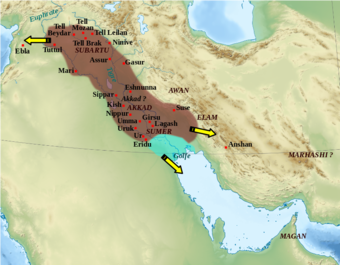
Map of the Akkadian Empire
The Akkadian Empire is pictured in brown. The directions of the military campaigns are shown as yellow arrows.
Its founder was Sargon of Akkad (2334–2279 BCE). Under Sargon and his successors, the Akkadian Empire reached its political peak between the 24th and 22nd centuries BCE. Akkad is sometimes regarded as the first empire in history.
Sargon and His Dynasty
Sargon claimed to be the son of La’ibum or Itti-Bel, a humble gardener, and possibly a hierodule, or priestess to Ishtar or Inanna. Some later claimed that his mother was an “entu” priestess (high priestess). Originally a cupbearer to king Ur-Zababa of Kish, Sargon became a gardener, which gave him access to a disciplined corps of workers who also may have served as his first soldiers. Displacing Ur-Zababa, Sargon was crowned king and began a career of foreign conquest. He invaded Syria and Canaan on four different campaigns, and spent three years subduing the countries of “the west” to unite them with Mesopotamia “into a single empire.”
Sargon’s empire reached westward as far as the Mediterranean Sea and perhaps Cyprus (Kaptara); northward as far as the mountains; eastward over Elam; and as far south as Magan (Oman)—a region over which he purportedly reigned for 56 years, though only four “year-names” survive. He replaced rulers with noble citizens of Akkad. Trade extended from the silver mines of Anatolia to the lapis lazuli mines in Afghanistan, and from the cedars of Lebanon to the copper of Magan. The empire’s breadbasket was the rain-fed agricultural system of northern Mesopotamia (Assyria), and a chain of fortresses was built to control the imperial wheat production.
Sargon, throughout his long life, showed special deference to the Sumerian deities, particularly Inanna (Ishtar), his patroness, and Zababa, the warrior god of Kish. He called himself “the anointed priest of Anu” and “the great ensi of Enlil. ”
Sargon managed to crush his opposition even in old age. Difficulties also broke out in the reign of his sons, Rimush (2278–2270 BCE), who was assassinated by his own courtiers, and Manishtushu (2269–2255 BCE), who reigned for 15 years. He, too, was likely assassinated in a palace conspiracy.
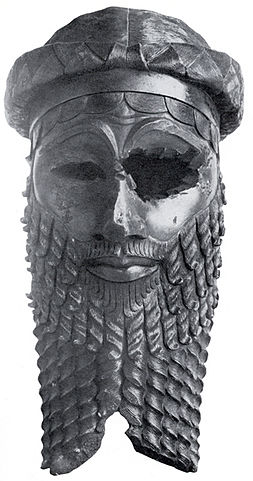
Bronze head of a king
Bronze head of a king, most likely Sargon of Akkad but possibly Naram-Sin. Unearthed in Nineveh (now in Iraq).
Naram-Sin
Manishtushu’s son and successor, Naram-Sin (called, Beloved of Sin) (2254–2218 BCE), assumed the imperial title “King Naram-Sin, King of the Four Quarters.” He was also, for the first time in Sumerian culture, addressed as “the god of Agade (Akkad).” This represents a marked shift away from the previous religious belief that kings were only representatives of the people toward the gods.
Naram-Sin conquered Ebla and Armum, and built a royal residence at Tell Brak, a crossroads at the heart of the Khabur River basin of the Jezirah. Naram-Sin also conquered Magan and created garrisons to protect the main roads. This productive period of Akkadian conquest may have been based upon benign climatic conditions, huge agricultural surpluses, and the confiscation of the wealth of other peoples.
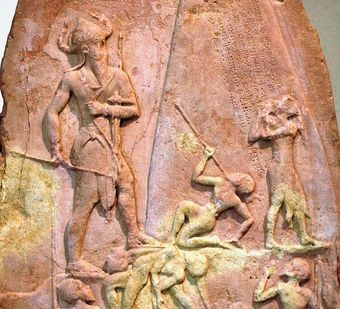
Stele of Naram-Sin
This stele commemorates Naram-Sin’s victory against the Lullubi from Zagros in 2260 BCE. Naram-Sin is depicted to be wearing a horned helmet, a symbol of divinity, and is also portrayed in a larger scale in comparison to others to emphasize his superiority.
Living in the Akkadian Empire
Future Mesopotamian states compared themselves to the Akkadian Empire, which they saw as a classical standard in governance. The economy was dependent on irrigated farmlands of southern Iraq, and rain-fed agriculture of Northern Iraq. There was often a surplus of agriculture but shortages of other goods, like metal ore, timber, and building stone. Art of the period often focused on kings, and depicted somber and grim conflict and subjugation to divinities. Sumerians and Akkadians were bilingual in each other’s languages, but Akkadian gradually replaced Sumerian. The empire had a postal service, and a library featuring astronomical observations.
Collapse of the Akkadian Empire
The Empire of Akkad collapsed in 2154 BCE, within 180 years of its founding. The collapse ushered in a Dark Age period of regional decline that lasted until the rise of the Third Dynasty of Ur in 2112 BCE. By the end of the reign of Naram-Sin’s son, Shar-kali-sharri (2217-2193 BCE), the empire had weakened significantly. There was a period of anarchy between 2192 BC and 2168 BCE. Some centralized authority may have been restored under Shu-Durul (2168-2154 BCE), but he was unable to prevent the empire collapsing outright from the invasion of barbarian peoples, known as the Gutians, from the Zagros Mountains.
Little is known about the Gutian period or for how long it lasted. Cuneiform sources suggest that the Gutians’ administration showed little concern for maintaining agriculture, written records, or public safety; they reputedly released all farm animals to roam about Mesopotamia freely, and soon brought about famine and rocketing grain prices. The Sumerian king Ur-Nammu (2112-2095 BCE) later cleared the Gutians from Mesopotamia during his reign.
The collapse of rain-fed agriculture in the Upper Country due to drought meant the loss of the agrarian subsidies which had kept the Akkadian Empire solvent in southern Mesopotamia. Rivalries between pastoralists and farmers increased. Attempts to control access to water led to increased political instability; meanwhile, severe depopulation occurred.
After the fall of the Akkadian Empire, the Akkadian people coalesced into two major Akkadian speaking nations: Assyria in the north, and, a few centuries later, Babylonia in the south.
2.2.3: Ur
The city-state of Ur in Mesopotamia was important and wealthy, and featured highly centralized bureaucracy. It is famous for the Ziggurat of Ur, a temple whose ruins were discovered in modern day.
Learning Objective
To understand the significance of the city-state of Ur
Key Points
- Ur was a major Sumerian city-state located in Mesopotamia, founded circa 3800 BCE.
- Cuneiform tablets show that Ur was a highly centralized, wealthy, bureaucratic state during the third millennium BCE.
- The Ziggurat of Ur was built in the 21st century BCE, during the reign of Ur-Nammu, and was reconstructed in the 6th century BCE by Nabonidus, the last king of Babylon.
- Control of Ur passed among various peoples until the Third Dynasty of Ur, which featured the strong kings Ur-Nammu and Shulgi.
- Ur was uninhabited by 500 BCE.
Key Terms
- Sargon the Great
-
A Semitic emperor of the Akkadian Empire, known for conquering Sumerian city-states in the 24th and 23rd centuries BCE.
- Ziggurat
-
A rectangular stepped tower, sometimes surmounted by a temple.
- Sumerian
-
A group of non-Semitic people living in ancient Mesopotamia.
- Cuneiform
-
Wedge-shaped characters imprinted onto clay tablets, used in ancient writing systems of Mesopotamia.
A Major Mesopotamian City
Ur was a major Sumerian city-state located in Mesopotamia, marked today by Tell el-Muqayyar in southern Iraq. It was founded circa 3800 BCE, and was recorded in written history from the 26th century BCE. Its patron god was Nanna, the moon god, and the city’s name literally means “the abode of Nanna.”
Cuneiform tablets show that Ur was, during the third millennium BCE, a highly centralized, wealthy, bureaucratic state. The discovery of the Royal Tombs, dating from about the 25th century BCE, showed that the area had luxury items made out of precious metals and semi-precious stones, which would have required importation. Some estimate that Ur was the largest city in the world from 2030-1980 BCE, with approximately 65,000 people.
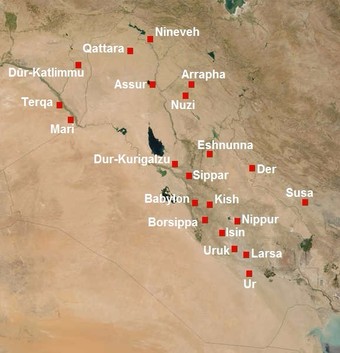
The City of Ur
This map shows Mesopotamia in the third millennium BCE, with Ur in the south.
The Ziggurat of Ur
This temple was built in the 21st century BCE, during the reign of Ur-Nammu, and was reconstructed in the 6th century BCE by Nabonidus, the last king of Babylon. The ruins, which cover an area of 3,900 feet by 2,600 feet, were uncovered in the 1930s. It was part of a temple complex that served as an administrative center for the city of Ur, and was dedicated to Nanna, the moon god.
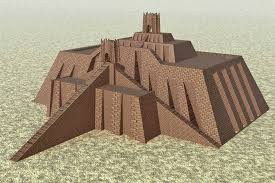
The Ziggurat of Ur
This is a reconstruction of Ur-Nammu’s ziggurat.
Control of Ur
Between the 24th and 22nd century BCE, Ur was controlled by Sargon the Great, of the Akkadian Empire. After the fall of this empire, Ur was ruled by the barbarian Gutians, until King Ur-Nammu came to power, circa 2047 – 2030 BCE (the Third Dynasty of Ur). Advances during this time included the building of temples, like the Ziggurat, better agricultural irrigation, and a code of laws, called the Code of Ur-Nammu, which preceded the Code of Hammurabi by 300 years.
Shulgi succeeded Ur-Nammu, and was able to increase Ur’s power by creating a highly centralized bureaucratic state. Shulgi, who eventually declared himself a god, ruled from 2029-1982 BCE, and was well-known for at least two thousand years after.
Three more kings, Amar-Sin, Shu0Sin and Ibbi-Sin, ruled Ur before it fell to the Elamites in 1940 BCE. Although Ur lost its political power, it remained economically important. It was ruled by the first dynasty of Babylonia, then part of the Sealand Dynasty, then by the Kassites before falling to the Assyrian Empire from the 10th-7th century BE. After the 7th century BCE, it was ruled by the Chaldean Dynasty of Babylon. It began its final decline around 550 BCE, and was uninhabited by 500 BE. The final decline was likely due to drought, changing river patterns and the silting of the Persian Gulf.
2.3: Babylonia
2.3.1: Babylon
Following the collapse of the Akkadians, the Babylonian Empire flourished under Hammurabi, who conquered many surrounding peoples and empires, in addition to developing an extensive code of law and establishing Babylon as a “holy city” of southern Mesopotamia.
Learning Objective
Describe key characteristics of the Babylonian Empire under Hammurabi
Key Points
- A series of conflicts between the Amorites and the Assyrians followed the collapse of the Akkadian Empire, out of which Babylon arose as a powerful city-state c. 1894 BCE.
- Babylon remained a minor territory for a century after it was founded, until the reign of its sixth Amorite ruler, Hammurabi (1792-1750 BCE), an extremely efficient ruler who established a bureaucracy with taxation and centralized government.
- Hammurabi also enjoyed various military successes over the whole of southern Mesopotamia, modern-day Iran and Syria, and the old Assyrian Empire in Asian Minor.
- After the death of Hammurabi, the First Babylonian Dynasty eventually fell due to attacks from outside its borders.
Key Terms
- Marduk
-
The south Mesopotamian god that rose to supremacy in the pantheon over the previous god, Enlil.
- Hammurabi
-
The sixth king of Babylon, who, under his rule, saw Babylonian advancements, both militarily and bureaucratically.
- Code of Hammurabi
-
A code of law that echoed and improved upon earlier written laws of Sumer, Akkad, and Assyria.
- Amorites
-
An ancient Semitic-speaking people from ancient Syria who also occupied large parts of Mesopotamia in the 21st Century BCE.
The Rise of the First Babylonian Dynasty
Following the disintegration of the Akkadian Empire, the Sumerians rose up with the Third Dynasty of Ur in the late 22nd century BCE, and ejected the barbarian Gutians from southern Mesopotamia. The Sumerian “Ur-III” dynasty eventually collapsed at the hands of the Elamites, another Semitic people, in 2002 BCE. Conflicts between the Amorites (Western Semitic nomads) and the Assyrians continued until Sargon I (1920-1881 BCE) succeeded as king in Assyria and withdrew Assyria from the region, leaving the Amorites in control (the Amorite period).
One of these Amorite dynasties founded the city-state of Babylon circa 1894 BCE, which would ultimately take over the others and form the short-lived first Babylonian empire, also called the Old Babylonian Period.
A chieftain named Sumuabum appropriated the then relatively small city of Babylon from the neighboring Mesopotamian city state of Kazallu, turning it into a state in its own right. Sumuabum appears never to have been given the title of King, however.
The Babylonians Under Hammurabi
Babylon remained a minor territory for a century after it was founded, until the reign of its sixth Amorite ruler, Hammurabi (1792-1750 BCE). He was an efficient ruler, establishing a centralized bureaucracy with taxation. Hammurabi freed Babylon from Elamite dominance, and then conquered the whole of southern Mesopotamia, bringing stability and the name of Babylonia to the region.
The armies of Babylonia under Hammurabi were well-disciplined, and he was able to invade modern-day Iran to the east and conquer the pre-Iranic Elamites, Gutians and Kassites. To the west, Hammurabi enjoyed military success against the Semitic states of the Levant (modern Syria), including the powerful kingdom of Mari. Hammurabi also entered into a protracted war with the Old Assyrian Empire for control of Mesopotamia and the Near East. Assyria had extended control over parts of Asia Minor from the 21st century BCE, and from the latter part of the 19th century BCE had asserted itself over northeast Syria and central Mesopotamia as well. After a protracted, unresolved struggle over decades with the Assyrian king Ishme-Dagan, Hammurabi forced his successor, Mut-Ashkur, to pay tribute to Babylon c. 1751 BCE, thus giving Babylonia control over Assyria’s centuries-old Hattian and Hurrian colonies in Asia Minor.
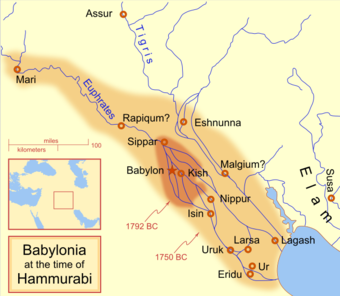
Babylonia under Hammurabi
The extent of the Babylonian Empire at the start and end of Hammurabi’s reign.
One of the most important works of this First Dynasty of Babylon was the compilation in about 1754 BCE of a code of laws, called the Code of Hammurabi, which echoed and improved upon the earlier written laws of Sumer, Akkad, and Assyria. It is one of the oldest deciphered writings of significant length in the world. The Code consists of 282 laws, with scaled punishments depending on social status, adjusting “an eye for an eye, a tooth for a tooth.” Nearly one-half of the Code deals with matters of contract. A third of the code addresses issues concerning household and family relationships.
From before 3000 BC until the reign of Hammurabi, the major cultural and religious center of southern Mesopotamia had been the ancient city of Nippur, where the god Enlil reigned supreme. However, with the rise of Hammurabi, this honor was transferred to Babylon, and the god Marduk rose to supremacy (with the god Ashur remaining the dominant deity in Assyria). The city of Babylon became known as a “holy city,” where any legitimate ruler of southern Mesopotamia had to be crowned. Hammurabi turned what had previously been a minor administrative town into a major city, increasing its size and population dramatically, and conducting a number of impressive architectural works.
The Decline of the First Babylonian Dynasty
Despite Hammurabi’s various military successes, southern Mesopotamia had no natural, defensible boundaries, which made it vulnerable to attack. After the death of Hammurabi, his empire began to disintegrate rapidly. Under his successor Samsu-iluna (1749-1712 BCE), the far south of Mesopotamia was lost to a native Akkadian king, called Ilum-ma-ili, and became the Sealand Dynasty; it remained free of Babylon for the next 272 years.
Both the Babylonians and their Amorite rulers were driven from Assyria to the north by an Assyrian-Akkadian governor named Puzur-Sin, c. 1740 BCE. Amorite rule survived in a much-reduced Babylon, Samshu-iluna’s successor, Abi-Eshuh, made a vain attempt to recapture the Sealand Dynasty for Babylon, but met defeat at the hands of king Damqi-ilishu II. By the end of his reign, Babylonia had shrunk to the small and relatively weak nation it had been upon its foundation.
2.3.2: Hammurabi’s Code
The Code of Hammurabi was a collection of 282 laws, written in c. 1754 BCE in Babylon, which focused on contracts and family relationships, featuring a presumption of innocence and the presentation of evidence.
Learning Objective
Describe the significance of Hammurabi’s code
Key Points
- The Code of Hammurabi is one of the oldest deciphered writings of length in the world (written c. 1754 BCE), and features a code of law from ancient Babylon in Mesopotamia.
- The Code consisted of 282 laws, with punishments that varied based on social status (slaves, free men, and property owners).
- Some have seen the Code as an early form of constitutional government, as an early form of the presumption of innocence, and as the ability to present evidence in one’s case.
- Major laws covered in the Code include slander, trade, slavery, the duties of workers, theft, liability, and divorce. Nearly half of the code focused on contracts, and a third on household relationships.
- There were three social classes: the amelu (the elite), the mushkenu (free men) and ardu (slave).
- Women had limited rights, and were mostly based around marriage contracts and divorce rights.
- A stone stele featuring the Code was discovered in 1901, and is currently housed in the Louvre.
Key Terms
- cuneiform
-
Wedge-shaped characters used in the ancient writing systems of Mesopotamia, impressed on clay tablets.
- ardu
-
In Babylon, a slave.
- mushkenu
-
In Babylon, a free man who was probably landless.
- amelu
-
In Babylon, an elite social class of people.
- stele
-
A stone or wooden slab, generally taller than it is wide, erected as a monument.
The Code of Hammurabi is one of the oldest deciphered writings of length in the world, and features a code of law from ancient Babylon in Mesopotamia. Written in about 1754 BCE by the sixth king of Babylon, Hammurabi, the Code was written on stone stele and clay tablets. It consisted of 282 laws, with punishments that varied based on social status (slaves, free men, and property owners). It is most famous for the “an eye for an eye, a tooth for a tooth” (lex talionis) form of punishment. Other forms of codes of law had been in existence in the region around this time, including the Code of Ur-Nammu, king of Ur (c. 2050 BCE), the Laws of Eshnunna (c. 1930 BCE) and the codex of Lipit-Ishtar of Isin (c. 1870 BCE).
The laws were arranged in groups, so that citizens could easily read what was required of them. Some have seen the Code as an early form of constitutional government, and as an early form of the presumption of innocence, and the ability to present evidence in one’s case. Intent was often recognized and affected punishment, with neglect severely punished. Some of the provisions may have been codification of Hammurabi’s decisions, for the purpose of self-glorification. Nevertheless, the Code was studied, copied, and used as a model for legal reasoning for at least 1500 years after.
The prologue of the Code features Hammurabi stating that he wants “to make justice visible in the land, to destroy the wicked person and the evil-doer, that the strong might not injure the weak.” Major laws covered in the Code include slander, trade, slavery, the duties of workers, theft, liability, and divorce. Nearly half of the code focused on contracts, such as wages to be paid, terms of transactions, and liability in case of property damage. A third of the code focused on household and family issues, including inheritance, divorce, paternity and sexual behavior. One section establishes that a judge who incorrectly decides an issue may be removed from his position permanently. A few sections address military service.
One of the most well-known sections of the Code was law #196: “If a man destroy the eye of another man, they shall destroy his eye. If one break a man’s bone, they shall break his bone. If one destroy the eye of a freeman or break the bone of a freeman he shall pay one gold mina. If one destroy the eye of a man’s slave or break a bone of a man’s slave he shall pay one-half his price.”
The Social Classes
Under Hammurabi’s reign, there were three social classes. The amelu was originally an elite person with full civil rights, whose birth, marriage and death were recorded. Although he had certain privileges, he also was liable for harsher punishment and higher fines. The king and his court, high officials, professionals and craftsmen belonged to this group. The mushkenu was a free man who may have been landless. He was required to accept monetary compensation, paid smaller fines and lived in a separate section of the city. The ardu was a slave whose master paid for his upkeep, but also took his compensation. Ardu could own property and other slaves, and could purchase his own freedom.
Women’s Rights
Women entered into marriage through a contract arranged by her family. She came with a dowry, and the gifts given by the groom to the bride also came with her. Divorce was up to the husband, but after divorce he then had to restore the dowry and provide her with an income, and any children came under the woman’s custody. However, if the woman was considered a “bad wife” she might be sent away, or made a slave in the husband’s house. If a wife brought action against her husband for cruelty and neglect, she could have a legal separation if the case was proved. Otherwise, she might be drowned as punishment. Adultery was punished with drowning of both parties, unless a husband was willing to pardon his wife.
Discovery of the Code
Archaeologists, including Egyptologist Gustave Jequier, discovered the code in 1901 at the ancient site of Susa in Khuzestan; a translation was published in 1902 by Jean-Vincent Scheil. A basalt stele containing the code in cuneiform script inscribed in the Akkadian language is currently on display in the Louvre, in Paris, France. Replicas are located at other museums throughout the world.
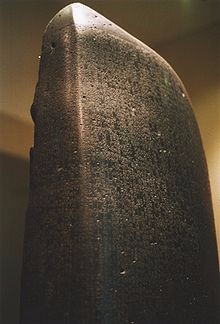
The Code of Hammurabi
This basalt stele has the Code of Hammurabi inscribed in cuneiform script in the Akkadian language.
2.3.3: Babylonian Culture
Hallmarks of Babylonian culture include mudbrick architecture, extensive astronomical records and logs, diagnostic medical handbooks, and translations of Sumerian literature.
Learning Objective
Evaluate the extent and influence of Babylonian culture
Key Points
- Babylonian temples were massive structures of crude brick, supported by buttresses. Such uses of brick led to the early development of the pilaster and column, and of frescoes and enameled tiles.
- Certain pieces of Babylonian art featured crude three-dimensional statues, and gem-cutting was considered a high-perfection art.
- The Babylonians produced extensive compendiums of astronomical records containing catalogues of stars and constellations, as well as schemes for calculating various astronomical coordinates and phenomena.
- Medicinally, the Babylonians introduced basic medical processes, such as diagnosis and prognosis, and also catalogued a variety of illnesses with their symptoms.
- Both Babylonian men and women learned to read and write, and much of Babylonian literature is translated from ancient Sumerian texts, such as the Epic of Gilgamesh.
Key Terms
- Epic of Gilgamesh
-
One of the most famous Babylonian works, a twelve-book saga translated from the original Sumerian.
- pilaster
-
An architectural element in classical architecture used to give the appearance of a supporting column and to articulate an extent of wall, with only an ornamental function.
- etiology
-
Causation. In medicine, cause or origin of disease or condition.
- mudbrick
-
A brick mixture of loam, mud, sand, and water mixed with a binding material, such as rice husks or straw.
- Enūma Anu Enlil
-
A series of cuneiform tablets containing centuries of Babylonian observations of celestial phenomena.
- Diagnostic Handbook
-
The most extensive Babylonian medical text, written by Esagil-kin-apli of Borsippa.
Art and Architecture
In Babylonia, an abundance of clay and lack of stone led to greater use of mudbrick. Babylonian temples were thus massive structures of crude brick, supported by buttresses. The use of brick led to the early development of the pilaster and column, and of frescoes and enameled tiles. The walls were brilliantly colored, and sometimes plated with zinc or gold, as well as with tiles. Painted terracotta cones for torches were also embedded in the plaster. In Babylonia, in place of the bas-relief, there was a preponderance of three-dimensional figures—the earliest examples being the Statues of Gudea—that were realistic, if also somewhat clumsy. The paucity of stone in Babylonia made every pebble a commodity and led to a high perfection in the art of gem-cutting.
Astronomy
During the 8th and 7th centuries BCE, Babylonian astronomers developed a new empirical approach to astronomy. They began studying philosophy dealing with the ideal nature of the universe and began employing an internal logic within their predictive planetary systems. This was an important contribution to astronomy and the philosophy of science, and some scholars have thus referred to this new approach as the first scientific revolution. Tablets dating back to the Old Babylonian period document the application of mathematics to variations in the length of daylight over a solar year. Centuries of Babylonian observations of celestial phenomena are recorded in a series of cuneiform tablets known as the “Enūma Anu Enlil.” In fact, the oldest significant astronomical text known to mankind is Tablet 63 of the Enūma Anu Enlil, the Venus tablet of Ammi-saduqa, which lists the first and last visible risings of Venus over a period of about 21 years. This record is the earliest evidence that planets were recognized as periodic phenomena. The oldest rectangular astrolabe dates back to Babylonia c. 1100 BCE. The MUL.APIN contains catalogues of stars and constellations as well as schemes for predicting heliacal risings and the settings of the planets, as well as lengths of daylight measured by a water-clock, gnomon, shadows, and intercalations. The Babylonian GU text arranges stars in “strings” that lie along declination circles (thus measuring right-ascensions or time-intervals), and also employs the stars of the zenith, which are also separated by given right-ascensional differences.
Medicine
The oldest Babylonian texts on medicine date back to the First Babylonian Dynasty in the first half of the 2nd millennium BCE. The most extensive Babylonian medical text, however, is the Diagnostic Handbook written by the ummânū, or chief scholar, Esagil-kin-apli of Borsippa.
The Babylonians introduced the concepts of diagnosis, prognosis, physical examination, and prescriptions. The Diagnostic Handbook additionally introduced the methods of therapy and etiology outlining the use of empiricism, logic, and rationality in diagnosis, prognosis and treatment. For example, the text contains a list of medical symptoms and often detailed empirical observations along with logical rules used in combining observed symptoms on the body of a patient with its diagnosis and prognosis. In particular, Esagil-kin-apli discovered a variety of illnesses and diseases and described their symptoms in his Diagnostic Handbook, including those of many varieties of epilepsy and related ailments.
Literature
Libraries existed in most towns and temples. Women as well as men learned to read and write, and had knowledge of the extinct Sumerian language, along with a complicated and extensive syllabary.
A considerable amount of Babylonian literature was translated from Sumerian originals, and the language of religion and law long continued to be written in the old agglutinative language of Sumer. Vocabularies, grammars, and interlinear translations were compiled for the use of students, as well as commentaries on the older texts and explanations of obscure words and phrases. The characters of the syllabary were organized and named, and elaborate lists of them were drawn up.
There are many Babylonian literary works whose titles have come down to us. One of the most famous of these was the Epic of Gilgamesh, in twelve books, translated from the original Sumerian by a certain Sin-liqi-unninni, and arranged upon an astronomical principle. Each division contains the story of a single adventure in the career of King Gilgamesh. The whole story is a composite product, and it is probable that some of the stories are artificially attached to the central figure.
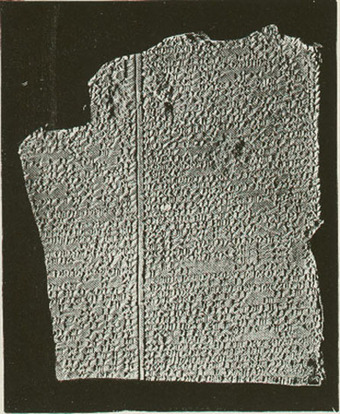
A Tablet from the Epic of Gilgamesh
The Deluge tablet of the Gilgamesh epic in Akkadian.
Philosophy
The origins of Babylonian philosophy can be traced back to early Mesopotamian wisdom literature, which embodied certain philosophies of life, particularly ethics, in the forms of dialectic, dialogs, epic poetry, folklore, hymns, lyrics, prose, and proverbs. Babylonian reasoning and rationality developed beyond empirical observation. It is possible that Babylonian philosophy had an influence on Greek philosophy, particularly Hellenistic philosophy. The Babylonian text Dialogue of Pessimism contains similarities to the agonistic thought of the sophists, the Heraclitean doctrine of contrasts, and the dialogs of Plato, as well as a precursor to the maieutic Socratic method of Socrates.
Neo-Babylonian Culture
The resurgence of Babylonian culture in the 7th and 6th century BCE resulted in a number of developments. In astronomy, a new approach was developed, based on the philosophy of the ideal nature of the early universe, and an internal logic within their predictive planetary systems. Some scholars have called this the first scientific revolution, and it was later adopted by Greek astronomers. The Babylonian astronomer Seleucus of Seleucia (b. 190 BCE) supported a heliocentric model of planetary motion. In mathematics, the Babylonians devised the base 60 numeral system, determined the square root of two correctly to seven places, and demonstrated knowledge of the Pythagorean theorem before Pythagoras.
2.3.4: Nebuchadnezzar and the Fall of Babylon
The Kassite Dynasty ruled Babylonia following the fall of Hammurabi and was succeeded by the Second Dynasty of Isin, during which time the Babylonians experienced military success and cultural upheavals under Nebuchadnezzar.
Learning Objective
Describe the key characteristics of the Second Dynasty of Isin
Key Points
- Following the collapse of the First Babylonian Dynasty under Hammurabi, the Babylonian Empire entered a period of relatively weakened rule under the Kassites for 576 years. The Kassite Dynasty eventually fell itself due to the loss of territory and military weakness.
- The Kassites were succeeded by the Elamites, who themselves were conquered by Marduk-kabit-ahheshu, the founder of the Second Dynasty of Isin.
- Nebuchadnezzar I was the most famous ruler of the Second Dynasty of Isin. He enjoyed military successes for the first part of his career, then turned to peaceful building projects in his later years.
- The Babylonian Empire suffered major blows to its power when Nebuchadnezzar’s sons lost a series of wars with Assyria, and their successors effectively became vassals of the Assyrian king. Babylonia descended into a period of chaos in 1026 BCE.
Key Terms
- Assyrian Empire
-
A major Semitic empire of the Ancient Near East which existed as an independent state for a period of approximately nineteen centuries.
- Nebuchadnezzar I
-
The most famous ruler of the Second Dynasty of Isin, who sacked the Elamite capital of Susa and devoted himself to peaceful building projects after securing Babylonia’s borders.
- Elamites
-
An ancient civilization centered in the far west and southwest of modern-day Iran.
- Kassite Dynasty
-
An ancient Near Eastern people who controlled Babylonia for nearly 600 years after the fall of the First Babylonian Dynasty.
- Marduk-kabit-ahheshu
-
Overthrower of the Elamites and the founder of the Second Dynasty of Isin.
- Kudurru
-
A type of stone document used as boundary stones and as records of land grants to vassals by the Kassites in ancient Babylonia.
The Fall of the Kassite Dynasty and the Rise of the Second Dynasty of Isin
Following the collapse of the First Babylonian Dynasty under Hammurabi, the Babylonian Empire entered a period of relatively weakened rule under the Kassites for 576 years—
the longest dynasty in Babylonian history. The Kassite Dynasty eventually fell due to the loss of territory and military weakness, which resulted in the evident reduction in literacy and culture. In 1157 BCE, Babylon was conquered by Shutruk-Nahhunte of Elam.
The Elamites did not remain in control of Babylonia long, and Marduk-kabit-ahheshu (1155-1139 BCE) established the Second Dynasty of Isin. This dynasty was the very first native Akkadian-speaking south Mesopotamian dynasty to rule Babylon, and was to remain in power for some 125 years. The new king successfully drove out the Elamites and prevented any possible Kassite revival. Later in his reign, he went to war with Assyria and had some initial success before suffering defeat at the hands of the Assyrian king Ashur-Dan I. He was succeeded by his son Itti-Marduk-balatu in 1138 BCE, who was followed a year later by Ninurta-nadin-shumi in 1137 BCE.
The Reign of Nebuchadnezzar I and His Sons
Nebuchadnezzar I (1124-1103 BCE) was the most famous ruler of the Second Dynasty of Isin. He not only fought and defeated the Elamites and drove them from Babylonian territory but invaded Elam itself, sacked the Elamite capital Susa, and recovered the sacred statue of Marduk that had been carried off from Babylon. In the later years of his reign, he devoted himself to peaceful building projects and securing Babylonia’s borders. His construction activities are memorialized in building inscriptions of the Ekituš-ḫegal-tila, the temple of Adad in Babylon, and on bricks from the temple of Enlil in Nippur. A late Babylonian inventory lists his donations of gold vessels in Ur. The earliest of three extant economic texts is dated to Nebuchadnezzar’s eighth year; in addition to two kudurrus and a stone memorial tablet, they form the only existing commercial records. These artifacts evidence the dynasty’s power as builders, craftsmen, and managers of the business of the empire.
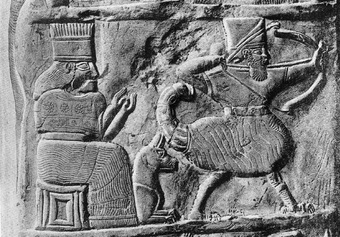
The Kudurru of Nebuchadnezzar
This detail depicts Nebuchadnezzar granting Marduk freedom from taxation.
Nebuchadnezzar was succeeded by his two sons, firstly Enlil-nadin-apli (1103-1100 BCE), who lost territory to Assyria, and then Marduk-nadin-ahhe (1098-1081 BCE), who also went to war with Assyria. Some initial success in these conflicts gave way to catastrophic defeat at the hands of Tiglath-pileser I, who annexed huge swathes of Babylonian territory, thereby further expanding the Assyrian Empire. Following this military defeat, a terrible famine gripped Babylon, which invited attacks from Semitic Aramean tribes from the west.
In 1072 BCE, King Marduk-shapik-zeri signed a peace treaty with Ashur-bel-kala of Assyria. His successor, Kadašman-Buriaš, however, did not maintain his predecessor’s peaceful intentions, and his actions prompted the Assyrian king to invade Babylonia and place his own man on the throne. Assyrian domination continued until c. 1050 BCE, with the two reigning Babylonian kings regarded as vassals of Assyria. Assyria descended into a period of civil war after 1050 BCE, which allowed Babylonia to once more largely free itself from the Assyrian yoke for a few decades.
However, Babylonia soon began to suffer repeated incursions from Semitic nomadic peoples migrating from the west, and large swathes of Babylonia were appropriated and occupied by these newly arrived Arameans, Chaldeans, and Suteans. Starting in 1026 and lasting till 911 BCE, Babylonia descended into a period of chaos.
Chapter 1: The Study of History and the Rise of Civilization
1.1: The Study of History
1.1.1: Splitting History
Periodization—the process of categorizing the past into discrete, quantified, named blocks of time in order to facilitate the study and analysis of history—is always arbitrary and rooted in particular regional perspectives, but serves to organize and systematize historical knowledge.
Learning Objective
Analyze the complications inherent to splitting history for the purpose of academic study
Key Points
-
The question of what kind of inquiries
historians pose, what knowledge they seek, and how they interpret the evidence
that they find remains controversial. Historians draw conclusions from the past
approaches to history but in the end, they always write in the context of their
own time, current dominant ideas of how to interpret the past, and even
subjective viewpoints. -
All events that are remembered and preserved in
some original form constitute the historical record. The task of
historians is to identify the sources that can most usefully contribute to
the production of accurate accounts of the past. These sources, known are
primary sources or evidence, were produced at the time under study and
constitute the foundation of historical inquiry. -
Periodization is the process of categorizing the
past into discrete, quantified named blocks of time in order to facilitate the
study and analysis of history. This results in descriptive abstractions that
provide convenient terms for periods of time with relatively stable
characteristics. All systems of periodization are arbitrary. -
The common general split between prehistory, ancient history, Middle Ages,
modern history, and contemporary history is
a Western division of the largest blocks of time agreed upon by Western
historians.
However, even within this largely accepted division the perspective of specific
national developments and experiences often divides Western historians, as some
periodizing labels will be applicable only to particular regions. -
The study of world history emerged as a
distinct academic field in order to examine history from a global perspective rather than a solely national perspective of
investigation. However, the field still struggles
with an inherently Western periodization. - World historians use a thematic approach to look for common patterns that
emerge across all cultures. World history’s periodization, as imperfect
and biased as it is, serves as a way to organize and systematize
knowledge.
Key Terms
- world history
-
(Also global history or transnational history): emerged as a distinct academic field in the 1980s. It examines history from a global perspective. World history should not be confused with comparative history, which, like world history, deals with the history of multiple cultures and nations, but does not do so on a global scale. World history identifies common patterns that emerge across all cultures.
- periodization
-
The process or study of categorizing the past into discrete, quantified named blocks of time in order to facilitate the study and analysis of history. This results in descriptive abstractions that provide convenient terms for periods of time with relatively stable characteristics. However, determining the precise beginning and ending to any period is usually arbitrary.
- primary sources
-
Original sources of information about a topic. In the study of history as an academic discipline, primary sources include artifact, document, diary, manuscript, autobiography, recording, or other source of information that was created at the time under study.
How Do We Write History?
The word history comes ultimately from Ancient Greek historía, meaning “inquiry,” “knowledge from inquiry,” or “judge.” However, the question of what kind of inquiries historians pose, what knowledge they seek, and how they interpret the evidence that they find remains controversial. Historians
draw conclusions from past approaches to history, but in the end, they always write in the context of their own time, current dominant ideas of how to interpret the past, and even subjective viewpoints. Furthermore, current events and developments often trigger which past events, historical periods, or geographical regions are seen as critical and thus should be investigated. Finally, historical studies are designed to provide specific lessons for societies today. In the words of Benedetto Croce, Italian philosopher and historian, “All history is contemporary history.”
All events that are remembered and preserved in some original form constitute the historical record. The task of historians is to identify the sources that can most usefully contribute to the production of accurate accounts of the past. These sources, known are primary sources or evidence, were produced at the time under study and constitute the foundation of historical inquiry. Ideally, a historian will use as many available primary sources as can be accessed, but in practice, sources may have been destroyed or may not be available for research. In some cases, the only eyewitness reports of an event may be memoirs, autobiographies, or oral interviews taken years later. Sometimes, the only evidence relating to an event or person in the distant past was written or copied decades or centuries later. Historians remain cautious when working with evidence recorded years, or even decades or centuries, after an event; this kind of evidence poses the question of to what extent witnesses remember events accurately. However, historians also point out that hardly any historical evidence can be seen as objective, as it is always a product of particular individuals, times, and dominant ideas. This is also why researchers try to find as many records of an event under investigation as possible, and it is not unusual that they find evidence that may present contradictory accounts of the same events.
In general, the sources of historical knowledge can be separated into three categories: what is written, what is said, and what is physically preserved. Historians often consult all three.
Periodization
Periodization is the process of categorizing the past into discrete, quantified, named blocks of time in order to facilitate the study and analysis of history. This results in descriptive abstractions that provide convenient terms for periods of time with relatively stable characteristics.
To the extent that history is continuous and cannot be generalized, all systems of periodization are arbitrary. Moreover, determining the precise beginning and ending to any period is also a matter of arbitrary decisions. Eventually, periodizing labels are a reflection of very particular cultural and geographical perspectives, as well as specific subfields or themes of history (e.g., military history, social history, political history, intellectual history, cultural history, etc.).
Consequently, not only do periodizing blocks inevitably overlap, but they also often seemingly conflict with or contradict one another. Some have a cultural usage (the Gilded Age), others refer to prominent historical events (the inter-war years: 1918–1939), yet others are defined by decimal numbering systems (the 1960s, the 17th century). Other periods are named after influential individuals whose impact may or may not have reached beyond certain geographic regions (the Victorian Era, the Edwardian Era, the Napoleonic Era).
Western Historical Periods
The common general split between prehistory (before written history), ancient history, Middle Ages, modern history, and contemporary history (history within the living memory) is a Western division of the largest blocks of time agreed upon by Western historians and representing the Western point of view. For example, the history of Asia or Africa cannot be neatly categorized following these periods.
However, even within this largely accepted division, the perspective of specific national developments and experiences often divides Western historians, as some periodizing labels will be applicable only to particular regions.
This is especially true of labels derived from individuals or ruling dynasties, such as the Jacksonian Era in the United States, or the Merovingian Period in France. Cultural terms may also have a limited, even if larger, reach. For example, the concept of the Romantic period is largely meaningless outside of Europe and European-influenced cultures; even within those areas, different European regions may mark the beginning and the ending points of Romanticism differently. Likewise, the 1960s, although technically applicable to anywhere in the world according to Common Era numbering, has a certain set of specific cultural connotations in certain countries, including sexual revolution, counterculture, or youth rebellion. However, those never emerged in certain regions (e.g., in Spain under Francisco Franco’s authoritarian regime). Some historians have also noted that the 1960s, as a descriptive historical period, actually began in the late 1950s and ended in the early 1970s, because the cultural and economic conditions that define the meaning of the period dominated longer than the actual decade of the 1960s.

Petrarch by
Andrea del Castagno.
Petrarch, Italian poet and thinker, conceived of the idea of a European “Dark Age,” which later evolved into the tripartite periodization of Western history into Ancient, Middle Ages and Modern.
While world history (also referred to as global history or transnational history) emerged as a distinct academic field of historical study in the 1980s in order to examine history from a global perspective rather than a solely national perspective of investigation, it still struggles with an inherently Western periodization. The common splits used when designing comprehensive college-level world history courses (and thus also used in history textbooks that are usually divided into volumes covering pre-modern and modern eras) are still a result of certain historical developments presented from the perspective of the Western world and particular national experiences. However, even the split between pre-modern and modern eras is problematic because it is complicated by the question of how history educators, textbook authors, and publishers decide to categorize what is known as the early modern era, which is traditionally a period between Renaissance and the end of the Age of Enlightenment. In the end, whether the early modern era is included in the first or the second part of a world history course frequently offered in U.S. colleges is a subjective decision of history educators. As a result, the same questions and choices apply to history textbooks written and published for the U.S. audience.
World historians use a thematic approach to identify common patterns that emerge across all cultures, with two major focal points: integration (how processes of world history have drawn people of the world together) and difference (how patterns of world history reveal the diversity of the human experiences). The periodization of world history, as imperfect and biased as it is, serves as a way to organize and systematize knowledge.
Without it, history would be nothing more than scattered events without a framework designed to help us understand the past.
1.1.2: Dates and Calendars
While various calendars were developed and used across millennia, cultures, and geographical regions, Western historical scholarship has unified the standards of determining dates based on the dominant Gregorian calendar.
Learning Objective
Compare and
contrast different calendars and how they affect our understanding of history
Key Points
-
The first recorded calendars date to the Bronze
Age, including the
Egyptian and Sumerian calendars.
A
larger number of calendar systems of the Ancient Near East became accessible in
the Iron Age and were based on the Babylonian calendar. A
great number of Hellenic calendars also developed in Classical Greece and influenced
calendars outside of the immediate sphere of Greek influence, giving rise to
the various Hindu calendars, as well as to the ancient Roman calendar. -
Despite various calendars used across millennia,
cultures, and geographical regions, Western historical scholarship has unified
the standards of determining dates based on the dominant Gregorian calendar. -
Julius Caesar effected drastic changes in the existing timekeeping system. The New Year in 709 AUC began on January first and ran over 365 days
until December 31. Further adjustments were made under Augustus, who introduced
the concept of the leap year in 737 AUC (4 CE). The resultant Julian calendar
remained in almost universal use in Europe until 1582. -
The Gregorian calendar, also called the Western
calendar and the Christian calendar, is internationally the most widely used
civil calendar today. It is named after Pope Gregory XIII, who introduced it in
October, 1582. The calendar was a refinement to the Julian calendar, amounting to
a 0.002% correction in the length of the year. -
While the European Gregorian calendar eventually
dominated the world and historiography, a number of other calendars have shaped
timekeeping systems that are still influential in some regions of the world. These include the Islamic calendar, various Hindu calendars, and the Mayan calendar. -
A calendar era that is often used as an
alternative naming of the long-accepted anno Domini/before Christ system is Common Era or Current Era,
abbreviated CE.
While both systems are an accepted
standard, the Common Era system is more neutral and inclusive of a non-Christian perspective.
Key Terms
- Mayan calendar
-
A system of calendars used in pre-Columbian Mesoamerica, and in many modern communities in the Guatemalan highlands, Veracruz, Oaxaca and Chiapas, Mexico. The essentials of it are based upon a system that was in common use throughout the region, dating back to at least the fifth century BCE. It shares many aspects with calendars employed by other earlier Mesoamerican civilizations, such as the Zapotec and Olmec, and with contemporary or later calendars, such as the Mixtec and Aztec calendars.
- anno Domini
-
The Medieval Latin term, which means in the year of the Lord but is often translated as in the year of our Lord. Dionysius Exiguus, of Scythia Minor, introduced the system based on this concept in 525, counting the years since the birth of Christ.
- Islamic calendar
-
(Also Muslim calendar or Hijri calendar): A lunar calendar consisting of 12 months in a year of 354 or 355 days. It is used to date events in many Muslim countries (concurrently with the Gregorian calendar), and is used by Muslims everywhere to determine the proper days on which to observe the annual fasting, to attend Hajj, and to celebrate other Islamic holidays and festivals. The first year equals 622 CE, during which time the emigration of Muhammad from Mecca to Medina, known as the Hijra, occurred.
- Gregorian calendar
-
(Also the Western calendar and the Christian calendar): A calendar that is internationally the most widely used civil calendar today. It is named after Pope Gregory XIII, who introduced it in October 1582. The calendar was a refinement to the Julian calendar, amounting to a 0.002% correction in the length of the year.
- Julian calendar
-
A calendar introduced by Julius Caesar in 46 BCE (708 AUC), which was a reform of the Roman calendar. It took effect in 45 BCE (AUC 709), shortly after the Roman conquest of Egypt. It was the predominant calendar in the Roman world, most of Europe, and in European settlements in the Americas and elsewhere, until it was refined and gradually replaced by the Gregorian calendar, promulgated in 1582 by Pope Gregory XIII.
Calendars and Writing History
Methods of timekeeping can be reconstructed for the prehistoric period from at least the Neolithic period. The natural units for timekeeping used by most historical societies are the day, the solar year, and the lunation. The first recorded calendars date to the Bronze Age, and include the Egyptian and Sumerian calendars. A larger number of calendar systems of the Ancient Near East became accessible in the Iron Age and were based on the Babylonian calendar. One of these was calendar of the Persian Empire, which in turn gave rise to the Zoroastrian calendar, as well as the Hebrew calendar.
A great number of Hellenic calendars were developed in Classical Greece and influenced calendars outside of the immediate sphere of Greek influence. These gave rise to the various Hindu calendars, as well as to the ancient Roman calendar, which contained very ancient remnants of a pre-Etruscan ten-month solar year. The Roman calendar was reformed by Julius Caesar in 45 BCE. The Julian calendar was no longer dependent on the observation of the new moon, but simply followed an algorithm of introducing a leap day every four years. This created a dissociation of the calendar month from the lunation. The Gregorian calendar was introduced as a refinement of the Julian calendar in 1582 and is today in worldwide use as the de facto calendar for secular purposes.
Despite various calendars used across millennia, cultures, and geographical regions, Western historical scholarship has unified the standards of determining dates based on the dominant Gregorian calendar. Regardless of what historical period or geographical areas Western historians investigate and write about, they adjust dates from the original timekeeping system to the Gregorian calendar. Occasionally, some historians decide to use both dates: the dates recorded under the original calendar used, and the date adjusted to the Gregorian calendar, easily recognizable to the Western student of history.
Julian Calendar
The old Roman year had 304 days divided into ten months, beginning with March. However, the ancient historian, Livy, gave credit to the second ancient Roman king, Numa Pompilious, for devising a calendar of twelve months. The extra months Ianuarius and Februarius had been invented, supposedly by Numa Pompilious, as stop-gaps. Julius Caesar realized that the system had become inoperable, so he effected drastic changes in the year of his third consulship. The New Year in 709 AUC (ab urbe condita—
year from the founding of the City of Rome)
began on January first and ran over 365 days until December 31. Further adjustments were made under Augustus, who introduced the concept of the leap year in 737 AUC (4 CE). The resultant Julian calendar remained in almost universal use in Europe until 1582. Marcus Terentius Varro introduced the Ab urbe condita epoch, assuming a foundation of Rome in 753 BCE. The system remained in use during the early medieval period until the widespread adoption of the Dionysian era in the Carolingian period. The seven-day week has a tradition reaching back to the Ancient Near East, but the introduction of the planetary week, which remains in modern use, dates to the Roman Empire period.
Gregorian Calendar
The Gregorian calendar, also called the Western calendar and the Christian calendar, is internationally the most widely used civil calendar today. It is named after Pope Gregory XIII, who introduced it in October, 1582. The calendar was a refinement to the Julian calendar, amounting to a 0.002% correction in the length of the year. The motivation for the reform was to stop the drift of the calendar with respect to the equinoxes and solstices—particularly the vernal equinox, which set the date for Easter celebrations. Transition to the Gregorian calendar would restore the holiday to the time of the year in which it was celebrated when introduced by the early Church. The reform was adopted initially by the Catholic countries of Europe. Protestants and Eastern Orthodox countries continued to use the traditional Julian calendar, and eventually adopted the Gregorian reform for the sake of convenience in international trade. The last European country to adopt the reform was Greece in 1923.
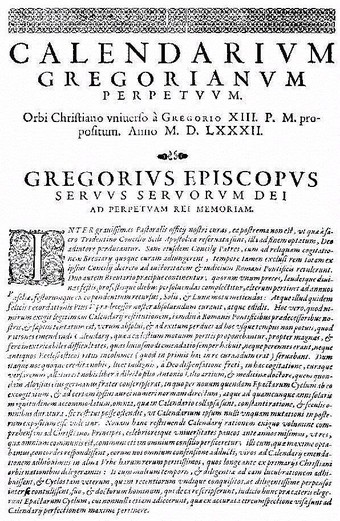
The first page of the papal bull “Inter Gravissimas” by which Pope Gregory XIII introduced his calendar.
During the period between 1582, when the first countries adopted the Gregorian calendar, and 1923, when the last European country adopted it, it was often necessary to indicate the date of some event in both the Julian calendar and in the Gregorian calendar. Even before 1582, the year sometimes had to be double dated because of the different beginnings of the year in various countries.
Calendars Outside of Europe
While the European Gregorian calendar eventually dominated the world and historiography, a number of other calendars have shaped timekeeping systems that are still influential in some regions of the world.
The Islamic calendar determines the first year in 622 CE, during which the emigration of Muhammad from Mecca to Medina, known as the Hijra, occurred. It is used to date events in many Muslim countries (concurrently with the Gregorian calendar), and is used by Muslims everywhere to determine the proper days on which to observe and celebrate Islamic religious practices (e.g., fasting), holidays, and festivals.
Various Hindu calendars developed in the medieval period with Gupta era astronomy as their common basis. Some of the more prominent regional Hindu calendars include the Nepali calendar, Assamese calendar, Bengali calendar, Malayalam calendar, Tamil calendar, the Vikrama Samvat (used in Northern India), and Shalivahana calendar. The common feature of all regional Hindu calendars is that the names of the twelve months are the same (because the names are based in Sanskrit) although the spelling and pronunciation have come to vary slightly from region to region over thousands of years. The month that starts the year also varies from region to region. The Buddhist calendar and the traditional lunisolar calendars of Cambodia, Laos, Myanmar, Sri Lanka, and Thailand are also based on an older version of the Hindu calendar.
Of all the ancient calendar systems, the Mayan and other Mesoamerican systems are the most complex. The Mayan calendar had two years, the 260-day Sacred Round, or tzolkin, and the 365-day Vague Year, or haab.
The essentials of the Mayan calendar are based upon a system that was in common use throughout the region, dating back to at least the fifth century BCE. It shares many aspects with calendars employed by other earlier Mesoamerican civilizations, such as the Zapotec and Olmec, and contemporary or later ones, such as the Mixtec and Aztec calendars. The Mayan calendar is still used in many modern communities in the Guatemalan highlands, Veracruz, Oaxaca and Chiapas, Mexico.

Islamic Calendar stamp issued at King Khaled airport (10 Rajab 1428 / 24 July 2007)
The first year was the Islamic year beginning in AD 622, during which the emigration of Muhammad from Mecca to Medina, known as the Hijra, occurred. Each numbered year is designated either “H” for Hijra or “AH” for the Latin Anno Hegirae (“in the year of the Hijra”). Hence, Muslims typically call their calendar the Hijri calendar.
Anno Domini v. Common Era
The terms anno Domini (AD) and before Christ (BC) are used to label or number years in the Julian and Gregorian calendars. The term anno Domini is Medieval Latin, which means in the year of the Lord, but is often translated as in the year of our Lord. It is occasionally set out more fully as anno Domini nostri Iesu (or Jesu Christi (“in the year of Our Lord Jesus Christ”). Dionysius Exiguus of Scythia Minor introduced the AD system in AD 525, counting the years since the birth of Christ. This calendar era is based on the traditionally recognized year of the conception or birth of Jesus of Nazareth, with AD counting years after the start of this epoch and BC denoting years before the start of the era. There is no year zero in this scheme, so the year AD 1 immediately follows the year 1 BC. This dating system was devised in 525, but was not widely used until after 800.
A calendar era that is often used as an alternative naming of the anno Domini
is Common Era or Current Era, abbreviated CE. The system uses BCE as an abbreviation for “before the Common (or Current) Era.” The CE/BCE designation uses the same numeric values as the AD/BC system so the two notations (CE/BCE and AD/BC) are numerically equivalent. The expression “Common Era” can be found as early as 1708 in English and traced back to Latin usage among European Christians to 1615, as vulgaris aerae, and to 1635 in English as Vulgar Era.
Since the later 20th century, the use of CE and BCE have been popularized in academic and scientific publications, and more generally by authors and publishers wishing to emphasize secularism or sensitivity to non-Christians, because the system does not explicitly make use of religious titles for Jesus, such as “Christ” and Dominus (“Lord”), which are used in the BC/AD notation, nor does it give implicit expression to the Christian creed that Jesus is the Christ. While both systems are thus an accepted standard, the CE/BCE system is more neutral and inclusive of a non-Christian perspective.
1.1.3: The Imperfect Historical Record
While some primary sources are considered more reliable or trustworthy
than others, hardly any historical evidence can be
seen as fully objective since it is always a product of particular individuals,
times, and dominant ideas.
Learning Objective
Explain the consequences of the imperfect historical record
Key Points
-
In
the study of history as an academic discipline, a primary source
is an artifact,
document, diary, manuscript, autobiography, recording, or other source of
information that was created at the time under study. -
History
as an academic discipline is based on primary sources, as evaluated by the
community of scholars for whom primary sources are absolutely fundamental to
reconstructing the past. Ideally, a historian will use as many primary sources that were created during the time under study as can be accessed. In practice however, some sources have been destroyed,
while others are not available for research. -
While
some sources are considered more reliable or trustworthy than others, historians point
out that hardly any historical evidence can be seen as fully objective since it is always a product of particular individuals, times, and dominant ideas. -
Historical
method comprises the techniques and guidelines by which
historians use primary sources and other evidence (including the
evidence of archaeology) to research and write historical accounts of the past. -
Primary
sources may remain in private hands or are located in archives, libraries,
museums, historical societies, and special collections. Traditionally,
historians attempt to answer historical questions through the study of written
documents and oral accounts. They also use such sources as monuments,
inscriptions, and pictures. In general, the sources of historical knowledge can
be separated into three categories: what is written, what is said, and what is physically
preserved. Historians often consult all three. - Historians use various strategies to reconstruct the past when facing a lack of sources, including collaborating with experts from other academic disciplines, most notably archaeology.
Key Terms
- historical method
-
A scholarly method that comprises the techniques and guidelines by which historians use primary sources and other evidence (including the evidence of archaeology) to research and write historical accounts of the past.
- primary source
-
In the study of history as an
academic discipline, an artifact, document, diary, manuscript, autobiography,
recording, or other source of information that was created at the time under
study. It serves as an original source of information about the topic. - secondary source
-
A document or recording that relates or discusses information originally found in a primary source. It contrasts with a primary source, which is an original source of the information being discussed; a primary source can be a person with direct knowledge of a situation, or a document created by such a person. A secondary source involves generalization, analysis, synthesis, interpretation, or evaluation of the original information.
Primary Sources
In the study of history as
an academic discipline, a primary source (also called original source or
evidence) is an artifact, document, diary, manuscript, autobiography, recording,
or other source of information that was created at the time under study. It
serves as an original source of information about the topic. Primary sources
are distinguished from secondary sources, which cite, comment on, or build upon
primary sources. In some cases, a secondary source may also be a primary
source, depending on how it is used. For example, a memoir would be considered
a primary source in research concerning its author or about his or her friends
characterized within it, but the same memoir would be a secondary source if it
were used to examine the culture in which its author lived. “Primary”
and “secondary” should be understood as relative terms, with sources
categorized according to specific historical contexts and what is being
studied.
Using Primary Sources: Historical Method
History as an academic
discipline is based on primary sources, as evaluated by the community of
scholars for whom primary sources are absolutely fundamental to reconstructing
the past. Ideally, a historian will use as many primary sources that
were created by the people involved at the time under study as can be accessed. In practice however, some sources have been destroyed, while others are not
available for research. In some cases, the only eyewitness reports of an event
may be memoirs, autobiographies, or oral interviews taken years later.
Sometimes, the only evidence relating to an event or person in the distant past
was written or copied decades or centuries later. Manuscripts that are sources
for classical texts can be copies or fragments of documents. This is a common problem in classical studies, where sometimes only
a summary of a book or letter, but not the actual book or letter, has survived.
While some sources are considered more reliable or trustworthy than others
(e.g., an original government document containing information about an
event vs. a recording of a witness recalling the same event years later),
historians point out that hardly any historical evidence can be seen as fully
objective as it is always a product of particular individuals, times, and
dominant ideas. This is also why researchers try to find as many records of an
event under investigation as possible, and attempt to resolve evidence that may
present contradictory accounts of the same events.
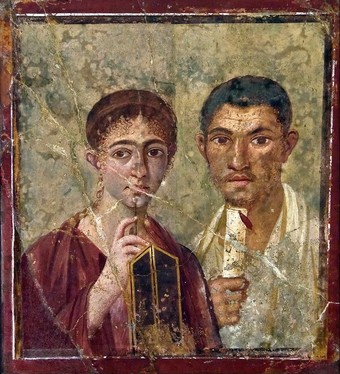
This wall painting (known as
The portrait of Paquius Proculo and currently preserved at the Naples National Archaeological Museum) was found in the Roman city of Pompeii and serves as a complex example of a primary source.
The fresco would not tell much to historians without corresponding textual and archaeological evidence that helps to establish who the portrayed couple might have been.
The man wears a toga, the mark of a Roman citizen, and holds a rotulus, suggesting he is involved in public and/or cultural affairs. The woman holds a stylus and wax tablet, emphasizing that she is educated and literate. It is suspected, based on the physical features of the couple, that they are Samnites, which may explain the desire to show off the status they have reached in Roman society.
Historical
method comprises the techniques and guidelines by which
historians use primary sources and other evidence (including the
evidence of archaeology) to research and write historical accounts of the past. Historians continue to debate what aspects and practices
of investigating primary sources should be considered, and what constitutes a
primary source when developing the most effective historical method. The
question of the nature, and even the possibility, of a sound historical method
is so central that it has been continuously raised in the philosophy of
history as a question of epistemology.
Finding Primary Sources
Primary sources may remain
in private hands or are located in archives, libraries, museums, historical
societies, and special collections. These can be public or private. Some are
affiliated with universities and colleges, while others are government
entities. Materials relating to one area might be spread over a large number of
different institutions. These can be distant from the original source of the
document. For example, the Huntington Library in California houses a large
number of documents from the United Kingdom. While the development of
technology has resulted in an increasing number of digitized sources, most
primary source materials are not digitized and may only be represented online
with a record or finding aid.
Traditionally, historians
attempt to answer historical questions through the study of written documents
and oral accounts. They also use such sources as monuments, inscriptions, and
pictures. In general, the sources of historical knowledge can be separated into
three categories: what is written, what is said, and what is physically
preserved. Historians often consult all three. However, writing is the
marker that separates history from what comes before.
Archaeology is one
discipline that is especially helpful to historians. By dealing with buried
sites and objects, it contributes to the reconstruction of the past.
However, archaeology is constituted by a range of methodologies and approaches
that are independent from history. In other words, archaeology does not
“fill the gaps” within textual sources but often contrasts its
conclusions against those of contemporary textual sources.
Archaeology also provides
an illustrative example of how historians can be helped when written records
are missing. Unearthing artifacts and working with archaeologists to interpret
them based on the expertise of a particular historical era and cultural or
geographical area is one effective way to reconstruct the past. If written
records are missing, historians often attempt to collect oral accounts of
particular events, preferably by eyewitnesses, but sometimes, because of the
passage of time, they are forced to work with the following generations. Thus, the question of the reliability of oral history has been widely debated.
When dealing with many government records, historians usually have to wait for a
specific period of time before documents are declassified and available to
researchers. For political reasons, many sensitive records may be
destroyed, withdrawn from collections, or hidden, which may also encourage
researchers to rely on oral histories. Missing records of events, or
processes that historians believe took place based on very fragmentary
evidence, forces historians to seek information in records that may not be a likely
sources of information. As archival
research is always time-consuming and labor-intensive, this approach poses the
risk of never producing desired results, despite the time and effort invested
in finding informative and reliable resources. In some cases, historians are
forced to speculate (this should be explicitly noted) or simply admit that we
do not have sufficient information to reconstruct particular past events or
processes.
1.1.4: Historical Bias
Biases have been part of historical investigation since the ancient beginnings of the discipline. While more recent scholarly practices attempt to remove earlier biases from history, no piece of historical scholarship can be fully free of biases.
Learning Objective
Identify some examples of historical bias
Key Points
-
Regardless
of whether they are conscious or learned implicitly within cultural contexts, biases
have been part of historical investigation since the ancient beginnings of the
discipline. As such, history provides an excellent example of how biases
change, evolve, and even disappear. -
Early attempts to make history an empirical,
objective discipline (most notably by Voltaire) did not find many followers. Throughout the 18th and 19th
centuries, European historians only strengthened their biases. As Europe
gradually dominated the
world through the self-imposed mission to colonize nearly all the other
continents, Eurocentrism prevailed in history. - Even within the Eurocentric perspective, not all
Europeans were equal; Western historians largely ignored aspects of
history, such as class, gender, or ethnicity. Until the rapid development of social history in the 1960s and 1970s,
mainstream Western historical narratives focused on political and military
history, while cultural or social history was written mostly from the
perspective of the elites. -
The biased approach to history-writing
transferred also to history-teaching. From the origins of national mass
schooling systems in the 19th century, the teaching of history to promote
national sentiment has been a high priority. History textbooks in most countries have been tools to foster nationalism and patriotism and to promote the
most favorable version of national history. -
Germany attempts to be an example of how to
remove nationalistic narratives from history education. The history curriculum in Germany is characterized
by a transnational perspective that emphasizes the all-European heritage, minimizes the idea of national pride, and fosters the notion of civil society centered on democracy, human rights, and peace. -
Despite progress and increased focus on
groups that have been traditionally excluded from mainstream historical
narratives (people of color, women, the working class, the poor,
the disabled, LGBTQI-identified people, etc.), bias remains a component of historical
investigation.
Key Term
- Eurocentrism
-
The practice of viewing the world from a European or generally Western perspective with an implied belief in the pre-eminence of Western culture. It may also be used to describe a view centered on the history or eminence of white people. The term was coined in the 1980s, referring to the notion of European exceptionalism and other Western equivalents, such as American exceptionalism.
Bias in Historical Writing
Bias is an inclination or outlook to present or hold a partial perspective, often accompanied by a refusal to consider the possible merits of alternative points of view. Regardless of whether conscious or learned implicitly within cultural contexts, biases have been part of historical investigation since the ancient beginnings of the discipline. As such, history provides an excellent example of how biases change, evolve, and even disappear.
History as a modern academic discipline based on empirical methods (in this case, studying primary sources in order to reconstruct the past based on available evidence), rose to prominence during the Age of Enlightenment. Voltaire, a French author and thinker, is credited to have developed a fresh outlook on history that broke from the tradition of narrating diplomatic and military events and emphasized customs, social history (the history of ordinary people) and achievements in the arts and sciences. His Essay on Customs traced the progress of world civilization in a universal context, thereby rejecting both nationalism and the traditional Christian frame of reference. Voltaire was also the first scholar to make a serious attempt to write the history of the world, eliminating theological frameworks and emphasizing economics, culture, and political history. He was the first to emphasize the debt of medieval culture to Middle Eastern civilization. Although he repeatedly warned against political bias on the part of the historian, he did not miss many opportunities to expose the intolerance and frauds of the Catholic Church over the ages—
a topic that was Voltaire’s life-long intellectual interest.
Voltaire’s early attempts to make history an empirical, objective discipline did not find many followers. Throughout the 18th and 19th centuries, European historians only strengthened their biases. As Europe gradually benefited from the ongoing scientific progress and dominated the world in the self-imposed mission to colonize nearly all other continents, Eurocentrism prevailed in history. The practice of viewing and presenting the world from a European or generally Western perspective, with an implied belief in the pre-eminence of Western culture, dominated among European historians who contrasted the progressively mechanized character of European culture with traditional hunting, farming and herding societies in many of the areas of the world being newly conquered and colonized. These included the Americas, Asia, Africa and, later, the Pacific and Australasia. Many European writers of this time construed the history of Europe as paradigmatic for the rest of the world. Other cultures were identified as having reached a stage that Europe itself had already passed: primitive hunter-gatherer, farming, early civilization, feudalism and modern liberal-capitalism. Only Europe was considered to have achieved the last stage. With this assumption, Europeans were also presented as racially superior, and European history as a discipline became essentially the history of the dominance of white peoples.
However, even within the Eurocentric perspective, not all Europeans were equal; Western historians largely ignored aspects of history, such as class, gender, or ethnicity. Until relatively recently (particularly the rapid development of social history in the 1960s and 1970s), mainstream Western historical narratives focused on political and military history, while cultural or social history was written mostly from the perspective of the elites. Consequently, what was in fact an experience of a selected few (usually white males of upper classes, with some occasional mentions of their female counterparts), was typically presented as the illustrative experience of the entire society. In the United States, some of the first to break this approach were African American scholars who at the turn of the 20th century wrote histories of black Americans and called for their inclusion in the mainstream historical narrative.
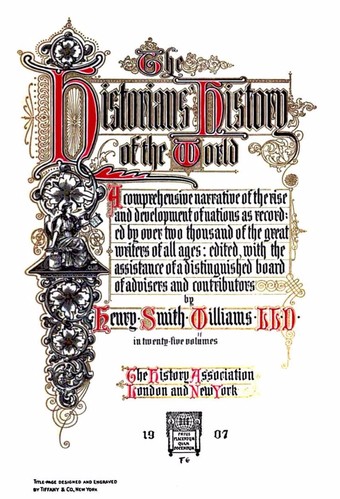
The title page to The Historians’ History of the World:
A Comprehensive Narrative of the Rise and Development of Nations as Recorded by over two thousand of the Great Writers of all Ages, 1907.
The Historians’ History of the World is a 25-volume encyclopedia of world history originally published in English near the beginning of the 20th century. It is quite extensive but its perspective is entirely Western Eurocentric. For example, while four volumes focus on the history of England (with Scotland and Ireland included in one of them), “Poland, the Balkans, Turkey, minor Eastern states, China, Japan” are all described in one volume. It was compiled by Henry Smith Williams, a medical doctor and author, as well as other authorities on history, and published in New York in 1902 by Encyclopædia Britannica and the Outlook Company.
Bias in the Teaching of History
The biased approach to historical writing is present in the teaching of history as well.
From the origins of national mass schooling systems in the 19th century, the teaching of history to promote national sentiment has been a high priority. Until today, in most countries history textbook are tools to foster nationalism and patriotism and promote the most favorable version of national history. In the United States, one of the most striking examples of this approach is the continuous narrative of the United States as a state established on the principles of personal liberty and democracy. Although aspects of U.S. history, such as slavery, genocide of American Indians, or disfranchisement of the large segments of the society for decades after the onset of the American statehood, are now taught in most (yet not all) American schools, they are presented as marginal in the larger narrative of liberty and democracy.
In many countries, history textbooks are sponsored by the national government and are written to put the national heritage in the most favorable light, although academic historians have often fought against the politicization of the textbooks, sometimes with success. Interestingly, the 21st-century Germany attempts to be an example of how to remove nationalistic narratives from history education. As the 20th-century history of Germany is filled with events and processes that are rarely a cause of national pride, the history curriculum in Germany (controlled by the 16 German states) is characterized by a transnational perspective that emphasizes the all-European heritage, minimizes the idea of national pride, and fosters the notion of civil society centered on democracy, human rights, and peace. Yet, even in the rather unusual German case, Eurocentrism continues to dominate.
The challenge to replace national, or even nationalist, perspectives with a more inclusive transnational or global view of human history is also still very present in college-level history curricula.
In the United States after World War I, a strong movement emerged at the university level to teach courses in Western Civilization with the aim to give students a common heritage with Europe. After 1980, attention increasingly moved toward teaching world history or requiring students to take courses in non-western cultures. Yet, world history courses still struggle to move beyond the Eurocentric perspective, focusing heavily on the history of Europe and its links to the United States.
Despite all the progress and much more focus on the groups that have been traditionally excluded from mainstream historical narratives (people of color, women, the working class, the poor, the disabled, LGBTQI-identified people, etc.), bias remains a component of historical investigation, whether it is a product of nationalism, author’s political views, or an agenda-driven interpretation of sources. It is only appropriate to state that the present world history book, while written in accordance with the most recent scholarly and educational practices, has been written and edited by authors trained in American universities and published in the United States. As such, it is also not free from both national (U.S.) and individual (authors’) biases.
1.2: Precursors to Civilization
1.2.1: The Evolution of Humans
Human evolution is an ongoing and complex process that began seven million years ago.
Learning Objective
To understand the process and timeline of human evolution
Key Points
- Humans began to evolve about seven million years ago, and progressed through four stages of evolution. Research shows that the first modern humans appeared 200,000 years ago.
- Neanderthals were a separate species from humans. Although they had larger brain capacity and interbred with humans, they eventually died out.
- A number of theories examine the relationship between environmental conditions and human evolution.
- The main human adaptations have included bipedalism, larger brain size, and reduced sexual dimorphism.
Key Terms
- aridity hypothesis
-
The theory that the savannah was expanding due to increasingly arid conditions, which then drove hominin adaptation.
- turnover pulse hypothesis
-
The theory that extinctions due to environmental conditions hurt specialist species more than generalist ones, leading to greater evolution among specialists.
- Red Queen hypothesis
-
The theory that species must constantly evolve in order to compete with co-evolving animals around them.
- encephalization
-
An evolutionary increase in the complexity and/or size of the brain.
- sexual dimorphism
-
Differences in size or appearance between the sexes of an animal species.
- social brain hypothesis
-
The theory that improving cognitive capabilities would allow hominins to influence local groups and control resources.
- Toba catastrophe theory
-
The theory that there was a near-extinction event for early humans about 70,000 years ago.
- savannah hypothesis
-
The theory that hominins were forced out of the trees they lived in and onto the expanding savannah; as they did so, they began walking upright on two feet.
- hominids
-
A primate of the family Hominidae that includes humans and their fossil ancestors.
- bipedal
-
Describing an animal that uses only two legs for walking.
Human evolution began with primates. Primate development diverged from other mammals about 85 million years ago. Various divergences among apes, gibbons, orangutans occurred during this period, with Homini (including early humans and chimpanzees) separating from Gorillini (gorillas) about 8 millions years ago. Humans and chimps then separated about 7.5 million years ago.
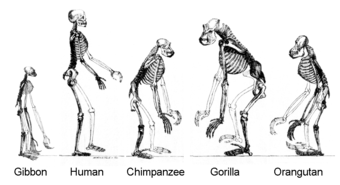
Skeletal structure of humans and other primates.
A comparison of the skeletal structures of gibbons, humans, chimpanzees, gorillas and orangutans.
Generally, it is believed that hominids first evolved in Africa and then migrated to other areas. There were four main stages of human evolution. The first, between four and seven million years ago, consisted of the proto hominins Sahelanthropus, Orrorin and Ardipithecus. These humans may have been bipedal, meaning they walked upright on two legs. The second stage, around four million years ago, was marked by the appearance of Australopithecus, and the third, around 2.7 million years ago, featured Paranthropus.
The fourth stage features the genus Homo, which existed between 1.8 and 2.5 million years ago. Homo habilis, which used stone tools and had a brain about the size of a chimpanzee, was an early hominin in this period. Coordinating fine hand movements needed for tool use may have led to increasing brain capacity. This was followed by Homo erectus and Homo ergaster, who had double the brain size and may have been the first to control fire and use more complex tools. Homo heidelbergensis appeared about 800,000 years ago, and modern humans, Homo sapiens, about 200,000 years ago. Humans acquired symbolic culture and language about 50,000 years ago.
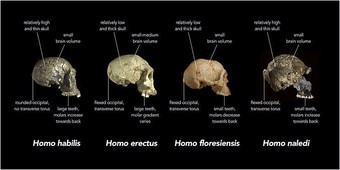
Comparison of skull features among early humans.
A comparison of Homo habilis, Homo erectus, Homo floresiensis and Homo naledi skull features.
Neanderthals
A separate species, Homo neanderthalensis, had a common ancestor with humans about 660,000 years ago, and engaged in interbreeding with Homo sapiens about 45,000 to 80,000 years ago. Although their brains were larger, Neanderthals had fewer social and technological innovations than humans, and they eventually died out.
Theories of Early Human Evolution
The savannah hypothesis states that hominins were forced out of the trees they lived in and onto the expanding savannah; as they did so, they began walking upright on two feet. This idea was expanded in the aridity hypothesis, which posited that the savannah was expanding due to increasingly arid conditions resulting in hominin adaptation. Thus, during periods of intense aridification, hominins also were pushed to evolve and adapt.
The turnover pulse hypothesis states that extinctions due to environmental conditions hurt specialist species more than generalist ones. While generalist species spread out when environmental conditions change, specialist species become more specialized and have a greater rate of evolution. The Red Queen hypothesis states that species must constantly evolve in order to compete with co-evolving animals around them. The social brain hypothesis states that improving cognitive capabilities would allow hominins to influence local groups and control resources. The Toba catastrophe theory states that there was a near-extinction event for early humans about 70,000 years ago.
Human Adaptations
Bipedalism, or walking upright, is one of the main human evolutionary adaptations. Advantages to be found in bipedalism include the freedom of the hands for labor and less physically taxing movement. Walking upright better allows for long distance travel and hunting, for a wider field of vision, a reduction of the amount of skin exposed to the sun, and overall thrives in a savannah environment. Bipedalism resulted in skeletal changes to the legs, knee and ankle joints, spinal vertebrae, toes, and arms. Most significantly, the pelvis became shorter and rounded, with a smaller birth canal, making birth more difficult for humans than other primates. In turn, this resulted in shorter gestation (as babies need to be born before their heads become too large), and more helpless infants who are not fully developed before birth.
Larger brain size, also called encephalization, began in early humans with Homo habilis and continued through the Neanderthal line (capacity of 1,200 – 1,900 cm3). The ability of the human brain to continue to grow after birth meant that social learning and language were possible. It is possible that a focus on eating meat, and cooking, allowed for brain growth. Modern humans have a brain volume of 1250 cm3.
Humans have reduced sexual dimorphism, or differences between males and females, and hidden estrus, which means the female is fertile year-round and shows no special sign of fertility. Human sexes still have some differences between them, with males being slightly larger and having more body hair and less body fat. These changes may be related to pair bonding for long-term raising of offspring.
Other adaptations include lessening of body hair, a chin, a descended larynx, and an emphasis on vision instead of smell.
1.2.2: The Neolithic Revolution
The Neolithic Revolution and invention of agriculture allowed humans to settle in groups, specialize, and develop civilizations.
Learning Objective
Explain the significance of the Neolithic Revolution
Key Points
- During the Paleolithic Era, humans grouped together in small societies and subsisted by gathering plants, and fishing, hunting or scavenging wild animals.
- The Neolithic Revolution references a change from a largely nomadic hunter-gatherer way of life to a more settled, agrarian-based one, with the inception of the domestication of various plant and animal species—depending on species locally available and likely also influenced by local culture.
- There are several competing (but not mutually exclusive) theories as to the factors that drove populations to take up agriculture, including the Hilly Flanks hypothesis, the Feasting model, the Demographic theories, the evolutionary/intentionality theory, and the largely discredited Oasis Theory.
- The shift to agricultural food production supported a denser population, which in turn supported larger sedentary communities, the accumulation of goods and tools, and specialization in diverse forms of new labor.
- The nutritional standards of Neolithic populations were generally inferior to that of hunter-gatherers, and they worked longer hours and had shorter life expectancies.
- Life today, including our governments, specialized labor, and trade, is directly related to the advances made in the Neolithic Revolution.
Key Terms
- Demographic theories
-
Theories about how sedentary populations may have driven agricultural changes.
- specialization
-
A process where laborers focused on one specialty area rather than creating all needed items.
- Feasting model
-
The theory that displays of power through feasting drove agricultural technology.
- Oasis Theory
-
The theory that humans were forced into close association with animals due to changes in climate.
- Paleolithic Era
-
A period of history that spans from 2.5 million to 20,000 years ago, during which time humans evolved, used stone tools, and lived as hunter-gatherers.
- Hunter-gatherer
-
A nomadic lifestyle in which food is obtained from wild plants and animals; in contrast to an agricultural lifestyle, which relies mainly on domesticated species.
- Neolithic Revolution
-
The world’s first historically verifiable advancement in agriculture. It took place around 12,000 years ago.
- Evolutionary/Intentionality theory
-
The theory that domestication was part of an evolutionary process between humans and plants.
- Hilly Flanks hypothesis
-
The theory that agriculture began in the hilly flanks of the Taurus and Zagros mountains, where the climate was not drier, and fertile land supported a variety of plants and animals amenable to domestication.
Before the Rise of Civilization: The Paleolithic Era
The first humans evolved in Africa during the Paleolithic Era, or Stone Age, which spans the period of history from 2.5 million to about 10,000 BCE. During this time, humans lived in small groups as hunter-gatherers, with clear gender divisions for labor. The men hunted animals while the women gathered food, such as fruit, nuts and berries, from the local area. Simple tools made of stone, wood, and bone (such as hand axes, flints and spearheads) were used throughout the period. Fire was controlled, which created heat and light, and allowed for cooking.
Humankind gradually evolved from early members of the genus Homo—
such as Homo habilis,
who used simple stone tools— into fully behaviorally and anatomically modern humans (Homo sapiens) during the Paleolithic era. During the end of the Paleolithic, specifically the Middle and or Upper Paleolithic, humans began to produce the earliest works of art and engage in religious and spiritual behavior, such as burial and ritual. Paleolithic humans were nomads, who often moved their settlements as food became scarce. This eventually resulted in humans spreading out from Africa (beginning roughly 60,000 years ago) and into Eurasia, Southeast Asia, and Australia. By about 40,000 years ago, they had entered Europe, and by about 15,000 years ago, they had reached North America followed by South America.
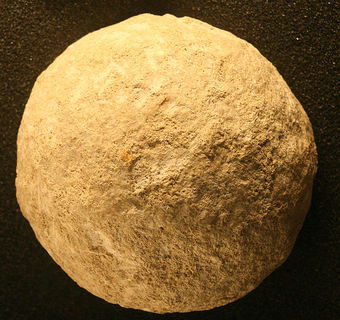
Stone ball from a set of Paleolithic bolas
Paleoliths (artifacts from the Paleolithic), such as this stone ball, demonstrate some of the stone technologies that the early humans used as tools and weapons.
During about 10,000 BCE, a major change occurred in the way humans lived; this would have a cascading effect on every part of human society and culture. That change was the Neolithic Revolution.
The Neolithic Revolution: From Hunter-Gatherer to Agriculturalist
The beginning of the Neolithic Revolution in different regions has been dated from perhaps 8,000 BCE in the Kuk Early Agricultural Site of Melanesia Kuk to 2,500 BCE in Subsaharan Africa, with some considering the developments of 9,000-7,000 BCE in the Fertile Crescent to be the most important. This transition everywhere is associated with the change from a largely nomadic hunter-gatherer way of life to a more settled, agrarian-based one, due to the inception of the domestication of various plant and animal species—depending on the species locally available, and probably also influenced by local culture.
It is not known why humans decided to begin cultivating plants and domesticating animals. While more labor-intensive, the people must have seen the relationship between cultivation of grains and an increase in population. The domestication of animals provided a new source of protein, through meat and milk, along with hides and wool, which allowed for the production of clothing and other objects.
There are several competing (but not mutually exclusive) theories about the factors that drove populations to take up agriculture. The most prominent of these are:
- The Oasis Theory, originally proposed by Raphael Pumpelly in 1908, and popularized by V. Gordon Childe in 1928, suggests as the climate got drier due to the Atlantic depressions shifting northward, communities contracted to oases where they were forced into close association with animals. These animals were then domesticated together with planting of seeds. However, this theory has little support amongst archaeologists today because subsequent climate data suggests that the region was getting wetter rather than drier.
- The Hilly Flanks hypothesis, proposed by Robert Braidwood in 1948, suggests that agriculture began in the hilly flanks of the Taurus and Zagros mountains, where the climate was not drier, as Childe had believed, and that fertile land supported a variety of plants and animals amenable to domestication.
- The Feasting model by Brian Hayden suggests that agriculture was driven by ostentatious displays of power, such as giving feasts, to exert dominance. This system required assembling large quantities of food, a demand which drove agricultural technology.
- The Demographic theories proposed by Carl Sauer and adapted by Lewis Binford and Kent Flannery posit that an increasingly sedentary population outgrew the resources in the local environment and required more food than could be gathered. Various social and economic factors helped drive the need for food.
- The Evolutionary/Intentionality theory, developed by David Rindos and others, views agriculture as an evolutionary adaptation of plants and humans. Starting with domestication by protection of wild plants, it led to specialization of location and then full-fledged domestication.
Effects of the Neolithic Revolution on Society
The traditional view is that the shift to agricultural food production supported a denser population, which in turn supported larger sedentary communities, the accumulation of goods and tools, and specialization in diverse forms of new labor. Overall a population could increase its size more rapidly when resources were more available. The resulting larger societies led to the development of different means of decision making and governmental organization. Food surpluses made possible the development of a social elite freed from labor, who dominated their communities and monopolized decision-making. There were deep social divisions and inequality between the sexes, with women’s status declining as men took on greater roles as leaders and warriors. Social class was determined by occupation, with farmers and craftsmen at the lower end, and priests and warriors at the higher.
Effects of the Neolithic Revolution on Health
Neolithic populations generally had poorer nutrition, shorter life expectancies, and a more labor-intensive lifestyle than hunter-gatherers. Diseases jumped from animals to humans, and agriculturalists suffered from more anaemia, vitamin deficiencies, spinal deformations, and dental pathologies.
Overall Impact of the Neolithic Revolution on Modern Life
The way we live today is directly related to the advances made in the Neolithic Revolution. From the governments we live under, to the specialized work laborers do, to the trade of goods and food, humans were irrevocably changed by the switch to sedentary agriculture and domestication of animals. Human population swelled from five million to seven billion today.
